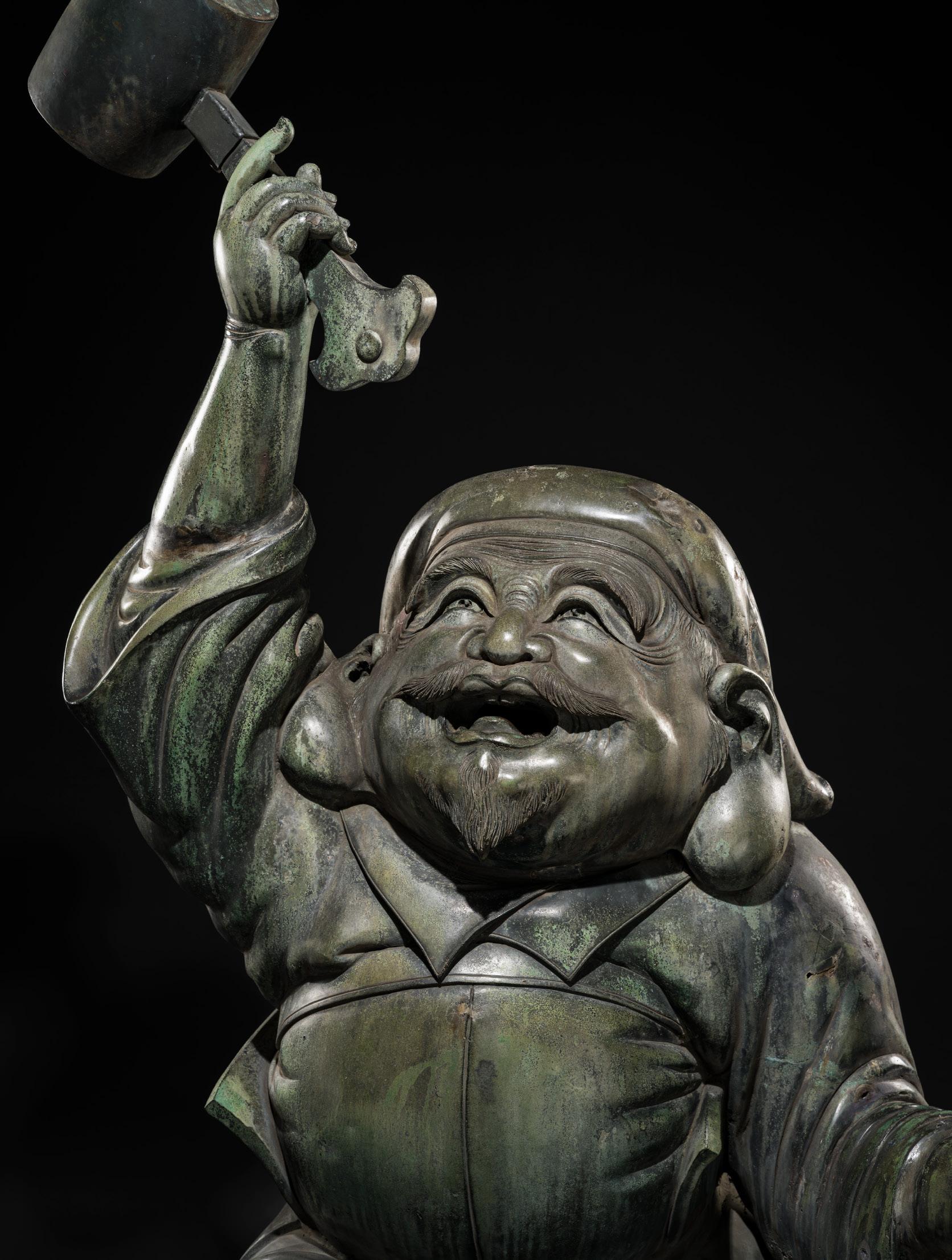
Friday, 5 December 2025

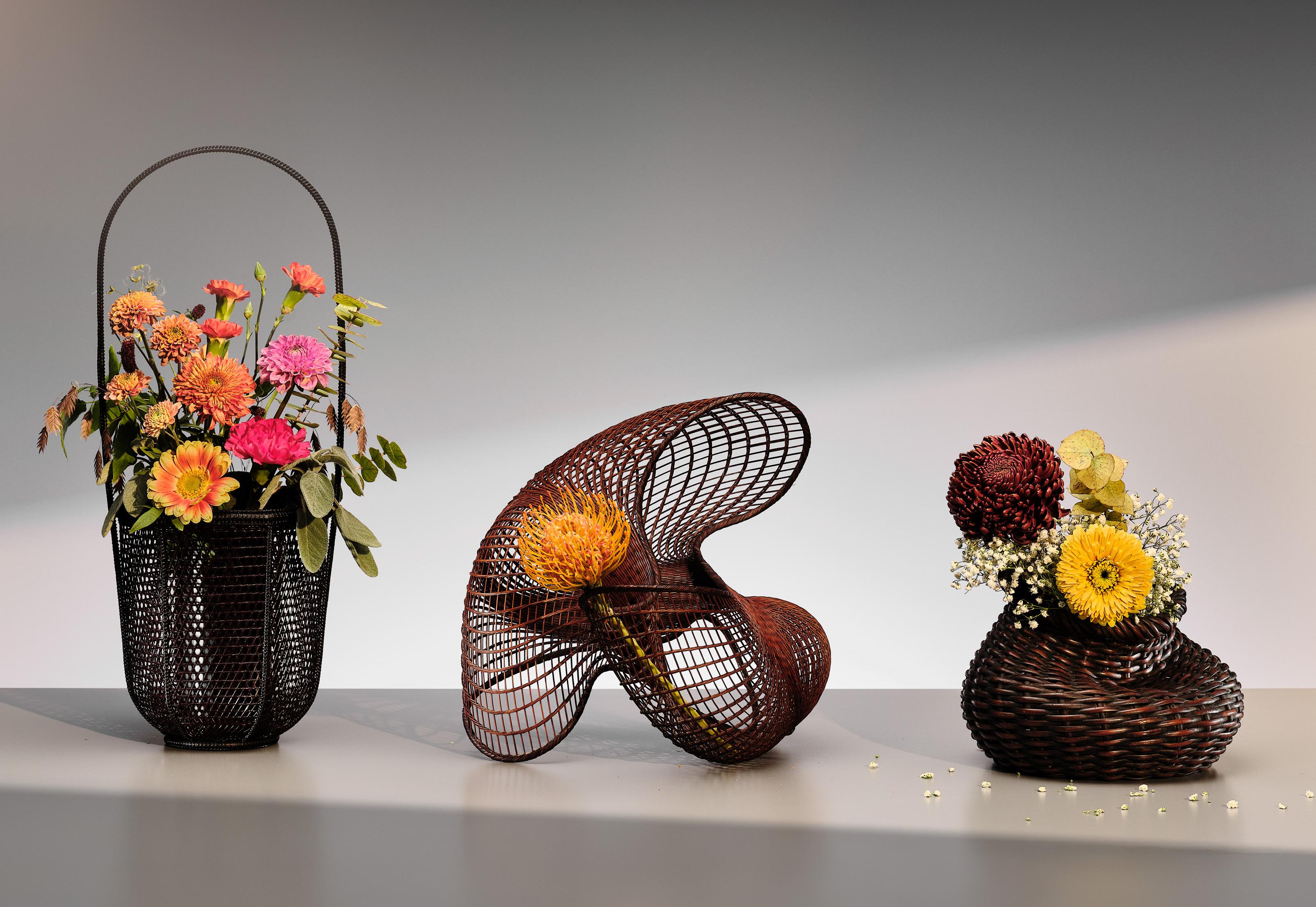
CATALOG JPN1225


Friday, 5 December 2025


CATALOG JPN1225
Friday, 5 December 2025, 10 am CET
Attend in person at our new auction room at Zelinkagasse 6 or participate online via Zacke Live – and enjoy premium buyer’s terms with no additional online bidding fees
Register now: www.zacke.at
SESSION I Lots 1-360 Print Catalog
SESSION II Lots 361-600 Online Catalog
EXHIBITION
28 November - 4 December Monday – Friday 10 am – 6 pm as well as by appointment
GALERIE ZACKE
Zelinkagasse 6
1010 VIENNA AUSTRIA
Tel +43 1 532 04 52 E-mail office@zacke.at
www.zacke.at
According to the general terms and conditions of business of Galerie Zacke Vienna, Founded 1968, SZA Versteigerungen & Vertriebs GmbH, 1010 Wien, online at www.zacke.at
ABSENTEE BIDDING
Absentee bids are carried out under the regulations of the terms of business of Galerie Zacke, SZA Versteigerungen & Vertriebs GmbH, which requires written submission of your purchase limit. Orders without purchase limits cannot be processed. Only the submitted lot number of the auction lot is binding for the processing of the absentee bid. The place of jurisdiction is Vienna, Austrian Law and Austrian jurisdiction are exclusively applicable for all legal questions arising from the business relationship. Absentee bids for this auction will be accepted until the day of auction by 10:00 a.m. We regret that absentee bids received after the time stated above will not be processed until after the auction.
PLEASE SEND ABSENTEE BIDS FOR THIS AUCTION TO:
Fax: +43 1 532 04 52 20 or Email: office@zacke.at or Mail: Galerie Zacke, Zelinkagasse 6, 1010 Wien, Austria, Europe
WE ACCEPT THE FOLLOWING METHODS OF PAYMENTS:
• Cash
• Certified or personal check
• Bank transfer (please inquire to receive our bank account information)
• Credit card (Visa, MasterCard, Amex) up to EUR 5.000 - higher amounts require prior approval and are subject to service fees
TELEPHONE BIDDING
It is generally possible to bid by telephone during the auction. Please fill out the absentee bidding form enclosed in this catalog and include your telephone number at which you can be reached during the auction. In the “bid in euro” column please write “TEL” and then send us the completed absentee bidding form. Galerie Zacke will call you on the day of the auction, on the telephone number provided, 5 lots before the lot you are bidding on and the bidding will commence at the starting price, as stated in the catalog. If Galerie Zacke cannot reach you during the auction, Galerie Zacke will bid the starting price on your behalf.
ESTIMATES AND STARTING PRICES
The auction will begin with the starting price and written bids will be accepted only with a minimum amount equivalent to the starting price.
For domestic shipping Galerie Zacke (hereinafter called “the company”) charges in average Eur 15,- to Eur 50,- per item, depending on size and weight. These fees cover the costs of packing and shipping. Fees for bulky or fragile items, or international shipping will be quoted upon request.
The purchased goods are transported at the risk of the customer following handover of the packaged item to the post office or another carrier which the customer agrees to through his/her submission of the purchase order. According to the specific wish of the customer, the auctioned goods may be insured for the value of the purchase price (highest bid and all surcharges). This insurance fee is 3% of the purchase price. For any lots with a purchase prices exceeding EUR 350,- the transport insurance will be automatically arranged by the company if it does not expressively receive the purchaser’s written denial of this service and signed waiver of claims. Payments due to the company under the insurance contract will be charged to the customer. The company is also entitled to assign claims under the insurance contract to the customer providing the terms of the insurance contract do not prevent this.
In any case, the company is only required to make payment to the customer specifically if payment has effectively been received from the insurance company.
Auction lots will be exhibited for viewing prior to the auction, thus offering all interested customers the opportunity to examine the quality and condition of the works exhibited. The catalog illustrations are intended to assist customers during such preview.
In illustrations, printed colors do not correspond exactly to the originals. The printed catalog images are not representative for the condition of the illustrated pieces. Hidden flaws and damages are indicated in the condition report. The illustrations in our online catalogs can be strongly magnified, so that most damages and restorations are well recognizable.
Some items in this catalog may for example consist of ivory, rhinoceros-horn, tortoise shell, or some types of tropical wood, and are subject to the Convention on International Trade in Endangered Species of Wild Fauna and Flora [CITES]. Such items are marked with the symbol Ɏ on www.zacke.at and may only be exported outside the European Union after an export permit in accordance with CITES has been granted by the Austrian authorities. We would like to inform you that such licenses are typically not granted.
COMPLAINTS
At its auctions, Galerie Zacke sells consigned lots on behalf of third-party consignors. For this reason, any complaints related to purchased lots must be in accordance with §32-48 of the general terms and conditions of business of Galerie Zacke, which can be found on www.zacke.at
THE ART LOSS REGISTER
All items starting above EUR 2,000 have been checked by the Art Loss register.

HOW TO FIND OUR NEW AUCTION & SHOWROOM
ZELINKAGASSE 6
Easily accessible by public transport or car (a parking garage is located nearby).
By Public Transport: SCHOTTENRING station (U2, U4, tram lines 1, 31, 71, D, and bus 3A)

produziert gemäß Richtlinie Uz24 des Österreichischen Umweltzeichens, Print Alliance HAV Produktions GmbH, UW-Nr 715
PLEASE RAISE MY BID BY ONE BIDDING INCREMENT (ca. 10%) IF NECESSARY
IMPORTANT NOTICE:
Bids do not include buyer’s premium and VAT. Margin taxation applies. Items with added VAT are marked in the online catalog.
TELEPHONE BIDS:
BIDDING FORM
FOR THE AUCTION Fine Japanese Art JPN1225 ON DATE 5 December 2025
PLEASE CALL ME WHEN A HIGHER BID THAN MINE HAS BEEN RECEIVED
MY PHONE NUMBER
If you like to bid by telephone, please state ‘TEL’ in the ‘BID IN EURO’ column instead of a Euro amount. Galerie Zacke will call you on the day of the auction, on the telephone number provided, 5 lots before the lot you are bidding on and the bidding will commence at the starting price, as stated in the catalog. If Galerie Zacke cannot reach you during the auction, Galerie Zacke will bid the starting price on your behalf.
TERMS OF PAYMENT, SHIPPING AND COLLECTION:
NAME
ADRESS
CITY, COUNTRY
POSTCODE
PHONE NUMBER
CREDIT CARD PAYMENT
PLEASE CHECK THE DESIRED CARD
COLLECTION BY CLIENT WITH PAYMENT ON THE PREMISES IN CASH, BY CERTIFIED CHEQUE OR CREDIT CARD
INVOICE PAYMENT
VIA BANK WIRE AFTER RECEIPT OF INVOICE SHIPPING AFTER RECEIPT OF PAYMENT
EXPRESS PARCEL SERVICE
REQUIRED (ACCORDING TO TERMS AND CONDITIONS OF GALERIE ZACKE)
SHIPPING INSURANCE
REQUIRED (ACCORDING TO TERMS AND CONDITIONS OF GALERIE ZACKE)
GALERIE ZACKE
Zelinkagasse 6, 1010 Vienna, Austria
Email: office@zacke.at
Tel: +43-1-532 04 52
Fax: +43-1-532 04 52 20
With the signature on this form, the client instructs the auctioneer to bid on his behalf. The Euro amount up to which the auctioneer shall bid on behalf of the client is either stated in this form or will be communicated to the auctioneer via telephone during the auction. All absentee bidding shall be governed by the terms and conditions [AGB] of Galerie Zacke. The client agrees with his signature that he has read, understood and fully accepted the AGB of Galerie Zacke. Galerie Zacke, founded 1968, is a registered brand of SZA Versteigerungen & Vertriebs GmbH, Vienna, Austria.
NAME
ADDRESS CARD NUMBER
EXPIRY DATE
IMPORTANT NOTICE:
Whenever making a bid, whether personally or via an agent, in writing, online, telephone, or in any other way, the bidder fully and unconditionally accepts the Terms of Auction, the ‘Important Information’ section in the auction catalog, the Terms and Conditions (AGB) of Galerie Zacke, §1-48, the Fee Tariff, and the Bidding Increments table, all as published on www.zacke.at on the day of the auction.


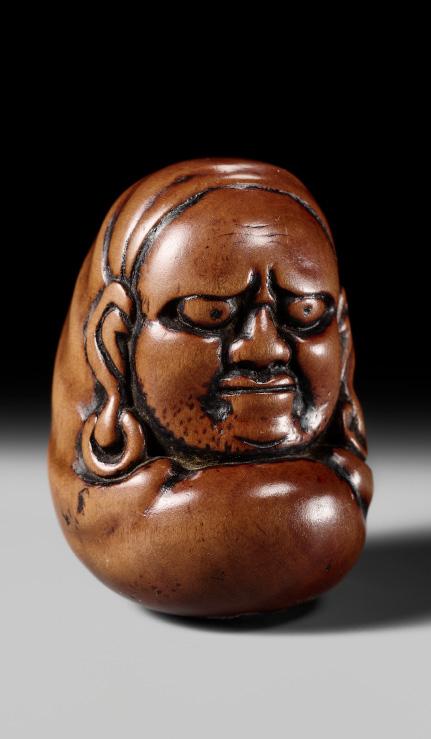



IMPRINT
Publisher Galerie Zacke
founded 1968 © SZA Versteigerungen & Vertriebs GmbH 1010 Wien
Zelinkagasse 6 Austria, Europe
Tel (0043-1) 532 04 52
Email: office@zacke.at
Editors

Catalogers
Assistance
Photography
Design
Printing
GmbH Website www.zacke.at © GALERIE ZACKE Reproduction forbidden
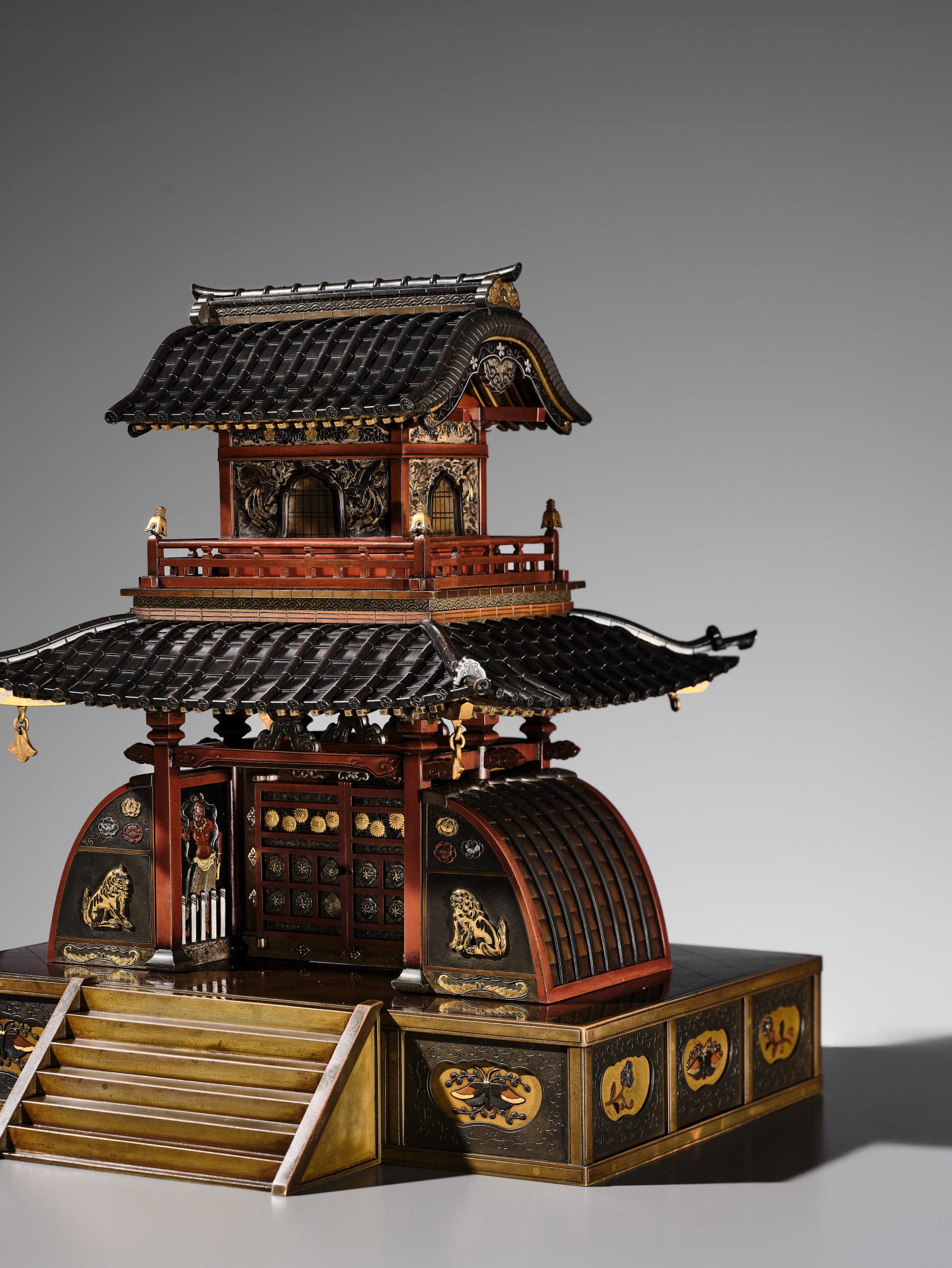


1 GENRYUSAI SEIYA: A HUMOROUS AND LARGE BRONZE OKIMINO OF A SARUMAWASHI WITH MONKEY
By Genryusai Seiya, sealed Dai Nihon Genryusai Seiya zo Japan, Meiji period (1868-1912)
Finely modeled as a monkey trainer seated upon a rock, holding in his right hand a long pole upon which a monkey playfully climbs, bending it under its weight. In his left hand, he grasps a rope tied to the same monkey. The base behind the rock with a seal mark Dai Nihon GENRYUSAI SEIYA zo [Made by Genryusai Seiya, Great Japan].
HEIGHT 51.5 cm
WEIGHT 9.8 kg
Condition: Excellent condition. The rope is a later replacement. Genryusai Seiya was a master craftsman in charge of a workshop specializing in export wares of the highest quality. He was well known for naturalistic animal bronzes. This bronze model of a sarumawashi is a rare example of his figurative sculpture.
Estimate EUR 4,000
Starting price EUR 2,000
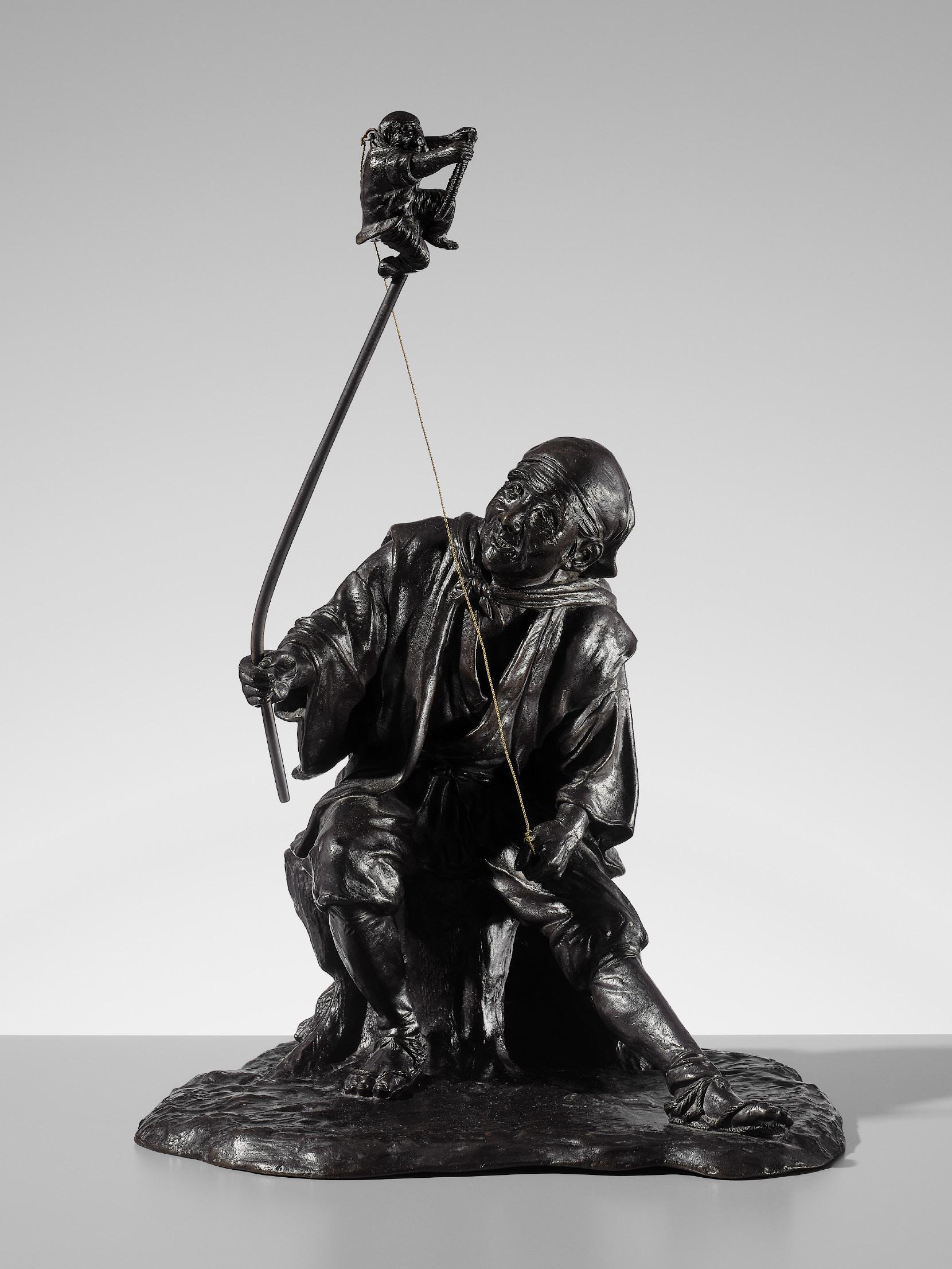
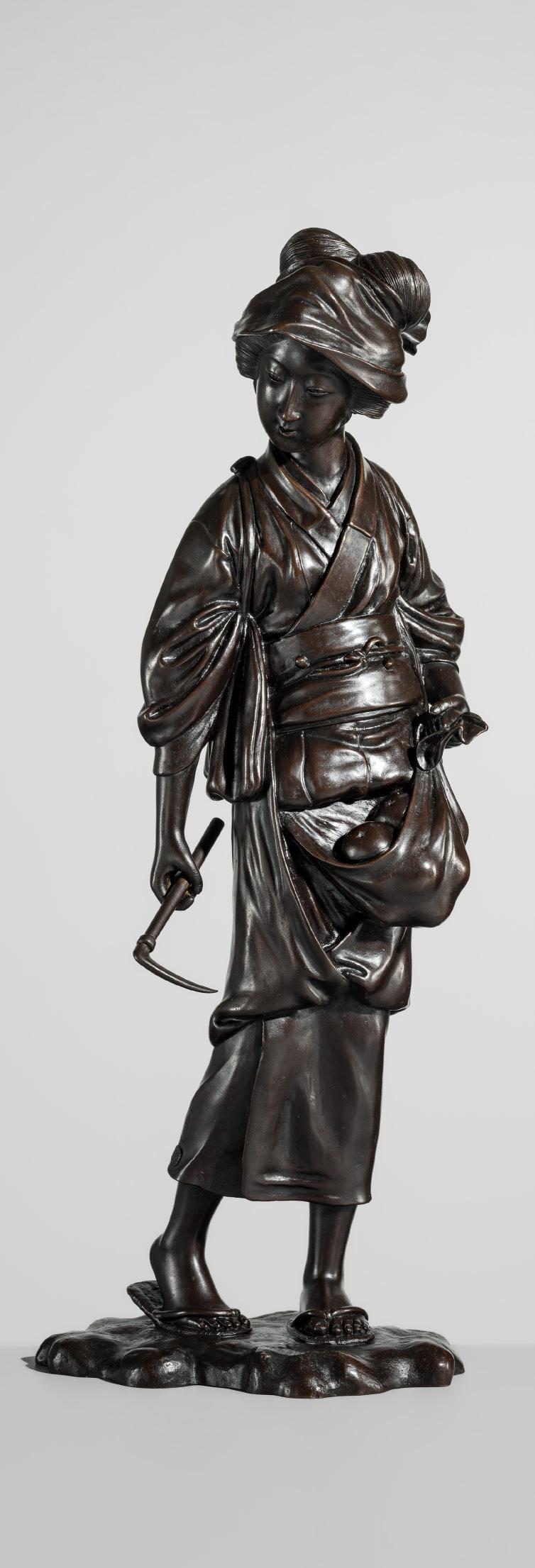

2
ATSUYOSHI FOR THE MARUKI COMPANY: A SUPERB TOKYO SCHOOL BRONZE OKIMONO OF A BIJIN
By Miyabe
Atsuyoshi for the Maruki Company, signed Atsuyoshi saku and marked Maruki sachu sei Japan, Meiji period (1868-1912)
Finely cast and naturalistically modeled, this figure portrays a young beauty in rustic attire, poised mid-step upon an irregular naturalistic base. Her head is gently turned to the side, her expression serene and contemplative. She wears layered robes tied with a sash, the crisply chased folds cascading in naturalistic drapery. In her right hand she holds a small curved sickle, while at her waist hangs a satchel brimming with pomegranates. Her hair is neatly arranged beneath a headscarf, and her delicately modeled features are polished to a soft sheen. Signed to the lower edge of the robe ATSUYOSHI saku [made by Atsuyoshi], with a raised square seal Maruki shachu sei [manufactured by the Maruki company].
HEIGHT 46.5 cm
WEIGHT 5,488 g
Provenance: From the collection of Carl Oppermann, officer and captain of the Imperial Navy, acquired before 1917 and thence by descent.
Condition: Excellent condition with only minor wear and casting irregularities.
AUCTION
COMPARISON


Compare a closely related smaller Tokyo school bronze okimono of a fishergirl, signed Atsuyoshi and Maruki sei, 21 cm high, at Bonhams, Fine Japanese Art, 6 November 2012, London, lot 523 (sold for GBP 2,250 or approx. EUR 4,500 converted and adjusted for inflation at the time of writing). Compare a closely related smaller bronze portrait okimono of a bathing nude, 17 cm high, signed Atsuyoshi saku and Maruki sei, at Zacke, Fine Japanese Art, 16 June 2023, Vienna, lot 112 (sold for EUR 5,200).
Estimate EUR 3,000
Starting price EUR 1,500
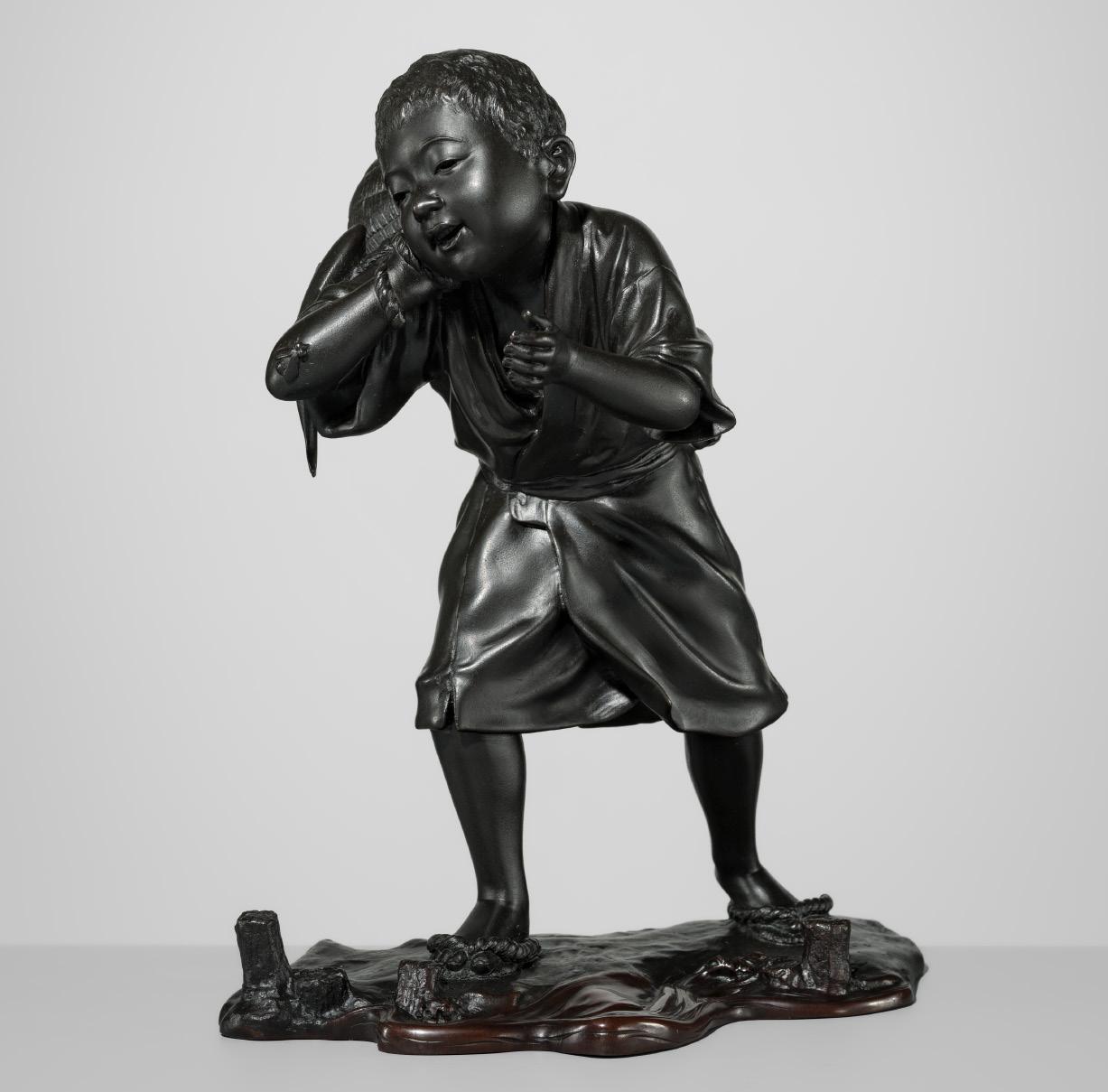

3
MASATSUNE: A CHARMING TOKYO SCHOOL BRONZE OKIMONO OF A BOY WITH A BASKET OF FISH
By Kyoi
Masatsune, signed Masatsune saku Japan, Meiji period (1868-1912)
Boldly cast and naturalistically modeled, this sculpture captures a lively moment of near-disaster: a young boy returning home with a heavy haul of freshly caught fish. A large woven basket brimming with his catch hangs from his back, two slippery fish already on the verge of falling. Just as a tiny fly lands on his bare elbow, he glances toward it in surprise - his straw sandal slipping beneath him. In the next instant, he seems certain to stumble forward and spill his precious load. The boy wears a short, tied kimono, its crisp folds finely chased and softly polished, the garment neatly belted at the waist. Signed to the base MASATSUNE saku [made by Masatsune].
HEIGHT 31.2 cm
WEIGHT 4,687 g
Condition: Excellent condition with minor wear and casting irregularities.
Kyoi Masatsune (active late 19th to early 20th century, Yokohama) was a Japanese bronze sculptor known for superbly cast and finished bronze okimono and animal figures during the Meiji era.
Estimate EUR 1,500
Starting price EUR 800

4
A VERY LARGE BRONZE FIGURE OF A CRANE
Japan, Meiji period (1868-1912)
Naturalistically and expertly cast as a crane standing with long slender legs, outstretched wings and an open beak. The body is worked in layered feather patterns, each finely detailed to suggest texture, while the neck is elegantly curved.
HEIGHT 107 cm
WEIGHT 22.8 kg
Condition: Good condition with minor wear and casting irregularities. Small loss to the tail, one nail and neck, few scattered nicks and surface scratches.
With an associated European marble base.
AUCTION COMPARISON
Compare a related bronze figure of a crane, dated to the Meiji period, 97.9 cm (high), at Christie’s, Christie’s interiors, 5 February 2013, London, lot 289 (sold for GBP 4,000 or approx. EUR 7,500 converted and adjusted for inflation at the time of writing).

Estimate EUR 3,000
Starting price EUR 1,500
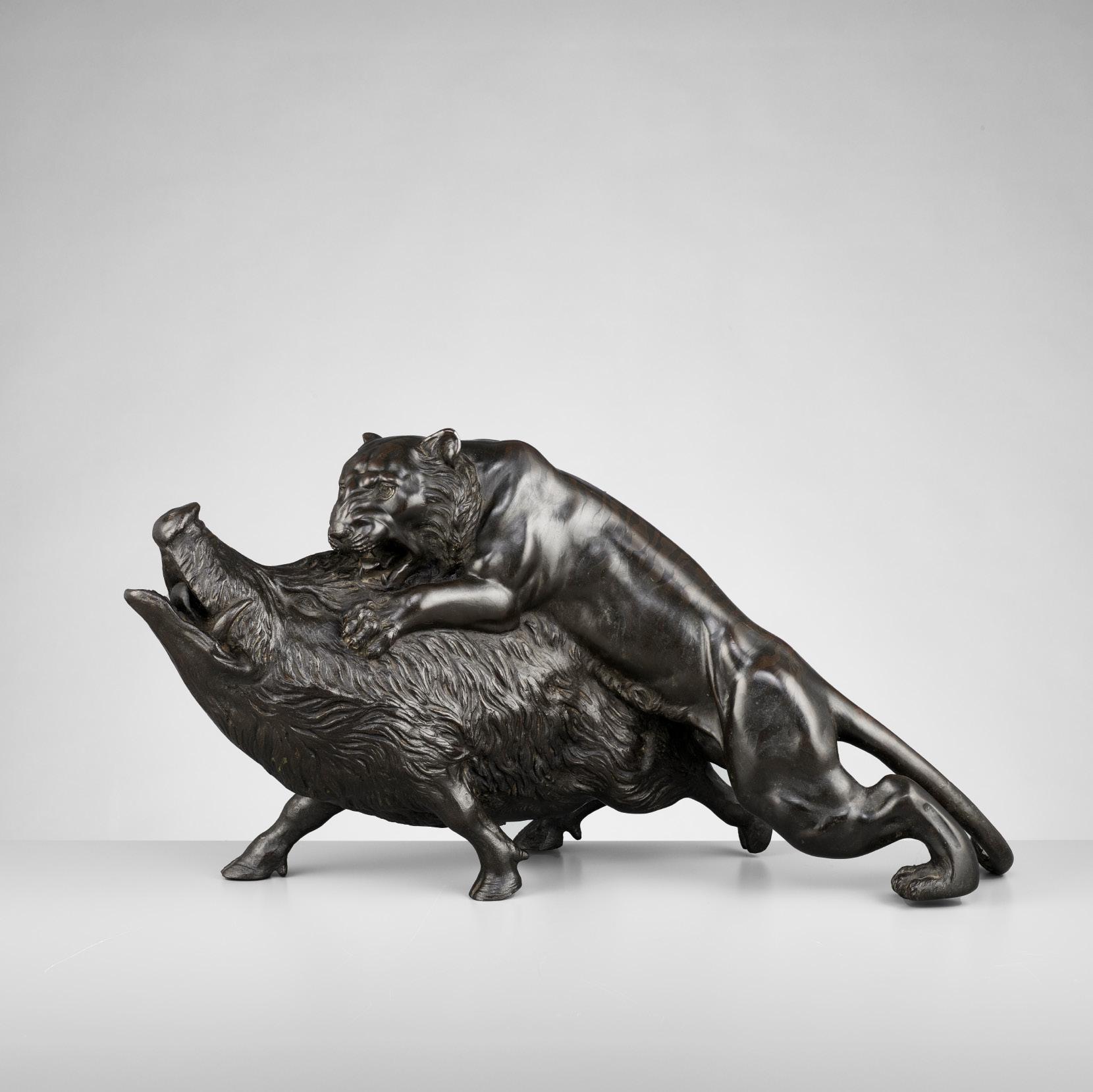
GENRYUSAI SEIYA: A TIGER AND BOAR BRONZE
By Genryusai Seiya, signed Dai Nihon Genryusai Seiya Japan, Meiji period (1868-1912)
The large and massive statue captures the rare moment, when a tiger dares to attack a wild boar from the back. Typically, both animals avoid each other, as they are physically more or less equal combatants. Impressed seal mark “Dai Nihon Genryusai Seiya” to base. Note the fine detail to the fur of both animals, including various types of incision and relief work.
LENGTH 55 cm
WEIGHT 9.9 kg
Condition: Excellent condition with some wear, mostly to base of feet, and very minor traces of use. The patina has grown into a deep bronze, almost black color with an unctuous finish.
Estimate EUR 2,500 Starting price EUR 1,200

MARUKI: A FINE PORTRAIT BRONZE OKIMONO OF A HORSE
By the Maruki company, sealed Maruki shachu seisaku Japan, Meiji period (1868-1912)
Very finely cast as a richly caparisoned horse, the figure conveys a strong sense of movement, its flowing mane and sweeping tail naturalistically modeled and enhanced with delicate incised details. The muscular body is masterfully rendered, with subtly raised veins in low relief contributing to the lifelike realism of the bronze. The saddle, adorned with the aoi (hollyhock) crest of the Tokugawa family, along with the crisply cast reins, further attest to the sculptor’s exceptional craftsmanship. The underside of the belly bears the seal MARUKI shachu seisaku [manufactured by the Maruki Company].
LENGTH 36 cm
WEIGHT 5,058 g
Condition: Excellent condition with only very minor expected wear.
The Maruki Company was active during the Meiji Period (18681912) in Japan, they stand out for the quality and weight of their okimono and are known for producing fine bronzes of animals.
AUCTION COMPARISON
Compare a closely related okimono of a horse, by Miyabe Atsuyoshi for the Maruki company, 37 cm long, at Zacke, Asian Art Discoveries, 20 January 2023, Vienna, lot 1099 (sold for EUR 6,500).
Estimate EUR 3,000
Starting price EUR 1,500


7 KAKUUNSAI: A RARE AND CHARMING BRONZE OKIMONO OF A HARE
By Kakuunsai, signed Kakuunsai Japan, 19th century, late Edo period (1615-1868) to Meiji period (1868-1912)
Heavily cast and naturalistically modeled to depict a hare poised in attentive repose, ready to bound forward. Its plump body, rendered with meticulously incised fur, extending into a small, pointed tail. The head, slightly tilted to the left and raised, finely detailed, with almond-shaped eyes, a well-defined snout, and two long ears gracefully falling along the back of the animal. The bronze surface exhibiting a dark, naturally grown patina. Signed to the underside KAKUUNSAI.

LENGTH 18.5 cm
WEIGHT 1,818 g
Condition: Excellent condition with only minor wear and casting irregularities.
AUCTION COMPARISON
Compare a closely related bronze model of a hare, dated Edo period, 20.3 cm long, at Bonhams, Fine Japanese Works of Art, 25 March 2010, New York, lot 2231 (sold for USD 5,490 or approx. EUR 7,000 converted and adjusted for inflation at the time of writing).
Estimate EUR 2,000
Starting price EUR 1,000

8
SUIUN: A FINE SMALL BRONZE OKIMONO OF A TORTOISE
By Suiun, sealed Suiun Japan, Meiji period (1868-1912)
Naturalistically cast, standing foursquare with its head slightly raised and tilted to the left, its carapace and scaly skin meticulously rendered. The bronze patinated to an unctuous black finish. Sealed to the underside SUIUN.
LENGTH 3.8 cm
WEIGHT 83.8 g
Condition: Good condition with minor wear and casting irregularities. Tiny losses to the ends of the claws.
Estimate EUR 1,500
Starting price EUR 800

MASAMITSU: AN IMPRESSIVE SILVER-PATINATED BRONZE OKIMONO OF TWO CRANES ON A ROCK
By
Masamitsu (Shoko), sealed Masamitsu saku Japan, Meiji period (1868-1912)
Naturalistically cast in three sections as a pair of cranes (tsuru) standing upon a rugged rock base, one bird bending forward while the other stands tall with its head raised and beak open in mid-call, both with shakudo eyes. The bronze is finely detailed with meticulously chiseled plumage and patinated to a lustrous silver finish, the tail feathers and neck are executed in shakudo. The finely cast rock base is detailed with shrubs and sasa bamboo leaves. Sealed underneath within a rectangular cartouche MASAMITSU saku [made by Masamitsu].
HEIGHT 56 cm
WEIGHT 6,919 g
Condition: Very good condition with minor wear to the silver patination and light typical traces of use throughout.
AUCTION COMPARISON
Compare a closely related pair of silver bronze okimono of cranes, 33 cm (high), at Bonhams, Asian Art, 1-11 April 2024, Skinner Marlborough, lot 37 (sold for USD 4,352 or approx. EUR 3,900 converted and adjusted for inflation at the time of writing).
Estimate EUR 2,000
Starting price EUR 1,000

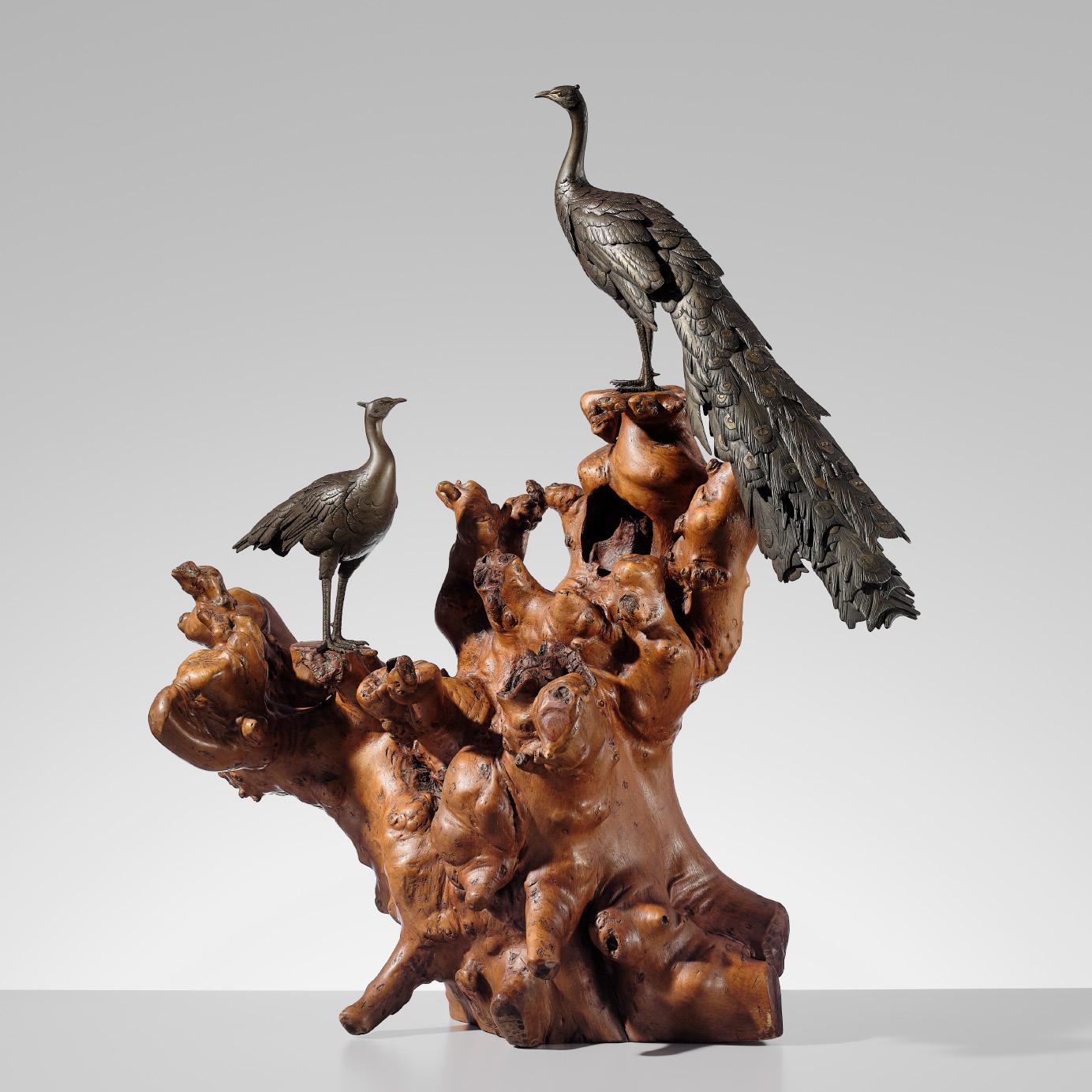
10
SEIYA: A LARGE BRONZE OKIMONO OF TWO PEACOCKS ON A BURLWOOD STUMP
Workshop of Genryusai Seiya, sealed Seiya chu Japan, Meiji period (1868-1912)
Each bronze cast separately, naturalistically modeled as a peacock and a peahen mounted together on a burlwood base. The peacock is positioned higher, its long tail feathers finely chiseled and flowing downward, while the peahen stands below, gazing upward toward its mate. Both are rendered with great attention to detail, from the subtle texture of the plumage to the sharply defined talons gripping the wood. Sealed underneath the larger peacock within a rectangular cartouche SEIYA chu [cast by Seiya].
HEIGHT 85.5 cm
WEIGHT 29.4 kg
Condition: Good condition with typical wear. The bronze with manufacturing irregularities, losses to one beak, crest and to the tips of the feathers. The wood with natural flaws and age cracks. Overall presenting very well.
Genryusai Seiya was a master craftsman in charge of a workshop specializing in export wares of the highest quality. Production included human genre figures, vases and exotic bronze models of animals probably influenced by the opening of Tokyo Zoological Gardens in 1882. The present piece is a brilliant example of Seiya’s naturalistic bronzes.
AUCTION COMPARISON
Compare a closely related bronze model of a pheasant by the same artist, sealed Genryusai Seiya zo, dated to the Meiji period (1868-1912), 52 cm (long), at Christie’s, Chinese & Japanese Art, 15 May 2008, London, lot 32 (sold for GBP 9,375 or approx. EUR 18,000 converted and adjusted for inflation at the time of writing).
Estimate EUR 3,000
Starting price EUR 1,500

A FINE BRONZE OKIMONO OF A HAWK PERCHED ON A TREE TRUNK
Japan, Meiji period (1868-1912)
The majestic bird of prey naturalistically cast, standing alert on one leg while the other IS gracefully raised against its body, poised with a fierce expression, with its head slightly turned to the left. The wings and plumage exquisitely detailed, with the beak and talons gilt. The claws grip a separately cast, gnarled tree trunk, whose surface is masterfully rendered to suggest the rugged texture of the bark.
HEIGHT 18.2 cm (hawk) and 31.8 cm (total)
WEIGHT 911 g (hawk) and 2,676 g (total)
Provenance: From the Alan Bostock collection of Japanese metalwork and cloisonné, assembled over the last 40 years.
Condition: Very good condition with minor wear and casting irregularities. Few minor nicks and light surface scratches. One leg slightly loose.
AUCTION COMPARISON
Compare a related bronze model of a hawk, signed Yoshitani, Meiji period, late 19th century, 42.2 cm high overall, at Christie’s, Japanese and Korean Art, 19 September 2000, New York, lot 93 (sold for USD 5,875 or approx. EUR 9,500 converted and adjusted for inflation at the time of writing).
Estimate EUR 3,000
Starting price EUR 1,500



12
NOGAMI RYUKI: A SUPERB BRONZE OKIMONO OF A MINOGAME AND YOUNG
By Nogami Ryuki (Nogami Tatsuoki, 1865-1932), signed Ryuki Japan, early 20th century, Meiji period (1868-1912) to Taisho period (1912-1926)
The mythical tortoise with a long bushy tail swept to one side with gold patinated tips hanging over the naturalistically cast and patinated mossy rockwork base it proudly stands on, above goldinlaid lichens, its offspring clambering on its carapace, both finely detailed with the shells and pebbly skin realistically rendered. The large tortoise signed on the underside RYUKI and sealed on the rock RYUKI tsukuri shirusu [made by and with the seal of Ryuki].
The wood storage box inscribed Iwao no ue kame (ganjo no kame), okimono, Koson [a turtle on a rock, okimono (in the collection of) Koson].
HEIGHT 25.8 cm, LENGTH 38.5 cm
WEIGHT 6,073 g
Condition: Very good condition with minor wear and casting irregularities, few nicks and scratches.
The minogame is a mythical turtle, often depicted with the head of a dragon. It is said to live for over a thousand years, with a long, hairy tail made of seaweed and algae that have grown on its shell due to its old age, symbolizing longevity and wisdom. The perhaps most famous minogame appears in the legend of Urashima Taro, in which the hero rescues a sea turtle from tormenting children and is rewarded with a journey to Ryugu-jo, the palace of the Dragon King, under the sea.
Nogami Tatsuoki (1865-1932), art name Nogami Ryuki, studied at the Tokyo School of Fine Arts under one of the most notable metal craftsmen of the Meiji era, Oshima Joun (1858-1940). His work was exhibited widely including the Paris Great Exhibition in 1900. Ryuki was best known for his bronze figures of tortoises. He worked for the Imperial Household Agency and was mentioned in a 1910 article on metalwork entitled Japanese Art and Artists of Today.
Compare a closely related bronze okimono of a pair of minogame on a rock, signed Ryubi and dated to the Meiji period, 24.7 cm high, at Bonhams, Fine Japanese Works of Art, 19 March 2014, New York, lot 3299 (sold for USD 5,625 or approx. EUR 6,815 converted and adjusted for inflation at the time of writing).
Estimate EUR 3,000
Starting price EUR 1,500


Japan, Meiji period (1868-1912)
Imposingly cast, of trumpet form with a six-lobed flared rim, its walls richly decorated in high relief with naturalistic irises (shobu) rising from marshy banks. The tall stems twist upward, their magnificent blossoms unfurling with finely chased petals in varying stages of bloom. At the base, a sculpted bird perches among reeds, poised above rippling water rendered in sinuous lines that circle around the foot.
HEIGHT 52.5 cm
WEIGHT 12 kg
Provenance: Galerie Koller, Asiatica, 24 September 2005, Zurich, lot 316. Private collection, Switzerland, acquired from the above. Condition: Very good condition with minor wear and casting irregularities. One tiny chip to the edge of one leaf and some light nibbling to edges throughout.
AUCTION COMPARISON

Compare a related bronze vase with bird of prey, dated to the Meiji period, 62 cm high, at Bonhams, British and European Ceramics, Glass & Asian Art, 17 October 2012, Oxford, lot 372 (sold for GBP 2,500 or approx. EUR 5,000 converted and adjusted for inflation at the time of writing).

Compare a related bronze vase with foliage, dated to the Meiji period, 77 cm high, at Christie’s, The Decorative Arts Sale incl. Fine Paintings, 27 March 2013, Paris, lot 419 (sold for EUR 4,375 or approx. EUR 5,500 adjusted for inflation at the time of writing).
Estimate EUR 4,000
Starting price EUR 2,000
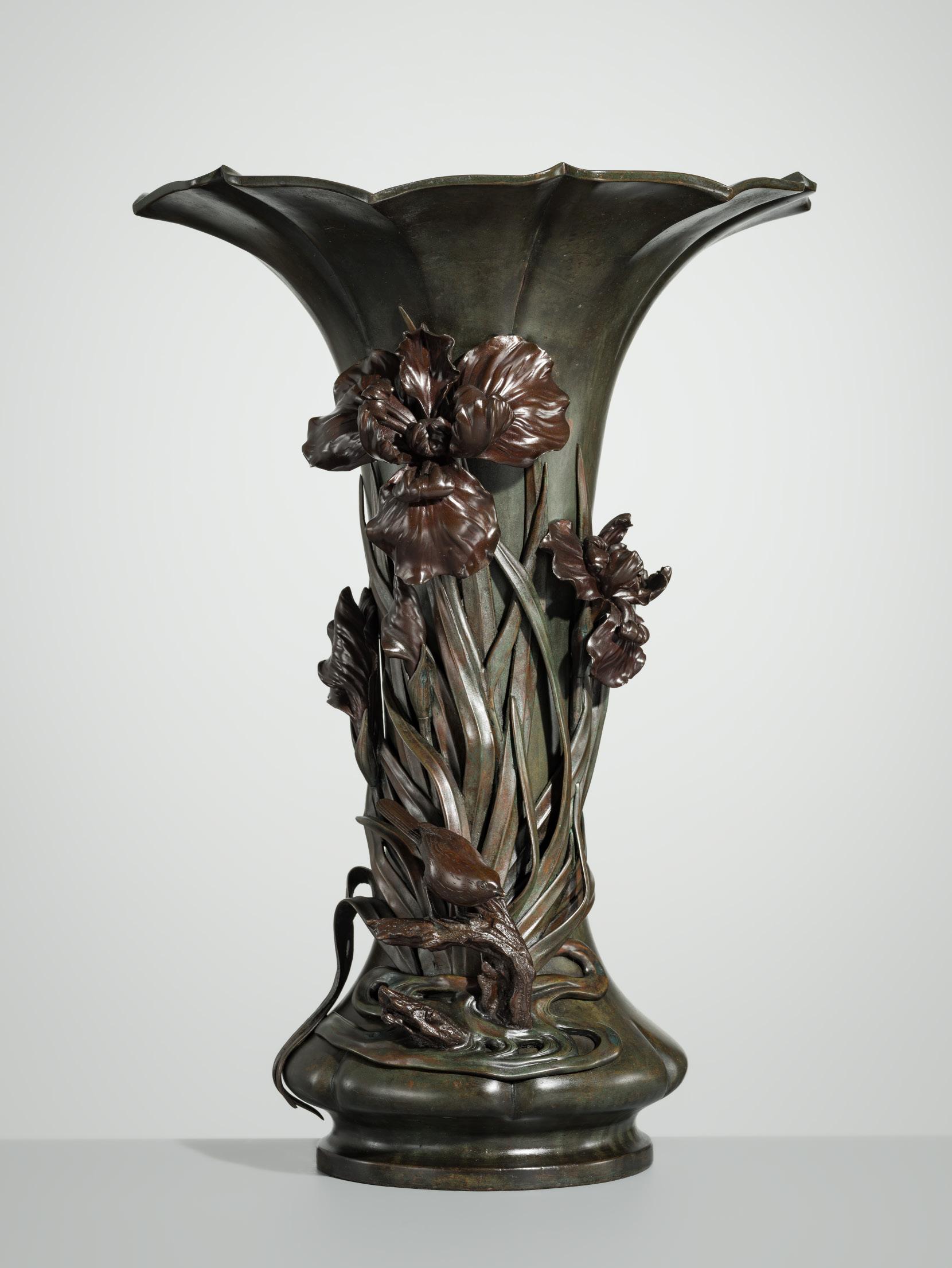

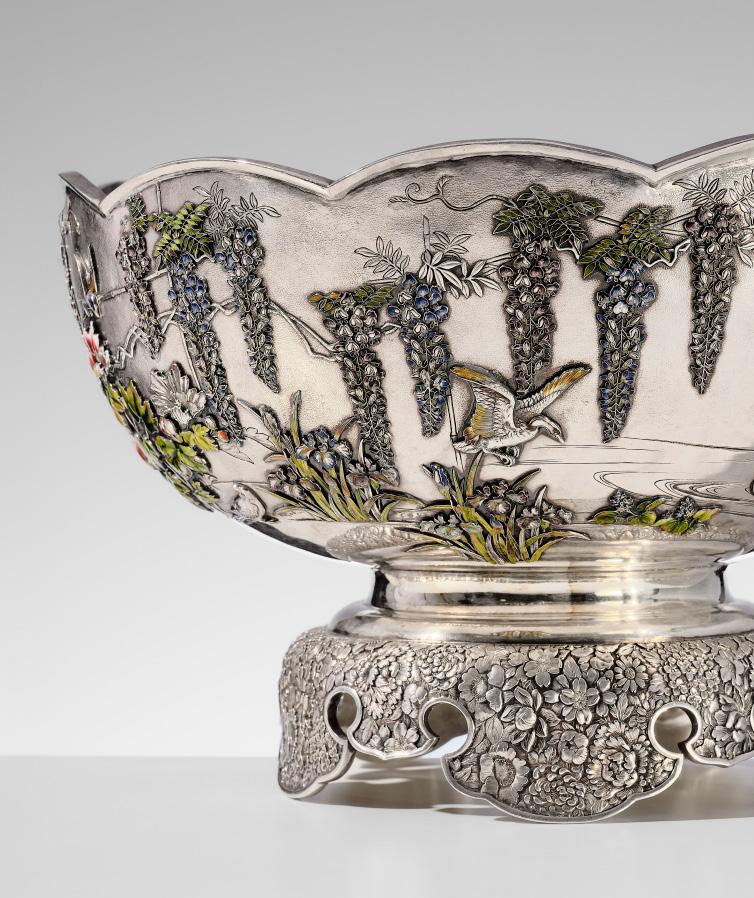
14
TOUNSAI MASAKATSU: AN IMPRESSIVE AND LARGE CLOISONÉ ENAMELED SILVER PUNCH BOWL
By Tounsai Masakatsu, signed Tounsai Masakatsu koku Japan, Yokohama, c. 1890s, Meiji period (1868-1912)
The large lobed bowl with a scalloped rim supported on lobed feet applied with millefleur takabori, the main body masterfully worked in further silver takabori with vibrant enameling depicting a variety of birds including pheasants, sparrows, ducks, and geese amongst beautifully blooming flowers including irises, chrysanthemums and wisteria. Signed underneath within a gilt reserve TOUNSAI MASAKATSU koku [engraved by Tounsai Masakatsu].
HEIGHT 21.2 cm, DIAMETER 33.2 cm
WEIGHT 1,268 g
Provenance: From a private collection in Switzerland. Condition: Very good condition with minor expected surface wear and tiny non-distracting losses to enamels.
AUCTION COMPARISON
Compare a closely related smaller silver and enamel footed bowl, signed Komei/ Mitsuaki koku, dated 1890s, 24 cm diameter, at Bonhams, Fine Japanese Works of Art, 19 March 2014, New York, lot 3225 (sold for USD 10,000 or approx. EUR 12,000 converted and adjusted for inflation at the time of writing).
Estimate EUR 8,000
Starting price EUR 4,000



TERUYOSHI:
By Teruyoshi (Shobi), signed Teruyoshi koku Japan, Yokohama, Meiji period (1868-1912)
Of typical form, the double doors applied with four hinges and two kiku-framed knops, pierced with a keyhole and with a lobed closing mechanism, all sides very finely incised in kebori and katakiribori with highlights in gold hirazogan, depicting various seasonal blossoms including chrysanthemums (kiku), cherry blossoms (sakura), peony (botan), and orchids. The top applied with a handle mounted with further kiku and suspending a cord with tassel, the interior revealing four plain wood drawers applied with silver kiku knops, and the two doors decorated with plump boys in a festive setting, one wearing a shsihimai mask and the other an Okina mask and holding a bell tree.
Signed to the side TERUYOSHI koku [engraved by Teruyoshi] and stamped underneath jungin [pure silver].
SIZE 11.5 x 13.7 x 15.4 cm
WEIGHT 1,485 g
Condition: Very good condition with minor wear and light scratches as are to be expected. The key is lost.
AUCTION COMPARISON
Compare a closely related small silver kodansu, unsigned, 11.6 x 12.9 x 11.6cm, dated to the late 19th century, at Bonhams, Fine Japanese Works of Art, 13 September 2011, New York, lot 2226 (sold for USD 2,500 or approx. EUR 3,000 converted and adjusted for inflation at the time of writing).
Estimate EUR 2,000
Starting price EUR 1,000


KATSUYOSHI FOR THE HATTORI COMPANY: A FINE SILVER BOX AND COVER
By Katsuyoshi (died 1934) for the Hattori company, signed Katsuyoshi sen and sealed with the Hattori company ‘swallow’ mark Japan, early 20th century, Meiji period (1868-1912)
Of rectangular shape supported on four bracket feet and with a flush-fitting cover, the silver surface superbly incised in fine katakaribori and kebori depicting an imposing pine tree to the cover, the small pinecones picked out in gold hirazogan, the sides showing further pine needles as well as falling cherry blossoms. The interior of plain wood. Signed to the cover KATSUYOSHI sen [engraved by Katsuyoshi] and stamped to the rim jungin [pure silver] and with the ‘swallow’ mark of the Hattori company.
SIZE 5.5 x 10 x 14.5 cm
WEIGHT 444 g
Condition: Very good condition with only very minor wear including a few light surface scratches.
Estimate EUR 1,500 Starting price EUR 800

17
YOSHIMASA: A FINE SILVER ‘COCKEREL’ VASE
By Yoshimasa, signed Yoshimasa koku and Kihodo Japan, Meiji period (1868-1912)
The pear-shaped body rises from a circular foot ring to a slender neck with a subtly flaring rim. The surface is finely worked in delicate katakiribori and kebori engraving to depict a rooster standing amid bamboo, gazing toward a flowing stream, with a hen positioned just behind the proud bird. Signed to the side YOSHIMASA koku [engraved by Yoshimasa], and to the underside KIHODO, with a stamped mark jungin [pure silver].
HEIGHT 18.6 cm
WEIGHT 204 g
Condition: Excellent condition with only very minor wear, light traces of use, light surface scratches, tiny nicks.
Estimate EUR 1,500 Starting price EUR 800
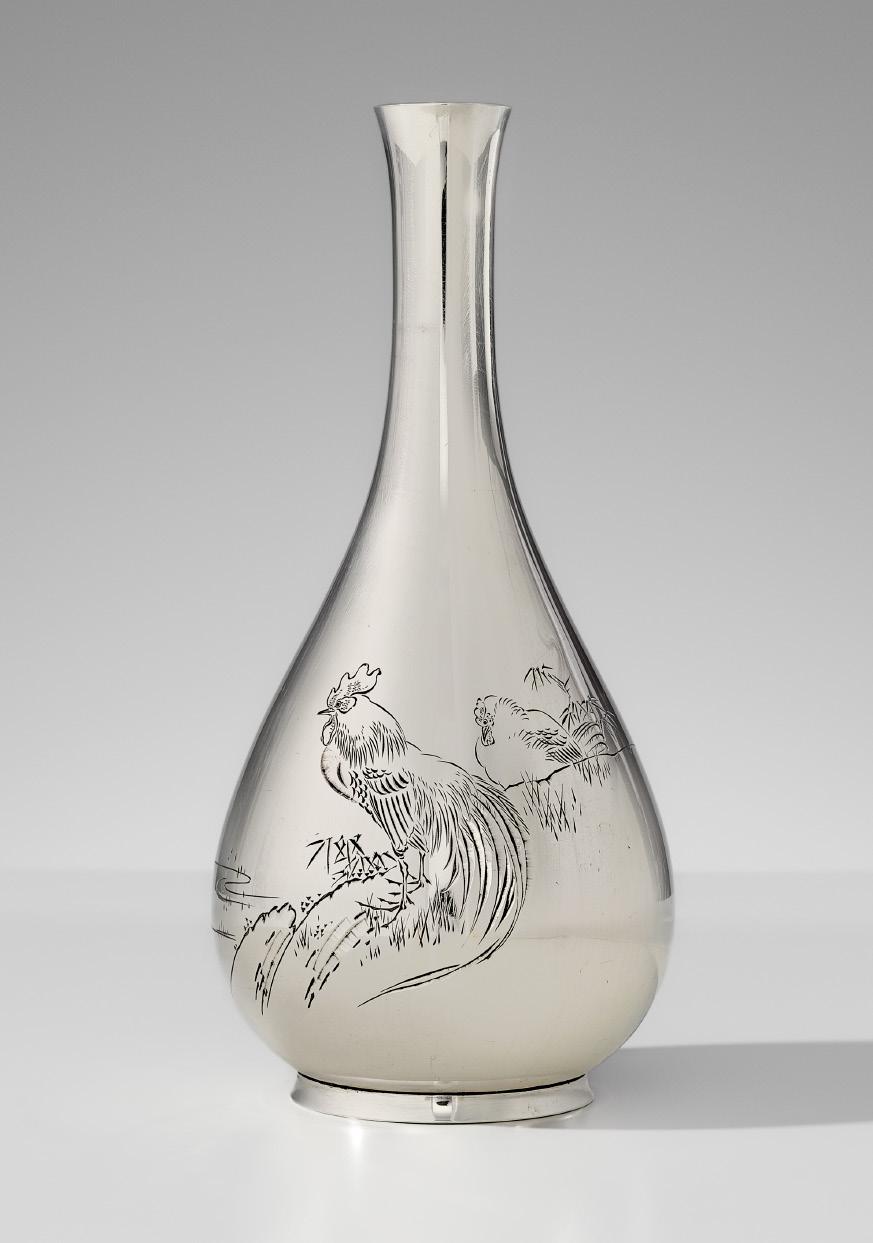
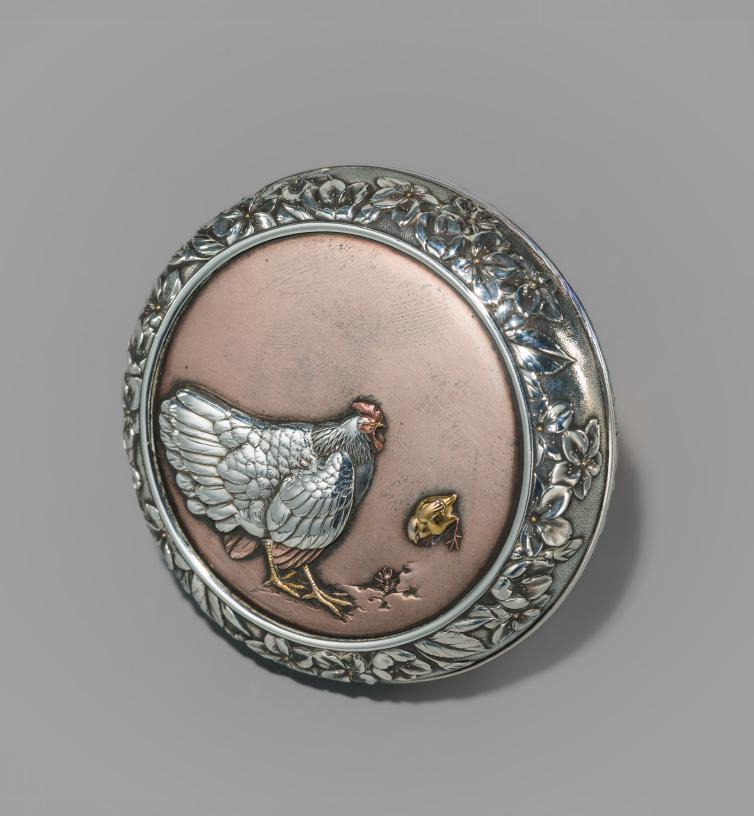

18
A FINE COPPER-INLAID SILVER INCENSE BOX (KOGO) AND COVER
By Hidetsugu, signed Hidetsugu koku Japan, Meiji period (1868-1912)
Of circular form, the silver box finely worked in takabori, the cover set with a large copper roundel, carefully inlaid in gold and silver takazogan to depict a large hen with meticulously rendered plumage beside her chick, gazing at a large ant emerging from a crevice. The sides minutely adorned with cherry blossoms and leafy stems. Signed to the underside HIDETSUGU koku [engraved by Hidetsugu].
DIAMETER 7.8 cm
WEIGHT 152.7 g
Condition: Very good condition with minor wear and manufacturing irregularities. Few minor nicks and light surface scratches.
Estimate EUR 1,500
Starting price EUR 800
19
HATTORI: A FINE SILVER AND SHAKUDO ‘CORMORANT FISHING’ YOJITATE (TOOTHPICK HOLDER)
By the Hattori company, stamped with the company mark Japan, late 19th century, Meiji period (1868-1912)
Finely crafted in the form of a two-handled wicker fish basket, with a shakudo cormorant perched on its braided rim and a silver oar diagonally applied to its side. Signed on the base with the Hattori company mark in the form of a flying swallow and stamped jungin [pure silver].
HEIGHT 4.9 cm, LENGTH 6 cm
WEIGHT 29.2 g
Condition: Very good condition with minor wear and typical manufacturing irregularities. Light tarnishing to silver. Few minor nicks and light surface scratches, mostly to the base, as is to be expected.
AUCTION COMPARISON
Compare a closely related silver and shakudo yojitate, by the Mitsukoshi company, Meiji period, 4.6 cm long, at Bonhams, Fine Japanese Art, 14 May 2015, London, lot 435 (sold for GBP 625 or approx. EUR 1,150 converted and adjusted for inflation at the time of writing).
Estimate EUR 1,500
Starting price EUR 800
Cormorant Fishing Boats on the Nagae River, by Kodo, Edo period, c. 1835-1838, in the Minneapolis Institute of Art, accession number P.75.51.156



20
KONOIKE: A THREE-PIECE SET OF JAPANESE EXPORT SILVER TEA AND COFFEE ‘BAMBOO’ SERVICE
By the Konoike Company, sealed Konoike 鴻池 Japan, Yokohama, c. 1900, Meiji period (1868-1912)
Comprising a teapot, milk ewer, and sugar box, each piece is finely crafted to imitate sections of bamboo, with naturalistic vertical ribbing and applied leaves in high relief encircling the bodies. The teapot and sugar box include flush-fitting lids surmounted by delicate bamboo shoot finials, while the handles are elegantly shaped as knotted bamboo stems. The interiors are smoothly polished. Each sealed to the underside KONOIKE.
HEIGHT 6.5-11.9 cm
WEIGHT 779 g (total)
By Ozeki Sadajiro for the Musashiya company, signed S.M Japan, Yokohama, c. 1900, Meiji period (1868-1912)
Formed as two chrysanthemum (kiku) sprigs, one issuing from the handle and terminating near the base with leafy foliage, the other a larger blossom forming the bowl of the spoon with fine gilt details. Signed underneath within a sunken cartouche S.M (Sadajiro Musashiya).
LENGTH 19.5 cm
WEIGHT 66 g
Condition: Excellent condition with only very minor wear.
Ozeki Sadajiro, operating under the trade name Musashiya, was one of the leading silversmiths and retailers in Yokohama during the Meiji period. The firm, founded by his father Ozeki Yahei soon after the port opened to foreign trade, became a key exporter of Japanese luxury goods, supplying finely crafted silver and enamelware to international markets, including Liberty & Co. in London. The present spoon exemplifies the refined naturalism and technical mastery that defined the Ozeki workshop’s Meiji-period silverwork, merging traditional Japanese design with the tastes of a rapidly modernizing world.
Estimate EUR 1,500 Starting price EUR 800
Condition: Very good condition with minor wear. Light surface scratches, two tiny nicks to the foot of the milk ewer and sugar box.
AUCTION COMPARISON

Compare a related silver set by Konoike at Bonhams, Collector’s Treasures: Asian Art; 12-19 May 2025, London, lot 563 (sold for GBP 2,816 or approx. EUR 3,200).
Estimate EUR 2,000
Starting price EUR 1,000

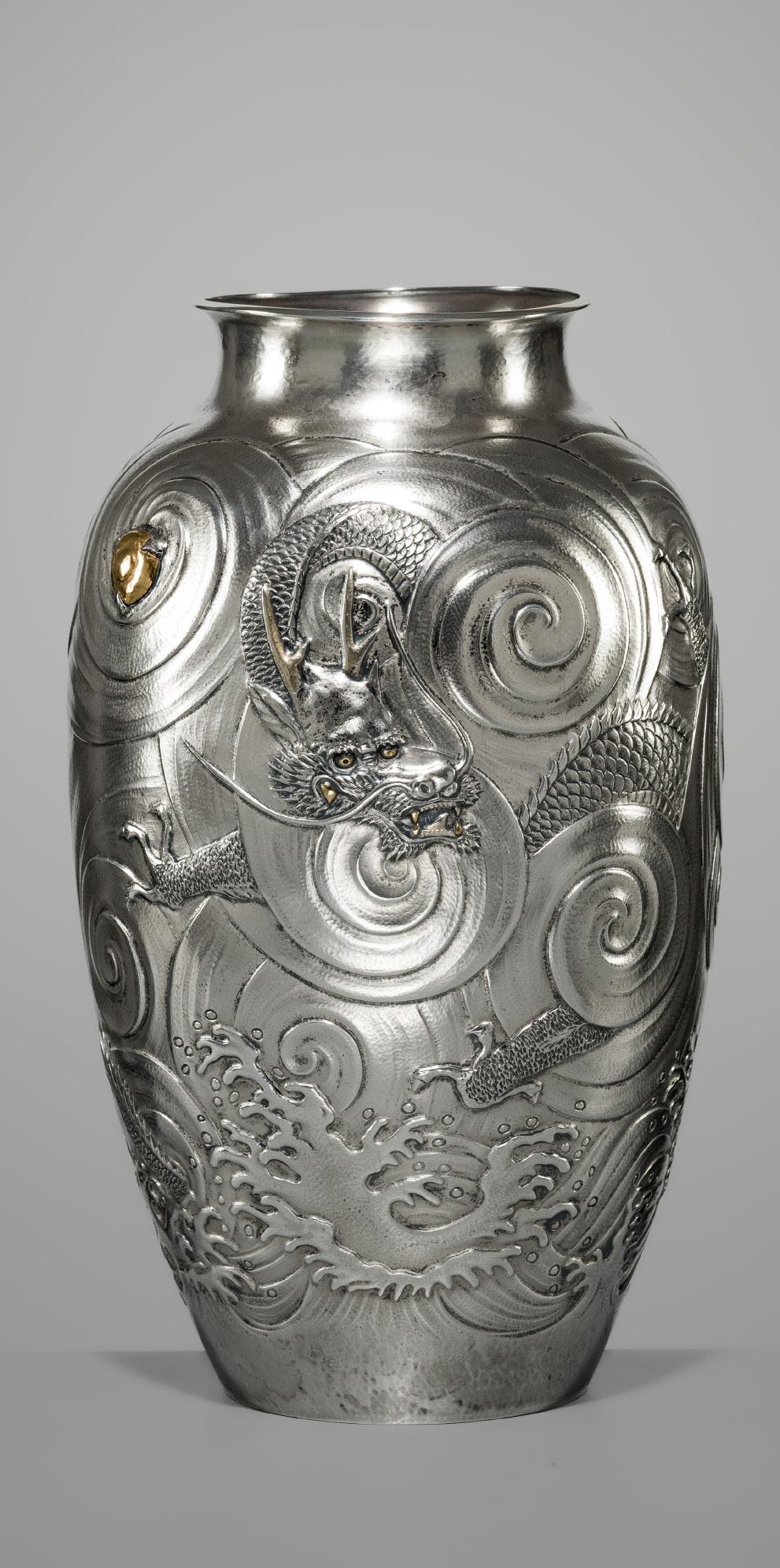
22
KAWASHIMA TOSHU: A SUPERB AND LARGE GOLD-INLAID UCHIDASHI (REPOUSSÉ) SILVER ‘DRAGON’ VASE
By Kawashima Toshu (active c. 1928-1946), signed Toshu saku Japan, early to mid-20th century, Showa period (1926-1989)
The baluster body tapers gracefully toward the foot and rises to a waisted neck with a flared mouth, masterfully chased and hammered in varying degrees of relief to depict a threeclawed dragon writhing amid swirling clouds above turbulent waves, clutching the gold-inlaid sacred pearl (tama). The composition unfolds against a finely textured ground, the dragon’s sinuous, scaly body meticulously rendered, its fierce head distinguished by gold-inlaid eyes and a gaping mouth revealing sharp, similarly gilded fangs, framed by long, flowing whiskers. Signed to the lower section Manyusai, nanajusan sai [Manyusai, at the age of 73], sealed at the base TOSHU saku [made by Toshu] and jungin [pure silver].
With an associated wood stand.
HEIGHT 32.9 cm (vase) and 36.8 cm (total)
WEIGHT 1,534 g (vase)
Condition: Very good condition with minor wear and manufacturing irregularities. Minimal warping. Few minute nicks and light surface scratches as are to be expected.
Kawashima Toshu (active c. 19281946) was a Japanese metal artist renowned for his mastery of the uchidashi (repoussé) technique. His craftsmanship earned him recognition at the Second Nitten Exhibition, held in the autumn of Showa 21 (1946).
AUCTION COMPARISON
Compare a related silver vase with dragon and clouds, signed Shoun, Meiji period, late 19th century, 38 cm high, at Christie’s, Japanese and Korean Art, 24 March 2010, New York, lot 546 (sold for USD 11,250 or approx. EUR 14,500 converted and adjusted for inflation at the time of writing).
Estimate EUR 8,000

Starting price EUR 4,000
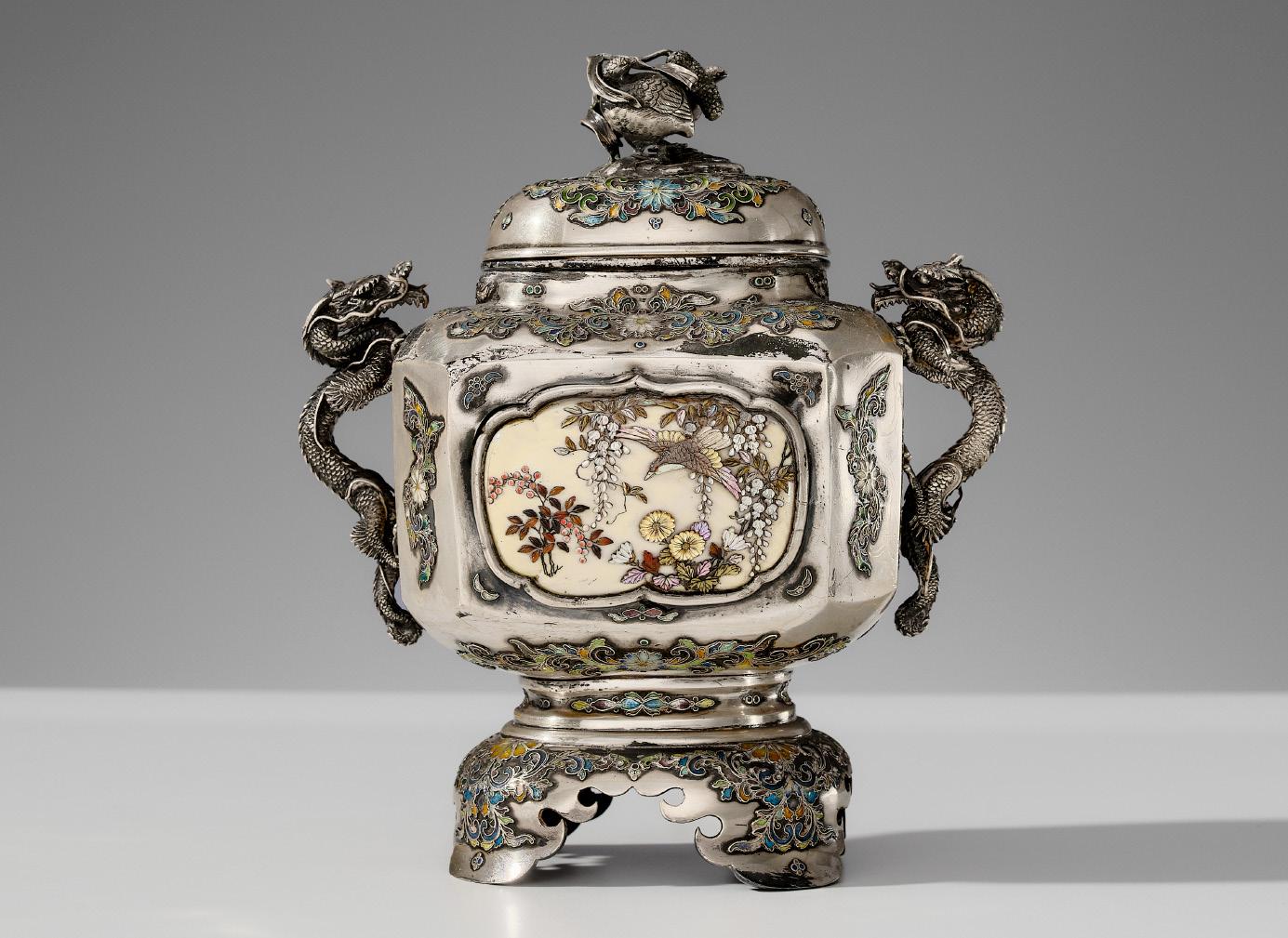
23
AKIHIDE: A FINE SILVER, CLOISONNÉ ENAMEL AND SHIBAYAMA KORO (INCENSE BURNER) AND COVER
By Akihide (Meishu), signed Akihide Japan, Meiji period (1868-1912)
The squat ovoid vessel resting on lobed feet, the main body applied with two ivory panels to either side superbly worked in the Shibayama style with inlays of mother-of-pearl, stained horn and tortoiseshell, one side depicting egrets standing among blossoms and irises, the other showing a sparrow mid-flight above chrysanthemums and below wisteria, the body further applied with vibrant enamels throughout, and with two handles cast as ferocious dragons, the cover similarly decorated with further enamels and surmounted by knop shaped as a quail with a leafy millet stalk. Signed underneath within a gilt reserve AKIHIDE.
SIZE 9 x 14 x 16 cm
WEIGHT 448 g
Condition: Good condition with minor expected wear and tarnishing to silver as visible in the images provided. A few minor expected losses to inlays and enamels. The underside with scratches, discoloration, and remnants of old labels.
AUCTION COMPARISON
Compare a closely related silver and Shibayama koro by Mitsumasa, 17 cm high, also with dragon handles, at Bonhams, Fine Japanese and Korean Works of Art, 18 March 2015, New York, lot 3171 (sold for USD 8,125 or approx. EUR 9,600 converted and adjusted for inflation at the time of writing).
Estimate EUR 4,000 Starting price EUR 2,000
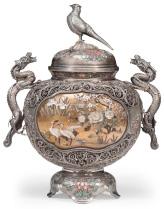


By Ujitada, signed Ujitada Japan, Meiji
period (1868-1912)

Finely cast, the bulbous body supported on three bracket feet and rising to a slender neck with a flared mouth and a lobed rim. The exterior meticulously enameled in vibrant colors with silver wire, to depict a three-clawed writhing dragon, its scaly body minutely rendered, with gaping mouth revealing sharp fangs, long mane, and flowing whiskers. The neck of the vessel adorned with blossoming wisteria on each lobe, while the foot is embellished with additional flower heads amidst scrolling tendrils. Signed to the underside within a gilt-inlaid rectangular reserve UJITADA.
HEIGHT 15.6 cm
WEIGHT 162.4 g
AUCTION COMPARISON
Condition: Good condition with minor wear and manufacturing irregularities. Some evidence of restoration to the enameled decoration to the lower end of the dragon, visible under UV light examination.


Compare a closely related pair of Chinese enameled silver vases with rampant dragons, c. 1920, 22.5 cm high each, at Bonhams, British and Continental Silver including Objects of Vertu, 18 December 2013, London, lot 163 (sold for GBP 16,250 or approx. EUR 30,500 converted and adjusted for inflation at the time of writing). Compare a related silver and cloisonné enamel vase, by Kin’unken of Kyoto, Meiji period, late 19th to early 20th century, 20.2 cm high, at Bonhams, Snow, Sew, and Spectacle, 13 May 2021, London, lot 141 (sold for GBP 3,570 or approx. EUR 5,500 converted and adjusted for inflation at the time of writing).
Estimate EUR 3,000
Starting price EUR 1,500
By Kanemitsu, signed Kanemitsu
Japan, late 19th century, Meiji period (1868-1912)
Finely cast in the form of a spinning top, the vase rests on a splayed foot and rises through high-angled shoulders to a slender neck with a flared mouth. The bronze body is exquisitely patinated in variegated tones of moss green and reddish brown, while the base, neck section, and mouth are executed in patinated silver. Climbing gracefully over the shoulders is a superbly detailed silver minogame, the mythical long-tailed turtle, its textured shell and flowing tail rendered with meticulous precision. The creature drinks from a large suaka (refined copper) sakazuki (sake saucer), which is finely inlaid in gold hirazogan with the character Ju 寿 (also read Kotobuki, meaning longevity). Signed KANEMITSU to the underside of the base.
HEIGHT 21.5 cm
WEIGHT 549.4 g
Condition: Very good condition with minor wear and casting irregularities. Few minor nicks and light surface scratches. Expected tarnishing to silver.
The combination of auspicious motifs - the minogame, the sakazuki, and the character Ju (Kotobuki) - expresses a harmonious wish for longevity, prosperity, and good fortune. Sake, often celebrated in classical literature as the drink of sages and immortals, is here presented in a vessel inscribed with the emblem of long life and felicity. The inclusion of the minogame, a turtle whose long trailing tail of seaweed symbolizes endurance and steadfast vitality, reinforces these benevolent associations, resulting in a composition that eloquently embodies the Meiji aesthetic of refined craftsmanship imbued with auspicious meaning.
AUCTION COMPARISON
Compare a related silver model of a minogame, 11.4 cm wide, Meiji period, at Bonhams, Fine Japanese Works of Art, 19 March 2014, New York, lot 3164 (sold for USD 6,875 or approx. EUR 8,100 converted and adjusted for inflation at the time of writing).
Estimate EUR 4,000
Starting price EUR 2,000




YUKIKAZU: A SUPERB INLAID SHAKUDO VASE WITH A BEAUTY UNDERNEATH CHERRY BLOSSOMS
By Yukikazu, signed Yukikazu koku Japan, Meiji period (1868-1912)
Of baluster form rising from a straight, short foot to gently rounded shoulder with a short, waisted neck, the vase is elegantly worked in silver takazogan with highlights of gold and suaka (refined copper) to depict a standing bijin (beauty) in a delicately patterned kimono, gazing downward beneath a gracefully arching branch of blooming cherry blossoms. Signed to the side YUKIKAZU koku [engraved by Yukikazu].
HEIGHT 19.8 cm
WEIGHT 769 g
Condition: Excellent condition with only very minor wear.
Provenance: From the Alan Bostock collection of Japanese metalwork and cloisonné, assembled over the last 40 years.
AUCTION
COMPARISON
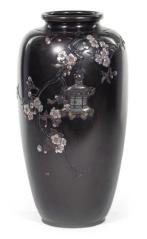
Compare a related larger inlaid vase by the Kuroda company, a company with which Yukikazu often collaborated, dated to the Meiji period, 37 cm high, at Sotheby’s, The Great Exhibition Sale, 31 October 2006, London, lot 573 (sold for GBP 6,000 or approx. EUR 14,000 converted and adjusted for inflation at the time of writing).
Estimate EUR 3,000
Starting price EUR 1,500

SEIMEI: A SUPERB INLAID SHAKUDO VASE WITH FIREFLIES ON GRASSES
By Seimei for the Kyoto Kuroda company, signed Seimei and Kyoto Kuroda zo Japan, Meiji period (1868-1912)
Finely cast, the pear-shaped body supported on a slightly splayed foot and rising to a long neck with a flared mouth. The exterior masterfully inlaid in gold, shibuichi, and suaka takazogan to depict a poetic scene of wind-swept grasses with delicate fireflies alighting upon them. Signed on the lower section SEIMEI and to the base Kyoto KURODA zo.
HEIGHT 24.1 cm
WEIGHT 622.7 g
Provenance: From an old private collection in Northern Germany, acquired in 1993 at Dorotheum Auctions, Vienna, by repute.
Condition: Very good condition with minor wear and casting irregularities. Light surface scratches along the lower section and dents to the foot ring.
AUCTION COMPARISON
Compare a closely related mixedmetal-inlaid bronze vase with insects on grasses, by Seimei for the Kyoto Kuroda company, Meiji period, 29 cm high, at Christie’s, Masterful Exuberance. Artistic Craftsmanship of Imperial Japan. The Property of a Lady, 18 May 2012, London, lot 82 (sold for GBP 2,375 or approx. EUR 4,500 converted and adjusted for inflation at the time of writing).
Estimate EUR 2,000
Starting price EUR 1,000


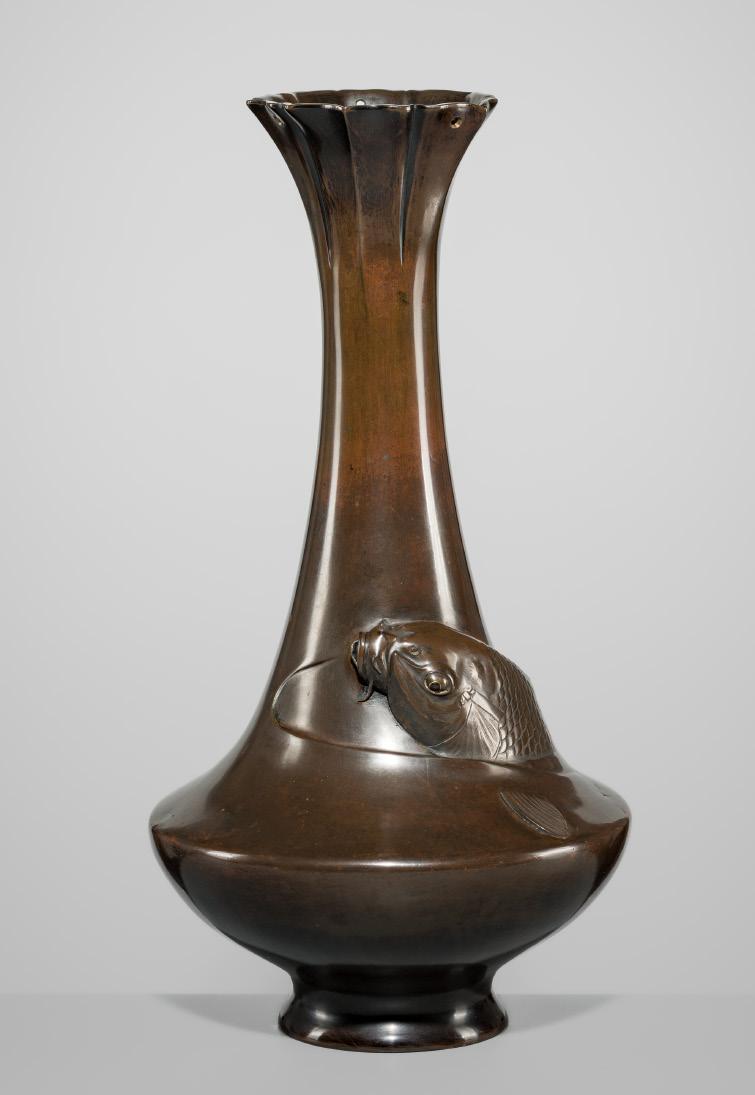

28
A LARGE BRONZE VASE WITH A CARP
Japan, early 20th century, Meiji period (1868-1912) to Taisho period
Of spin-top form, the heavily cast body supported on a slightly splayed foot, rising through high-angled shoulders to an elongated, waisted neck with a trumpet flared mouth and a lobed rim. The exterior finely decorated in high relief to depict a carp gracefully traversing the body of the vessel as if emerging from water. The animal naturalistically modeled with minutely detailed scales and fins, its visible eye inlaid in gold-ringed shakudo.
HEIGHT 37.6 cm
WEIGHT 2,718 g
Provenance: From the Alan Bostock collection of Japanese metalwork and cloisonné, assembled over the last 40 years. Condition: Good condition with minor wear and casting irregularities. Few minute nicks and light surface scratches. The scalloped rim pierced with three small circular apertures, while a further hole is found on the lower section of the vessel, likely all for mounting as a lamp. The base plate has been renewed and may have previously housed an artist signature.
AUCTION COMPARISON
Compare a related bronze vase with several carps, also detailed with gold eyes, by Ichioka Shiun, dated Meiji to Taisho period, at Zacke, Fine Japanese Art, 6 December 2024, Vienna, lot 46 (sold for EUR 5,200).
Estimate EUR 1,500
Starting price EUR 800

29
SEIGYOKU: A RARE BRONZE ‘CLAM’S DREAM’ VASE
By Seigyoku, signed Seigyoku Japan, Meiji period (1868-1912)
The vase of pear form rising from a circular foot to a slightly waisted neck with everted rim, the body detailed in gold, silver and copper takazogan to depict three clams, the largest emanating misty clouds which support Ryujin’s underwater palace. With the artist’s signature SEIGYOKU neatly incised to the right side of the image.
HEIGHT 25.9 cm
WEIGHT 3.1 kg
Condition: Very good condition with minor wear, manufacturing irregularities, and few tiny nicks.
According to popular belief, the clam exhales in a purple mist and pearly tints the form of the island Horai with the palace of Ryujin. This mirage is regularly called ‘the clam’s dream’.
Estimate EUR 1,500
Starting price EUR 800

HIDEKANE: A GOLD-SPECKLED MIXED-METAL-INLAID ‘MOUNT FUJI AND CRANES’ BRONZE VASE
By Hidekane, signed Hidekane koku Japan, Meiji period (1868-1912)
Of large bulbous form, finely inlaid in gold, silver, and shakudo takazogan to depict three cranes in graceful flight against Mount Fuji, partially veiled by a cloudy mist. The plumage of the birds meticulously incised, and the towering mountain carefully rendered to evoke its snow-capped summit. The bronze surface with a shimmering gold-speckled patina. Signed to the lower section HIDEKANE koku [engraved by Hidekane].
HEIGHT 23.6 cm
WEIGHT 2,530 g
Condition: Very good condition with minor wear and casting irregularities. Light discoloration to the gold-speckled patina. The surface with a small dent to the side, few minor nicks, and light surface scratches.
AUCTION COMPARISON
Compare a closely related silver-inlaid bronze vase with Mount Fuji, Meiji period, at Sotheby’s, Saturday at Sotheby’s: Asian Art, 19 March 2016, New York, lot 1578 (estimated at USD 6,000-8,000).
Estimate EUR 2,000
Starting price EUR 1,000
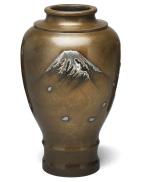

KITAGAWA HOKUSEN I: A MAGNIFICENT AND RARE ‘HATCHING CICADA’ DOUBLE-GOURD BRONZE VASE, DATED 1922
By Kitagawa Hokusen I (Motoyoshi, 1865-1922), signed Mito Hokusen with kakihan Japan, dated 1922
The sentoku bronze vase of elegant double-gourd form, inlaid in shakudo and gold takazogan with naturalistic ivy leaves encircling the shoulder, finely detailed with minute precision. The body applied with a cicada husk that can be removed and replaced with a lifelike cicada, ingeniously representing the moment of hatching. The cicada, long a symbol of rebirth and transformation, evokes the passage of time and the cycle of life and death. Signed to the side “made by Hokusen at the age of seventyseven (corresponding to 1922)” with an elaborate gold kakihan and with a large circular seal to the underside reading MITO HOKUSEN.
HEIGHT 26.5 cm
WEIGHT 3.3 kg
Condition: Excellent condition with minor expected wear, including a few light surface scratches mostly to the base.
With the original wood tomobako (storage box) inscribed: ‘Carved cicadas on a gourd-shaped vase. Made at the age of 77. Kitagawa Hokusen.’
Kitagawa Hokusen I (1846-1922) was born in Mito, presentday Ibaraki Prefecture. He studied under the renowned Mito metalworker Sekijoken Motozane and became one of the most accomplished successors of that tradition. His works exemplify the transition from sword-fitting craftsmanship of the Edo period to the refined sculptural bronzes of the Meiji and Taisho eras.
Hokusen exhibited widely and was awarded a gold medal at the 1893 World’s Columbian Exposition in Chicago for his silver bantam cockerels and gilt-bronze figure of a youth on a tortoise. He also received commissions from the Imperial Household, including a silver lion censer and a “crab-in-stream” vase. Around 1890 he produced a hyogogusari tachi sword mounting on commission for the Mito Tokugawa family, now linked to holdings in the Tokyo National Museum and Tokugawa Museum.
In his later years, Hokusen continued to work in Mito and was associated with early craft education at the Tokyo Fine Arts School. Museum collections today include pieces by him at the Tokyo National Museum, the Mito City Museum (which holds two vases), and the Tokugawa Museum in Mito. His bronzes are recognized for their superb modeling, expressive detail, and poetic subject matter.

Hokusen’s masterful conception allows the viewer to interchange the empty shell with the living insect, literally enacting the moment of transformation. Created in the final year of his life, the work reads as a personal meditation on the fleeting of life and the promise of renewal. The naturalism of the insects, the luminous sentoku patina, and the subtle gold and shakudo inlays all contribute to a quiet and deeply human reflection on time, memory, and the soul’s passage.
The double gourd, ivy, and cicada form a symbolic trinity of renewal and impermanence. The gourd (hyotan) is an ancient emblem of protection and fertility; its twin chambers suggest continuity between generations and worlds. Ivy represents endurance, its tendrils clinging to life even as seasons change. The cicada, emerging from its husk, is a classic image of rebirth, spirit, and the transient beauty of existence.
In Japanese culture, the cicada’s short life above ground is a reminder that existence is brief, but its song endures—much like the legacy of Hokusen himself, whose art bridges the spirit of the Mito craftsmen with the new modern age.
For another work by the artist in the form of a bronze bamboo vase applied with a snail, see Bonhams, Fine Japanese Works of Art, 17 September 2013, New York, lot 3269 (sold for USD 7,500 or approx. EUR 9,000 converted and adjusted for inflation at the time of writing).
Estimate EUR 12,000 Starting price EUR 6,000

A SUPERB AND LARGE MIYAO STYLE PARCEL
Japan, Meiji period (1868-1912)
Of shallow circular form, cast in rich brown bronze and inlaid in gold, suaka (refined copper) and shakudo takazogan with some gold hirazogan highlights. The surface finely modeled in high relief with two rakan standing side by side, the figure on the left holding a nyoi scepter and cleaning his ear with an ear pick, the other stretching and yawning with both arms raised in a lively posture. Both are shown with circular halos behind their heads, their flowing robes defined by crisp folds and chased details. The borders and ornaments of their garments are heightened with gold, while the skin areas display a contrasting refined copper tone. The whole composition rests within a plain outer rim that accentuates the sculptural modeling of the figures.
DIAMETER 44 cm
WEIGHT 5.5 kg
Condition: Excellent condition with only minor wear.
The animated pairing of rakan reflects a humorous and devotional theme in Buddhist art, in which disciples imitate Daruma (Bodhidharma)—the patriarch of Zen—who was often depicted yawning or cleaning his ear as symbols of awakening and attentive hearing. The vigorous modeling, selective gilding, and expressive gestures align closely with the Miyao workshop style, renowned for its masterful casting and lively realism during the Meiji period. The combination of copper and brown patination, gilded highlights, and the distinctive narrative energy suggest production within, or under the influence of, the atelier of Miyao Eisuke.
AUCTION COMPARISON
Compare a related bronze charger of similar quality, depicting Daruma as Daidarabotchi, 46 cm diameter, Meiji period, at Zacke, Fine Japanese Art, 6 December 2024, Vienna, lot 30 (sold for EUR 16,900).
Estimate EUR 8,000
Starting price EUR 4,000



33
INOUE OF KYOTO: A FINE KOMAI-STYLE MIXED-METAL-INLAID IRON DISH
By Inoue of Kyoto, signed Kyoto Inoue sei and sealed Fusahiro
Japan, Meiji period (1868-1912)
Of circular lobed form on a short foot rim, the iron ground is inlaid with gold and silver takazogan and hirazogan. It shows three boys in ceremonial robes on a phoenix-headed boat gathering lotus flowers. The scene is framed by a gilt border with scrolls, four cartouches of landscapes and foliage, and geometric motifs in the Komai style of Kyoto. The foot has an iron wire for suspension and is signed Kyoto INOUE sei [made by Inoue of Kyoto] with a gold square seal Fusahiro.
DIAMETER 27.1 cm
WEIGHT 1,102 g
Provenance: From the private collection of Robert Crowder, thence by descent.
Condition: Overall good condition with losses to patination and rust as visible in the images provided. Typical rubbing to gilding and inlays. Occasional minuscule nicks and minor nibbling along the edges.
AUCTION COMPARISON
Compare a closely related mixedmetal-inlaid bronze lobed charger, signed Kyoto Inoue sei, at Bonhams, Fine Japanese Art, 9 November 2017, London, lot 377 (estimated at GBP 3,000-4,000).
Estimate EUR 2,000
Starting price EUR 1,000



34
A FINE KOMAI STYLE GOLD INLAID IRON ‘HO-O NO KIRI’ BOX AND COVER
Japan, Meiji period (1868-1912)
Of rectangular form, the flush-fitting cover superbly inlaid in gold takazogan with a majestic ho-o (phoenix) perched on a kiri (paulownia) tree, the entire scene framed by clouds and the design continuing onto the sides. The interior gilt.
SIZE 5.9 x 8.2 x 10.3 cm
WEIGHT 512 g
Condition: Very good condition with minor rubbing to gilt, some light traces of use, including a few tiny nicks, and minor rust development.
AUCTION COMPARISON
Compare a related inlaid iron box and cover, unsigned, 4.8 x 12.4 x 9.5 cm, Meiji period, at Bonhams, Fine Japanese Art, 11 May 2017, London, lot 424 (sold for GBP 4,000 or approx. EUR 7,000 converted and adjusted for inflation at the time of writing).
Estimate EUR 3,000
Starting price EUR 1,500

35
FUJII: AN INLAID BRONZE ‘FULL MOON’ BOX AND COVER WITH PRUNUS BLOSSOMS AND MAPLE LEAVES
By Fujii Yoshitoyo (Biho, born 1868), signed Fujii zo Japan, Meiji period (1868-1912)
Of circular form in allusion to the full moon, the rims gilded, the domed cover worked in low relief with wispy clouds against a minutely gold-stippled ground and finely inlaid in silver and gold takazogan depicting scattered prunus blossoms and petals as well as maple leaves. The base signed FUJII zo [made by Fujii].
DIAMETER 12.1 cm
WEIGHT 267 g
Condition: Very good condition with expected wear, traces of use, manufacturing irregularities, few small dents, light surface scratches mostly to the base.
Fujii Yoshitoyo, founder of the Fujii Damascene Company, was renowned for his exquisite metalwork craftsmanship.
Estimate EUR 1,000 Starting price EUR 500
Moon seen through the leaves, c. 1840s, by Utagawa Hiroshige, woodblock print
36
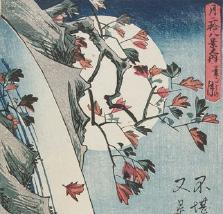
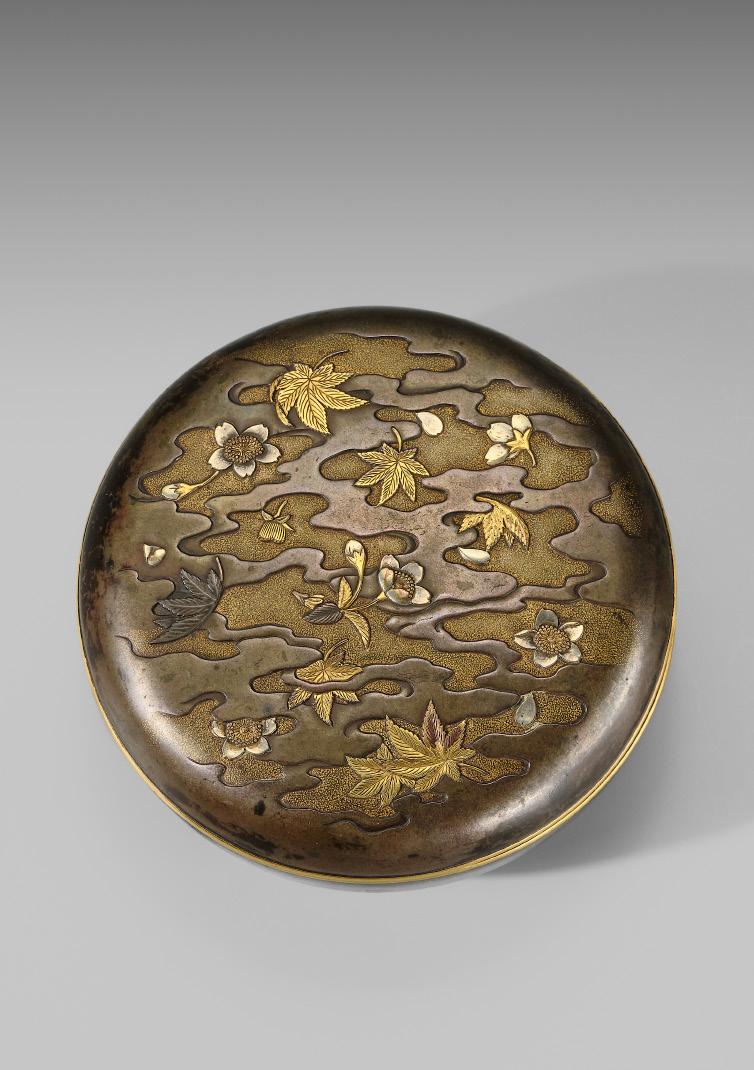
SEKI OF KYOTO: A FINE GOLD INLAID IRON ‘DRAGON’ KOGO (INCENSE BOX) AND COVER
By Seki of Kyoto, signed Seki Japan, Meiji period (1868-1912)
Of circular form, the design inlaid in gold nunome-zogan, in Komai style, depicting a writhing dragon chasing a flaming tama pearl. The sides are neatly inlaid in silver hirazogan with brocade designs. Signed underneath in silver takazogan SEKI.
DIAMETER 6.4 cm
WEIGHT 82 g
Condition: Excellent condition with light rubbing to the gold nunome-zogan and some light rust.
The artist Seki produced works for the Nogawa company in Kyoto but was more than likely also affiliated with the Komai company, his works being invariably made from iron with nunome-uogan inlay in the typical Komai style.
AUCTION COMPARISON
Compare a related Komai style vase by Seki, 15.9 cm high, at Christie’s, Edo to Post War: 500 Years of Japanese Art and Design, 19 November 2018, New York, lot 28 (sold for USD 2,125 or approx. EUR 2,400 converted and adjusted for inflation at the time of writing).
Estimate EUR 3,000 Starting price EUR 1,500
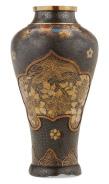
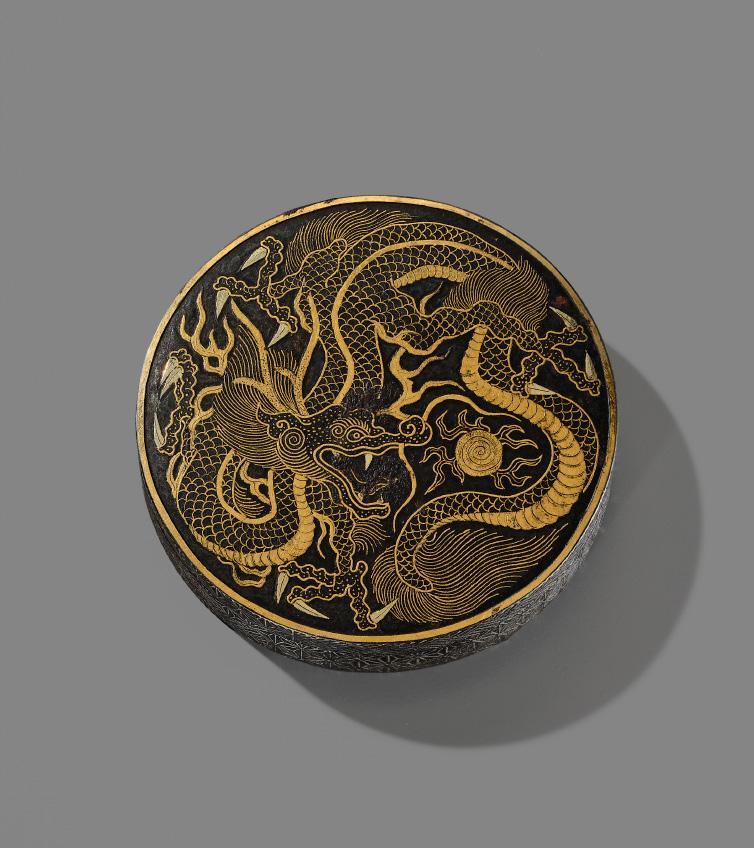

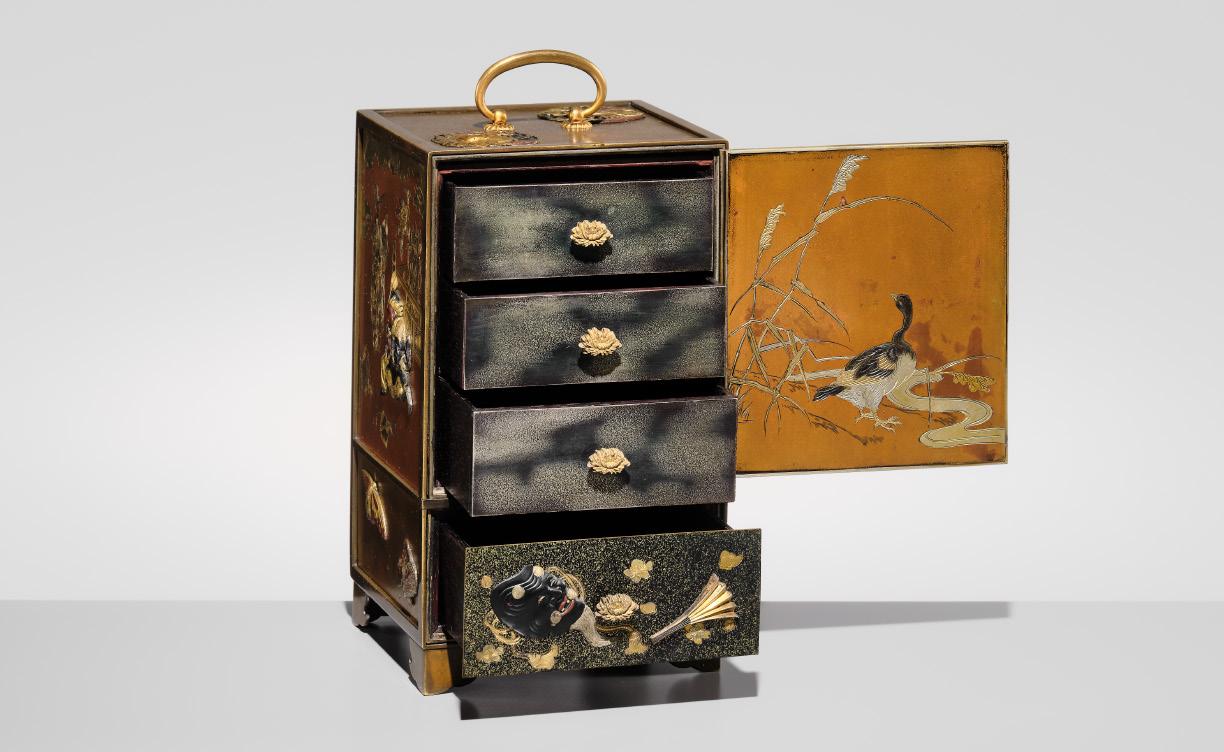
37
A SUPERB MIXED METAL KODANSU (SMALL CABINET)
Japan, Meiji period (1868-1912)
Of rectangular form, raised on four shaped bracket feet and surmounted by a gilt handle mounted with chrysanthemum (kiku) motifs, the cabinet finely worked in takazogan and hirazogan with iro-e and gold inlays upon contrasting textured and polished grounds.
The front panel depicts two geese flying low above a winding stream beneath a night sky, accompanied by a mask of Okina and a fan, all set against a densely dotted ground evoking nashiji lacquer. The sides are richly decorated with figural scenes of daily and festive life: one showing a carver in his studio admiring a newly completed Nio sculpture, his tools neatly arranged beside him; another with a group of boys in ornate festival garments performing the shishimai (lion dance), full of movement and vitality; and a further panel showing two boys in festive robes, one tenderly cuddling a small dog while the other releases a bird into the air among clouds and floral motifs.
The lower sections are adorned with delicately rendered butterflies and moths in gold, copper, and shakudo, their wings chased and inlaid to shimmer against the warm bronze surface. The top is decorated with two roundels in mixed metal depicting kiku (chrysanthemum) and botan (peony) flanking the gilt handle, while

the interior reveals three drawers fitted with gilt-metal peony-form pulls. The inside of the door is finely incised with hirazogan details depicting geese among reeds beside a flowing stream.
SIZE 18.5 x 10.6 x 10.2 cm
WEIGHT 1.2 kg
Provenance: Lyon & Turnbull, Japanese Works of Art, 15th June 2015, Edinburgh, lot 274. From the Alan Bostock collection of Japanese metalwork and cloisonné, assembled over the last 40 years.
Condition: Excellent condition with only very minor expected wear and light traces of use.
AUCTION
COMPARISON

Compare a related kodansu with similar inlaid takazogan décor, by Miyabe Atsuyoshi, at Sotheby’s, Fine Japanese Art, 5 November 2019, London, lot 132 (sold for GBP 20,000 or approx. EUR 32,500 converted and adjusted for inflation at the time of writing).
Estimate EUR 5,000
Starting price EUR 2,400


By Jomi
Eisuke II (1839-1899), sealed Jomi sei Japan, late 19th century, Meiji period (1868-1912)
Published: G. Lester, Japanese Metal Art in the Meiji Era, Arts of Asia, Hong Kong, 1987, p. 102, fig. 14.
A magnificent mixed-metal censer composed of numerous interlocking sections (now eight separate pieces), conceived as a multi-tiered temple pavilion raised on a rectangular plinth finely decorated with blossoms and butterflies. The entire structure is richly adorned in iro-e takazogan and hirazogan, each surface worked in exceptionally fine relief and inlay. The lower section features a double-door entrance mounted with gilt kiku fittings and flanked by a pair of fierce Nio guardians. The curved side panels incorporate small drawers decorated with komainu, the mythical lion-dog protectors of shrine gateways, beneath clusters of peonies.

The overhanging eaves are hung with minute gilt bells, while the upper storey displays inlaid panels of phoenixes set beneath bands of kiri (paulownia) crests. The tiled roofs are executed with meticulous precision, capped by ridge ornaments and gilt corner finials, and pierced in two sections to allow incense smoke to drift gracefully through the openwork. A silver chamber just beneath the roof serves as the incense holder. Several of the gilt fittings are formed with inome (boar’s-eye) motifs, traditional symbols of protection in Japanese architecture.
The reverse bears the seal mark JOMI sei [made by Jomi] and an inscription to the interior.
SIZE 28.8 x 26.5 x 23.2 cm
WEIGHT 7.8 kg
Condition: Very good condition with minor wear, some expected scratching on the contact surface between the pagoda and platform, and some very minor losses to takazogan inlays and fittings. Presenting beautifully.
Architectural incense burners of this complexity epitomize the Meiji fascination with miniature temple architecture rendered in metal. The selective gilding highlights the roof architecture and finials, while the concealed drawers and compartments give the piece a hybrid character—at once a devotional object and a sculptural display of technical mastery.
Jomi Eisuke II (also known as Jomi Einosuke) studied under the celebrated metal artist Kanaya Gorosaburo. He exhibited widely at the second, third, and fourth Domestic Industrial Expositions (1881, 1890, 1895) and was appointed an Artist to the Imperial Household (Teishitsu Gigeiin) in 1896. Eisuke’s work received major prizes at international exhibitions including Philadelphia (1876), Paris (1878, 1889, 1900), Chicago (1893), St Louis (1904), and the Japan-British Exhibition (1910, London).
The present masterpiece, clearly conceived for exhibition, demonstrates the height of his technical ability and artistic vision. Its elaborate structure, rich contrasts of gold, silver, and bronze, and ingenious architectural design indicate production for the export and exhibition markets, where such Meiji metalwork was celebrated as among the finest in the world.
LITERATURE COMPARISON
Compare a related bronze vase with similar takazogan inlays, by Jomi Eisuke II, c. 1880, 40.2 cm tall, illustrated in The Nasser D. Khalili Collection of Japanese Art - Treasures of Imperial Japan, Metalwork Part II, 1995, no. 95.
AUCTION COMPARISON
Compare a related Komai model of a three-tiered pagoda, 19th century, 35.6 cm tall, at Bonhams, Fine Japanese Works of art, 15 September 2015, New York, lot 3297 (sold for USD 17,500 or approx. EUR 20,500 converted and adjusted for inflation at the time of writing).
Estimate EUR 8,000
Starting price EUR 4,000
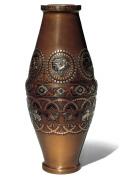



A LARGE AND IMPRESSIVE MIYAO STYLE BRONZE FIGURE OF A KARAKO PULLING A HANAGURUMA (FLOWER CART)
Japan, c. 1870, Meiji period (1868-1912)
Constructed of several adjoined pieces, finely modeled as a karako pulling a flower cart, the boy dressed in loose robes, the cart finely decorated in gold and iro-e hirazogan and takazogan, the cartwheels decorated with mythical beasts, bats, and minogame, the upper section of openwork with lotus and pomegranate tendrils, supported by four diminutive karako, and the shafts with floral blossoms.
LENGTH 61.3 cm
WEIGHT 17.4 kg
Condition: Excellent condition with only very minor wear.
Provenance: Sotheby’s, 9 November 2018, London, lot 450. A noted private collection, acquired from the above.
Estimate EUR 30,000
Starting price EUR 15,000

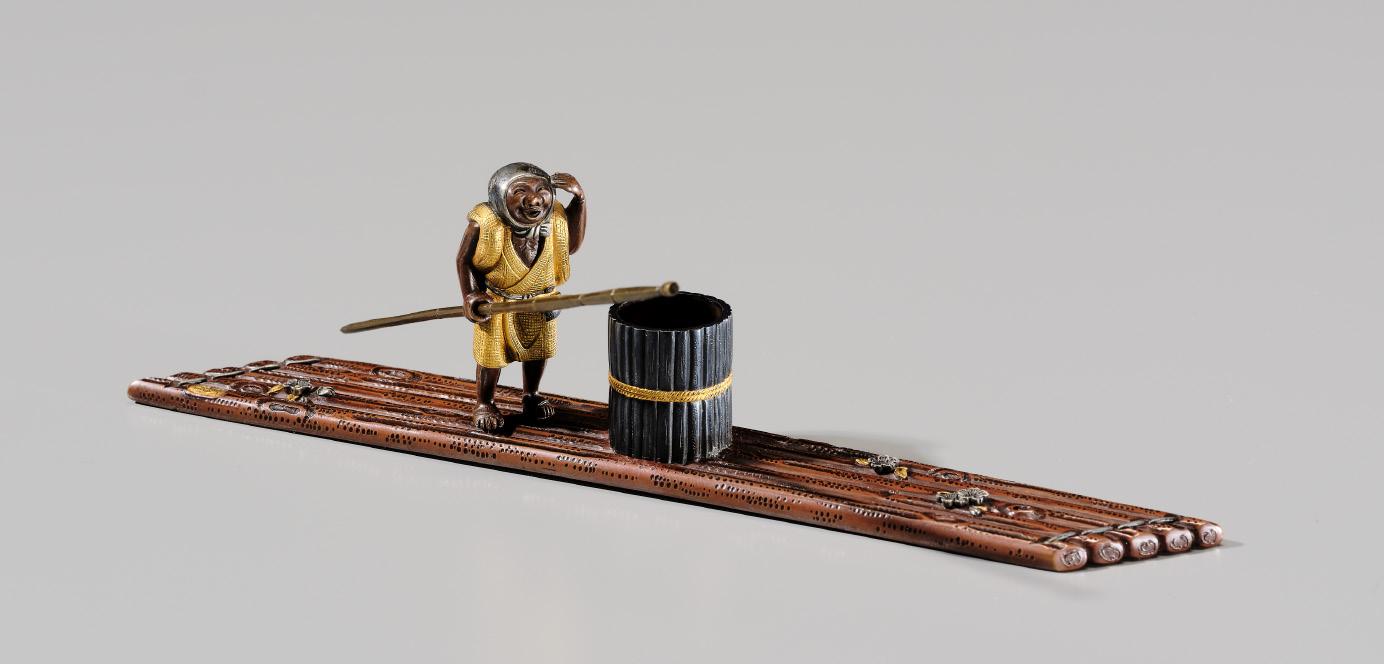
40 SHOZUI: A FINE HAMANO SCHOOL MIXED-METAL BUNCHIN (PAPERWEIGHT) OF A FISHERMAN ON A FLOAT
Lineage of Hamano Shozui, signed Shozui Japan, mid to late 19th century
Superbly modeled as a fisherman standing atop a long float, worked in copper, gold, silver and shakudo takazogan. The figure is dressed in a short robe, with a scarf tied around his head, holding a long fishing pole. The float detailed with sakura blossoms and the signature SHOZUI within a gold oval reserve to one end.
41 MIYAO: A PARCEL-GILT BRONZE FIGURE OF AN ARCHER
Workshop of Miyao Eisuke, signed Miyao Japan, Meiji period (1868-1912)
Skillfully rendered in a wide back-leaning stance with his bow drawn and arrow notched, the archer preparing to shoot at his target, supporting himself on one knee as the other one is fully outstretched, a wakizashi tucked under his belt, the bow and arrow crafted separately. His robes are neatly incised and finely engraved with wheel roundels, chrysanthemums (kiku), clouds, and lotus foliage. The back with a rectangular reserve incised with the signature MIYAO. With a black-lacquered wood stand.
HEIGHT 30.5 cm (figure) and 32.7 cm (total)
WEIGHT 1,765 g (figure) and 2,115 g (total)
Provenance: From a private collection in Czechia.
Condition: Very good condition with minor wear and casting irregularities. Few minute nicks and tiny dents.
With an inscribed wood tomobako (storage box).
AUCTION COMPARISON
Compare a closely related bronze figure of an archer, also signed Miyao, at Zacke, Fine Japanese Art, 6 December 2024, Vienna, lot 19 (sold for EUR 3,900).
Estimate EUR 2,000 Starting price EUR 1,000

LENGTH 19.7 cm
WEIGHT 235.3 g
Condition: Excellent condition with minor expected wear.
With an associated wood tomobako (storage box).
Estimate EUR 2,500 Starting price EUR 1,200
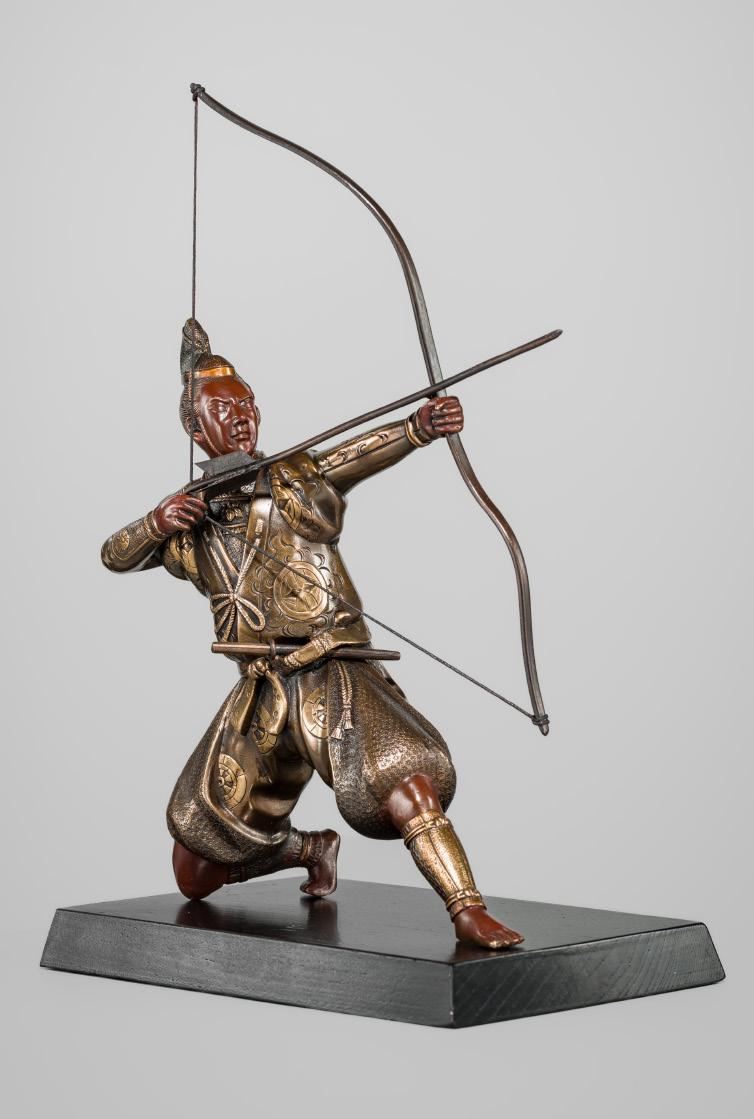

42
FUJITA TAKAYASU: A VERY LARGE (42.5 CM)
IRON NAMBU TEKKI
YONEZAWA FUJI-SHAPED TETSUBIN (TEA KETTLE) WITH MARU NI MOKKO MON
By Fujita Takayasu, signed Takayasu and sealed Tachibana
Japan, Meiji period (1868-1912) to Taisho period
Of large, flared form with a curved, upturned spout and arched handle, the body finely cast in iron and decorated in relief with a profusion of cherry blossoms (sakura). To the center of each side appears a prominent maru ni mokko mon. The lid is similarly adorned with fine floral motifs and surmounted by a small knop. Signed TAKAYASU and sealed TACHIBANA to the body.
LENGTH 32 cm, HEIGHT 42.5 cm (incl. handle)
WEIGHT 7.3 kg
Provenance: From an old German private collection, acquired after 1950. Condition: Excellent condition with minor wear and casting irregularities.
Nambu Tekki is a renowned tradition of cast ironwork from Iwate Prefecture, developed under the Nambu clan during the Edo period. Celebrated for its tetsubin (tea kettles) and chagama (tea ceremony kettles), it is prized for refined forms, intricate surface textures, and a distinctive black patina that deepens with use. Each piece is meticulously cast using hand-carved molds and precise heating techniques, producing exceptional durability and a smooth, rust-resistant interior that enhances the flavor of boiled water. Beyond tea utensils, Nambu Tekki historically encompassed daily wares and temple bells.
MUSEUM COMPARISON


43 RYUBUNDO: AN IRON TEA KETTLE (TETSUBIN) WITH A NOCTURNAL LANDSCAPE UNDER THE CRESCENT MOON
By Ryubundo, signed Nihon Ryubun(do)
Japan, 19th century, late Edo period (1615-1868) to Meiji period (1868-1912)
Heavily cast, the globular body set with a short upturned spout and a hinged overhanging handle, roughly worked in takabori to depict a nocturnal landscape with willows growing among rugged rocks and small huts. The scene illuminated solely by a crescent moon (mikazuki) and a small bird crossing the night sky, joined by a pair of bats (komori) adorning the handle, all delicately inlaid in silver takazogan. The circular bronze cover surmounted by a bud-form finial. Signed to the lower section of the tea kettle Nihon RYUBUN within a square reserve.
HEIGHT 21.2 cm (incl. handle) WEIGHT 1,870 g
Provenance: From a private collection in Austria. Condition: Very good condition with minor wear and casting irregularities. Expected traces of use to the interior. Few minor nicks and light surface scratches, mostly to the cover and handle.
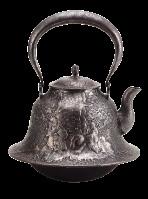
Compare a closely related nambu tekki fuji-shaped tetsubin by the same artist, Fujita Takayasu, in the Collection of the Kyoto Women’s University.
Estimate EUR 4,000
Starting price EUR 2,000
AUCTION COMPARISON
Compare a related rounded square iron teapot (tetsubin) with similarly inlaid details, by Ryubundo, late Edo to Meiji period, mid- to late 19th century, 11.5 cm high, at Bonhams, Fine Japanese Art, 15 May 2014, London, lot 573 (sold for GBP 8,750 or approx. EUR 16,200 converted and adjusted for inflation at the time of writing).
Estimate EUR 2,000
Starting price EUR 1,000



44
ORIHARA KYUZAEMON: A MASSIVE BRONZE SQUARE VASE
By Orihara Kyuzaemon (1931-2018), signed Kyuzaemon Japan, 20th century, Showa period (1926-1989)
Heavily cast in a cubic form, supported on a short foot and rising to a square mouth with thick lips. The exterior boldly worked in varying degrees of relief and texture with overlapping geometric patterns in the shape of manji, culminating at the rim. Signed on the base KYUZAEMON.
With the original wood tomobako (storage box), inscribed Seido, Hotei Kaki, Nitten hyogi-in, Orihara Kyuzaemon [bronze flower vessel, in the square geometric shape, made by Orihara Kyuzaemon, Nitten Exhibition Committee member] and sealed Kyuzaemon.
HEIGHT 23.5 cm WEIGHT 6.7 kg
Condition: Excellent condition.
Estimate EUR 2,500 Starting price EUR 1,200
45
HASUDA SHUGORO: A SHIBUICHI SQUARE KORO (INCENSE BURNER)
By Hasuda Shugoro (1915-2010), signed with the artist’s seal Japan, 20th century, Showa period (1926-1989)
Finely cast, of square section, the censer supported on a chamfered foot with a projecting lip, the body neatly decorated with incised parallel horizontal lines, rising to a slightly domed top, pierced with four circular openings and others of triangular shape along the edges, framed by further incised and dotted lines. Signed on the base with the artist’s seal and stamped Shibuichi.
With the original wood tomobako (storage box).
HEIGHT 9.3 cm WEIGHT 495.7 g
Condition: Excellent condition.
Estimate EUR 1,000 Starting price EUR 500
46
By Hasuda Shugoro (1915-2010), sealed Shu Japan, 20th century, Showa (1926-1989) to Heisei period (1989-2019)
Finely cast and crisply modeled with elegantly stylized forms to depict a shishi (Buddhist lion) seated on its haunches, its tail curving gracefully along the left side of its body, with one hind leg raised beside its head while the other extends beneath the firmly planted forelegs. The head of the animal held high and turned slightly to the left, marked by a prominent snout and two bulging eyes set beneath a furrowed brow, framed by a majestic mane finely rendered in scrolling locks of hair. Sealed to the base SHU (of Shugoro) and shibuichi.
With the original wood tomobako (storage box), inscribed on the cover rogin, Shishi Koro, Shugoro [incense burner in the shape of a shishi lion, made in shibuichi metal, Shugoro] and sealed Shugoro.
HEIGHT 13.5 cm
WEIGHT 642.2 g
Condition: Excellent condition with minimal wear and traces of use.
Estimate EUR 1,200 Starting price EUR 600

47
SAEGUSA SOUTAROU: A BRONZE OKIMONO OF A TURTLE DOVE
By Saegusa Soutarou (1911-2006), signed with the artist’s seal Japan, 20th century, Showa period (1926-1989)
Finely cast in the form of a standing oriental turtle dove, the stylized body elegantly elongated into a slender tail defined by sharp lines. The small head of the bird with a delicate beak and two neatly punched eyes. The bronze surface with a rich chocolate-brown tone. Signed with the artist’s seal to the underside of the tail.
LENGTH 20.7 cm
WEIGHT 1,298 g
Condition: Excellent condition.
AUCTION COMPARISON
Compare a related patinated copper okimono of a panther, by Saegusa Soutarou, Showa period, 20th century, 33.2 cm long, at Zacke, Fine Japanese Art, 6 December 2024, lot 70 (sold for EUR 2,600).

Estimate EUR 1,200 Starting price EUR 600

By
Myochin Munenori, signed Myochin ki Munenori Japan, late 18th to early 19th century, Edo period (1615-1868)
Exquisitely hammered, the tapering rectangular censer supported on four cabriole legs emerging from dragon-head terminals, flanked by C-form mythical-beast keyfret handles suspending loose rings, superbly worked in uchidashi and decorated in gold and silver takazogan and hirazogan, to depict Fudo Myoo, the powerful King of Immutable Wisdom and Vanquisher of Evil, holding the kurikara (devil-subduing) sword and a lasso to catch and bind up the wicked, accompanied by his acolytes Kongara and Seitaka, surrounded by the halo of flames that destroys ignorance; the reverse panel decorated with a shishi menacingly crouching on the edge of a cliff, the face with a fierce expression, the eyes finished in gilt, and claws and fangs in silver. Each of the opposing short panels with a longtailed bird in flight holding a knotted cord in its beak and a fluttering butterfly above a large chrysanthemum flower.
With a partially reticulated cover decorated with pierced geometric design, between bands of foliate and geometric scrolls, terminating in a flaring knop with an overhanging lip with a lobed design. The underside of the lid with a cut-out design of a sparrow. The interior with a removable metal lining to protect the koro from the burned incense.

Inscriptions: Signed to the Fudo Myoo panel, ‘Myochin ki Munenori’.
SIZE 39 x 32 x 26 cm
WEIGHT 7,286 g
Provenance: Woolley & Wallis, Asian Art II, 18 May 2016, Salisbury, lot 810 (sold for GBP 28,864 or approx. EUR 51,000 converted and adjusted for inflation at the time of writing).
Woolley & Wallis, Japanese Works of Art, 23 November 2021, Salisbury, lot 1039 (sold for GBP 26,240 or approx. EUR 38,500 converted and adjusted for inflation at the time of writing).

Hugo Burge (1972-2023)
The collection of Hugo Burge, acquired from the above. Hugo Burge (1972-2023) was an internet entrepreneur, collector, philanthropist, and the founder of Marchmont Ventures, an organization that supports arts and crafts. He displayed to great effect in his homes at Marchmont House in the Scottish Borders and in London.
Condition: Very good condition with old wear and light traces of use. Two feet with old repairs and associated minor touchups.
Myochin Munenori is recorded as being a retainer of the Tsuchiya clan working in the province of Hitachi during the late 18th-early 19th century.
The Myochin family was the most successful of the numerous dynasties of professional armorers that originated in late-medieval Japan. In the Edo period (1615-1868) the family opened branches not just in the major cities but also in the chief towns of many provincial fiefs where they turned out vast quantities of cuirasses, helmets, face masks, and other components that were needed for samurai armor. Myochin craftsmen were highly accomplished in using tiny rivets to join multiple iron plates, creating protection that was both relatively light and highly flexible; over time, they repurposed their skills to make ingenious and astonishingly lifelike articulated models of snakes, fishes, crustaceans, and insects. They also made other objects for everyday or ceremonial use, like the present incense burner, which is to be considered exceedingly rare.
AUCTION
COMPARISON


Compare a related yet significantly smaller iron tripod incense burner, by Myochin Muneyoshi, 19th century, 10.5 cm wide, at Christie’s, The Meiji Aesthetic: Selected Masterpieces from a Private Asian Collection, 27 November 2018, Hong Kong, lot 3830 (sold for HKD 250,000 or approx. EUR 32,500 converted and adjusted for inflation at the time of writing). Compare a related Myochin school uchidashi tosei gusoku armor decorated with a shishi to the do, 18th-19th century, at Christie’s, Arts of the Samurai and Japanese Art & Design, 7 June 2000, London, lot 38 (sold for GBP 42,300 or approx. EUR 116,000 converted and adjusted for inflation at the time of writing).
Estimate EUR 25,000
Starting price EUR 12,000


49
KOZAN: A SUPERB INLAID SHAKUDO ARTICULATED ‘JIZAI’ OKIMONO OF A SWALLOWTAIL BUTTERFLY
By Takase Torakichi (Kozan, 1869-1924), signed Kozan Japan, c. 1900, Meiji period (1868-1912)
Naturalistically modeled as a swallow-tail butterfly and assembled with fully articulated joints in the wings, neck, legs and abdomen, the surface worked in shakudo and with suaka (refined copper) and gold flush-inlaid highlights to resemble the natural pattern of the insect’s body, signed KOZAN underneath the wing.
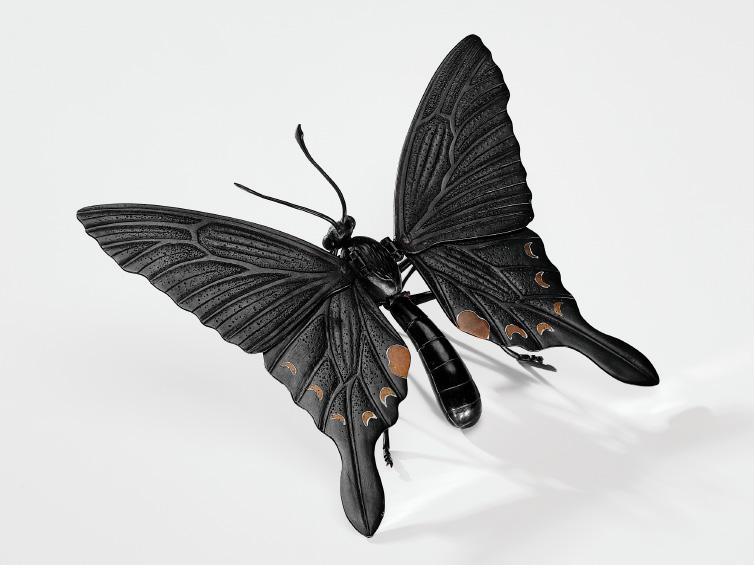
LENGTH (including antennae) 8 cm, LENGTH (wingspan) 15.5 cm
WEIGHT 63.6 g
Condition: Excellent condition with minor wear.
With a wood tomobako (storage box).
Takase Torakichi (Kozan, 1869-1934) was born in Kanazawa as the eldest son of Takase Kanatake. Kozan started working in the export department of Ikeda Seisuke’s ceramics export company in Kobe, in 1883 and transferred in 1887 to the metalworking division of the factory’s Kyoto branch, where he learned metalworking techniques from Tomiki Isuke. In 1893, he became independent and started a business selling metalwork both domestically and abroad, soon becoming famous for his articulated studies of sea life and insects. In 1910, the artist was honored when the Crown Prince (later the Taisho Emperor) purchased several of his astonishingly realistic articulated insects during a visit to Kyoto.
AUCTION COMPARISON
Compare a closely related inlaid shakudo figure of a butterfly by the same artist, signed Kozan, dated to c. 1900, 12 cm long, at Bonhams, Fine Japanese Works of Art, 16 September 2014, New York, lot 2172 (sold for USD 35,000 or approx. EUR 41,000 converted and adjusted for inflation at the time of writing).
Estimate EUR 12,000
Starting price EUR 6,000


50 MUNEYOSHI: A SUPERB INLAID SHAKUDO ARTICULATED JIZAI OKIMONO OF A SWALLOWTAIL BUTTERFLY
By Tanaka Tadayoshi (d. 1958), signed Muneyoshi Japan, early 20th century
Naturalistically modeled as a butterfly with fully articulated wings, head, legs, and abdomen, the surface executed in rich shakudo alloy with inlaid gold and copper (suaka) details that replicate the delicate color and texture of the insect’s body. The wings are finely jointed, allowing lifelike movement, and decorated with intricate incised and inlaid markings. The antennae, legs, and abdomen are rendered with striking anatomical accuracy, giving the piece a vivid sense of motion and presence. Signed MUNEYOSHI beneath one wing.
LENGTH (including antennae) 5.5 cm, LENGTH (wingspan) 12.8 cm WEIGHT 21.1 g
Condition: Excellent condition with minor wear consistent with age.
Jizai okimono, or articulated metal figures, represent one of the most technically demanding achievements of Meiji metalwork. Originating with the Myochin lineage of armorers, these creations combined mechanical ingenuity with naturalistic observation.
Tanaka Tadayoshi, known professionally as Muneyoshi, was a leading maker of articulated metal figures in the Taisho and early Showa periods. Trained in Kyoto in the studio of Takase Kozan, he adapted armorer techniques to create lifelike, fully jointed insects and animals in iron, shakudo, copper, and precious-metal inlay. His butterflies are especially admired for precise engineering and subtle surface work, and his repertoire ranges from small insects to large serpents, all carrying the refined mechanical virtuosity associated with the Kozan workshop lineage.
AUCTION COMPARISON

Compare a closely related jizai okimono of a swallowtail butterfly, by the same artist, signed Muneyoshi, 13.6 cm long (wingspan), at Bonhams, Patient Detail, Perfect Design: Japanese Art Across the Centuries, 3 November 2022, London, lot 278 (sold for GBP 7,012 or approx. EUR 9,100 converted and adjusted for inflation at the time of writing).
Estimate EUR 8,000
Starting price EUR 4,000
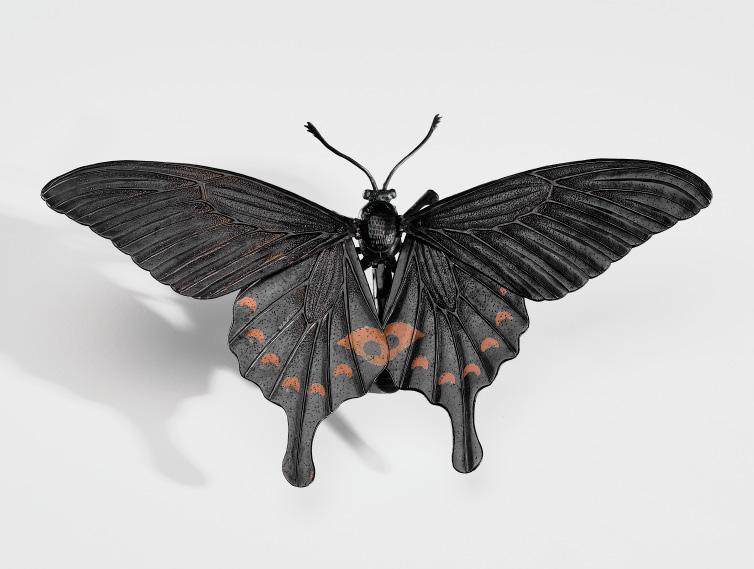

A SUPERB IRON JIZAI OKIMONO OF A CRAB
Japan, 18th-19th century, Edo period (1615-1868)
The naturalistically modeled and fully articulated crustacean with eight segmented legs, two large pincers in the front and two protruding eyes which are also movable. The carapace is carefully finished and the surface with a very good patina.
WIDTH 4.3 cm (the body only) and 15.1 cm (incl. legs)
WEIGHT 187.1 g
Condition: Excellent condition with minor wear, expected stiffness to some joints.
The basic principle of Japanese armor is its flexibility, being composed of a great number of small, lacquered metal plates laced together in rows allowing freedom of movement. It is this freedom which gave rise to the word jizai to describe jizai okimono, or articulated ornaments. The subjects of the jizai okimono makers
are chiefly dragons, snakes, crustaceans, birds, insects – any such creatures whose articulating feathers and scales protect them from harm, as do indeed the articulating components of a Japanese armor. Meticulously constructed with hammered plates of iron, these articulated figures were greatly sought after for decorative use and were the object of entertainment and discussion.
AUCTION COMPARISON

Compare a closely related iron articulated model of a crab, dated 18th-19th century, Edo period, the body 4.1 cm long, at Christie’s, An Inquiring Mind: American Collecting of Japanese & Korean Art, 25 April 2017, New York, lot 66 (sold for USD 22,500 or approx. EUR 26,000 converted and adjusted for inflation at the time of writing).
Estimate EUR 4,000
Starting price EUR 2,000

52
A RARE IRON MYOCHIN SCHOOL SUKASHI TSUBA IN THE FORM OF A SNAKE
Unsigned Japan, 18th century, Edo period (1615-1868)
Finely carved in the round (marubori) as a coiled writhing snake twisting its tail around its looped body forming the ryohitsu and naturalistically detailed with skillfully hammered scales, the eyes, mouth, and grass worked in gold hirazogan.
HEIGHT 7.8 cm, LENGTH 6.4 cm
WEIGHT 141.3 g
Provenance: An old collector’s number ‘272’ lacquered to the interior of the nakago hitsu-ana.
Condition: Very good condition with minor wear and few small losses to gold inlays.
MUSEUM COMPARISON
Compare a closely related Myochinschool iron tsuba of a snake in the Museum of Fine Arts, Boston, accession number 11.11959.
Estimate EUR 2,000 Starting price EUR 1,000



ICHIRYU TOMOTOSHI: A SUPERB AND LARGE MITO SCHOOL
SENTOKU TSUBA WITH SNAKE AND MONKEY
By Ichiryu Tomotoshi (1831-1889), signed Ichiryu Tomotoshi with kakihan
Japan, Mito, Hatachi province, mid-19th century, Edo period (1615-1868)
Of kakumarugata form, with one kozuka hitsu ana, the migakiji ground with a copper and shibuichi takabori details, and gold and iro-e takazogan, featuring a snake attacking a monkey that emerges from a small cave covered in vines. The reverse signed ICHIRYU
TOMOTOSHI with kakihan.
HEIGHT 9.3 cm, LENGTH 8.7 cm
WEIGHT 312.3 g
Provenance: The Philip and Nancy Kotler Collection, Sarasota, Florida, United States. Philip and Nancy Kotler are distinguished collectors and philanthropists best known for their landmark contributions to the field of studio glass, including the creation of the Philip and Nancy Kotler Glass Collection at The Ringling and the opening of the Kotler-Coville Glass Pavilion in 2018.

Nancy and Philip Kotler at the Philip and Nancy Kotler Glass Exhibit Opening at the Ringling Museum in 2018
Beyond glass, the Kotlers cultivated a discerning interest in Asian art— particularly sword fittings, netsuke, and related objects—extending their patronage to institutions such as the Racine Art Museum and the Museum of Arts and Design.
Philip Kotler, celebrated as the S.C. Johnson Distinguished Professor of International Marketing at Northwestern University and widely regarded as the “father of modern marketing,” together with Nancy Kotler, built a collection that reflects both scholarly passion and artistic vision.
Condition: Very good condition with minor wear.
Ichiryu Tomotoshi (1831-1889) is listed in Robert E. Haynes, The Index of Japanese Sword Fittings and Associated Artists, p. 2001 (H 10114.0). He was the fourth son of Tomoyoshi.
AUCTION COMPARISON
Compare a related large iron tsuba of a snake and monkeys at Zacke, Fine Japanese Art, 13 June 2025, Vienna, lot 63 (sold for EUR 19,500).
Estimate EUR 8,000
Starting price EUR 4,000
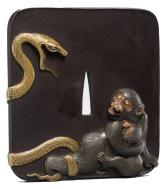

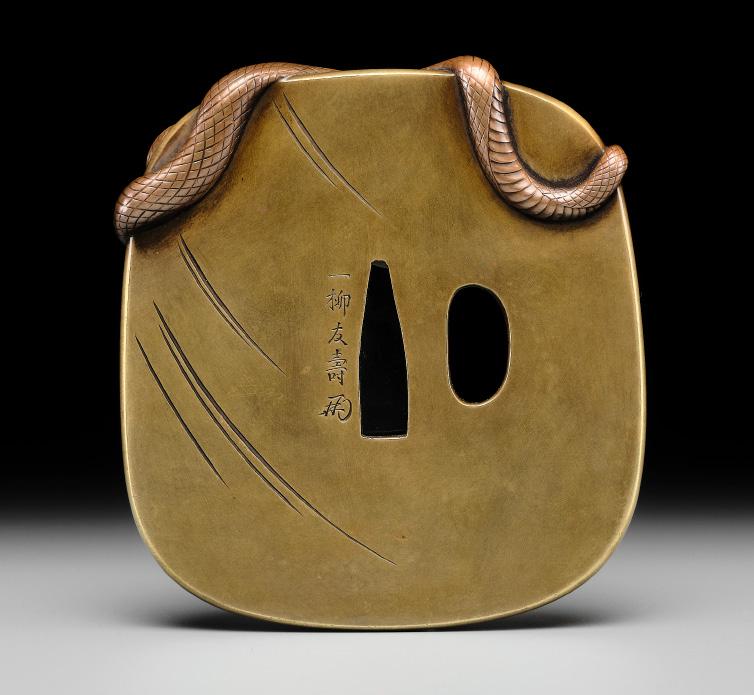

IWAMA MASAYOSHI: A SUPERB HAMANO SCHOOL SENTOKU TSUBA OF A COILING SNAKE
By Iwama Masayoshi (1764-1837), signed Katsuryuken Masayoshi with kakihan
Japan, first half of the 19th century, Edo period (1615-1868)
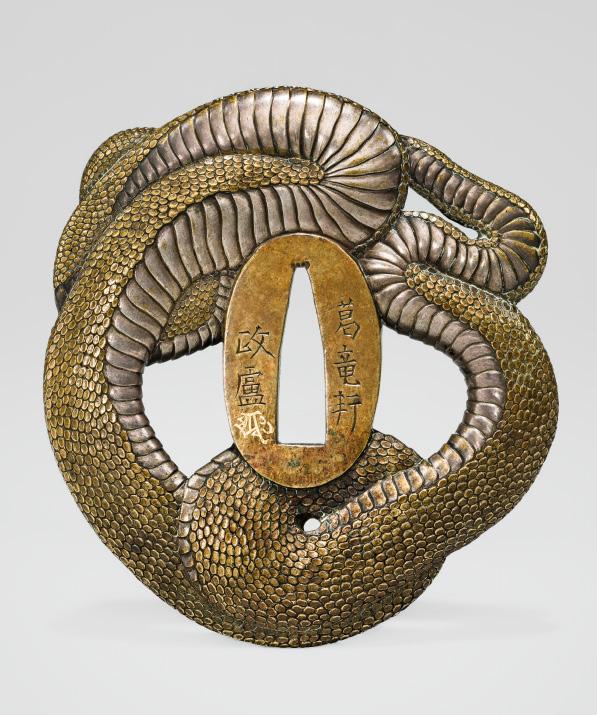
The tsuba in form of a coiling snake with meticulously rendered sentoku and silver scales, gold and suaka hirazogan eye, and sharp teeth framing the tongue. Signed KATSURYUKEN MASAYOSHI with the kakihan inlaid in gold hirazogan.
HEIGHT 8.2 cm, LENGTH 7.5 cm
WEIGHT 214 g
Provenance: The Philip and Nancy Kotler Collection, Sarasota, Florida, United States.
Condition: Very good condition with light wear.
Iwama Masayoshi (1764-1837) is listed in Robert E. Haynes, The Index of Japanese Sword Fittings and Associated Artists, p. 1007 (H 04907.0). He worked in Edo and was a student of Hamano Naoyuki, Nobuyuki and Toshiyuki.
While many later reproductions of this coiling snake model exist, they are typically cast entirely in bronze with little detail and lack the sophistication of the present example. The superior quality of this piece is evident in the crisply executed incisions of the scales and the selective use of mixed metals - particularly in the detailed treatment of the eyes and interior body - demonstrating Masayoshi’s masterful control and artistic sensibility.
AUCTION COMPARISON
Compare a related sentoku tsuba of a coiled snake, signed Eishi, dated to the Edo period, 8.3 cm tall, at Bonhams, Antique Arms and Armour, 30 April 2014, London, lot 21 (sold for GBP 3,750 or approx. EUR 6,900 converted and adjusted for inflation at the time of writing).
Estimate EUR 4,000
Starting price EUR 2,000


55
By Iwamoto Ryokan I or II (c. 1750-1775), signed Ryokan Japan, late 18th century, Edo period (1615-1868)
Of marugata form, with two hitsu ana, the nakago ana with copper sekigane, the surface rendered to resemble wonderfully weathered bark, with a copper and shakudo takabori snake curling around the sides, and with finely picked out gold hirazogan details. Signed RYOKAN.
HEIGHT 7.3 cm, LENGTH 7.1 cm
WEIGHT 144.4 g
Two artists of the Iwamoto Ryokan line are listed in Robert E. Haynes, The Index of Japanese Sword Fittings and Associated Artists, pp. 1491–1492 (H 07595.0 and H 07596.0). The first (H 07595.0) is identified as the third master of the Iwamoto family school, while the second (H 07596.0) is recorded as his student and successor.
Estimate EUR 3,000
Starting price EUR 1,500

Patrick Liebermann
Provenance: Ex-collection Patrick Liebermann. Patrick Liebermann (1948–2023) was a passionate collector of tsuba (Japanese sword guards). His journey began in 1970 when he unknowingly purchased his first tsuba, unaware it was a sword fitting—an encounter that sparked a lifelong dedication. Over the course of more than fifty years, Liebermann assembled an impressive collection of 450 pieces, always prioritizing quality over quantity. Rather than adhering strictly to specific schools, periods, or types such as sukashi or kinko, he was guided by the thematic content of each piece. His acquisitions were often made directly in Japan, with a discerning eye for originality and artistic merit. A selection of his collection was exhibited at the Bibliothèque Universitaire in Strasbourg in 2022, offering a glimpse into his refined and deeply personal approach to collecting.
Condition: Very good condition with minor wear.


56
TOSHITSUGU: A SUPERB SUAKA TSUBA WITH A SNAKE AND LOOFAH GOURD, WITH NBTHK TOKUBETSU KICHO (ESPECIALLY PRECIOUS) CERTIFICATE
By Toshitsugu, signed Toshitsugu Japan, mid to late 19th century
Published & Exhibited: Samouraïs. Guerriers et esthètes, Bibliothèque Nationale et Universitaire, Strasbourg, 11 March13 July 2022, p. 162, no. 175.
Of tateitomakigata form, the refined copper plate of ishimeji ground, decorated in gold and iro-e takazogan to depict a snake beneath a long gourd hanging from vines, flanked by two sparrows. The reverse with two edamame pods on a leafy vine and signed TOSHITSUGU.
HEIGHT 9.2 cm, LENGTH 7.6 cm
WEIGHT 219.8 g

With a tokubetsu kicho (especially precious) certificate of the NBTHK, dated 1 October 1977, with a snake and loofah motif, signed Toshi Tsugu, and of copper.
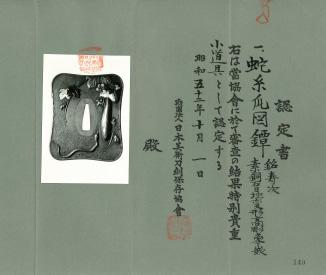
Provenance: Ex-collection Patrick Liebermann. Condition: Very good condition with minor wear.
AUCTION COMPARISON
Compare a related iron tsuba with an egret and bird, signed Toshitsugu, 19th century, 9.9 cm tall, at Bonhams, 18 May 2023, London, lot 287 (sold for GBP 3,570 or approx. EUR 4,500 converted and adjusted for inflation at the time of writing).
Estimate EUR 6,000
Starting price EUR 3,000
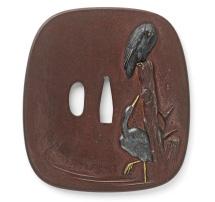
This design featuring a loofah gourd became popular in the latter half of the 19th century and was taken up by metalworkers, many of whom had previously specialized in sword fittings. Following the 1876 Sword Abolishment Edict, which restricted the public wearing of swords, demand for such fittings sharply declined. In response, many artisans turned their attention to decorative arts, using organic forms like gourds and vines to showcase their exceptional technical skill. A sublime example by the celebrated metalworker Shoami Katsuyoshi (1832–1908), also previously a maker of sword fittings, was sold at Bonhams, Fine Japanese Art, 16 May 2019, London, lot 190, for GBP 125,062 (fig. 1)

1
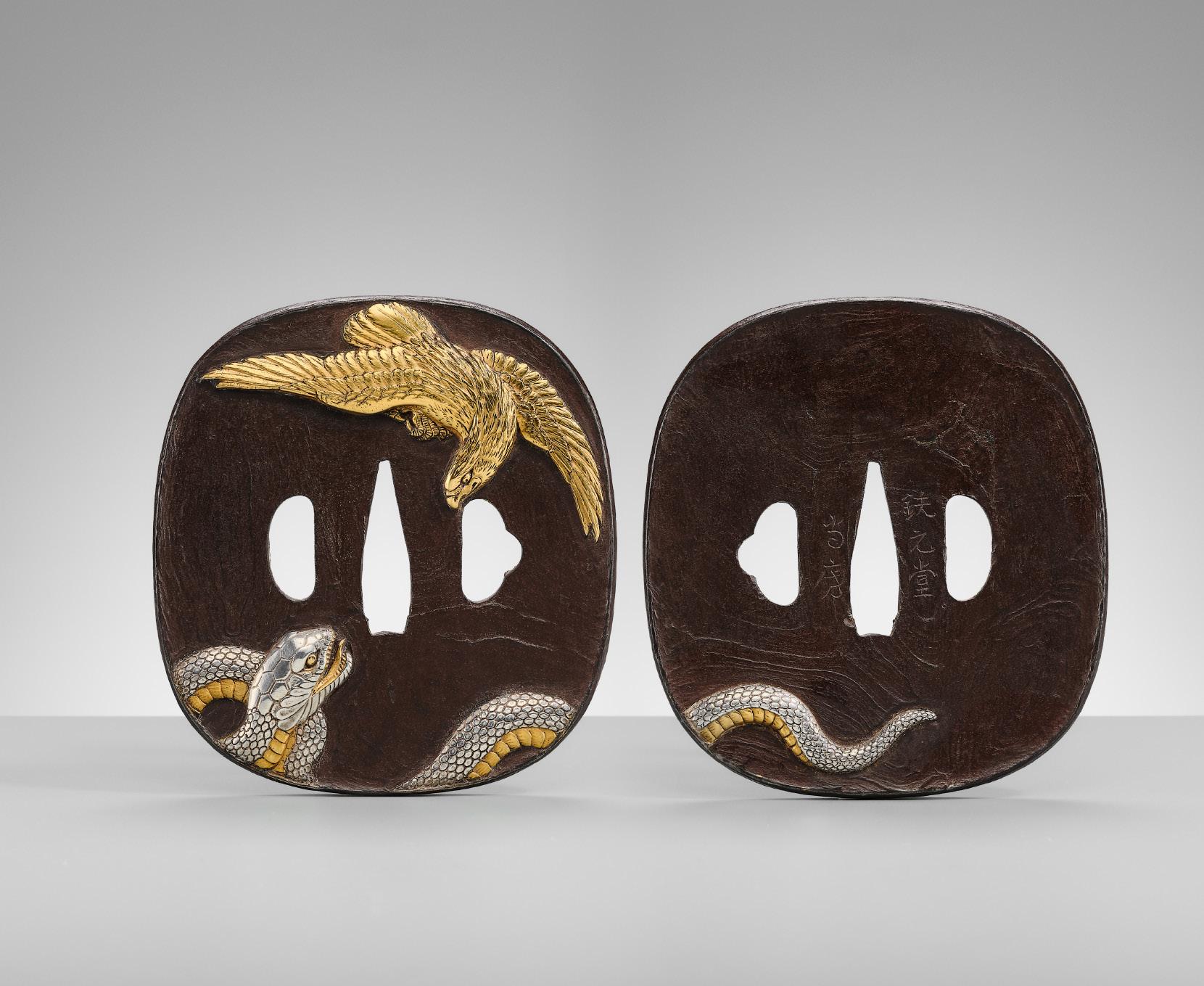
57 A SUPERB AND LARGE BAKUMATSU IRON TSUBA WITH A GOLD EAGLE AND SILVER SNAKE
Tetsugendo school, inscribed Tetsugendo Naofusa Japan, Bakumatsu (1853-1868) to Meiji period (1868-1912)
Of nagamarugata form, with a kozuka and kogai hitsu ana, the surface simulating mokume (wood grain), framed by a raised mimi (rim), with masterful gold and silver takazogan to depict an eagle and a snake, the plumage and scales naturalistically rendered, and with an honorific inscription TETSUGENDO NAOFUSA.
HEIGHT 9 cm, LENGTH 8.5 cm
WEIGHT 241.2 g
Provenance: From the private collection of Alan and Simone Hartman, New York. Alan Hartman (1930-2023) was an influential American art dealer, who took over his parents’ antique business in Manhattan and established the legendary Rare Art Gallery Alan and Simone Hartman

on Madison Avenue, with further locations in Dallas and Palm Beach. His wife Simone (née Horowitz) already served as assistant manager of the New York gallery before the couple were married in 1975, and together they built a renowned collection for over half a century.
Condition: Very good condition with minor wear.
The Tetsugendo school was founded by Shoami Tetsugendo and flourished during the late Edo period (1615-1868). The school invariably worked in iron and members often only signed with the name Tetsugendo.
AUCTION COMPARISON
Compare a related Tetsugendo school tsuba, with an ingenious design of a monkey catching an octopus, signed Tetsugendo, at Zacke, Fine Japanese Art, 13 June 2025, Vienna, lot 62 (sold for EUR 13,000).
Estimate EUR 4,000
Starting price EUR 2,000


With a tokubetsu kicho (especially precious) certificate of the NBTHK, dated May 1977.
59
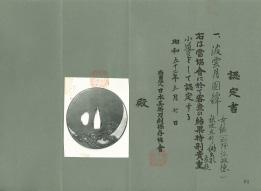
NAKAI TOMOTSUNE: A RARE CHOSHU SCHOOL IRON TSUBA WITH SAKURA
By Nakai Tomotsune, signed Nagato Hagi no ju Nakai Zensuke Tomotsune
Japan, 18th century, Edo period (1615-1868)
Of kawarigata form, with two kogai hitsu ana, the nakago ana with copper sekigane, featuring cherry blossoms on a bamboo raft, signed to one side Nagato Hagi ju Nakai zensuke, and the reverse TOMOTSUNE saku [made by Tomotsune Zensuke of the Nakai family, resident of Hagi, in the Province of Nagato].
HEIGHT 6.9 cm, LENGTH 5.7 cm
WEIGHT 54.5 g
Provenance: Collection of Falkenberg, Herwigsdorf-Rosenbach, Saxony, Germany, June 2019. A private collection, Saxony, Germany, acquired from the above.
Condition: Very good condition with minor wear.
Robert E. Haynes lists three Nakai Tomotsune in The Index of Japanese Sword Fittings and Associated Artists, p.2005-2006 (H 10144.0, H 10145.0, H 10146.0). However, he states that it is unclear whether there were two or three generations as the signatures of Tomotsune I and II are very difficult to set apart. Nakai Tomotsune I (1669-1723) is said to have been the son of Kawaji Tomotsune and adopted son of Tadatsugu.
Estimate EUR 1,500 Starting price EUR 800
58 A SHOAMI SCHOOL IRON TSUBA WITH WAVES AND A CRESCENT MOON, WITH NBTHK TOKUBETSU KICHO (ESPECIALLY PRECIOUS) CERTIFICATE
Unsigned Japan, 18th century, Edo period (1615-1868)
Of marugata form, with one kogai hitsu ana, carved in relief and worked in gold and silver takazogan, and gold nunomezogan, one side featuring a crescent silver moon emerging from crashing waves detailed with dew drops, the reverse depicting scrolling clouds.
HEIGHT 8.6 cm, LENGTH 8.4 cm
WEIGHT 260.4 g
Provenance: Ex-collection Patrick Liebermann.
Condition: Very good condition with minor wear and little rubbing to the nunome zogan.
AUCTION COMPARISON
Compare a related Shoami School iron tsuba, 18th century, 8 cm tall, at Bonhams, The Edward Wrangham Collection of Japanese Art, 9 November 2010, London, lot 90 (sold for GBP 1,920 or approx. EUR 4,000 converted and adjusted to inflation at the time of writing).
Estimate EUR 2,000 Starting price EUR 1,000


60
MASAKATA: A FINE ITO SCHOOL IRON SUKASHI TSUBA
By Ito Masakata (died 1774), signed Bushu no ju Masakata Japan, 18th century, Edo period (1615-1868)
Of kawarigata form, with a kozuka and kogai hitsu ana, worked in yo-sukashi to depict two insect-eaten leaves on curling stems, the veins finely incised in kebori, and decorated with gold nunomezogan tendrils and patches. Signed to one side Bushu no ju MASAKATA [Masakata resident of Bushu].
HEIGHT 7.4 cm, LENGTH 7.1 cm
WEIGHT 77.7 g
Condition: Excellent condition with only minor expected wear.
Ita Masakata (died 1774) is listed in Robert E. Haynes, The Index of Japanese Sword Fittings and Associated Artists, p.876 (H 04068.0). He is commonly known as Genjiro, and said to be the son of Masatsune and the second master of the Edo Ito school.
MUSEUM COMPARISON
Compare a related sukashi iron tsuba of ginko leaves, signed Bushu no ju Masakata, 7.6 cm tall, in the Ashmolean Museum, Oxford, accession number EAX.10531.
Estimate EUR 1,500 Starting price EUR 800


61 A VERY RARE ‘EUROPEAN LEATHER’ AWA SCHOOL IRON TSUBA
Unsigned Japan, 18th century, Edo period (1615-1868)
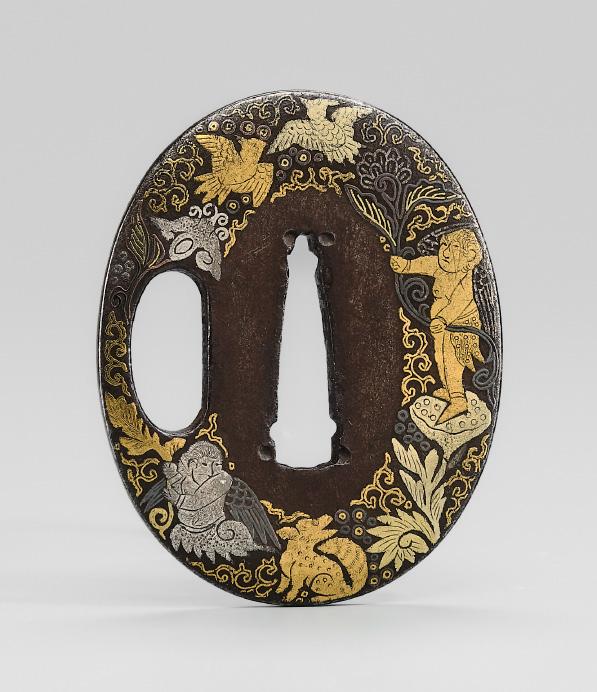
The small tsuba of nademarugata form, with one kozuka hitsu ana, delicately inlaid in nunomezogan with gold, sentoku, shakudo, silver, and copper, featuring a Dutch design of cupids among floral tendrils and mythical creatures. The mimi finely decorated in gold nunomezogan with a hatched design.
HEIGHT 5.8 cm, LENGTH 4.7 cm
WEIGHT 62 g
Provenance: Christie’s, A Fine Collection of Japanese Sword Fittings, 9 November 2005, lot 61. From the private collection of Alan and Simone Hartman, New York, acquired from the above. Condition: Very good condition with minor wear and little rubbing to gold.
With an associated wood tomobako (storage box).
The design, originally taken from Dutch embossed leather, is illustrated in the Soken Kisho, 1781.
MUSEUM COMPARISON
Compare a closely related Awa school iron tsuba with mythical creatures, 18th century, 6.5 cm tall, in the Victoria & Albert Museum, accession number M.1066-1910.
Estimate EUR 2,000 Starting price EUR 1,000
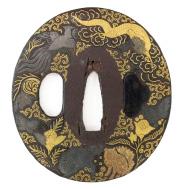

62
MITSUHIRO: A HIZEN SCHOOL SENTOKU AND GOLD ‘100 MONKEYS’ TSUBA
By Mitsuhiro, signed Hishu Yagami no ju Mitsuhiro Japan, early-mid 19th century, Edo period (1615-1868)
Of nademarugata form, with a kozuka hitsu ana, a shakudo plugged kogai hitsu ana, and the nakago ana with copper sekigane. Carved in typical style with hundred monkeys clambering over each other, their eyes accentuated in gold hirazogan, and the design continuing onto the rim. Signed to one side Hishu Yagami no ju MITSUHIRO [Mitsuhiro from Yagami in Hizen province], the reverse signed sento kin i saku kore [made with brass and gold].
HEIGHT 7.2 cm, LENGTH 7 cm WEIGHT 122 g
Provenance: The Saoud bin Mohammed Ali Al-Thani Foundation. Purchased at Piasa, Sale 1201. Asian Art, 14 June 2012, Paris, lot 40.
Condition: Very good condition with minor expected wear and light traces of use. One gold-inlaid eye is lost.

Robert E. Haynes lists three Noda Mitsuhiro in The Index of Japanese Sword Fittings and Associated Artists, p.1059-1060 (H 05200.0, H 05201.0, and H 05202.0). Noda Mitsuhiro I (c. 17501800) was the founder of the Yagami school of fitting makers and specialized in intricately carved iron tsuba often depicting monkeys. The two following generations continued his designs and are often quite difficult to distinguish as they both worked with similar materials. After the death of Mitsuhiro III, the Yamagi line came to an end. A family memorial was erected in 1929 at the site of the Noda residence.
The design incorporates a series of monkeys, each with distinctive traits. At the top appear the three symbolic figures who see no evil, hear no evil, and speak no evil. At the bottom, two monkeys engage in a neck-wrestling contest, bound together by a rope. In the upper left, one monkey carries a fan or baton, while below it another clasps a giant peach. At the lower right, a monkey is shown with a bag slung over its shoulder.
AUCTION COMPARISON
Compare a near-identical Hizen sentoku tsuba, attributed to Mitsuhiro, dated early-mid 19th century, at Bonhams, Fine Japanese Art, 8 November 2018, London, lot 88 (sold for GBP 7,250 or approx. EUR 12,500 converted and adjusted for inflation at the time of writing).
Estimate EUR 4,000
Starting price EUR 2,000
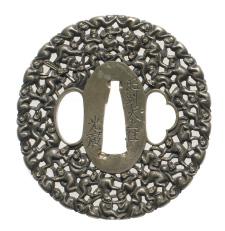


TAKESHIGE: AN IRON SUKASHI TSUBA WITH FIVE MONKEYS IN A PEACH TREE
By Takeshige (active c. 1800), signed Takeshige and kakihan Japan, Shimosa province, c. 1800, Edo period (1615-1868)
Of kawarigata form, the nakago ana with copper sekigane, pierced and carved as well as inlaid in gold and suaka takazogan and hirazogan to depict five frolicking monkeys pulling at branches with peaches, their fur neatly incised, all encircling the seppai dai which has a shakudo fill to the side. Signed TAKESHIGE with kakihan.
HEIGHT 6.4 cm, LENGTH 5.6 cm
WEIGHT 103 g
Provenance: The Philip and Nancy Kotler Collection, Sarasota, Florida, United States.
Condition: Excellent condition with minor expected wear and light traces of use.
Takeshige (c. 1800) is listed in Robert E. Haynes, The Index of Japanese Sword Fittings and Associated Artists, p. 1873 (H 09409.0).
Monkeys fetching peaches is a common subject in Japanese art. A Chinese legend has it that the Monkey King steals the Peaches of Immortality guarded by the Queen Mother of the West and consumes them.
MUSEUM COMPARISON
Compare a related earlier iron tsuba with eight monkeys and peaches, unsigned, in the Metropolitan Museum of Art, object number 91.1.753.

Estimate EUR 2,000
Starting price EUR 1,000

RARE
Unsigned Japan, mid-19th century, Edo period (1615-1868)
Of kawarigata form, with one kogai hitsu ana, the nakago ana with copper sekigane, modeled in the form of a coiled rat holding its long tail, the eyes in shakudo takazogan, and the fur neatly incised.
HEIGHT 7 cm, LENGTH 6.8 cm
WEIGHT 111.1 g
Provenance: Ex-collection Patrick Liebermann. Condition: Excellent condition with minor wear and little rubbing to the shakudo eyes.
In Japan, the rat (nezumi) symbolizes prosperity, fertility, wealth, resourcefulness, and adaptability. It is the first sign of the Japanese zodiac, representing beginnings, and is a companion and messenger to Daikoku, the god of wealth. The rat’s ability to thrive even in difficult times makes it a symbol of good fortune and abundant harvests.
MUSEUM COMPARISON
Compare a closely related shibuichi tsuba of a coiled rat, unsigned, mid-19th century, 6.7 cm tall, in the Museum of Fine Arts, Boston, accession number 11.12129.
Estimate EUR 2,000 Starting price EUR 1,000
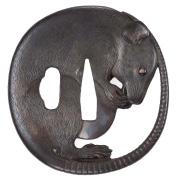
PUBLISHED & EXHIBITED Samouraïs. Guerriers et esthètes, Bibliothèque Nationale et Universitaire, Strasbourg, 11 March-13 July 2022, p. 123, no. 104.




65
HARUAKI: A FINE ‘TANUKI HARA NO TSUZUMI’ SHAKUDO NANAKO TSUBA, WITH TOKUBETSO KICHO (ESPECIALLY PRECIOUS) NBTHK CERTIFICATE
By a member of the Haruaki school, signed Haruaki Hogen with kakihan
Japan, 19th century, Edo period (1615-1868)
Published & Exhibited: Samouraïs. Guerriers et esthètes, Bibliothèque Nationale et Universitaire, Strasbourg, 11 March-13 July 2022, p. 157, no. 166.
Of sumikirigata form, with one kozuka hitsu ana, the shakudo nanako ground with gold and iro-e takazogan, the mimi in shibuichi, featuring a tanuki changing into a tea kettle under the full moon, the reverse with further reeds beside a stream and signed HARUAKI Hogen [an honorific title] with kakihan.
HEIGHT 5.9 cm, LENGTH 5.2 cm
WEIGHT 93.7 g
Provenance: Ex-collection Patrick Liebermann. Condition: Very good condition with minor wear.
Haruaki (1787-1857) is listed in Robert E. Haynes, The Index of Japanese Sword Fittings and Associated Artists, p.197-198 (H 00760.0). Haynes identified the artist as a student of Yanagawa Naomitsu. After studying he moved to Tokyo where he founded his own studio, receiving the title of Hogen at age 40. He had a vast number of students and followers who signed with his name.
MUSEUM COMPARISON
Compare a related shakudo tsuba, signed Haruaki Hogen, 19th century, 7 cm, in the Metropolitan Museum of Art, object number 36.120.11.
Estimate EUR 3,000
Starting price EUR 1,500

With a tokubetsu kicho (especially precious) certificate of the NBTHK, dated 10 June 1972, described as a shakudo nanako tsuba with a tanuki under the moon, signed Haruaki Hogen with kakihan.


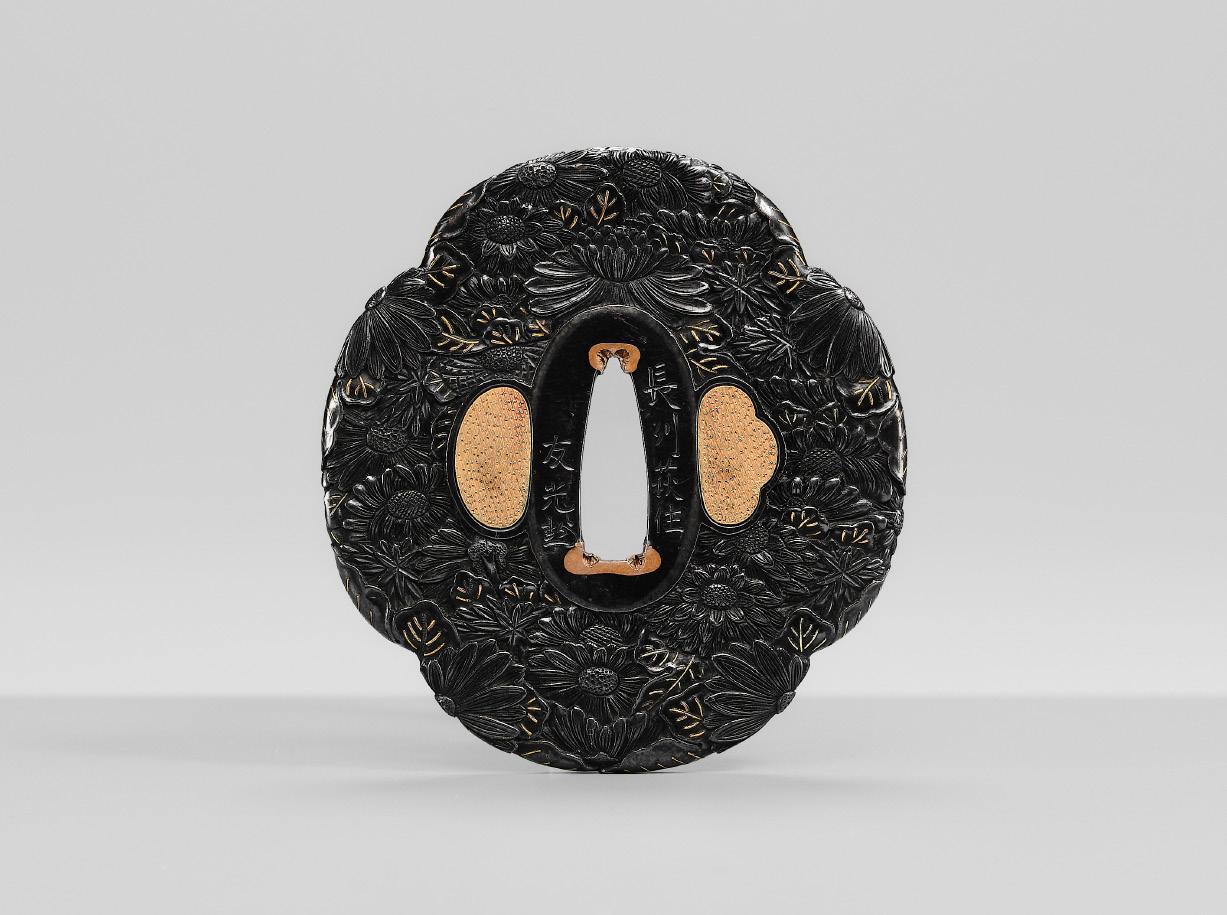
66 TOMOMITSU: A FINE SHAKUDO TSUBA WITH KIKU
By Tomomitsu, signed Choshu Hagi no ju Tomomitsu with kakihan Japan, Nagato province, early to mid-18th century, Edo period (1615-1868)
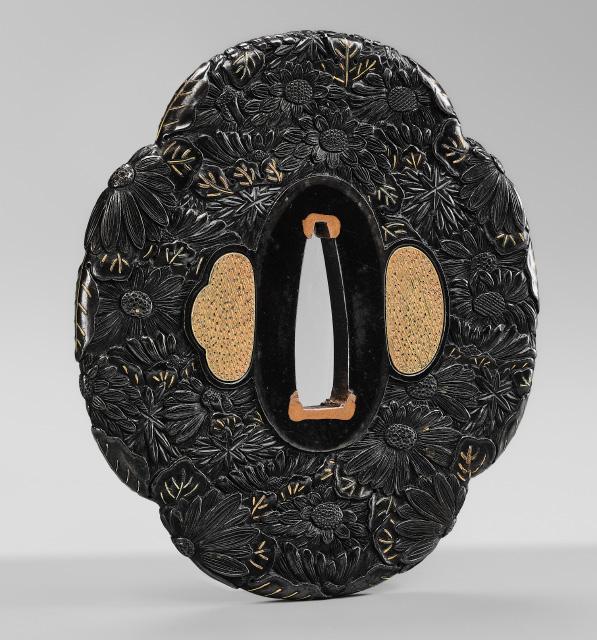
Of mokkogata form, with a copper-gold plugged kozuka and kogai hitsu ana, the nakago ana with copper sekigane, finely carved in relief with a myriad of chrysanthemums, the veins of the leaves detailed in gold takazogan. Signed Choshu Hagi no ju TOMOMITSU [Tomomitsu, resident of Hagi, Choshu province].
HEIGHT 8 cm, LENGTH 7.5 cm
WEIGHT 149.5 g
Provenance: From the private collection of Alan and Simone Hartman, New York.
Condition: Excellent condition with only very minor wear.
With a wood tomobako (storage box).

There are two Tomomitsu listed in in Robert E. Haynes, The Index of Japanese Sword Fittings and Associated Artists, p. 1980 (H 09974.0- 09975.0). Both signed with the prefix Choshu Hagi no ju and both were active in the early to mid-18th century.
MUSEUM COMPARISON
Compare a related earlier shakudo tsuba with chrysanthemums, signed Choshu Hagi no ju Tomomitsu with kakihan, 17th century, 7 cm tall, in the Metropolitan Museum of Art, object number 33.40.21.
Estimate EUR 3,000
Starting price EUR 1,500
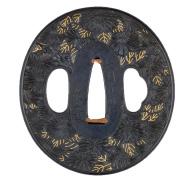
67
AN IRON HAMANO SCHOOL TSUBA DEPICTING A SNAIL ON AN OLD TREE, WITH HOZON TOSOGU NBTHK CERTIFICATE
Unsigned Japan, c. 1800, Edo period (1615-1868)
Of nademarugata, with one kozuka hitsu ana, the iron beautifully worked to resemble the natural texture and surface of tree bark, worked in takabori, and embellished with fine gold, suaka, and shakudo takazogan. The tree bark is detailed with leafy vines and a snail to the lower section.
HEIGHT 7.5 cm, LENGTH 7 cm
WEIGHT 118 g
Provenance: Ex-collection Patrick Liebermann.
Condition: Very good condition with minor wear.
Estimate EUR 2,000
Starting price EUR 1,000
With a Hozon Tosogu (worthy of preservation) certificate of the NBTHK, dated 17 January 2014, with the description ‘featuring old wood with snail’, mumei (unsigned), and from the Hamano school.


HEIGHT 6.4 cm, LENGTH 5.8 cm
WEIGHT 77.5 g

68 A FINE HAMANO SCHOOL SENTOKU TSUBA DEPICTING SNAILS
Unsigned Japan, 19th century, Edo period (1615-1868)
Of nademarugata form, with one kozuka hitsu ana, the nakago ana with copper sekigane, of ishimeji ground, worked with gold, silver, and shibuichi takazogan to depict a snail and grasses to one side, and a hole pierced though the side with a second snail emerging from the reverse.
Provenance: A private collection in Saxony, Germany, acquired at Auer Dult, April 2018.
Condition: Very good condition with light wear.
Estimate EUR 2,000
Starting price EUR 1,000
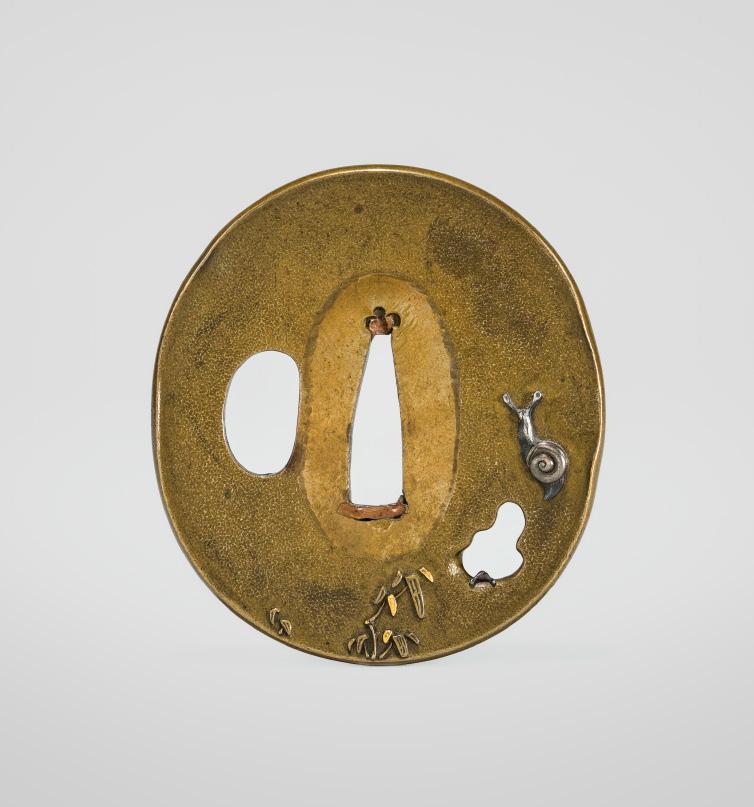

YANAGAWA NAOMASA: A FINE YANAGAWA SCHOOL
SHAKUDO TSUBA WITH SHISHI AND PEONIES
Lineage of Yanagawa Naomasa, signed Yanagawa Naomasa Japan, 19th century, Edo period (1615-1868)

Of marugata form, with one kozuka hitsu ana, the nakago ana with sekigane, the ishimeji ground finely decorated in gold and iro-e takazogan, featuring a shishi frolicking beside a blossoming branch of peonies. The reverse with another peony sprig, the bloom detailed in silver. Signed YANAGAWA NAOMASA.
HEIGHT 7.4 cm, LENGTH 7.2 cm
WEIGHT 128.6 g
Condition: Very good condition with minor wear.
Two artists named Yanagawa Naomasa, father and son, appear in the Haynes Index of Japanese Sword Fittings and Associated Artists with the same signature, see p. 1327-1328 (H 06690.0 & H 06692.0).
The pairing of shishi and peonies (botan shishi) is a longstanding motif in Japanese traditional art. The shishi, a Buddhist symbol of power and protection, was regarded as the ‘king of the animals’, while the peony, symbolizing wealth and good fortune, was considered the ‘queen of the flowers’, being both together considered as fitting and auspicious companions.
Compare a closely related Yanagawa School tsuba with shishi and peony, signed Yanagawa Naomasa, 19th century, 7.5 cm tall, at Bonhams, The Paul Goodman collection of Japanese arrowheads, swords and fittings, 20 October 2015, New York, lot 72 (at an estimate of USD 3,500 or approx. EUR 4,100 converted and adjusted for inflation at the time of writing).
Estimate EUR 3,000
Starting price EUR 1,500
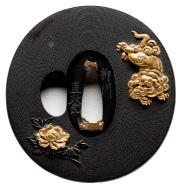

70
ISHIKAWA YOSHITADA AND KANO YOSHINOBU: A SHONAI SEKIBUN SCHOOL SUAKA TSUBA WITH A TIGER
By Ishikawa Yoshitada (1723-1801) and Kano Yoshinobu (c. 1750-1800), signed Ishikawa Yoshitada with kakihan and Kano Yoshinobu with kakihan Japan, first half of the 18th century, mid-late Edo period (1615-1868)
Of nademarugata form, the migakiji (polished) ground with takanikubori, kebori, and katakiribori, as well as gold and silver takazogan and shakudo hirazogan, featuring a tiger looking back at scrolling clouds and pouring rain, alluding to a dragon hidden within the cloudy mist. The reverse depicts a pine tree. Signed to one side KANO YOSHINOBU with kakihan, and the verso ISHIKAWA YOSHITADA with kakihan.
HEIGHT 7 cm, LENGTH 6.6 cm
WEIGHT 120 g
Provenance: From an old German private collection.
Condition: Very good condition with minor wear and the tiger with varnish.
Ishikawa Yoshitada (1723-1801) is listed in Robert E. Haynes, The Index of Japanese Sword Fittings and Associated Artists, p. 2337 (H12127.0). He was the student of Sugiura Joi and retainer of the Matsudaira Daimyo in Edo.
Kano Yoshinobu (c. 1750-1800) is listed in Robert E. Haynes, The Index of Japanese Sword Fittings and Associated Artists, p. 2316 (H11976.0).
PUBLISHED
Günther Heckmann, Tsuba, H.U.B Verlag, Nürtingen, 1995, T 78.


AUCTION COMPARISON
Compare a related suaka Sekibun tsuba depicting a tiger at Bonhams, Arts of the Samurai, 27 October 2014, New York, lot 1214 (sold for USD 5,000 or approx. EUR 6,000 converted and adjusted for inflation at the time of writing).
Estimate EUR 2,500
Starting price EUR 1,200
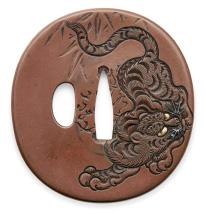
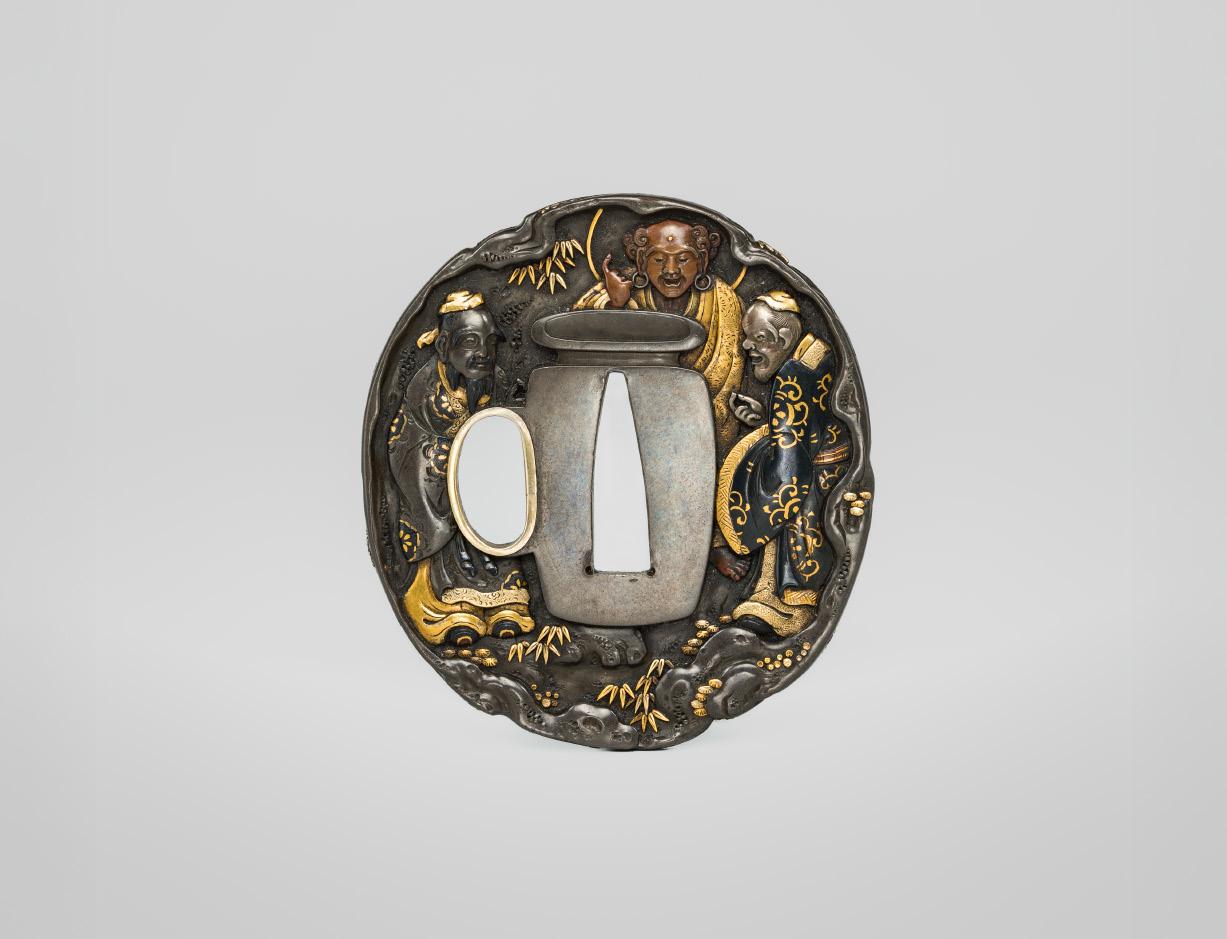
Unsigned Japan, 19th century, Edo period (1615-1868)

Of nademarugata form, with one gold-lined kozuka hitsu ana, carved in shishiaibori and katakiribori, detailed with gold and iro-e takazogan, featuring the three sages, Shaka, Roshi, and Koshi, standing around a large sake jar with cheerful expressions as they are clearly inebriated from testing a little too much sake. The reverse depicting a misty landscape with a waterfall emerging from rockwork, partly shrouded in clouds.
HEIGHT 7.1 cm, LENGTH 6.6 cm
WEIGHT 111 g
Provenance: The Philip and Nancy Kotler Collection, Sarasota, Florida, United States.
Condition: Very good condition with minor wear.
The subject represents Sakusui Sankyo with three sages, Shaka (The historical Buddha), Koshi (Confucius), and Roshi (Laozi), who are often depicted tasting sake from a jar. This depiction is a metaphor explaining that although religious or philosophical origins are expressed differently, ultimately, they are derived from the same source.
AUCTION COMPARISON
Compare a related shibuichi tsuba with three sake tasters, signed Seiryoken, dated to the end of the 19th century, 8.7 cm tall, at Nagel Auctions, Fine Asian Art I, 6 June 2025, Stuttgart, lot 212 (sold for EUR 5,000).
Estimate EUR 2,500
Starting price EUR 1,200

72
MORITA MOTOTOSHI: A FINE SHIBUICHI TSUBA WITH RIHAKU IN A WINTER SCENE
By Morita Mototoshi, signed Morita Mototoshi with kakihan Japan, c. 1850, Edo period (1615-1868)
Of kakugata form, with one kozuka hitsu ana, the shibuichi migakiji ground carved in shishiaibori and katakiribori, and with gold, shakudo, and silver takazogan, to depict Rihaku (Li Bai) reading a scroll in a cave, the reverse with snow-capped mountains and a stream, signed MORITA MOTOTOSHI with kakihan.
HEIGHT 6.1 cm, LENGTH 5.5 cm
WEIGHT 119.3 g
Provenance: From the private collection of Alan and Simone Hartman, New York.
Condition: Very good condition with minor wear.
Morita Mototoshi is listed in Robert E. Haynes, The Index of Japanese Sword Fittings and Associated Artists, p.1185 (H 05954.0). He was a student of Naijo Motonaga and of the first Taizan Motozane and also crafted fine metal inlays for inros.
With a wood tomobako (storage box).
Estimate EUR 2,000
Starting price EUR 1,000


73
YASUCHIKA: A NARA SCHOOL SUAKA TSUBA WITH A FISHERMAN
Lineage of Tsuchiya Yasuchika, sealed Yasuchika Japan, second half of the 18th century, Edo period (1615-1868)
Published: Günther Heckmann, Tsuba, H.U.B Verlag, Nürtingen, 1995, T 81.
Of nademarugata form, with one kozuka hitsu ana, the nakago ana with some shakudo sekigane, the tsuba of ishimeji ground, finely worked in gold, silver, and shakudo takazogan and shishiaibori to depict a poetic scene of a fisherman at shore holding a jar and looking up at a flock of geese flying below the moon. The reverse with a river emerging from rockwork and leading into a lake. The mimi (rim) incised with fine lines reminiscent of bark. Sealed to the back YASUCHIKA in gold hirazogan within a square reserve.
HEIGHT 6.3 cm, LENGTH 5.8 cm
WEIGHT 90 g
Provenance: From an old German private collection.
Condition: Very good condition with minor wear and light scratching to one side.
MUSEUM COMPARISON
Compare a related shakudo and shibuichi tsuba of a fisherman and cuckoo, signed Yasuchika, 19th century, 5.4 cm tall, in the Ashmolean Museum, Oxford, accession number EAX.10951.
Estimate EUR 2,000
Starting price EUR 1,000


SUGIURA JOI: A SUPERB SHIBUICHI TSUBA WITH MANZAI DANCERS
By Sugiura Joi (1701-1761), signed Issando Joi Japan, c. 1750, Edo period (1615-1868)
Of nagamarugata form, with a kozuka hitsu ana plugged in shakudo, the migakiji ground superbly detailed with gold and iro-e takazogan and carved in sukidashibori and takabori, one side depicting two Manzai dancers, one drumming, the other dancing with a fan. The reverse with a festive decoration with inscription ‘Iccho Hama’.
Signed ISSANDO JOI.
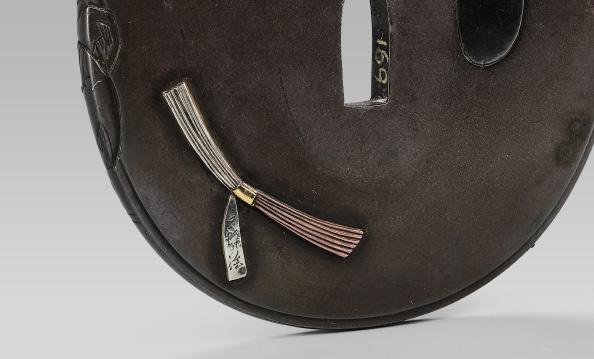
PUBLISHED
Günther Heckmann, Tsuba, H.U.B Verlag, Nürtingen, 1995, T 77.


HEIGHT 7.7 cm, LENGTH 7.2 cm WEIGHT 153.3 g
Provenance: Ex-collection Blockley. The inner rim of the nakago lacquered with a collector’s number ‘169’.
Condition: Very good condition with minor wear and a few light surface scratches as are to be expected.
Estimate EUR 3,000
Starting price EUR 1,500
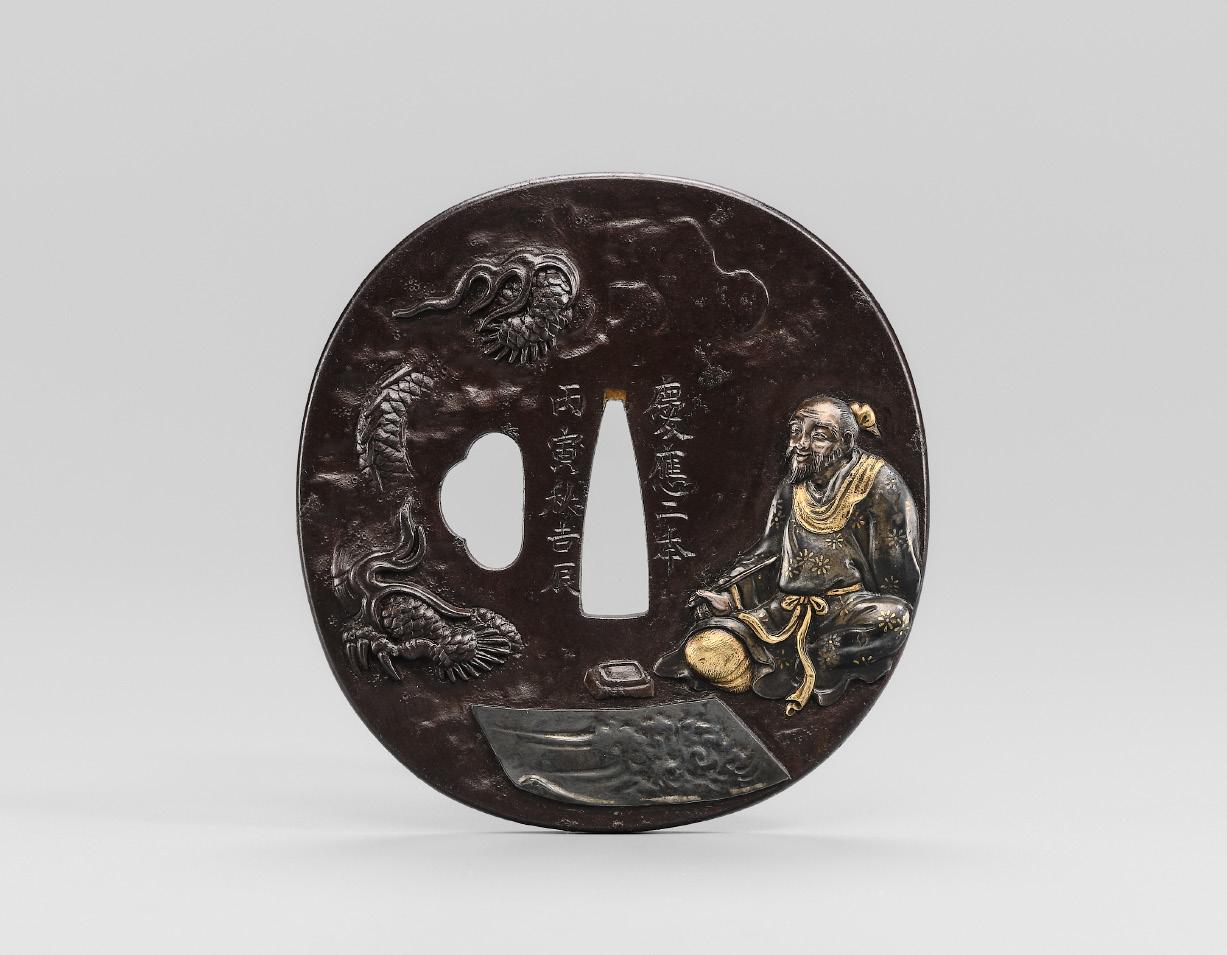
75
WATAI TANETORA: A SUPERB MITO SCHOOL IRON TSUBA DEPICTING SO FUKO AND DRAGON, DATED 1866
By Watai Tanetora, signed Mito Watai Tanetora saku Japan, dated 1866, Edo period (1615-1868)
PUBLISHED
Günther Heckmann, Tsuba, H.U.B Verlag, Nürtingen, 1995, T 115.


Of nagamarugata form, with one kogai hitsu ana, the nakago with a copper sekigane, masterfully worked in takabori and shishiaibori, with details in gold and iro-e takazogan, featuring So Fuko (Cao Buxing) painting a dragon which is so realistic it emerges from the silk. One side inscribed, Keio nen hineo no tora aki kishin [on a lucky day in autumn in the second year of the Kineo reign (1866), year of the fire tiger], the reverse signed Mihan WATAI TANETORA saku [made by Watai Tanetora of Mito].
HEIGHT 8.2 cm, LENGTH 7.9 cm
WEIGHT 191.2 g
Provenance: Ex-collecton H. Saenger, Hamburg. Condition: Excellent condition with only minor expected wear.
Tanetora is listed in Robert E. Haynes, The Index of Japanese Sword Fittings and Associated Artists on p.1882 (H 09458.0). Haynes notes that there are supposedly two generations of Tanetora.
Estimate EUR 4,000
Starting price EUR 2,000


ICHINOMIYA NAGAMITSU: A SUPERB SHIBUICHI TSUBA DEPICTING THE GREAT BELL OF CHIONIN
By Ichinomiya Nagamitsu (active c. 1800-1825), signed Nagamitsu and kakihan
Japan, c. 1800, Edo period (1615-1868)
Of marugata form, partially worked in yo-sukashi and decorated with gold and iro-e takazogan, depicting a lively group of figures including a sarumawashi and his monkey, the Wisteria Maiden Fujihime, and other folkloric characters visiting the Chion-in Temple in Kyoto, awed by the immense proportions of the great bell. The details are finely executed, with a blossoming sakura tree flowing gracefully around the composition, its petals inlaid in silver takazogan.
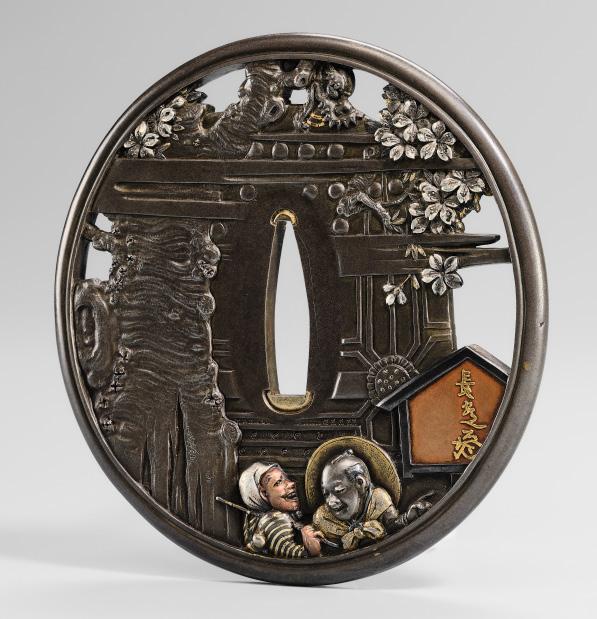
The large bell, or Ogane, is only rung during the memorial services for Honen, held in April, and on New Year’s Eve (Joya no Kane), where it is rung 108 times, struck by a team consisting of one leader with sixteen assistants. The bell, or bonsho, is struck at midnight of December 31, as a part of the Omisoka celebrations.
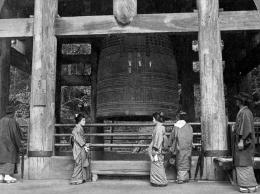
Kyoto, Japan, 1904
One side signed in gold NAGAMITSU with kakihan on an ema (votive plaque) and the reverse dated also in gold characters to the bell Meiwa gannen [first year of Meiwa (1764)], which likely indicates the date this design was first executed by the Ichinomiya school.
DIAMETER 8.5 cm
WEIGHT 186 g
Provenance: The Philip and Nancy Kotler Collection, Sarasota, Florida, United States.
Condition: Excellent condition with only very minor wear.
Ichinomiya Nagamitsu (active c. 1800–1825), a student of Nagayoshi and a representative craftsman of the Ichinomiya school, known for its refined workmanship and expressive style, is listed in the Haynes Index of Japanese Sword Fittings and Associated Artists (p.1291, H 06481.0).
LITERATURE COMPARISON
Compare a closely related tsuba by Ichinomiya Nagatsune, also with an inscribed gold date of 1764 and of identical design, illustrated in In LotusLand Japan by Herbert G. Ponting, F.R.G.S., Macmillan and Co., Ltd., London, 1910.
Estimate EUR 5,000
Starting price EUR 2,400
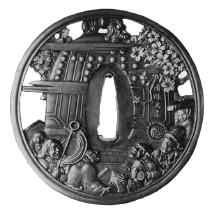
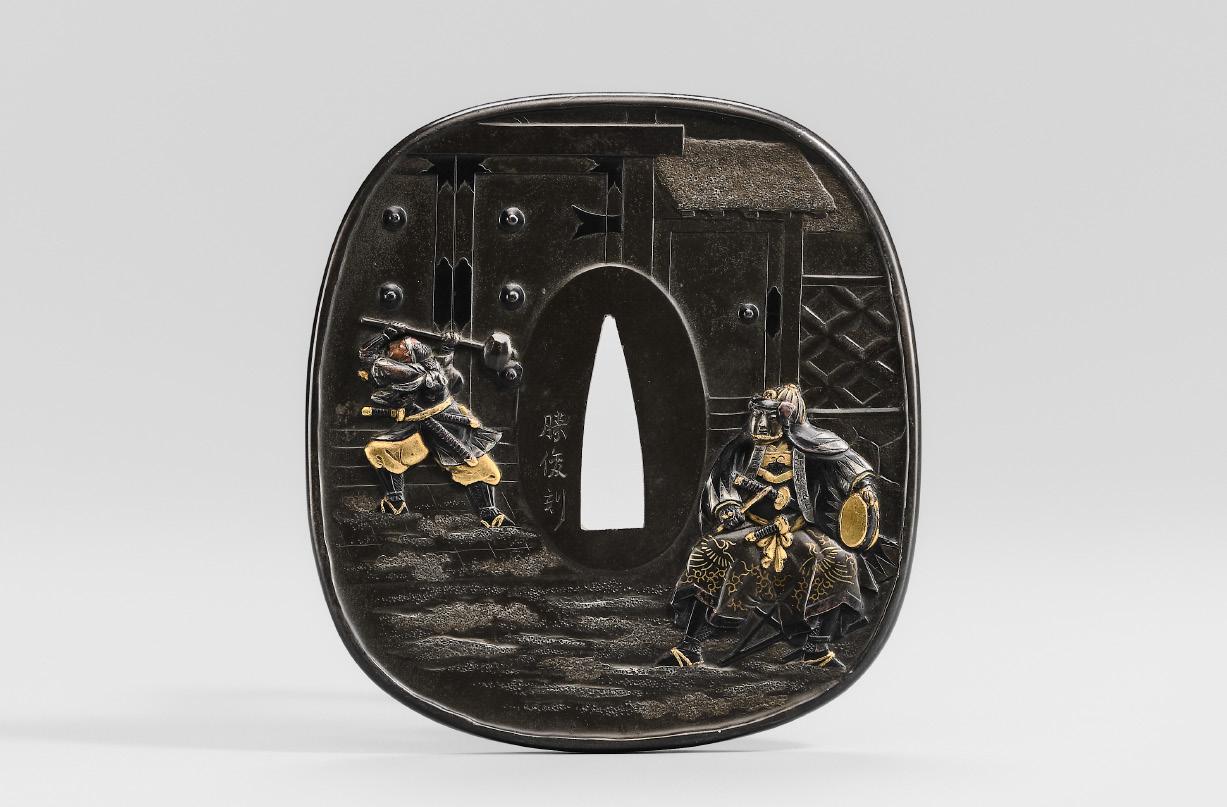
KATSUTOSHI: A SUPERB MITO SCHOOL SHIBUICHI TSUBA WITH THE A SCENE FROM THE 47 RONIN
By Katsutoshi (born 1832), signed Katsutoshi kaku Japan, late 19th century, Meiji period (1868-1912)
Of nagamarugata form, with gold and iro-e takazogan and stippled details, one side featuring Oishi Kuranosuke with another ronin storming the gate of Kira Yoshinaka with a sledgehammer, Oishi seated in a foldable chair and drumming and his robe incised at the hems ‚Ooishi’ and ‘Akoroshi (47 ronin)’. The reverse with another ronin climbing over a wall with a ladder. Signed KATSUTOSHI kaku [engraved by Katsutoshi].
HEIGHT 8.7 cm, LENGTH 8.1 cm
WEIGHT 190 g

Provenance: The Philip and Nancy Kotler Collection, Sarasota, Florida, United States.
Condition: Excellent condition with minimal surface wear.
Katsutoshi is listed in the Haynes Index of Japanese Sword Fittings and Associated Artists (H 02910.0). He was born in 1832, still alive in 1912 and was a student of the first Hagiya Katsuhira.
AUCTION COMPARISON
For a related work by the artist, signed Katsutoshi saku, see Bonhams, Arts of the Samurai, 16 October 2012, New York, lot 1093 (sold for USD 6,875 or approx. EUR 8,300 converted and adjusted for inflation at the time of writing).
Estimate EUR 5,000
Starting price EUR 2,400


The story of the 47 Ronin is one of Japan’s most famous tales of loyalty and honor. In 1701, Asano Naganori, the young lord of Ako, was provoked and insulted by the corrupt court official Kira Yoshinaka while on duty in Edo Castle. Losing his temper, Asano drew his sword inside the shogun’s palace, a grave offense, and was ordered to commit seppuku (ritual suicide). His retainers were left masterless, becoming ronin. For nearly two years, the ronin, led by Oishi Kuranosuke, secretly planned revenge. In the winter of 1703, they attacked Kira’s mansion in Edo, killed him, and placed his severed head on Asano’s grave as a final act of loyalty. After surrendering, all forty-seven were sentenced to death but allowed to commit seppuku, admired by the public as models of samurai honor (bushido). Their graves remain a symbol of unwavering loyalty and righteousness in Japanese culture.

See a related subject from the Fifty woodblock prints from Stories of the True Loyalty of the Faithful Samurai (Seichu gishi den), by Utagawa Kuniyoshi (1797-1861), 19th century
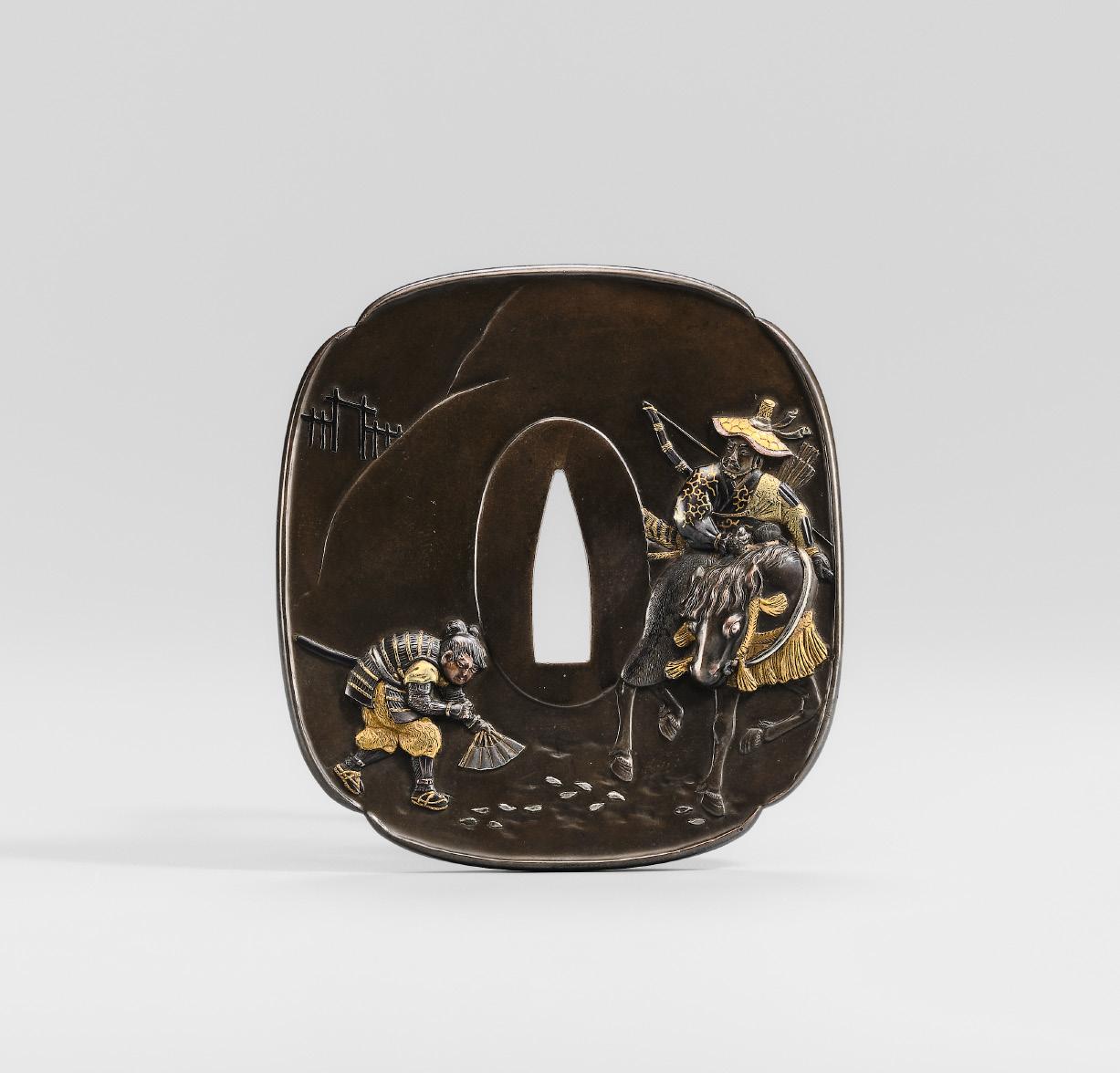
78
HAGIYA KATSUHIRA: A SUPERB MITO SCHOOL
SHIBUICHI TSUBA DEPICTING SAMURAI STOPPING TO VIEW SAKURA (CHERRY BLOSSOMS)
By Hagiya Katsuhira (1804-1886), signed Seiryoken Hagiya Katsuhira and kakihan
Japan, c. 1860
Of mokkogata form, the shibuichi migakiji ground decorated in masterful gold and iro-e takazogan, featuring a samurai on horseback stopping to admire a beautifully blooming cherry tree detailed with fine silver petals on the reverse, a second samurai kneeling, holding a war fan, and looking at the fallen petals, indicating the changing of the seasons. Signed Seiryoken HAGIYA KATSUHIRA with the artist’s typical kakihan.
HEIGHT 8.4 cm, LENGTH 7.9 cm
WEIGHT 174.5 g
Provenance: The Philip and Nancy Kotler Collection, Sarasota, Florida, United States.
Condition: Very good condition with minor wear.
Hagiya Katsuhira (1804-1886), art name Seiryoken, is listed in Robert E. Haynes, The Index of Japanese Sword Fittings and Associated Artists, p.576 (H 02759.0). In 1844, the Matsudaira Daimyo of Mito Domain appointed him an official metal artist to the Tokugawa government.
Minamoto no Yoshiie on horseback looking solemnly to the side, watching as cherry blossom petals fall gently to the ground, Katsushika Hokusai (1760-1849)

Hanami, the tradition of viewing cherry blossoms, held profound symbolic weight for the samurai, whose code of bushidō revered a life of brief, radiant beauty and honorable death, much like the blossoms themselves that fall at their peak. Beneath cascades of sakura, warriors contemplated the impermanence of life (無 常, mujō), embracing the poetic tension between duty, death, and fleeting grace.
MUSEUM COMPARISON
Compare a related shibuichi tsuba with the race across the Uji River, by Hagiya Katsuhira, 19th century, 8.4 cm, in the Museum of Fine Art, Boston, accession number 11.11912.
Estimate EUR 5,000
Starting price EUR 2,400

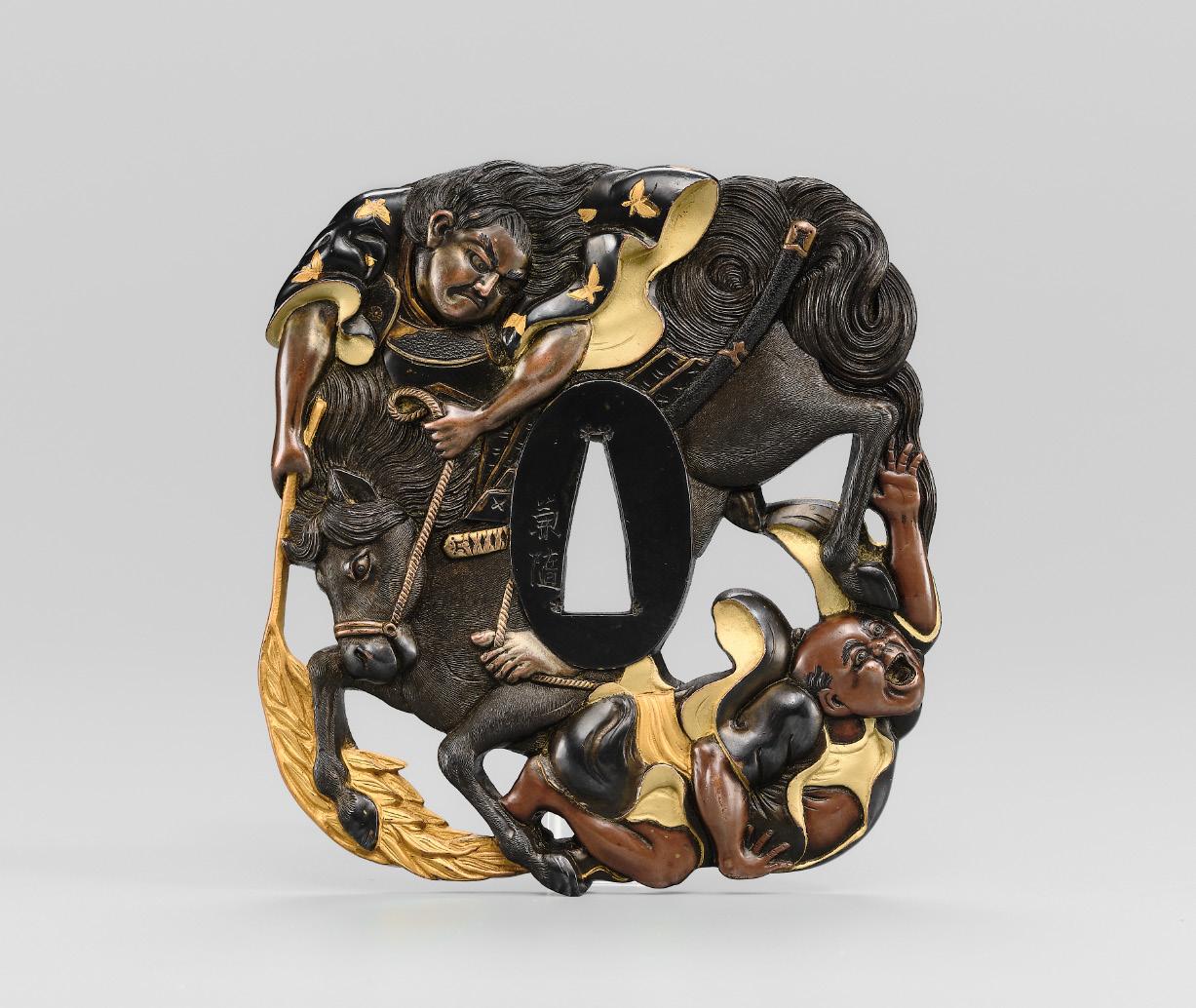
79
KANEYUKI: A SUPERB AND LARGE SUKASHI KINKO TSUBA WITH A SAMURAI ON HORSEBACK
By Kaneyuki, signed Kaneyuki Japan, second half of the 19th century
Of kawarigata form, chiseled in marubori (round carving), decorated in gold and iro-e takazogan as well as some gold lacquer to depict a remarkably dynamic scene of a warrior on horseback brandishing a willow branch and trampling on a man. Signed to one side KANEYUKI.
HEIGHT 9.8 cm, LENGTH 9.2 cm
WEIGHT 412.6 g
Provenance: Ex-collection Adrian H. Joline (1850-1912), bequeathed to the Metropolitan Museum of Art, New York, and subsequently de-accessed. Christie’s, Japanese Art Including Property of The Metropolitan Museum of Art, 28 March 2006, New York, lot 247 (part lot, sold for USD 8,400 or approx. EUR 11,800 converted and adjusted for inflation at the time of writing). From the private collection of Alan and Simone Hartman, New York, acquired from the above.

and Simone Hartman
Condition: Excellent condition with only very minor wear.
With a wood tomobako (storage box).
Two Kaneyuki are listed in Haynes Index of Japanese Sword Fittings and Associated Artists on p.547 (H 02616.0 and H 02617.0).
Estimate EUR 6,000
Starting price EUR 3,000


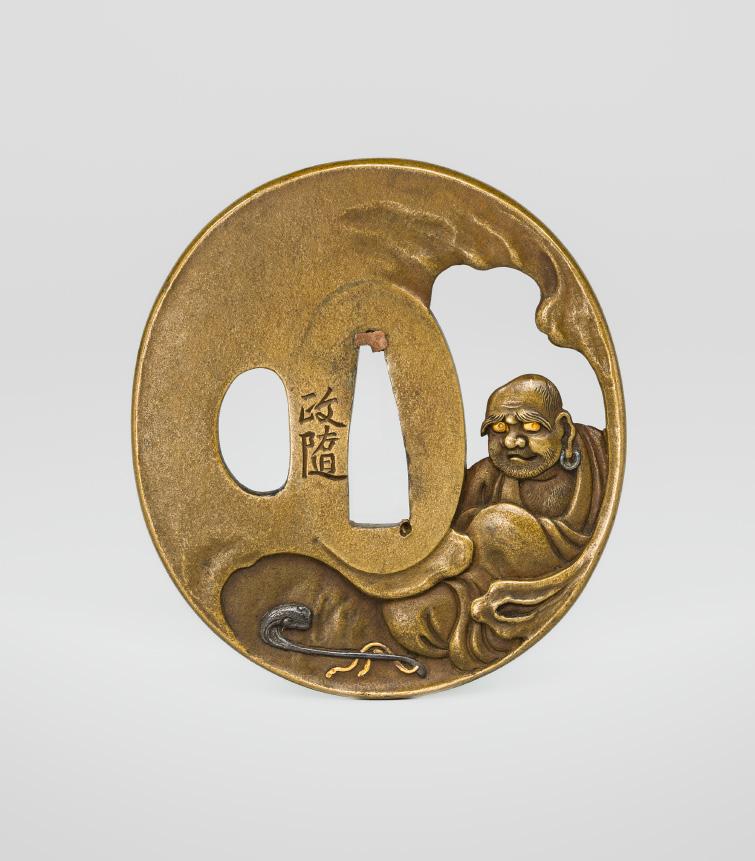
80
OTSURYUKEN MIBOKU: A FINE HAMANO SCHOOL SUAKA TSUBA DEPICTING DARUMA APPLYING MOXA
By Otsuryuken Miboku (born 1773), signed Otsuryuken Miboku Japan, first half of the 19th century, Edo period (1615-1868)
Of kakugata form, with one kozuka hitsu-ana, the suaka migakiji ground decorated with takazogan in gold and shakudo, the mimi bordered by a shibuichi fukurin. The design depicts Daruma (Bodhidharma) seated before a cave-like enclosure rendered with gold bars, beside a container of burning moxa. One gold-inlaid pellet has been applied to his leg, which he draws close in pain, his face contorted, one eye tightly shut and the other wide open. The reverse is inlaid with a silver plate signed OTSURYUKEN MIBOKU, beside a hossu (Buddhist flywhisk).
HEIGHT 6.6 cm, LENGTH 6.2 cm
WEIGHT 111 g
Provenance: From the collection of Eva & Aubrey Sweet. The nakago lacquered with an inventory number ‘388’. Condition: Very good condition with minor wear.
Otsuryuken Miboku is listed in Robert E. Haynes, The Index of Japanese Sword Fittings and Associated Artists on p.917 (H04332.0). He was born in Edo in 1773 and was still alive in 1846. He was adopted into the Hamano family school, and became the fourth master of the Hamano school in 1793.
Estimate EUR 2,000
Starting price EUR 1,000
81
MASAYUKI: A FINE HAMANO SCHOOL
SENTOKU TSUBA DEPICTING DARUMA IN A CAVE
Signed Masayuki Japan, c. 1850, Edo period (1615-1868)
Of nademarugata form, with one kozuka hitsu ana, the nakago ana with copper sekigane. Finely worked in shishiaibori and openwork to depict Bodhidharma seated in a cave, highlighted in gold, silver, and shibuichi takazogan to the eyes, earring, and nyoi-scepter, his eyebrows and beard meticulously stippled. Signed MASAYUKI.
HEIGHT 6.8 cm, LENGTH 6.2 cm
WEIGHT 88 g
Provenance: The Saoud bin Mohammed Ali Al-Thani Foundation. The inner rim of the nakago ana lacquered with a collector’s number ’88’.
Condition: Very good condition with minor wear.
MUSEUM COMPARISON
Compare a related sentoku and gold tsuba with Daruma, signed Masayuki, dated c. 1850, Nara, in the Art Gallery of South Australia, accession number 863A20.
Estimate EUR 1,500
Starting price EUR 800

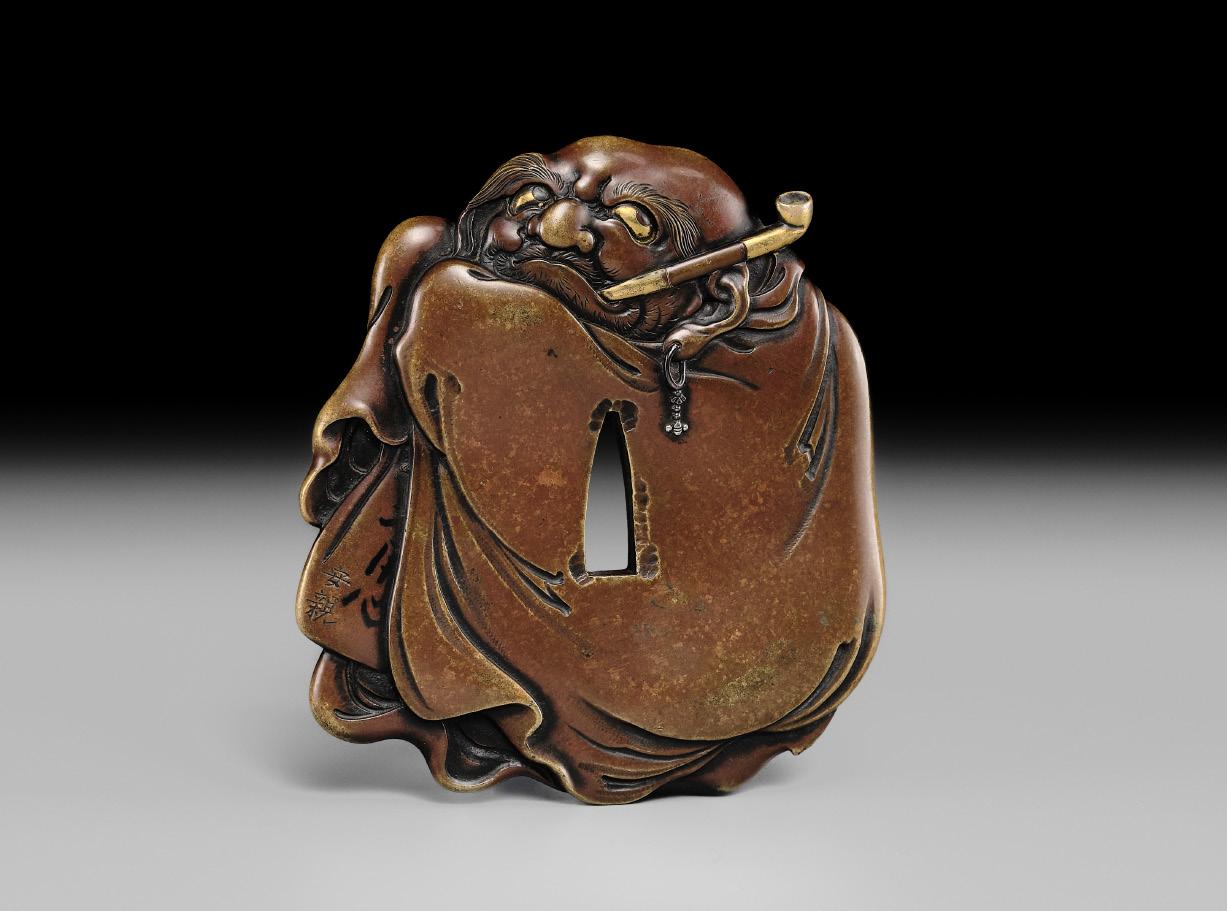
82
YASUCHIKA: A SUPERB SENTOKU TSUBA IN THE FORM OF DARUMA SMOKING A KISERU (PIPE)
Lineage of Tsuchiya Yasuchika, signed Yasuchika Japan, 19th century
The sentoku and copper tsuba shaped to resemble Bodhidharma smoking a pipe with gold fittings and wearing voluminous robes, his face with an amusingly grim expression, his brows and beard engraved in fine katakiribori and kebori, his tobacco pouch partly enveloped in his robes with the inscription ‘Hi yoshin’ (‘Beware of fire’). His earring made of copper and silver takazogan and his eyes are of gold, copper, and shakudo. Signed YASUCHIKA.

HEIGHT 8.9 cm, LENGTH 8.1 cm
WEIGHT 289.4 g
The artist was a member of the Tsuchiya Yasuchika lineage of smiths which extends back to the 17th century. The Haynes Index of Japanese Sword Fittings and Associated Artists records seven smiths belonging to this lineage with this same signature, p. 2188.

Provenance: The Philip and Nancy Kotler Collection, Sarasota, Florida, United States. Philip and Nancy Kotler are distinguished collectors and philanthropists best known for their landmark contributions to the field of studio glass, including the creation of the Philip and Nancy Kotler Glass Collection at The Ringling and the opening of the Kotler-Coville Glass Pavilion in 2018. Beyond glass, the Kotlers cultivated a discerning interest in Asian art— particularly sword fittings, netsuke, and related objects—extending their patronage to institutions such as the Racine Art Museum and the Museum of Arts and Design. Philip Kotler, celebrated as the S.C. Johnson Distinguished Professor of International Marketing at Northwestern University and widely regarded as the “father of modern marketing,” together with Nancy Kotler, built a collection that reflects both scholarly passion and artistic vision.
Condition: Very good condition with minor wear.
AUCTION COMPARISON
Compare a closely related sentoku tsuba of Daruma, signed Yasuchika, 19th century, at Zacke, Fine Japanese Art, 14 June 2024, Vienna, lot 252 (sold for EUR 7,150).
Estimate EUR 5,000
Starting price EUR 2,400


83
INOUE MOTOTSUNE: A SUPERB AND LARGE SHAKUDO TSUBA DEPICTING A MAN AND FLY
Lineage of Inoue Mototsune, signed Inoue Mototsune kaku Japan, 19th century, Edo period (1615-1868)
Of tate-itomakigata from, with one kozuka hitsu ana, the shakudo ishimeji ground detailed with gold and iro-e takazogan and hirazogan, featuring a man with a startled expression as a fly lands on his bald head, the exaggerated eyes turned upwards, his bushy eyebrows lifted, and the hand raised to swat it. The subject may be a tongue-in-cheek reference to Daruma who is often disturbed by a fly in his meditation. The reverse with three banners. Signed INOUE MOTOTSUNE kaku [engraved by Inoue Mototsune].
HEIGHT 8.4 cm, LENGTH 7.8 cm
WEIGHT 249.5 g
Provenance: The Philip and Nancy Kotler Collection, Sarasota, Florida, United States.
Condition: Very good condition with minor wear.
Inoue Mototsune (died before 1781) is listed in Robert E. Haynes, The Index of Japanese Sword Fittings and Associated Artists, p.1189 (H 05979.0). He likely belonged to the Wakabayashi family lineage and worked in Etchu Province and Kaga Province. Mototsune is also listed in the Soken Kisho, 1781, vol.4., p.1.
Estimate EUR 6,000
Starting price EUR 3,000
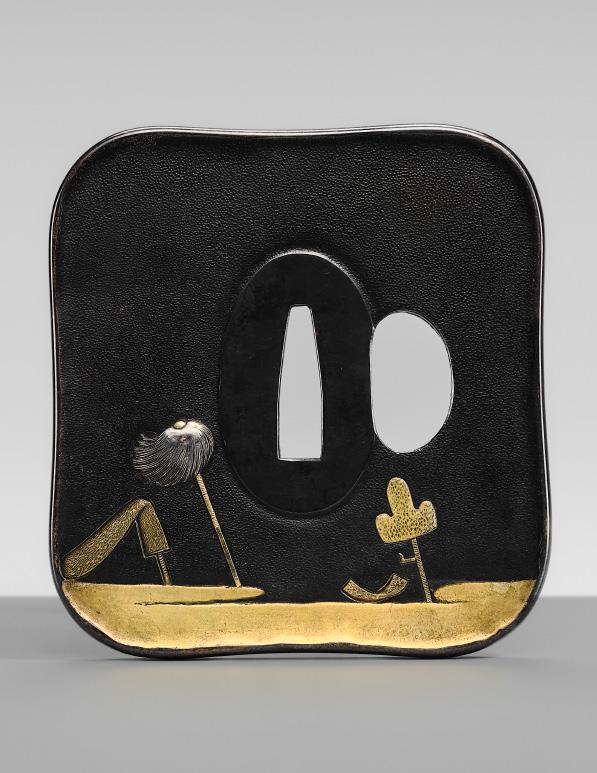

SHOZUI: A SUPERB AND LARGE HAMANO SUAKA TSUBA WITH DARUMA
Lineage of Hamano Shozui, signed Shozui Japan, Bakumatsu (1853-1868) to Meiji period (1868-1912)
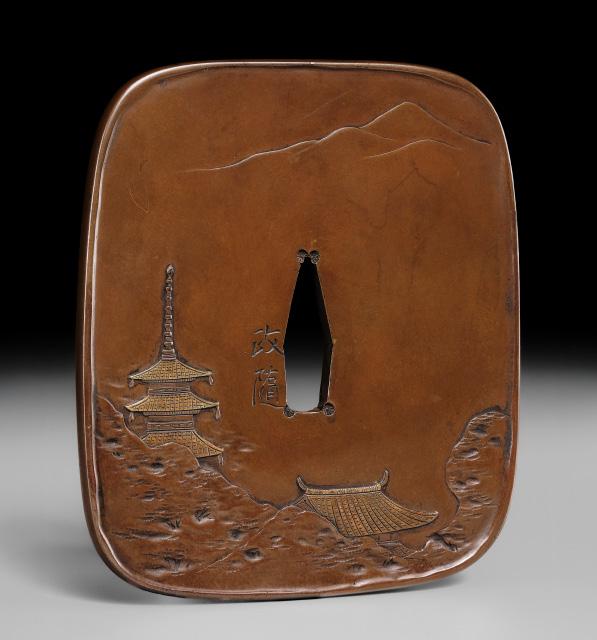
Of hirakakugata form, with a raised mimi, the copper migakiji ground decorated with gold and iro-e takazogan, with kebori and katakiribori details, featuring daruma in a contemplative pose, looking out of a window at a toro (stone lantern). The reverse depicting a pagoda and temple below the outline of a mountain and signed SHOZUI.
HEIGHT 9.2 cm, LENGTH 8.2 cm
WEIGHT 222 g
Provenance: From the private collection of Alan and Simone Hartman, New York.
Condition: Very good condition with minor wear.
With a wood tomobako (storage box).
Shozui (1696-1769) is listed in Haynes Index of Japanese Sword Fittings and Associated Artists on p.1746-1747 (H 08803.0). He is considered the founder of the Hamano school and had many followers and pupils.
AUCTION COMPARISON
Compare a related suaka tsuba, signed Shozui, 19th century, 8 cm diameter, at Christie’s, Japanese Art Including Property of The Metropolitan Museum of Art, 28 March 2006, New York, lot 240 (sold for USD 4,560 or approx. EUR 6,400 converted and adjusted at the time of writing).
Estimate EUR 4,000
Starting price EUR 2,000


OKAWA TEIKAN: A SUPERB SENTOKU AND SHAKUDO TSUBA DEPICTING A YUREI (GHOST)
By Okawa Teikan (1828-1898), signed Teikan saku Japan, mid- to late 19th century

Of mokkogata form, the ishimeji ground with gold and iro-e takazogan, featuring a man frightened by a yurei (ghost) and dropping his lantern, the reverse worked in shakudo, decorated with a toro (stone lantern) and a rock below the bright full moon. Signed TEIKAN saku [made by Teikan].
HEIGHT 8.8 cm, LENGTH 8.3 cm
WEIGHT 234.1 g
Condition: Very good condition, minor wear with little rubbing.
Okawa Teikan (1828-1898) is listed in Robert E. Haynes, The Index of Japanese Sword Fittings and Associated Artists, p.1895 (H 09521.0). He was born at Mito in Hitachi Province and used the art name (go) Hoen. Teikan became a retainer of the Mito Tokugawa Daimyo and of the Bakufu (shogunate) in Edo. He was a prolific artist who created exceptionally fine tsuba, many of his works now being stored and exhibited in Western Museums, such as the Museum of Fine Arts, Boston.
AUCTION COMPARISON
For another work by this superb artist, signed Okawa Teikan and dated 1866, worked one half in sentoku and the other in suaka, see Zacke, Fine Japanese Art, 14 June 2024, Vienna, lot 249 (sold for EUR 10,400).
Estimate EUR 4,000
Starting price EUR 2,000
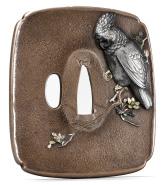

86
MITSUAKI: A HUMOROUS AND LARGE SENTOKU TSUBA DEPICITNG BLIND MEN AND THE YOKAI HITOTSUME-KOZO
By Mitsuaki, signed Mitsuaki Japan, Bakumatsu (1853-1868) to Meiji period (1868-1912)
Of nagamarugata form, the ishimeji ground brilliantly detailed with gold and iro-e takazogan and hirazogan, one side depicting a blind man walking at night, startling a Hitotsume-kozo, who stumbles backward in fright. The reverse, neatly incised in katakiribori and kebori, shows three blind men holding each other by the ties while wading through a stream. Signed MITSUAKI in cursive script.
HEIGHT 9.1 cm, LENGTH 8.7 cm
WEIGHT 210 g
The Hitotsume-kozo (“one-eyed boy”) is a small, childlike yokai with a single large eye in the center of his face, often depicted wearing a monk’s robe and straw hat. Mischievous and fond of surprising people, he rarely causes harm. In this tsuba, Mitsuaki humorously reverses that familiar folklore: the yokai, whose power lies in being seen, is rendered powerless and terrified when confronted by a man who cannot see him. The result is a rare and witty Edo-period meditation on sight, fear, and irony—where blindness becomes protection rather than vulnerability.

Illustration of Hitotsume-kozo
Provenance: The Philip and Nancy Kotler Collection, Sarasota, Florida, United States.
Condition: Very good condition with minor wear.
Estimate EUR 4,000
Starting price EUR 2,000
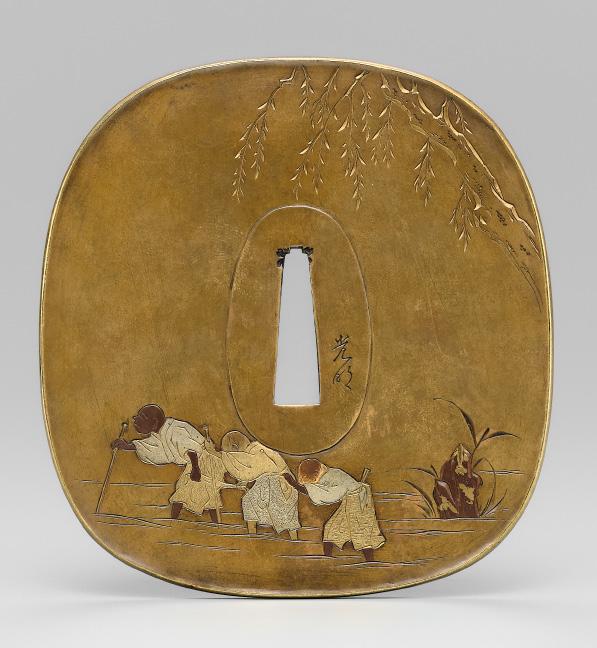

87
OTSUKI KORIN: AN OTSUKI SCHOOL SHAKUDO TSUBA DEPICTING SOSHI (ZHUANG ZHOU) DREAMING
Lineage of Otsuki Korin, signed Otsuki Korin with kakihan Japan, 18th-19th century, Edo period (1615-1868)
Of nagamarugata form, with one kozuka hitsu ana, the shakudo migakiji ground decorated in gold and iro-e takazogan, featuring Soshi (Zhuang Zhou) asleep beside a large sake saucer, with butterflies fluttering above, a dreamy mist emerging from his head and leading to a figure wearing a large hat and holding a fan and inscribed with a Chinese poem in gold: 良酒好夢中観楽見 [Ryoshu Komu chu kanraku ken (Fine wine and sweet dreams, within them, joy reveals itself)], composed by Sanseki Dojin. Signed OTSUKI KORIN with a gold kakihan.
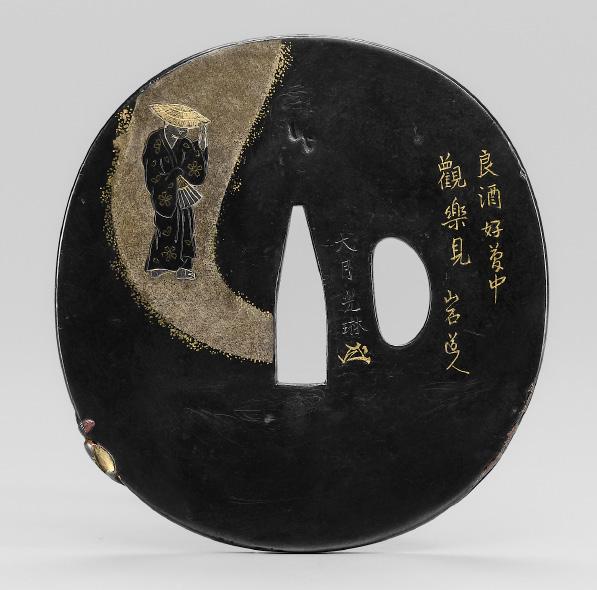
HEIGHT 7.8 cm, LENGTH 7.5 cm
WEIGHT 183.7 g
Provenance: Sotheby’s, Asian Arts, 6 December 2007, Paris, lot 217.
From the private collection of Alan and Simone Hartman, New York, acquired from the above.
Condition: Good condition with light wear to inlays, a few surface scratches, minuscule losses to the rim, and few nicks.
With a wood tomobako (storage box).

Zhuang Zhou, commonly known as Zhuangzi (Japanese: Soshi), was an influential Chinese philosopher who lived around the 4th century BC during the Warring States period. He is credited with writing one of the foundational texts of Daoism, known by his name, the Zhuangzi. The most famous of all Zhuangzi stories –Zhuang Zhou Dreams of Being a Butterfly – appears at the end of the second chapter, On the Equality of Things: “Once, Zhuang Zhou dreamed he was a butterfly, a butterfly flitting and fluttering about, happy with himself and doing as he pleased. He didn’t know that he was Zhuang Zhou. Suddenly he woke up and there he was, solid and unmistakable Zhuang Zhou. But he didn’t know if he was Zhuang Zhou who had dreamt he was a butterfly, or a butterfly dreaming that he was Zhuang Zhou. Between Zhuang Zhou and the butterfly there must be some distinction! This is called the Transformation of Things.” (Zhuangzi, chapter 2 [Watson translation]).
Otsuki Korin (died 1742), also read as Otsuki Mitsushige, is listed in Haynes Index of Japanese Sword Fittings and Associated Artists on p.1092 (H 05396.0). He is said to be the founder of the Otsuki family school. He is also listed in the Soken Kisho, vol. 3, p. 12.
Estimate EUR 3,000 Starting price EUR 1,500

88
SEISHU: A FINE BAKUMATSU
SUAKA TSUBA WITH SHOKI AND ONI
By Seishu, signed Seishu and kakihan Japan, Bakumatsu (1853-1868) to Meiji period (1868-1912)
Of marugata form, carved in takabori, decorated in gold and iro-e takazogan and hirazogan, the mimi lined in gold, depicting the wrathful Demon Queller Shoki drawing his sword to attack an oni. The reverse featuring a mountain landscape, the tip of Shoki’s sword, and the signature SEISHU with kakihan.
HEIGHT 8.2 cm, LENGTH 8 cm
WEIGHT 149.9 g
Provenance: Property from a European private collection. The collection Assembled over the past thirty years and comprises works acquired primarily from leading international auction houses and dealers, including Spink & Son, Marchant, Vanderven & Vanderven, and Jorge Welsh.
Condition: Very good condition with minor wear and little warping.
AUCTION COMPARISON
Compare a closely related bakumatsu shakudo tsuba, signed Seishu, Meiji period, 8.3 cm tall, at Bonhams, Fine Japanese Art, 17 May 2012, London, lot 7 (sold at GBP 6,875 or approx. EUR 13,500 converted and adjusted at the time of writing).
Estimate EUR 5,000 Starting price EUR 2,400
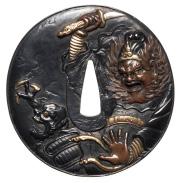
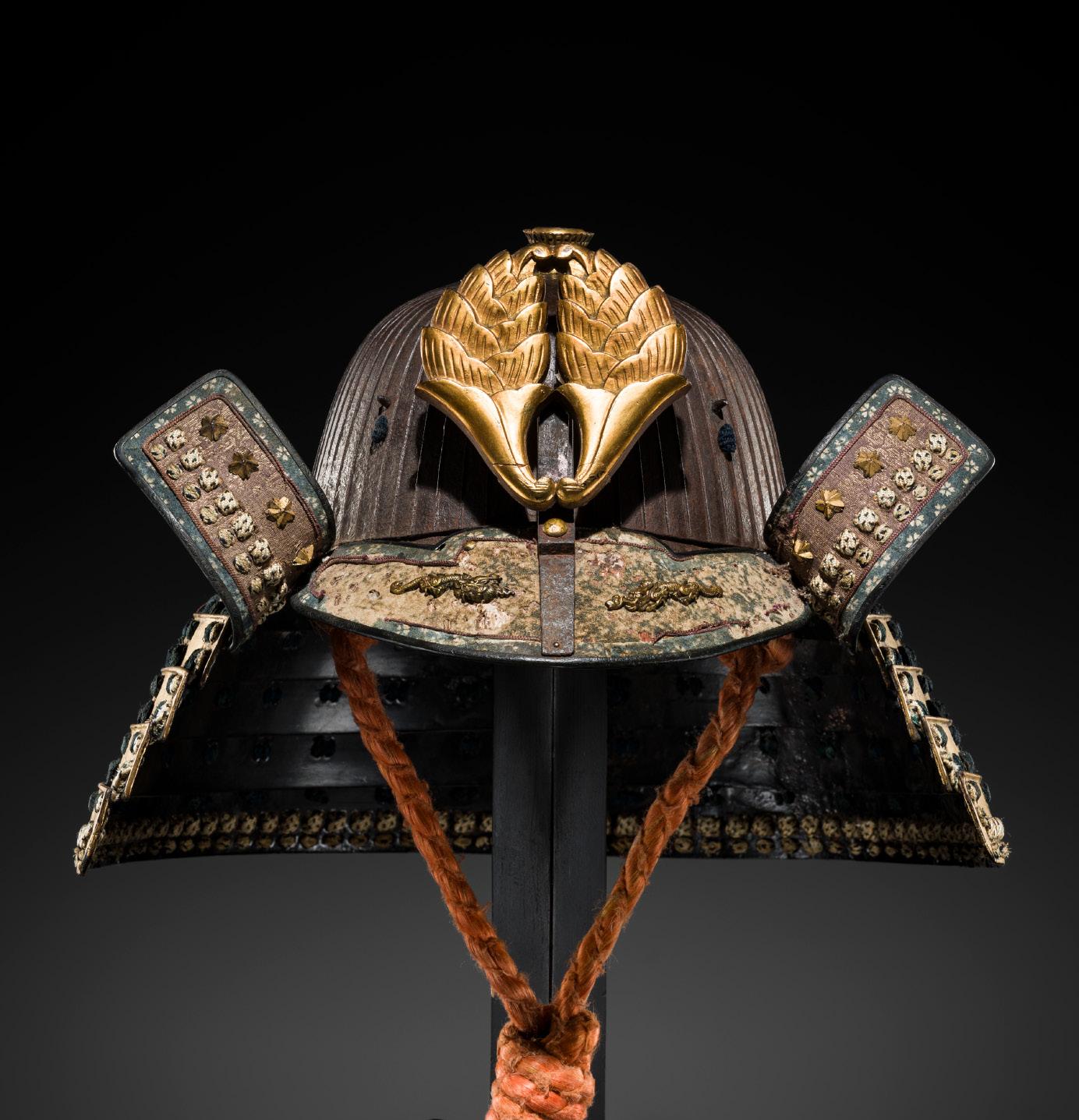
MYOCHIN NOBUIE: A SUJIBACHI KABUTO WITH NABESHIMA (APRICOT LEAF) MON
The kabuto signed Myochin Nobuie saku Japan, 16th century, Momoyama period (1573-1615)
The sixty-two-plate iron bowl with raised ridges topped by a sixstage gilt-copper tehen kanamono, fitted with a agemaki-no-kan to the back, the mabizashi and fukigaeshi each with printed leather, the mabizashi adorned with a pair of confronting dragons and fitted with a maedate in the form of the Nabeshima (apricot leaf) mon, flanked by the gently upturned fukigaeshi decorated with foliate studs, all above the gold lacquer six-lame shikoro with blue lacing. The kabuto signed MYOCHIN NOBUIE saku [made by Myochin Nobuie].
HEIGHT 27.5 cm, WIDTH 37 cm
WEIGHT 2,950 g
Condition: Good condition with old wear. The lacquer with few age cracks, expected flaking, and losses to the printed leather. A repair to the maedate with associated touchups.
Myochin Nobuie was active around 1504–1554, during the early 16th century, and is considered one of the most renowned armorers of the family.
AUCTION COMPARISON
Compare a closely related kabuto, by Myochin Nobuie, dated to 1535, at Christie’s, Japanese and Korean Works of Art, 22 September 2004, New York, lot 210 (sold for USD 16,730 or approx. EUR 24,500 converted and adjusted for inflation at the time of writing).
Estimate EUR 8,000
Starting price EUR 4,000
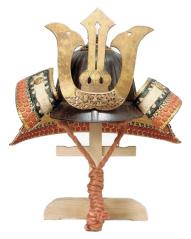
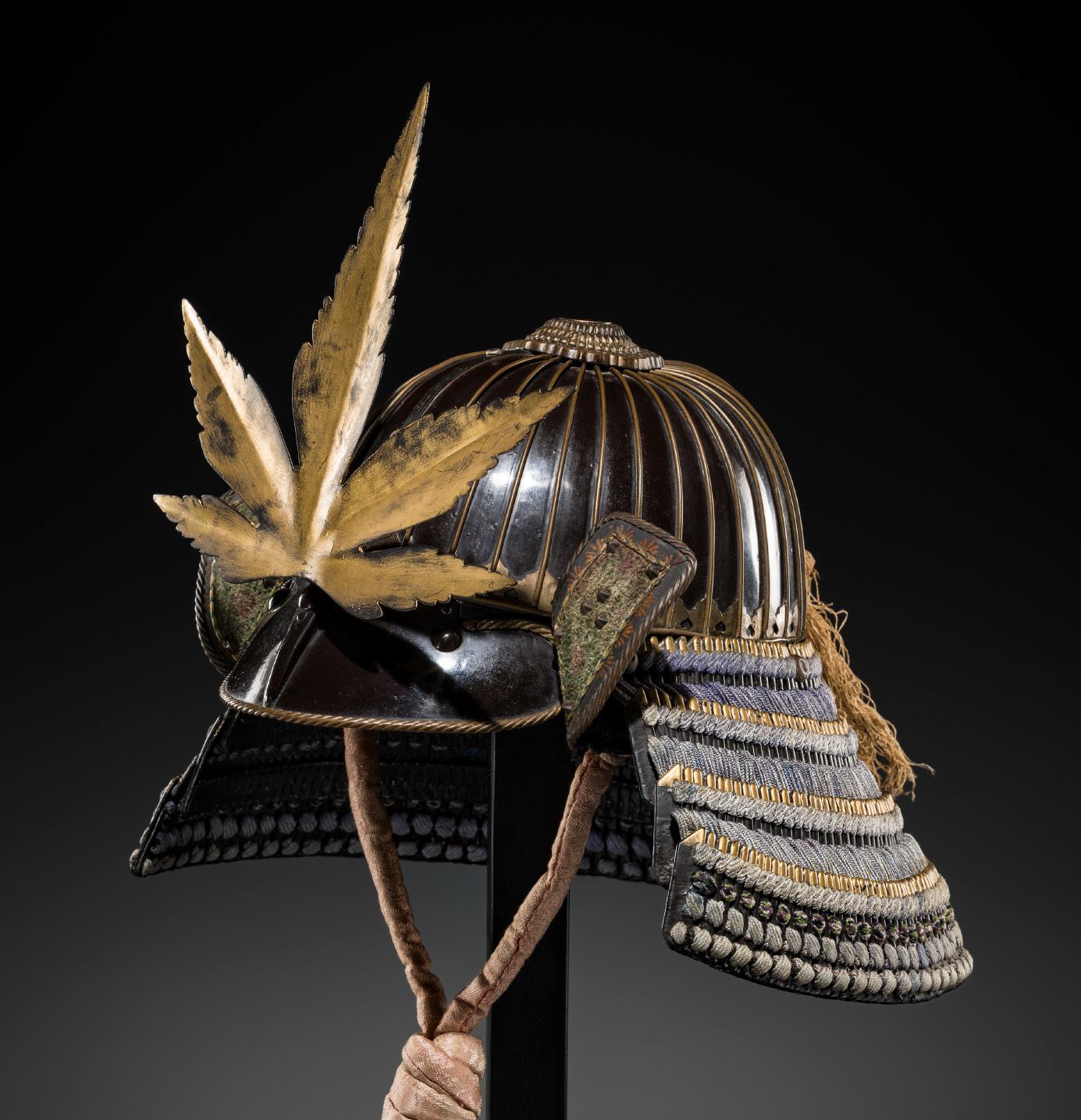
AUCTION COMPARISON
Japan, 17th century, Edo period (1615-1868)
The black-lacquered thirty-two-plate iron bowl with raised ridges, topped by a five-stage copper tehen kanamono issuing shinodare to the front and back with chrysanthemum fittings, applied with gilt-copper so-fukurin (ornamental border) and igaki (small metal plates to the base) pierced with inome (boar’s eye), the mabisashi and fukigaeshi decorated with copper nawa fukurin (roped border), the mabisashi further fitted with a gilt-metal maedate in the form of a maple leaf, the gently upturned fukigaeshi applied with printed leather and copper studs, all above the lacquer four-lame jikoro.
HEIGHT 37.5 cm, WIDTH 34 cm
WEIGHT 2,337 g
Condition: Very good condition with wear. The lacquer with few age cracks and minor flaking. Expected rubbing and flaking to the gilt.


Compare a closely related Haruta School so-fukurin sujibachi kabuto with tomoe mon, Edo period, 17th century, 29 cm high, at Zacke, Fine Japanese Art, 6 December 2024, Vienna, lot 128 (sold for EUR 7,800).
Compare a closely related so-fukurin sujibachi, also with tomoe mon, dated 17th century, at Sotheby’s, The Samurai: Japanese Arms and Armour, 10 May 2022, London, lot 72 (estimate GBP 10,000 or approx. EUR 14,000 converted and adjusted for inflation at the time of writing).
Estimate EUR 6,000
Starting price EUR 3,000

A RUSSET-IRON SUJIBACHI
KABUTO AND RESSEI MENPO, WITH NABESHIMA-MOKKOU MON
Japan, 16th-17th century, late Muromachi period (1333-1573) to early Edo period (1615-1868)
The components laced predominantly in blue and gold and adorned with kiku medallions. The sixteen-plate hachi with a kikuform agemaki-no-kan to the back, topped by a five-stage parcelgilt chrysanthemum-form tehen kanamono, the mabisashi and fukigaeshi each with black leather, the mabizashi fitted with a mon crest combining apricot leaves (nabeshima) with mokkou blossoms, all above the black-leather five-lame shikoro. The lacquered iron ressei menpo with a removable nose plate secured by turning pins, cast with flared nostrils and an open mouth revealing goldlacquered teeth and red-lacquered lips, above a stiff moustache, designed with deeply embossed wrinkles on the cheek, the chin with ase-nagashi, and the cheeks with bent anchoring posts, and fitted with a four-lame yodarekake.
HEIGHT 26 cm (the helmet incl. shikoro and maedate) and 23 cm (the menpo incl. yodarekake)
WEIGHT 2,015 g (the helmet incl. shikoro) and 413 g (the menpo incl. yodarekake)
Condition: Good condition with wear and natural imperfections to the leather. The lacquer with age cracks, losses, and flaking, some with associated touchups. Expected rubbing and flaking to the gilt.
AUCTION COMPARISON
Compare a related sujibachi kabuto by Naomasa, with a similar leather applique to the mabisashi, dated Muromachi period, at Zacke, Fine Japanese Art, 6 December 2024, Vienna, lot 129 (sold for EUR 5,850).
Estimate EUR 4,000
Starting price EUR 2,000
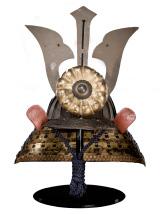

92
A FINE RUSSET-IRON SUJIBACHI KABUTO WITH SETTSU-IKEDA CLAN MON
Japan, 16th-17th century, Momoyama period (1573-1615) to early Edo period (1615-1868)
The eight-plate hachi with an agemaki-no-kan to the back, topped by a five-stage parcel-gilt chrysanthemum-form tehen kanamono, the fukigaeshi with printed leather and further applied with Maru ni Mokkou mon, associated with the Settsu-Ikeda clan, and laced with an additional lame, all above the five-lame shikoro.
HEIGHT 26 cm, WIDTH 38 cm
WEIGHT 2,823 g
Provenance: From a private English collection, Heath House, Hampshire. By repute, acquired in Asia at the turn of the 19th century. The same collection includes a Louis XVI bureau plat which was originally the working desk of the French Emperor Napoleon III. Condition: Very good condition with wear, traces of use, the leather with small losses, the lacquer with expected age cracks and minor flaking.
Mokkou (Japanese quince) is a type of Japanese family crest known as Mokkou mon. This design is mainly called Yokomokkou (horizontal quince), while the vertical one is also called Tatemokkou (vertical quince).
The Ikeda clan was a Japanese clan that claimed descent from Minamoto no Yorimitsu (948-1021) of the Seiwa Genji. Minamoto no Yasumasa, the fourth generation descending from Yorimitsu, and younger brother of Minamoto no Yorimasa (1104-1180), was the first to call himself ‘Ikeda’. In the Edo period, several of the clan’s branches were daimyo families, most notably of the Tottori Domain and Okayama Domain.
AUCTION COMPARISON
Compare a closely related eight-plate kabuto, Momoyama-Edo period, 16th17th century, at Sotheby’s, The Samurai: Japanese Arms and Armour, 11 May 2021, London, lot 2 (sold for GBP 37,800 or approx. EUR 58,500 converted and adjusted for inflation at the time of writing).
Estimate EUR 6,000
Starting price EUR 3,000
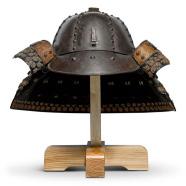


93
A SUPERB KOBOSHI KABUTO WITH MENPO AND A ‘PHEASANT FEATHER’ USHIRODATE
Japan, 17th-18th century, Edo period (1615-1868)
The roiro-lacquered sixty-two-plate iron bowl with raised ridges, finished with pointed rivets, and surmounted by a sixstage copper tehen kanamono. The back fitted with an agemaki-no-kan as well as a pheasant feather ushirodate. The broad mabisashi fitted with a gilt maedate in a square from inscribed with the character 八 (Hachi, evoking Hachiman, the God of War) flanked by the gently upturned fukigaeshi with copper studs and applied with circular medallion inscribed with the character 安東, likely relating to the Akita clan, all above the six-lame shikoro with green lacing. Together with an iron ressei menpo with a removable nose plate secured by turning pins, cast with flared nostrils and an open mouth revealing teeth, the lips painted red, below a horse-hair mustache and above a goatee, designed with deeply embossed wrinkles, the chin with ase-nagashi, and the cheeks with bent anchoring posts, all fitted with a four-lame yodarekake with brown lacing.
HEIGHT 82 cm (the helmet incl. shikoro and ushirodate) and 18.2 cm (the menpo incl. yodarekake)
WEIGHT 2,205 g (the helmet incl. shikoro, uhshirodate and maedate) and 489 g (the menpo incl. yodarekake)
Condition: Very good condition with old wear. The lacquer with few age cracks and minor flaking. Expected rubbing and flaking to the gilt.
COMPARISON
Compare a related koboshi kabuto and menpo, dated to the 17th18th century, at Sotheby’s, The Charlier and Cortina Collection of Exotic Samurai Helmets and Armour, 28 September 2022, London, lot 3 (mid-estimate of GBP 27,500 or approx. EUR 37,000 converted and adjusted for inflation at the time of writing).
Estimate EUR 10,000

Starting price EUR 5,000

KAWARI KABUTO (LOTS 94-102)
Kawari kabuto were unusual and decorative samurai helmets that became popular in Japan during the late Sengoku and early Edo periods, around the late sixteenth to early seventeenth centuries. Unlike standard battle helmets, they were designed to show individuality and status, often shaped like animals, shells, horns, or symbols of power. Made from iron, leather, and lacquer, they combined craftsmanship with imagination. As Japan entered a time of peace under the Tokugawa shogunate, kawari kabuto became more ceremonial than practical, serving as striking displays of art and identity rather than tools of war.

A LACQUERED IRON ‘HAWK’S BEAK’ KAWARI KABUTO (ECCENTRICALLY SHAPED HELMET)
Japan, 17th century, early Edo period (1615-1868)
The conical six-plate iron bowl built up with lacquer leather to resemble a tobiguchi (hawk’s beak), the surface molded and lacquered smooth with black lacquer, to the front a brief three-lobed peak, the wakidate in the form of stylized wings reminiscent of a torikabuto, the shikoro of close-fitting ko manju form of iron kiritsuke kozane laced in yoseikaki sugake odoshi of blue and green.
HEIGHT 38 cm, LENGTH 32 cm WEIGHT 1,961 g
Provenance: Bonhams, Fine Japanese Art, 12 May 2011, London, lot 20 (sold for GBP 9,600 or approx. EUR 19,000 converted and adjusted for inflation at the time of writing). A European private collection, acquired from the above.
Condition: Very good condition with wear. The lacquer with minimal age cracks, small losses, and little flaking, some with associated touchups.
AUCTION
COMPARISON
Compare a related kawari kabuto, Edo period, 18th century, at Christie’s, Arts of the Samurai and Japanese Art & Design, 7 June 2000, London, lot 18 (sold for GBP 14,100 or approx. EUR 39,000 converted and adjusted for inflation at the time of writing).
Estimate EUR 10,000 Starting price EUR 5,000


95 A VERY RARE GILT-LACQUERED IRON ‘AKODA-NARI’ KAWARI KABUTO (ECCENTRICALLY SHAPED HELMET) WITH GOTO CLAN MON
Japan, 17th-18th century, Edo period (1615-1868)
The bulbous helmet constructed from twenty-four plates riveted together and covered with a layer of gilt-lacquer, the roirolacquered mabisashi and fukigaeshi decorated with the four-petal maruni-hanabishi mon, associated with the Goto clan, all above the five-lame shikoro.
HEIGHT 31 cm, LENGTH 30 cm
WEIGHT 2,066 g
Condition: Very good condition with wear. The lacquer with age cracks, losses, and flaking, some with associated touchups.
Among the most distinctive helmet forms of the late Muromachi and Momoyama periods is the akoda nari kabuto, or “squash-shaped” helmet, named after the bulbous akoda gourd that inspired its form. Typically constructed from multiple riveted plates radiating from a central point, the akoda nari became a hallmark of the Haruta and Iwai schools. During the Edo period this shape was reinterpreted within the kawari kabuto, or “eccentric helmet” tradition, where armorers used familiar silhouettes as the basis for increasingly expressive and decorative designs. A kawari kabuto in the akoda nari style bridges early functional aesthetics and later sculptural experimentation, its rounded ribbed form evoking archaic valor while gilt lacquer, clan crests, and refined finishes reflect samurai rank and Edo period taste.
The Goto clan were daimyo of the Goto Islands in Hizen Province, ruling the Fukue Domain from the early seventeenth century until the Meiji Restoration in 1871. Originally vassals of the Ryuzoji and later of Toyotomi Hideyoshi, the Goto were confirmed in their holdings by Tokugawa Ieyasu after the Battle of Sekigahara in 1600. Their island domain, positioned at Japan’s western frontier, served as a maritime outpost for trade control and coastal defense and later became notable for its hidden Christian communities. The clan’s crest, the maruni hanabishi mon, a four petal diamond flower within a circle, appears on armor, banners, and other furnishings associated with the family, symbolizing continuity and refinement. Though not among the largest feudal houses, the Goto maintained a distinguished lineage characterized by loyalty and an enduring aesthetic sophistication.
AUCTION COMPARISON
Compare a related akoda-nari kabuto and hanbo, by Haruta Mitsusada, mid-16th century, at Bonhams, Arts of the Samurai, 8 October 2013, New York, lot 1021 (sold for USD 11,250 or approx. EUR 13,500 converted and adjusted for inflation at the time of writing).
Estimate EUR 8,000
Starting price EUR 4,000
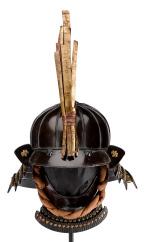
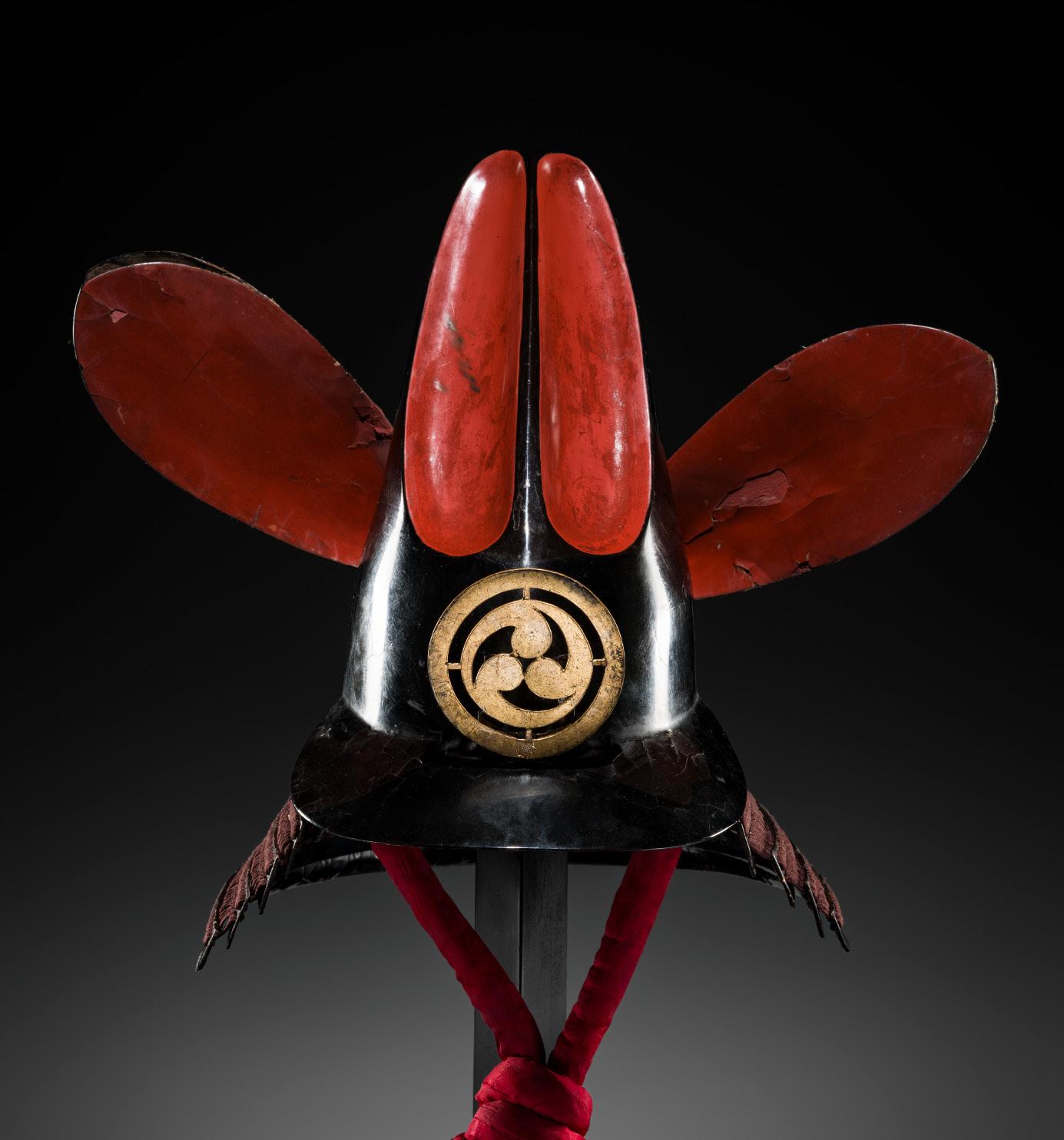
A RARE LACQUERED IRON ‘RABBIT EARS’ KAWARI KABUTO (ECCENTRICALLY SHAPED HELMET)
Japan, 17th century, early Edo period (1615-1868)
The intricately modeled iron bowl lacquered in black and surmounted by two tall, red-lacquered rabbit ears, the hachi further set with two wakidate also in the form of rabbit ears, all above the mabizashi fitted with a gilt-wood tomoe maedate and fitted with a five-lame shikoro.
HEIGHT 38.5 cm, LENGTH 34.5 cm
WEIGHT 2,136 g
Condition: Good condition with wear. The lacquer with age cracks, small losses, and flaking, some with associated touchups. One wakidate repaired. The maedate with losses, repairs, and signs of wear and use.
The rabbit or hare in the moon is a common Japanese motif. As well as being one of the twelve animals of the East Asian Zodiac, for the samurai the rabbit was a symbol of speed into battle and, as with the English expression “breed like rabbits,” was also a good omen for the continuation of one’s family line.
AUCTION COMPARISON
Compare a closely related lacquered iron kawari kabuto with rabbit ears, dated 16th-17th century, at Bonhams, Arts of the Samurai, 30 October 2017, New York, lot 448 (sold for USD 9,375 or approx. EUR 10,600 converted and adjusted for inflation at the time of writing).
Estimate EUR 6,000
Starting price EUR 3,000

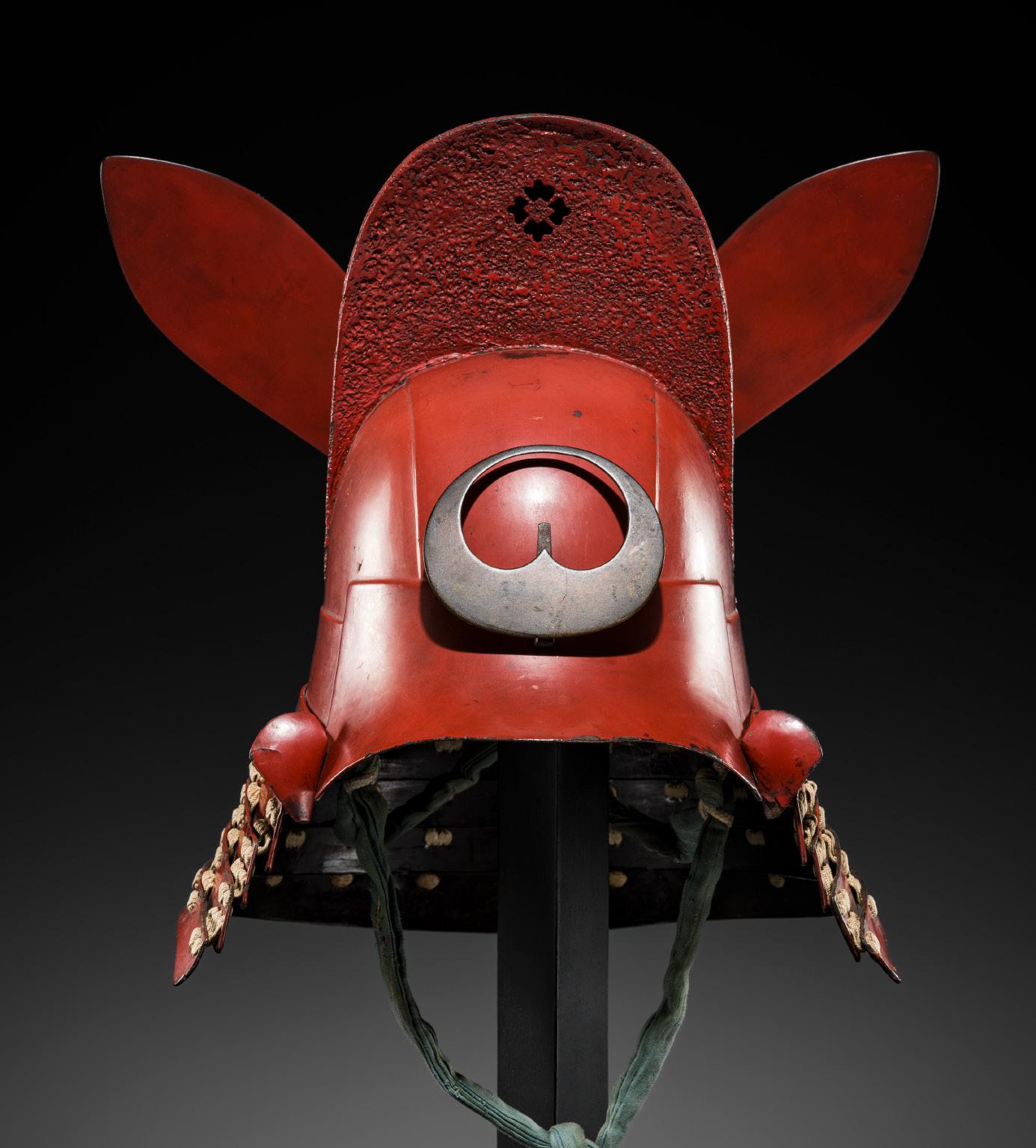
Japan, 17th century, early Edo period (1615-1868)
The simple three-plate bowl designed in textured red lacquer as an eboshi (court cap) pierced with a plum blossom on the front, the hachi set with ushirodate formed as stylized ribbons, the gently upturned mabisashi fitted with a metal kaga inome maedate, flanked by fukigaeshi, all above the five-lame shikoro laced in beige.
HEIGHT 37 cm
WEIGHT 2,251 g
Provenance: Christie’s, Japanese and Korean Art, 29 March 2005, New York, lot 63 (sold for USD 7,800 or approx. EUR 11,500 converted and adjusted for inflation at the time of writing).
Condition: Good condition with wear. The lacquer with age cracks, losses, and flaking, some with associated touchups. The maedate repaired.
AUCTION COMPARISON
Compare a related kawari kabuto, dated to the 17th century, at Bonhams, Arts of the Samurai, 8 October 2013, New York, lot 1019 (sold for USD 16,250 or approx. EUR 19,500 converted and adjusted for inflation at the time of writing).
Estimate EUR 6,000
Starting price EUR 3,000

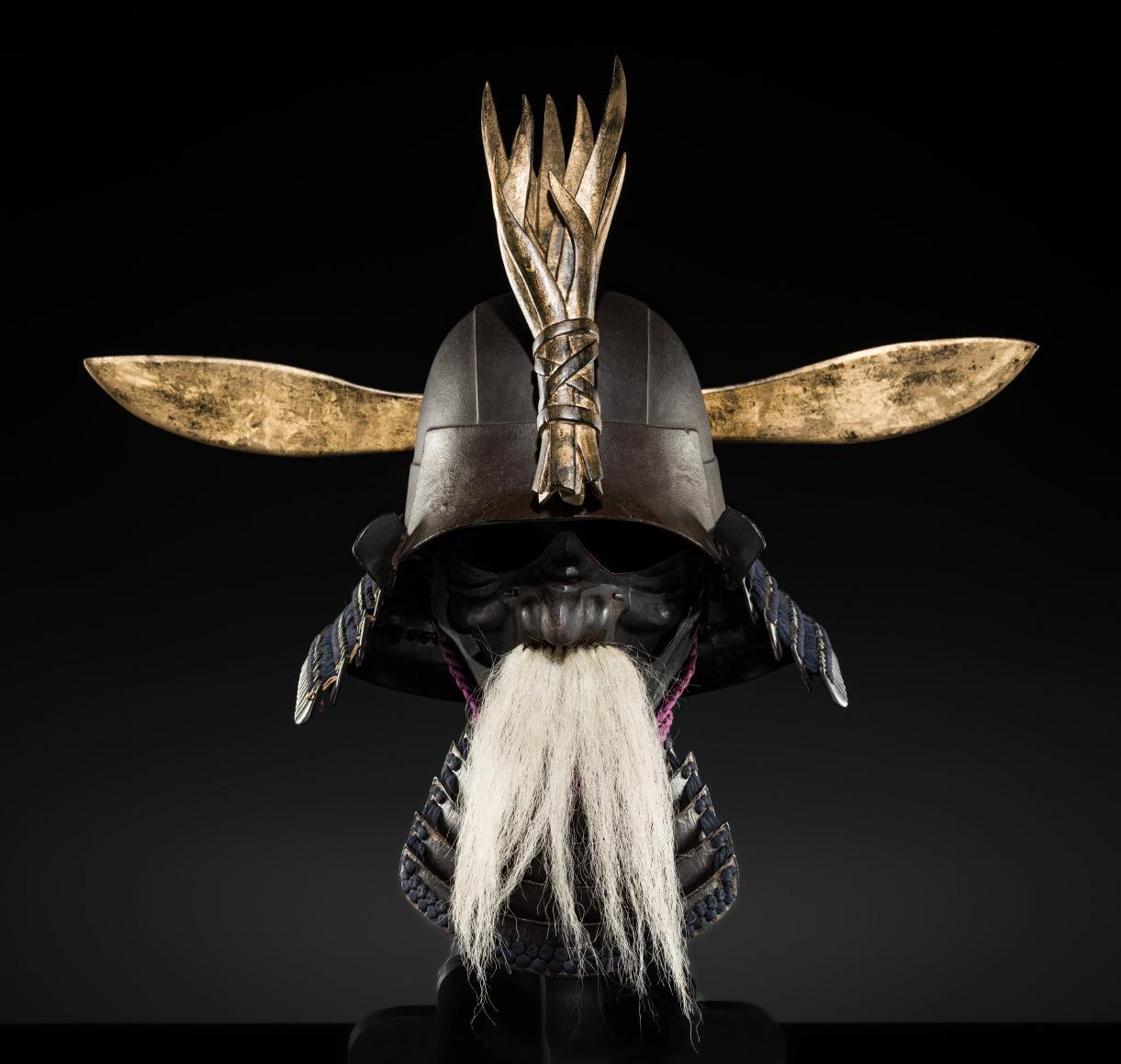
98 AN IMPRESSIVE LACQUERED IRON HINENO ZUNARI KABUTO AND RESSEI MENPO, WITH NKBKHK KICHO SHIRYO CERTIFICATE
Japan, late 16th – early 17th century, Momoyama period (1573-1615)
The components laced in blue. The sabiji-nuri lacquered bowl is shaped like the top of a human head (zunari), the hachi set with gold-lacquered wakidate carved as the hat’s elongated flaps, fitted at the back of the helmet, the integral deep mabisashi (brim) with a gently upturned lip and fitted with a gilt-wood maedate in the form of a bundle of straw, flanked by upturned fukigaeshi, all above the five-lame shikoro. The lacquered iron ressei menpo with a removable nose plate secured by turning pins, cast with flared nostrils and an open mouth revealing the red-lacquered interior, below a long hair moustache, designed with deeply embossed wrinkles on the cheek, flanked by raised flanges before bent anchoring posts, the chin with ase-nagashi and straight cord pegs on rhombus grommets, all above the five-lame jikoro.
With a Kicho Shiryo (Valuable Cultural Artifact) certificate from the Association for the Research and Preservation of Japanese Helmets and Armor (Nihon Katchu Bugu Kenkyu Hozon Kai –NKBKHK), no. 1377, dated 11 May 2025, confirming the dating above.
HEIGHT 39 cm (the helmet incl. shikoro and maedate) and 27 cm (the menpo incl. yodarekake)
WEIGHT 2,037 g (the helmet incl. shikoro, wakidate, and maedate) and 660 g (the menpo incl. yodarekake)
Condition: Very good condition with minor wear. The lacquer with age cracks, tiny losses, and flaking, some with associated touchups. Expected rubbing and flaking to the gilt.
The Hineno Zunari Kabuto, developed by the armorer Hineno Oribe-no-Kami in the late 16th century, represents one of the most practical and efficient forms of Japanese helmet design. Crafted from three riveted plates to create a smooth, zunari (head-shaped) bowl, it offered excellent protection while remaining lightweight and easy to produce. Favoring functionality over ornamentation, this style reflected the demands of the late Sengoku period, when durability and efficiency were paramount. Despite its simplicity, the Hineno Zunari often incorporated expressive face masks and crests, balancing martial utility with the refined aesthetics characteristic of samurai armor.
AUCTION COMPARISON
Compare a related zunari kabuto by Asai Tomoyuki, dated to the 17th century, Edo period, at Bonhams, Fine Japanese and Korean Art, 17 March 2021, New York, lot 674 (sold for USD 8,925 or approx. EUR 9,400 converted and adjusted for inflation at the time of writing).
Estimate EUR 6,000
Starting price EUR 3,000


A RARE LACQUERED IRON OWARI
MOMONARI KABUTO AND RESSEI MENPO, WITH KIRI MON
Japan, 18th century, Edo period (1615-1868)
Of somewhat abstract momonari (peach-form) shape, the components laced predominantly in blue and gold. The roiro lacquered bowl made in four pieces and crested with a deep medial ridge, the hachi pierced to the top with inome (boar’s eye) apertures and set with a kiku-form agemaki-no-kan, the integral deep mabisashi (brim) with a gently upturned lip and fitted with a gilt-wood maedate in the form of a crescent moon below the sun, flanked by upturned fukigaeshi decorated with the 5-3 paulownia mon, all above the five-lame shikoro lacquered red to the underside. The lacquered iron ressei menpo with a removable nose plate secured by turning pins, cast with flared nostrils and an open mouth revealing lacquered teeth and red-lacquered lips, above a stiff moustache, designed with deeply embossed wrinkles on the cheek, the chin with ase-nagashi, and the cheeks with bent anchoring posts, and fitted with a four-lame yodarekake.
WEIGHT 2,166 g (the helmet incl. shikoro and maedate) and 372 g (the menpo incl. yodarekake)
HEIGHT 29 cm (the helmet incl. shikoro and maedate) and 23 cm (the menpo incl. yodarekake)
Condition: Good condition with wear. The lacquer with age cracks, losses, and flaking, some with associated touchups. Expected rubbing and flaking to the gilt. Wear and losses to the lacing.
Compare a closely related heavy lacquered iron owari momonari kabuto, dated to the 18th century, 17.1 cm high (excluding the shikoro), at Bonhams, The Arts of the Samurai, 31 March 2025, New York, lot 108 (sold for USD 5,888 or approx. EUR 5,200 converted and adjusted for inflation at the time of writing).
Estimate EUR 6,000
Starting price EUR 3,000

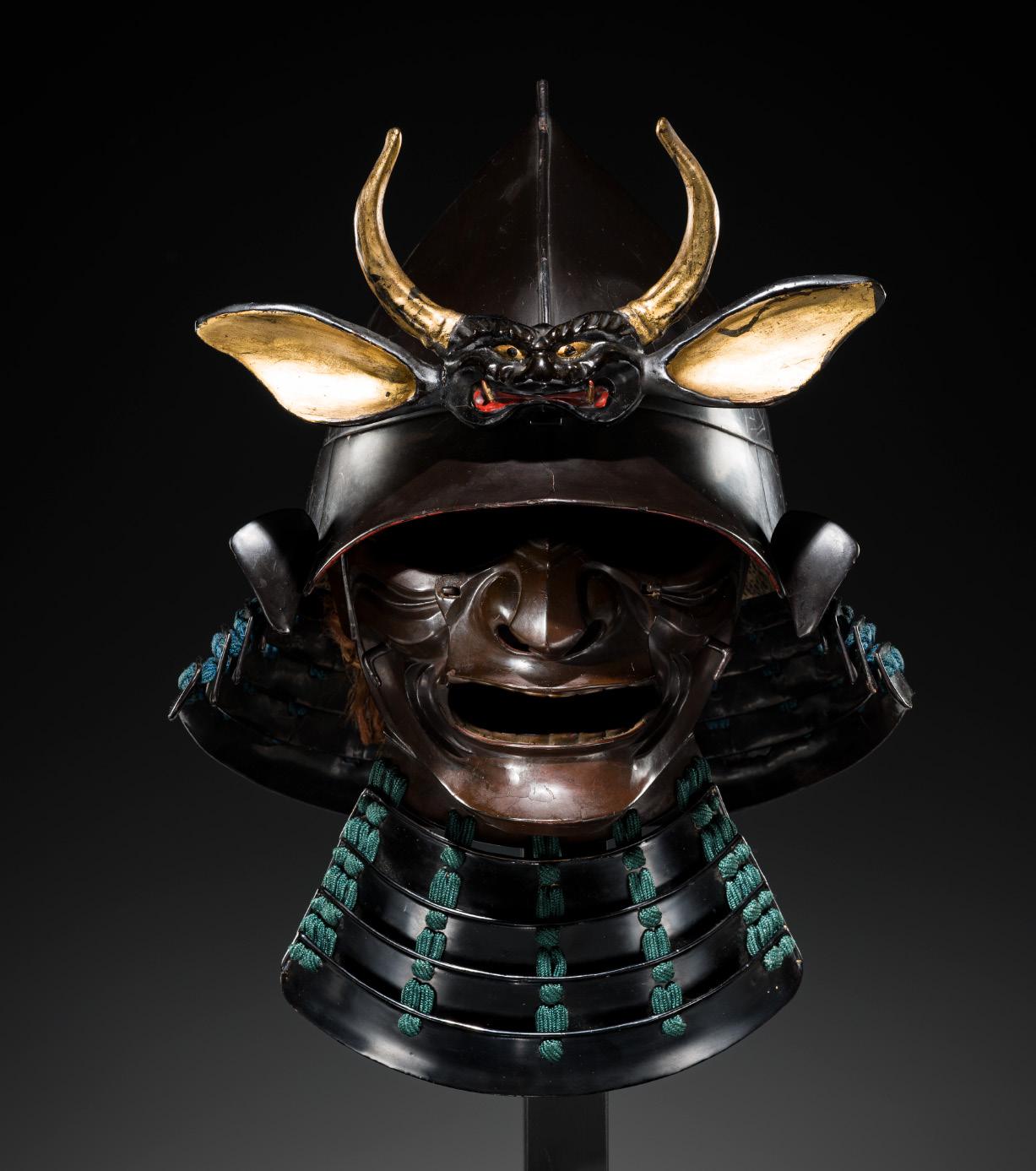
100
A RARE AND IMPRESSIVE LACQUERED IRON MOMONARI KABUTO WITH ONI MAEDATE AND IRON MENPO
Japan, 17th-18th century, Edo period (1615-1868)
The peach-shaped helmet lacquered black with a prominent central ridge, the tosei mabisashi [concave peak] applied with a boldly cast maedate in the form of a fierce two-horned demon with the mouth wide open in a ferocious roar revealing gilt fangs, the lips painted red, the gilt eyes with black-lacquered pupils, issuing a pair of elegantly curved bovine horns, flanked by the upturned fukigaeshi, all above the five-lame shikoro. Together with a lacquered iron menpo with a removable nose plate secured by turning pins, cast with flared nostrils and an open mouth revealing gold-lacquered teeth, designed with deeply embossed wrinkles, the chin with asenagashi, and the cheeks with bent anchoring posts, all fitted with a four-lame yodarekake with blue lacing.
HEIGHT 28 cm (the helmet incl. shikoro and maedate) and 24 cm (the menpo incl. yodarekake)
WEIGHT 1,854 g (the helmet incl. shikoro and maedate) and 559 g (the menpo incl. yodarekake)
Condition: Good condition with wear. The lacquer with age cracks, small losses, and flaking, some with associated touchups. The maedate with small losses, flaking, signs of wear and use, and repair to one ear.
AUCTION COMPARISON
Compare a closely related momonari kabuto and an associated mempo, dated to the 17th century, 27 cm high (bowl to peak), at Sotheby’s, The Samurai: Japanese Arms and Armour, 16 May 2024, London, lot 31 (sold for GBP 11,430 or approx. EUR 14,000 converted and adjusted for inflation at the time of writing).
Estimate EUR 5,000
Starting price EUR 2,400


A LACQUERED IRON EBOSHI NARI ‘DRAGONS’ KAWARI KABUTO (ECCENTRICALLY SHAPED HELMET)
Japan, 19th century, late Edo period (1615-1868)

The tall roiro-lacquered iron bowl constructed of two vertical plates hammered and riveted together and banded by a horizontal koshimaki to resemble an eboshi (formal court cap) and decorated with confronting dragons in gold and red hiramaki-e, the mabizashi fitted with a kuwagata dai decorated with a sakura blossom to the center, flanked by upturned fukigaeshi, all above the four-lame shikoro applied with leather.
HEIGHT 33 cm, LENGTH 29 cm
WEIGHT 2,188 g
Condition: Very good condition with wear. The lacquer with minor age cracks, small losses, and little flaking, some with associated touchups.
AUCTION COMPARISON
Compare a closely related eboshi nari kabuto, also decorated with dragons, dated to the 19th century, late Edo period, at Bonhams, Fine Japanese Art, 11 November 2010, London, lot 55 (sold for GBP 3,000 or approx. EUR 6,200 converted and adjusted for inflation at the time of writing).
Estimate EUR 5,000 Starting price EUR 2,400


AN IMPRESSIVE MYOCHIN STYLE IRON KAWARI KABUTO IN THE FORM OF A TENGU WITH TOKIN CAP, ATTRIBUTED TO FUKUTAKE ICHIRO
Attributed to Fukutake Ichiro (1928-2002), unsigned Japan, c. 1950-1980, Showa period (1926-1989)
Forged in iron and finished in a rich russet-brown patina, constructed of seven plates riveted together forming a broad helmet bowl with a low profile, the top of the bowl with a tokin cap pierced to the sides and fitted with kiku medallions, the front hammered up and carved to form the elaborate beak and face of a tengu, the eyebrows boldly carved in swirling whorls above black and gold lacquered eyes and the nostrils pierced for ventilation, flanked by lacquered fukigaeshi, all above the five-lame shikoro lacquered brown to the exterior.
HEIGHT 29.5 cm, LENGTH 37 cm
WEIGHT 2,162 g
Condition: Very good condition with minor wear. Expected flaking and rubbing to lacquer.
AUCTION COMPARISON
Compare a closely related kawari kabuto in the form of a tengu wearing a tokin cap, dated 19th century, at Bonhams, Arts of the Samurai, 27 October 2014, New York, lot 1035 (sold for USD 31,250 or approx. EUR 37,000 converted and adjusted for inflation at the time of writing).
Estimate EUR 15,000
Starting price EUR 7,500
Fukutake Ichiro (1928-2002) was a Japanese swordsmith who today is recognized as the most talented of Gendai smiths in the art of uchidashi (repoussé). He is considered one of the last true traditional armor makers in Japan and his work was greatly inspired by the Myochin school. He lived and worked in the Kurashiki area of Okayama prefecture in the 1950s-1970s.
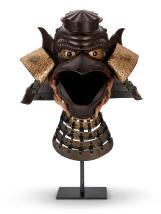

Fukutake Ichiro (1928-2002)

103
By Fukutake Ichiro (1928-2002), signed Ryu Japan, c. 1950-1980, Showa period (1926-1989)
The iron mask forged in one piece with the beak and ears riveted on, hammered up with prominent wrinkles and eyebrows held in a scowl, beneath the chin are two otayori no kugi flanking the asenagashi, lacquered to the exterior in vibrant red, the interior roirolacquered. The outer edge pierced to mount the yodarekake.
Inscriptions: To the underside of the chin, signed on a recessed gilt plaque ‘Ryu’.
HEIGHT 19.5 cm
WEIGHT 403 g
Condition: Excellent condition with minor wear.
AUCTION COMPARISON
Compare a related iron somen, by Fukutake Ichiro, dated early 20th century, at Christie’s, Art of Japan, 8 December 2016, London, lot 128 (sold for GBP 5,625 or approx. EUR 9,900 converted and adjusted for inflation at the time of writing).
Estimate EUR 6,000
Starting price EUR 3,000



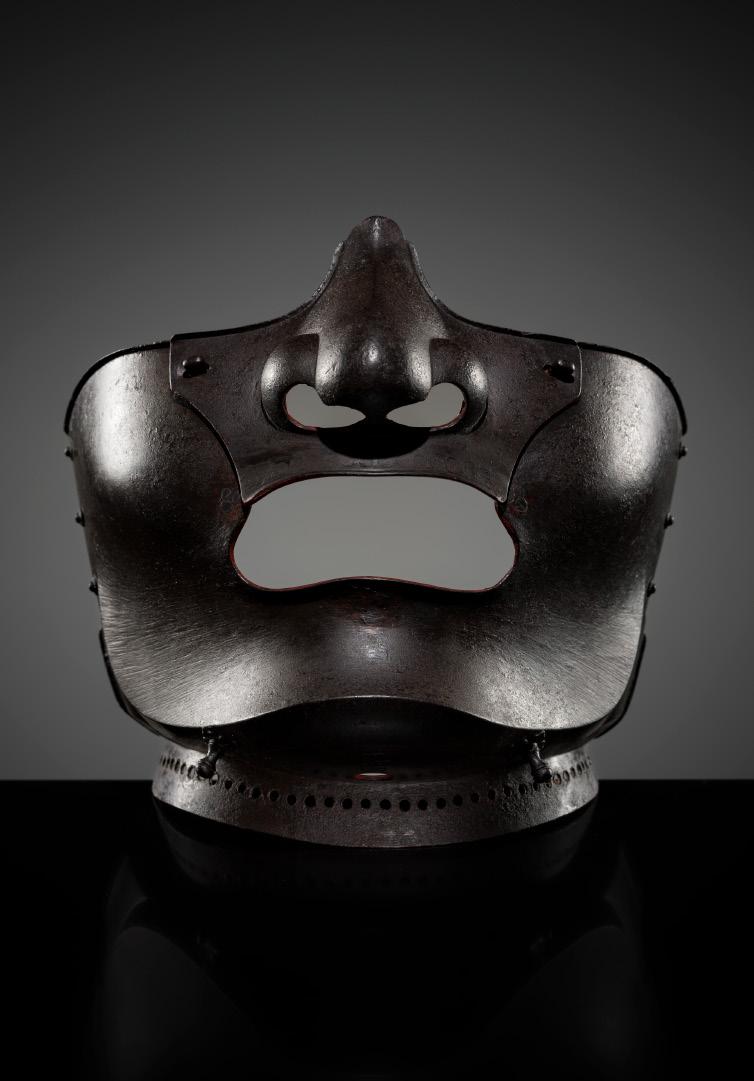
104
A LACQUERED IRON TENGU MENPO
Japan, 18th-19th century, Edo period (1615-1868)
Finely cast and forged in one section with a removable nose plate secured by turning pins, the lacquered tengu applied with an open mouth revealing teeth with fangs, designed with deeply embossed wrinkles at the cheeks, the chin with ase-nagashi, and cord pegs on rhombus grommets, all fitted with a five-lame yodarekake with orange lacing and a horsehair trim.
HEIGHT 21.5 cm
WEIGHT 468 g
Condition: Very good condition with minor wear. The lacquer with tiny age cracks, small chips as well as minor flaking. Expected rubbing and flaking to the gilt of the teeth.
AUCTION COMPARISON
Compare a closely related tengu menpo, dated 18th-19th century, at Christie’s, Japanese Art & Design Including Arts of The Samurai, 9 November 2011, London, lot 390 (sold for GBP 5,000 or approx. EUR 10,000 converted and adjusted for inflation at the time of writing).
Estimate EUR 5,000
Starting price EUR 2,400

105
UNKAI MITSUHISA: AN UNKAI SCHOOL IRON MENPO (FACE MASK)
By Unkai Mitsuhisa, signed Mitsuhisa Japan, late 17th century to 18th century, early Edo period (1615-1868)
Forged in russet iron with a prominent chin applied with two otayori no kugi flanking the ase-nagashi, the separately forged, removable nose piece with inome-form nostrils; the interior lacquered red. The outer edge pierced to mount the yodarekake. To the underside of the chin, signed MITSUHISA.
HEIGHT 15 cm, LENGTH 16 cm
WEIGHT 287 g
Condition: Excellent condition with minor wear and the lacquer to the underside with expected age cracks and minuscule nicks.
Unkai Mitsuhisa was the name borne by several generations of armorers of the Unkai school active in Kaga Province (modern Ishikawa) under the patronage of the Maeda clan during the Edo period. Working within a highly refined regional tradition, the Unkai masters produced menpō noted for their meticulous forging, balanced proportions, and subtle, dignified expression characteristic of Kaga craftsmanship. This example exemplifies the technical precision and restrained elegance that defined the Unkai school throughout the early Edo period.
Estimate EUR 2,500
Starting price EUR 1,200
Japan, 17th-18th century, Edo period (1615-1868)
Finely cast and forged in one section with a removable nose plate secured by turning pins, cast with flared nostrils and an open mouth revealing teeth, the lips painted red, below a stiff horsehair mustache, the chin with ase-nagashi, and the cheeks with bent anchoring posts, all fitted with a four-lame yodarekake with blue lacing.
HEIGHT 19 cm
WEIGHT 416 g
Condition: Very good condition with minor wear. The lacquer with some age cracks, small losses as well as minor flaking to the yodarekake.
AUCTION COMPARISON
Compare a closely related menpo, dated to the 17th century, at Sotheby’s, The Samurai: Japanese Arms and Armour, 10 May 2022, London, lot 23 (sold for GBP 4,410 or approx. EUR 6,000 converted and adjusted for inflation at the time of writing).
Estimate EUR 3,000
Starting price EUR 1,500
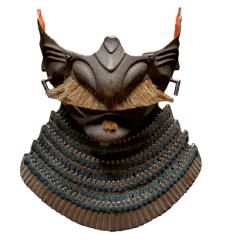
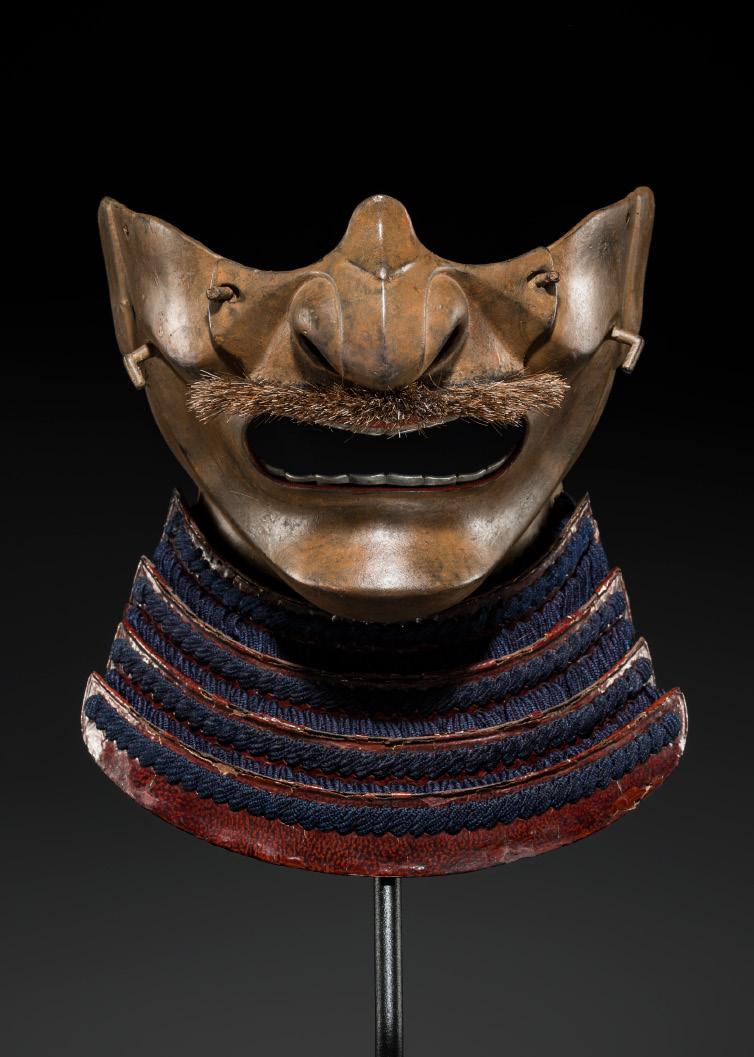
Japan, 18th century, Edo period (1615-1868)
Finely cast and forged in one section with a removable nose plate secured by turning pins, cast with flared nostrils and an open mouth revealing teeth, the lips painted red, below the applied horsehair mustache and above a goatee, designed with deeply embossed wrinkles, the chin with ase-nagashi, and the cheeks with bent anchoring posts, all fitted with a five-lame yodarekake with blue and orange lacing.
HEIGHT 23.5 cm
WEIGHT 500 g
Condition: Very good condition with minor wear. The lacquer with small age cracks, tiny chips to the edges and some flaking. Expected rubbing and flaking to the gilt of the teeth.
AUCTION COMPARISON
Compare a closely related menpo, dated to the 18th century, at Sotheby’s, The Samurai: Japanese Arms and Armour, 10 May 2022, London, lot 27 (sold for GBP 2,520 or approx. EUR 3,500 converted and adjusted for inflation at the time of writing).
Estimate EUR 1,500
Starting price EUR 800
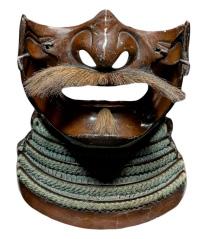



108 AN IMPRESSIVE NIMAI OKEGAWA DO GUSOKU (TWO-PIECE CUIRASS ARMOR) WITH A RED-LACQUERED IRON SUJIBACHI KABUTO WITH TENTSUKU MAEDATE AND RESSEI MENPO
Japan, 16th century, Momoyama period (1573-1615)
The red-lacquered iron components predominantly laced in blue, mounted on a fine red silk brocade, and fitted with kanamono with sakura (‘cherry blossom’).
The armor comprising:
A red-lacquered iron kabuto with a sixty-two plate hachi with raised ridges terminating in a four-stage gilt-copper tehen kanamono, the mabisashi with embossed eyebrows and fitted with gilt-lacquered wood maedate in the form of stylized horns (kuwagata) flanked by upturned fukigaeshi, all above the five-lame shikoro; a lacquered iron ressei menpo with a removable nose plate secured by turning pins, cast with an open mouth revealing the red-lacquered interior and teeth, designed with deeply embossed wrinkles, the chin with three straight cord pegs, two borne on rhombus grommets, all fitted with a four-lame yodarekake; a nimai okegawa do with seven five-lame kusazuri; a pair of five-lame sode; a pair of iron and kusari (chain mail) kote and tekko, the latter adorned with sakura blossoms; a pair of red-lacquered haidate mounted on a beige and gold silk brocade; and a pair of lacquered iron and kusari suneate. The back of the do mounted with a sashimono in the form of an ornate golden staff.
Condition: Good condition with old wear, and soiling. The lacquer with flaking, rubbing, some age cracks, and few losses. Tears to the fabric.
The black-lacquered wood storage box (yoroibako) with a gold hiramaki-e Kuroda fuji tomoe mon, associated with the Kuroda clan.
The Akai Oni Taisho (“Red Demon Generals”) were elite commanders within the armies of the powerful Takeda clan, receiving their orders directly from the Daimyo of Kai, Takeda. Leading their gashira and kachi into battle, these generals directed troop movements with disciplined precision, their strategies unfolding like a deadly dance under the will of their lord. The Akai Oni were selected for their valor, loyalty, and exceptional skill, embodying the clan’s highest ideals of honor and heroism.
Their distinctive crimson armor, coated in vermilion red (suna) lacquer, symbolized luxury, prominence, and fearlessness in combat, earning them the name “Red Demons.” Through countless victories, these elite warriors cemented the Takeda clan’s reputation as one of the most formidable powers of feudal Japan. Ruling Kai Province for over four centuries (12th–16th centuries), the Takeda upheld the enduring motto “Loyalty and Brotherhood”, and their battle standard bore the legendary phrase “Fu Rin Ka Zan” — Swift as the wind, silent as the forest, fierce as fire, and immovable as the mountain.
AUCTION COMPARISON
Compare a closely related tosei gusoku, Momoyama-Edo period, 16th-17th century, at Christie’s, Japanese Art & Design Including Arts of The Samurai, 9 November 2011, London, lot 381 (sold for GBP 37,250 or approx. EUR 73,500 converted and adjusted for inflation at the time of writing).
Estimate EUR 15,000 Starting price EUR 7,500

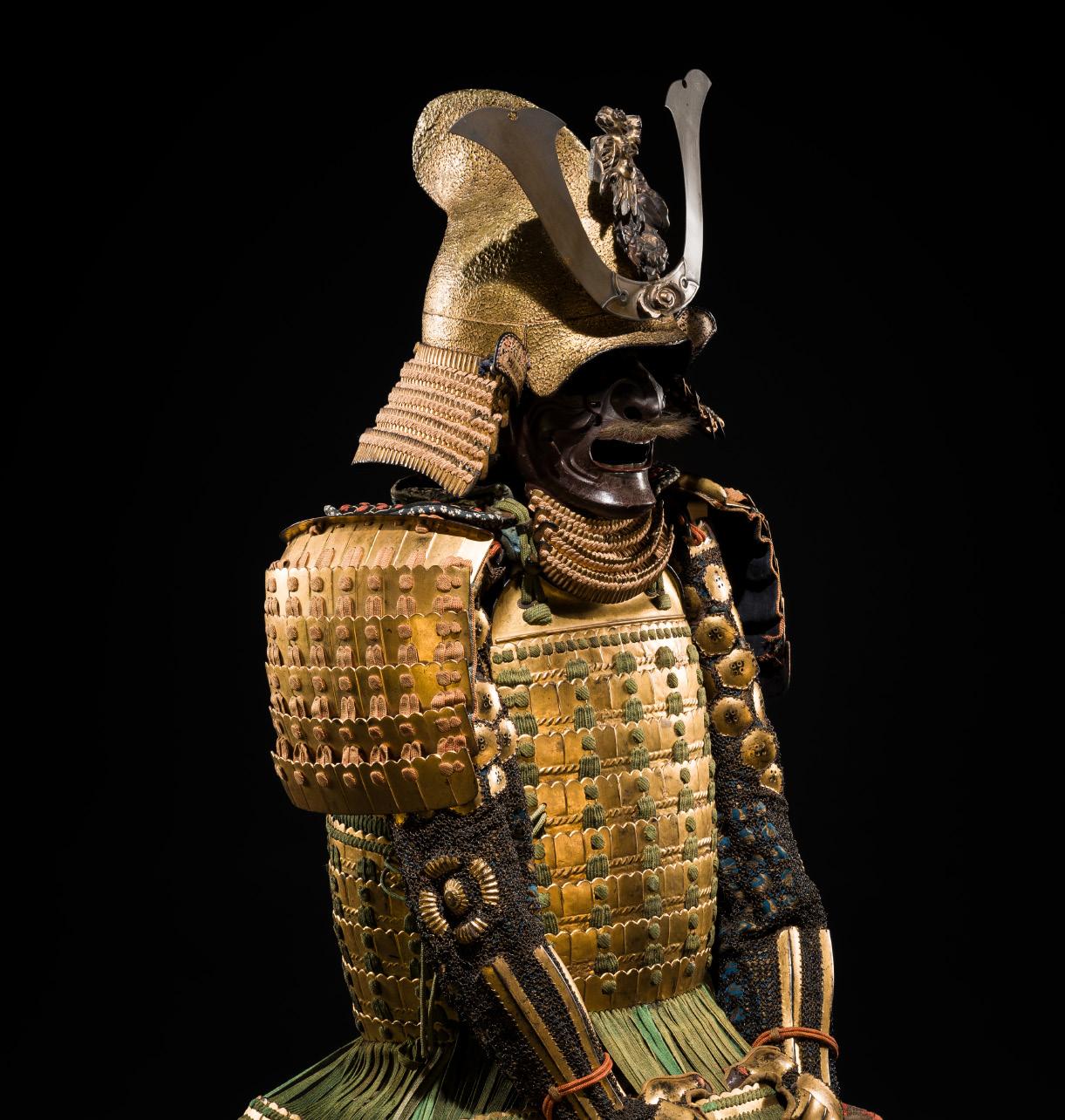
109
AN IMPRESSIVE GILT-LACQUERED NIMAI OKEGAWA DO GUSOKU (TWO-PIECE CUIRASS ARMOR) WITH A GOLD-LACQUERED IRON EBOSHI KABUTO AND RESSEI MENPO
Japan, 17th-18th century, Edo period (1615-1868)
The gold-lacquered iron components predominantly laced in green and mounted on a fine red and blue silk brocade.
The armor comprising:
A gilt-lacquered iron eboshi (formal court cap) kabuto with a broad mabisashi centered by a gilt-wood maedate in the form of a sinuous dragon, flanked by kuwagata piereced with inome and fitted on foliate kuwagata dai, framed by gently upturned fukigaeshi applied with printed leather, all above the five-lame shikoro; a brown-lacquered iron ressei menpo with a removable nose plate secured by turning pins, cast with an open mouth revealing the red lips and gilt teeth beneath a stiff moustache, designed with deeply embossed wrinkles, the chin with ase-nagashi, and the cheeks with bent anchoring posts, all fitted with a four-lame yodarekake; a nimai okegawa do of honkozane with six five-lame kusazuri, the back with an uke-zutsu; a pair of six-lame sode; a pair of gilt-iron and kusari (chain mail) kote with hexagonal plates and tekko; a pair of iron and kusari haidate, the lower part with kiku plates, mounted on a red silk brocade; and a pair of lacquered iron and kusari suneate.
Condition: Good condition with old wear, some losses and soiling. The lacquer with flaking, rubbing, some age cracks, and obvious losses. Repairs to the kabuto and maedate, with remnants of glue and associated touchups. Tears and losses to the silk.
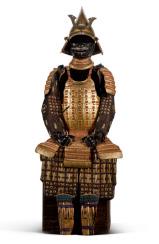

Compare a closely related gilt-lacquered nimai-do gusoku, dated to the 17th century, at Sotheby’s, The Samurai: Japanese Arms and Armour, 11 May 2021, London, lot 27 (sold for GBP 239,400 or approx. EUR 371,000 converted and adjusted for inflation at the time of writing). Compare a related gilt-lacquered nimai-do gusoku, dated to the 17th century, at Sotheby’s, The Samurai: Japanese Arms and Armour, 2 November 2021, London, lot 22 (sold for GBP 100,800 or approx. EUR 150,000 converted and adjusted for inflation at the time of writing).
Estimate EUR 15,000
Starting price EUR 7,500
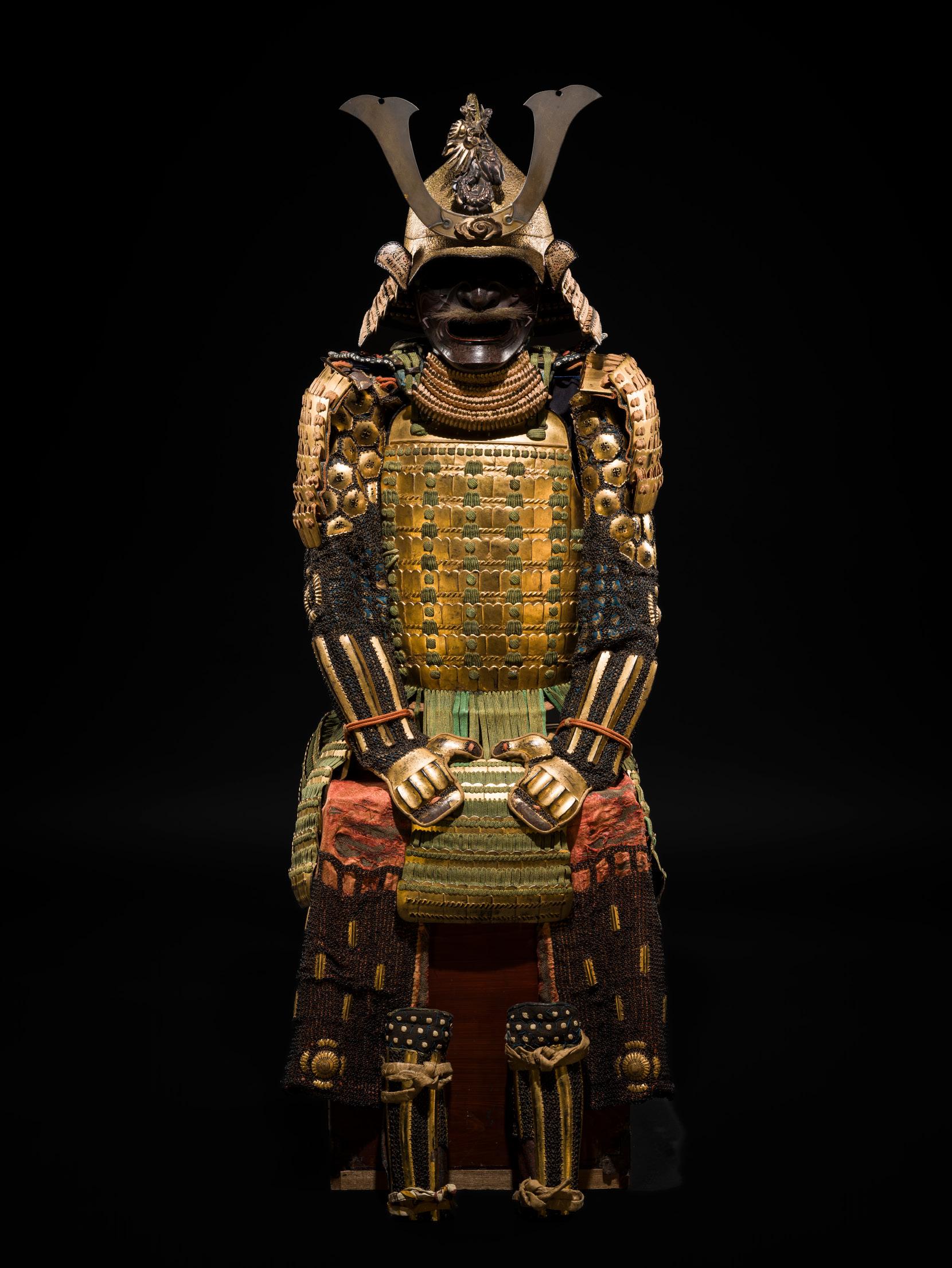

110
A NIMAI OKEGAWA DO GUSOKU (TWO-PIECE ARMOR) WITH AN EBOSHI KABUTO WITH A SUPERB ONI MAEDATE
Japan, 17th-18th century, Edo period (1615-1868)
The lacquered components predominantly laced in green, mounted on a fine silk brocade, and fitted with kanamono with sakura (‘cherry blossom’) and kiku (‘chrysanthemum’) design.
The armor comprising:
An iron eboshi (formal court cap) kabuto with a broad mabisashi centered by a polychrome and gilt-wood maedate in the form of an oni with long horns and large funnel-shaped ears, flanked by upturned fukigaeshi, all above the five-lame shikoro; a roiro lacquered iron hanbo pierced to the chin with an ase-nagashi, the cheeks with bent anchoring posts, fitted with a four-lame yodarekake; the nimai okegawa do with seven five-lame kusazuri, fitted with a single kiku-form agemaki-no-kan at the chest, the back with an uke-zutsu; a pair of six-lame sode; a pair of iron and kusari (chain mail) kote and tekko, the latter adorned with sakura blossoms; a pair of haidate; and a pair of lacquered iron and kusari suneate. With a surcoat (jinboari) with a 5-3 paulownia mon and dragonflies.
Condition: Good condition with old wear, small losses, and soiling. The lacquer with some flaking, rubbing, few age cracks, and tiny losses. A chip to one horn of the oni maedate. Tears and small losses to the fabric and lacing.
The paulownia crest (kiri-mon) displayed on the jianbori embodies a long lineage of political symbolism in Japan. Among the many variants of the kiri-mon, the go-san no kiri (five-three paulownia) became the definitive emblem of central authority. Originally paired with the chrysanthemum crest (kiku-mon) as an imperial symbol, it was granted by Emperor Go-Daigo to Ashikaga Takauji following his capture of Kyoto during the Kenmu Restoration (1333–1336). Thereafter, it came to signify the right to rule in the Emperor’s stead — an emblem of governmental legitimacy rather than familial descent.
By the late 16th century, the go-san no kiri had been adopted by Oda Nobunaga and later became synonymous with the Toyotomi administration under Hideyoshi, adorning armor, banners, and official documents. Under the subsequent Tokugawa regime, its use was codified as a formal mark of the government itself. Throughout the Edo period, and especially in the 18th century, the go-san no kiri retained its association with official authority and the institutions of state, appearing on the crests of shogunal officials, court appointees, and the arms of retainers serving in administrative capacities.
Dragonflies symbolize courage, strength, and victory in Japanese art. They were especially admired by samurai for their forward flight and were incorporated into the designs of saddles, stirrups, quivers, and the front crests of helmets. Dragonflies are also associated with autumn, representing change and the beauty of nature’s cycles. In poetry, particularly haiku, they often signify fleeting moments of beauty, reflecting the transient nature of life.
AUCTION COMPARISON
Compare a closely related green laced yokohagi okegata nimai-do gusoku (armor), Edo period, 17th-18th century, at Christie’s, The Japanese Aesthetic, 15 May 2013, London, lot 102 (sold for GBP 11,875 or approx. EUR 19,500 converted and adjusted for inflation at the time of writing).
Estimate EUR 10,000
Starting price EUR 5,000




111 A FINE NIMAI OKEGAWA DO GUSOKU (TWO-PIECE CUIRASS ARMOR) WITH A BLACK-LACQUERED IRON SUJIBACHI KABUTO AND RESSEI MENPO
Japan, 17th-18th century, Edo period (1615-1868)
The gilt-lacquered iron components predominantly laced in blue, mounted on a fine dark blue and gold silk brocade, and fitted with kanamono with sakura (‘cherry blossom’) and kiku (‘chrysanthemum’) design.
The armor comprising:
A russet-iron kabuto with a sixty-two plate hachi with raised ridges topped by a four-stage gilt-copper tehen kanamono incised with scrolling vines to the lowest tier, with a gilt-copper agemaki-nokan to the back, the mabisashi fitted with gilt-lacquered wood maedate in the form of the sun (nichirin) flanked by upturned, gilt-lacquered fukigaeshi, all above the five-lame shikoro; a roirolacquered iron ressei menpo with a removable nose plate, cast with an open mouth revealing the red lips and gilt teeth beneath a stiff moustache, designed with deeply embossed wrinkles, the chin with ase-nagashi, and the cheeks with bent anchoring posts, all fitted with a four-lame yodarekake; a nimai okegawa do with seven five-lame kusazuri, fitted with a single kiku-form agemaki-no-kan at the chest below two gilt hiramaki-e mon, fitted to the back with an uketsubo (banner holder); a pair of five-lame sode; a pair of iron and kusari (chain mail) kote and tekko, the latter adorned with sakura blossoms; a pair of iron and kusari haidate, the lower part with kiku plates, mounted on a blue-gold silk brocade; and a pair of lacquered iron suneate with hinges.
Condition: Good condition with old wear, and soiling. The lacquer with flaking, rubbing, some age cracks, and losses. Repair to the back of the do and shikoro as well as the meadate, with remnants of glue and associated touchups. Wear and losses to sections of the lacing. The silk brocade at least partially renewed. The turning pins of the menpo lost.
The red-lacquered wood storage box (yoroibako) fitted with kikuhandles and decorated with gold hiramaki-e medallions enclosing stylized butterflies.
Compare a closely related nimaido gusoku, dated to the 17th-18th century, at Sotheby’s, The Samurai: Japanese Arms and Armour, 2 November 2021, London, lot 17 (sold for 100,800 or approx. EUR 150,000 converted and adjusted for inflation at the time of writing).
Estimate EUR 15,000 Starting price EUR 7,500


112
AN IMPRESSIVE PURPLE LACED KAGA STYLE SUIT OF ARMOR WITH SAKAI CLAN MON AND AN IRON ZABOSHI KABUTO AND MYOCHIN MENPO
The menpo by Myochin Munehisa (c. 1640-1700), signed Kashu ju, Myochin Ki, Munehisa saku Japan, 17th-18th century, Edo period (1615-1868)
The lacquered components predominantly laced in purple, mounted on rich silk brocade, and fitted with intricate gilt-metal kanamono with the Maru ni Ken-Katabami mon, associated with the Sakai clan.
The armor comprising:
An iron sujibachi kabuto with a thirty-two plate hachi, finished with standing rivets borne on foliate medallions, and mounted with a five-tiered tehen kanamono, the mabizashi and fukigaeshi applied with gilded leather, the mabizashi fitted with a large gold-lacquered leaping shishi maedate, the upturned maedate fitted with gilt-metal Maru ni Ken-Katabami mon, associated with the Sakai clan, all above the five-lame shikoro lacquered red to the underside; the russet-iron menpo with a removable nose plate secured by turning pins, cast with flared nostrils and an open mouth, below a stiff mustache, designed with deeply embossed wrinkles on the cheek, the chin with ase-nagashi, all fitted with a four-lame yodarekake, the underside of the chin signed KASHU JU, MYOCHIN KI, MUNEHISA SAKU; the gomai-do decorated in black leather with seven five-lame kusazuri, applied with silvered foliage and two stylised agemaki-nokan to the breast and a third cord ring to the back; a pair of sode laced with a single lame; a pair of haidate; a pair of iron and kusari (chain mail) kote and tekko; and a pair of lacquered suneate with iron embellishments.
Condition: Very good condition with minor wear. The lacquer with age cracks, tiny losses, and flaking. Expected rubbing and flaking to the gilt. Wear and minor losses to the lacing.
The Sakai clan was one of the principal fudai retainer families of the Tokugawa shogunate, serving Tokugawa Ieyasu from his early career and later holding major domains such as Himeji, Obama, and Tsuruga. Descended from Minamoto no Arichika and related to the Matsudaira, the Sakai produced several senior councillors to the shogunate. The Maru ni Ken-Katabami crest on this Kagastyle armor identifies it with the Sakai family, whose mon signified authority and loyalty. The Kaga style, noted for its fine lacquerwork, purple lacing, elaborate gilt fittings, and refined metal inlay to the do, reflects the exceptional craftsmanship fostered under the Maeda domain in Kaga Province. The fusion of Sakai heraldry and Kaga workmanship denotes an armor of high rank, expressing both the political stature and aesthetic refinement of a senior Tokugawa retainer.
Compare a related Kaga style suit of armor at Christie’s, Japanese and Korean Art, 29 March 2005, New York, lot 78 (sold for USD 42,000 or approx. EUR 60,500 converted and adjusted for inflation at the time of writing).
Estimate EUR 30,000
Starting price EUR 15,000



113
A NIMAI OKEGAWA DO GUSOKU (TWO-PIECE CUIRASS ARMOR) WITH AN IRON KOBOSHI KABUTO AND RESSEI MENPO
Japan, 17th-18th century, Edo period (1615-1868)
The black-lacquered iron components predominantly laced in blue, white and purple, mounted on a fine dark-blue and gold silk brocade, and fitted with kanamono with sakura (‘cherry blossom’) and kiku (‘chrysanthemum’) design.
The armor comprising:
A russet-iron kabuto with a thirty-two plate hachi with raised ridges, finished with raised rivets, topped by a seven-stage mixed-metal tehen kanamono, with a gilt-copper agemakino-kan to the back, the mabisashi fitted with a diamond-shaped, gilt-lacquered wood maedate inscribed with the character 向, flanked by upturned fukigaeshi, all above the five-lame shikoro; a brown-lacquered iron ressei menpo with a removable nose plate secured by turning pins, cast with an open mouth revealing the red lips and teeth beneath a stiff moustache, designed with deeply embossed wrinkles, the chin with ase-nagashi, all fitted with a four-lame yodarekake; a nimai okegawa do with seven five-lame kusazuri fitted with two kiku-form agemaki-no-kan at the chest below three openwork gilt-copper plates adorned with kiku blossoms, the back with an uke-zutsu; a pair of five-lame sode, fitted with reticulated giltcopper plates with kiku agemaki-no-kan; a pair of iron and kusari (chain mail) kote and tekko, the latter adorned with sakura blossoms; a pair of iron and kusari haidate mounted on a bluegold silk brocade; and a pair of lacquered iron and kusari suneate.
Condition: Good condition with old wear and soiling. The lacquer with flaking, rubbing, some age cracks, and few losses. The shikoro reinforced with glued ties.
Compare a related Hanaito odoshi nimaido gusoku, at Christie’s, An Inquiring Mind: American Collecting of Japanese And Korean Art, 15 April 2016, New York, lot 64 (sold for USD 17,500 or approx. EUR 20,500 converted and adjusted for inflation at the time of writing).
Estimate EUR 12,000
Starting price EUR 6,000

114
AN IRON GOMAI-DO GUSOKU (FIVE PIECE CUIRASS ARMOR) AND MYOCHIN KABUTO, WITH NKBKHK TOKUBETSU KICHO (ESPECIALLY IMPORTANT) SHIRYO CERTIFICATE
The kabuto by a member of the Myochin lineage, signed Soshu Myochin […] Japan, 17th century, early Edo period (1615-1868)
The lacquered iron components predominantly laced in green and fitted with gilt-metal kanamono with kiku (‘chrysanthemum’) design, the Imperial symbol of Japan, as well as the kugi nuki mon.
The armor comprising:
An iron sujibachi kabuto with a thirty-plate hachi, finished with standing rivets borne on foliate medallions, decreasing in size towards the top, and mounted with a four-tiered chrysanthemum-form tehen kanamono, fitted with copper-gilt so-fukurin (ornamental border), the broad mabizashi centered by a gilt-wood pronged maedate, flanked by the roirolacquered fukigaeshi applied with the kugi nuki mon, all above the five-lame shikoro, signed to the underside Soshu MYOCHIN […] [‘Myochin […] of the Soshu Province’]; the lacquered iron menpo cast with flared nostrils and an open mouth revealed silvered teeth, designed with embossed wrinkles on the cheek, the chin with ase-nagashi, the cheeks with bent anchoring posts, all fitted with a four-lame yodarekake; the lacquered-iron gomai do with nine five-lame iron kusazuri, fitted to the back with a large gilt-metal agemaki (decorative tassel) strung from a chrysanthemum-form cord ring and an uke-zutsu (sashimono pole holder); a pair of six-lame iron sode; and pairs of iron and kusari (chain mail) haidate, tekko, kote, and suneate. With a saihai (tasseled banner) and Tsurumaki (bowstring holder).
Condition: Good condition with wear. The lacquer with age cracks, tiny losses, and flaking. Expected rubbing and flaking to the gilt. Wear and small losses to the lacing. The maedate repaired. The signature on the helmet partially illegible from wear.
With a Tokubetsu Kicho Shiryo (Especially Important Object) certificate from the Association for the Research and Preservation of Japanese Helmets and Armor (Nihon Katchu Bugu Kenkyu Hozon Kai – NKBKHK), no. 967, dated 20 March Showa 58 (1983), confirming the dating above.
The haidate is adorned with the Shoheigawa print, a highly popular pattern of E Gawa introduced in the 14th century. It features Shishi (lion-like creatures) set among foliage and floral blooms, with a small framed area of kanji characters recording a commemorative date in 1352.
Estimate EUR 15,000
Starting price EUR 7,500

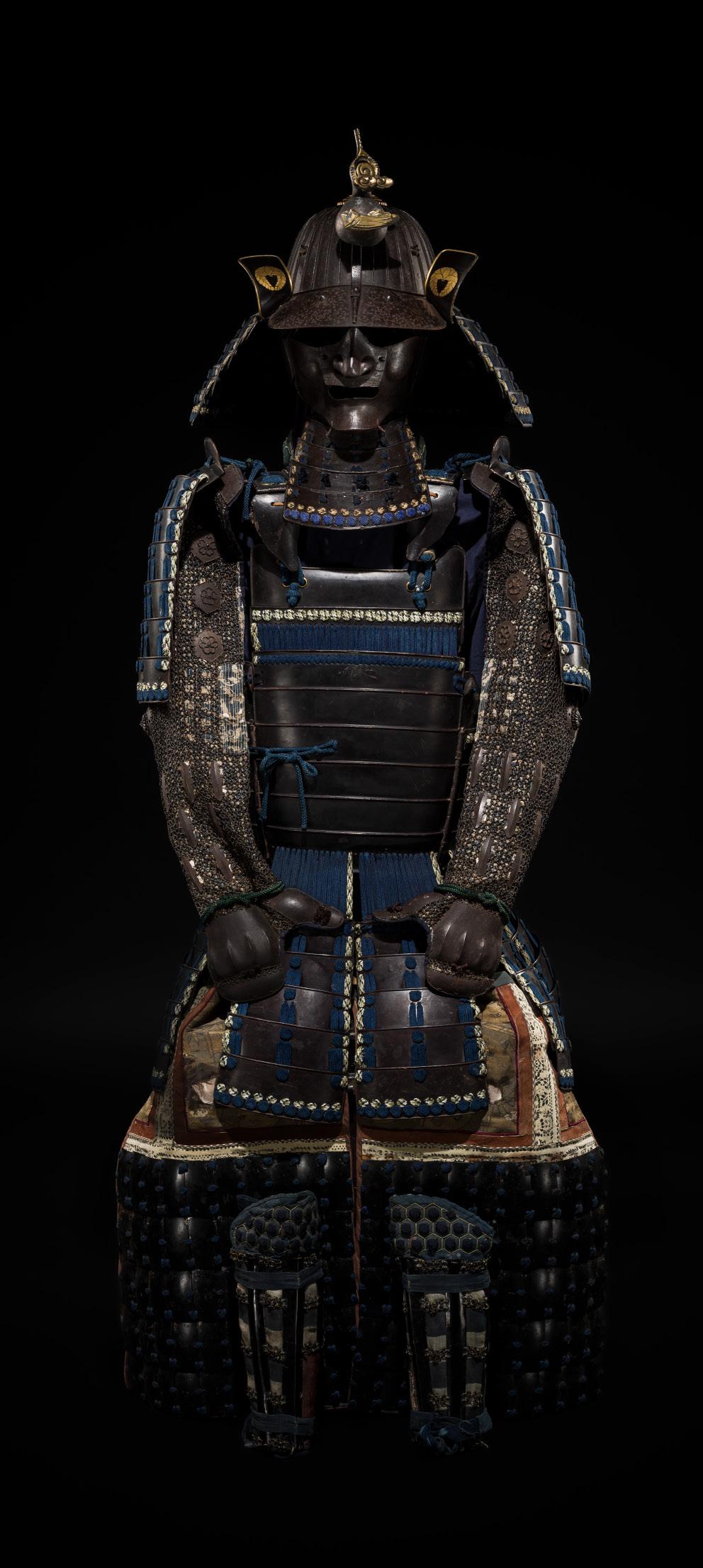
115 A FINE GOMAI-DO GUSOKU (FIVE PIECE CUIRASS ARMOR) WITH SAKURA KAMON AND AN IRON SUJIBACHI KABUTO AND MENPO
Japan, 17th-18th century, Edo period (1615-1868)
The lacquered iron components predominantly laced in blue, mounted on a fine blue and gold silk brocade, and fitted with intricate iron kanamono with sakura (‘cherry blossom’) design.
The armor comprising:
An iron kabuto with a thirty-two plate hachi with raised ridges terminating in a four-stage chrysanthemum-form tehen kanamono, to the rear an agemaki-no-kan, the wide-brimmed mabisashi centered by a gilt-wood maedate in the form of double-gourd adorned with scrolling clouds, flanked by roiro-lacquered fukigaeshi centered by sagarifuji (‘falling wisteria’) kamon, associated with the Fujiwara clan, all above the five-lame shikoro; an iron menpo with a removable nose plate secured by turning pins, cast with an open mouth, the chin with ase-nagashi and straight cord pegs borne on rhombus grommets, all fitted with a four-lame yodarekake; the gomai do with eight five-lame kusazuri, fitted at the back with an uke-zutsu (sashimono pole holder); a pair of six-lame sode; a pair of iron haidate; and pairs of iron and kusari (chain mail) tekko, kote, and suneate.
Condition: Very good condition with expected wear, soiling, and corrosion. The lacquer with age cracks, small losses, and flaking. The lacing with losses and breaks—some with associated repairs.
The Fujiwara clan was a powerful family of imperial regents in Japan, descending from the Nakatomi clan and, as legend held, through them their ancestral god Ame-no-Koyane. The Fujiwara prospered since ancient times and dominated the Imperial court until the Meiji Restoration in 1868. They held the title of Ason.
Estimate EUR 10,000 Starting price EUR 5,000
FINE NIMAI-DO GUSOKU (TWO PIECE CUIRASS ARMOR) WITH FUJIWARA CLAN MON AND AN IRON SUJIBACHI KABUTO AND RED-LACQUERED MENPO
Japan, 17th-18th century, Edo period (1615-1868)
The roiro-lacquered components predominantly laced in blue, mounted on a fine blue and silver silk brocade, and fitted with intricate gilt-metal kanamono with sagarifuji (‘falling wisteria’) mon, associated with the Fujiwara clan, as well as the kiku (‘chrysanthemum’) design, the Imperial symbol of Japan.
The armor comprising:
An iron kabuto with a sixty-four plate hachi with raised ridges terminating in a four-stage chrysanthemumform tehen kanamono, the mabisashi and fukigaeshi with gilt-copper foliate-incised fukurin against a ring-punched ground, the wide-brimmed mabisashi centered by a gilt-metal maedate in the form of a large foliate vine enclosed with a lobed panel, against a ring-punched ground, fitted with a kuwagata dai pierced with inome design to the top, flanked by roiro-lacquered fukigaeshi centered by karigane (‘wild goose’) kamon, all above the five-lame shikoro; a redlacquered iron menpo with a removable nose plate secured by turning pins, cast with an open mouth with gilt-lacquered teeth, obscured by the trailing horse-tail moustache and goatee, the chin with ase-nagashi, and the cheeks with bent anchoring posts, all fitted with a four-lame yodarekake; the nimai do with seven five-lame kusazuri, fitted at the back with an uke-zutsu (sashimono pole holder); a pair of six-lame sode; a pair of roiro-lacquered iron tekko applied with the sagarifuji (‘falling wisteria’) mon, associated with the Fujiwara clan; a pair of haidate; and pairs of iron and kusari (chain mail) kote and suneate.
Condition: Very good condition with expected wear, soiling, and corrosion. The lacquer with age cracks, small losses, and flaking. The maedate with repairs and some warping.
The Fujiwara clan was a powerful family of imperial regents in Japan, descending from the Nakatomi clan and, as legend held, through them their ancestral god Ame-no-Koyane. The Fujiwara prospered since ancient times and dominated the Imperial court until the Meiji Restoration in 1868. They held the title of Ason.
AUCTION COMPARISON
Compare a closely related blue-laced nimai-do gusoku (armor), Edo period, 17th-18th century, at Christie’s, Japanese and Korean Art, 20 March 2013, New York, lot 654 (sold for USD 52,500 or approx. EUR 63,500 converted and adjusted for inflation at the time of writing).
Estimate EUR 10,000
Starting price EUR 5,000

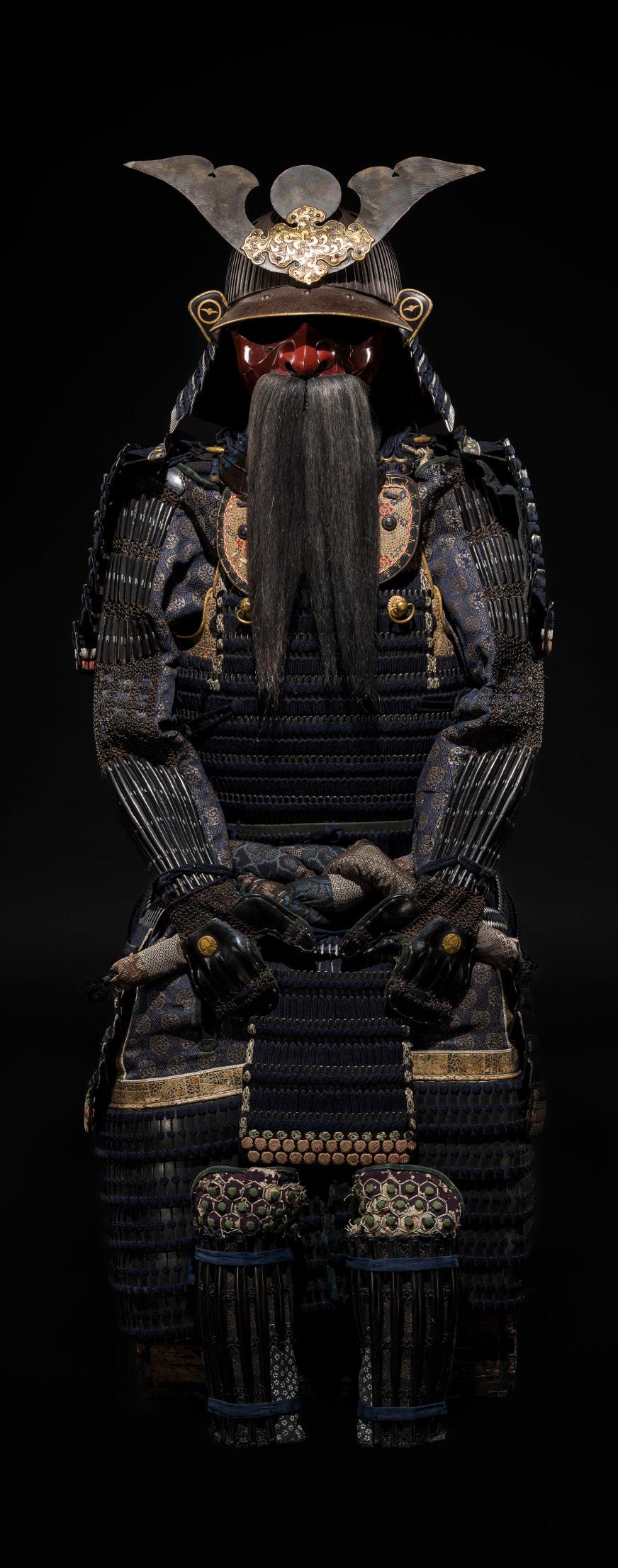
MIYATA KATSUSADA: AN IMPRESSIVE ROKUMAI DO GUSOKU (SIX-PIECE CUIRASS ARMOR) WITH AN IRON SUJIBACHI KABUTO AND MENPO
The kabuto by Miyata Katsusada (1653-c. 1727), signed Miyata Katsusada saku Japan, c. 1700-1720s, Edo period (1615-1868)
The brownlacquered iron components predominantly laced in blue, mounted on a fine blue fabric with Maruni chigai takanoa (‘two crossed falcon feathers’) crest, associated with the Kubo and Hidaka family, and fitted with intricate gilt-metal kanamono with kiku (‘chrysanthemum’) design.
The armor comprising:
An iron kabuto with a sixteen plate hachi with raised ridges terminating in a six-stage chrysanthemum-form tehen kanamono, to the back an agemaki-no-kan, the wide-brimmed mabisashi flanked by upturned roiro-lacquered fukigaeshi fitted with the Hoshi Umebachi (‘star plum bowl’) mon, associated with the Kuwana Domain, all above the three-lame shikoro, signed to the underside MIYATA KATSUSADA saku [made by Miyata Katsusada]; a brownlacquered iron menpo with a removable nose plate secured by turning pins, cast with an open mouth revealing the red-lacquered interior underneath a stiff moustache, the chin with ase-nagashi and straight cord pegs borne on rhombus grommets, all fitted with a three-lame yodarekake; a rokumai do with six five-lame kusazuri, fitted with two kiku-form agemaki-no-kan at the chest; a pair of six-lame sode; a pair of iron and kusari (chain mail) kote and tekko; a pair of haidate mounted on a beige and gold silk brocade; and a pair of lacquered iron and kusari suneate.
Provenance: From a private English collection, Heath House, Hampshire. By repute, acquired in Asia at the turn of the 19th century. The same collection includes a Louis XVI bureau plat which was originally the working desk of the French Emperor Napoleon III. Condition: Very good condition with old wear, and soiling. The lacquer with age cracks, flaking and minor touch ups to the menpo and yodarekake. Tears to the fabric and lacing.
Miyata Katsusada (1653- c.1727) was the 6th master of the Miyata school of armour makers and trained in the Saga Prefecture (Kyushu). He later became retained by the Lord of Nabeshima and moved to Edo (Tokyo) in 1707.
Miyata Katsusada was an excellent armor maker, excelling in the manipulation of iron. For a related armor by the same artist bearing the coat of arms of the Feudal


Lord Nabeshima Yoshishige, dated c. 1707-1730 see the Louvre Abud Dhabi, inventory number LAD 2018.007. Also compare a related iron do with an image of Fudo-Myo-o in the Walters Art Museum, by the same artist and dated 1721, accession no. 51.598.
Estimate EUR 20,000
Starting price EUR 10,000

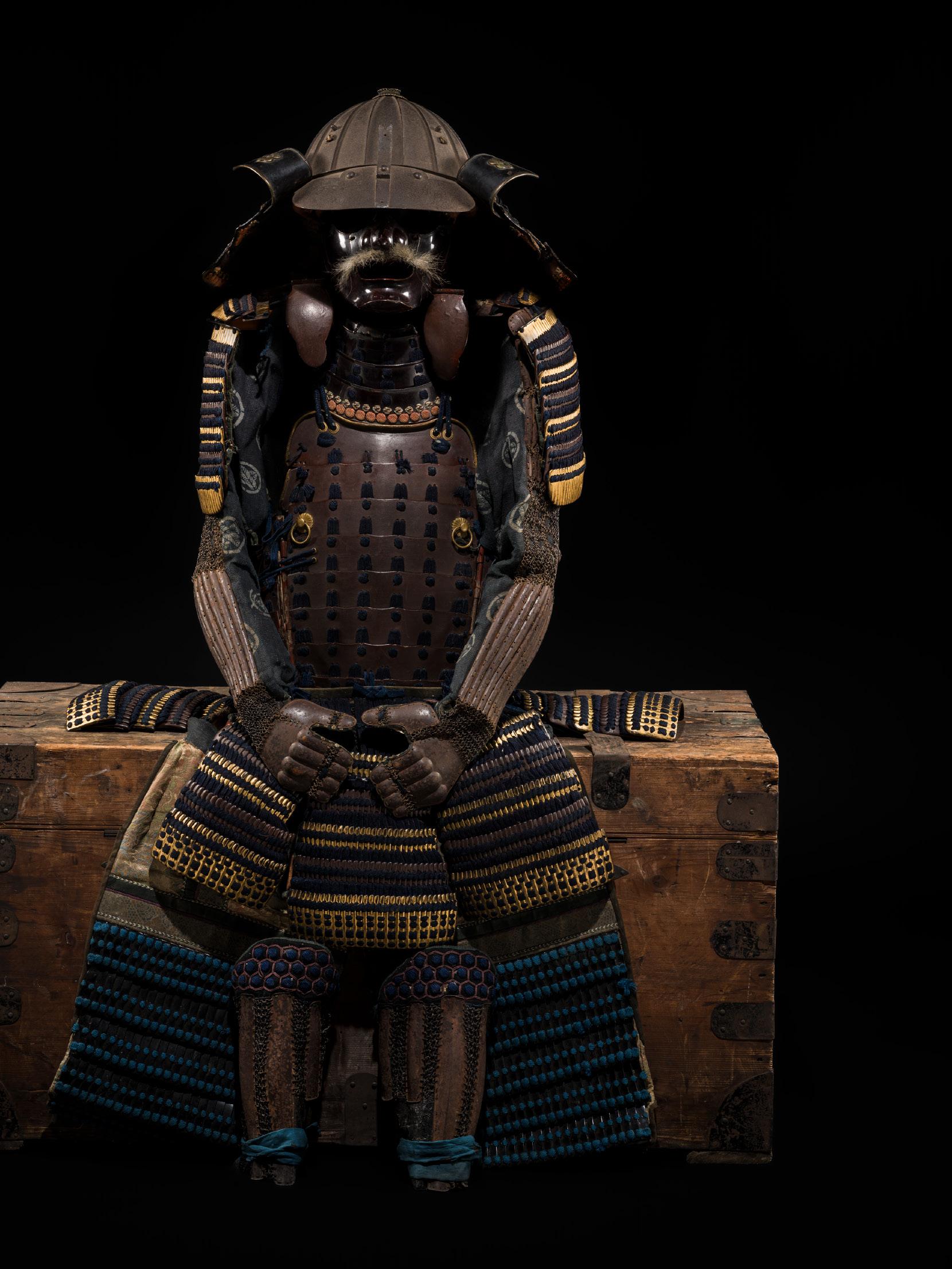


118
A SUPERB SILVER-INLAID GOMAI YOKOHAGI OKEGAWA DO GUSOKU (FIVE-PIECE CUIRASS ARMOR) WITH TAKEDA CLAN MON AND A MYOCHIN KABUTO
The helmet by Myochin Munetae, signed Myochin Munetae saku Japan, 18th century, Edo period (1615-1868)
The cuirass lacquered black, the sangu russet iron, all laced in blue with white and orange highlights, mounted on a fine silk brocade, and fitted with intricate gilt-metal kanamono with hishi mon, associated with the Takeda clan, as well as the kiku (‘chrysanthemum’) design, the Imperial symbol of Japan.
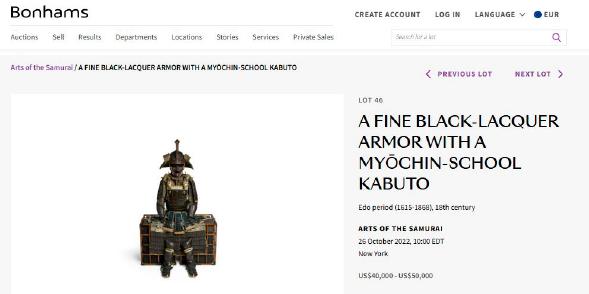
The present lot at Bonhams, Arts of the Samurai, 26 October 2022, New York, lot 46 (estimated at USD 40,000-50,000).
The armor comprising:
A twenty-four plate russet-iron kabuto of shallow profile, terminating in a five-stage gilt tehen kanamono chiseled with chrysanthemum scroll, the mabizashi decorated with confronted phoenixes in flush-inlaid silver on a polished iron ground,
trimmed in gilt-copper fukurin and finished with a two-part brass maedate formed as a Buddhist ken, flanked by ensuite fukigaeshi with printed leather and fitted with gilt heraldic crests of hishi, associated with the Takeda clan, and laced with an additional lame, all above the three-lame russet-iron shikoro laced in sugake style, the lowest lame applied with textured leather, the interior of the helmet signed MYOCHIN MUNETAE saku [made by Myochin Munetae]; the russet-iron Ryubu menpo with a removable straight nose plate secured by butterfly-shaped hinges, cast with an open mouth revealing the red-lacquered interior, scalloped flanges on the cheeks, the chin with a pierced ase-nagashi and straight cord peg, and fitted with a three-lame yodarekake; the gomai yokohagi okegawa do laced in sugake style and fitted with ten sections of five-lame lacquered-iron kusazuri, fitted with two kiku-form gilt-metal agemaki (decorative tassel) strung from en-suite cord rings to the breast and a third cord ring borne on a reticulated chrysanthemum plaque to the back; the six-lame chusode with kanmuri trimmed in gilt-metal fukurin chiseled with foliate scroll; the russet-iron kote with waffled Iyo-style plates on the upper arm, tsutsu-style plates on the forearms, and solid tekko, each decorated with flush-inlaid silver stylized dragons in clouds, and coiling vines; the haidate of close-fitting rows of russet-iron scales; and the tsubo suneate and the kogake decorated with clouds and scrolling vines in flush-inlaid silver.
Provenance: Bonhams, Arts of the Samurai, 26 October 2022, New York, lot 46 (estimated at USD 40,000-50,000). With an old label to the interior of the kabuto bowl’s ukibari lining identifying Munetae as the 27th Myochin master.
Condition: Very good condition with old wear, corrosion, and soiling. The lacquer with age cracks, small losses, and flaking. Expected losses and rubbing to silver inlays.
Estimate EUR 40,000
Starting price EUR 20,000


Japan, late Edo period (1615-1868)
The do decorated to the front in gold, black and red takamaki-e and hiramaki-e depict a dragon among scrolling clouds with a fierce expression, its mouth agape flanked by nostrils, the eyes painted behind a thin sheet of transparent crystal, the head topped by two horns and the scrolling body with finely rendered scales. The borders of the do of leather, surmounted by a chest piece of further brown leather stitched with an ornate design.
HEIGHT 31.5 cm
Condition: Very good condition with old wear. The lacquer with few age cracks, flaking and losses, as well as a small crack to the inlaid eye. Typical light creasing to the leather.
Estimate EUR 2,000
Starting price EUR 1,000
Japan, 18th century, Edo period (1615-1868)
The pair of sleeves comprising of solid iron tekko (hand covers), eight-lame sode (shoulder guards) with blue lacing, and iron and kusari (chain mail) kote. The reverse lined with multicolored silk brocade decorated with reishi clouds dragons.
LENGTH 66.5 cm
Provenance: From a private English collection, Heath House, Hampshire. By repute, acquired in Asia at the turn of the 19th century. The same collection includes a Louis XVI bureau plat which was originally the working desk of the French Emperor Napoleon III. Condition: Very good condition with old wear. The lacquer with few age cracks and minor flaking. The fabric with typical small losses and tears.
Estimate EUR 1,500
Starting price EUR 800

121
KOICHI NAGANOBU: A FINE PAIR OF SILVER-INLAID LACQUERED IRON STIRRUPS (ABUMI)
By Koichi Naganobu, signed Koichi Naganobu
Japan, Kanazawa in Kaga Province, 18th century, Edo period (1615-1868)
Of typical form, the exteriors finely lacquered in brown and intricately inlaid in silver to depict birds, clouds and floral motifs. The buckles at the top are similarly decorated with movable tangs. Signed to the tang of each stirrup KOICHI NAGANOBU.
SIZE 27 x 32.5 cm (each)
WEIGHT 2,148 g and 2,157 g
Japan, Edo period (1615-1868)
The group comprising, first, an iron command fan (tessen), its sticks lacquered in black, interspersed with dewdrops, the ribs mounted with paper decorated with the red sun on a gold-leaf ground and suspending a red tassel; the second, a large rectangular white cotton Hinomaru flag, sewn in three parts with a bold red sun disc hand-sewn at the center, symbolizing the rising sun and national identity of Japan.
HEIGHT 33.5 cm (fan), SIZE 128 x 213 cm (flag)
WEIGHT 448 g (fan)
Provenance: From a private English collection, Heath House, Hampshire. By repute, acquired in Asia at the turn of the 19th century. The same collection includes a Louis XVI bureau plat which was originally the working desk of the French Emperor Napoleon III. Condition: Good condition with old wear. The fan with a few folds, obvious age cracks and flaking to the lacquer. The flag with soiling, losses to one corner and obvious holes.
AUCTION COMPARISON
Compare a related iron command fan (tessen), dated to the 17th18th century, 53 cm (high), at Zacke, Fine Japanese Art, 6 December 2024, Vienna, lot 109 (sold for EUR 5,200).
Estimate EUR 1,500
Starting price EUR 800

Condition: Good condition with old wear and casting irregularities. Minuscule nicks, and minor obvious losses to the inlays. The inlaid signature heavily worn.
AUCTION COMPARISON

Compare a related pair of silverinlaid stirrups (abumi), by Katsukawa, dated to the 18th century, 27.4 cm (long), at Christie’s, Japanese and Korean Art, 20 March 2007, New York, lot 185 (sold for USD 14,400 or approx. EUR 19,500 converted and adjusted for inflation at the time of writing).
Estimate EUR 1,500 Starting price EUR 800

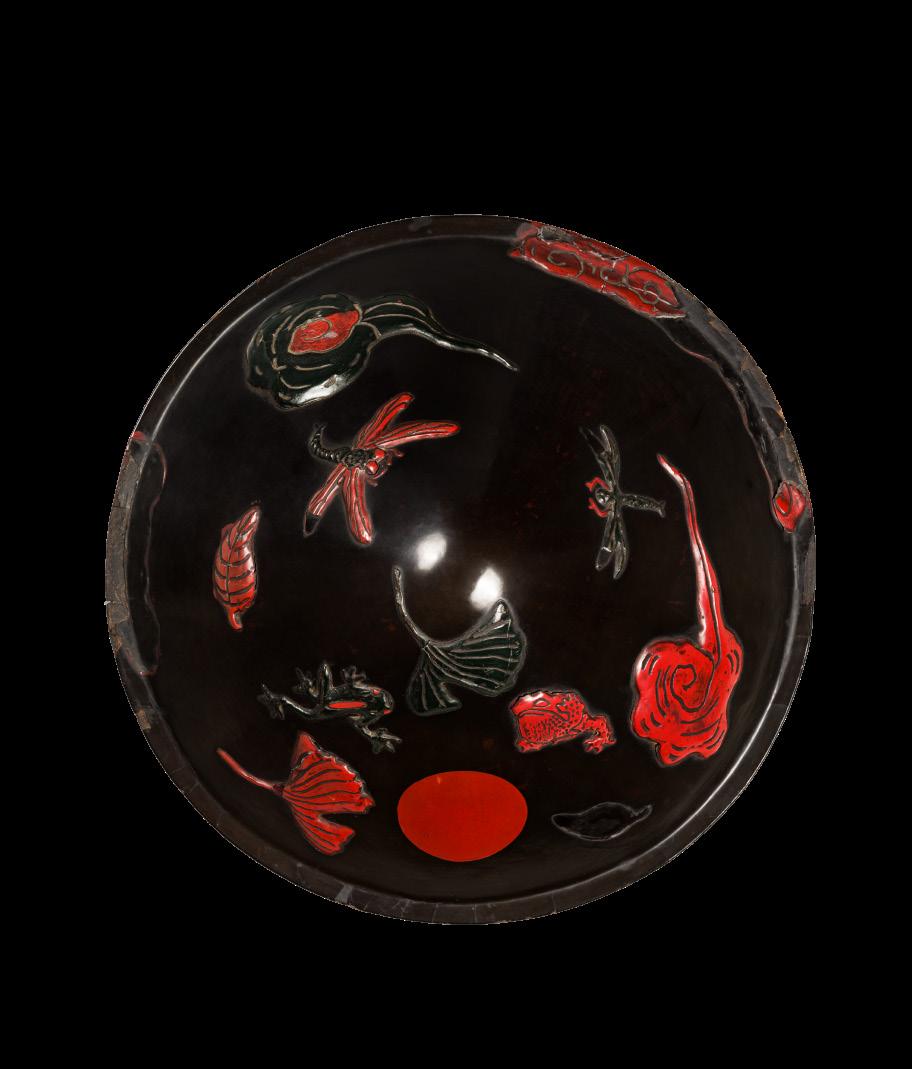
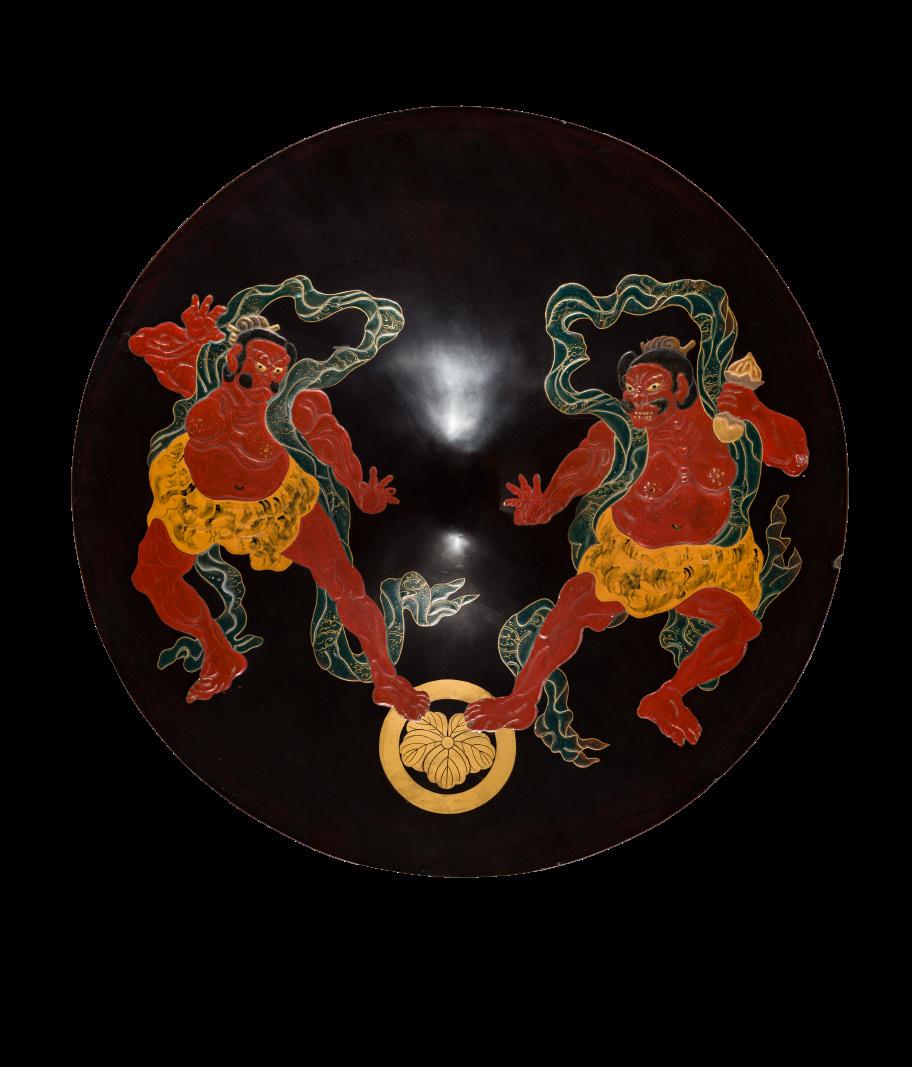
Japan, late Edo period (1615-1868)
Of conical form with a pointed top and a flat brim, finely lacquered in red and black takamaki-e to depict frogs and fireflies interspersed among ginko leaves, foliage, and scrolling clouds.
DIAMETER 34.7 cm
WEIGHT 960 g
Provenance: From a private English collection, Heath House, Hampshire. By repute, acquired in Asia at the turn of the 19th century. The same collection includes a Louis XVI bureau plat which was originally the working desk of the French Emperor Napoleon III.
Condition: Good condition with old wear, few age cracks, losses to lacquer—some with associated touchups, the underside with nicks, fine cracks, and small losses.
Estimate EUR 1,500
Starting price EUR 800
Japan, late Edo period (1615-1868)
Of almost flat ichimonji form, finely lacquered in iro-e takamaki-e, to depict Nio guardians standing in dynamic poses, chanting their respective syllables, with muscular red bodies and draped in billowing emerald green scarves. The guardians with one foot each resting atop the Maru ni tuta mon in gold hiramaki-e. The underside lacquered in red.
DIAMETER 45 cm
Provenance: From a private English collection, Heath House, Hampshire. By repute, acquired in Asia at the turn of the 19th century. The same collection includes a Louis XVI bureau plat which was originally the working desk of the French Emperor Napoleon III.
Condition: Very good condition with wear, few minor age cracks, small losses to lacquer, the underside with few tiny nicks and fine cracks.
Estimate EUR 2,000
Starting price EUR 1,000
125
A FINE LACQUERED WOOD JINGASA (WAR HAT) WITH CHINNAN SENNIN AND ASHINA CLAN MON
Japan, late Edo period (1615-1868)
Of almost flat ichimonji form, finely lacquered in iro-e takamaki-e and sabiji nuri to depict the immortal sitting atop a cliff with his familiar dragon wrapped around him, dressed in voluminous robes, the sennin holds the flaming pearl and a scepter aloft in his hands, all framed by scrolling clouds and above a maru-no-uchi-ni-mitsuhikiryo mon, associated with the Ashina clan, in gold hiramaki-e.
DIAMETER 43 cm
Provenance: From a private English collection, Heath House, Hampshire. By repute, acquired in Asia at the turn of the 19th century. The same collection includes a Louis XVI bureau plat which was originally the working desk of the French Emperor Napoleon III.
Condition: Good condition with old wear, few age cracks, small losses to lacquer, the underside with few tiny nicks and fine cracks.
Estimate EUR 2,000
Starting price EUR 1,000
126 A FINE LACQUERED WOOD JINGASA (WAR HAT) WITH A DRAGON AND WACHIGAI MON
Japan, late Edo period (1615-1868)

Of almost flat ichimonji form, fitted with a sakura-form hachimanza and kiku-form agemaki no kan, finely lacquered in iro-e takamaki-e to depict a sinuous dragon curling around the brim of the hat, its body finely rendered with scales and flaming scrolls, all framed by sabiji-nuri clouds and above a Wachigai mon, associated with the Wakisaka clan, in gold hiramaki-e.
DIAMETER 44.5 cm
Provenance: From a private English collection, Heath House, Hampshire. By repute, acquired in Asia at the turn of the 19th century. The same collection includes a Louis XVI bureau plat which was originally the working desk of the French Emperor Napoleon III.
Condition: Good condition with wear, few minor age cracks, small losses to lacquer, the underside with few tiny nicks and fine cracks.
AUCTION COMPARISON
Compare a closely related lacquered wood jingasa with snakes and hanabishi mon, Edo period, 43 cm wide, at Zacke, Fine Japanese Art, 6 December 2024, Vienna, lot 127 (sold for EUR 4,420).
Estimate EUR 2,000
Starting price EUR 1,000
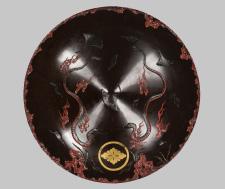


127
AN IMPRESSIVE AND RARE SOMADA STYLE LACQUER ‘BOTAN SHISHI’ KATANA DISPLAY CABINET (KATANA KAKE)
Japan, 19th century, Edo period (1615-1868)
A cabinet-form sword display stand, featuring four arched supports for the presentation of katana and a fitted lower case with three small drawers and one larger central drawer. Each drawer is mounted with gilt-metal handles finely cast in the form of samurai bridle bits (kutsuwa), a refined reference to the equestrian traditions of the warrior class. The wood core is finished in lustrous black lacquer and decorated throughout in Somada style aogai and raden.
The surfaces are densely inlaid with exceptionally thin motherof-pearl pieces forming scrolling floral arabesques; the foliage is composed of countless small curved fragments of iridescent shell that shimmer in shades of blue and green, the blossoms rendered in white shell, and the stems traced in fine gilded lines. All edges and fields are framed by continuous micro-mosaic borders of minute square nacre tiles, the hallmark of Somada workmanship. The largest drawer features an elaborate design of two shishi (lion dogs), symbols of protection and courage, while the sides are richly adorned with floral sprays of peony.
SIZE 40.3 × 49.2 × 24.2 cm
Condition: Very good condition, the inlays overall remarkably well preserved with only typical light crackling and tiny losses. The edges with typical cracks and nicks, some with associated repairs, and a larger crack to the back.
The precise mosaic borders, carefully patterned shell fields, and delicate gilt linework identify this piece as Somada style, associated with the Osaka–Kyoto sphere. Cabinet-form katana kake with such extensive raden decoration are exceptionally rare; the inclusion of drawers—each with kutsuwa-form fittings—suggests a high-status domestic display, intended both to present blades and to store small sword fittings or accessories.
The Somada style is attributed to specialist lacquerers active from the late 17th to early 18th century in the Kyoto and Osaka region, often associated with the name Somada and their followers. Hallmarks include micro-mosaic borders made from countless tiny shell and gold pieces, crisp geometric diapers framing pictorial panels, and floral scrolls built from uniformly cut nacre fragments linked by fine gilded lines. The idiom remained popular through the 19th century in boxes, inro, and occasional furniture forms. Works of this quality—such as the present cabinet—display extraordinary precision of the borders, subtle iridescence of the shell, and a striking harmony between martial and decorative symbolism.
The pairing of shishi and peonies (botan shishi) is a longstanding motif in Japanese traditional art. The shishi, a Buddhist symbol of power and protection, was regarded as the ‘king of the animals’, while the peony, symbolizing wealth and good fortune, was considered the ‘queen of the flowers’, being both together considered as fitting and auspicious companions.
AUCTION COMPARISON
Compare a related two-tiered suzuribako executed in the Somada style, measuring 23.1 x 15.4 x 9.4 cm, dated to the Meiji period, at Christie’s, Crafted Landscapes: The Ankracrona Collection of Japanese Lacquer and Asian Works of Art, 1 October 2020, New York, lot 10 (sold for USD 7,500 or approx. EUR 8,000 converted and adjusted for inflation at the time of writing).
Estimate EUR 5,000
Starting price EUR 2,400



A FINE MOTHER-OF-PEARL INLAID AND LACQUERED ‘MOUNT FUIJI’ KATANA
Japan, Meiji period (1868-1912)
The central panel carved in the form of a snowcapped Mt. Fuji and finely lacquered to depict a decorative mountain and lake landscape with a fisherman. The stand supported on two lobed feet, the uprights with three slots for katana, the roiro lacquered ground neatly inlaid with thin mother-of-pearl sheets below the gold takamaki-e vines.
LENGTH 50.3 cm
Condition: Good condition with minor wear, small nicks here and there, few natural age cracks, little flaking to the lacquer, and few losses to the inlays.
Estimate EUR 1,500 Starting price EUR 800


Japan, Meiji period (1868-1912)
A finely crafted lacquered tachi-kake, the stand featuring a gracefully curving stem flanked by flanges, rising from a rectangular base to a gold-lacquered scepter-head finial. The surface is decorated in roiro lacquer, centered by a tsuba motif intricately inlaid with mother-ofpearl. The stem is finished in brown lacquer, polished to simulate natural wood grain.
HEIGHT 58.5 cm, LENGTH 36 cm
Condition: Good condition with minor wear, light scratches to the base, new varnish to the top of the base, and little flaking.
AUCTION COMPARISON
Compare a related tachi-kake with similar mother-of-pearl inlays at Bonhams, Fine Japanese Art, 7 November 2013, London, lot 190 (sold for GBP 2,500 or approx. EUR 4,700 converted and adjusted for inflation at the time of writing).
Estimate EUR 1,000
Starting price EUR 500



IETSUGU: A KO-WAKIZASHI IN KOSHIRAE WITH CERTIFICATE
By Ietsugu, signed Ietsugu Japan, c. 1504-1521 (the blade), 17th century (the koshirae)
The blade: The sugata is hira-zukuri with iori mune. The hamon is ko-choji gunome in togari nioi-deki and nie-deki, the hada is itame nagare and masame. The nakago is ubu (not shortened), with one mekugiana, the tip is kurijiri, the yasurime is kiri, the mei reads IETSUGU.
The mounting: The habaki of shakudo with diagonal file marks and dew drops to the narrow sides. The iron tsuba of hamidashigata form, with gold and iro-e hirazogan featuring scrolling vines issuing leaves. The iron fuchi-kashira similarly worked in gold and silver hirazogan with the paulownia emblems flanked by fine tendrils. The tsuka with samewaga (rayskin), black tsuka-ito, and shibuichi menuki in form of a horse. The saya covered in brown lacquer imitating leather with further iron fittings and a similarly decorated iron kozuka with paulownia. The kozuka inscribed to the blade, SEKI KANESADA.
NAGASA 33.2 cm, LENGTH 43.8 cm (the blade), 47.7 cm (the koshirae)
Condition: Very good condition with minor wear and little ware. Provenance: From a noted French private collection of Japanese swords, purchased from L’ Huiller, 29 November 2021, Paris, lot 210.
Accompanied by a certificate (Shousho) from Togishi Rossi Massimo confirming the dating and signature, with an imprint of the tang, dated March 2022, signed and sealed.
Rossi Massimo is a highly skilled artisan, with over 30 years of experience in polishing and restoring Nihonto blades. He is the general secretary of INTK (Italian Association for the Japanese Sword) and a togishi, a restorer or polisher of Japanese swords.
Estimate EUR 5,000
Starting price EUR 2,400

YOSHITSUGU: A SHINTO KO-WAKIZASHI WITH CERTIFICATE
By Yoshitsugu, signed Nobukuni
Minamoto
Yoshitsugu Japan, c. 1624-1650 (the sword), the koshirae late Edo period (1615-1868)
PUBLISHED Andrea Saratti, Japanese Swords.
A journey into the art, Federighi editori, 2014, p.138.
The blade:

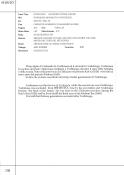

The sugata of kanmuri otoshi-zukuri with iori mune. The hamon is gunome, midare, and notare in nie-deki, with nie-kuzure, nie-sake, the hada is ko-mokume with ji-nie. The horimono is naginata hi. The nakago is ubu (not shortened), the tip is haagari kurijiri, two mekugi ana, the yasurime is kiri, the mei reads NOBUKUNI MINAMOTO YOSHITSUGU.
The mounting:
The habaki of plain copper. The iron tsuba of marugata form with one kozuka hitsu ana. The iron fuchi-kashira with gold takazogan lieafy vines. The tsuka and saya lacquered in a deep purple with an ishimeji ground. The kozuka of shibuichi nanako with hens, chicks, and baskets.
NAGASA 35.8 cm, LENGTH 47.6 cm (the blade), 57.7 cm (the koshirae)
Provenance: From a noted French private collection of Japanese swords.
Condition: Very good condition with minor wear, few minuscule nicks to the cutting edge, muneyaki, and tobiyaki. The saya of excellent condition.
Accompanied by a certificate (Shousho) from Togishi Rossi Massimo confirming the dating and signature, with an imprint of the tang, dated March 2009, signed and sealed.
Rossi Massimo is a highly skilled artisan, with over 30 years of experience in polishing and restoring Nihonto blades. He is the general secretary of INTK (Italian Association for the Japanese Sword) and a togishi, a restorer or polisher of Japanese swords.
Estimate EUR 4,000 Starting price EUR 2,000


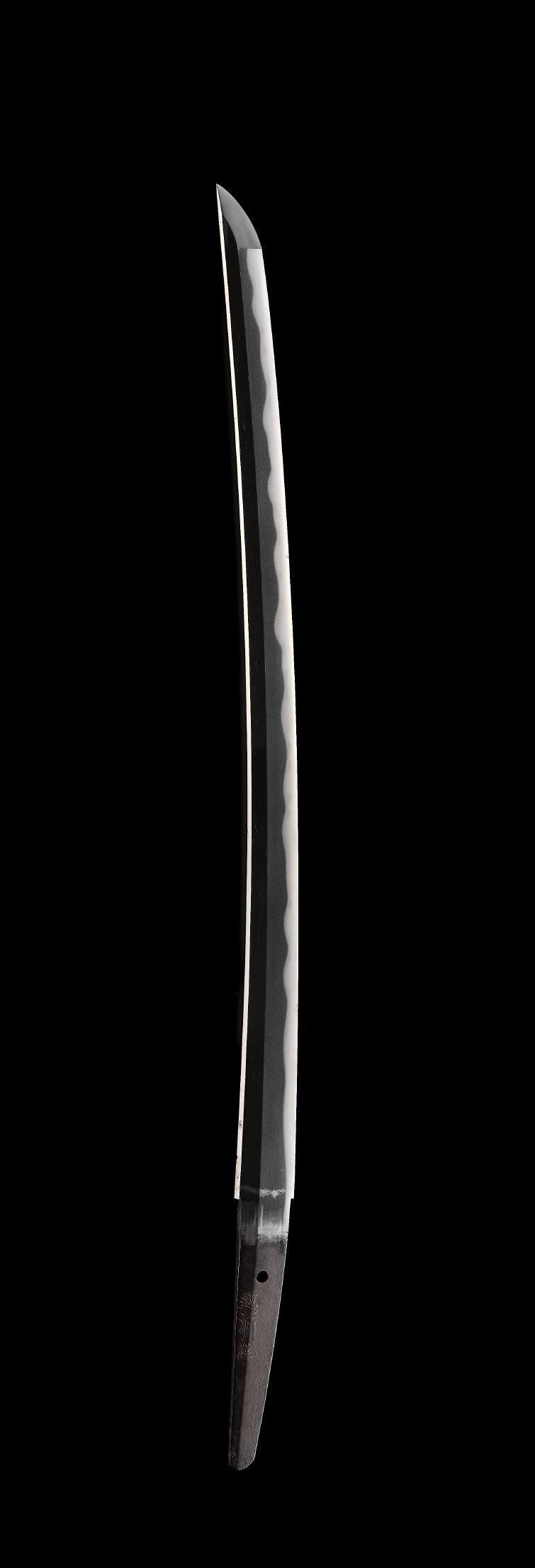

132
KANEMASA: AN ECHIZEN WAKIZASHI IN FINE KOSHIRAE AND SHIRASAYA WITH NBTHK TOKUBETSU HOZON TOKEN CERTIFICATES FOR THE MOUNTING AND BLADE
By Kanemasa (1661-1673), signed Echizen ju Shimosa Daijo Fujiwara Kanemasa
Japan, Echizen Province, mid to late 17th century, Enpo era (1673-1681)
This wakizashi has been judged and attested by the NBTHK to be the Hozon Token (‘Worthy of Preservation’) rank. The NBTHK Hozon paper, no. 101189, dated 30 April Showa 62 [1987], with an imprint of the tang and the seal of the NBTHK, with a registration stamp from the Educational Committee of Aichi, no. 42971, registration date 19 September Showa 47 [1972], issue date 25 June Showa 62 [1987], accompanies this lot.
This koshirae has been judged and attested by the NBTHK to be the Hozon Token (‘Worthy of Preservation’) rank. The NBTHK Hozon paper, no. 438151, dated 15 October Heisei 11 [1999], with a photograph of the koshirae and the seal of the NBTHK, accompanies this lot.
The blade:
The sugata is shinogi-zukuri with iori-mune, and chu-kissaki. The hamon is large, irregular gunome midare in ji-nie and chikei, the hada is ko-itame nagare. The nakago is ubu (not shortened), the tip is haagari, with one mekugi-ana, the yasurime is sujikai, and the mei reads ECHIZEN JU SHIMOSA DAIJO FUJIWARA KANEMASA.
The mounting:
The silver habaki with diagonal file marks and dew drops. The shibuichi tsuba of nademarugata form, with a kozuka hitsu ana, the ishimeji ground with gold and iro-e takazogan, featuring a cat with peonies and butterflies. The fuchi-kashira is of shinchu (brass) with an ishimeji ground, depicting Chokaro, gourd, and horses rendered in iro-e takazogan and shishiaibori. The fuchi signed ROSEN saku [made by Rosen]. The tsuka with rayskin samegawa and black tsuka-ito, with a bamboo and morning glory-form menuki carved in gold. The saya is of roiro with a roughened surface resembling leather. The kozuka with a shakudo nanako ground and gold and silver takazogan, decorated with floral wreaths, and inscribed, ‘RAIJO, HIJI-ZAN, TSUSHIMA no KAMI, FUJIWARA no ASON KANENAGA below a kiku flower (Protection from thunder / Mt. Hiji, Fujiwara no Ason Kanenaga, the Governor of Tsushima Province)’.
The shirasaya inscribed with a sayagaki, ‘SHIMOSA DAIJO FUJIWARA KANEMASA, ECHIZEN JU, JIDAO ENPO GORO [Fujiwara Kanemasa, with the title of Shimousa Daijo, resident in Echizen Province, dating from circa the Enpo era (1673-1681)], HACHO ISSISSHAKU HASSUN NIBU-HAN ARI KORE [The length of the blade is 1-shaku 8-sun and 2-bu and a half (circa 55.3 cm)]’.
NAGASA 55.3 cm, LENGTH 70 cm (the blade), 77.2 cm (the koshirae), 78.7 cm (the shirasaya)
Provenance: Christie’s, The Japanese Aesthetic, 15 May 2013, London, lot 116. The shirasaya with an old label from Christie’s, ‘15th May 2013 8822 116’. A noted private collector of Japanese swords, acquired from the above.
Condition: Very good condition with minor wear, little ware, and kuchikomi. The koshirae with minor wear.
Estimate EUR 15,000
Starting price EUR 7,500

133
TOMOMITSU: AN EFU NO TACHI
By Tomomitsu, signed Tomomitsu Japan, 15th century (the blade), late 19th century (the mounting)
The blade:
The sugata is of shinogi-zukuri with iori mune and koshi-zori curvature. The hamon is sugu and ko-midare in noi-deki, the hada is itame and some mokume. The nakago is suriage (shortened), with katte-sagari yasurime, in kiri-jiri, with four mekugi-ana, and the mei TOMOMITSU.
The mounting:
The habaki with vertical file marks. The tsuka of samegawa (rayskin), with gilt metal fittings comprising a menuki in form of a ho-o bird in a paulownia tree and a kabuto-gane (pommel cap). The shitogi tsuba of gilt metal. The saya of roiro superbly lacquered with autumn grasses in gold and silver takamaki-e, beautifully inlaid with mother-of-pearl, and with gilt metal fittings.
NAGASA 61.1 cm, LENGTH 76.5 cm (the blade), 85.7 cm (the shirasaya), 88 cm (the koshirae)
Condition: Very good condition with minor wear, few kuchikomi, and little ware. The koshirae with minor losses to the mother-ofpearl inlays, few little nicks, some of the metal fittings reattached with remnants of adhesive, the rayskin with small cracks and minor losses, few loose threads, small losses and open seams to the leather bands. Overall presenting beautifully.
Efu no tachi, or Hoso tachi, refer to the sword mounting style worn by the highest ranking Daimyo and officials of the court. Efu no tachi usually have a shitogi tsuba. They are generally considered ceremonial mountings rather than combat mountings.
Estimate EUR 8,000
Starting price EUR 4,000
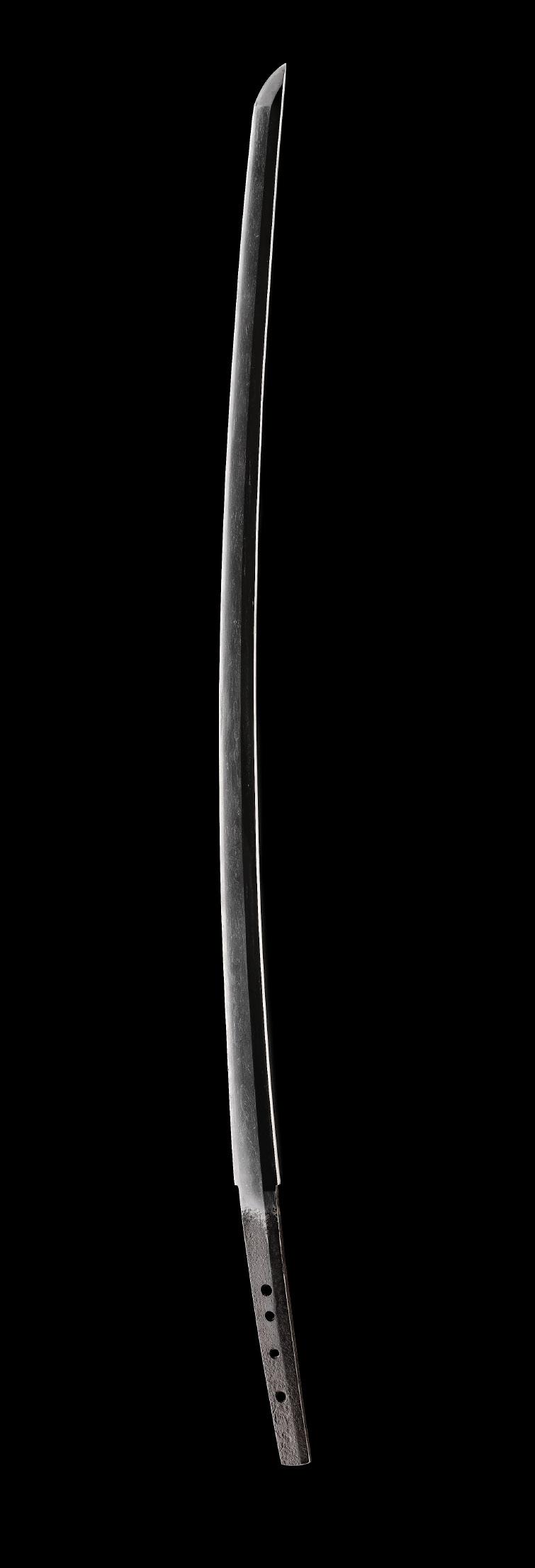

YOSHIMICHI: A MISHINA SCHOOL WAKIZASHI WITH NBTHK FUTSU KICHO CERTIFICATE AND FINE
By Yoshimichi, signed Tanba no Kami Yoshimichi Japan, Tanba, c. 1660, Edo period (1615-1868)
The blade:
The sugata is shinogi-zukuri with iori mune, koshi-zori curvature, and ikubi-kissaki. The hamon is a wide sudare in nioi-deki, extending to the shinogi-ji and dipping to a yaki-dashi at the hamachi, the hada is nashiji. Finely decorated to one side with a horimono of Bishamonten subduing a demon, the reverse with a lotus and bonji (Sanskrit script). The nakago is ubu (not shortened), with one mekugi-ana, the tip is iriyamagata, the yasurime is sujikai, the mei reads TANBA no KAMI YOSHIMICHI. The habaki of giltcopper with diagonal file marks and dew drops.
NAGASA 50 cm, LENGTH 64.5 cm (the blade), 74.3 cm (the shirasaya)
Provenance: The private collection of Kano Oshima, New York. Dr. Walter A. Compton, New York, acquired from the above. Christie’s, Japanese Swords & Sword Fittings from the Collection of Walter A. Compton, New York, 31 March 1992, lot 333. From a noted French private collection of Japanese swords, acquired from the above. A label from Christie’s, ‘The Compton Collection, 333’ to the shirasaya. Condition: Very good condition with minor wear.
The wakizashi with an NBTHK Futsu Kicho (especially precious) certificate, dated 13 December Showa 34 [1959], with an imprint of the tang and the seal of the NBTHK.
Estimate EUR 4,000 Starting price EUR 2,000
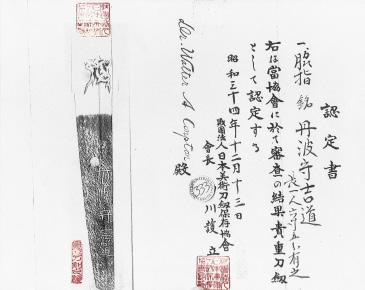
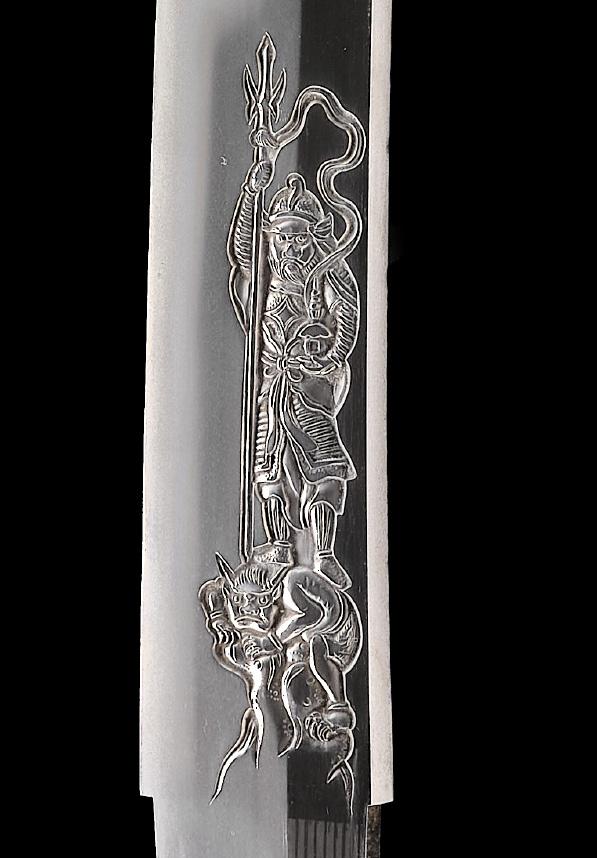

135
AFTER TADAYOSHI I: A FINE WAKIZASHI WITH DRAGON HORIMONO, IN SUPERB ‘DRAGON’ MOUNTS
After Tadayoshi I, signed Hi Tadayoshi and Kurimono Fujiwara Munenaga Japan, 1850-1870, Edo period (1615-1868)
The blade:
The sugata is hira-zukuri with iori mune. The hamon is wide suguha in ko-nie-deki, the hada is itame. The blade with a horimono featuring a dragon chasing a tama to one side, and a long vajra sword to the reverse. The nakago is ubu (not shortened), with two mekugi ana, the tip is kurijiri, the yasurime is kiri, and the mei reads Hi Tadayoshi to one side and Kurimono Fujiwara Munenaga to the other side.
The mounting:
The gilt-metal habaki with diagonal file marks and dew drops. The shibuichi tsuba of nademarugata form, of superior quality, worked in relief and with gold takazogan to depict a dragon amid clouds and turbulent waves, and signed ICHIGYOKUSAI OMORI EICHI and kakihan. The fuchi-kashira of a similar decoration and with a signature to the fuchi OMORI TERUHIDE with kakihan. The tsuka of samegawa (rayskin) with a black tsuka-ito and gold menuki of a crouching tiger. The saya superbly lacquered in roiro with gold and iro-e hiramaki-e and takamaki-e featuring a ferocious dragon. The kozuka of a shakudo nanako ground with gilt takazogan, featuring a dragon in scrolling clouds and inscribed to the blade, Jumyo.
NAGASA 31.7 cm, LENGTH 42.2 cm (the blade), 48.5 cm (the koshirae)
Provenance: From a noted French private collection of Japanese swords, purchased from L’ Huiller, 29 November 2021, Paris, lot 214.
Condition: The blade in excellent condition. The saya with touchups to the roiro lacquer, small nicks, and few fine age cracks.
Accompanied by a certificate (Shousho) from Togishi Rossi Massimo confirming the dating and signature, with an imprint of the tang, dated July 2025, signed and sealed.
Rossi Massimo notes that the present lot is an old utsushi mono, or prefect copy, of an important wakizashi forged by the famous founder of the Hizen School Tadayoshi (around 1600). The kodogu (sword fittings) and tsuba are of superior quality. The horimono is also of excellent quality with slight variations to the original sword.
Estimate EUR 6,000
Starting price EUR 3,000

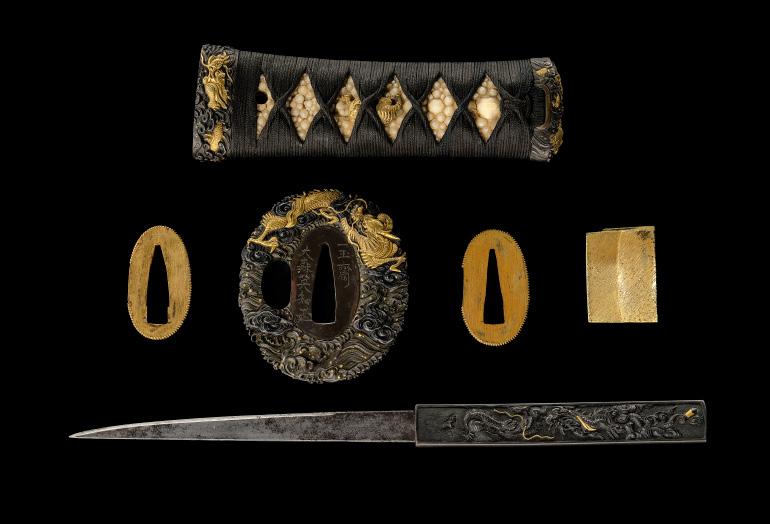

136 A WAKIZASHI IN SHIRASAYA WITH NBTHK KOSHU TOKUBETSU KICHO CERTIFICATE, ATTRIBUTED TO KANENOBU
Attributed to Kanenobu, unsigned Japan, 17th century, Edo period (1615-1868)
The sugata is of shinogi-zukuri with iori mune. The hamon is gunome in nie-deki, the hada is ko-itame. One side with two bohi (blood groove), the other side with one bohi. The nakago with kiri-jiri, with kiri yasurime, one mekugi-ana, and mumei (unsigned). The gilt-copper habaki with organic indentations reminiscent of rocks.
The silk cover suspending a wooden tag inscribed ‘Kanenobu’.
NAGASA 44.3 cm, LENGTH 57.1 cm (the blade), 67.5 cm (the shirasaya)
Condition: Good condition with minor wear, the blade with few areas of shintetsu (overpolishing), little ware, and minor fukure. The peg of the shirayasa is lost.
Estimate EUR 4,000
Starting price EUR 2,000

The wakizashi with a NBTHK Koshu Tokubetsu Kicho (especially precious) certificate, no. 291777, dated 30 June Showa 48 [1973], with an imprint of the tang, attributing the wakizashi to Kanenobu, and the seal of the NBTHK.
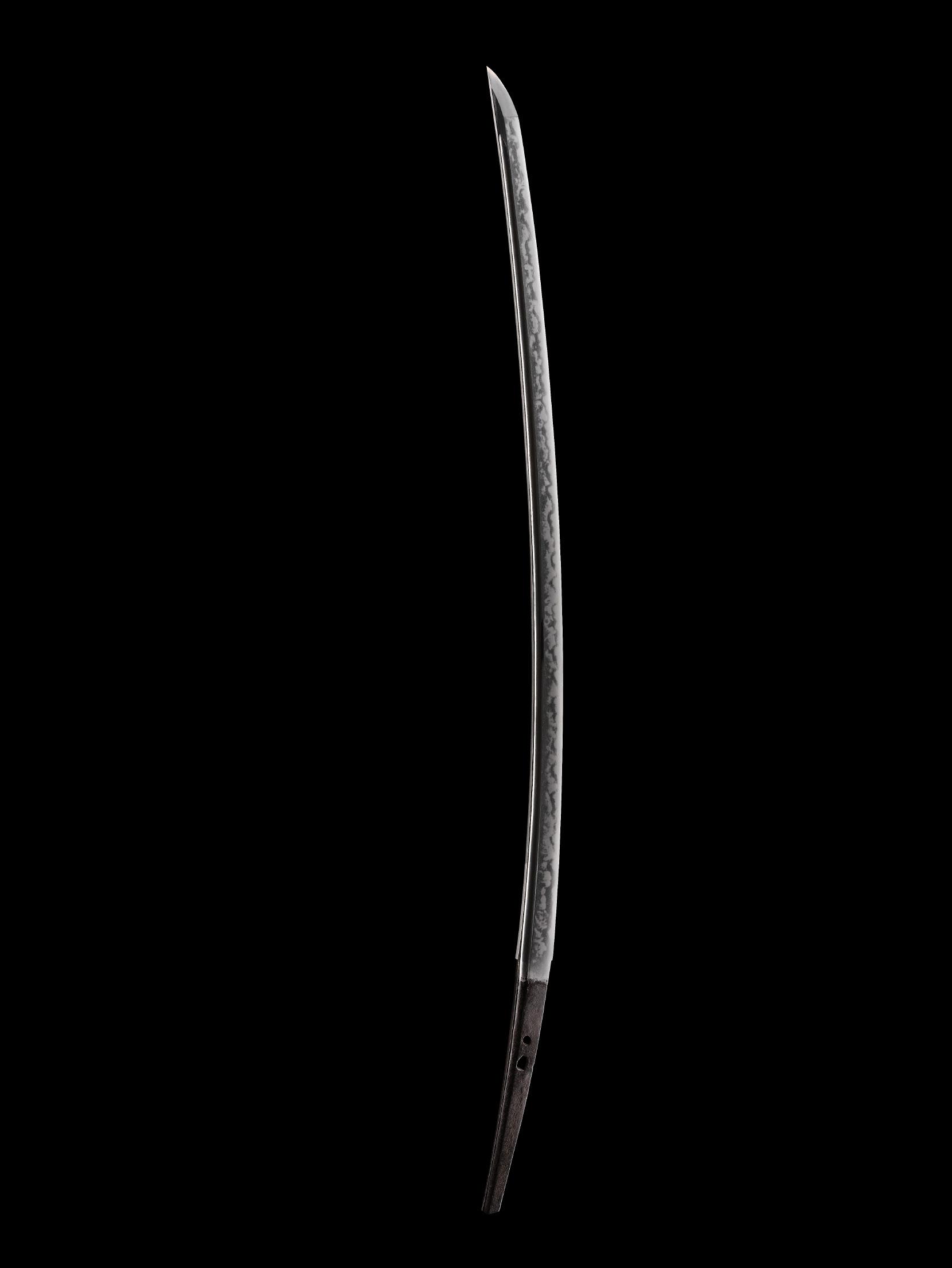
137 AN IMPRESSIVE KATANA IN SHIRASAYA
Japan, 17th-18th century, Edo period (1615-1868)
The sugata is of shinogi-zukuri with iori mune. The hamon is hitatsura in nie- and nioi-deki, the hada is mokume. Each side with a wide bohi (blood groove). The nakago in iriyamagata, no yasurime, two mekugiana, and mumei (unsigned). The copper habaki with diagonally incised lines.
NAGASA 91.4 cm, LENGTH 71.3 cm (the blade), 97.5 cm (the shirasaya)
Condition: Good condition with minor wear, few kuchikomi (rusty dimple), and tiny nicks to some areas of the cutting edge.
Estimate EUR 10,000
Starting price EUR 5,000

KANETAKA: A KATANA IN KOSHIRAE AND SHIRASAYA WITH NBTHK TOKUBETSU KICHO CERTIFICATE
By Kanetaka, signed Kanetaka Japan, 18th century, Edo period (1615-1868)
The katana with an NBTHK Tokubetsu Kicho (especially precious) certificate, no. 210101, dated 15 April Showa 46 [1971], with an imprint of the tang and the seal of the NBTHK.
The blade:
The sugata is shinogi-zukuri with iori mune, the hamon is notare and toran in nioi and nie-deki, the hada is itame. The nakago is suriage (shortened) with four mekugi-ana, the tip is kirijiri, the yasurime is kiri, and the mei reads KANETAKA.
The mounting:
The gilt-metal habaki with vertical and horizontal file marks. The iron tsuba of mokkogata form with a kogai and kozuka hitsu ana, featuring a fishing boat and bamboo, and an illegible signature. The iron fuchi-kashira with highlights in gold and shakudo takazogan, depicting bamboo and a tiger. The tsuka of samegawa (rayskin) with a pale orange tsuka-ito and gilt and shakudo menuki in form of a basket. The saya finely lacquered in roiro and sprinkled with aogai flakes.
NAGASA 68.4 cm, LENGTH 89 cm (the blade), 103 cm (the koshirae)
Condition: Very good condition with minor wear and little ware. The koshirae with minor wear and little flaking to lacquer. The saya of very good condition.
A copy of a registration card issued by the Okayama Prefecture Educational Committee on 8 February Showa 35 [1960], issue number 36111, accompanies this lot.
AUCTION COMPARISON
Compare a closely related Shinto katana by Kanetaka, dated 18th century, at Bonhams, Fine Japanese Art, 5 November 2009, London, lot 366 (sold for GBP 3,840 or approx. EUR 8,400 converted and adjusted for inflation at the time of writing).
Estimate EUR 5,000
Starting price EUR 2,400

TADAHIRO: A HIZEN
TADAHIRO KATANA IN SHIRASAYA WITH NBTHK TOKUBETSU KICHO CERTIFICATE
By Fujiwara Tadahiro, signed Fujiwara Tadahiro (2nd generation) Japan, Hizen, after 1641, Edo period (1615-1868)
The sugata is shinogi-zukuri with iori mune, the tip is o-kissaki, torii-zori curved, with a thick kasane (thickness). The hamon is suguha in nie-deki, the hada is ko-itame and mokume. The nakago is ubu (not shortened), the tip is iriyamagata, with one mekugiana, the yasurime is kiri, and the mei reads HIZEN KUNI no ju OMI DAIJO FUJIWARA TADAHIRO. The gilt-silver habaki with horizontal file marks and dew drops. The textile cover is inscribed HIZEN (NAGASAKI) HONGANJI Temple and the length of the sword.
NAGASA 79.4 cm, LENGTH 102.9 cm (the blade), 106.3 cm (the koshirae)
Condition: Very good condition with minor wear and few light scratches.
Omi no Daijo Fujiwara Tadahiro was the second Master of the Hizen school. His blades are known as oniwa-uchi swords, meaning ‘quenched in a garden’. They were said to have been quenched in front of the Lord of the Nabeshima clan, at his request.
AUCTION COMPARISON
Compare a closely related Hizen Tadahiro katana, 17th century, at Christie’s, Japanese Art and Design, 13 July 2005, London, lot 825 (sold for GBP 10,200 or approx. EUR 25,000 converted and adjusted for inflation at the time of writing).
Estimate EUR 6,000
Starting price EUR 3,000


The katana with an NBTHK Tokubetsu Kicho (especially precious) certificate, no. 325612, dated 18 April Showa 51 [1976], with an imprint of the tang, confirming the signature, and the seal of the NBTHK.



140
YOSHIMICHI: A MISHINA SCHOOL KATANA WITH NBTHK TOKUBETSU HOZON TOKEN CERTIFICATE
By Yoshimichi, signed Tanba no Kami Yoshimichi (5th Generation) Japan, Kyoto, dated 1712, Edo period (1615-1868)
This katana has been judged and attested by the NBTHK to be the Hozon Token (‘Worthy of Preservation’) rank. The NBTHK Hozon paper, no. 122277, dated 21 June Heisei 3 [1991], with a photo of the tang, confirming the signature, and the seal of the NBTHK, with a registration stamp from the Educational Committee of Tokyo, no. 236584, registration date 19 December Showa 60 [1985], issue date 20 August Heise 3 [1991], accompanies this lot.
The blade:
The sugata is shinogi-zukuri with iori-mune, and Mishina style boshi. The hamon is gunome notare, with ji-nie, ko-ashi, sunagashi, and kinsuji, the hada is itame and masame. The nakago is ubu with one mekugi ana, the tip is iriyamagata, the yasurime is sujikai, the mei reads TANBA no KAMI YOSHIMICHI with an Imperial kikumon and the uramei SHOTOKU NI NEN HACHI GATSU KICHI JITSU [On a lucky day in August of the second year of Shotoku era (1712)].
The mounting:
The habaki of gold-copper with horizontal file marks, and incised lines. The iron tsuba worked in yo-sukashi in form of a kiku and tendrils, and the nakago with copper sekigane. The fuchi-kashira of shakudo with an ishimeji ground and detailed with pavilions and pines in kebori and katakiribori as well as highlights in gold and iro-e takazogan. The tsuka of samegawa (rayskin), covered in black tsuka-ito, and with a copper and shakudo mekugi depicting armors. The saya of a luster roiro. The kozuka of shakudo nanako with gold takazogan featuring a dragon in a raised reserve.
NAGASA 63.4 cm, LENGTH 80.3 cm, 92.5 cm (the koshirae), 90.6 cm (the shirasaya)
Condition: Very good condition with minor wear. The koshirae with few minor flakes to the lacquer.
AUCTION COMPARISON
Compare a related Mishina school Tanto, also by Yoshimichi and dated 1641, at Christie’s, Important Swords from the Museum of Japanese Sword Fittings, 29 March 2005, New York, lot 42 (sold for USD 13,200 or approx. EUR 19,000 converted and adjusted for inflation at the time of writing).
Estimate EUR 15,000
Starting price EUR 7,500



141
SUKENAGA: A WAKIZASHI IN SUPERB LACQUER ‘KIRI, KATABAMI AND KIKU’ KOSHIRAE, THE BLADE WITH NBTHK TOKUBETSU HOZON TOKEN CERTIFICATE
By Sukenaga, signed Bizen Kuni Osafune ju Sukenaga Japan, Bizen, dated 1823, Edo period (1615-1868)
This sword has been judged and attested by the NBTHK to be the Tokubetsu Hozon Token (‘Especially worthy of Preservation’) rank. The NBTHK Hozon paper, no. 1021748, dated 15 December Reiwa 5 [2023], with a photograph of the tang and the seal of the NBTHK, with a registration stamp from the Educational Committee of Okayama, no. 3004, registration date 11 May Showa 26 [1951], accompanies this lot.
The blade:
The sugata is of shinogi-zukuri with iori mune. The hamon is chojimidare with ashi in nioi-deki, the hada is ko-itame. The nakago with kuri-jiri, with sujikai yasurime, one mekugi-ana, and the mei BIZEN KUNI OSAFUNE JU SUKENAGA [Sukenaga, resident of Osafune, Bizen] and dated to the reverse BUNSEI ROKU NEN NI GATSU HI [a day in February 1823].
The mounting:
The habaki of plain copper with diagonal file marks, the shakudo tsuba of mokkogata form with yo-sukashi and gold takazogan and hirazogan, featuring kiku flowers. The fuchi-kashira of shakudo nanako with iro-e takazogan, each featuring a group of swallows, the fuchi signed ISHIGURO KAZUO with kakihan. The menuki with kiku sprays in gold and shibuichi takazogan. The tsuka with samegawa (rayskin) and golden silk tsuka-ito. The koshirae saya finely lacquered in nashiji with gold takamaki-e paulownia and katabami kamon. The kozuka and kogai with a shakudo nanako reserve featuring a spray of kiku framed in a raised gold border.
NAGASA 53.8 cm, LENGTH 70.8 cm (the blade), 78.8 cm (the koshirae)
Condition: Very good condition with minor wear. The koshirae with minor wear, little rubbing and light scratches. With a fine polish brightening the hamon.
Sukenaga was a swordsmith in Bizen who was active at the end of Edo period. He received the title of Kaga Suke in 1834. Sukenaga made unique Choji-midare, reminiscent of chrysanthemum petals. His son the 2nd generation Sukenaga and Sukekane followed his style.
Estimate EUR 15,000
Starting price EUR 7,500



142
YUKIHIRO: A WAKIZASHI IN FINE MOUNTS, WITH NBTHK TOKUBETSU HOZON TOKEN CERTIFICATE FOR THE BLADE
By Yukihiro, signed Hizen Kuni Dewa Daijo Fujiwara Yukihiro Japan, mid- to late 17th century, Edo period (1615-1868)
This sword has been judged and attested by the NBTHK to be the Hozon Token (‘Worthy of Preservation’) rank. The NBTHK Hozon paper, no. 1008163, dated 15 March Heisei 30 [2018], with a photograph of the tang and the seal of the NBTHK, with a registration stamp from the Educational Committee of Hyogo, no. 10036, registration date 4 October Showa 26 [1951], accompanies this lot.
The blade:
The sugata is shinori-zukuri with iori mune. The hamon is suguha in nie-deki and with ko-ashi, the hada is ko-itame. The sword with a horimono featuring a sword and bonji (Sanskrit script), the reverse with two bohi (blood lines) and boji. The nakago is ubu (not shortened), the tip is kurijiri, with two mekugi ana, the yasurime is sujikai, and the mei reads HIZEN KUNI DEWA DAIJO FUJIWARA YUKIHIRO.
The mounting:
The gold-copper habaki with diagonal file marks and dew drops. The iron tsuba of yo-sukashi with a kozuka and kogai hitsu ana, and gold and copper takazogan featuring three immortals beside a waterfall, and signed to one side GOSHU HIKONE JU, the reverse SOHEISHI NYUDO MUNENORI SEI [Made by Soheishi Nyudo Munenori, resident of Hikone, Goshu]. The shakudo fuchi-kashira of iro-e takazogan, depicting a lively scene with oni. The fuchi signed GOSHU HIKONE JU KITAGAWA SOTEN SEI [Made by Kitagawa Soten, resident of Hikone, Goshu]. The tsuka of samegawa (rayskin) with golden tsuka-ito and iron menuki featuring a landscape with cottage. The saya lacquered in roiro with an ishimeji ground. The kozuka and kogai of shakudo nanako and gold takazogan, the kozuka with kiku blossom and inscribed to the blade TANBA no KAMI YOSHIMICHI. The kogai featuring auspicious flowers and reeds.
NAGASA 57.4 cm, LENGTH 74 cm (the blade), 82.9 cm (the koshirae), 86.2 cm (the shirasaya)
Condition: Very good condition with minor wear, little ware, and few minuscule nicks.
Estimate EUR 15,000
Starting price EUR 7,500


Japan, 19th century, late Edo period (1615-1868) to Meiji period (1868-1912)
The blade:
The sugata of ken-zukuri, the hamon is notare in nioi-deki with fine sunagashi, the hada is masame. The nakago with one mekugi ana, katte sagari yasurime, and mumei.
The mounting:
The gilt-copper habaki with horizontal file marks. The tsuka of irogane (mixed metal), in form of a vajra with bands of lotus petals worked in gold, silver, and copper takazogan. The fuchi decorated in silver takazogan with clouds. The saya lacquered in nashiji under a second layer of lacquer, entwined by a large silvered metal dragon with gold details chasing the magical tama pearl, and terminating in an irogane kojiri with silver takazogan clouds.
NAGASA 39 cm, LENGTH 51.7 cm (the blade), 66.4 cm (the koshirae)
Condition: Very good condition with minor wear. The dragon fitting to the saya slightly loose, few touchups to the gilt of the dragon, and minor surface wear.
In Buddhist iconography, the sword represents the defense of the true doctrine and the vanquishing of ignorance and evil. It also embodies intelligence and, more broadly, the triumph of spiritual wisdom leading to enlightenment. The combination of sword and vajra—known as the Kongoken (vajra sword)—is the attribute of Fudo Myoo. His sword symbolizes wisdom cutting through delusion, while the rope he holds binds and subdues negative forces. The Kurikara is the name of Fudo Myoo’s sword, derived from the dragon that coils around its blade. In esoteric Buddhist symbolism (samaya), the Kurikara-ken is regarded as a manifestation of Fudo Myoo himself—the sacred sword of wisdom that severs the three poisons (trivisa). The weapon takes its name from the Dragon King Kurikara (Kurikara Ryuo), who is said to wrap around the blade, transforming into a spiral of flames.
AUCTION COMPARISON
Compare a closely related ken with mounts, 26 cm long, at Bonhams, The Samurai Sale, 22 October 2009, New York, lot 3109 (sold for USD 42,700 or approx. EUR 55,500 converted and adjusted for inflation at the time of writing).
Estimate EUR 20,000
Starting price EUR 10,000



Japan, late 19th century

The present lot at Bonhams London, Fine Japanese Art, 15 May 2014, lot 194, sold for GBP 15,000 or approx. EUR 27,500
The fittings of solid gold, superbly worked in nanako (ringpunched ground), finely decorated in relief with crickets perched on reeds amid autumnal plants including kikyo (bellflower), kiku (chrysanthemum), hagi (bushclover), and obana (eulalia), comprising a tsuba of marugata form, with kogai and kozuka hitsu-ana, fuchikashira, and menuki, the roiro-lacquered saya with en suite kurikata and kaeritsuno, the tsuka of black samegawa (rayskin).
LENGTH 101.5 cm (total), WEIGHT (total) 765 g
Gold testing indicates a minimum purity of 18K WEIGHT of the gold tsuba 308 grams
Condition: Excellent condition with only minor wear.
Provenance: Bonhams London, Fine Japanese Art, 15 May 2014, lot 194 (sold for GBP 15,000 or approx. EUR 27,500 converted and adjusted for inflation at the time of writing). A noted private collection, acquired from the above.
Estimate EUR 30,000
Starting price EUR 15,000

Testing has indicated a minimum purity of 18 karat for the gold tsuba, weighing 308 grams (approximately worth €26,000 as of 26 October 2025).
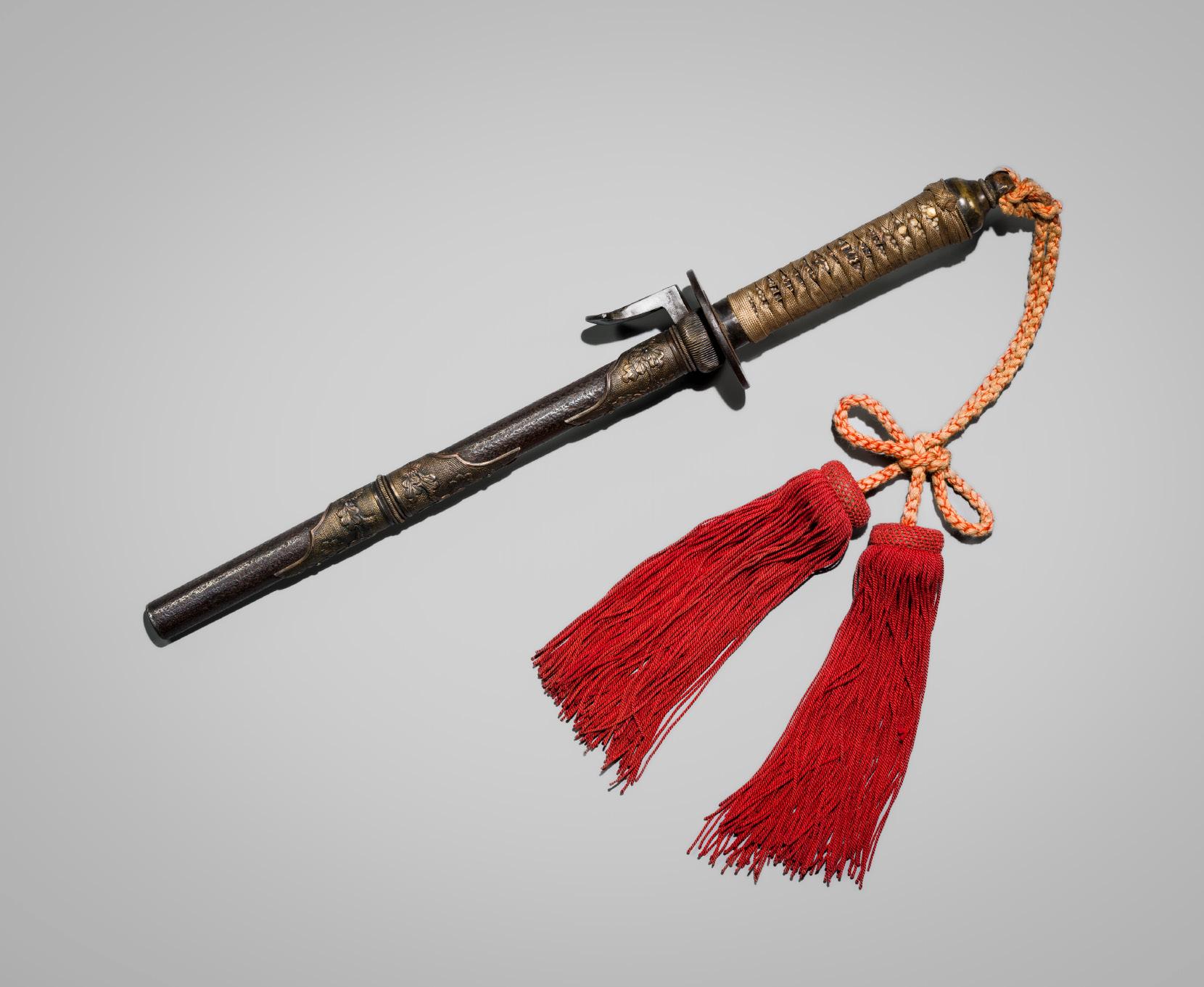
145
A RARE IRON JITTE (TRUNCHEON)
Japan, 18th-19th century, Edo period (1615-1868)
The boshin (main shaft) of solid iron, embellished to the top and mid-section with bronze appliques featuring an embossed kiku design above a nanako ground. The kagi (side hook) in form of a small axe. The iron tsuba is decorated in gold and silver hirazogan with a blossoming prunus tree. The tsuka with samegawa (ray skin) wrapped in tsuka-ito and with a pair of gilt-metal menuki featuring oni. The end is tied with a long cord suspending red silk agemaki (decorative tassels).
LENGTH 51.7 cm (excl. cord)
WEIGHT 1.9 kg
Provenance: From a Dutch collection. An old tag inscribed to one side, ‘Battle-made iron club of a high-ranking monk-soldier of Negoro-ji Temple, Kii Province, forged with a thick rod and a hooked handgrip’ and with the measurements to the reverse, accompanies the lot.
Condition: Very good condition with minor wear.
The jitte (ten hands) was a blunt weapon used by law enforcement during Japan’s Edo period. It also served as a symbol of authority, much like a badge, indicating that its bearer was on official duty. The jitte was carried by police officers of all ranks, from high-ranking samurai officials to lower-ranking samurai constables.
MUSEUM COMPARISON
Compare a related steel jitte, 18th19th century, 55 cm long, in the British Museum, museum number OA+.7131.

Estimate EUR 1,500
Starting price EUR 800

Japan, 19th century, Edo period (1615-1868)
The yari of jumonji (cross) form, fitted to a pole lacquered in roiro with a fine network of leafy tendrils scattered with Imperial kiku crests and iron fittings.
LENGTH 207.5 cm
WEIGHT 1.46 kg
Provenance: Collection of Hugo Burge. Hugo Burge (1972-2023) was an internet entrepreneur, collector, philanthropist, and the founder of Marchmont Ventures, an organization that supports arts and crafts. He displayed to great effect in his homes at Marchmont House in the Scottish Borders and in London.
Condition: Good condition with usual wear, some rubbing to the gilt, few stains, little flaking to the lacquer, and minor corrosion.
AUCTION COMPARISON
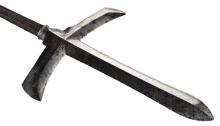
Compare a related Jumonji yari, dated 1824, lacking the pole, at Zacke, Fine Japanese Art, 6 December 2024, Vienna, lot 125 (sold for EUR 3,120).
Estimate EUR 2,000
Starting price EUR 1,000


147
MASAHISA: AN ECHIZEN IRON ‘SAKURA’ SUKASHI YANONE (PRESENTATION ARROWHEAD)
By Masahisa, Signed Echizen Masahisa Japan, 18th-19th century, Edo period (1615-1868)
The yanone of yanagi-ba (willow-leaf) form, pierced at the center with two interlocking sakura blossoms and incised with Echizen to one side and MASAHISA to the reverse.
LENGTH 18.9 cm
WEIGHT 24.8 g
Provenance: Collection of Jamie Wood. Hessink’s, Zwolle, 3 September 2020, lot 76. Private collection, Saxony, acquired from the above. Jamie Wood is the adopted son of the famous Rolling
148
TAKAKI: AN ECHIZEN IRON SUKASHI ‘SPICE CLOVE’ YANONE (PRESENTATION ARROWHEAD)
By Takaki, signed Takaki Japan, 18th century, Edo period (1615-1868)
The yanone of a small choji (Japanese spice clove) form, pierced at the center with a cross shape and incised to one side TAKAKI.
LENGTH 17 cm
WEIGHT 12.4 g
Provenance: Collection of Jamie Wood. Hessink’s, Zwolle, 3 September 2020, lot 76. Private collection, Saxony, acquired from the above. Jamie Wood is the adopted son of the famous Rolling
Stones guitarist Ronald David (Ronnie) Wood and the co-owner of two galleries, Scream and Whisper in London, which exhibit art from emerging artists.
Condition: Good condition with minor wear, few spots of rust, few tiny nibbles along the edges, minor surface scratches, and a split to the tip of the tang.
MUSEUM COMPARISON
Compare a closely iron yanone in form of a yanagi-ba with sakura blossoms, 13th–18th century, 23.8 cm long, in the Metropolitan Museum of Art, object number 14.100.343.
Estimate EUR 1,000
Starting price EUR 500

Stones guitarist Ronald David (Ronnie) Wood and the co-owner of two galleries, Scream and Whisper in London, which exhibit art from emerging artists.
Condition: Good condition with minor wear, few tiny nibbles along the edges, minor surface scratches, and few tiny nicks and chips to the edges.
MUSEUM COMPARISON
Compare a closely related iron yanone, 18th century, 14.6 cm long, in the Metropolitan Museum of Art, object number 32.75.670.
Estimate EUR 1,000 Starting price EUR 500



149
TOMOKATSU AND SHOSHINSAI: A RARE MINIATURE ‘THE JEWELED RIVERS’ INDOOR ARCHERY SET
By Tomokatsu (arrow) and Shoshinsai (bow), signed Tomokatsu and Shoshinsai
Japan, 19th century, Edo period (1615-1868)
The box contains eight wooden arrows with bone tips, adorned with gold lacquer bands and fine green thread bindings or black lacquer securing three feathers, one dyed purple and the others white. Each arrow is signed TOMOKATSU. The accompanying threepart wooden bow (koyumi) features silver fittings and a wooden grip decorated with a finely detailed dragon amid curling clouds, the ends finished with silver mounts. Signed SHOSHINSAI.
The present archery set, with its exquisitely lacquered arrows and bow, thus embodies a poetic allusion rather than a martial purpose. It was not intended for practical use but as a ceremonial or decorative display object. Japanese ladies entertaining themselves with indoor archery, Edo period

Inscription: To the tomobako LENGTH 28.5 cm (arrows), 92 cm (bow)
Condition: In good overall condition with minor wear consistent with age and use. Some flaking to the lacquer, light tarnishing to the silver, and a few loose feathers. One end of the bow shows a repaired section.
With a wood tomobako (storage box) decorated with bush clover (hagi) and inscribed Tamagawa 玉河 [The Jeweled Rivers]. Each part of the koyumi with a silk cover.
Mu-Tamagawa (The Six Jeweled Rivers) poetically references the six famous rivers named Tamagawa that appear in classical Japanese poetry, each celebrated for its beauty and the seasonal imagery it evokes. These rivers, scattered across the provinces of Japan, were beloved subjects in waka poetry and painting, symbolizing the purity of flowing water, the passage of time, and the refinement of nature’s transient beauty.
AUCTION COMPARISON
Compare a related archery set of closely related size but with twelve arrows at Zacke, Fine Japanese and Netsuke Art, 22 June 2019, Vienna, lot 54 (sold for EUR 5,491).
Estimate EUR 1,500 Starting price EUR 800


150
A RARE GROUP OF TWO AINU RITUAL OBJECTS, IKUPASUY AND MAKIRI
Japan, mid-19th century, Edo period (1615-1868)
The first carving is a slender wood ikupasuy (prayer stick) carved of elongated, flat, and slightly tapering form with rounded ends, the body finely carved in relief with star-shaped crest and a tomo-e crest. The second is a makiri dagger with a slightly curved wooden hilt and sheath, both deeply carved with intricate linear and crosshatched patterns. The sheath is bound with two antler bands to both ends. A cord is attached to the sheath for suspension.
Originally huntergatherers, the island’s indigenous Ainu people have a different language, religion and culture from the Japanese, all rooted in a strong connection with nature; this influence is clear in local crafts. Chief among them is carving, traditionally the domain of Ainu men, who sculpt wood into tools and adorn their surfaces with patterns passed down through generations.

LENGTH
Condition: Very good condition with typical wear and natural flaws to the material. Age cracks and small losses to the handle, tiny nibbling, and rust to the dagger.
Ikupasuy are among the most important objects owned by the Ainu and are venerated as sacred objects. They were used in Ainu rituals, particularly libation rituals where barley wine or sake is dripped on the stick. The Ainu believed that the gods would receive what they drank six-fold.
MUSEUM COMPARISON
Compare a related wood prayer stick (ikupasuy) carved with abstract designs and crosshatching, 31 cm long, dated to the mid-19th century, in the British Museum, registration number As.8110.


Compare a closely related Ainu bone and wood knife and sheaths, 17.3 long, in the British Museum, registration number As1944,09.8.
Estimate EUR 4,000
Starting price EUR 2,000

Lots 151 to 199

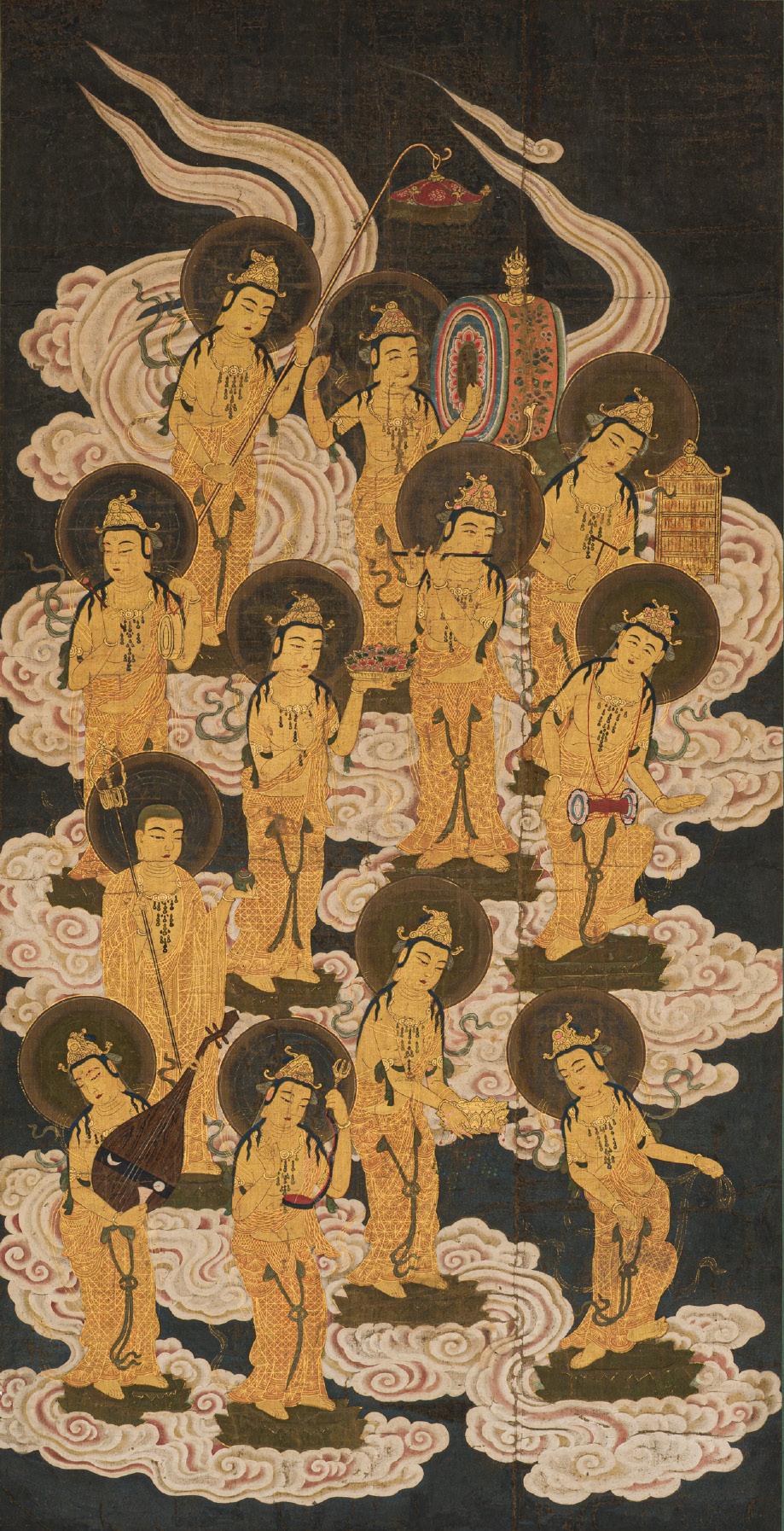
151 AN IMPORTANT PAIR OF HANGING SCROLL PAINTINGS DEPICTING THE TWENTY-FIVE BODHISATTVAS DESCENDING FROM HEAVEN, KAMAKURA PERIOD
Japan, c. 1300, Kamakura period (1192-1333)
Ink, watercolors, gouache, and gold on silk. Mounted as hanging scrolls within silk-brocade frames with gilt-metal lotus-chased jikusaki (roller ends).
This pair of scrolls depicts the twenty-five bodhisattvas (Nijugo Bosatsu) descending from heaven, a vision associated with the welcoming descent (raigo) of Amida Buddha. Twenty-five radiant divinities, adorned with jeweled ornaments and flowing scarves, float upon golden clouds. The right scroll is led by the bodhisattva Kannon (Avalokitesvara), who holds a small lotus pedestal to receive the soul of the believer, while the left is led by Seishi (Mahasthamaprapta), who joins his hands in the anjali mudra, the gesture of reverence.
The remaining attendants play musical instruments - drums, flute, koto, and lute - and dance gracefully upon lotus pedestals as they descend, their garments and ribbons trailing in rhythmic motion. Each figure is outlined in delicate ink lines, highlighted with gold pigment, and painted in soft mineral colors characteristic of Kamakura-period devotional art.

Raigo of Amida and Twenty-Five Attendants, late Kamakura period, color and gold on silk, Chion-in Temple and Kyoto National Museum, Kyoto – designated a National Treasure of Japan
These bodhisattvas serve as attendants to Amida (Amitabha), the Buddha of Infinite Light, who promises salvation and rebirth in the Western Paradise (Sukhavati) to those who call upon his name with sincere faith. Such pairs of scrolls would originally have flanked a central image of Amida Buddha, forming a triptych used in Pure Land rituals and funerary rites.
Inscriptions: To the box, Kamakura Jidai, Nijugo Bosatsu 鎌倉時代、廿五菩薩 像 [Twenty-Five Boddhisattvas, The Kamakura Period]. The labels to the side of the box, inscribed Ri yon-gorei-go (yonsen gohyaku go), Kamakura Jidai, Nijugo Bosatsu リ四五0五、鎌倉時代、廿五 菩薩双幅 [Number “Ri” 4505, a pair of hanging scrolls with Twenty-five Bodhisattvas, the Kamakura Period]
Image SIZE 110 x 56.5 cm, SIZE incl. mounting 202 x 77.5 cm
Condition: Good condition with old wear commensurate with age. Minor soiling, some creasing and folds, and expected flaking to pigment with associated touchups. The mounting with usual traces of wear and age. Presenting beautifully.
Each hanging scroll with an inscribed, black-lacquered wood tomobako (storage box).
MUSEUM COMPARISON
Compare a closely related pair of scrolls depicting twenty-five bodhisattvas descending from heaven, Kamakura period, dated c. 1300, size 99 x 40 cm (each), in the collection of the Kimbell Art Museum, accession number AP 1986.11 a,b.
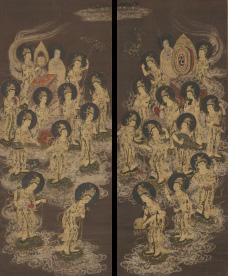
Estimate EUR 15,000 Starting price EUR 7,500

152
A BUDDHIST PAINTING DEPICTING AMIDA RAIGO (DESCENT OF AMITABHA BUDDHA) TRIAD, KAMAKURA TO MUROMACHI PERIOD
Japan, 14th-15th century, late Kamakura (1185-1333) to Muromachi period (1333-1573)
Ink, watercolors, and gold paint on paper. Mounted on silk brocade and set inside a wooden frame. Depicting Amida descending from heaven on floating lotus pedestals, the hands in the raigo (welcoming) mudra: the right arm raised with the hand facing outward and the thumb and forefinger touching (symbolizing wisdom); Amida accompanied by the Bodhisattvas Kannon (Avalokiteshvara) and Seishi (Mahasthamaprapta), the kneeling Kannon carrying a lotus pedestal.

AUCTION COMPARISON
Image SIZE 49 x 28 cm, SIZE incl. mounting 66.5 x 40.5 cm
Provenance: Property of Madam Li Ai-Vee, The Chalet Yu Lan Collection, thence by descent.
Condition: Good condition with wear and soiling. Some creasing, scattered folds, flaking and rubbing to pigment, and overall crackling.
MUSEUM COMPARISON
Compare a closely related Kamakura painting depicting Buddha Amida’s descent, early 14th century, size 127 x 56.5 cm, in the Walters Art Museum, accession number 35.68.


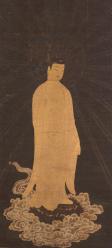
Compare a closely related hanging scroll painting depicting Buddha Raigo, Muromachi period, 15th-16th century, size 81 x 33.6 cm, at Bonhams, Fine Japanese and Korean Art, including the Alan and Simone Hartman Collection of Japanese Art, 20 March 2025, New York, lot 632 (sold for USD 5,120 or approx. EUR 4,500 converted and adjusted for inflation at the time of writing). Compare a closely related hanging scroll painting of Amida Raigo, Kamakura period, 14th century, image size 117.5 x 53.5 cm, at Bonhams, Samurai, Snow, Spectacle, Japanese Art across Seven Centuries, 7 November 2024, London, lot 281 (sold for GBP 14,080 or approx. EUR 17,000 converted and adjusted for inflation at the time of writing).
Estimate EUR 4,000
Starting price EUR 2,000
153
Japan, 16th century, Muromachi period (1333-1573)
Ink, watercolors, gouache, and gold paint on silk. Mounted as a hanging scroll within a silk brocade frame with copper repousse jikusaki (roller ends). Depicting thirteen deities seated in vajrasana on lotuses, holding various attributes, a canopy in the upper part, among them Dainichi and the four Chi Nyorai (Dhyani Buddha), six Bosatsu, an Arakan (perfected disciple of Buddha) and Fudo Myo-o.
Inscriptions: To the box, Namu jusan butsu sonzo, jugoi jo, sakon e no shogen, uneme no kami, Kose Tomonisa no sho 南無十三佛尊像、従五位上、左近衛将監、采女正、巨勢有久
能写 [The Sacred images of the Thirteen Buddhas, painted by Kose no Tomohisa, with the Court Rank Junior Fifth upper rank, Sakon no e Shogen, uneme no kami title.]
Image SIZE 98.5 x 39.5 cm, SIZE incl. mounting 175 x 58.5 cm
Provenance: The private collection of Hersleb Vogt, Norway. Hersleb Vogt (1912-1999) was a Norwegian diplomat, born in Kristiania (now Oslo). He was hired in the Ministry of Foreign Affairs in 1936 and served as the Norwegian ambassador to Japan from 1953 to 1958.
Condition: Very good condition with minor wear. Minor soiling, some creasing and folds, and expected flaking and rubbing to pigment with associated touchups. The mounting with usual traces of wear and age.
With an inscribed wood tomobako storage box.
The Thirteen Buddhas include Fudo Myo-o (Acala: 7th day), Shaka Nyorai (Shakyamuni Tathagata: 27th day), Monju Bosatsu (Manjusri: 37th), Fugen Bosatsu (Samantabhadra: 47th), Jizo Bosatsu (Ksitigarbha: 57th), Miroku Bosatsu (Maitreya: 67th), Yakushi Nyorai (Bhaishajyaguru: 77th), Kannon Bosatsu (Avalokitesvara: 100th), Seishi Bosatsu (Mahasthamaprapta: 1st year), Amida Nyorai (Amitabha: 3rd year), Ashuku Nyorai (Aksobhya: 7th year), Dainichi Nyorai (Mahavairocanasatathagata: 13th year) and Kokuzo Bosatsu (Akasa-garbha: 33rd year).
MUSEUM COMPARISON
Compare a closely related hanging scroll depicting the Thirteen Buddhas, dated to the 16th-17th century, image size 94 x 39.7 cm, in the Metropolitan Museum of Art, object number 2021.396.1.
AUCTION COMPARISON
Compare a closely related hanging scroll depicting the Thirteen Buddhas, dated to the 16th century, size 106.7 x 58.3 cm, at Christie’s, Japanese and Korean Art, 20 March 2007, New York, lot 116 (sold for USD 12,000 or approx. EUR 16,400 converted and adjusted for inflation at the time of writing).
Estimate EUR 2,500
Starting price EUR 1,200



Japan, 18th–19th century, Edo period (1615–1868)
Ink, watercolors, gouache, and gold on silk. Mounted on silk and set inside a frame, behind glass.
Finely painted with the threeheaded, eight-armed Buccho Sonso (Ushnishavijaya) at the center, seated in dhyanasana. The principal right hand holds a double vajra (visvavajra) before the chest, the left grasps a vajra lasso (pasha). The radiating secondary hands display a lotus (padma) supporting Amitabha (Amitabha), an arrow, a bow, and a nectar vase (amrita-kalasha).
Flanking her are Avalokiteshvara (Avalokitesvara) to the right and Vajrapani (Vajrapani) to the left, each standing gracefully, holding a fly whisk, and adorned with rich silks and jewelry. Above, a celestial being (Hiten) descends among swirling clouds.
In the four corners are the wrathful deities Fudo Myo-o (Acalanatha), Aizen Myo-o (Takkiraja), Seijo Myo-o (Niladanda), and Dairiki Myo-o (Mahabala), each within an aureole of flames, brandishing attributes appropriate to their esoteric functions.
Image SIZE 46.4 x 28 cm
SIZE (incl. frame) 105.5 x 58 cm
Condition: Excellent condition with minor wear. The frame with expected traces of use and age.
The Japanese name Buccho Sonsho translates the Sanskrit Usnisavijaya, the Victorious One of the Buddha’s Crown, a deity associated with longevity and purification rites. The iconography of three heads and eight arms, including the visvavajra, pasha, arrow, bow, nectar vase, and lotus bearing Amitabha, follows the standard esoteric descriptions of the deity.

Wrathful Myoo such as Fudo, Aizen, Seijo, and Dairiki are common attendants in Edo-period mandara compositions related to the cult of Ushnishavijaya. Their fierce expressions and dynamic postures symbolize the subjugation of obstacles to enlightenment.
While Ushnishavijaya is depicted in earlier Kamakura and Muromachi Sonsho Mandara, these typically center on Dainichi (Mahavairocana) surrounded by the Eight Usnisa Buddhas. The present composition, featuring Ushnishavijaya herself at the center, reflects the later Edo-period interest in more explicitly Vajrayana imagery and longevity cults, stylistically consistent with eighteenthto nineteenth-century painting.
AUCTION COMPARISON
Compare with a related mandara of the Godai Kokuzo Bosatsu, 16th-17th century, size 172 x 101 cm, at Zacke, Fine Chinese Art, Buddhism and Hinduism, 6 March 2021, lot 697 (sold for EUR 20,224).
Estimate EUR 2,500
Starting price EUR 1,200

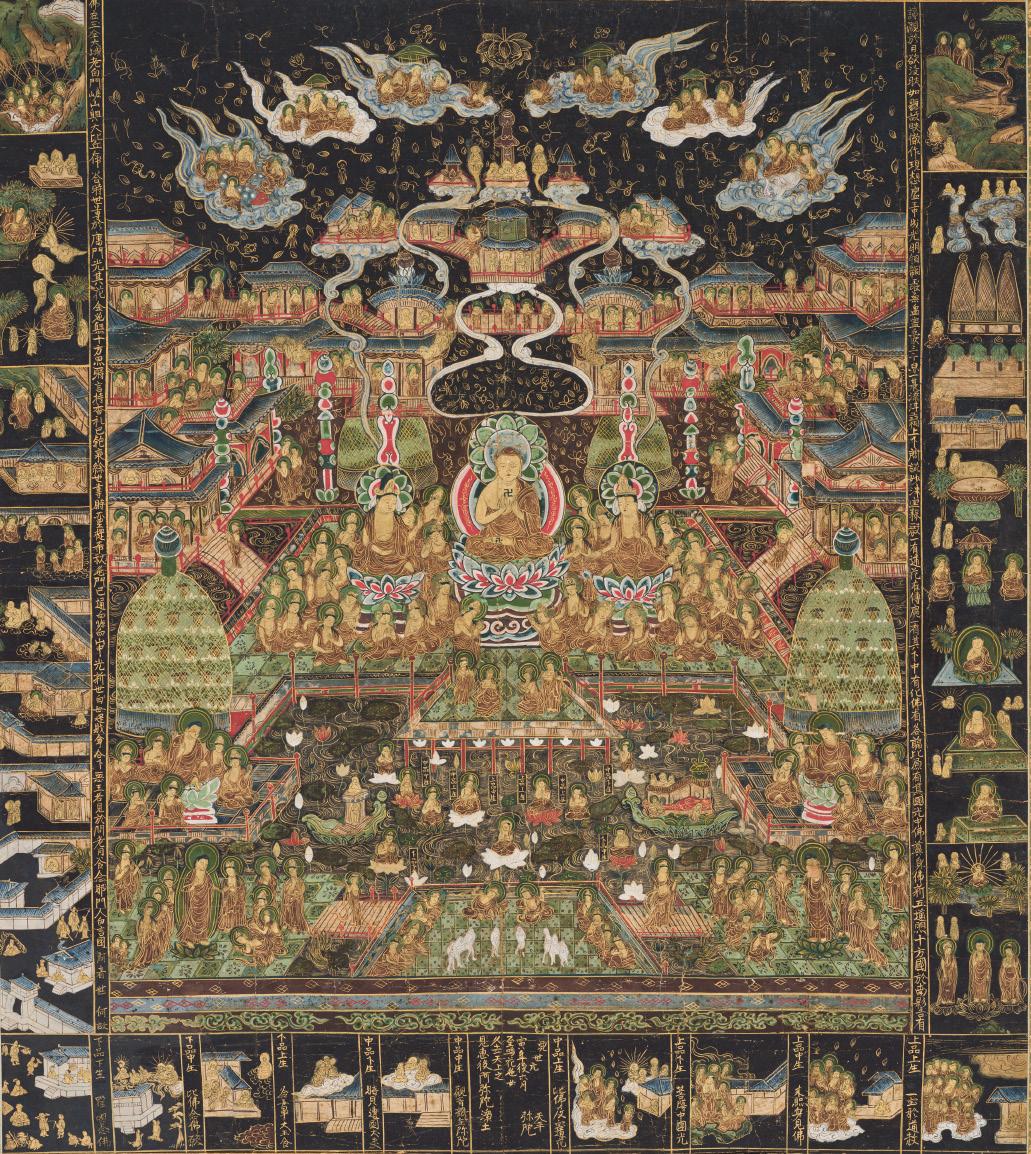
155
A BUDDHIST PAINTING DEPICTING THE TAIMA MANDARA, EDO PERIOD
Japan, 18th-19th century, Edo Period (1615-1868)
Ink, watercolors, gouache, and gold paint on paper. Set inside a frame, behind glass. Depicting the Pure Land Western Paradise in minute and animated detail: Amida Nyorai, the Buddha of the Future, seated beneath a canopy with his hands in the preaching gesture, flanked by the bodhisattvas Kannon and Seishi and attendant deities on a tiled terrace; in front of Amida, two of the newly born presented by two smaller bodhisattvas; below the terrace a lotus pond with existing dwellers in the Western Paradise together with naked figures of the newly born, some of them on two richly decorated barges; below the lotus pond a dance stage with more of the newly born; on either side of the pond a large tree beside which Amida sits preaching accompanied by other deities; behind and above the main Amida triad several other smaller Amida triads and other groups of deities in celestial buildings or floating on clouds; on the left and right, columns of rectangular cartouches, captioned in gold calligraphy, with scenes from the Kanmuryojukyo (Sutra on the Meditation on the Buddha of Infinite Life) including on the left an image of the Vulture Peak above episodes from the discovery and promulgation of the Sutra and on the right images of the 13 contemplations preached by the historical Buddha; at the base a band of nine captioned cartouches showing the nine stages of rebirth.
Image SIZE 71 x 64 cm, SIZE incl. mounting 94.5 x 77 cm
Provenance: The private collection of Joris Onzea and Suzanne Govaerts.
Condition: Good condition with wear and minor soiling. Some creasing, small folds, few tears and small losses with associated repairs and touchups. The mounting with usual traces of wear and some soiling. A small section of the glass broken.
MUSEUM COMPARISON
Compare a closely related Taima Mandara, dated to the Edo Period, size 77.8 x 71.4 cm, in the Kyoto National Museum, museum no. AO358.
AUCTION COMPARISON
Compare a related hand-colored woodblock printed copy of the Taima Mandara, by Dokutan Shoei (1628-1706), Edo period, 17th-18th century, 103.5 x 88 cm, at Bonhams, Fine Japanese and Korean Art, 17 September 2025, New York, lot 684 (sold for USD 4,864 or approx. EUR 4,200 converted at the time of writing).
Estimate EUR 2,000
Starting price EUR 1,000



156
AN IMPORTANT AND VERY LARGE CYPRESS WOOD STATUE OF A HEAVENLY GENERAL, HEIAN PERIOD, THE DATING CONFIRMED BY A C14 TEST
Japan, late 8th-10th century, first half of the Heian period (794-1185)
Of single-block (ichibokuzukuri) construction, standing in a dynamic stance, the muscular legs well-defined and with bangles carved around the ankles. The guardian deity wears a superbly detailed loincloth carved in relief, the upper body is bare showing an immensely powerful chest, rib cage, and slightly distended stomach carved with a beast mask. The face is expressively and powerfully carved with large bulging eyes, furrowed brows, and full lips pressed tightly together, while the hair is wild and flaming.
HEIGHT 164 cm (excl. mounting), 168 cm (incl. mounting)
Condition: Good condition, commensurate to age. Several age cracks, splits, losses, all as expected from a wood figure of over 1,000 years of age.
Provenance: From a private collection in France.
The conception of the sculpture, carved in one block in the ichiboku-zukuri technique, is consistent with an earlier Heian period dating; wood sculptures of the later Heian and succeeding Kamakura period were usually carved in yosegi- and warihagizukuri.
The heavenly generals (Juni Shinsho) are the protective deities of Bhaisajyaguru, the Buddha of healing and medicine in Mahayana Buddhism. The Heavenly Generals, always shown with a fierce look and wearing armor, were often the subject of large wood sculptures during the Heian and Kamakura periods. In fact, five different sets of Heavenly Generals have been designated as National Treasures in Japan. In the group of figures at the Seikado Bunko and Tokyo National Museums, the uniqueness of each one of the figures has been praised, with varied postures, hairstyles, hand-held symbols and armor shapes.

SCIENTIFIC ANALYSIS REPORT
The result of a radiocarbon dating test (C14) conducted by Re. S. Artes, C 145503A-2, dated 4 September 2024, based on one sample taken from the back of the figure, is consistent with the dating of this lot. A copy of the detailed scientific report accompanies this lot.
MUSEUM COMPARISON
Compare a related wood statue of a Heavenly King, dated 12th century, Heian period, 86 cm high, in the Metropolitan Museum of Art, accession number 1975.268.165.

Compare a closely related wood statue of a Tenbu, late Heian period, in the Katakami Shrine, Minamiicho, Sabae City. Its specific iconography is related to the very famous early Heian painting of the red Fudo preserved in the Myoo-in of the mount Koya temple in Wakayama, the main centre of Esoteric (Shingon) Buddhism in Japan.

AUCTION COMPARISON
Compare a related carved wood figure of Fudo Myo-o, Heian period, 12th century, also with an accompanying C14 test, at Sotheby’s, 1 April 2018, Hong Kong, lot 3089 (sold for HKD 1,000,000 or approx. EUR 130,000 converted and adjusted for inflation at the time of writing).
Estimate EUR 30,000
Starting price EUR 15,000

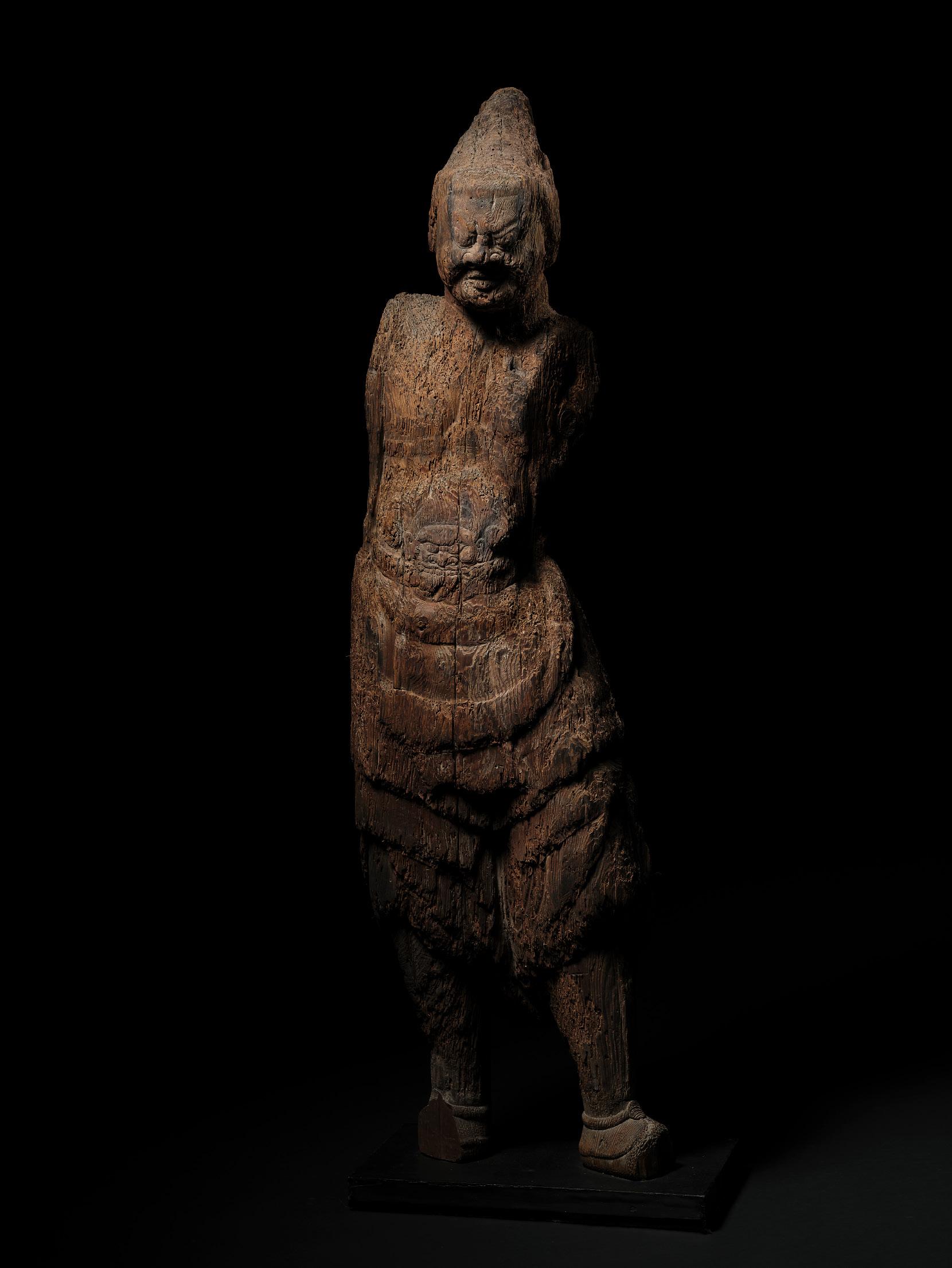
157 A RARE CARVED WOOD TORSO OF SHITENNO, THE HEAVENLY KING, HEIAN PERIOD, THE DATING CONFIRMED BY A C14 TEST
Japan, 11th-12th century, Heian period (794-1185)
SCIENTIFIC ANALYSIS REPORT
The result of a radiocarbon dating test conducted by RCD Lockinge, from a sample taken in April 2025 of the present figure, is consistent with the dating of this lot. A copy of the signed report, dated 3 June 2025, accompanies this lot.

Finely carved from a single block of wood, the figure depicted standing in a dynamic stance, dressed in armor fastened at the waist and worn over voluminous, flowing robes that cross over the chest.
With an associated wood stand.
HEIGHT 46.7 cm (figure) and 49.7 cm (total)
Provenance: From a private collection in Hungary. Condition: Good condition, commensurate with age, with ancient wear and natural age-related imperfections. Obvious losses and minor chips, mostly to the edges. Few small nicks and light surface scratches. Light flaking and remnants of old pigment and resin residue.
The present torso is identifiable as that of one of the Four Heavenly Kings, known in Japanese Buddhism as Shitenno, the guardian deities that conventionally flank the Cosmic Buddha Dainichi Nyorai, each presiding over one of the cardinal directions. Originally conceived as Hindu demigods (Lokapalas), these figures were assimilated into the Buddhist pantheon as protectors of the Dharma, the monastic precinct, and the realm. In the Chinese context, representations of the Four Heavenly Kings were generally positioned at the entrance halls of temple complexes, whereas in Japan they were more frequently arranged around the principal icon enshrined on the main altar. Characteristically rendered as martial and imposing figures, they are depicted wearing elaborate armor, wielding weapons or other ritual attributes, and adopting vigorous, animated stances rather than the composed attitudes associated with meditative deities.
AUCTION COMPARISON
Compare a related carved wood figure of Fudo Myo-o, Heian period, 11th-12th century, 70.5 cm high, at Christie’s, Japanese and Korean Art, 14 September 2011, New York, lot 677 (sold for USD 7,500 or approx. EUR 9,000 converted and adjusted for inflation at the time of writing).
Estimate EUR 4,000
Starting price EUR 2,000


A RARE CARVED CYPRESS WOOD
FIGURE OF JIZO BOSATSU, HEIAN PERIOD
Japan, 10th-11th century, Heian period (794-1185)
Finely carved, standing in samabhanga, with the left forearm gently bent forward while the right arm remains close to the body, clad in a loosely draped monastic robe that opens at the chest and cascades in voluminous folds. The rounded face conveying a serene expression, marked by heavy-lidded, downcast eyes beneath gently arched brows, centered by a byakugo (urna), a broad nose, and full lips, all framed by long, pendulous earlobes. The distinctly shaven head further reinforcing his monastic appearance.
With an associated wood stand.
HEIGHT 27.9 cm (figure) and 32.3 cm (total)
Provenance: From a private collection in Hungary. Condition: Good condition, commensurate with age, with ancient wear and natural age-related imperfections. Obvious losses and extensive flaking to pigments, minor repairs and touchups, as is to be expected.
Jizo Bosatsu is a merciful bodhisattva who moves through the Six Realms of existence in his role of saving all sentient beings. These Six Realms, from human to animal, and including Hell, comprise the levels of existence through which we are driven by the forces of karmic retribution, until such time as we achieve enlightenment. Jizo seeks out sufferers to ease their pain. Among Japan’s myriad deities, Jizo is arguably the most widely known, easily recognized and actively venerated even in modern times. He appears as a kindly young monk, with shaven head, no adornments, and dressed in the simple robe of a cleric. His exalted status as a deity is indicated by the urna on his forehead and his long earlobes. In his left hand, he usually holds a pearl-like jewel, called nyoishu (wisdom gem) and in his right a staff with multiple rings used to beat away the demons of hell.
AUCTION COMPARISON


Compare a related larger carved wood figure of a Bodhisattva, Heian period, 10th century, 119.3 cm high, at Christie’s, Japanese and Korean Art, 11 September 2012, New York, lot 47 (sold for USD 40,000 or approx. EUR 48,000 converted and adjusted for inflation at the time of writing).
Compare a related carved wood figure of Jizo Bosatsu, Heian to Kamakura period, 12th century, 50.4 cm high, at Bonhams, Fine Japanese and Korean Art, 15 March 2017, New York, lot 6154 (sold for USD 33,750 or approx. EUR 38,500 converted and adjusted for inflation at the time of writing).
Estimate EUR 4,000
Starting price EUR 2,000


159
AN EARLY CARVED CYPRESS WOOD FIGURE OF AMIDA NYORAI, HEIAN PERIOD
Japan, 10th-11th century, Heian period (794-1185)
Finely carved from a single block of cypress (hinoki) wood in ichiboku-zukuri, with traces of lacquer and gilding, standing in a classic Heian pose, with his right arm gently raised and left arm lowered in what was likely seppo-in (vitarka mudra). The figure clad in a loosely draped monastic robe that opens at the chest and cascades in voluminous folds over the abdomen, forming vertical pleats. The rounded face conveying a serene expression, distinguished by heavy-lidded, downcast eyes beneath gently arched brows, centered by a byakugo (urna), a broad nose, and full lips, all framed by long, pendulous earlobes. The hair carefully arranged in tight rounded forms over the high nikkei (ushnisha).
HEIGHT 37.7 cm (figure) and 42.8 cm (total)
Provenance: The private collection of Michael Phillips, acquired in 2015. Michael Phillips (born 1943) is an Academy Awardwinning film producer.
Condition:

Michael Phillips and Queen Elizabeth II
Good condition, commensurate with age, with ancient wear and natural age-related imperfections. Obvious losses and signs of wood decay, mostly to lower back area. Extensive flaking to gilding and pigments, old fills and touchups, with residual traces of wax, all as expected from an ancient wood statue more than a thousand years old.
AUCTION COMPARISON
Compare a related carved wood figure of standing Amida Buddha, Heian period, 12th century, 64.5 cm high, at Christie’s, Japanese and Korean Art, 21 September 2006, New York, lot 224 (sold for USD 8,400 or approx. EUR 11,500 converted and adjusted for inflation at the time of writing).
Estimate EUR 6,000
Starting price EUR 3,000
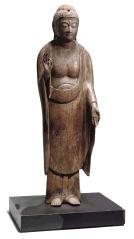
Japan, 10th-11th century, Heian period (794-1185) [figure] and Edo period (1615-1868) [stand]
The figure finely carved from a single block (ichiboku) of kaya wood (Japanese nutmeg yew), seated in kekka fuza (dhyanasana) with the hands lowered in mida jo-in (dhyana mudra), clad in a loosely draped monastic robe opening at the chest and cascading in voluminous folds. The rounded face conveying a meditative expression distinguished by downcast eyes beneath gently arched brows, centered by a prominent byakugo (urna), a broad nose, and full lips, flanked by long, pendulous earlobes. The hair arranged in tight rounded forms, surmounted by a nikkeishu (jewel of wisdom).
The stand neatly carved and lacquered in black and gold, shaped as a lotus dais supported on an elaborate circular plinth adorned with brocade patterns and floral-scroll panels. It rises to a reticulated kohai (aureole), intricately carved with swirling clouds and three smaller seated figures depicting attendants of Amida.
HEIGHT 17.8 cm (figure) and 47.3 cm (total)
Provenance: From a noted private collection in Hungary. Condition: The figure with obvious signs of restoration to the pleated folds beside the legs; otherwise, very good condition, commensurate with age, with ancient wear and remnants of red ritual pigments. The stand in good condition with expected wear. Few age cracks, mostly to the aureole, with associated flaking, and small fractures to the lotus dais. Extensive rubbing to gilding, as is to be expected. The image presenting overall notably well.
This figure might be compared with notable examples of the Tempyo era, such as the standing Yakushi Nyorai (164.8cm high) in the Kofukujin temple (registered as a National Treasure), and the standing Yakushi figure (169.7cm high) in the Jingoji temple, Kyoto, or the seated Miroku Bosatsu in the Todaiji Nara (39 cm high) (registered as an Important Cultural Property).
AUCTION COMPARISON
Compare a related much larger wood figure of seated Amida Nyorai, Heian period, 10th century, 78 cm high, at Christie’s, Aesthetic Intuition: Collecting Japanese Art in Post-War London, 11 November 2015, London, lot 68 (sold for GBP 218,500 or approx. EUR 396,500 converted and adjusted for inflation at the time of writing). Compare a related much larger wood figure of seated Amida Nyorai, late Heian period, 12th century, 55.2 cm high, at Christie’s, An Inquiring Mind: American Collecting of Japanese and Korean Art, 25 April 2017, New York, lot 9 (sold for USD 211,500 or approx. EUR 241,000 converted and adjusted for inflation at the time of writing).
Estimate EUR 4,000
Starting price EUR 2,000




Japan, 13th century, Kamakura period (1185-1333)
Carved and assembled from cypress wood in yosegizukuri technique and modeled as the Amitabha Buddha standing, his right arm raised and the left slightly lowered, wearing a monastic robe opening at the chest and cascading in voluminous folds, decorated in gilt with brocade patterns, much of the original decoration to the robes still preserved in various places. His face with a serene expression, downcast eyes painted and inlaid in behind crystal, circular byakugo (urna), and the hair arranged in small spiral curls (rahotsu) covering the ushnisha centered to the front by a crystal inlay.
HEIGHT 39.5 cm (excl. stand), 46.2 cm (incl. stand)
With a modern presentation stand.
Provenance: From an old Canadian private collection in Montreal. Remnants of an old paper label to the back.
Condition: Good condition, commensurate with age. Extensive wear to the gilt decoration, expected minor age cracks, tiny chips, few losses, flaking. Restorations to the hands, feet, and part of the robe reattached with remnants of adhesive, all as is to be expected from this type of figure. Some insect activity throughout and the crystal byakugo lost.
The present sculpture represents Amitabha, known in Japanese as Amida Nyorai, Buddha of Infinite Light. The Pure Land (Jodo) tradition in Japan emphasizes the salvific powers of Amida; incantation of the Buddha’s name can invite divine intercession and devotion in life can insure rebirth in Amida’s Western Paradise. By the early eleventh century, it was increasingly believed that only the compassion of Amida could override the cycle of rise, decline and fall – the concept of mappo, meaning the end of the Law that would devolve into ten millennia of moral degradation and strife. By Japanese calculation, this would coincide with the year 1052. Devotees among the upper classes commissioned sculptures and paintings showing the arrival of Amida and attendants to welcome the spirits of the dying. Given its scale, it is likely that the figure here graced a private altar.
The figure exudes an elegant serenity characteristic of the sculptural treatments of the 13th century. Amida’s divinity is emphasized by gentle idealization. The figure is slender and delicate with robes carved in rhythmic folds.
Compare a closely related wood sculpture of Amida, dated to the Kamakura period, 13th century, 34 cm tall, at Christie’s, Japanese and Korean Art, 21 March 2023, New York, lot 5 (sold for USD 30,240).
Estimate EUR 6,000
Starting price EUR 3,000



162
A SUPERB AND VERY RARE CARVED WOOD FIGURE OF FUGEN BOSATSU ON ELEPHANT, KAMAKURA PERIOD, THE DATING CONFIRMED BY A C14 TEST
Japan, late 13th to early 14th century, Kamakura period (1185-1333)
Of yosegi (jointed) construction and exquisitely carved, the Bodhisattva depicted seated in kekka fuza (dhyanasana) atop a lotus dais, which rests upon a small octagonal stand positioned on the back of an elephant standing foursquare, delicately adorned with garlands draped over its textured hide and with its trunk gracefully curved above its gaping mouth. Fugen shown with hands joined in gassho (anjali mudra), clad in a loosely draped monastic robe that opens at the chest and falls in voluminous folds. His rounded face conveying a serene expression, characterized by heavy-lidded, downcast eyes beneath gently arched brows, centered by a prominent byakugo (urna), a slender nose, and full lips, all framed by long, pendulous earlobes, while the hair carefully arranged and secured beneath distinctive headgear.
HEIGHT 42.3 cm (total)
Provenance: From a private collection in Hungary. Condition: Good overall condition consistent with age, showing natural wear, some old repairs, and surface touchups. Natural age cracks, chips, and obvious losses. The wood retains a rich, naturally developed patina.
Fugen Bosatsu (in Sanskrit, Samantabhadra) is the Bodhisattva of Universal Virtue, one of the principal figures in the Mahayana Buddhist pantheon. Within Mahayana doctrine, Fugen is traditionally paired with Monju Bosatsu (Manjushri), the Bodhisattva of Wisdom, both of whom act as attendants to Shaka Nyorai (Buddha Shakyamuni). Their triadic configuration is first articulated in the Avatamsaka Sutra, translated into Chinese during the fifth century and subsequently disseminated throughout other regions of East Asia. In this paradigm, Monju, positioned at the left of the Buddha, personifies wisdom, while Fugen, on the right, embodies practice and meditative discipline.
The cult of Fugen appears to have been transmitted to Japan between the eighth and ninth centuries and attained particular prominence within the Buddhist pantheon during the latter half of the Heian period. As in the case of Kannon Bosatsu (Avalokiteshvara), representations of Fugen underwent a progressive transformation in terms of gender. Early images emphasize a markedly masculine physiognomy, whereas from the Muromachi period onward, depictions adopt increasingly feminized characteristics. The present figure retains predominantly masculine features, yet the delicately articulated modeling and androgynous facial expression suggest production in the transitional phase between the late Kamakura and early Muromachi periods.
SCIENTIFIC ANALYSIS REPORT
The result of a radiocarbon dating test conducted by RCD Lockinge, from a sample taken in April 2025 of the present figure, is consistent with the dating of this lot. A copy of the signed report, dated 3 June 2025, accompanies this lot.


Hanging scroll depicting the Bodhisattva Fugen mounted on an elephant, designated a National Treasure of Japan, Heian period, 12th century, in the Tokyo National Museum, collection reference number A-1
Fugen is most frequently depicted astride a white sixtusked elephant, an iconographic motif derived directly from the extensive influence of the Lotus Sutra within the Japanese Buddhist tradition. He is conventionally shown with his hands clasped together in prayer, as in the present example, although alternative representations portray him holding a lotus blossom, signifying his intimate association with and patronage of this seminal scripture.
MUSEUM COMPARISON


Compare a related much larger gilt-lacquered wood figure of Fugen Bosatsu on elephant, Kamakura period, 14th century, 251.2 cm high, in the Virginia Museum of Fine Arts. Compare a related gilt-lacquered wood figure of Fugen Bosatsu on elephant, in the Musée Guimet.
Estimate EUR 10,000
Starting price EUR 5,000


A LARGE AND EARLY POLYCHROME-LACQUERED WOOD FIGURE OF A PRIEST, KAMAKURA PERIOD, THE DATING CONFIRMED BY A C14 TEST
Japan, 13th-14th century, Kamakura period (1185-1333)
SCIENTIFIC ANALYSIS REPORT
The result of a radiocarbon dating test conducted by Dr. Mikhail G. Buzynnyi, from a sample taken in February 2009 of the present figure, is consistent with the dating of this lot. A copy of the signed report, dated 25 February 2009, accompanies this lot.
Dr. Mikhail Georgievich Buzynnyi (b. 1959) is a Doctor of Biological Sciences specializing in hygiene, radiation, and public health. Since 2003, he has headed the Radiation Monitoring Laboratory at the O. M. Marzieiev Institute for Public Health and is a member of the National Academy of Medical Sciences of Ukraine. Over the course of more than thirty years, he has led numerous research initiatives and extensively published on environmental radiological monitoring.

Finely carved, depicted seated at ease on a rectangular stand, with separately carved hands resting on his lap, elegantly attired in a loosely draped robe, delicately adorned with painted floral motifs, its pleated folds gathering naturally around the legs. His face conveying a hieratic expression, distinguished by almond-shaped, rock-crystal eyes, an aquiline nose, and full lips, all framed by prominent ears and a bold, well-defined head.
HEIGHT 59.5 cm (figure) and 65.3 cm (total)
Provenance: From a private collection in the Netherlands. Condition: Good condition, commensurate with age, with expected wear. Few age cracks and small losses to the fingers of the left hand. Typical rubbing to lacquer with subsequent touchups and areas of later re-lacquering. Few minor nicks and light surface scratches. An attribute held in the right hand likely lost. Overall, the figure still presenting remarkably well.
In addition to representations of Buddhist deities, sculptures of Buddhist founding figures and priests were also created, serving as tributes to their devoted service and exemplary conduct. These wooden sculptures not only honor the spiritual and administrative roles of these individuals within the monastic community but also functioned as models of moral and religious virtue for both monks and lay practitioners. Through their careful craftsmanship and dignified presence, such works conveyed the ideals of discipline, wisdom, and compassion central to Buddhist practice, reinforcing the ethical and spiritual standards that guided daily life in Japanese Buddhist temples.
MUSEUM COMPARISON
Compare a closely related figure of Shinbutsu dated to the 13th century, Kamakura period, 74.6 cm tall, designated an Important Cultural Property of Japan, in the Goeido of the Honji-Senjuji Temple, Tsu city, Mie prefecture, placed on the right side of the altar.
Estimate EUR 15,000
Starting price EUR 7,500


A GILT-LACQUERED WOOD
FIGURE OF AMIDA NYORAI, KAMAKURA PERIOD
Japan, 13th-14th century, Kamakura period (1185-1333)
Of yosegi (jointed) construction, delicately carved and finely lacquered in black and gold, the figure standing in samabhanga upon a separately carved lotus pedestal, itself supported by a recumbent shishi on an elaborate, tiered octagonal plinth adorned with openwork floral-scroll panels and beaded rims. His right hand raised in seppo-in (vitarka mudra) and his left lowered in yogan-in (varada mudra). He is clad in a loosely draped monastic robe opening at the chest and cascading in voluminous folds. The rounded face, serene in expression, distinguished by downcast eyes beneath gently arched brows, centered by a prominent crystal-inlaid byakugo (urna), a slender nose, and full lips, all flanked by pierced, pendulous earlobes. The hair arranged in tight curls surmounted by a nikkeishu (jewel of wisdom) and backed by a reticulated kohai (halo).
HEIGHT 36.3 cm (figure) and 69.4 cm (total)
Condition: Good condition, consistent with age, with old wear. Small losses to exposed areas and evidence of breakage to the halo, with associated touchups and repairs. Flaking and light rubbing to gilding and pigments, as is to be expected. Overall, the figure presenting notably well.
This iconographic representation of Amida corresponds to Buddha Amitabha, a central figure in Japanese Buddhism. Worship of Amida was established in Japan during the Nara period (710–794) and became one of the principal practices taught in the Tendai school during the Heian period (794–1185). Amida is revered as the one who welcomes the faithful into the celestial realm. Despite human imperfections, those who embrace Buddhist doctrine and invoke the name of Amida at the moment of death are believed to be reborn in the Pure Land Paradise. The boat-shaped halo behind the figure symbolizes the guidance offered to devotees across the ‘ocean of suffering’.
AUCTION COMPARISON
Compare a closely related gilt-lacquered wood figure of Amida Nyorai, Kamakura period, 13th-14th century, 50 cm high overall, at Zacke, Fine Japanese Art, 6 December 2024, Vienna, lot 153 (sold for EUR 5,200).
Estimate EUR 4,000
Starting price EUR 2,000
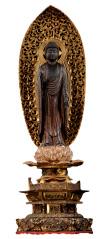
Japan, 13th-14th century, Kamakura period (1185-1333)
Carved and assembled from cypress wood in the yosegi-zukuri technique and modeled as the Amida Buddha standing, hands held in the raigo-in mudra, the gesture of welcoming souls to the Western Paradise. The figure is draped in a monastic robe opening at the chest and cascading in voluminous folds. His face with a serene expression, downcast eyes inlaid in glass, rock crystal byakugo (urna), the hair arranged in small curls (rahotsu) rising into the ushnisha with a further crystal inlay. He is standing on a gilded and tiered stand surmounted by a lotus dais.
HEIGHT 26.5 cm (figure) and 36 cm (total)
Condition: Very good condition, commensurate with age. The lacquer with some flaking, exposing the gilding underneath, the right hand and left foot reattached, few small nicks, and a small touchup to the lacquer at the left sleeve and base.
The present sculpture represents Amitabha, known in Japanese as Amida Nyorai, Buddha of Infinite Light. The Pure Land (Jodo) tradition in Japan emphasizes the salvific powers of Amida; incantation of the Buddha’s name can invite divine intercession and devotion in life can insure rebirth in Amida’s Western Paradise. By the early eleventh century, it was increasingly believed that only the compassion of Amida could override the cycle of rise, decline and fall –the concept of mappo, meaning the end of the Law that would devolve into ten millennia of moral degradation and strife. By Japanese calculation, this would coincide with the year 1052. Devotees among the upper classes commissioned sculptures and paintings showing the arrival of Amida and attendants to welcome the spirits of the dying. Given its scale, it is likely that the figure here graced a private altar.
AUCTION COMPARISON
Compare a related wood figure of Amitabha, 13th century, 37.1 cm tall, at Christie’s, Japanese and Korean Art, 19 March 2019, New York, lot 288 (sold for USD 50,000 or approx. EUR 57,000 converted and adjusted for inflation at the time of writing).
Estimate EUR 4,000
Starting price EUR 2,000



166 A GILT-LACQUERED WOOD FIGURE OF AMIDA NYORAI, NANBOKUCHO PERIOD, THE DATING CONFIRMED BY A C14 TEST
Japan, 14th century, Nanbokucho period (1336-1392)
Of yosegi (jointed) construction, delicately carved and finely lacquered in black and gold, the figure standing in samabhanga upon a separately carved lotus pedestal, itself supported on an elaborate, tiered octagonal plinth adorned with brocade patterns and floral-scroll panels. His right hand raised in seppo-in (vitarka mudra) and his left lowered in yogan-in (varada mudra). He is clad in a loosely draped monastic robe opening at the chest and cascading in voluminous folds. The rounded face, serene in expression, distinguished by downcast eyes beneath gently arched brows, centered by a prominent crystal-inlaid byakugo (urna), a broad nose, and full lips, all flanked by pierced, pendulous earlobes. The hair arranged in tight curls surmounted by a nikkeishu (jewel of wisdom) and backed by a reticulated kohai (halo) densely carved with swirling clouds.
HEIGHT 36.3 cm (figure) and 69.5 cm (total)
Provenance: From a noted private collection in Hungary. Condition: Good condition, consistent with age, with old wear. Few age cracks to the aureole and small losses to the lotus dais and plinth. Flaking and light rubbing to gilding and pigments, as is to be expected. Overall, the figure presenting exceptionally well.
Within the Pure Land (Jodo) tradition in Japan, doctrinal emphasis rests on the salvific efficacy of Amida Nyorai (Buddha Amitabha). Recitation of his name (nembutsu) functioned as a ritual conduit for divine intercession, while sustained devotional practice ensured rebirth in the Western Paradise associated with Amida. By the early eleventh century, prevailing beliefs held that only the boundless compassion of Amida could overcome the cyclical deterioration of the dharma, conceptualized as ‘mappo’ (or the Latter Day of the Law) and projected as ten millennia of moral and social decline. Elite patrons commonly commissioned sculptural
SCIENTIFIC ANALYSIS REPORT
The result of a radiocarbon dating test conducted by RCD Lockinge, from a sample taken in June 2025 of the present figure, is consistent with the dating of this lot. A copy of the signed report, dated 30 June 2025, accompanies this lot.

and pictorial representations of the descent of Amida, accompanied by attendant figures to receive the spirits of the dying. Considering scale and execution, the present figure was likely intended for a private devotional altar.
Compare a closely related giltlacquered wood figure of Amida Nyorai, Kamakura period, dated 1259, 130 cm high overall, in the Tokyo National Museum, accession number C-508.
Estimate EUR 10,000 Starting price EUR 5,000
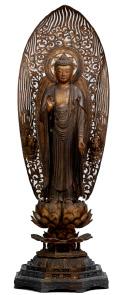

167
THREE GILT BRONZE BUDDHIST RITUAL OBJECTS: KATSUMA, RINPO, AND KONGO, KAMAKURA PERIOD
Japan, 13th century, Kamakura period (1185-1333)
Each of classic and typical form, finely cast, neatly engraved with lotus decorations, and skillfully gilded.
SIZE 11.1 cm (katsuma), 11.8 cm (rinpo) and 12.3 cm (kongo)
WEIGHT 590.2 g (total)
Provenance: From a private collection in France.
Condition: Each in very good condition with expected wear and casting irregularities. Light rubbing to gilding. Few minuscule nicks and light surface scratches.
The Katsuma, sometimes referred to as a cross-shaped vajra, is thought to have originated from a projectile weapon used in ancient India. This object would have been placed at the four corners of a mandala during Buddhist ceremony.
The Rinpo is a ritual object connected with Esoteric Buddhism, symbolizing the Wheel of the Law (dharmachakra). In Buddhist texts and rituals, the phrase ‘turning the wheel of the law’ refers to the act of teaching by the Buddha Shakyamuni. Each of the eight spokes and corners represents one of the moral admonitions of the Noble Eightfold Path, and the central section depicts a lotus flower with eight petals.
The Kongo is a legendary ritual tool, symbolizing the qualities of a diamond, indestructibility, and a thunderbolt, irresistible force, and is often described as a ‘ritual weapon’. It is typically used in conjunction with a ritual bell (sho), together forming essential instruments in the esoteric practices of the Shingon and certain Tendai schools and embodying the union of method and wisdom.
MUSEUM COMPARISON

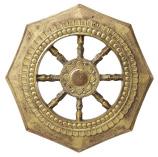
Compare a closely related gilt bronze katsuma, Kamakura period, 13th century, 11.9 cm long, in the Nara National Museum, accession number 671-0. Compare a related gilt bronze rinpo, late 13th century, in the Metropolitan Museum of Art, accession number 2015.300.296.
Estimate EUR 4,000
Starting price EUR 2,000
168
TWO GILT BRONZE BUDDHIST RITUAL OBJECTS: KATSUMA AND RINPO, KAMAKURA PERIOD
Japan, 13th century, Kamakura period (1185-1333)
Each of typical form, finely cast, meticulously engraved with lotus decorations, and skillfully gilded.
DIAMETER 14.6 cm (katsuma) and 13.2 cm (rinpo)
WEIGHT 858.9 g (total)
Provenance: From a private collection in France. Condition: Each in very good condition with expected wear and casting irregularities. Light rubbing to gilding. Few minuscule nicks and light surface scratches.
AUCTION COMPARISON
Compare a closely related gilt-bronze katsuma and rinpo with lotus trays, dated 13th century, Kamakura period, at Zacke, Fine Japanese Art, 1 December 2023, Vienna, lot 32 (sold for EUR 14,300).
Estimate EUR 3,000
Starting price EUR 1,500

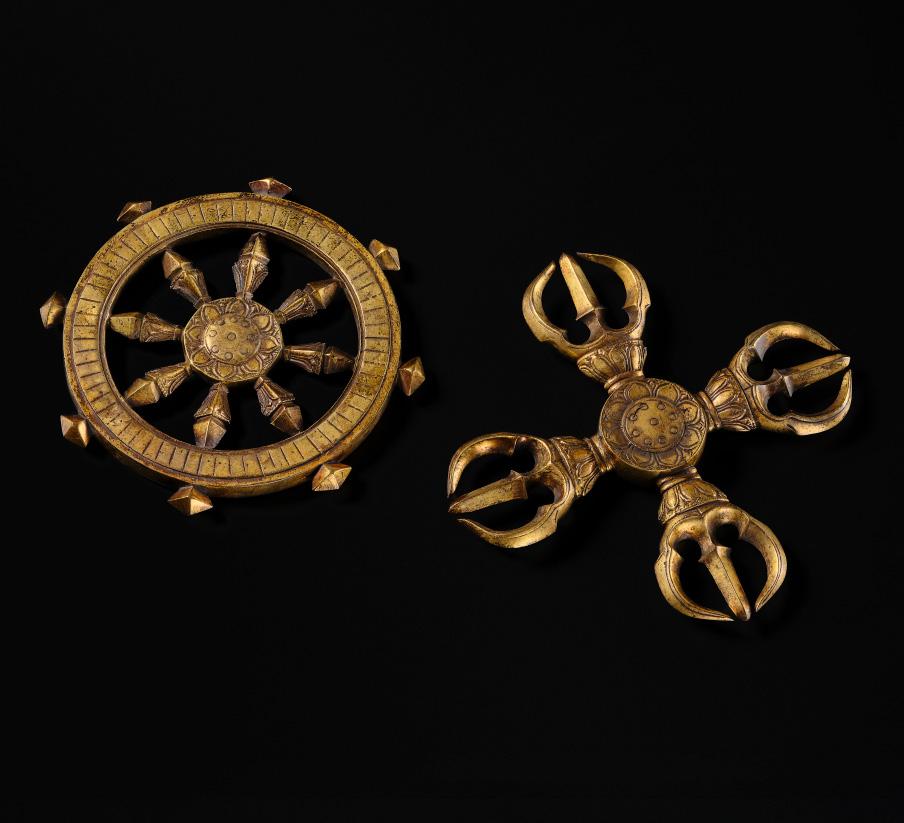

169
A BRONZE AND COPPER ‘LOTUS’ EKORO (LONG-HANDLED CENSER), NANBOKUCHO PERIOD
Japan, 14th century, Nanbokucho period (1336-1392)
Exquisitely modeled as a lotus-form brazier with finely chased petals supported on a leaf-form foot, the cover cast in openwork with leaf veins surmounted by a central knob, borne on the long handle decorated with leafy vines and a butterfly and floral bracket, all richly detailed with skillful incision work.
LENGTH 28 cm
WEIGHT 203 g
Condition: Very good condition with minor wear and casting irregularities. Few small dents, tiny scratches, the hinge with a small loss, and traces of wear and use.
AUCTION COMPARISON
Compare a closely related longhandled gilt bronze censer (ekoro), 14th century, Nanbokucho period, 39 cm long, at Christie’s, Japanese and Korean Art, 18 September 2007, New York, lot 139 (sold for USD 5,625 or approx. EUR 7,500 converted and adjusted for inflation at the time of writing).
Estimate EUR 2,000
Starting price EUR 1,000

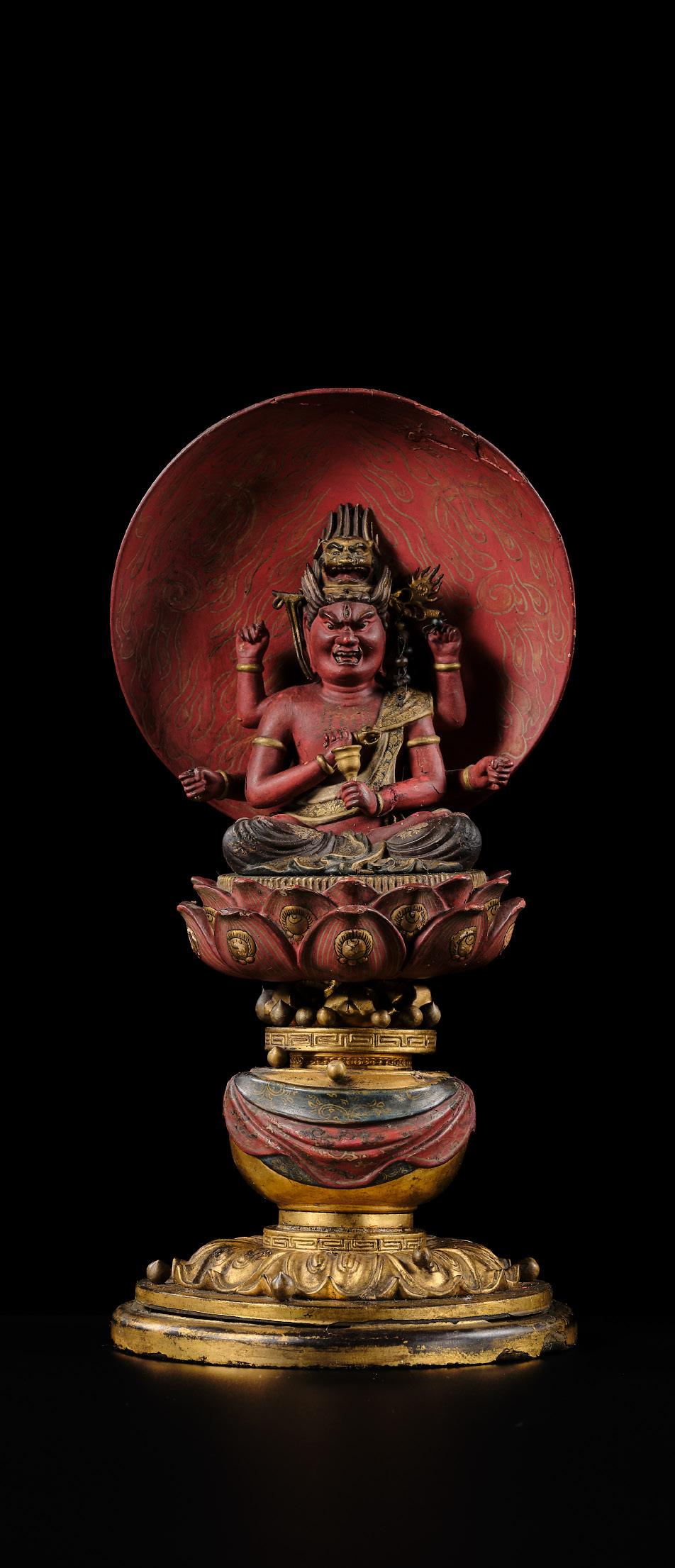
170
A FINELY CARVED GILT AND POLYCHROME WOOD FIGURE OF AIZEN MYO-O, MUROMACHI PERIOD
Japan, 15th-16th century, Muromachi period (1333-1573)
Meticulously carved and painted with neatly applied gilt and polychrome decoration, the red-skinned wrathful deity seated in dhyanasana atop a lotus throne with minutely carved petals, highlighted in gold and black hiramaki-e to depict the Three Jewels (sambo). The throne resting on an elaborate tiered base with further petals and neatly articulated mid-section draped with a pleated mantle. The deity clad in flowing brocade robes and richly bejeweled, with his six arms holding ritual attributes, including a kongosho (vajra) and a ritual bell (hogu no suzu). His face with a fierce expression distinguished by almond-shaped eyes, a broad nose, and a gaping mouth revealing sharp fangs, surmounted by a flaming coiffure topped by a shishi head and backed by a flaming kohai (halo).
HEIGHT 21.7 cm (total)
Provenance: From a private collection in the United Kingdom. With an old auction label affixed to the base, inscribed ‘479. Old wood carved figure, Aizen Myo-o, the God of Power, from Nara temple, date about 1600’. Condition: Good condition, commensurate with age, with old wear. Minor breaks to halo and throne with associated touchups and repairs. Rubbing to gilding and flaking to pigments with subsequent touchups. Some attributes possibly lost, with the openings in the hands filled. Overall presenting very well.
MUSEUM COMPARISON
Compare a related wood figure of Aizen Myo-o, Muromachi period, 13th14th century, 73 cm high, in the British Museum, registration number 1885,1227.27.
AUCTION COMPARISON
Compare a closely related, yet larger (44.5 cm total), wood figure of Aizen Myo-o, dated to the Muromachi period (14th-15th century), at Zacke, Fine Japanese Art, 6 December 2024, Vienna, lot 157 (sold for EUR 23,400).
Estimate EUR 4,000
Starting price EUR 2,000



A GILT AND POLYCHROME CARVED WOOD FIGURE OF SAMBO KOJIN, MUROMACHI PERIOD
Japan, 14th-15th century, Muromachi period (1333-1573)
Finely carved and painted with gilt and polychrome decoration, the red-skinned deity standing in samabhanga atop a craggy pedestal, its six arms radiating outward while holding distinctive attributes, including a kongosho (vajra) and a kaenbo (flaming staff). Draped in flowing brocade robes that fall from the shoulders and leave the chest exposed, the figure further adorned with its original openwork metal necklace and headdress. The three faces, with their wrathful expressions, distinguished by almond-shaped eyes beneath furrowed brows, broad noses, and open mouths revealing sharp fangs, all framed by a flaming coiffure and set against a flaming kohai (halo) with a central pierced flowerhead.
HEIGHT 58.8 cm (figure) and 76.5 cm (total)
Condition: Good condition, commensurate with age, with expected wear. Few age cracks with associated touchups and repairs to exposed areas, mostly to the arms and halo. Some attributes possibly lost, with the openings in the hands filled. Rubbing to gilding and pigments with associated flaking and minor repainting. Overall, the image presenting remarkably well.
Sambo Kojin is a syncretic deity associated with the hearth fire and the protection of land, cattle, and horses. He is represented often in three principal iconographic types, the most prevalent characterized by a wrathful visage with three heads, symbolizing the Buddhas of the past, present, and future, as well as the original Buddhas Manjusri, Shakyamuni, and Fudo, and six or eight arms. The origins of this deity may predate the formal introduction of Buddhism to Japan, as he appears in a single apocryphal sutra but not in canonical Buddhist texts. His ferocious iconography corresponds to the typology of the Myo-o, and he is sometimes interpreted as a manifestation of Fudo Myo-o, who is similarly depicted amidst flames and tasked with punishing transgressions.
AUCTION COMPARISON
Compare a related wood figure of Gundari Myo-o (kundali), Edo period, 18th century, 115.6 cm high, at Christie’s, Japanese and Korean Art, 18 September 2008, New York, lot 95 (sold for USD 10,000 or approx. EUR 12,500 converted and adjusted at the time of writing).
Estimate EUR 6,000
Starting price EUR 3,000


172
A RARE BRONZE VOTIVE PLAQUE (KAKEBOTOKE)
DEPICTING FUDO MYO-O, MUROMACHI PERIOD
Japan, 15th-16th century, Muromachi period (1333-1573)
Of circular form and cast in multiple sections, the central figure standing on a jagged rock base in a commanding pose, flanked by two vases. His left hand raised beside the chest, while the right rests on the hip, likely once holding a sword. He is clad in a loosely draped robe falling from the left shoulder, leaving the chest exposed. His face bearing a wrathful expression, marked by bulging eyes, a broad nose, and sharp fangs. The figure encircled by two concentric rings adorned with evenly spaced domed rivets, with a pair of temple lion (shishi) heads at the top serving as suspension fittings. The reverse further fitted with iron pins, indicating that it could also be mounted flush against a surface.
DIAMETER 31.5 cm, LENGTH (with mountings) 37.9 cm
WEIGHT 2,481 g
Condition: Good condition, commensurate with age, with wear and casting irregularities. Few minor fissures and small losses. Mild warping. Light surface scratches and minute nibbles to edges. The bronze surface exhibiting a rich, naturally grown patina.
Kakebotoke, literally ‘hanging Buddhas’, were typically produced from circular bronze or copper sheets, bearing the image of the sacred body of Kami (Shinto deities). They originated from the practice of Shinbutsu-shugo, the syncretism of Kami and Buddhas, established in the Heian period. As one of the few forms of
Buddhist art unique to Japan, kakebotoke can be found both into Shinto shrines and Buddhist temples, where they were offered to protect the sacred precinct and ensure the prosperity of the Buddhist faith. Within a Buddhist context, they were suspended from the eaves above the main entrance to an image hall or above the frieze rail separating the outer and inner sanctums, positioned to honor the deity charged with safeguarding the temple compound.
AUCTION
COMPARISON

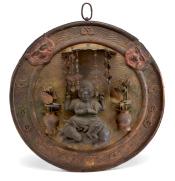
Compare a related larger bronze hanging votive plaque (kakebotoke), Kamakura period, 13th century, 59 cm diameter, at Christie’s, Japanese and Korean Art, 20 March 2007, New York, lot 117 (sold for USD 18,000 or approx. EUR 24,500 converted and adjusted for inflation at the time of writing). Compare a related bronze hanging votive plaque (kakebotoke) with Daitoku Myo-o, Kamakura to Nanbokucho period, 14th century, 33 cm diameter, at Bonhams, Fine Japanese Works of Art, 16 March 2016, New York, lot 3022 (sold for USD 10,000 or approx. EUR 12,000 converted and adjusted for inflation at the time of writing).
Estimate EUR 4,000
Starting price EUR 2,000

173 AN EXCEEDINGLY RARE CHRISTIAN VOTIVE ICON (FUMI-E) DEPICTING THE VIRGIN MARY IN PRAYER, EARLY EDO PERIOD
Japan, 17th century, Edo period (1615-1868)
Rectangular in form, the ceramic relief well-modeled to depict the Virgin Mary standing in prayer, dressed in a loose-fitting mantle with gracefully pleated folds, and encompassed by a radiant oval mandorla. The composition surrounded by four highly stylized putto heads, one positioned at each corner of the tile.
Mounted in an associated wood frame, probably oak, with an iron ring for suspension. The frame dates to the 19th century or earlier.
SIZE 9.6 x 6.9 cm (image) and 24.8 x 19.2 cm (total)
Condition: Good condition with wear and expected firing-inherent irregularities. Small losses and minute old repairs, consistent with age. Signs of abrasion, with associated flaking to pigments and remnants of ancient gilding.
Christianity was introduced to Japan in the context of early European contact in the mid-16th century, as merchants and missionaries endeavored to extend both commercial and religious networks. This foreign faith, alien to indigenous Japanese traditions, aroused a complex response of curiosity and apprehension among local authorities. Jesuit missionaries accompanied Portuguese traders first in 1549, actively disseminating Christian doctrine, particularly in Kyushu, where a notable number of local daimyo embraced conversion. The 1638 uprising of Christian converts persuaded the Tokugawa government of the potential peril posed by European colonial intervention. Consequently, in 1639, the Portuguese were expelled, and in the following year, all sixty members of a Portuguese delegation dispatched to petition for the resumption of trade were executed. The shogunate instituted a policy of national seclusion, restricting foreign access to a select
cohort of Chinese merchants, a limited number of Dutch traders, and occasional Korean envoys. By 1650, Christian imagery was proscribed, and missionary activity was rendered a capital offense.
Devotion to the Virgin Mary constituted a pivotal factor in the reception of Christianity in Japan. Her image elicited a profound, even enigmatic resonance among Buddhists, who perceived in her a subtle spiritual affinity. Amidst periods of state persecution, the fidelity of Japanese Christians to the Virgin remained unwavering. Missionaries had introduced paintings and statuettes of the Virgin Mary to Japan. However, owing to the arduous nature of the journey and the constraints of transport, these objects were predominantly diminutive. Among them were the fumi-e, medallions upon which suspected Christians were compelled to tread, as a ritualized test of apostasy.
MUSEUM COMPARISON
Compare a closely related bronze votive image depicting the Virgin Mary in prayer (fumi-e), Edo period, late 16th to early 17th century, 10.5 x 7.4 cm, in the Tokyo National Museum, accession number C-711.
AUCTION COMPARISON
Compare a closely related bronze votive image (fumi-e) depicting the Virgin Mary, Edo period, 18th century, 11.5 x 7 cm (image), at Christie’s, Japanese and Korean Art, 24 March 2010, New York, lot 599 (sold for USD 10,000 or approx. EUR 13,000 converted and adjusted for inflation at the time of writing).
Estimate EUR 5,000 Starting price EUR 2,400


174
AN IMPRESSIVE LARGE GILT AND LACQUERED WOOD FIGURE OF NYOIRIN KANNON, THE BODHISATTVA OF WISH-FULFILLING COMPASSION, LATE KAMAKURA TO EARLY MUROMACHI PERIOD
Japan, 14th-15th century, late Kamakura period (1185-1333) to early Muromachi period (1333-1573)
Finely carved and almost entirely covered in black lacquer with traces of gilt decoration, the deity seated in royal ease atop a lotus pedestal, with one knee raised and the soles of the feet together. The torso inclines gently and the head tilts in contemplation, the principal right arm resting on the raised knee to support the cheek and the left arm drawn back in repose; along the flanks and shoulders are old breaks and filled mortises indicating the former presence of two additional arms. The flowing robes are deeply pleated, opening to reveal the bare torso and traces of jewelry. The serene face is distinguished by heavy-lidded, downcast eyes beneath softly arched brows, centered by a rock crystal byakugo (urna), a slender nose, and full lips set in a calm smile, framed by long pendulous earlobes. The hair is meticulously arranged beneath a gilt band and rises into a high nikkei (ushnisha).
HEIGHT 51.2 cm (figure) and 66.7 cm (total)
Provenance: From an old French private collection. Condition: Good overall condition, consistent with age. Surface wear, losses, and restorations throughout, including to areas of drapery and the extremities. Minor age cracks, small areas of breakage with corresponding infill and retouching. Traces of overpainting and re-lacquering visible in several areas, likely the result of historical conservation. The filigree metal crown is lost. Typical flaking and rubbing to the gilding. The figure remains visually powerful and well preserved for its age.
The distinctive seated posture identifies the figure as Nyoirin Kannon, the wish-fulfilling manifestation of the bodhisattva Kannon (Avalokiteshvara). In Japanese Buddhism, Nyoirin Kannon is one of the six transformed manifestations (rokuson) of Kannon, associated with the granting of prayers and the compassionate response to the needs of the world.
MUSEUM COMPARISON
Compare a related delicate small-scale image of Nyoirin kannon, 32.7 cm high, dated 1275, the figure formerly in the Tennoji temple, Osaka, now in the Nara National Museum (multiple images accessible at https:// www.narahaku.go.jp/ collection/v-1070-1.html).
AUCTION COMPARISON
Compare a closely related figure of Noyirin kannon, dated 13th/14th century, Kamakura period, 43.1 cm high, at Bonhams, Property from the Collection of Drs. Edmund and Julie Lewis Part I, 11 September 2019, New York, lot 552 (sold for USD 35,075 or approx. EUR 38,000 converted and adjusted for inflation at the time of writing).
Estimate EUR 15,000 Starting price EUR 7,500




FIGURE OF KANNON BOSATSU, MUROMACHI PERIOD
Japan, 15th-16h century, Muromachi period (1333-1573)
Finely carved from a single block of cypress wood, the bodhisattva standing upon a lotus dais supported by a recumbent elephant, itself set on a further lotus plinth and a rock-shaped pedestal. The figure clad in long, flowing robes draped over both shoulders, leaving the torso partially exposed, rendered with deeply carved folds. The right hand raised in ken-in (karana mudra), while the left holds a gilt-metal lotus blossom on a slender stem. The plump face of the deity bearing a serene expression, distinguished by heavylidded, downcast eyes beneath gently arched brows, centered by a glass byakugo (urna), a slender nose, and full lips, all flanked by pierced, pendulous earlobes. The hair arranged in a topknot and adorned with a hokan (jeweled crown) and munakazari (ornamental necklace), backed by a circular halo.
HEIGHT 51.8 cm (figure) and 73.4 cm (total)
Condition: Good condition, consistent with age, with expected wear. Evidence of old breakage, mostly to the reverse of the figure and the pedestal, with associated touchups, repairs and repainting. Few minor losses to exposed areas. Light rubbing to gilding and pigments. Overall, the image presenting remarkably well.
Compare a related wood figure of Kannon, Nanbokucho period, 14th century (with an amendment stating that the dating ‘could be as late as early Muromachi period, 15th century’), 61.9 cm high, at Bonhams, Fine Japanese and Korean Works of Art, 18 March 2015, New York, lot 3107 (sold for USD 27,500 or approx. EUR 32,500 converted and adjusted for inflation at the time of writing).
Estimate EUR 8,000 Starting price EUR 4,000



Japan, 15th-16th century, Muromachi period (1333-1573)
Finely carved and painted in gold and black lacquer, the figure depicted kneeling, with the body inclined slightly forward, upon a separately carved double-lotus pedestal, itself resting on an elaborate, tiered hexagonal stand decorated with brocade patterns, floral-scroll panels with swirling clouds, and beaded bands. His hands joined before the chest in a gesture of prayer (gassho mudra), clad in a loosely draped monastic robe that opens at the chest and cascades in voluminous folds from the left shoulder. The rounded face, serene in expression, characterized by downcast eyes beneath gently arched brows, centered by a byakugo (urna), a broad nose, and full lips, all framed by long, pendulous earlobes. The hair carefully arranged beneath a gilt diadem and gathered into a low coiffure, framed by a retractable circular kohai (halo).
HEIGHT 12.4 cm (figure) and 24.7 cm (total)
Condition: Good condition, commensurate with age, with old wear. Few small age cracks and fractures to the aureole, with associated touchups and repairs. Flaking and rubbing to gilding with some smaller repainted areas and one small loss to the lacquer at the base. Occasional minor chips to the lotus dais. Overall, the figure presenting remarkably well.
Seishi Bosatsu is one of the two principal attendant bodhisattvas (kyoji) of Amida Nyorai (Buddha Amitabha), alongside Kannon Bosatsu. In the Japanese context, these figures are frequently represented as a triad, the Amida Sanzon, with Amida centrally positioned, Seishi to the right, denoting wisdom, and Kannon to the left, symbolizing compassion. Outside of this triadic configuration, representations of Seishi are comparatively rare in Japanese sculpture, rendering the present example an unusual iconographic instance. His presence is attested in early Mahayana sutras, including the Immeasurable Life Sutra, the Meditation Sutra, and the Lotus Sutra. While his cultic veneration remained limited in India, his devotional significance grew in China and Japan alongside the spread of Pure Land traditions dedicated to Amida.
Estimate EUR 3,000 Starting price EUR 1,500

Hanging scroll depicting Amida Nyorai descending the mountain, flanked by Seishi Bosatsu on the right and Kannon Bosatsu on the left. Designated a National Treasure of Japan. Kamakura period (11851333). Collection of the Zenrin-ji Temple, Kyoto
Japan, 18th-19th century, Edo period (1615-1868)
Finely carved, the figure depicted seated in kekka fuza (dhyanasana), firmly mounted upon a separately carved lotus dais, itself resting on an elaborate, tiered circular stand decorated with shaped panels containing key-fret motifs (sayagata) and metal fittings chased with floral scrollwork. His hands lowered in mida jo-in (dhyana mudra) and his body clad in a loosely draped monastic robe opening at the chest and cascading in voluminous folds, exquisitely adorned with geometric patterns and floral designs. The rounded face conveying a meditative expression, distinguished by downcast eyes beneath gently arched brows, centered by a crystalinlaid prominent byakugo (urna), a broad nose, and full lips forming a calm smile, flanked by long, pendulous earlobes. The hair arranged in tight rounded forms, surmounted by a nikkei (ushnisha) and topped with a similarly inlaid nikkeishu (jewel of wisdom). The head backed by a kohai (aureole) in the form of a gilt lotus blossom.
HEIGHT 18.3 cm (figure) and 35.4 cm (total)
Condition: Good condition, commensurate with age, with old wear. Few small age cracks and occasional minor chips. The reverse of the lotus dais with evidence of restoration and repainting. The aureole slightly loose. Light flaking and rubbing to the gilding and pigments, minor touchups, as is to be expected. Overall, the figure presents notably well and has a remarkable charisma.
AUCTION COMPARISON
Compare a closely related lacquer-gilt wood figure of Amida Nyorai, dated tot eh 18th century, 22.7 cm total height, with a similar expression and character, at Zacke, Fine Japanese Art, 3 December 2021, Vienna, lot 128 (sold for EUR 4,045).
Estimate EUR 3,000
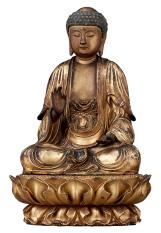
Starting price EUR 1,500

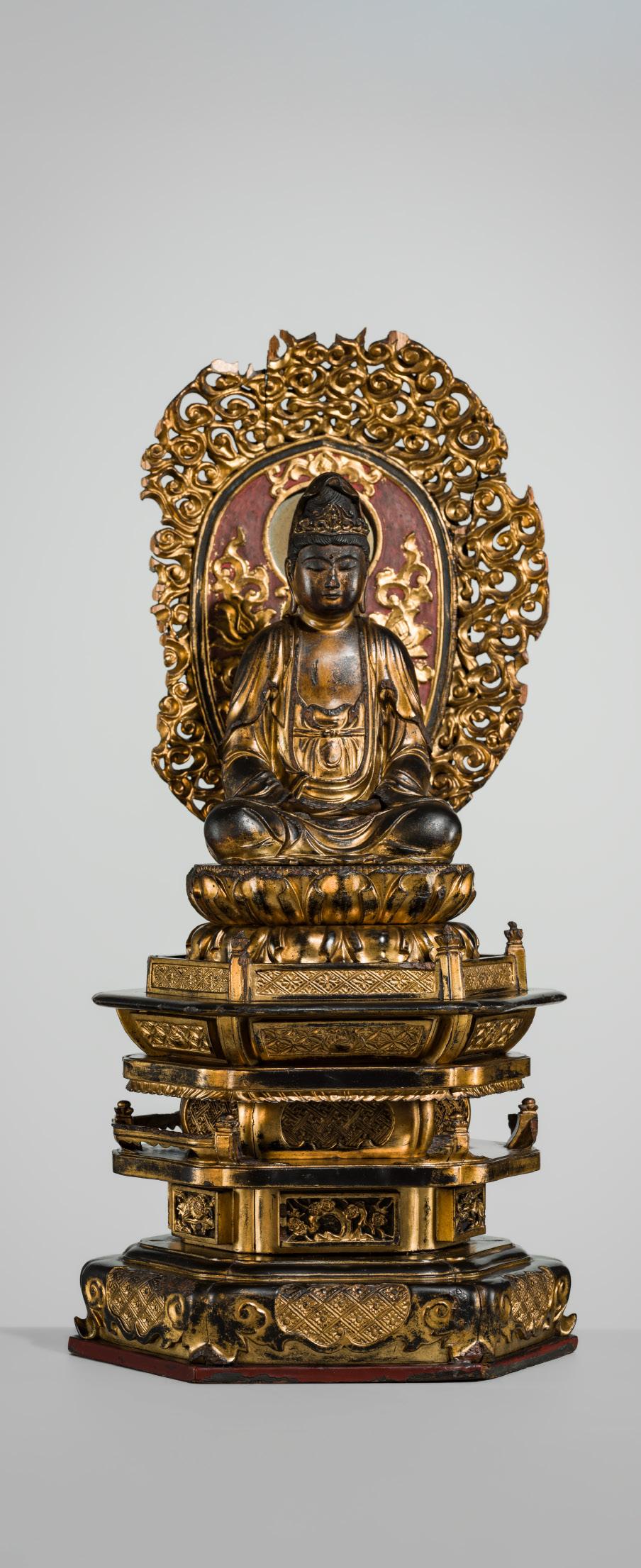
178
A GILT-LACQUERED WOOD
FIGURE OF A SEATED KANNON BOSATSU, EDO PERIOD
Japan, 18th-19th century, Edo period (1615-1868)
Finely carved and painted in gold, black, and red lacquer, the bodhisattva seated in kekka fuza (dhyanasana) upon a double-lotus pedestal, itself resting on an elaborate, tiered hexagonal stand decorated with brocade patterns and floral-scroll panels. His hands lowered in mida jo-in (dhyana mudra) and clad in a loosely draped monastic robe opening at the chest, cascading in voluminous folds. The rounded face, serene in expression, distinguished by downcast eyes beneath gently arched brows, centered by a prominent byakugo (urna), a broad nose, and full lips, all flanked by long, pendulous earlobes. The hair carefully arranged beneath a gilt tiara and gathered into a low coiffure, framed by an openworked kohai (halo).
HEIGHT 19.3 cm (figure) and 49.2 cm (total)
Provenance: From a private collection in Austria. Condition: Evidence of breakage to the aureole, standing slightly loose, with associated touchups and repairs. Minor age cracks. Few small losses and chips to exposed areas, mostly to the stand. Light flaking and rubbing to gilding and pigments with some repainted areas. Overall, the figure still presenting well.
Kannon Bosatsu, known in Sanskrit as Avalokiteshvara, meaning ‘The Lord Who Regards All’, and in Chinese as Guanyin, is one of the two principal attendant bodhisattvas (kyoji) of Amida Nyorai (Buddha Amitabha), together with Seishi Bosatsu. The role of Kannon is to witness and listen to prayers and cries from those who suffer in the earthly realm, offering guidance toward salvation. As the embodiment of compassion, Kannon is among the most widely venerated divinities in Asia and Japan, both in ancient and modern times. In sacred texts, Kannon appears as a bodhisattva who attains enlightenment but postpones Buddhahood until all beings can be saved, and is frequently mentioned in numerous Mahayana sutras, most notably in the Lotus Sutra. Worship of Kannon began in India around the first and second century AD and later spread throughout Southeast Asia, China, and Korea. Veneration in Japan began in the late sixth century, soon after Buddhism reached the Japanese archipelago through Korea and China. Initially represented as male, Kannon was later portrayed in female form in China, Japan, and other East Asian countries, each culture adapting the image of Kannon according to local temperament and spiritual concepts.
Estimate EUR 2,000
Starting price EUR 1,000
179
A LARGE GILT-LACQUERED WOOD FIGURE OF AMIDA NYORAI, 17TH–18TH CENTURY
Japan, 17th-18th century, Edo period (1615-1868)
Of yosegi (jointed) construction, finely carved and painted in gold, black, and red lacquer, the figure seated in kekka fuza (dhyanasana) on a lotus dais, with his hands lowered in mida jo-in (dhyana mudra), and clad in a loosely draped monastic robe opening at the chest, cascading in voluminous folds. The rounded face, serene in expression, distinguished by downcast eyes beneath gently arched brows, centered by a prominent byakugo (urna), a broad nose, and full lips, all flanked by pierced, pendulous earlobes. The hair arranged in tight curls surmounted by a crystal-inlaid nikkeishu (jewel of wisdom) and backed by a reticulated kohai (halo) densely carved with swirling clouds.
HEIGHT 31.7 cm (figure) and 62.9 cm (total)
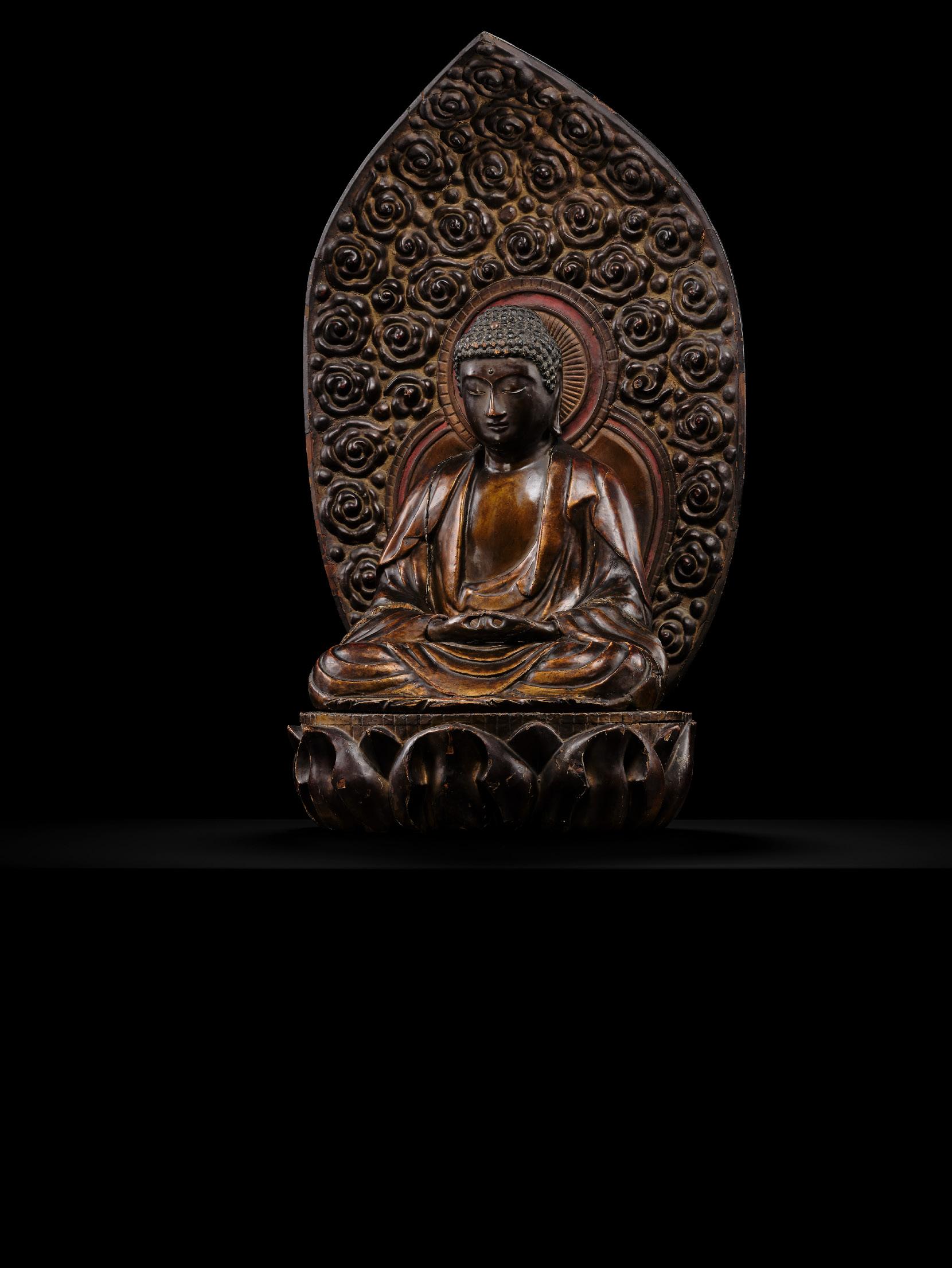
Provenance: From a private collection in Denmark. Condition: Good condition, commensurate with age, with expected wear. Few obvious age cracks and fractures, with associated touchups and repairs. Extensive flaking and rubbing to gilding and pigments, as is to be expected.
AUCTION COMPARISON
Compare a related gilt-lacquered wood figure of seated Amida Nyorai, Edo period, 18th-19th century, 59.7 cm high overall, at Bonhams, Fine Japanese and Korean Art including Japanese Screens from The Metropolitan Museum of Art and The Simone and Alan Hartman Collection of Japanese Art Part II, 21 March 2024, New York, lot 1090 (sold for USD 5,504 or approx. EUR 5,000 converted and adjusted for inflation at the time of writing).
Estimate EUR 2,500
Starting price EUR 1,200


180
A VERY LARGE (130 CM) GILT-LACQUERED WOOD FIGURE OF AMIDA NYORAI, 18TH CENTURY
Japan, 18th century, Edo period (1615-1868)
Of yosegi (jointed) construction, finely carved and lacquered in gold, black, and red, the figure standing in samabhanga and firmly mounted on a separately carved lotus dais, itself supported on an elaborate, tiered hexagonal stand, decorated with lotus petals and rectangular panels containing openwork scrolling tendrils. His right hand raised in raigo-in (vitarka mudra) and his left lowered in similar mudra. He is clad in a loosely draped monastic robe opening at the chest and cascading in voluminous folds from his shoulders. The rounded face, serene in expression, distinguished by downcast eyes beneath gently arched brows, centered by a prominent crystal-inlaid byakugo (urna), a slender nose, and full lips, all flanked by pierced, pendulous earlobes. The hair arranged in tight curls, surmounted by a nikkei (ushnisha), and backed by a reticulated kohai (halo).
Reticulated haloes of this kind are exceedingly rare in such a wellpreserved state, despite evidence of minor breakage to the halo with associated signs of restoration. Typically fashioned from thinly carved wood and lacquered openwork, they were highly vulnerable to warping, cracking, or loss over time due to their extreme fragility. Most surviving examples have either large missing sections or are simply gone completely. The present halo, however, retains its original structure and delicate pattern, with only few small losses.
HEIGHT 66 cm (figure) and 130 cm (total)
Provenance: From a private collection in the Netherlands. An old collector’s label affixed to the stand, inscribed ‘Buddha en bois, n° 131.226’.
Condition: Good condition with expected wear. Some losses and evidence of breakage to the halo with associated signs of restoration. Rubbing to gilding and pigments, as is to be expected. Scattered chips to lacquer along the edges of the stand. The nikkeishu (jewel of wisdom), typically attached to the ushnisha, missing. Overall, the figure presenting notably well.
This iconographic representation of Amida corresponds to Buddha Amitabha, a central figure in Japanese Buddhism. Worship of Amida was established in Japan during the Nara period (710–794) and became one of the principal practices taught in the Tendai school during the Heian period (794–1185). Amida is revered as the one who welcomes the faithful into the celestial realm. Despite human imperfections, those who embrace Buddhist doctrine and invoke the name of Amida at the moment of death are believed to be reborn in the Pure Land Paradise. The boat-shaped halo behind the figure symbolizes the guidance offered to devotees across the ‘ocean of suffering’.
The Raigo-in (in Sanskrit, vitarka mudra or ‘welcoming gesture’) is a hand gesture closely associated with Amida Nyorai. The deity is conventionally portrayed with the right hand raised and the left hand lowered, as exemplified in the present work. This specific gesture alludes to nine distinct variants employed by Amida in the act of receiving the departed into the Pure Land (Jodo) of Ultimate Bliss (Gokuraku). Collectively designated as Amida Kubon-in, or ‘Mudra of the Nine Levels of Rebirth’, these configurations correspond to the nine hierarchical stages of rebirth within the Pure Land, to which devotees are believed to ascend according to their spiritual attainment.
MUSEUM COMPARISON
Compare a related yet smaller gilt-lacquered wood figure of Amida Nyorai with a similarly reticulated kohai, Edo period, 18th century, 68 cm high, in the Musée d’Ethnographie de Genève, accession number ETHAS 023580.
AUCTION COMPARISON
Compare a closely related gilt-lacquered wood figure of Amida of almost identical size (the figure 70 cm, total 132 cm), dated to the 18th century, at Zacke, Fine Japanese Art, 27 May 2022, Vienna, lot 88 (sold for EUR 35,392).
Estimate EUR 15,000 Starting price EUR 7,500



181
By Watanabe
Koun, signed Koun Japan, 18th-19th century, Edo period (1615-1868)
The finely carved figure of Amida Nyorai stands serenely upon a lotus dais, supported by an elaborate multi-tiered base adorned with intricate floral and geometric motifs. The base is richly carved with mythical creatures, including shishi (Buddhist lions), kirin, and ho-o (phoenixes), symbolizing divine protection and enlightenment. Amida’s hands are held in the raigo-in mudra, the gesture of welcoming souls to the Western Paradise. His tranquil countenance, with downcast eyes beneath gently arched brows, radiates compassion and serenity. The features are delicately rendered—a broad nose, softly modeled lips, and a finely painted mustache—framed by long, pierced pendulous earlobes. At the forehead rests a crystal or glass byakugo (urna), the mark of spiritual wisdom. Behind the head rises a circular mandorla with a central lotus motif emanating rays of light.
Inscriptions: To the tenons of the feet, Koun 康雲 (Watanabe Koun).
HEIGHT 45.5 cm (the figure only), HEIGHT 102.5 cm (total)
Condition: Excellent condition and presenting beautifully. Some general wear commensurate with age and use.
Watanabe Koun was a Buddhist sculptor exclusively associated with Nishi Hongan-ji temples. Koun, active during the Edo period and based in Okazaki, was a name passed down through successive generations of temple sculptors. Statues of Amida Nyorai, principal deity of Nishi Hongan-ji, created by Koun and his lineage are found throughout Japan, celebrated for their refined expression and profound spiritual presence.
The Byakugo, a white swirl of fine hair on the forehead of the Buddha, is represented here by a neatly inlaid rock crystal . It is also sometimes called the third eye and allows Amida to see past the mundane and into the divine world. The ushnisha above is embedded in finely sculpted, curly hair, centered by a glass inlay.
The sculpture represents Amitabha, known in Japanese as Amida Nyorai, or the Buddha of Limitless Light. Amitabha reigns over the Western Pure Land, a paradise to which anyone is welcomed if they faithfully and sincerely incant his name. This place of salvation became central to the Jodo [lit. Pure Land] sect of Buddhism. Propounded in 1175 by the monk Honen, the accessibility of such tenets of redemption allowed this form of Buddhism to proliferate across the nation and feudal classes of Japan. Often depicted with an elaborate mandala, the boat-shaped halo is said to remind his followers that he serves as a guide for them to cross the ocean of suffering which contaminates the living.
LITERATURE COMPARISON
Compare a related standing figure of Amida Nyorai by Watanabe Kōun, enshrined at Jorakuji Temple, Hamamatsu, Shizuoka Prefecture, mid-Edo period. The temple’s principal image bears the sculptor’s signature “Watanabe Koun” (渡辺康雲) inscribed on the tenons of the feet, identifying it as the work of the same Nishi Hongan-ji–affiliated atelier. The Jorakuji example shares closely related stylistic features, including the calm, downcast expression, long pierced earlobes, and radiating circular mandorla, exemplifying the refined and devotional quality characteristic of Koun’s Amida figures.
AUCTION COMPARISON


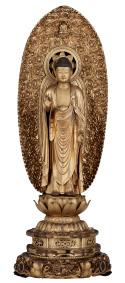
Compare a closely related figure of Amida Buddha, of similar size (total 94.9 cm), dated to the 18th century, at Bonhams, Fine Japanese and Korean Art, 20 March 2019, New York, lot 291 (sold for USD 13,825 or approx. EUR 15,000 converted and adjusted for inflation at the time of writing). Compare a related large gilt wood figure (total 132 cm), dated to the 18th century, at Zacke, Fine Japanese Art, 27 May 2022, Vienna, lot 88 (sold for EUR 35,392).
Estimate EUR 15,000
Starting price EUR 7,500


182 A LARGE (78 CM) AND IMPRESSIVE GILT-LACQUERED WOOD ZUSHI (PORTABLE SHRINE) CONTAINING A FIGURE OF AMIDA NYORAI, 18TH CENTURY
Japan, 18th century, Edo period (1615-1868)
The figure is finely carved and depicts the seated buddha in kekka fuza (dhyanasana) on a lotus dais, itself resting on an elaborate, tiered hexagonal stand decorated with panels enclosing sayagata patterns and openwork scrolling tendrils, framed by key-fret bands and swirling clouds, with metal fittings chased with floral scrollwork. His hands lowered in mida jo-in (dhyana mudra) and his body clad in a loosely draped monastic robe opening at the chest and cascading in voluminous folds. The rounded face conveying a meditative expression, distinguished by downcast eyes beneath gently arched brows, centered by a crystal-inlaid prominent byakugo (urna), a broad nose, and full lips, all flanked by pierced, pendulous earlobes. The hair arranged in tight rounded forms, surmounted by a nikkei (ushnisha) and topped with a similarly inlaid nikkeishu (jewel of wisdom). The head backed with an oval kohai (aureole), intricately carved with swirling cloud-like motifs.
The shrine of typical form, the exterior finished in a lustrous roiro ground with copper fittings including shaped hinges, while the interior is richly lacquered in gold, heightening the sacred presence of the image within.
HEIGHT 78 cm
Provenance: From a private collection in the Netherlands. Condition: Very good condition with expected wear. Typical rubbing to gilding and pigments. Few minor nicks and light surface scratches. Occasional small chips to exposed areas at the stand.
Japanese Buddhist images are frequently housed within zushi, portable or fixed wooden shrines equipped with doors that permit the deity to be alternately disclosed or concealed. These casket-like enclosures embodied a distinctly Japanese adaptation of Buddhist devotional practice. Scholars have posited that the custom may ultimately derive from Shinto precedents, wherein sacred presences are seldom represented in anthropomorphic form and are traditionally veiled from direct view.
Estimate EUR 8,000
Starting price EUR 4,000
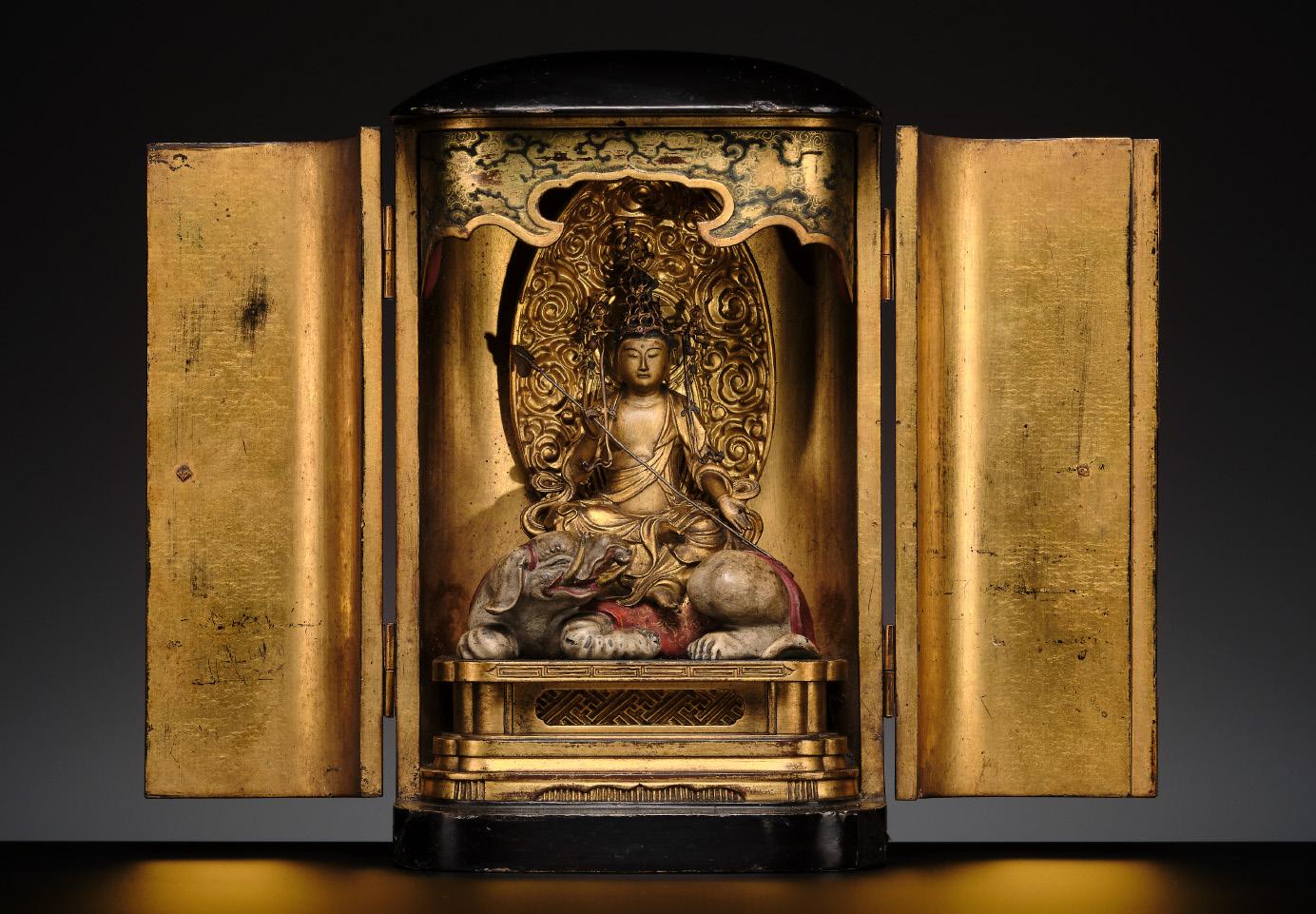
183
Japan, 18th century, Edo period (1615-1868)
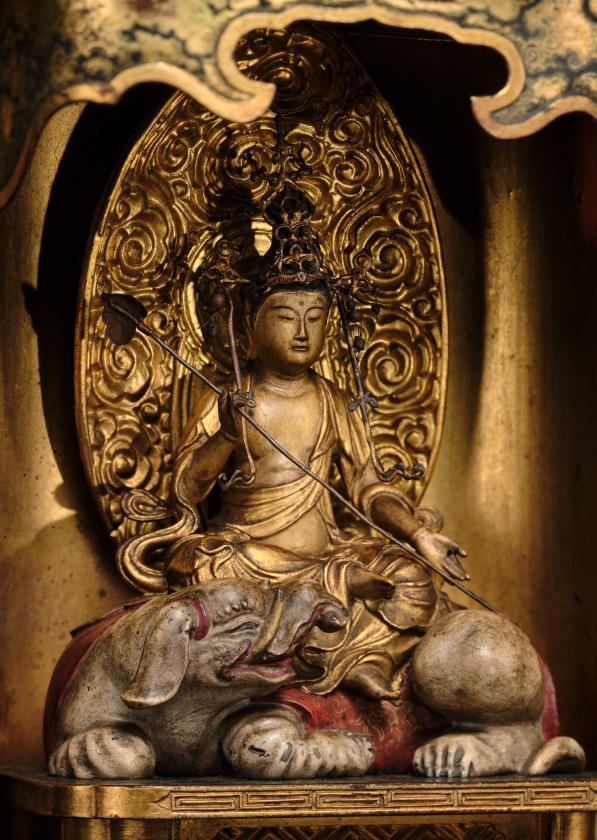
The bodhisattva is finely carved, seated in hanka-za (lalitasana) atop a recumbent elephant serving as his vahana, its back draped with a red mantle, while holding a lotus blossom with his right hand and his left lowered in yogan-in (varada mudra). He is clad in a loosely draped monastic robe opening at the chest and cascading in voluminous folds over his legs. The rounded face conveying a meditative expression, distinguished by downcast eyes beneath gently arched brows, centered by a byakugo (urna), a slender nose, and full lips forming a calm smile, flanked by long, pendulous earlobes. The blue-lacquered hair secured with an elaborate, openworked tiara, surmounted by a conical nikkei (ushnisha). The head backed by an oval kohai (aureole), intricately carved with swirling cloud-like motifs.
The shrine of typical form, the exterior finished in a lustrous roiro ground with copper fittings including shaped hinges, while the interior is richly lacquered in gold, heightening the sacred presence of the image within.
HEIGHT 23.3 cm
Condition: Good condition with expected wear. The shrine with flaking and associated losses to lacquer. Rubbing to gilding and pigments with old touchups. A small chip to the upper edge of the shrine. Few minor nicks and light surface scratches.
AUCTION COMPARISON
Compare a closely related gilt-lacquered wood portable shrine (zishu) containing a figure of Monju Bosatsu, Edo period, 19th century, 23.2 cm high, at Bonhams, Fine Japanese Works of Art, 16 March 2016, New York, lot 3028 (sold for USD 5,000 or approx. EUR 6,000 converted and adjusted for inflation at the time of writing).
Estimate EUR 4,000
Starting price EUR 2,000

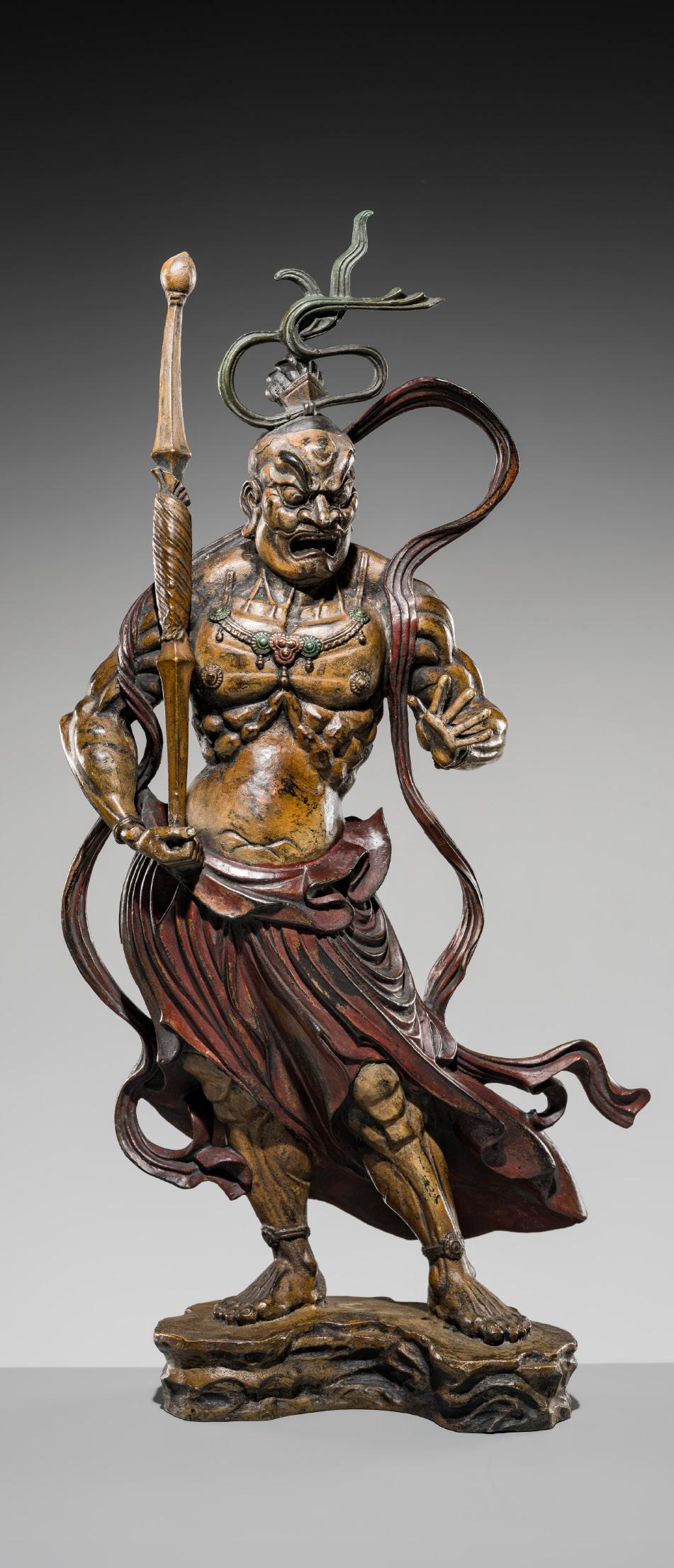
184 AN IMPRESSIVE AND LARGE BRONZE FIGURE OF A NIO GUARDIAN, LATE EDO PERIOD
Japan, late Edo period (1615-1868)
The Kongorikishi cast with a wrathful expression, finely cold-painted in polychrome pigments, standing on layered rockwork and wearing flowing skirts with heavenly bands, the muscular chest and arms left bare. Modeled after Agyo, the monumental 13th century cypress figure at Todaiji temple, Nara, Japan.
HEIGHT 56 cm
WEIGHT 10.3 kg
Condition: Very good condition with minor wear and casting irregularities. Few nicks, scattered scratches, small dings, expected rubbing and wear to pigment, minor warping, and traces of weathering and erosion. The tip of the staff with old repairs with associated touchups.
Nio or Kongorikishi are wrathful and muscular guardians of the Buddha standing today at the entrance of many Buddhist temples in East Asian Buddhism in the form of frightening wrestler-like statues. They are dharmapala manifestations of the bodhisattva Vajrapani, the oldest and most powerful of the Mahayana Buddhist pantheon. According to Japanese tradition, they travelled with Gautama Buddha to protect him. Within the generally pacifist tradition of Buddhism, stories of dharmapalas justified the use of physical force to protect cherished values and beliefs against evil. Nio are also seen as a manifestation of Mahasthamaprapta, the bodhisattva of power that flanks Amitabha in Pure Land Buddhism and as Vajrasattva in Tibetan Buddhism. They are usually a pair of figures that stand under a separate temple entrance gate usually called Niomon in Japan. The right statue is called Misshaku Kongo and has his mouth open, and the left statue is called Naraen Kongo and has his mouth closed. Similar to Alpha and Omega in Christianity, they signify “everything”.
AUCTION
COMPARISON
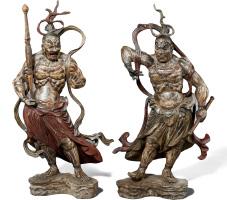
Compare a closely related pair of Nio bronze guardians, 18th-earlier 19th century, 55 cm high, at Zacke, Fine Japanese Art, 29 November 2019, Vienna, lot 5 (sold for EUR 14,000).
Estimate EUR 4,000
Starting price EUR 2,000
185
Japan, 19th century, Edo period (1615-1868)
Finely cast, depicted gracefully standing in samabhanga atop a double-lotus pedestal, with his right hand raised in semui-in (abhaya mudra) and the left lowered beside the body with the palm facing downward. The Bodhisattva richly attired with a flowing skirt arranged in stylized folds draped across the waist and embellished with beaded jewelry. His rounded face conveying a serene expression, with downcast eyes beneath gently arched brows, a slender nose, and full lips, all framed by long, pendulous earlobes. The hair neatly gathered beneath a foliate crown centered with the image of Shaka (Buddha Shakyamuni). With an engraved artist’s seal to the lower back area.
HEIGHT 69.7 cm
WEIGHT 7.4 kg
Provenance: From a private collection in Hungary. Condition: Very good condition with minor wear and casting irregularities. Occasional minor nicks to exposed areas and few minute dents to the lotus stand. The bronze surface with a dark, naturally grown patina.

Yume-Chigai Kannon, literally Dream-changing Kannon, represents a specific manifestation of Kannon Bosatsu, traditionally believed to transform inauspicious dreams into auspicious ones. An early extant example of this Bodhisattva, dating to the 8th century, is preserved at Horyu-ji Temple in Nara, one of the earliest Buddhist temples in Japan and a UNESCO World Heritage Site. The figure exhibits stylistic features approaching the mature Tenpyo aesthetic, marking a culmination of the Hakuho style, evident in the pure and youthful physiognomy of the Bodhisattva and in the refined treatment of drapery and proportion. The gilt-bronze sculpture holds the status of National Treasure of Japan.
A gilt-bronze figure of Yume-Chigai Kannon Bosatsu, designated a National Treasure of Japan, Asuka to Nara period, Hakuho culture, 7th-8th century, 86.9 cm high, in the Horyu-ji Temple, Nara
MUSEUM COMPARISON
Compare a related bronze figure of Kannon Bosatsu, Edo period, 107.7 cm high overall, in the Walters Art Museum, accession number 54.1605.
AUCTION COMPARISON
Compare a related smaller bronze figure of Kannon Bosatsu, Edo period, probably 18th-19th century, 26.4 cm high, at Christie’s, An Inquiring Mind: American Collecting of Japanese and Korean Art, 22 April 2015, New York, lot 15 (sold for USD 9,375 or approx. EUR 11,000 converted and adjusted for inflation at the time of writing).
Estimate EUR 8,000
Starting price EUR 4,000




186
A LARGE (101 CM) AND EXCEEDINGLY RARE BRONZE STATUE OF AMIDA NYORAI, 18TH CENTURY
Japan, 18th century, Edo period (1615-1868)
Finely cast, the figure standing in samabhanga atop a lotus dais, itself supported on an elaborate, tiered hexagonal stand, with a recumbent Buddhist lion (shishi) and shaped panels enclosing blossoming lotus sprays. His right hand raised in raigo-in (vitarka mudra) and his left lowered in similar mudra. He is clad in a loosely draped monastic robe opening at the chest and cascading in voluminous folds from his shoulders. The rounded face, serene in expression, distinguished by downcast eyes beneath gently arched brows, centered by a prominent crystal-inlaid byakugo (urna), a slender nose, and full lips, all flanked by long, pendulous earlobes. The hair arranged in tight curls, surmounted by a nikkei (ushnisha), and topped with a similarly inlaid nikkeishu (jewel of wisdom).
The head backed with an oval kohai (aureole), intricately cast with swirling cloud-like motifs.
HEIGHT 57 cm (figure), 101 cm (total)
WEIGHT 27.1 kg
Condition: Very good condition with minor casting irregularities and flaws as are to be expected. Some light traces of use, tiny nicks, and remnants of gilding throughout.
The Raigo-in (in Sanskrit, vitarka mudra or ‘welcoming gesture’) is a hand gesture closely associated with Amida Nyorai. The deity is conventionally portrayed with the right hand raised and the left hand lowered, as exemplified in the present work. This specific gesture alludes to nine distinct variants employed by Amida in the act of receiving the departed into the Pure Land (Jodo) of Ultimate Bliss (Gokuraku). Collectively designated as Amida Kubon-in, or ‘Mudra of the Nine Levels of Rebirth’, these configurations correspond to the nine hierarchical stages of rebirth within the Pure Land, to which devotees are believed to ascend according to their spiritual attainment.
Estimate EUR 15,000
Starting price EUR 7,500
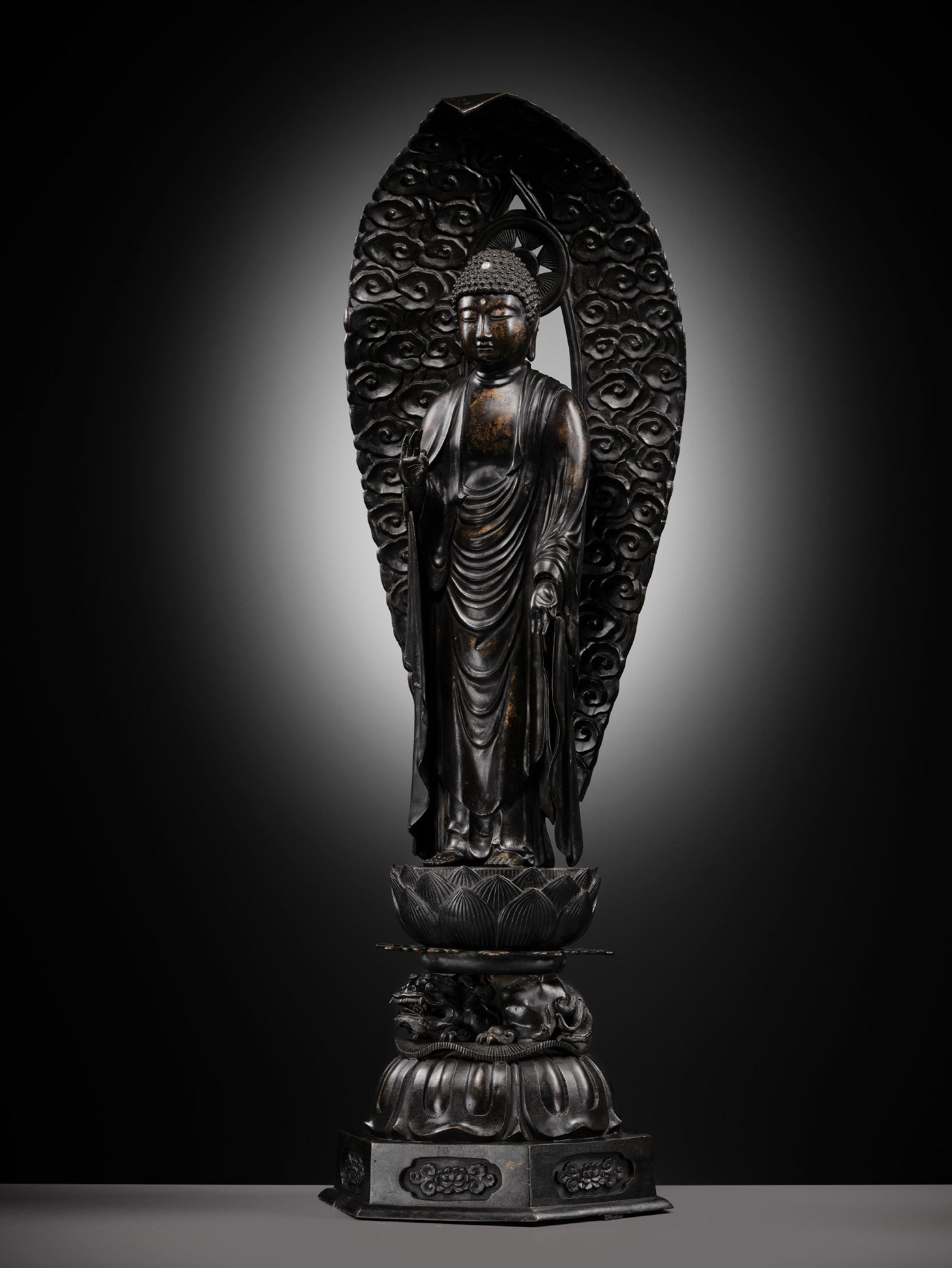
187
By Tanaka Koji (1871-1951), sealed Koji Japan, early 20th century, Meiji period (1868-1912) to Taisho period (1912-1926)
Of circular form, finely cast in relief to depict the upper-body portrait of the bodhisattva, adorned with a jeweled choker and long pendant earrings shaped as scrolling tendrils. The rounded face conveys a composed expression, with heavy-lidded, downcast eyes beneath gently arched brows, a distinct byakugo (urna), a slender nose, and softly rounded lips framed by a fine mustache. The hair is carefully arranged and adorned with peony blossoms, covered by a pleated veil that falls gracefully over the shoulders. Sealed within a square reserve KOJI.
DIAMETER 35.1 cm
WEIGHT 3.6 kg
Provenance: From an old private collection in Southern Germany, acquired from Nagel Auctions in Stuttgart, Germany, prior to 2000. Condition: Excellent condition with only minimal wear.
Tanaka Koji (1871-1951) was a distinguished metalwork artist and a student of Okakura Tenshin (1863-1913) at the Tokyo Fine Arts School (present-day Tokyo University of Arts). Following his graduation from the Metal Casting Department, he was appointed assistant professor at the institution. Subsequently, he joined the Tokyo Gas Company, where, for three years, he undertook advanced studies in metalwork and enameling across Western Europe as a government-sponsored industrial trainee under the auspices of the Ministry of Agriculture and Commerce. After departing Tokyo Gas, Tanaka founded his own atelier, the Tanaka Factory. His oeuvre encompasses not only exemplary craftsmanship but also the systematic refinement of utilitarian objects in enamelware and cast metal, reflecting both technical innovation and aesthetic sophistication.
Kannon Bosatsu, known in Sanskrit as Avalokiteshvara, meaning ‘The Lord Who Regards All’, and in Chinese as Guanyin, is one of the two principal attendant bodhisattvas (kyoji) of Amida Nyorai (Buddha Amitabha), together with Seishi Bosatsu. The role of Kannon is to witness and listen to prayers and cries from those who suffer in the earthly realm, offering guidance toward salvation. As the embodiment of compassion, Kannon is among the most widely venerated divinities in Asia and Japan, both in ancient and modern times. In sacred texts, Kannon appears as a bodhisattva who attains enlightenment but postpones Buddhahood until all beings can be saved, and is frequently mentioned in numerous Mahayana sutras, most notably in the Lotus Sutra. Worship of Kannon began in India around the first and second century AD and later spread throughout Southeast Asia, China, and Korea. Veneration in Japan began in the late sixth century, soon after Buddhism reached the Japanese archipelago through Korea and China. Initially represented as male, Kannon was later portrayed in female form in China, Japan, and other East Asian countries, each culture adapting the image of Kannon according to local temperament and spiritual concepts.
Estimate EUR 6,000
Starting price EUR 3,000




188
AN IMPORTANT AND MASSIVE (80.5 CM)
BRONZE TEMPLE FIGURE OF AMITABHA BUDDHA, EDO PERIOD
Japan, 18th-19th century, Edo period (1615-1868)
Cast in a pose of meditation with his hands in dhyanamudra, his monastic robes open at the chest and falling in rhythmic folds over the front, pooling before the feet. The faintly smiling face detailed with downcast eyes below arched brows, centered by an urna, plump cheeks, and a delicately cast nose, flanked by ears with pendulous lobes. The hair modeled as a coiffure of small spiral curls.
Inscriptions: Signed to the lower back Shinsei saku 信清作 [made by Shinsei].
HEIGHT 80.5 cm
WEIGHT 214 kg
Provenance: From a private collection in Southern Germany, acquired in the early 1990s from Koller, Zurich.
Condition: Excellent condition with minor wear and casting irregularities. Expected signs of weathering and erosion. The back with minor stress cracks with repairs and associated touchups. The interior cavity has been filled with concrete as a stabilizing and anti-theft measure, implemented while the work was displayed outdoors. The intervention appears stable and does not currently exhibit signs of structural stress or damage to the bronze shell.
The present bronze figure is modeled after the celebrated Great Buddha (Daibutsu) of Kamakura, one of Japan’s most iconic monuments and a designated National Treasure. The Kamakura Daibutsu, completed in the 13th century, exemplifies the serene composure and spiritual gravity of early Japanese bronze statuary, and is among the twenty-two historic sites proposed for UNESCO World Heritage inscription. The present work closely echoes its prototype in the tranquil expression, seated posture of meditation (dhyana mudra), and the naturalistic yet rhythmically ordered treatment of the monastic robes.

AUCTION COMPARISON
Compare a closely related larger bronze temple figure of Amitabha Buddha, Edo period, dated 1680, 170 cm high, at Bonhams, Fine Asian Works of Art, 20 November 2006, San Francisco, lot 6079 (sold for USD 172,250 or approx. EUR 238,000 converted and adjusted for inflation at the time of writing).
Estimate EUR 30,000
Starting price EUR 15,000



A HIGHLY IMPORTANT AND MONUMENTAL (165 CM) BRONZE FIGURE OF DAIKOKU,

189
A HIGHLY IMPORTANT AND MONUMENTAL (165 CM) BRONZE FIGURE OF DAIKOKU, LATE EDO TO MEIJI
Japan, 19th century, late Edo period (1615-1868) to Meiji period (1615-1868)
Superbly and massively cast, the God of Wealth seated atop a large rice bale, the right hand raised above his head and clasped around his separately cast wish-granting mallet, the left hand balancing a hoju (sacred wish-granting jewel) in his open palm. The deity dressed in a voluminous robe, tied with a belt below his engorged pot-belly, wearing thick boots and a cap, the face with an expression of triumph flanked by ears with pendulous lobes.
HEIGHT 165 cm
WEIGHT 120 kg
Provenance: The private collection of Friedrich Carl Duisberg, acquired prior to 1930 from an antique store in Kobe. Exhibited in the recreational Japanese Garden of Bayer AG in Leverkusen. In his travel diary, Dr. Carl Duisberg recounts a visit to Kobe, where he discovered a special bronze figure in a small shop owned by a Japanese man named Harashin, which was filled with exquisite works of art. After spotting the magnificent figure of Daikoku in the corner of the shop, Duisberg asked the owner in English who this figure represented, he received an answer in German, accompanied by a mischievous smile: “The god of industry.” As chairman of the Reich Association of German Industry, Duisberg felt obliged, with a wink, to purchase this bronze for his garden on the Rhine (copies of the diary pages in which Duisberg recounts the Japan travels confirming the above are included). Friedrich Carl Duisberg (1861-1935) was one of the most important German industrialists of his time. The first General Director of the Bayer paint factory from 1912 to 1925 and Chairman of the Supervisory Board of IG Farben, which he co-founded, from 1926 until his death in 1935, Duisberg is known above all as a pioneering industrialist. He played a decisive role in shaping both the scientific and economic landscape of early 20th-century Germany. Yet beyond his achievements in industry, he cultivated a deep personal commitment to the arts and to the harmonization of science, culture, and nature. This philosophy found its most intimate expression in the garden he created after moving from Elberfeld to Leverkusen in 1912 – a move closely tied to Bayer’s expansion and the development of the company’s headquarters.
Friedrich Carl Duisberg posing next to the present lot displayed in his carefully planned Japanese Garden in Leverkusen
Situated within a pre-existing landscape, Duisberg transformed the grounds surrounding his new residence into a visionary fusion of art and nature. A conventional redesign of the pond into a lawn was soon abandoned in favor of a more ambitious and poetic concept: a garden inspired by Japanese aesthetics. Yet his aim was not imitation. Instead, Duisberg developed a personal interpretation of the Japanese garden, one that reflected his sensitivity to the changing seasons, the poetics of natural form, and the contemplative dialog between object and environment. Every piece within this garden was handpicked by Duisberg. Each was chosen not only for its artistic merit but for its ability to converse with its surroundings: the trees, the water, the shifting light of spring and autumn. The result was a living collection, in which artworks did not dominate the landscape but became part of its breath and rhythm. Condition: Good condition with wear and casting irregularities. Age cracks, small losses, scattered dings, and signs of weathering and erosion. The underside of the left arm with losses and weathering. Small areas with fills and associated touchups. The bronze with a rich, naturally grown patina with vibrant malachite encrustations.
Daikoku, or Daikokuten is originally known as Mahakala, one of the Tantric guardian deities known as the primary Wisdom Protector of Tibetan Buddhism, as well as a meditational deity. While he has many different forms, he is typically depicted with a wrathful appearance. In Japan this deity is considered as protector of farming and commerce and one of the Seven Gods of Good Fortune. In a much less fearsome form, this deity was popular during the Edo period.
AUCTION COMPARISON
Compare related monumental bronze
Shinto deities, sealed Dai Nihon Suzuki Masayoshi tsukuru, Meiji period, dated 19th century, 208 cm high, at Christie’s, Asobi: Ingenious Creativity, Japanese Works of Art from Antiquity to Contemporary, 15 October 2014, London, lot 98 (sold for GBP 146,500 or approx. EUR 268,000 converted and adjusted for inflation at the time of writing).
Estimate EUR 50,000
Starting price EUR 24,000



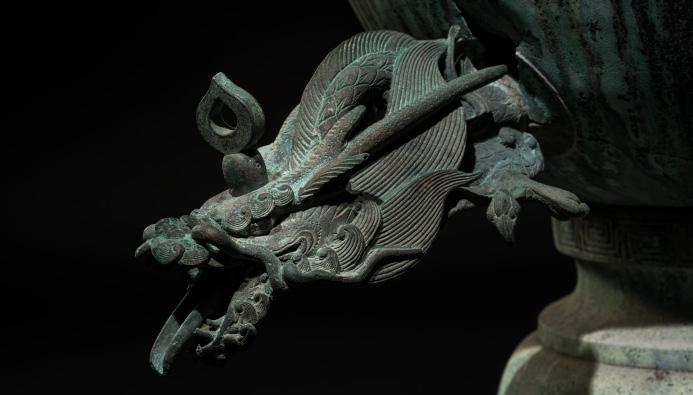
190
A LARGE AND MASSIVE BRONZE TEMPLE WATER FOUNTAIN WITH DRAGON SPOUT
Japan, 18th-19th century, Edo period (1615-1868)
Superbly modeled, the ovoid body supported on a tall tiered bell-form base cast in openwork and decorated with bands of key-fret, flanked by scrolling handles issuing from beast heads, above the spout in the form of a ferocious two-horned dragon with the mouth wide open revealing tongue and fangs, the head surmounted by the flaming tama, the shoulder encircled by an incised band enclosing sinuous dragons pursing the flaming pearl amid dense clouds, all below the stepped cover surmounted by a shishi modeled in animated poses with snarling expressions.
HEIGHT 78 cm
WEIGHT 28.7 kg
Provenance: From the estate of E. Theodore Krolikowki III, Laurel Beach, Milford, Connecticut.
Condition: Good condition with wear and casting irregularities. Scattered nicks and scratches, some dings, minor stress cracks, few losses, and signs of use and weathering. The spout reattached with associated traces of soldering. The bronze with a naturally grown patina with extensive malachite encrustations.
After the fall of the Tokugawa shogunate and the dissolution of Buddhist temples at the beginning of the Meiji period, many of the large bronze temple lanterns and fountains like the present lot were largely sold, melted down, or destroyed during earthquakes and wars. Expatriates living in Japan and tourists purchased them to decorate their gardens at home, while others received them as gifts well into the 20th century.
AUCTION COMPARISON
Compare a closely related larger bronze temple water fountain with dragon spout, with similar patina, 175 cm high, dated to the Edo period, at Zacke, Fine Japanese Ceramics Art, 14 June 2024, Vienna, lot 1 (sold for EUR 20,800).
Estimate EUR 4,000
Starting price EUR 2,000


191
A CARVED STONE KASUGA TORO (STONE LANTERN)
Japan, c. 1860, late Edo period (1615-1868) to early Meiji period (1868-1912)
In five sections, the cylindrical shaft (sao) resting above the circular lotus base (kiso), supporting the hexagonal firebox (hibukuro) in the form of a temple complete with large windows and walls adorned with a full moon among swirling clouds and a deer prancing over rolling hills to the exterior, surmounted by a slanting roof (kasa) with upturned eaves and topped by a lotus bud finial (hoju).
HEIGHT c. 150 cm
WEIGHT 329 kg (total)
Provenance: With Midori Gallery, Miami, Florida. From the estate of Andrew Cunningham Ware, acquired from the above in 2012. A copy of an invoice from Midori Gallery, addressed to Andrew Ware, dated 18 May 2012, confirming the dating above, and stating a purchase price of USD 7,178 or approx. EUR 8,700 (converted and adjusted for inflation at the time of writing), accompanies the lot.
Condition: Good condition with old wear and natural imperfections. Obvious losses, scattered chips, nicks, traces of use, encrustations, and signs of weathering and erosion.

The many lanterns along the approach to Kasuga Shrine in Nara are among the best known in Japan. In February & August each year they are lit up for Japan’s popular lantern festivals.
The present example is a Kasuga toro, one of the most iconic and enduring forms of Japanese stone lantern. Originating from the Kasuga Taisha Shrine in Nara, these lanterns are characterized by their harmonious proportions, gently sloping hexagonal roofs (kasa), and elegantly tapered cylindrical shafts (sao) rising from lotus bases (kiso). Their fireboxes (hibukuro) are often carved with windows to allow the flame’s light to emanate, illuminating both the physical and spiritual realms. Traditionally associated with Shinto shrines and sacred precincts, Kasuga toro later became central features in Japanese gardens, embodying a union of religious devotion, natural beauty, and refined aesthetic balance. The prancing deer depicted on this example alludes to the sacred deer of Nara, messengers of the Shinto deities worshiped at Kasuga Taisha, reinforcing the lantern’s profound spiritual symbolism and regional connection.
Estimate EUR 8,000
Starting price EUR 4,000

Japan, c. 1800, Edo period (1615-1868)
Superbly carved, each Inari fox (kitsune) seated on its haunches atop an integral rectangular pedestal, its forelimbs holding its slender body upright, the bushy tail erect, and face turned to one side. One kitsune with a menacing expression, its mouth slightly ajar, revealing sharp teeth, its companion similarly modeled with a grim expression and tight smile.
HEIGHT 62 cm, LENGTH 37 cm (each)
WEIGHT 64.1 kg and 61.1 kg
Provenance: With Midori Gallery, Miami, Florida. From the estate of Andrew Cunningham Ware, acquired from the above in 2014. A copy of an invoice from Midori Gallery, addressed to Andrew Ware, dated 8 April 2014, confirming the dating above, and stating a purchase price of USD 12,840 or approx. EUR 15,000 (converted and adjusted for inflation at the time of writing), accompanies the lot. The Midori Gallery was opened by Sachi Wagner and her husband in 1971 and has been a celebrated source of antique Asian cultural artifacts for over half a century. In the beginning it was used as a bookstore specializing in East Asian culture, art, and

philosophy, but slowly developed into an antique shop focusing on Far Eastern works of art. Sachi Wagner is an authority in Asian antiques with more than 50 years of experience, specializing in China and Japan with elements of Korea, Tibet, India, and Southeast Asia. She has garnered a premier collection of paintings and screens, textiles, porcelain and archaic ceramics, sculpture, furniture, netsuke,

An invoice from Midori Gallery, addressed to Andrew Ware, stating a purchase price of USD 12,840 or approx. EUR 15,000
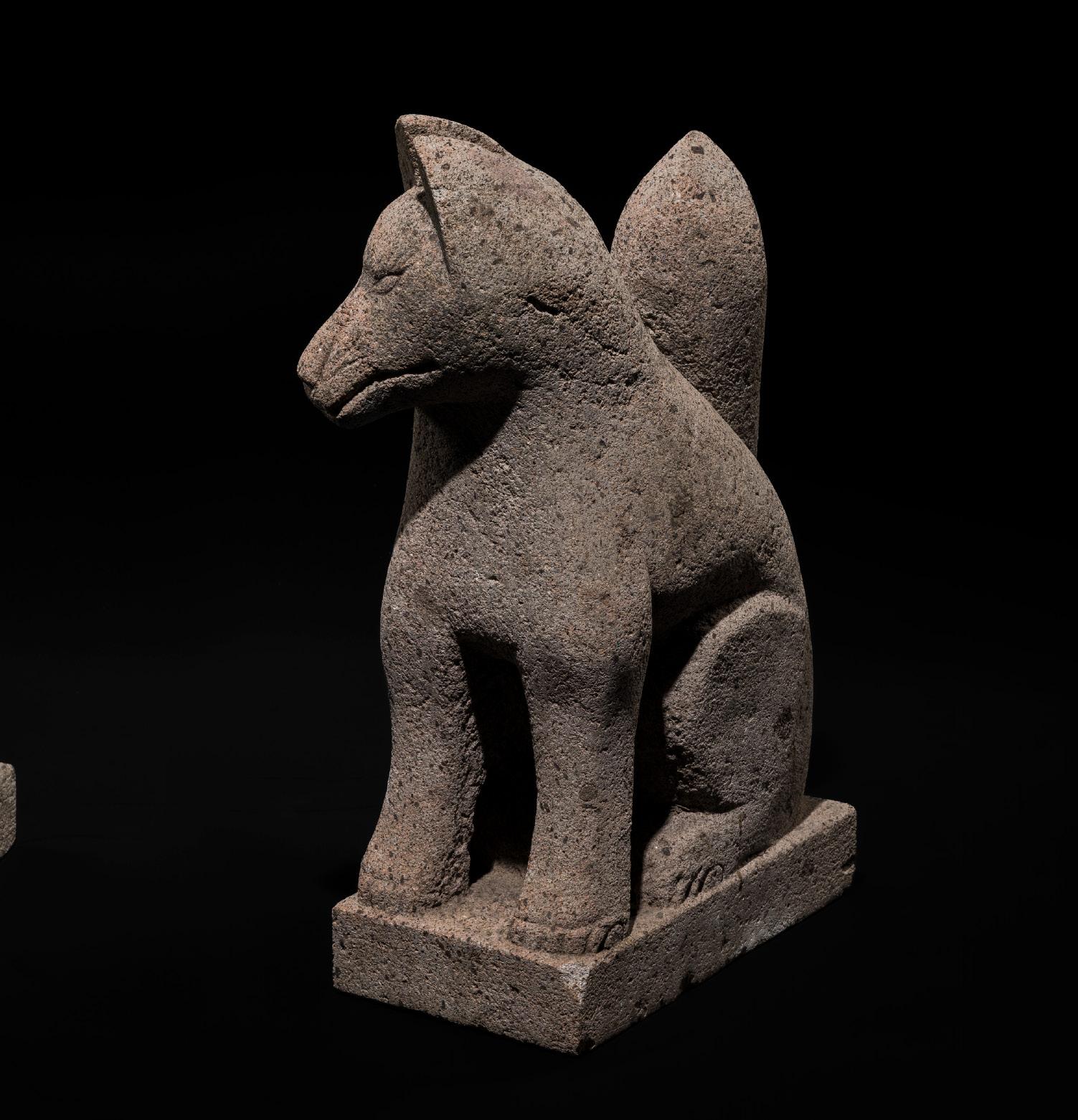
folk art, and other artifacts. Andrew Cunningham Ware (1945–2024) was an avid scholar and passionate amateur Egyptologist whose lifelong fascination with the ancient world led him to study under the distinguished French Egyptologist Christiane Desroches Noblecourt. Dividing his time between France and South Florida, Ware cultivated a remarkably diverse collection that reflected his wide-ranging intellectual curiosity—encompassing ancient Egyptian artifacts, historical documents from the French and Russian Revolutions, and a refined selection of Japanese art.
Condition: Excellent condition with old wear and natural imperfections. Small chips, few nicks, encrustations, and signs of weathering and erosion.
Estimate EUR 15,000
Starting price EUR 7,500
Among kitsune, it is the white fox - messenger of Dakiniten, later identified with Inari, the deity of cereals and harvest - that holds particular importance. Countless shrines dedicated to Inari were erected across Japan, often flanked by pairs of fox statues, many depicted holding a pearl or a key in their mouths. Worshipers visited these shrines to pray for wealth and prosperity, figures such as the present example may have flanked the entrance of such a temple complex.


Japan, 19th century, late Edo period (1615-1868) to Meiji period (1868-1912)
Superbly modeled to depict a moon rabbit leaping over turbulent waves. The hare’s form is softly modeled, with a subtle expression that conveys vitality and mythical charm, while the swirling waves offer a rhythmic counterbalance in carved relief.
HEIGHT 31 cm, LENGTH 52.5 cm
WEIGHT 8,453 g
Provenance: With Midori Gallery, Miami, Florida. From the estate of Andrew Cunningham Ware, acquired from the above in 2012. A copy of an invoice from Midori Gallery, addressed to Andrew Ware, dated 18 May 2012 accompanies the lot.
Condition: Very good condition with minor expected wear. Minor repairs to the paws.
MUSEUM COMPARISON
Compare a closely related roof tile depicting a rabbit leaping over crashing waves, exhibited in the Otsu City Museum of History, The 47th Special Exhibition, From Roof Tiles to the History of Otsu, 11 October-24 November 2008.
Estimate EUR 4,000
Starting price EUR 2,000

Roof tiles (kawara) were placed as protective talisman at the apex of a gabled roof. These sculpted architectural works of art were predominantly commissioned for temples or shrines or the important residence of a member of the ruling class. This most unusual example depicts the lunar hare dancing across cresting waves, a mystic vision that folk legend describes as occurring with the waxing of the full moon. In Japanese folklore, the lunar hare is a mystical creature said to appear in the moonlight as it pounds the elixir of life, often associated with longevity, health, and protection. The waves beneath the hare reference water, reinforcing its role as a guardian against fire, a common symbolic function for roof tiles on temples, shrines, and noble residences.

Close-up of the leaping rabbit amongst waves on the Five-Story Pagoda, c. 1818, Nikko Toshogu, part of the twelve zodiac signs
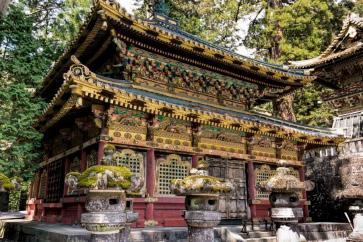
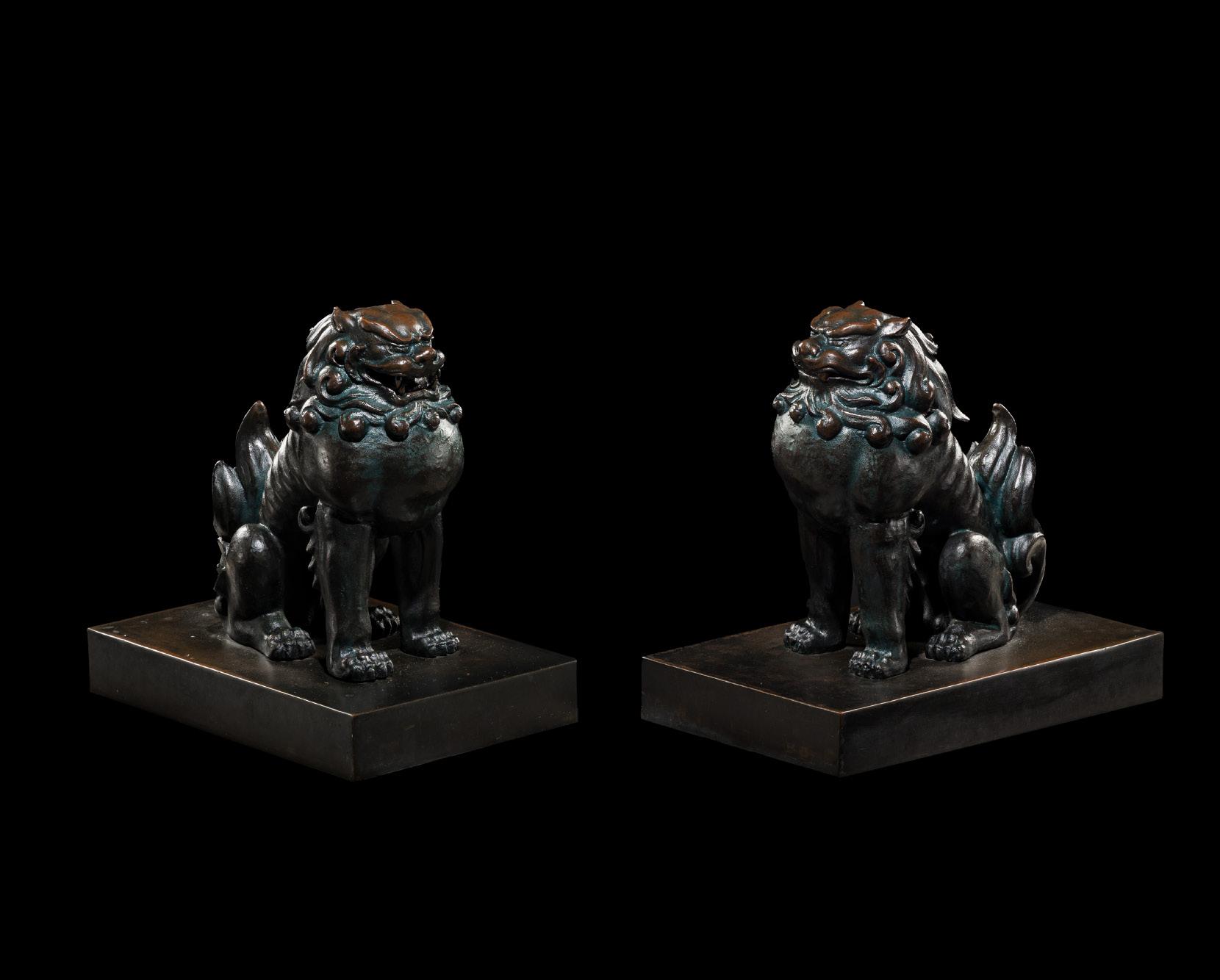
194
A PAIR OF BRONZE BUDDHIST LIONS (SHISHI), LATE EDO PERIOD
Japan, 19th century, Edo period (1615-1868)
Each finely cast atop an integral rectangular base, seated on its haunches, the head with a fierce expression, mouth ajar showing sharp fangs, a wide nose, and menacing eyes, the face framed by a thick curly mane. One lion with a closed mouth, uttering the syllable ‘um’, the other with the mouth open, uttering the syllable ‘ah’.
HEIGHT 31.5 cm and 33 cm (excl. base), 49.5 cm and 51 cm (incl. base)
WEIGHT c. 130 kg (each, incl. concrete block)
Provenance: With Bernheimer. The institutional collection of Bayer AG, Leverkusen, Germany, acquired by its long serving chairman, Friedrich Carl Duisberg, from the above prior to 1930. Exhibited in the recreational Japanese Garden of Bayer AG in Leverkusen. Condition: Excellent condition with minor wear and casting irregularities. Traces of weathering and erosion. The bronze with a naturally grown dark patina with areas of malachite encrustations. Firmly mounted on a block of concrete as a stabilizing and anti-theft measure, implemented while the work was displayed outdoors.
Typically appearing in pairs, one lion has its mouth open (agyo), symbolizing the cosmic syllable ah, the beginning, while the other’s mouth is closed (ungyo), uttering un or um, the end. Together they express the universal cycle of birth and death, the alpha and omega. This a-un pairing embodies both ferocity and spiritual protection, a duality reflected in the expressive modeling of these finely cast bronzes. The voluminous curls of their manes and the muscular vitality of their bodies demonstrate the high technical and aesthetic standards of late Edo bronze casting, as well as the enduring spiritual significance of the lion in the Buddhist visual tradition.
Estimate EUR 5,000 Starting price EUR 2,400

Friedrich Carl Duisberg posing next to a pair of shishi in his carefully planned Japanese Garden in Leverkusen


195
A GROUP OF THREE GILT AND CARVED WOOD BUDDHIST RITUAL KONGO, LATE EDO PERIOD
Japan, 19th century, Edo period (1615-1868)
Each of typical form, finely cast, neatly engraved with lotus decorations, and skillfully gilded.
LENGTH (largest) 7.8 cm
Provenance: From a private collection in France.
Condition: Each in very good condition with wear and natural age-related imperfections. Light rubbing to gilding, minor nicks here and there, and few microscopic chips to exposed areas.
The Kongo, in Sanskrit vajra, is a legendary and ritual tool, symbolizing the qualities of a diamond, indestructibility, and a thunderbolt, irresistible force, and is often described as a ‘ritual weapon’. It is typically used in conjunction with a ritual bell (sho), together forming essential instruments in the esoteric practices of the Shingon and certain Tendai schools and embodying the union of method and wisdom.
Estimate EUR 2,500
Starting price EUR 1,200
196 A SMALL CARVED WOOD FIGURE OF SHOTOKU TAISHI, LATE EDO TO MEIJI PERIOD
Japan, probably Nara, 19th century, late Edo period (1615-1868) to Meiji period (1868-1912)
Well-carved in ittobori, the prince depicted seated in kekka fuza (dhyanasana) upon an oval pedestal, possibly intended for use as a seal. His hands joined in gassho (anjali mudra) before his chest, clad in loosely draped robes tied at the waist. The face, rendered schematically, bearing a serene expression, with downcast eyes beneath gently arched brows, a flattened nose, and full lips forming a subtle smile, all framed by distinctive headgear.
HEIGHT 9.8 cm
Condition: Very good condition with minor wear and natural age-related imperfections. Light flaking and minor rubbing to lacquer. Minimal nibbling to edges.
Estimate EUR 1,500
Starting price EUR 800

197
A PAIR OF GILT LACQUER WOOD SHISHI, EDO PERIOD
Japan, 18th-19th century, Edo period (1615-1868)
Each carved in a playful and dynamic pose, one shishi seated on its haunches ready to startle its companion, its paws drawn to the chin, and mouth ajar, the curly mane framing its body. The second shishi in mid-jump, its haunches in the air and with an alarmed expression, its body decorated with large circular protrusions. Both lacquered in black with gold accents, the eyes painted in black and gold behind crystal.
198 A PAIR OF WOOD CARVINGS OF FOXES (KITSUNE), MEIJI TO TAISHO PERIOD
Japan, early 20th century, Meiji period (1868-1912) to Taisho period (1912-1926)
Each finely carved in the form of a fox seated on its haunches upon a rectangular base, their slightly sinuous tails gracefully raised. The heads of the animals neatly detailed, with prominent flattened snouts, slanted eyes, and upright ears.
HEIGHT 18.3 cm (figure) and 22.3 cm (total) each
Condition: Very good condition with minor wear and natural imperfections. Each tail with signs of reattachment and traces of original pigments on the stands.
Estimate EUR 1,500 Starting price EUR 800
LENGTH 36 & 40.5 cm
Condition: Very good condition with minor wear and light rubbing to gilding. A few surface scratches and tiny losses to lacquer.
Each mounted for hanging.
Estimate EUR 1,500 Starting price EUR 800

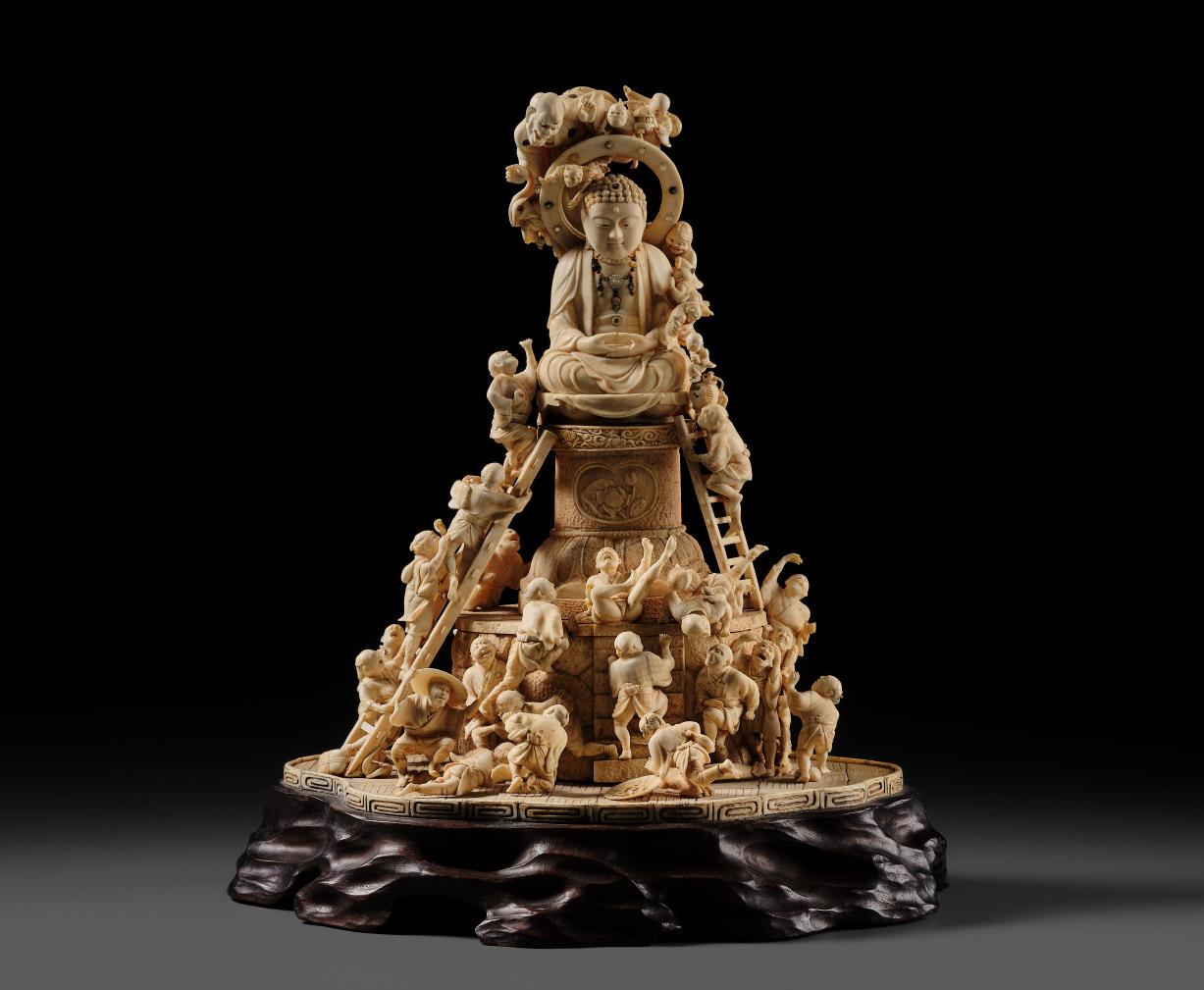
199 A SUPERB AND LARGE CARVED IVORY OKIMONO OF A PARADE OF YOKAI DISTURBING THE CLEANING OF THE BUDDHA
Japan, Meiji period (1868-1912)
An exceptional and intricately carved ivory okimono depicting an extraordinary scene in which a host of yokai, Japan’s mischievous and often malevolent spirits, infiltrate and disrupt the ritual cleansing of the Buddha.
The Buddha, distinct from the Great Buddha of Nara, is shown serenely seated upon a lofty, tiered pedestal, its surfaces exquisitely carved to evoke the texture of bronze and adorned with panels of lotus blooms and scrolling tendrils. The pedestal rises from a tiled platform, all mounted upon a naturalistic wooden base suggestive of rugged terrain.
Around the sacred figure, a multitude of monks climb ladders, scale the base, or kneel in prayer, performing the annual purification of the holy image. Yet the ceremony has been thrown into chaos: yokai and demons swarm over the aureole, intruding upon the rite. Among them are an oni, a tengu, a three-eyed spirit, a oneeyed monster, and even the cheerful Okame, caught amid the pandemonium. Some monks fall in fright, others persist in their pious duty, creating a densely animated and masterfully carved scene of disorder clashing with devotion.
The Buddha himself is rendered with profound calm in kekka fuza (dhyanasana), hands folded in mida join (dhyana mudra). His loosely draped robes cascade in deep, naturalistic folds, adorned with an inlaid Shibayama-style necklace of coral and mother-of-pearl. The plump, meditative face, with downcast eyes beneath arched brows and a pronounced byakugo (urna), radiates tranquil detachment amid the turmoil. The hair is arranged in tight curls surmounted by an inlaid nikkeishu (jewel of wisdom), the head backed by a pierced circular kohai (aureole).
The ivory okimono is firmly mounted on a finely carved, shaped wood base.
HEIGHT 35 cm (including base)
Condition: Very good condition with minor wear and natural imperfections, including few expected age cracks and fissures. One of the kneeling figures at the foot of the pedestal slightly loose, possibly reattached. Few minute nicks and minuscule nibbling along the edges of the platform. The okimono is firmly mounted on a wood base.
Through this scene of playful yet profound tension, the artist captures both the humor and the holiness of devotion under duress, a quintessential expression of Meiji-era virtuosity and imagination.
Estimate EUR 6,000
Starting price EUR 3,000
The composition draws on the Buddhist practice of cleansing sacred icons, symbolizing the removal of worldly defilements. While reminiscent of the Ominugui ceremony held at Todaiji in Nara, where the Great Buddha (Daibutsu) is purified each year, this imaginative carving instead envisions another Buddha under spiritual siege. Here, the incursion of yokai transforms the ritual act into an allegory of the eternal struggle between purity and corruption, enlightenment and chaos.

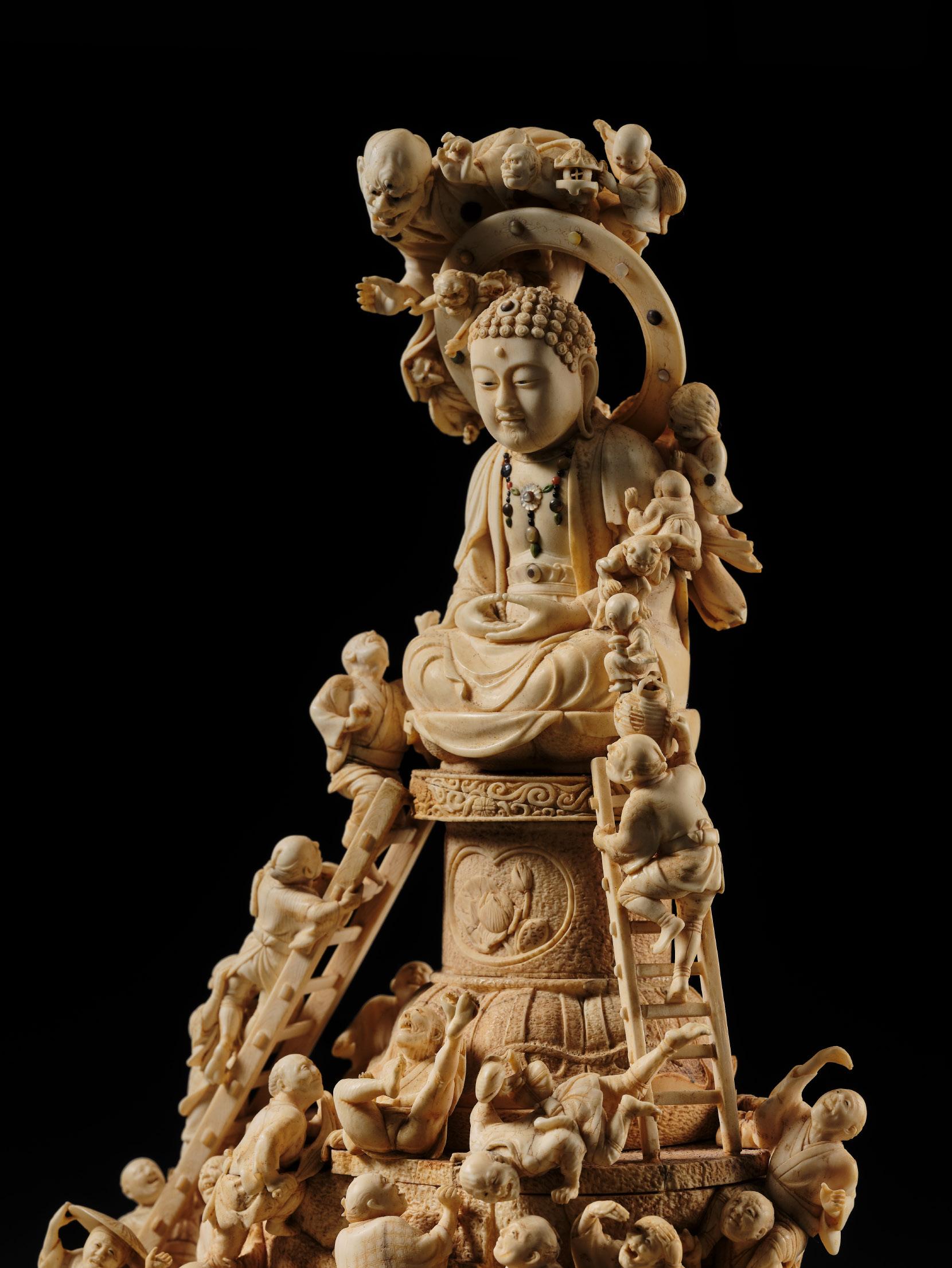

Lots 200 to 245

200
A FINE CLOISONNÉ ENAMEL VASE WITH HO-O AND CHRYSANTHEMUMS IN THE STYLE OF NAMIKAWA
Japan, c. 1870-1880, early Meiji period (1868-1912)
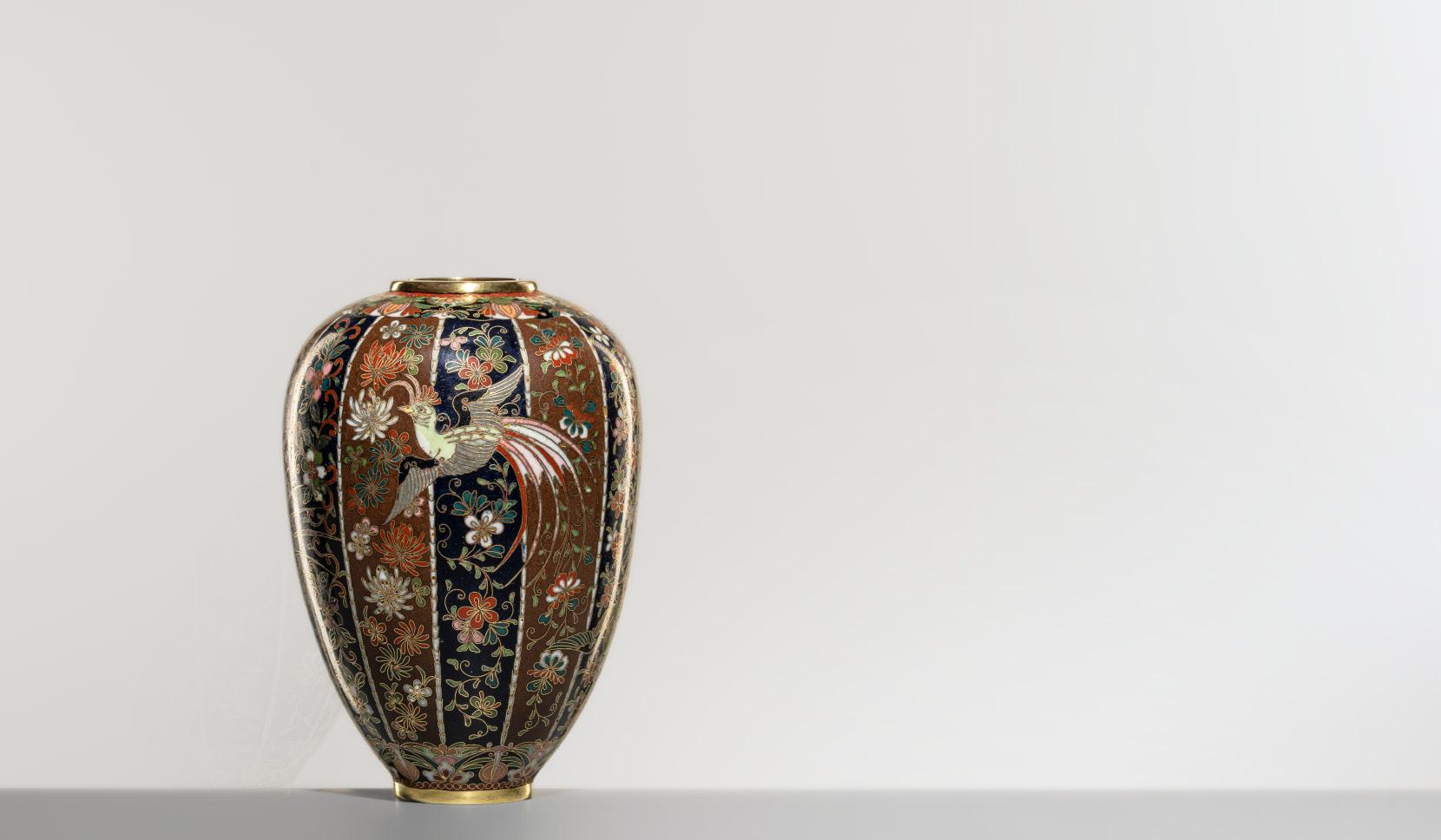

Of globular form, mounted with gilt rims, the rounded shoulder rising to a circular mouth. The body finely enameled with gold and silver wire, depicting blossoming chrysanthemums among further flowerheads and scrolling tendrils, arranged in alternating panels of midnight blue and chestnut-brown ground, with four stylized ho-o birds (phoenixes) soaring above the design, all framed above and below by luxuriant floral motifs and beaded bands.
HEIGHT 12.8 cm
WEIGHT 228.3 g
Provenance: From the Alan Bostock collection of Japanese metalwork and cloisonné, assembled over the last 40 years.
Condition: Very good condition with wear, inherent manufacturing irregularities, and minor traces of use. Scattered tiny losses to enamels, also all manufacturing-inherent. Typical wear to the gilt mounts.
AUCTION COMPARISON
Compare a related cloisonné enamel vase with alternating panels decorated with flowers and fluttering butterflies, attributed to Namikawa Yasuyuki, late Meiji period, 12.1 cm high (sold at Christie’s, Edo to Post-War: 500 Years of Japanese Art and Design, 15 November 2017, New York, lot 1, for USD 2,750 or approx. EUR 3,000 converted and adjusted for inflation at the time of writing).
Estimate EUR 1,500
Starting price EUR 800
201 A VERY FINE CLOISONNÉ ENAMEL VASE WITH AN ABUNDANCE OF FLOWERS
Sealed Ki Japan, Meiji period (1868-1912)


The faceted baluster body supported on a waisted foot, the rounded shoulder rising to a slender neck with a flared mouth. The exterior finely enameled in vibrant colors with silver wire on a midnight-blue ground to depict a gnarled tree with luxuriant wisteria branches within a fenced garden, alongside blossoming chrysanthemums, irises, maple, hibiscus, and lilies, next to a large scholar’s rock. The scene framed at the foot and neck by petaled bands. The base sealed Ki 木 – likely relating to Hayashi Kihyoe (1848-1931) or Hayashi Kodenji (1831-1915).
HEIGHT 24.9 cm
WEIGHT 322.2 g
Provenance: From the Alan Bostock collection of Japanese metalwork and cloisonné, assembled over the last 40 years. Condition: Very good condition with minor wear and manufacturing flaws. Few minute losses to the gilt wire. A few light surface scratches to the neck.
AUCTION COMPARISON
Compare a related cloisonné enamel vase with wisteria and waterlilies, Meiji period, late 19th century, 18 cm high, at Christie’s, The Avo Krikorian Collection: Innovation and Inspiration of Meiji Period Design, 19 February 2007, Geneva, lot 185 (sold for CHF 16,800 or approx. EUR 19,500 converted and adjusted for inflation at the time of writing).
Estimate EUR 2,000
Starting price EUR 1,000
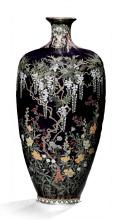

202
A PAIR OF CLOISONNÉ ENAMEL
‘SEA EAGLE’ BALUSTER VASES
Japan, Meiji period (1868-1912)
Decorated in mirror image, each finely worked in silver wire of varying gauge and brightly enameled to depict an eagle perched on a wave-lashed rock, its wings partially outstretched, eyeing its prey, a pair of chidori (plovers) making their escape above the tumultuous waters, all reserved on a midnight-blue ground, framed by bands of key-fret below the mouth and above the foot applied with silver rims. The interior and base enameled in dark green. The silver rims each with a stamped hallmark, ‘silver’.
HEIGHT 24.7 cm (each)
WEIGHT 666.2 g and 643 g
Condition: Excellent condition with minor wear and manufacturing irregularities including minimal pitting.
AUCTION COMPARISON
Compare a closely related single vase, also dated to the Meiji period, 31.2 cm high, at Bonhams, Fine Japanese Art, 17 May 2018, London, lot 518 (sold for GBP 16,875 or approx. EUR 28,000 converted and adjusted for inflation at the time of writing).
Estimate EUR 4,000
Starting price EUR 2,000



203
A PAIR OF CLOISONNÉ ENAMEL VASES WITH WRITHING DRAGONS
Japan, late 19th century, Meiji period (1868-1912)
Each of faceted baluster form, mounted with silver rims, supported on a slightly splayed foot and rising to high-angled shoulders with a waisted neck and a flared mouth. Each finely decorated in polychrome enamels against a deep midnight-blue ground, depicting a coiling three-clawed dragon, its scaly body meticulously rendered. The scene framed above and below by encircling beaded bands at the neck and foot.
With an associated padded tomobako (storage box).
HEIGHT 15.4 cm (each)
WEIGHT 227.1 g and 232.5 g
Condition: Excellent condition with only minor wear and manufacturing-inherent irregularities.
Estimate EUR 2,000
Starting price EUR 1,000
204
A PAIR OF CLOISONNÉ ENAMEL VASES WITH RED-CAPPED CRANES
Japan, Meiji period (1868-1912)
Each of faceted baluster form, mounted with silver rims, supported on a splayed foot and rising to rounded, high-angled shoulders with a slender neck and a flared mouth. The body finely decorated in colored enamels outlined with silver wire to depict a group of redcapped cranes (tancho tsuru), their plumage naturalistically rendered, set against a lustrous midnight-blue ground. The scene framed above and below by encircling bands of floral designs.
With an associated padded tomobako (storage box).
HEIGHT 15.7 cm (each)
WEIGHT 146.8 g and 155.4 g
Provenance: A private collection in London, United Kingdom, by the early 20th century.
A private collection in Inverness, Scottland, thence by descent. Christie’s, Japanese Art and Design, 13 May 2009, London, lot 60, estimated at GBP 1,500 or approx. EUR 3,500 converted and adjusted at the time of writing.
Condition: Excellent condition with only minor wear and manufacturing-inherent irregularities.
Estimate EUR 1,500
Starting price EUR 800
205 A LARGE CLOISONNÉ ENAMEL VASE WITH WRITHING DRAGONS
Japan, late 19th century, Meiji period (1868-1912)
Of baluster form, mounted with gilt-copper rims, supported on a splayed foot and rising to rounded shoulders with a waisted neck and a flared mouth. The body finely enameled against a deep scarlet-red ground, depicting a pair of coiling three-clawed dragons, their scaly bodies meticulously detailed, each detailed with a ferocious expression with gaping jaws revealing sharp fangs and a curling tongue. The scene framed above and below by bands of foliate and geometric designs at the neck and foot.
HEIGHT 51.2 cm
WEIGHT 3,180 g
Condition: Good condition with minor wear and manufacturing-inherent irregularities. Cracks to the interior, a small bruise to the neck with associated radiating cracks and losses, and a few cracks to the lower body. Few minute losses to enamels and light surface scratches throughout. Light warping and few minor dents to the metal rims with expected rubbing to gilt. Overall presenting very well.
Estimate EUR 2,500
Starting price EUR 1,200

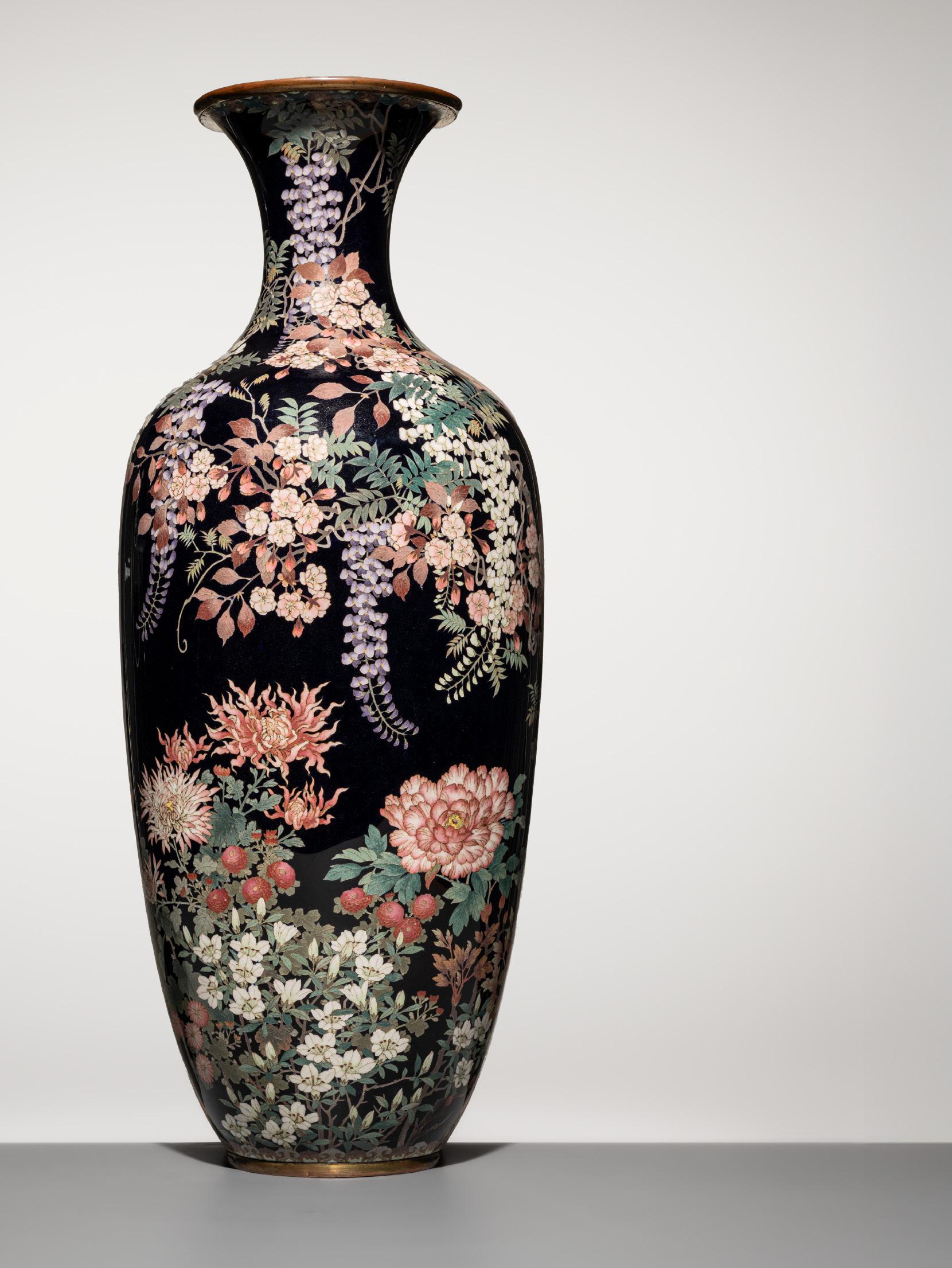
206 A VERY LARGE CLOISONNÉ ENAMEL VASE WITH BLOSSOMING FLOWERS
Japan, late 19th century, Meiji period (1868-1912)
Of baluster form, tapering towards the foot and rising to rounded shoulders with a waisted neck and a flared mouth. The body minutely decorated in vibrant polychrome enamels outlined with gilt-copper wire against a lustrous black ground, depicting a verdant scene of lush branches with chrysanthemums, peonies, cherry blossoms, and wisteria in full bloom amidst leafy stems. The composition framed above and below by encircling bands of foliate and geometric motifs at the neck and foot.
HEIGHT 58.2 cm
WEIGHT 3,068 g
Condition: Excellent condition, which is remarkable for this type. Only few manufacturing inherent irregularities and minor wear to the metal mounts.
AUCTION COMPARISON
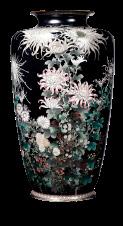
Compare a related cloisonné enamel vase with flowering chrysanthemums, Meiji period, 46.2 cm high, at Bonhams, Fine Japanese Art, 11 June 2003, London, lot 452 (sold for GBP 3,585 or approx. EUR 7,600 converted and adjusted for inflation at the time of writing).
Estimate EUR 4,000
Starting price EUR 2,000
207
GONDA HIROSUKE: A SUPERB AND LARGE CLOISONNÉ ENAMEL VASE WITH BLOSSOMING CHRYSANTHEMUMS
By Gonda Hirosuke (1865-1937), signed with the mark of Gonda Hirosuke Japan, early 20th century, Meiji (1868-1912) to Taisho period (1912-1926)
Of baluster form, mounted with copper rims, supported on a splayed foot and rising to rounded shoulders with a waisted neck and a flared mouth. The body skillfully decorated in bright polychrome enamels outlined with gilt-copper wire against a pale blue ground to depict leafy stalks with blossoming chrysanthemums. The base incised with the mark of Gonda Hirosuke in the shape of a flaming pearl (tama).
HEIGHT 47.3 cm
WEIGHT 2,045 g
Provenance: From the Alan Bostock collection of Japanese metalwork and cloisonné, assembled over the last 40 years.
Condition: Excellent condition, exhibiting only minor wear and inherent manufacturing irregularities such as light pitting and a few dark spots. Given the size and typical condition expectations for this type of ware, the present vase remains in remarkably pristine state.
Gonda Hirosuke (1865–1937) was adopted into the Gonda family in 1887 and trained under Hayashi Kodenji. He established his own enameling workshop in Nagoya in 1891. Recognized for his exceptional skills, he also collaborated as a subcontractor with the Ando Jubei workshop, producing cloisonné enamels in a wide range of techniques, becoming over time one of the leading figures of the so-called golden age of Japanese cloisonné. He received numerous awards at international expositions, including Paris (1889), Chicago (1893), St. Louis (1904), and Liège (1905).
AUCTION COMPARISON

Compare a related cloisonné enamel vase with leafy stalks of flowering poppies, by Gonda Hirosuke, Meiji or Taisho period, early 20th century, 47 cm high, at Bonhams, Samurai, Beauties, and Townsmen, 18 May 2023, London, lot 190 (sold for GBP 5,737 or approx. EUR 7,500 converted and adjusted for inflation at the time of writing).
Estimate EUR 3,000 Starting price EUR 1,500


208
A SUPERB CLOISONNÉ ENAMEL VASE WITH SPARROWS AND CHRYSANTHEMUMS, ATTRIBUTED TO THE WORKSHOP OF HAYASHI KODENJI
Japan, late Meiji period (1868-1912)
The broad body, mounted with silver rims, supported on a short waisted foot, its rounded shoulders rising to a short neck with a flared mouth. The exterior exquisitely enameled to depict luxuriant chrysanthemum branches in various stages of bloom, interspersed with further flowerheads, a sparrow perched delicately upon one branch, while others are shown in flight across the scene, against a lustrous cobalt-blue ground. The foot and neck finely decorated with pointed bands of stylized flowerheads and beaded borders.
HEIGHT 23.9 cm
WEIGHT 1,420 g
Condition: Excellent condition with only minor wear, few typical manufacturing irregularities, and a small dent to the silver foot ring.
MUSEUM COMPARISON
Compare a related cloisonné enamel vase with blossoming chrysanthemums, attributed to Hayashi Kodenji, Meiji period, dated c. 1902, 12.1 cm high, in the Smithsonian National Museum of Asian Art, accession number F1996.5.1a-b.
AUCTION COMPARISON
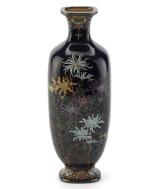

Compare a related cloisonné enamel vase with sparrows flying among wisteria and chrysanthemum, attributed to Hayashi Kodenji, Meiji period, dated c. 1900, 31.8 cm high, at Bonhams, Fine Japanese and Korean Art, 21 March 2018, New York, lot 2231 (sold for USD 11,250 or approx. EUR 12,500 converted and adjusted for inflation at the time of writing).
Estimate EUR 2,500
Starting price EUR 1,200
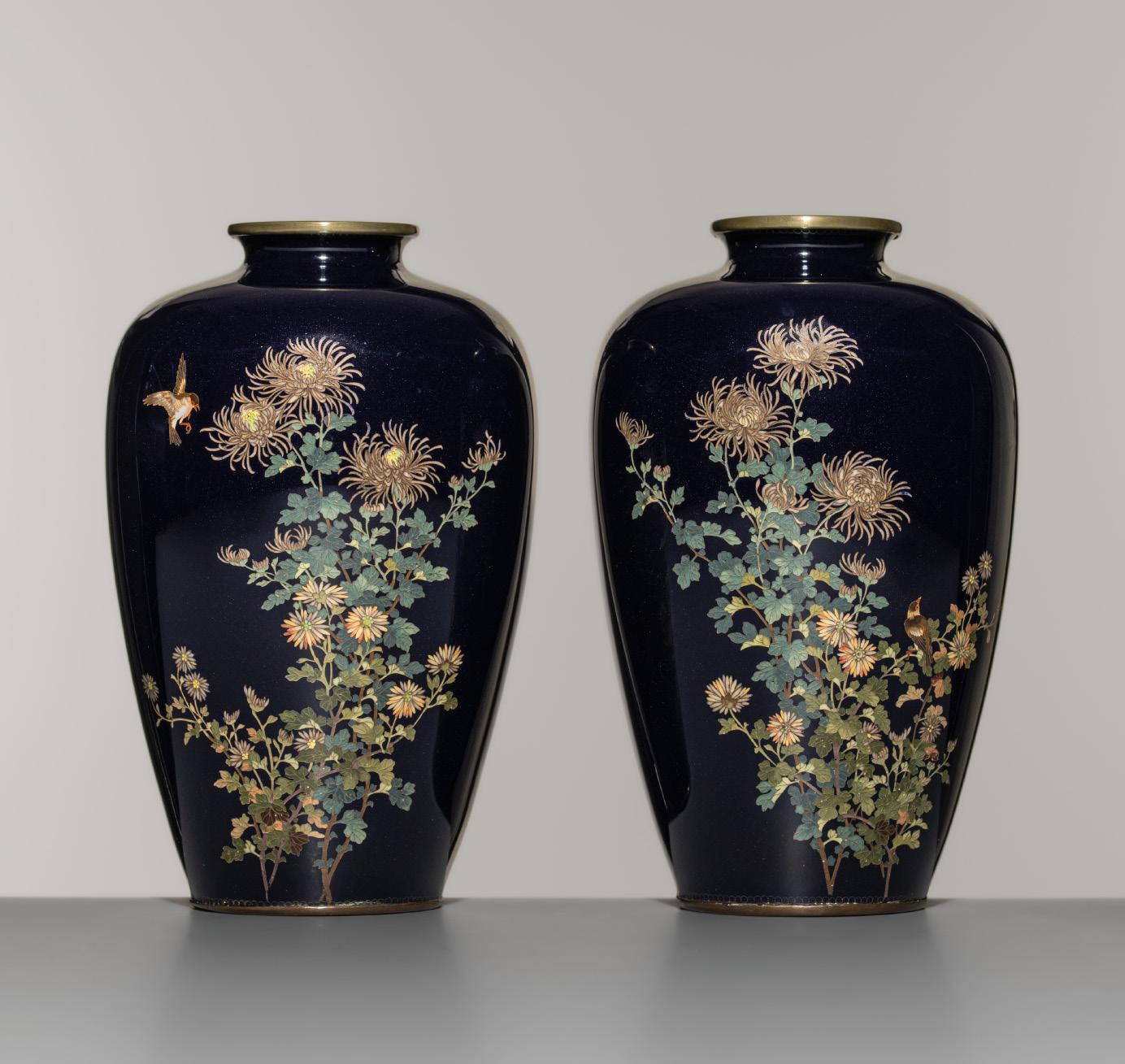
209
A PAIR OF FINE CLOISONNÉ ENAMEL VASES WITH SPARROWS AND CHRYSANTHEMUMS, ATTRIBUTED TO THE WORKSHOP OF HAYASHI KODENJI
Japan, late Meiji period (1868-1912)
Each of baluster form, with rounded shoulders tapering to a short neck and flared rim. The deep midnight-blue ground is finely worked in gold and silver wire, depicting luxuriant chrysanthemums (kiku) and other blossoms borne on sweeping leafy stems. On one vase, a sparrow perches lightly upon a stalk, its head lifted skyward; on the other, a companion sparrow hovers in mid-flight above the blooms.
HEIGHT 15.9 cm (each)
WEIGHT 331.5 g and 348.2 g
Condition: Excellent condition with only very few typical manufacturing irregularities and some very light surface scratches.
Hayashi Kodenji (1831-1915) was a pivotal figure in the history of cloisonné enameling and instrumental in the formation and leadership of the Shippo-cho enamelers guild, and it is probable that he worked for the Nagoya-based Shippo Kaisha. As well as
being an innovative enameler he was also an astute businessman. Stories are told that in his early days he walked from Nagoya to Yokohama to sell his wares at a time when there was a longstanding prohibition on selling copper (which included the body of the cloisonné objects). He worked with his son, Kodenji II, for over 40 years and it is often hard to differentiate the work of the two makers. He exhibited and won prizes at many international exhibitions: Nuremberg 1885 (silver), Paris 1889 (silver) and St Louis 1904 (gold). In 1912, Glendining of London auctioned over 300 ‘Japanese cloisonné enamels from the Glasgow Exhibition offered for sale by Mr. K Hayashi of Nagoya’.
AUCTION COMPARISON
Compare a closely related larger pair of cloisonné enamel vases with chrysanthemum and butterflies, attributed to Hayashi Kodenji, Meiji period, dated late 19th to early 20th century, 47 cm high (each), at Bonhams, Fine Japanese Art, 16 May 2024, London, lot 111 (sold for GBP 10,240 or approx. EUR 12,500 converted and adjusted for inflation at the time of writing).
Estimate EUR 2,500
Starting price EUR 1,200


210
HAYASHI TANIGORO: AN UNUSUAL ‘ART NOUVEAU’ MOSAIC-CLOISONNÉ
By Hayashi Tanigorō (active c. 1895–1935), sealed Hayashi Tani Japan, Meiji period (1868-1912) to early Taisho period (1912–1926)
Of large globular form, supported on a circular foot with silver rims at the mouth and base. The body is finished in deep-blue enamel, encircled at the shoulder by a broad mosaic cloisonné band composed of minute brocade-shaped cloisons, each filled with polychrome enamels to create a tessellated field. The precise wirework and carefully leveled surface result in a textile-like effect. The base with the rectangular Hayashi Tanigorō mark inlaid in silver wire, and a silver stamp to the foot rim.
HEIGHT 17.1 cm
Provenance: From the Alan Bostock collection of Japanese metalwork and cloisonné, assembled over the last 40 years.
Condition: Very good condition with a small flaw to the shoulder and an abrasion to the underside near the signature.
Hayashi Tanigoro’s workshop was active at a time when Japanese cloisonné was closely aligned with international decorative trends. While his better-known works emphasize botanical or avian motifs, some pieces reveal a responsiveness to European Art Nouveau, particularly in the use of repeating patterns, stylized
ornament, and an interest in surface harmony. The present vase, with its tessellated mosaic band, can be understood within this context of cross-cultural exchange.
AUCTION
COMPARISON


Compare a related cloisonné enamel vase with an unusual brocade ground, mark of Hayashi Tanigoro Studio, Meiji period (late 19th century), 35 cm high, at Christie’s, The Avo Krikorian Collection: Innovation and Inspiration of Meiji Period Design, 19 February 2007, Zurich, lot 208 (sold for CHF 30,000, or approx. EUR 35,000 converted and adjusted for inflation at the time of writing). Compare also a related pair of cloisonné enamel vases in the Art Nouveau style, mark of Hayashi Tanigoro Studio, Meiji period (circa 1900), each 33.7 cm high, at Christie’s, An Inquiring Mind: American Collecting of Japanese & Korean Art, 25 April 2017, New York, lot 76 (sold for USD 12,500, or approx. EUR 14,000 converted and adjusted for inflation at the time of writing).
Estimate EUR 2,000
Starting price EUR 1,000
211
HAYASHI HACHIZAEMON: A MORIAGE FISHNET AND GINBARI CLOISONNÉ ENAMEL VASE DEPICTING CHERRY BLOSSOMS
By Hayashi Hachizaemon (c. 1850-1908), sealed Hachi
Japan, late 19th to early 20th century, Meiji period (1868-1912)
The slender baluster body, mounted with silver rims, supported on a splayed foot and rising to a short neck with a flared mouth. The exterior finely decorated in blue silver-foil ginbari with a delicately incised palm-patterned ground and vibrant enamels outlined with silver wire to depict cherry blossoms on leafy branches, overlaid with a raised enamel net pattern worked in moriage. Sealed to the metal base HACHI (Hayashi Hachizaemon).
HEIGHT 15.5 cm
WEIGHT 242.3 g
Condition: Very good condition with minor wear and manufacturing irregularities. Expected light surface scratches and one minor dent to the silver base.
AUCTION COMPARISON
For another work by the artist see Bonhams, Fine Japanese Art, 13 September 2017, New York, lot 1008 (sold for USD 2,750 or approx. EUR 3,000 converted and adjusted for inflation at the time of writing).
Estimate EUR 2,000
Starting price EUR 1,000 212
Japan, Meiji period (1868-1912)



The deep, rounded sides rise gracefully from three short feet, the mouth and feet applied with silver rims. The body is finely worked in silver wire, filled with translucent enamels in a vibrant palette of red, violet, yellow, green, light blue, orange, and brown, creating a delicate interplay of color against a bubble-suffused ground. The exterior is decorated with a profusion of blossoms borne on leafy vines, the luminous translucency of the enamels enhancing their brilliance.
DIAMETER 11 cm
Provenance: From the Alan Bostock collection of Japanese metalwork and cloisonné, assembled over the last 40 years.
Condition: Good condition with minor typical manufacturinginherent flaws including cracks and pitting, some cracks with associated losses to the ground.
AUCTION COMPARISON
Compare a closely related pliqueà-jour bowl with floral design, late 19th century, at Christie’s Interiors, 2 April 2008, New York, lot 206 (sold for USD 3,000, or approx. EUR 3,800 converted and adjusted for inflation at the time of writing).
Estimate EUR 2,000 Starting price EUR 1,000
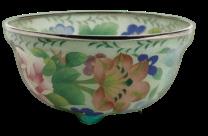
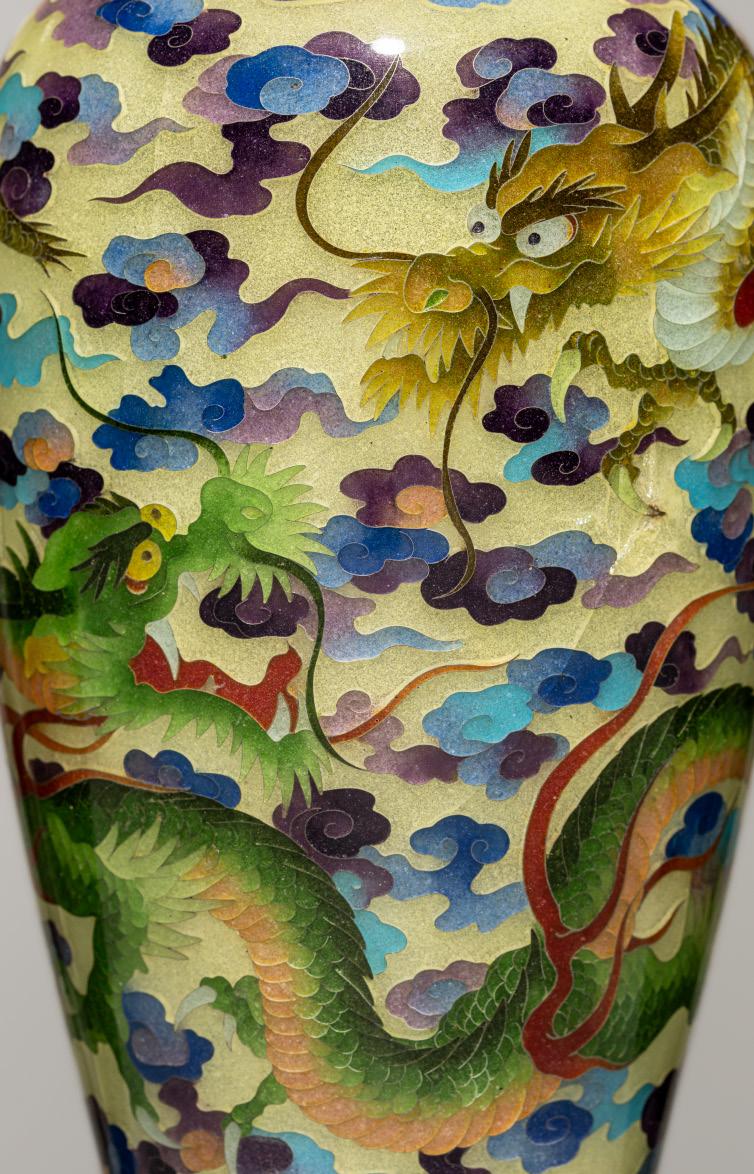
Japan, Meiji period (1868-1912)
The baluster body is supported on a short foot, the mouth and base applied with silver rims. The vessel is exquisitely worked in fine silver wire, filled with translucent enamels in shades of blue, green, purple, red, and yellow. Encircling the surface are two powerful celestial dragons, their sinuous bodies entwined in dynamic confrontation, their forms dramatically set against swirling clouds. The jewel-like translucency of the enamels heightens the sense of movement and energy, while the technical brilliance of the pliqueà-jour technique lends the mythical scene an ethereal radiance. Stamped to the silver rim to the underside jungin (pure silver).
HEIGHT 18.3 cm
Condition: Very good condition with minor inherent manufacturing flaws such as fine cracks and pitting, some with small associated losses to the ground. The most notable is to the upper dragon’s claw, discernible only by touch from the interior. The silver foot with some unevenness and light warping.
Plique-à-jour, known in Japan as shotai shippo, is among the rarest and most technically demanding cloisonné techniques. Adapted from French practice around 1900, it required Japanese craftsmen to suspend silver wires over a temporary backing, which was carefully removed during firing to leave the enamel cells freestanding, like stained glass with no solid ground. Each firing posed the risk of collapse, cracking, or warping, making successful pieces of this size and refinement exceptionally difficult to produce. The present bowl demonstrates the virtuosity of Meiji period enamelers in mastering this fragile medium, combining technical daring with a refined sensibility for color and composition.
While plique-à-jour bowls are already considered technically demanding, vases of this type are considerably rarer. The construction of a rounded, vertical form required the enamel to adhere evenly to suspended silver cloisons without the structural support of a backing. During firing, the risk of collapse or disintegration increased dramatically, as even minor tension or imbalance could cause the entire vessel to fail. For this reason, successful examples of plique-à-jour vases are exceptionally scarce, representing the pinnacle of Meiji-period experimentation and technical mastery in shotai shippo.
AUCTION COMPARISON
Compare a closely related plique-à-jour vase, dated late 19th century, of slightly smaller size, 15.2 cm high, Meiji period, at Christie’s, 13 July 2006, London, lot 399 (sold for 10,200 GBP, or approx. EUR 20,000 converted and adjusted for inflation at the time of writing).
Estimate EUR 8,000 Starting price EUR 4,000
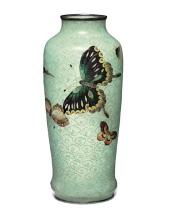

214
A FINE SOSUKE-STYLE CLOISONNÉ
ENAMEL BOX AND COVER DEPICTING MOUNT FUJI, ATTRIBUTED TO THE WORKSHOP OF ANDO JUBEI
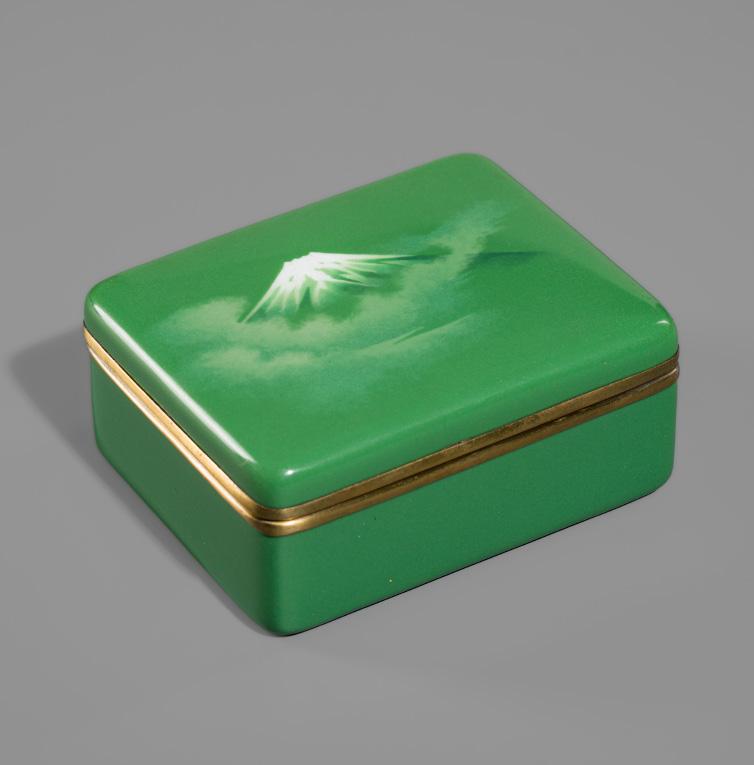
215
A FINE SOSUKE-STYLE CLOISONNÉ
ENAMEL BOX AND COVER DEPICTING A COASTAL LANDSCAPE WITH MOUNT FUJI, ATTRIBUTED TO THE WORKSHOP OF ANDO JUBEI
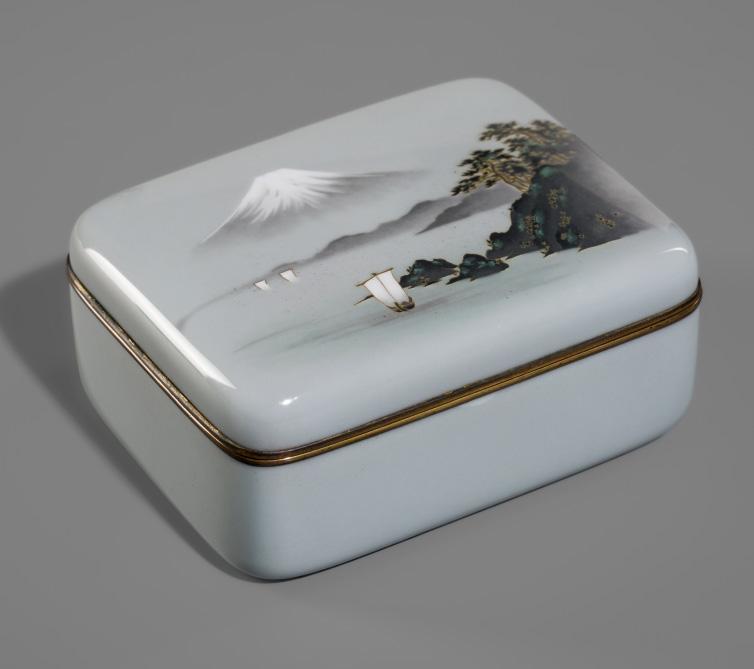
Japan, early 20th century, late Meiji (1868-1912) to Taisho period (1912-1926)
Of rectangular form with rounded corners, the exterior finely decorated in musen (wireless) enamels with a view of the snowcapped Mount Fuji in the mist on a bright emerald-green ground. The interior lined with silk brocade.
SIZE 4.6 x 8.6 x 10.3 cm
WEIGHT 385.4 g
Provenance: From the Alan Bostock collection of Japanese metalwork and cloisonné, assembled over the last 40 years. Condition: Very good condition with minor wear and manufacturing irregularities. Minimal traces of use. Tiny dents to the rims and light surface scratches, mostly to the base.
The present box, attributed to the workshop of Ando Jubei, is decorated in musen (“wireless”) enamels with a misty view of Mount Fuji on a brilliant green ground, in the painterly style pioneered by Namikawa Sosuke (1847–1910).
AUCTION COMPARISON
Compare a closely related cloisonné enamel cigarette box and cover with a scene of Mount Fuji, attributed to the Ando workshop, Taisho period, dated early 20th century, 5.6 x 10.1 x 13.3 cm, at Bonhams, Fine Japanese Works of Art, 16 March 2016, New York, lot 3205 (sold for USD 1,875 or approx. EUR 2,000 converted and adjusted for inflation at the time of writing).
Estimate EUR 1,000 Starting price EUR 500
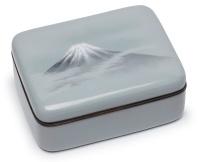
Japan, early 20th century, late Meiji (1868-1912) to Taisho period (1912-1926)
Of rectangular form with rounded corners, the exterior finely enameled combining musen (wireless) and standard techniques with gilt-copper wire on a pale blue ground to depict a rugged coastal landscape with lush trees growing upon the rocks. In the foreground, a boat sails close to the shore, while two further vessels appear on the distant horizon against the faraway coastline, beneath the misty presence of the snow-capped Mount Fuji. The interior lined with silk brocade.
SIZE 5.8 x 10.3 x 13.5 cm
WEIGHT 627.1 g
Condition: Very good condition with minor wear and inherent manufacturing flaws. Expected traces of use, mostly to the interior. Few minute nicks and light surface scratches to the rims.
AUCTION COMPARISON
Compare a related cloisonné enamel box and cover with a scene of Mount Fuji, by the workshop of Ando Jubei, Meiji period, dated late 19th century, 5.7 x 10.5 x 13.7 cm, at Bonhams, Fine Japanese Works of Art, 19 March 2014, New York, lot 3205 (sold for USD 1,625 or approx. EUR 2,000 converted and adjusted for inflation at the time of writing).
Estimate EUR 1,000
Starting price EUR 500


216
HAYASHI KIHYOE: A SUPERB PAIR OF SOSUKE STYLE CLOISONNÉ ENAMEL VASES WITH MOUNT FUJI AND PINE TREE
By Hayashi Kihyoe (1848–1931), sealed Ki Japan, early 20th century, Meiji period (1868-1912) to Taisho period (1912-1926)
Each of baluster form, mounted with gilt rims, supported on a slightly splayed foot and rising to rounded shoulders with a short neck and a flared mouth. The body finely decorated with musen (wireless) enamels, one depicting a lush pine tree, the other with a view of the snow-capped Mount Fuji emerging through the mist, set against a pale-blue ground. Marked to the base KI within the typical heart-shaped reserve.
HEIGHT 15.6 cm (each)
WEIGHT 330.3 g and 334 g (each)
Provenance: Sotheby’s, Japanese Works of Art from Private Collections, 28 September 2023, London, lot 130. From the Alan Bostock collection of Japanese metalwork and cloisonné, assembled over the last 40 years.
Condition: Excellent condition with only minor wear and manufacturing irregularities.
Hayashi Kihyoe (1848–1931) was among the leading makers employed by the Ando Company, renowned for its cloisonné enamels. Although the Hayashi family name seldom appears
on these works, pieces by Kihyoe were exhibited at prominent international and domestic expositions, including the Chicago Exposition (1893), the Fourth Domestic Exposition (1895), the Aichi Prefecture Exposition (1899), the Paris Exposition (1900), the Fifth Domestic Industrial Exposition (1903), the St. Louis Exposition (1904), and the Anglo-Japanese Exposition (1910).
After Sosuke’s death in 1910, the Ando workshop in Nagoya adopted and popularized the musen technique, producing refined works in the “Sosuke style” for both domestic and international markets. Alongside Namikawa Yasuyuki, Sosuke and Ando Jubei are regarded as the three masters whose innovations defined the golden age of Japanese cloisonné.
Musen, literally ‘wireless’, was a notable technique introduced into Japanese cloisonné art in the final decades of the nineteenth century, representing one of the most refined innovations of the period. In the conventional process, fine metal wires are affixed to a base to delineate the contours of a design, and vitreous enamel is then applied within the resulting cells. In the wireless method, however, the wires are carefully removed just before firing. During the sintering of the enamel, this procedure produces soft tonal gradations and blurred transitions, enabling effects comparable to painting in enamel. The musen technique garnered significant acclaim at the major international exhibitions of the late nineteenth century, a period in which Japan, following the Meiji Restoration, was actively engaging with the West.
Estimate EUR 3,000 Starting price EUR 1,500


By Ando Jubei (1876-1953), signed Ando zo and stamped with the company seal Japan, early 20th century, Meiji (1868-1912) to Taisho period (1912-1926)
Well-cast, the globular body supported on four small, rounded feet and rising to a short neck with a projecting rim. The exterior finely decorated in vivid enamels, depicting a large red lobster with elongated pincers and antennae amid an array of seashells, coral, and other aquatic grasses. The bronze surface neatly incised with chevron designs and bearing a rich, naturally grown patina. The censer, fitted with a cylindrical insert and a reticulated grid-shaped cover, signed to the underside ANDO zo [made by Ando] and stamped with the seal of the Ando workshop.
DIAMETER 30.4 cm
WEIGHT 2,472 g
Provenance: From a private collection in the Netherlands. Condition: Very good condition with minor wear, manufacturing irregularities, and expected traces of use. Minimal warping. Few minor nicks and light surface scratches.
Ando Jubei (1876-1953) was a Japanese cloisonné artist from Nagoya. He was the Meiji era’s most prolific creator of presentation wares (artworks that were commissioned by members of the Imperial Family for presentation to foreign dignitaries). He exhibited at the Japan-British Exhibition of 1910. Along with Hayashi Kodenji, he dominated Nagoya’s enameling industry in the late Meiji era. Ando, Namikawa Yasuyuki, and Namikawa Sosuke are considered the three artists whose technical innovations brought in a golden age for Japanese cloisonné in the late 19th century.
AUCTION COMPARISON
Compare a closely related enameled vase depicting a lobster with seashells, Meiji to Taisho period, early 20th century, 32.4 cm high, at Christie’s, Japanese and Korean Art, 11 September 2012, New York, lot 124 (sold for USD 4,375 or approx. EUR 5,500 converted and adjusted for inflation at the time of writing).

Estimate EUR 4,000
Starting price EUR 2,000


A RARE BLUE AND WHITE ARITA PORCELAIN
‘CARP’ HANA-IKE (FLOWER VASE)
Japan, late 17th to 18th century, Edo period (1615-1868)
Naturalistically modeled in the form of a carp with gaping mouth, leaping up from turbulent waves that crash against craggy rocks. The scaly body of the animal meticulously rendered in fine washes of underglaze blue. A suspension hole pierced through the back of the vessel. The base left unglazed, revealing the buff-colored ceramic underneath.
HEIGHT 31.7 cm
Provenance: The private collection of Jules Speelman, London, United Kingdom.
Condition: The upper end with signs of restoration. Otherwise, very good condition with minor wear and firing irregularities, including pitting, few dark spots, and hairline cracks. One small chip to the rim of the vessel.
AUCTION COMPARISON
Compare a closely related Imari blue and white hana-ike (flower vase), dated late 17th to early 18th century, 31.2 cm high, at Bonhams, Fine Japanese Art, 15 May 2014, London, lot 482 (sold for GBP 1,125 or approx. EUR 2,000 converted and adjusted at the time of writing).
Estimate EUR 2,000 Starting price EUR 1,000
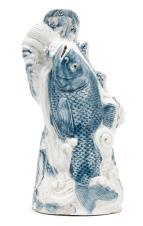

219
A FOUR-TIERED ARITA BLUE AND WHITE PORCELAIN JUBAKO (STACKING BOX AND COVER)
Japan, 17th century, Edo period (1615-1868)
Finely potted, of square form, the exterior elaborately painted in underglaze blue, each side with a shaped cartouche depicting, respectively, lush pine trees, blossoming cherry trees, and towering bamboo stalks, all set against a manji-patterned ground and framed by waves. The slightly domed cover further decorated with a cartouche containing flowering peonies on similarly patterned ground.
HEIGHT 20.8 cm
of Japanese aesthetics. Under Jules Speelman’s direction, the gallery is now among the foremost in the field. In 2024, the 28-lot sale of the Jules Speelman Collection at Bonhams totaled €15.2 million, far exceeding its €4.2 million estimate. Asaph Hyman, Global Head of Chinese Ceramics and Works of Art at Bonhams, praised Speelman as ‘one of the greatest and most respected dealers and collectors’, renowned for his keen eye for rarity and quality. Condition: Excellent condition with only minimal wear and firinginherent irregularities.
MUSEUM COMPARISON

Provenance: The private collection of Jules Speelman, London, United Kingdom. Jules Speelman, a world-renowned dealer and collector of East Asian art, has over 60 years of experience. He joined his late father, Alfred, in 1964, continuing a family business that dates back three generations to 19th-century Holland and later expanded to England. Originally dealing in European antiques, A & J Speelman gradually shifted its focus to Asian art, particularly figurative sculpture and works of art from the past 2,000 years. Over the decades, the firm also built an important reputation in the field of Japanese art, assembling and handling notable collections that contributed to deepening Western appreciation and understanding
Compare a related four-tiered blue and white porcelain stacking box and cover (jubako), Edo period, c. 1775-1824, 32.5 cm high, in the Rijksmuseum, Amsterdam, object number AK-NM-6661.
AUCTION COMPARISON
Compare a related four-tiered Arita box and cover, Edo period, 17th-18th century, 17 cm high, at Christie’s, The Soame Jenyns Collection of Japanese and Chinese Art, 8 November 2018, London, lot 82 (sold for GBP 20,000 or approx. EUR 33,000 converted and adjusted at the time of writing).
Estimate EUR 2,000
Starting price EUR 1,000


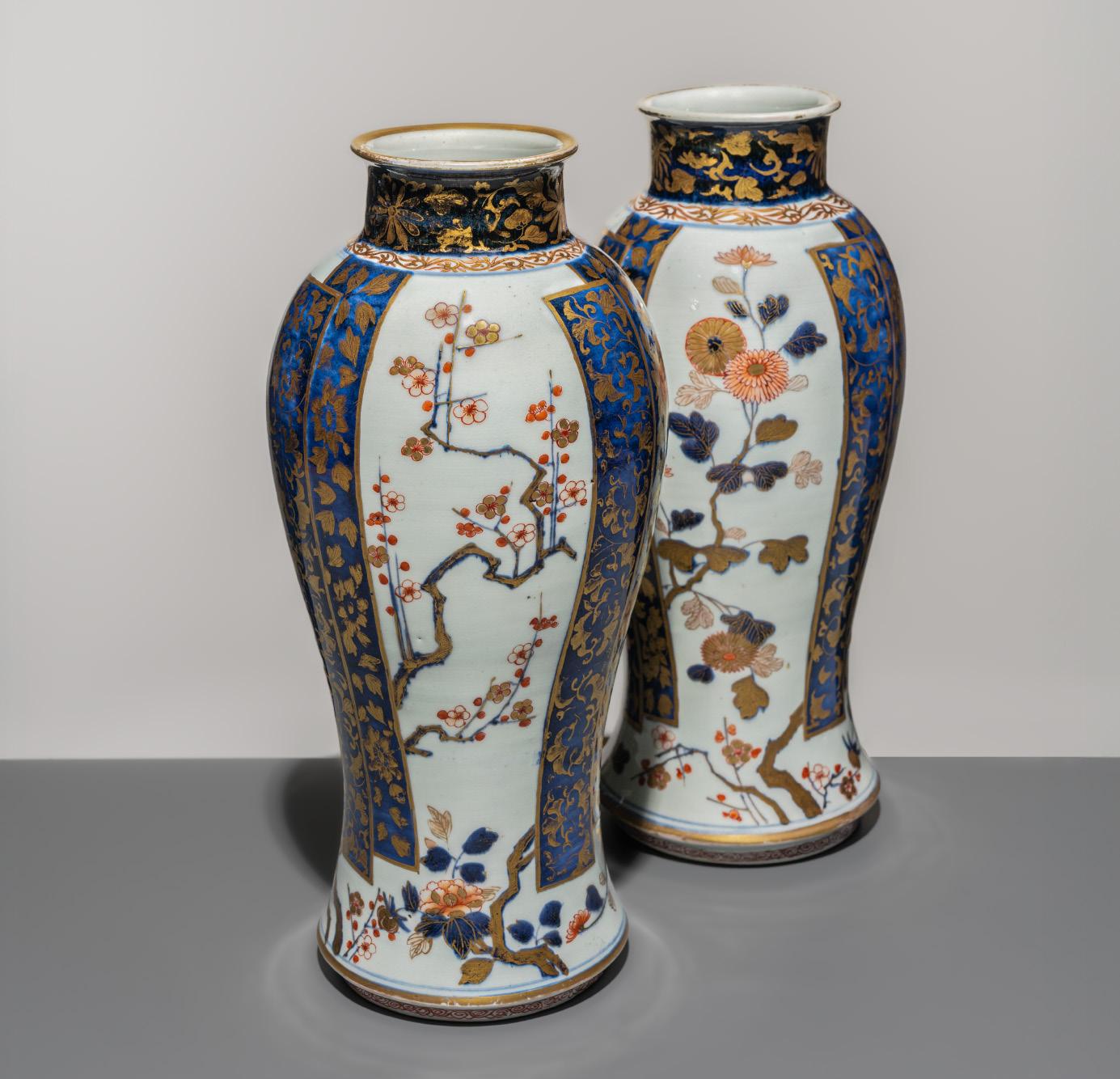
A PAIR OF LARGE IMARI PORCELAIN VASES DEPICTING BLOSSOMING FLOWERS
Japan, 18th century, Edo period (1615-1868)
Each well-potted vase features a baluster-form body supported on a splayed foot, rising to a straight neck with an everted rim. The exterior is finely decorated in polychrome enamels with alternating panels, each depicting luxuriant stalks of peony blossoms, flowering chrysanthemums, or blooming plum branches. These floral scenes are framed by vertical bands of rich gilt foliage set against a deep cobalt-blue ground. Below, the composition is bordered by encircling bands in gilt and red tones, while the upper sections are adorned with additional scrolling tendrils and stylized flower heads, also rendered on a similarly painted cobalt-blue ground. The rim is delicately accented with gilt, completing the elegant and harmonious design.
HEIGHT 33.8 cm (each)
Provenance: The private collection of Jules Speelman, London, United Kingdom. Jules Speelman, a world-renowned dealer and collector of East Asian art, has over 60 years of experience. In 2024, the 28-lot sale of the Jules Speelman Collection at Bonhams totaled
€15.2 million, far exceeding its €4.2 million estimate. Asaph Hyman, Global Head of Chinese Ceramics and Works of Art at Bonhams, praised Speelman as one of the greatest and most respected dealers and collectors’, renowned for his keen eye for rarity and quality. Condition: Very good condition with minor wear and firing irregularities and flaws, including but not limited to pitting and minute hairline fissures. Light rubbing to enamels and gilding.
AUCTION COMPARISON
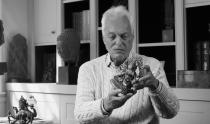
Compare a related larger Imari trumpet vase, with similar reserves and gilt accents on a dark blue ground, Edo period, late 17th century, 52 cm high, at Christie’s, Cheyne Walk, An Interior by Victoria Press and a House on Ham Common, The Collection of Tom Craig, 18 November 2015, London, lot 57 (sold for GBP 4,375 or approx. EUR 8,000 converted and adjusted for inflation at the time of writing).
Estimate EUR 3,000
Starting price EUR 1,500



Japan, 18th century, Edo period (1615-1868)
Each with a pear-shaped body on a short foot and a slender, tapering neck. The exterior is decorated in vibrant enamels with cartouches of cherry and pine trees, symbols of renewal and longevity, against a deep cobalt-blue ground with gilt scrolls and chrysanthemum crests. A vermilion criss-cross band encircles the foot, while the shoulders bear a blue key-fret band and turquoise petals. The neck is adorned with scrolling tendrils below a gilt rim, completing the design.
HEIGHT 23.4 cm (each)
Provenance: The private collection of Jules Speelman, London, United Kingdom.
Condition: Very good condition with minor wear and firing irregularities, including pitting and hairline cracks, one of which cleverly concealed by the roots of a flower. Light rubbing to enamels, mostly to the rims. Both bottle vases with a small loss to the glaze at the neck.
MUSEUM COMPARISON
Compare a closely related Imari porcelain bottle vase, Edo period, 1700-1720, 22.2 cm high, in the Metropolitan Museum of Art, object number 1995.268.49.
Estimate EUR 2,000
Starting price EUR 1,000
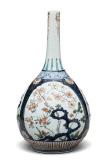
222
A PAIR OF IMARI PORCELAIN ‘CHRYSANTHEMUM’ TOKKURI (SAKE FLASKS)
Japan, 18th century, Edo period (1615-1868)
Each square flask has sloping shoulders tapering to a flat base and a short neck with an everted rim. Decorated in polychrome enamels and gilt, the sides show panels of chrysanthemums framed by cobalt-blue borders with gilt scrolls. The shoulders bear cartouches with chrysanthemum blooms in iron-red and gilt on a cobalt ground. The necks feature an iron-red dragon beneath double blue lines, the rims are gilt, and the unglazed bases reveal the buff ceramic body.
HEIGHT 22.6 cm (each)
Provenance: The private collection of Jules Speelman, London, United Kingdom.
Condition: Very good condition with minor wear and firing irregularities. Light rubbing to enamels and few minute touchups, as is to be expected.
AUCTION COMPARISON
Compare a related pair of Imari sake bottle vases (tokkuri) with flowering chrysanthemum blossoms, Edo period, c. 1800, 26.6 cm high, at Christie’s, Japanese and Korean Art, dated c. 1800, New York, lot 128 (sold for USD 7,475 or approx. EUR 6,500 converted).
Estimate EUR 3,000
Starting price EUR 1,500

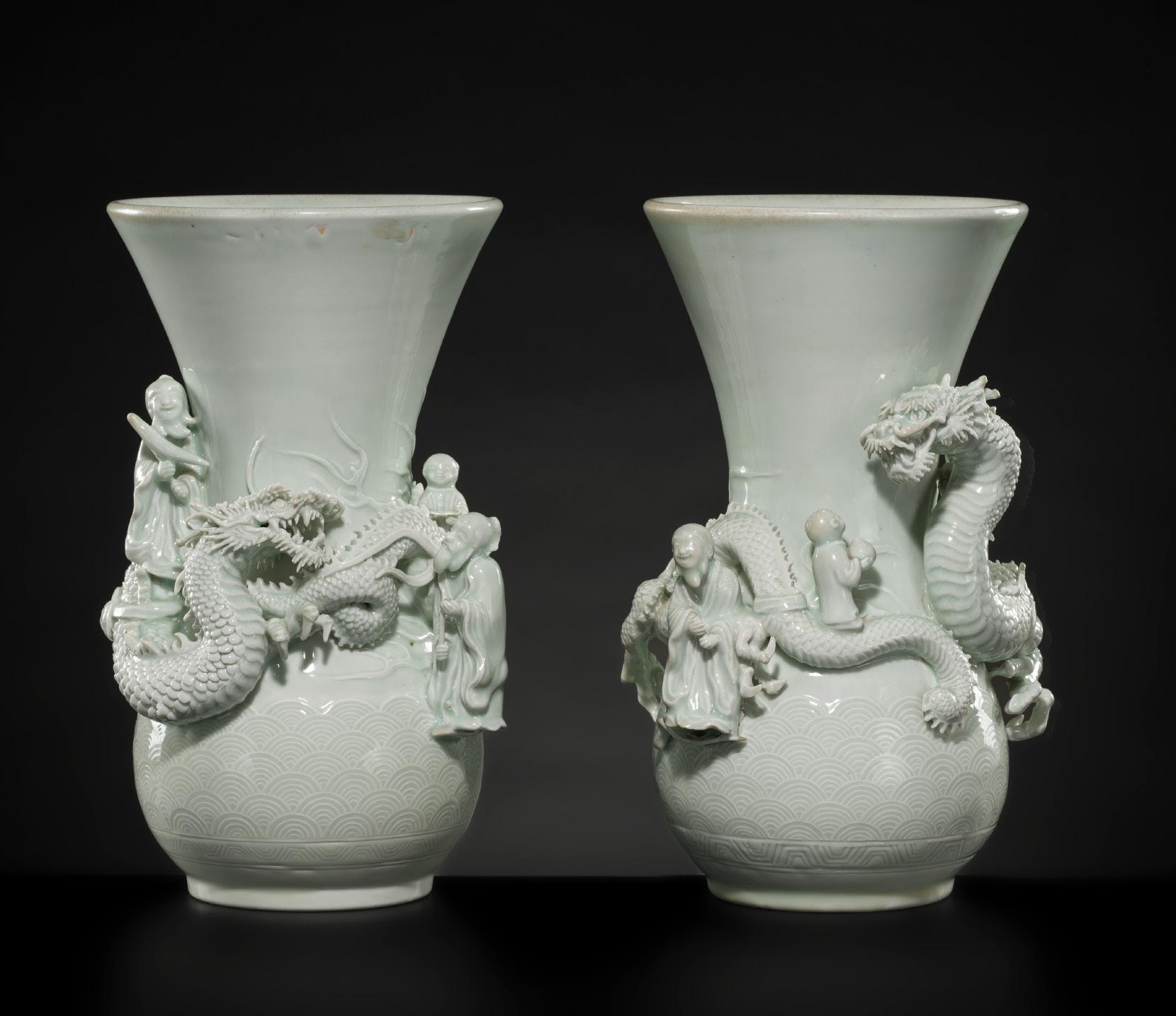
Provenance: From the private collection of Selma Orentreich and David Tanner, New York, United States.
By
Matsushima, signed Matsushima zo Japan, 19th century
Each finely potted and of gu-shape. The white-glazed exterior bearing a celadon hue, masterfully decorated with three-clawed dragons, their coiling, scaly bodies meticulously rendered and their large heads bearing ferocious expressions, with bulging eyes and gaping mouths. Standing atop the sinuous body of each dragon are two immortals, attired in loose-fitting robes and holding distinctive attributes, accompanied by a small child bearing offerings. The scenes rise from a wave-patterned ground carved in high relief, framed below by a chevron band above the foot. Each vase signed on the base Dai Nihon Hirado, MATSUSHIMA zo [made by Matsushima, Hirado ware, Great Japan].
HEIGHT 33.5 cm (each)
Condition: Good condition with minor wear and typical firing irregularities. Minimal traces of use. One vase with small losses to a dragon claw and the attribute held by a scholar, the other with repaired chips and a fissure on the dragon body with subsequent signs of restoration. Overall, both vases still presenting remarkably well.
MUSEUM COMPARISON
Compare a related Hirado ware blue and white ‘dragon’ vase, late Edo to Meiji period, 19th century, 27 cm high, in the Los Angeles County Museum of Art (LACMA), accession number M.2005.79.21.
Estimate EUR 4,000
Starting price EUR 2,000


224
A HIRADO BLUE AND WHITE PORCELAIN MIZUSASHI (WATER JAR) AND COVER
Japan, 19th century
Finely potted, the globular body gently tapering toward the foot and rising to a broad circular mouth. The exterior decorated with four shaped panels, painted in underglaze blue, to depict a prancing shishi, standing cranes beneath blossoming plum branches, a dragon writhing among swirling clouds, and a waterfall amidst pine trees. The scenes interspersed with four applied mythical beast heads with long tongues, set against a dense sayagata pattern.
The foot encircled by a blue chevron motif, while the rim bears a key-fret design accompanied by an unusual polychrome band with flowerheads, which extends onto the slightly domed cover. The lid adorned with a finial in the form of a fierce shishi, seated on its haunches with curled mane and tail, set against a further sayagata ground and bordered by another key-fret band.
HEIGHT 25.4 cm
Condition: A minor loss to the tail of the shishi on the cover and a small chip to the rim of the water jar. Otherwise, very good condition with minimal wear, expected firing irregularities, and light traces of use.
Hirado ware (Hirado-yaki) is a type of Japanese porcelain primarily produced at kilns in Mikawachi, Sasebo, and Nagasaki, cities located in the Kyushu region, therefore also known as Mikawachi ware (Mikawachi-yaki). It was originally made in the former feudal Hirado
domain, which owned the kilns and was responsible for establishing and overseeing their production. Hirado ware is primarily recognized for its sometsuke underglaze cobalt blue and white porcelain, with the amount of blue typically being low, allowing the intricate modeling and the exceptionally fine white color of the porcelain to be more prominent. This porcelain features a finer grain than most other Japanese porcelains, enabling the creation of fine details and delicate, intricate openwork in its forms. The present vase is an excellent example of it.
MUSEUM COMPARISON
Compare a closely related Hirado porcelain water jar and cover, Edo period, first half 19th century, 24.3 cm high, in the Los Angeles County Museum of Art (LACMA), accession number AC1997.273.2.1-.2.
AUCTION COMPARISON
Compare a related Hirado porcelain water jar and cover, painted by Imamura, Meiji period, late 19th century, 20.7 cm high, at Christie’s, Innovative Japanese Design: Art of the Meiji Period, 18 November 2015, New York, lot 29 (sold for USD 5,250 or EUR 6,000 converted and adjusted for inflation at the time of writing).
Estimate EUR 2,000
Starting price EUR 1,000
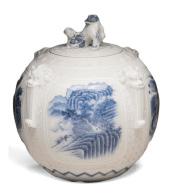

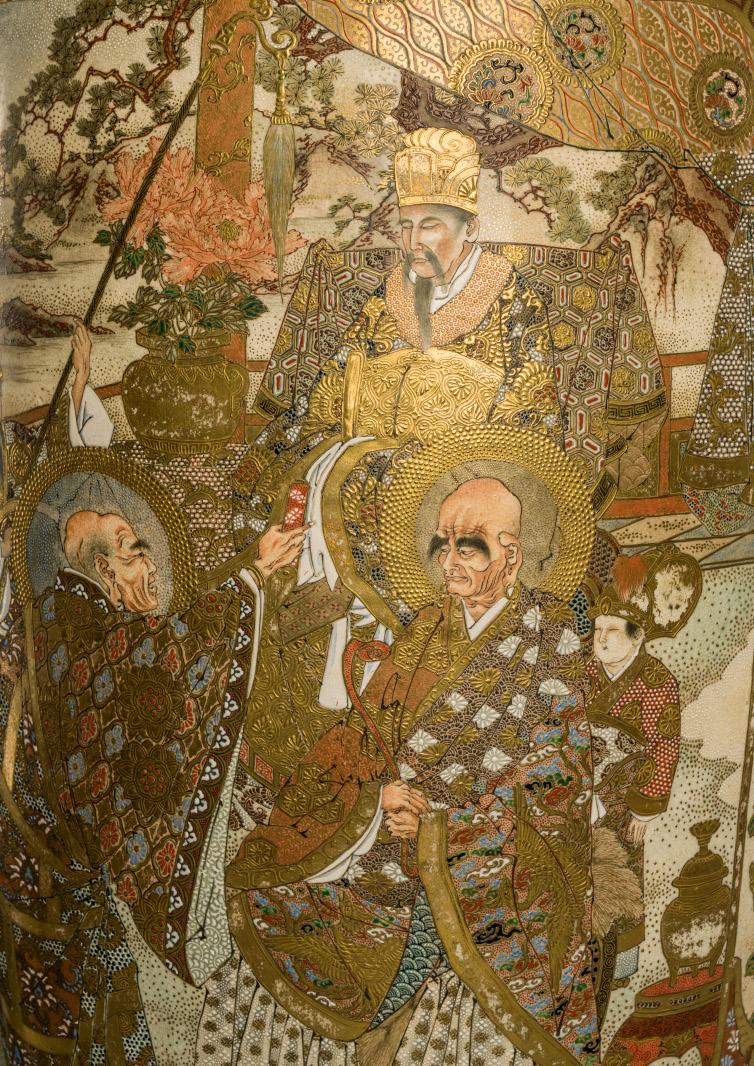
225 A MASSIVE (76.6 CM) AND IMPRESSIVE BALUSTER SATSUMA CERAMIC VASE DEPICTING
Signed Dai Nippon-koku Hon Satsuma Japan, Meiji period (1868-1912)
Heavily potted, the large baluster vase gently tapering towards the foot and rising to rounded shoulders with a slightly waisted neck and a thick-lipped mouth. The body elaborately decorated in polychrome pigments and extensive gilding, some elements in high relief, with two opposing large panels, one depicting Ryuju Kannon astride a writhing dragon above turbulent waters, appearing before a group of warriors; the other showing venerable rakan (arhats) before a seated official in a palace garden with luxuriant pine trees in the distance. Both panels framed by key-fret (rinzu) borders and interspersed with two further shaped reserves containing blossoming chrysanthemums amid red-capped cranes, pheasants, and sparrows. The surrounding surface lavishly adorned with floral brocade motifs, including stylized chrysanthemum patterns and gilt scrolling tendrils, extending onto the neck, which is embellished with two magnificent phoenixes (ho-o) and encircling decorative bands with diapered designs containing Imperial chrysanthemum crests (kiku-mon). Marked in red characters to the base Dai Nipponkoku Hon Satsuma [Made in the Great Empire of Japan, Satsuma].
HEIGHT 76.6 cm
WEIGHT 14.7 kg
Condition: Very good condition with minor wear and firing irregularities. Light rubbing to gilding and pigments, as is to be expected.
AUCTION COMPARISON
Compare a closely related larger Satsuma vase with opposing panels depicting courtly scenes and palace gardens, Meiji period, 106.6 cm high, at Christie’s, Christie’s Interiors. Style and Spirit, 13 May 2008, London, lot 461 (sold for GBP 7,500 or approx. EUR 16,500 converted and adjusted for inflation at the time of writing).
Estimate EUR 6,000
Starting price EUR 3,000
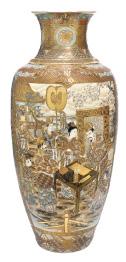



OKAMOTO RYOZAN FOR THE YASUDA COMPANY: A
By Okamoto Ryozan, signed Ryozan with the mark of the Yasuda Company Japan, Meiji period (1868-1912)
Finely potted, the trumpet-shaped vase supported on a splayed foot and rising to a stepped neck and a gently flared mouth with a thick-lipped rim. The body richly decorated in polychrome pigments and extensive gilding, some elements in high relief, with continuous registers depicting elegantly attired courtly ladies and children in a flowering garden with chrysanthemums in full bloom, an array of auspicious objects, and figures by a stream set amidst rolling hills and small dwellings. The scenes framed by gilt key-fret (rinzu) bands, diaper patterns, and additional geometric designs. The foot and neck applied with bamboo leaves resting on raised bamboo-form bands. Signed to the base Dai Nippon, Kyoto Tojiki Goshi-gaisha. Ryozan [made by Ryozan, The Kyoto Ceramic Limited Partnership Company, Great Japan] and with the Yasuda company mark.
HEIGHT 23.7 cm
Condition: Very good condition with minor wear and firing inherent irregularities. Light rubbing to gilding and pigments, as expected from this type of wares.
Okamoto Ryozan (c. 1820-1910) has been widely regarded as one of the foremost Satsuma artists of the Japanese golden age of manufacture.
AUCTION COMPARISON
Compare a related larger Satsuma ceramic vase with encircling panels enclosing figural scenes, by Okamoto Ryozan for the Yasuda Company, Meiji period, 39 cm high, at Bonhams, Fine Asian Works of Art, 22 June 2010, San Francisco, lot 2319 (sold for USD 12,200 or approx. EUR 15,500 converted and adjusted for inflation at the time of writing).
Estimate EUR 4,000
Starting price EUR 2,000


227
MEIGYOKU: A PAIR OF FINE SATSUMA CERAMIC GU-FORM VASES
By Meigyoku, signed Satsuma sei Meigyoku ga Japan, Meiji period (1868-1912)
Each finely potted, the trumpet-shaped body supported on a short foot, richly decorated in polychrome pigments and extensive gilding, some elements in high relief, with a continuous scene depicting lush bamboo stalks surrounded by blossoming chrysanthemums (kiku), balloon flowers (kikyo), and irises (shobu) rising from the tranquil waters of a pond, with butterflies fluttering amongst them. The scene framed above and below by overlapping reserves containing geometric diapered patterns, that gently extend onto the interior of the mouth. Signed to the base within a rectangular reserve Satsuma sei MEIGYOKU ga [painted by Meigyoku, Satsuma ware] with the Shimazu clan cross mark.
HEIGHT 24.8 cm (each)
Condition: Very good condition with minor wear and firing inherent irregularities. Minimal rubbing to gilding and pigments, mostly to the rims, as is to be expected.
AUCTION COMPARISON
Compare a related pair
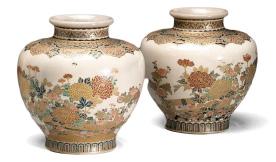
Satsuma ceramic jars scenes depicting flowering chrysanthemums and pawlonia blossoms, signed Meigyoku with the Shimazu family crest, late Edo to Meiji period, 14 cm high, at Bonhams, Japanese Works of Art, 19 March 2009, New York, lot 490 (sold for USD 1,830 or approx. EUR 2,500 converted and adjusted for inflation at the time of writing).
Estimate EUR 2,500
Starting price EUR 1,200

By Kyozan, signed Kyozan Japan, Meiji period (1868-1912)
Finely potted, the faceted baluster body supported on a splayed foot and rising to rounded shoulders with a straight neck and a slightly tapered mouth. The exterior lavishly decorated in polychrome pigments and extensive gilding, some elements in high relief, with oval panels depicting a variety of scenes, including Kannon amidst misty clouds, a samurai beneath the leafy branches of a cherry tree (sakura) and another before cascading waters, a richly attired official and a venerable rakan (arhat) among peonies and chrysanthemums, a courtly lady and her daughter beneath towering bamboo trunks and distant dwellings. The panels framed by bamboo-like borders and further enriched above and below by floral brocade motifs, including camellias among scrolling tendrils and leafy stems around the neck, and bordered with a design suggesting dripping glaze. The foot and rim encircled by a band of gilt key-fret (rinzu) pattern on a black ground. Signed within a rectangular reserve to the base KYOZAN.
HEIGHT 18.8 cm
Provenance: From a private collection in Southern Germany, acquired in the 1950s.
Condition: Very good condition with minor wear and firing inherent irregularities. Light rubbing to gilding and pigments, as expected from this type of wares.
AUCTION COMPARISON
Compare a closely related Satsuma hexagonal vase with oval panels depicting birds of prey among seasonal flowers, scenes of courtly life, and mythical creatures, signed Ryozan, Meiji period, 18 cm high, at Bonhams, Fine Japanese Art, 12 November 2015, London, lot 367 (sold for GBP 1,062 or approx. EUR 2,000 converted and adjusted for inflation at the time of writing).
Estimate EUR 2,500
Starting price EUR 1,200

By Kozan, signed Kozan Japan, Meiji period (1868-1912)
Finely potted with deep sides rising from a short, straight foot to a gently incurved gilt rim. The interior densely decorated in polychrome pigments and extensive gilding, some elements in high relief, with three overlapping rectangular panels depicting a variety of scenes, including Kannon with child descending on a cloud alongside samurai before cascading waters, a dancer performing before a gathering of richly attired courtiers, and a coastal landscape with steep cliffs and dwellings set among the rocks. The panels interspersed by shaped reserves containing geometric diaper patterns, adorned in vibrant colors with gilt accents, on a dense millefleur ground. The rim encircled by a distinctive band with heart-shaped motifs above scrolling tendrils and a frieze of pointed petals. The exterior further embellished with luxuriant stalks with peony and wisteria blossoms among various auspicious objects, as well as a register of turbulent waters with drifting leaves. Signed within a rectangular reserve to the base KOZAN.
DIAMETER 15.4 cm
Condition: Excellent condition with only minor wear, firing inherent irregularities, and minimal rubbing to gilding and pigments.
Estimate EUR 1,000
Starting price EUR 500
230
FUZAN: A FINE SQUARE
SATSUMA CERAMIC BOWL
DEPICTING COURTLY SCENES
By Fuzan, signed Fuzan Japan, Meiji period (1868-1912)
Finely potted with deep sides rising from a short, straight foot to a four-sided rim. The interior densely decorated in polychrome pigments and extensive gilding, some elements in high relief, with a central scene depicting elegantly attired ladies engaged in various parleys, framed by a band of gilt key-fret (rinzu) pattern on a black ground, and flanked above and below by two fan-shaped panels showing further courtly gatherings. The scenes surrounded by overlapping reserves containing geometric diaper patterns and millefleur motifs in vibrant colors with gilt accents. The exterior adorned with a majestic phoenix (ho-o) and an array of auspicious objects amid scrolling tendrils. The rim and foot decorated with gilt geometric designs on richly colored grounds. Signed to the base FUZAN.
DIAMETER 17.7 cm
Provenance: From a private collection in Southern Germany, acquired in the 1950s.
Condition: Very good condition with minor wear and firing inherent irregularities. Minimal rubbing to gilding and pigments.
Estimate EUR 1,000
Starting price EUR 500



By Yabu Meizan (1853-1934), signed Yabu Meizan Japan, late 19th century, Meiji period (1868-1912)
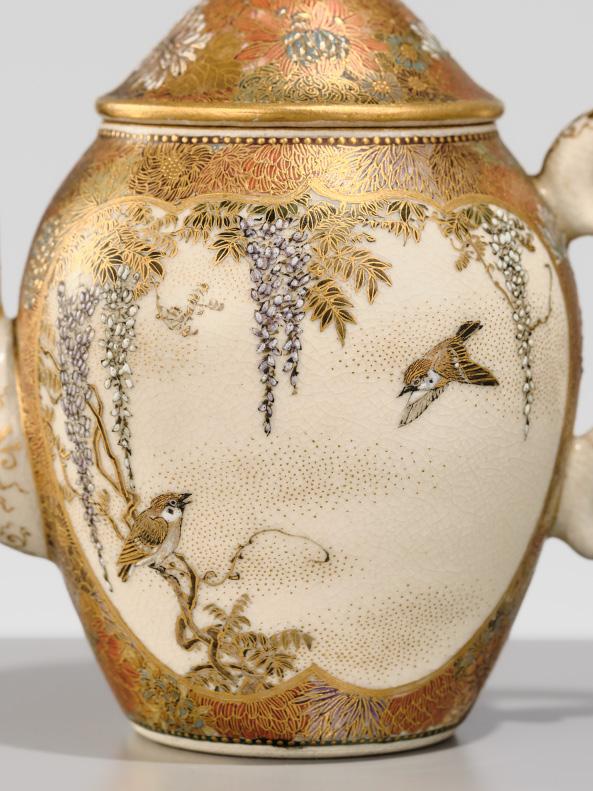

Finely potted, the ovoid body, set with a handle and a curved spout, exquisitely decorated in polychrome pigments and extensive gilding in high relief, with two opposing panels, one depicting a pair of sparrows fluttering among wisteria blossoms and leafy branches, the other containing a figurative scene with people at leisure, each superbly enameled on a finely crackled, creamy-white glazed ground. Both reserves framed in gilt and surrounded by a dense millefleur motif. The pot fitted with a bell-shaped cover surmounted by a five-petaled flower finial. The spout and handle further embellished with blossoming flowerheads and scrolling tendrils. Sealed in gold to the base with a four-character YABU MEIZAN mark enclosed within a square cartouche.
HEIGHT 8.1 cm
Condition: Minor repairs to the handle and spout. Otherwise excellent condition with only very minor wear and light rubbing to gilt as is to be expected. Presenting beautifully.
Yabu Meizan (1853-1934) was a Japanese artist and workshop owner known for painting on porcelain. His studio produced highend Satsuma ware and he was one of the artists who continued the tradition of high artistic quality while also successfully exporting. Meizan actively marketed his work internationally as well as domestically, taking an active role in organizing the presentation of Japanese wares at world fairs.
AUCTION COMPARISON
Compare a related Satsuma teapot and cover with shaped panels and similar millefleur decoration, by Yabu Meizan, Meiji period, late 19th century, 12.5 cm high, at Bonhams, Fine Japanese Art, 14 May 2015, London, lot 386 (sold for GBP 8,750 or approx. EUR 16,000 converted and adjusted for inflation at the time of writing).
Estimate EUR 5,000 Starting price EUR 2,400
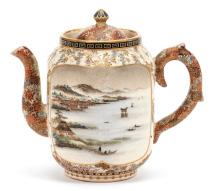
By Yabu Meizan (1853-1934), signed Yabu Meizan Japan, late 19th century, Meiji period (1868-1912)
Of rectangular form with inward-curving corners, superbly decorated in polychrome pigments and embellished with rich gilt. The interior depicting a sparrow perched on a blossoming cherry branch, while the exterior presents a poetic coastal landscape scene with distant mountains, each set against a finely crackled, creamy-white glazed ground. Both panels framed in gilt with a lozenge band and flanked on the sides of the box and cover by a dense millefleur motif. Sealed to the base in gold with a fourcharacter YABU MEIZAN mark enclosed within a square cartouche.
SIZE 2.3 x 6 x 8 cm
Condition: Excellent condition with only very minor wear and light rubbing to gilt as is to be expected.
LITERATURE COMPARISON
Compare a closely related satsuma earthenware incense box (kogo) and cover, by Yabu Meizan, Meiji period, 1890-1905, 7.7 cm long, illustrated in Oliver Impey and Malcolm Fairley, The Nasser D. Khalili Collection of Japanese Art. Treasures of Imperial Japan. Ceramics Part II, 1995, no. 38.
AUCTION COMPARISON
Compare a closely related Satsuma earthenware incense box (kogo) and cover, by Yabu Meizan, Meiji period, 12.7 cm long, at Christie’s, Fine Japanese Art, 16 May 2013, London, lot 500 (sold for GBP 18,750 or approx. EUR 35,500 converted and adjusted for inflation at the time of writing).
Estimate EUR 8,000
Starting price EUR 4,000



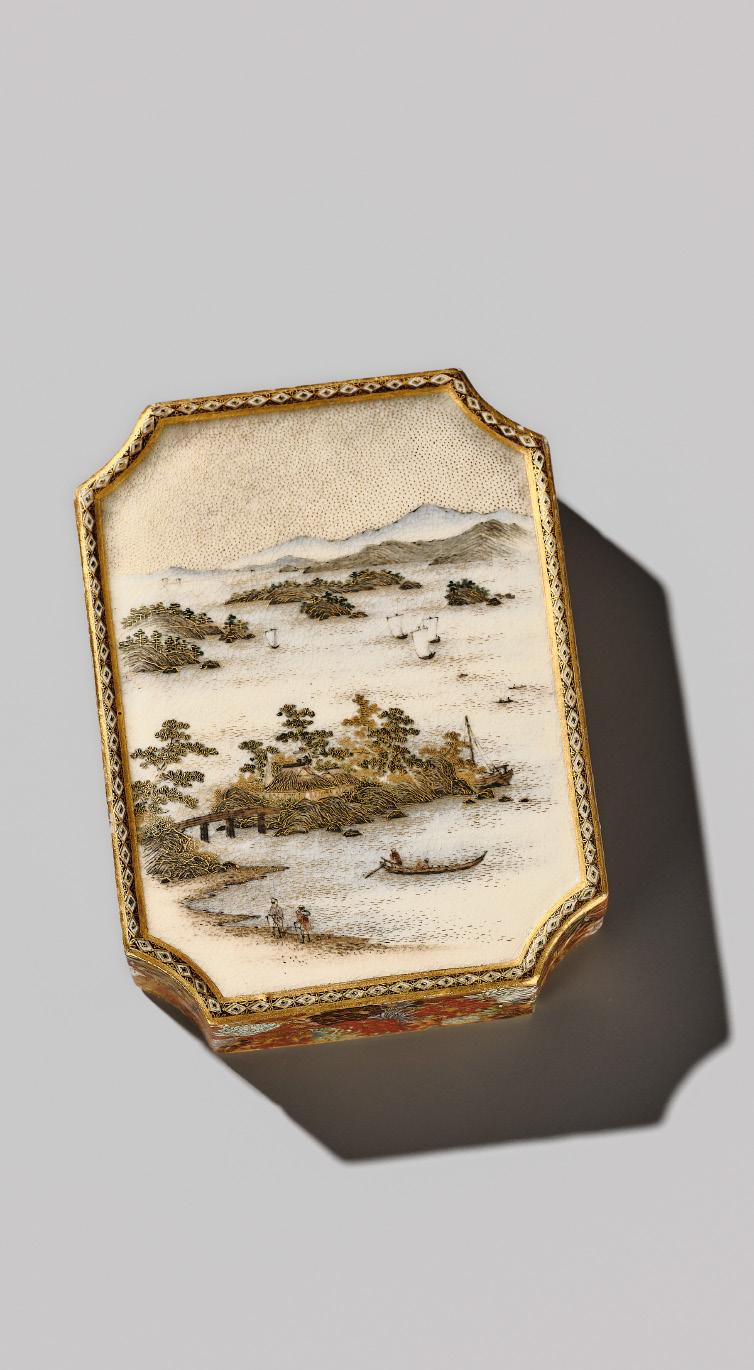



Japan, Meiji period (1868-1912)
Well potted and of elongated cylindrical form with gently swelling sides, finely decorated in high relief and brightly glazed to depict a leafy branch bearing blossoming camellias, around which a sparrow flutters. The foliage and bird are enriched with gilt and polychrome enamel painting depicting grasses and chrysanthemums, all set against a deep burgundy-brown ground. A dotted band encircles the foot, and a hexagonal motif borders the mouth.
HEIGHT 43.4 cm
Condition: Good condition with minor wear and firing-inherent irregularities, including pitting and glazing recess. Typical traces of use. Few small losses to exposed areas, as is to be expected. Light rubbing to glaze and pigments. A drilled hole to the base, likely for use as a lamp.
During Japan’s Meiji period (1868–1912), ceramic production flourished as part of the nation’s drive to modernize and engage with global markets. Among the most innovative artists was Miyagawa Kozan (1842–1916), whose Yokohama workshop achieved international acclaim for its technical mastery and sculptural decoration. His vases with their high relief modeling, bright enamels, and gilt highlights are classic examples of Japanese export art made to appeal to Victorian taste.
The present vase, executed in the style of Kozan, embodies this aesthetic with its naturalistic rendering of camellia blossoms and sparrow amid foliage. The combination of relief modeling, color, and refined glazing reflects the artistic sophistication that defined the finest Meiji period ceramics.
AUCTION COMPARISON
Compare a related pair of relief-moulded vases, style of Makuzu Kozan, at Zacke, Asian Art Discoveries, 30 June 2022, Vienna, lot 1115 (sold for EUR 11,376).
Estimate EUR 4,000
Starting price EUR 2,000
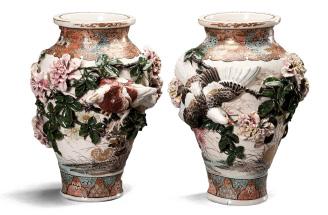
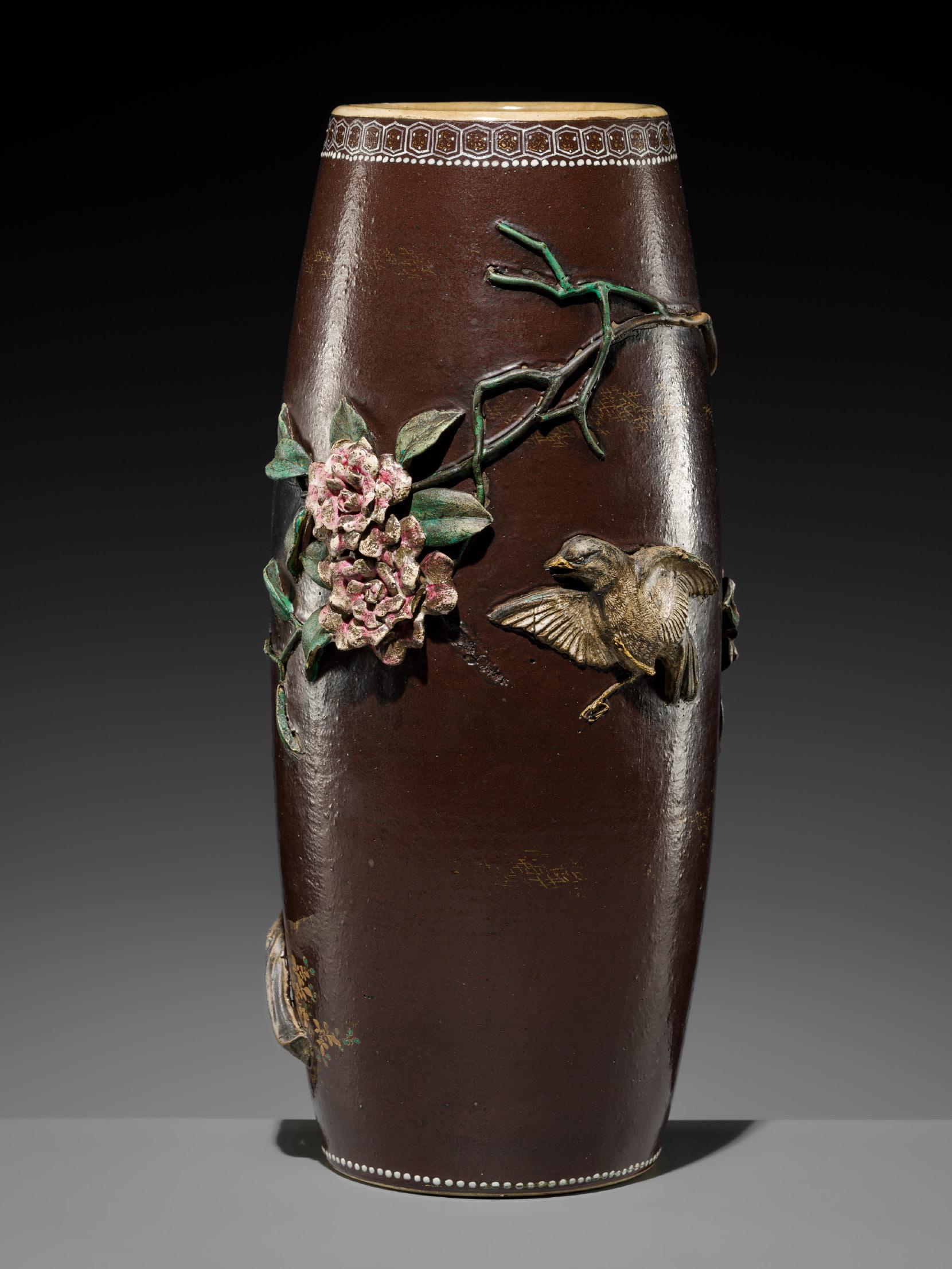

By Ajiki Hiro (b. 1948), sealed to the tomobako Japan, c. 2004, Heisei period (1989-2019)

Japan, 18th-19th century, Edo period (1615-1868)
Shoe-shaped (kutsugata), supported on a straight foot marked by a distinctive indentation and rising toward a broad, asymmetrical mouth that spirals upward from the base. Crafted from dark reddish-brown clay, the vessel bears the characteristic firing marks of Bizen ware. The surface undecorated and unglazed, save for the incidental drips of natural ash glaze formed during the firing process.
With the original wood tomobako (storage box), inscribed chawan (tea bowl), and oshifuku pouch, with a small wood tag inscribed Bizen.
LENGTH 12.9 cm
Condition: Excellent condition with only minor wear, firing irregularities, and expected traces of use.
Estimate EUR 1,500 Starting price EUR 800
Skillfully modeled, the oval body supported on a short foot and rising to a broad mouth, boldly painted with a checkered pattern inside and out in overlapping gold and red tones over a lustrous glaze of varying shades of brown.
With the original wood tomobako (storage box), inscribed Enyu, Basara, Wan [Salt glaze, entitled Basara (Flamboyant Elegance), a tea bowl] with kakihan monogram, and sealed HIRO Toin.
DIAMETER 13.1 cm
Provenance: Bonhams, 20th century Japanese Ceramics, 8 November 2005, London, lot 76 (sold for GBP 1,320 or approx. EUR 3,000 converted and adjusted for inflation at the time of writing). A private collection, acquired from the above. Condition: Excellent condition.
MUSEUM COMPARISON
Compare a closely related stoneware Basara chawan, by Aziki Hiro, Heisei period, dated 1997, 10.8 cm diameter, in the Metropolitan Museum of Art, object number 2005.245.
Estimate EUR 1,500
Starting price EUR 800

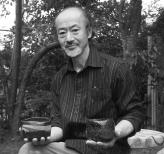
Ajiki Hiro, photographed by Carol Horvitz
Ajiki Hiro, born in 1948 in Hirata, Shimane Prefecture, is a ceramic artist celebrated for his mastery of pottery and his sustained engagement with the Japanese tea ceremony. In the early 1970s, he traveled extensively, visiting over thirty countries, an experience that informed his aesthetic vision. For decades, he has devoted himself to the refinement of the tea bowl (chawan), producing works distinguished by their spontaneity and subtlety, occasionally embellished with gold and silver. His ceramics have been exhibited internationally, including the United States, Mexico, Germany, and India, and are regularly presented at the Dento Kogei Ten (Traditional Japanese Craft Art Exhibition) in Japan. In 1987, he received the Grand Prize at the Modern Tea Forms Exhibition at the Tanabe Museum of Art.
236
HASEGAWA JUICHI: A MOTTLED UZURA-YU (QUAIL EGGSHELL) GLAZED EARTHENWARE TEA BOWL (CHAWAN)
By Hasegawa Juichi, sealed Ju (of Juichi) Japan, 20th century, Showa period (1926-1989)
Well-potted, with deep sides gently marked by horizontal ridges, supported on a short, spreading foot, rising to a broad mouth, finely covered overall in a lustrous white glaze, attractively pooling at the rim, and iron-russet specks, falling well short of the foot to reveal the buff-colored ware underneath. The base sealed JU.
DIAMETER 11.5 cm
Condition: Excellent condition.
Estimate EUR 1,000
Starting price EUR 500
237
SHIMIZU KEIICHI: A FINE STONEWARE VASE FROM THE SERIES ‘LINE PATTERN’
By Shimizu Keiichi (b. 1962), signed Kei Japan, Heisei period (1989-2019)
Finely modeled with sharp-edged contours and a square-section base, the elongated body rising vertically with one of its faces curving inward and compressing the mouth to create a distinctive irregular outline. The unglazed stoneware surface, in varying shades of brown, decorated with linear designs. Signed to the base KEI.
With the original wood tomobako (storage box), inscribed by the artist Senmon ki, Kei [a vessel decorated with linear design, Kei] with the seal Kei.
HEIGHT 33.7 cm
WEIGHT 2,846 g
Condition: Excellent condition.
MUSEUM COMPARISON
Compare a closely related stoneware vessel from the series ‘Line Pattern’, by Shimizu Keiichi, Heisei period, dated 2003, in the Museum of Ceramic Art, Hyogo, management number 040325-009.
Estimate EUR 1,500
Starting price EUR 800
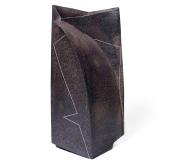
Shimizu Keiichi, born in 1962 in Tanba Tachikui, Hyogo Prefecture, is a fourthgeneration ceramic artist whose practice bridges traditional Tanba ware and contemporary ceramic expression. He studied at the Kyoto Prefectural Ceramic Training School and completed advanced studies at the Kyoto Municipal Industrial Research Institute before joining his family workshop, the Kaneto Kiln. Working primarily with local Tanba clay, Shimizu employs slab-building techniques to create precisely constructed forms that emphasize the inherent texture and tonal variations of the material. His work has been presented in numerous exhibitions across Japan, including those dedicated to modern ceramics and tea ware, and he has received recognition for his technical skill and refined sense of form.

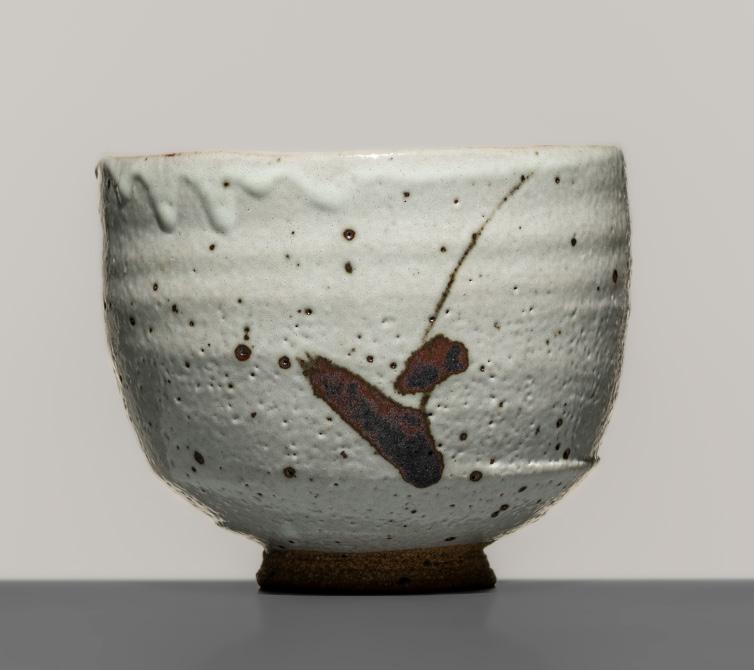
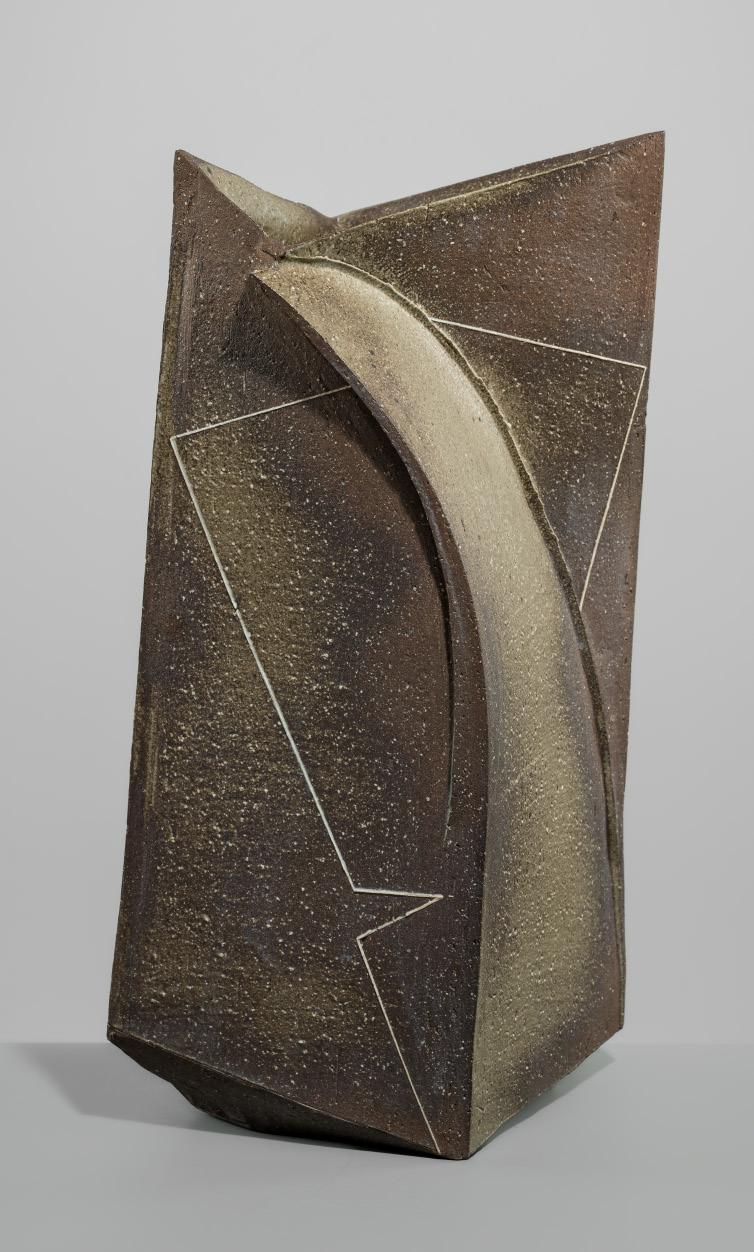

238
HAMADA SHOJI: A SUPERB BLACK AND IRON-RUST GLAZED TENMOKU-GLAZED STONEWARE DISH
By Hamada Shoji (1894-1978), signed and sealed to the tomobako Japan, Showa period (1926-1989)
Finely potted with deep, rounded sides rising from a short, tapered foot to a flared rim, covered overall in a lustrous and roughly textured black slip, magnificently decorated with irregularly dripped tawny-brown glaze, which continues onto the rim of the plate, unevenly stopping above the foot to reveal the underlying buffcolored ware.
With the original wood tomobako (storage box) inscribed by the artist Kokuyu Sabi-nagashi Ezara, SHOJI [black color glaze, the plate is painted with a design in iron rust, Shoji] and sealed Sho.
DIAMETER 26.8 cm
Condition: Excellent condition.
Hamada Shoji (1894-1978) studied ceramics at the Tokyo Institute of Technology, then known as Tokyo Industrial College, with Kawai Kanjiro under Itaya Hazan. As the sole students in the school interested in becoming artist-potters, Hamada and the slightly elder Kawai soon became friends, touring the city in search of inspiration. Anchored in the Japanese Mingei movement created under the leadership of Soetsu Yanagi between 1910 and 1920, Hamada focused on the beauty of everyday pieces by settling in the traditional pottery village of Mashiko. He used local stoneware, which he turned or molded into vessels with concave or convex, faceted or raised walls and decorated with a ladle or brush. Shoji Hamada’s reputation crosses borders, notably in France and England, where he built the first multi-chambered recumbent kiln of Asian type in the West with his long-time friend Bernard Leach. But it was in his native country that he achieved the greatest recognition, being named a Living National Treasure before his death in 1978.


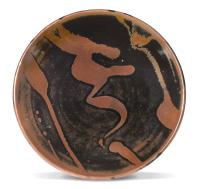
Compare a closely related tenmoku glazed stoneware dish with poured iron designs, by Hamada Shoji, Showa period, c. 1965, 31 cm diameter, at Bonhams, Contemporary Ceramics, 18 May 2004, London, lot 63 (sold for GBP 3,226 or approx. EUR 8,500 converted and adjusted at the time of writing). Compare a closely related tenmoku glazed stoneware dish, by Hamada Shoji, Showa period, 27 cm diameter, at Sotheby’s, Made in Britain, 13 September 2017, London, lot 127 (sold for GBP 3,000 or approx. EUR 5,000 converted and adjusted at the time of writing).
Estimate EUR 4,000
Starting price EUR 2,000
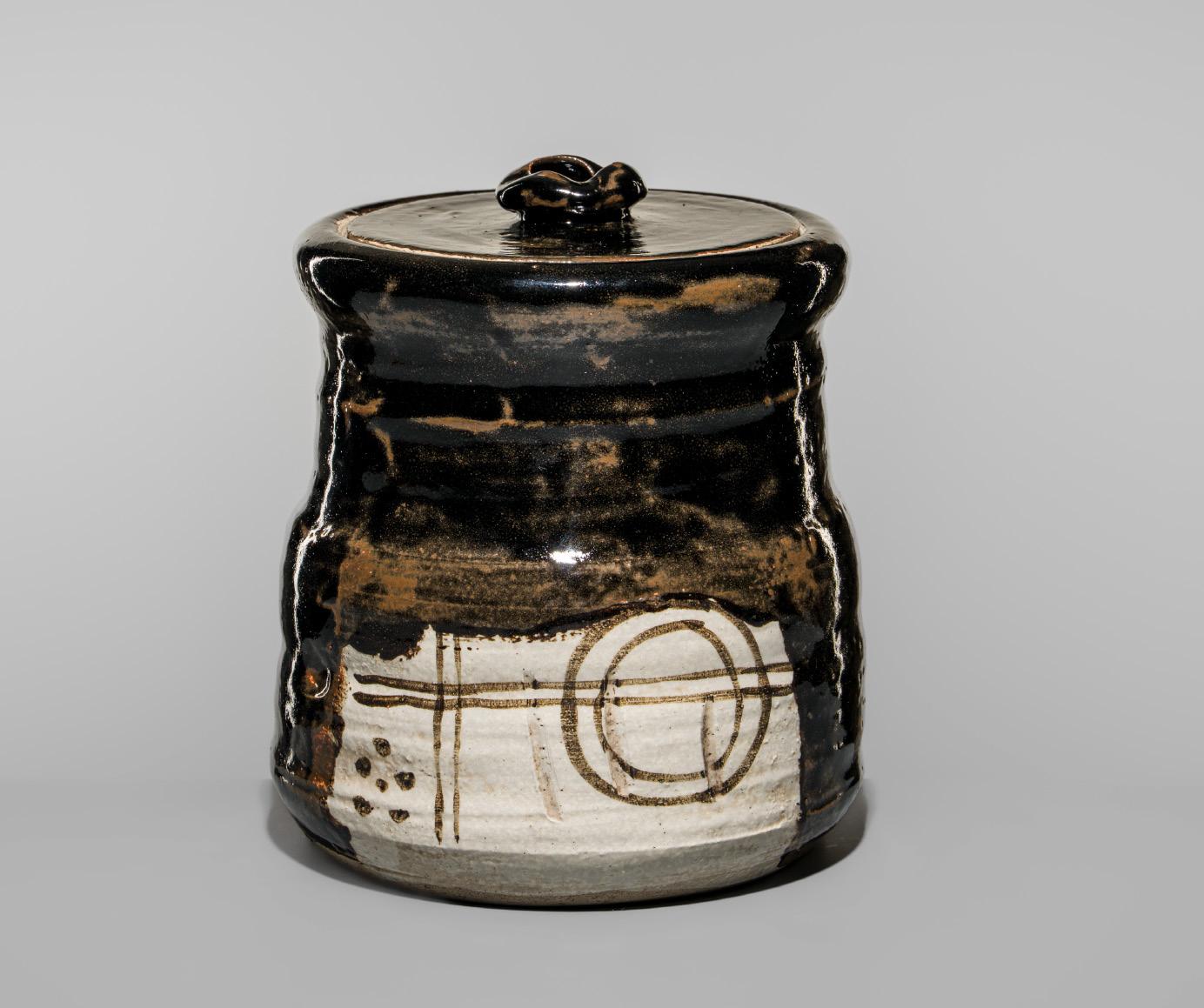
239
By Kitaoji Rosanjin (1883-1959), signed with the artist’s mark Ro and signed and sealed to the tomobako Japan, c. 1950, Showa period (1926-1989)
Superbly potted in a cylindrical form with horizontal ribs, supported on a short concave foot and rising to a gently tapering neck with a flared, thick-lipped mouth. The surface irregularly covered in varying shades of lustrous black glaze, with transparent-glazed reserves decorated with geometric designs, and fitted with a rounded cover topped by a stylized flower bud. The base unglazed, revealing the buff-colored ware underneath, incised with the artist’s mark RO.
With the original wood tomobako (storage box) inscribed by the artist Kuro Oribe, mizusashi, ROSANJIN saku [Black Oribe style, water container, made by Rosanjin] and sealed Hoshigaoka kama [Hoshigaoka kiln].
The cover inscribed and authenticated to the interior by Kuroda Totoan I (Kuroda Ryoji): Rosanjin sensei saku, Tot-an kiju [made by Master Rosanjin, authenticated by Totoan, aged 77] with the seal Totoan.
HEIGHT 20.8 cm
Condition: Excellent condition.
Estimate EUR 3,000 Starting price EUR 1,500

Kitaoji Rosanjin (18831959). Photograph by Isamu Noguchi
Kitaoji Rosanjin (1883–1959), born Kitaoji Fusajiro in Kyoto as the son of the head priest of Kamigamo Shrine, was one of the most celebrated and multifaceted Japanese artists of the Showa period. Trained in calligraphy under Okamoto Ippei, he spent two years in China (1908-1910) studying calligraphy and seal carving before returning to Japan, where he began to explore ceramics and their relation to food presentation. In 1919 he opened an art gallery in Tokyo and soon after founded the Bishoku Club, serving cuisine on his collection of traditional wares. The destruction of this collection in the Great Kanto Earthquake of 1923 led him to create his own ceramics, and in 1927 he established a kiln in Kamakura with the assistance of potter Arakawa Toyozo. Initially imitating classical Japanese traditions such as Mino, Shigaraki, Bizen, and Kutani, as well as Ming blue-and-white porcelains, Rosanjin soon distinguished himself with original designs of great simplicity and daring, often enriched with calligraphic elements. His work played a decisive role in reviving Japanese ceramic traditions threatened by war and industrialization. In 1954 he exhibited at the Museum of Modern Art in New York under the auspices of the Rockefeller Foundation and subsequently traveled in Europe, meeting artists such as Pablo Picasso and Marc Chagall. The following year, one of his Oribe wares was designated an Important Cultural Property of Japan, and in 1959 he declined the honor of being named a Living National Treasure, a distinction rarely refused.

241
KITAOJI ROSANJIN: AN AO ORIBE WARE CHAWAN (TEA BOWL)
By Kitaoji
Rosanjin (1883-1959), sealed Ro and signed Rosanjin and sealed Ro to the tomobako Japan, Showa period (1926-1989)
Skillfully potted, supported on a short foot and rising to deep sides gently flaring towards a broad mouth, the exterior finely decorated with stylized iron-brown underglaze grape motifs, set against a creamy-white glazed ground falling well short of the foot to reveal the buff-colored ware underneath, the interior covered in varying shades of olive-green glaze flowing over to the exterior and pooling attractively. The underside incised with the seal RO.
Signed Kenzan Japan, first half of the 19th century, late Edo period (1615-1868)
Dexterously hand-modeled, the earthenware body supported on a short, drop-shaped foot, with deep sides gently tapering towards a broad mouth, finely covered overall in an unctuous and slightly textured black glaze with reserves depicting stylized maple leaves in the Tatsuta River (Tatsutagawa), signed KENZAN above the foot.
With the original wood tomobako (storage box), inscribed: Fushikisai, Mei, Momiji to go su, Fushikisai [the title Maple Leaves (Momiji), Fushikisai] with kakihan (cursive monogram).
DIAMETER 8.8 cm
Condition: Excellent condition.
AUCTION COMPARISON
Compare a related stoneware tea bowl (chawan) with egrets among reeds, signed Kenzan, Edo period, 19th century, 10.5 cm diameter, at Sotheby’s, Japanese Works of Art from Private Collections, 28 September 2023, London, lot 85 (estimated at GBP 3,000 or approx. EUR 3,500 converted and adjusted at the time of writing).
Estimate EUR 1,500
Starting price EUR 800

With the original wood tomobako (storage box) inscribed by the artist Ao-Oribe chawan ROSANJIN [tea bowl in the Green Oribe style, Rosanjin] and sealed Ro.
The cover inscribed and authenticated to the interior by Kuroda Totoan I (Kuroda Ryoji): Rosanjin sensei saku, Toto-an hachijuni ju [made by Master Rosanjin, authenticated by Totoan, aged 82] with the seal Totoan.
DIAMETER 12.7 cm
Condition: Excellent condition.
Estimate EUR 3,000
Starting price EUR 1,500
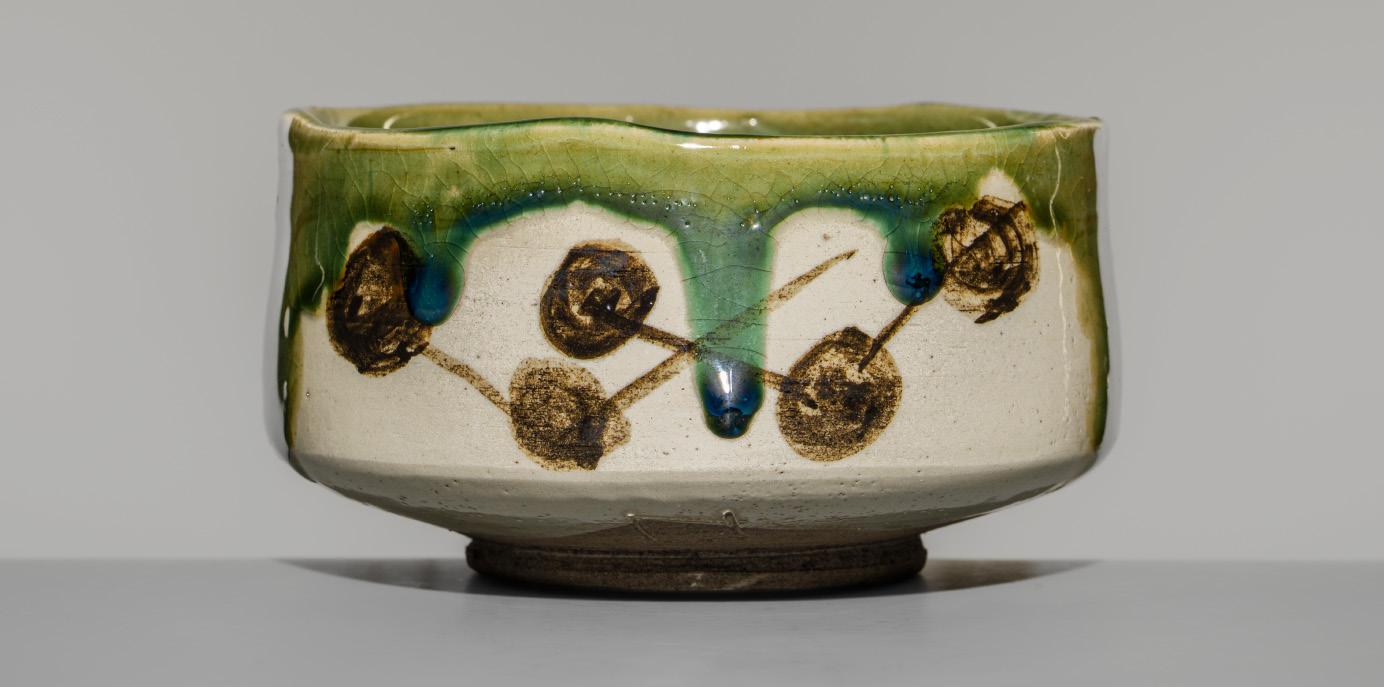
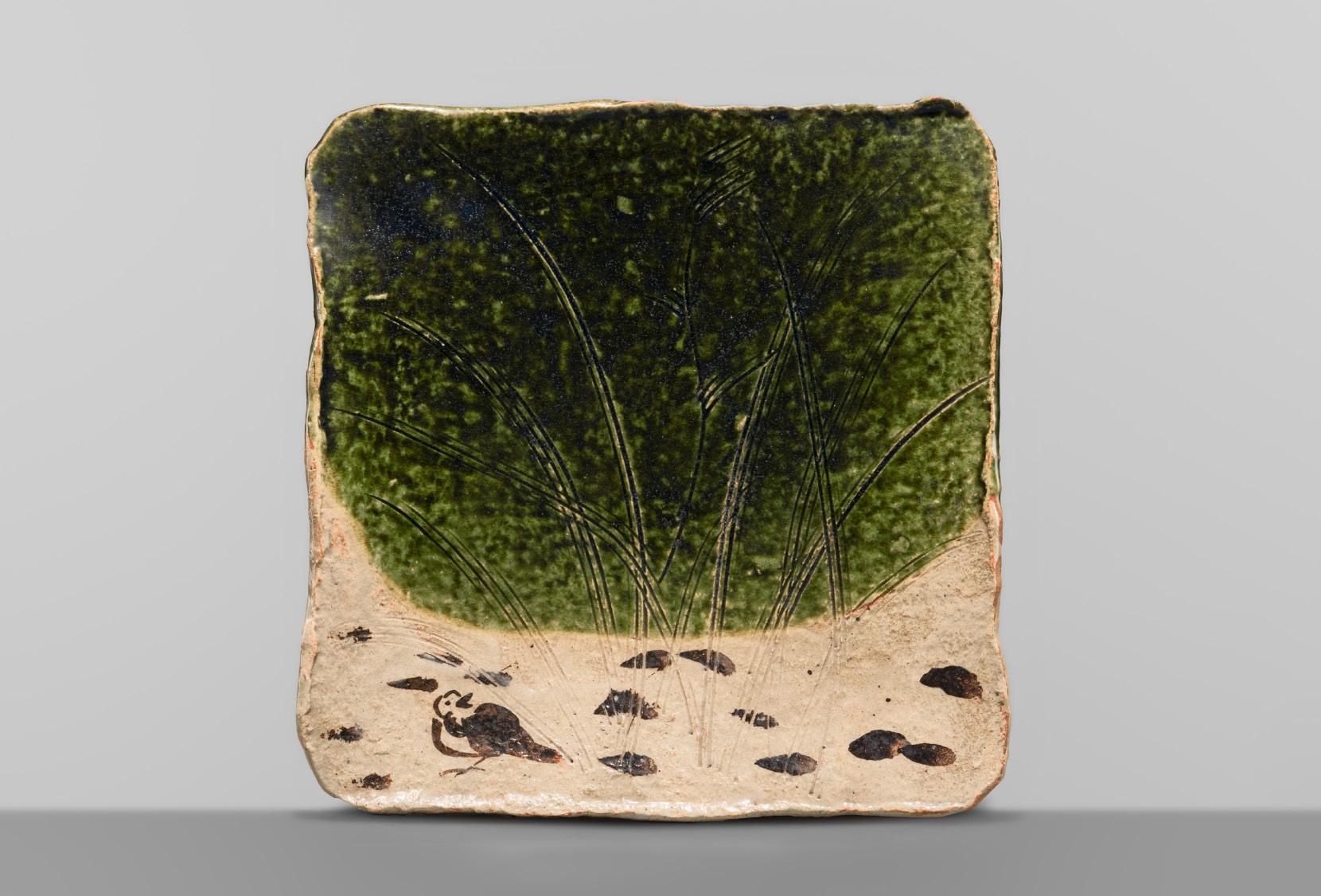
By Kitaoji Rosanjin (1883-1959), signed with the artist’s mark Ro Japan, Showa period (1926-1989)

The present lot at Christie’s, London, 9 November 2005, lot 350, sold for GBP 7,200 or approx. EUR 17,500
Of square form, thickly modeled and finely decorated with a large panel in varying hues of deep-green glaze and a small bird surrounded by iron-brown underglaze speckles on a transparent slip, with carved blades of grass. The underside incised with the artist’s mark RO.
With an associated wood tomobako (storage box).
LENGTH 27.4 cm
Provenance: Christie’s, Japanese Art and Design including an important 17th century, 9 November 2005, London, lot 350 (sold for GBP 7,200 or approx. EUR 17,500 converted and adjusted for inflation at the time of writing).
Condition: Excellent condition.
Kitaoji Rosanjin (1883–1959), born Kitaoji Fusajiro in Kyoto as the son of the head priest of Kamigamo Shrine, was one of the most celebrated and multifaceted Japanese artists of the Showa period.
AUCTION COMPARISON
Compare a closely related Oribe style stoneware footed platter, by Kitaoji Rosanjin, Showa period, 42.2 cm long, at Bonhams, Fine Asian Works of Art, 23 June 2008, San Francisco, lot 8347 (sold for USD 33,000 or approx. EUR 42,000 converted and adjusted at the time of writing). Compare a closely related Oribe-style square dish, by Kitaoji Rosanjin, Showa period, 27.8 cm long, at Christie’s, Japanese Art and Design, 18 June 2003, London, lot 326 (sold for GBP 4,541 or approx. EUR 12,000 converted and adjusted at the time of writing).
Estimate EUR 8,000
Starting price EUR 4,000
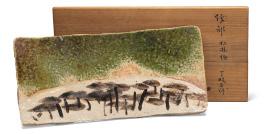
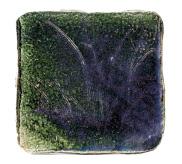

TOMONARI KATO: A MASSIVE CONTEMPORARY EARTHENWARE SCULPTURE
By Tomonari Kato (b. 1972), unsigned Japan, early 21st century, Reiwa period (2019-today)
Organically modeled with sinuous, contorted forms, the creamywhite surface with a roughly crackled texture, decorated with raised black dots of varying distributions.
With the original wood tomobako (storage box), the cover inscribed and stamped with the artist’s seal.
HEIGHT 44.8 cm
Condition: Excellent condition.
Estimate EUR 10,000
Starting price EUR 5,000
Tomonari Kato is a Japanese ceramic artist who completed his training at the Tajimi City Pottery Design and Technical Center in 1997. His work explores the expressive potential of clay through a refined contemporary sensibility, bridging traditional craftsmanship and modern sculptural form. Kato has exhibited internationally in Japan, Korea, Taiwan, Italy, and the Netherlands, and has received numerous distinctions, including the Grand Prix at the 56th Faenza Prize (Italy, 2009) and the Gold Prize at the 11th International Ceramics Competition Mino (Japan, 2017). His works are held in major public collections such as the Museo Internazionale delle Ceramiche in Faenza, the Museum of Modern Ceramic Art in Gifu, and the Ibaraki Ceramic Art Museum. He currently lives and works in Tajimi, Japan.
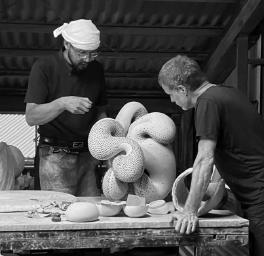
Tomonari Kato at his studio alongside one of his works

244
TOKUDA YASOKICHI III: A FINE KUTANI-GLAZED PORCELAIN VASE
By Tokuda Yasokichi III (1933-2009), signed Kutani
Masahiko
Japan, Heisei period (1989-2019)
The globular body supported on a short broad foot and rising to a slender flaring neck, covered overall in a rich, lustrous, finely crackled, blue-green streaked glaze, save for the white foot and base signed KUTANI MASAHIKO below an impressed foliate design.
With a signed and inscribed wood tomobako (storage box) and a Japanese leaflet with the biography of the artist.
HEIGHT 15.1 cm
Condition: Excellent condition.
AUCTION COMPARISON
Compare a closely related Kutaniglazed porcelain vase, by Tokuda Yasokichi III, Heise period, late 20th century, 16 cm high, at Zacke, Fine Japanese Art, 6 December 2024, lot 221 (sold for EUR 2,080).
Estimate EUR 1,500
Starting price EUR 800
245

TOKUDA YASOKICHI III: A FINE KUTANIGLAZED PORCELAIN VASE
By Tokuda Yasokichi III (1933-2009), signed Kutani Masahiko
Japan, Heisei period (1989-2019)
The globular body gently tapering towards the base and rising to a short, waisted neck with a flared mouth. The exterior covered overall in a lustrous, finely crackled, bluegreen streaked glaze, save for the white foot and base signed KUTANI MASAHIKO.
With a signed and inscribed wood tomobako (storage box).
HEIGHT 13.3 cm
Condition: Excellent condition.
Estimate EUR 1,000
Starting price EUR 500
Tokuda Yasokichi III (19332009) was designated a Bearer of Important Intangible Cultural Assets (or Living National Treasure) in 1997 for his mastery of the innovative Saiyu glaze technique, based on traditional Kutani-colored glaze enamels as handed down from his grandfather and father, Tokuda Yasokichi I (18731956) and Tokuda Yasokichi II (1907-1997). Before he succeeded his father in 1988 as Tokuda Yasokichi III, the artist was known as Tokuda Masahiko.

Tokuda Yasokichi III



Lots 246 to 304

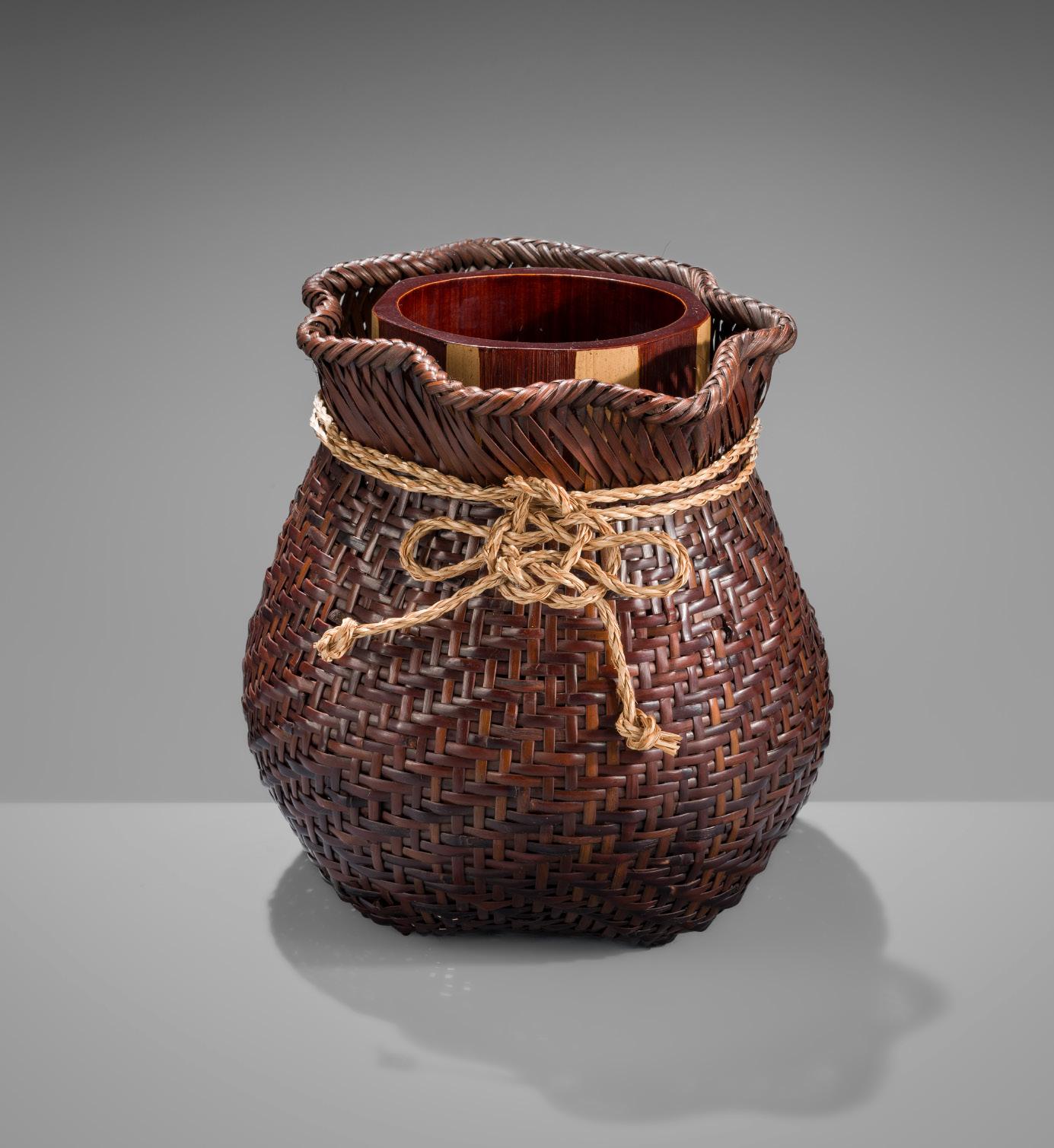
246
OKAZAKI CHIKUHOSAI II: A BAMBOO AND RATTAN HANAKAGO (FLOWER BASKET)
By Okazaki Chikuhosai II (born 1933), signed Chikuhosai Japan, Osaka, c. 1960-1970
Of jar-like form with a gently waisted neck and undulating rim, the basket is woven from finely split smoked bamboo in a dense vertical split weave pattern. A twisted rope of natural fiber is tied around the neck in a decorative knot. Signed underneath Chikuhosai. With an otoshi (water holder) made from alternating bands of natural and dark-stained bamboo.
HEIGHT 21 cm, LENGTH 23 cm
Condition: Very good condition with minor wear and natural imperfections.
With a wood tomobako (storage box) with hakogaki inscription: Biku, Chikuhosai saku, with seal Chikuhosai [Fish-basket shape, made by Chikuhosai] with seal Chikuhosai.
AUCTION COMPARISON
Compare a related bamboo and rattan hanakago by the same artist, signed Chikuhosai, dated to the second half of the 20th century, at Zacke, Fine Japanese Art, 6 December 2024, Vienna, lot 362 (sold for EUR 1,690).
Estimate EUR 1,000 Starting price EUR 500

247
OKAZAKI CHIKUHOSAI II: A LARGE BAMBOO AND RATTAN HANAKAGO (FLOWER BASKET)
By Okazaki Chikuhosai II (1933-2021), signed Chikuhosai
Japan, Osaka, second half of 20th century, Showa period (1926-1989)
Of tall, hexagonal form with a slightly tapering body rising to a wide mouth, the basket is woven in an open hexagonal lattice pattern from smoked bamboo. The rim and vertical supports are reinforced with tightly wrapped rattan bindings. The high, arching handle is similarly bound. Signed underneath CHIKUHOSAI. With an otoshi (water holder).
HEIGHT 48 cm
Condition: Excellent condition.
With a wood tomobako (storage box) bearing the artist’s seal.
Okazaki Chikuhosai II (born 1933) was the son of Okazaki Chikuhosai I (1899-1970) who was the eldest brother of Tanabe Chikuunsai I (18771937), one of the most important bamboo artists working in the first half of the 20th century in Osaka.
Estimate EUR 1,000 Starting price EUR 500

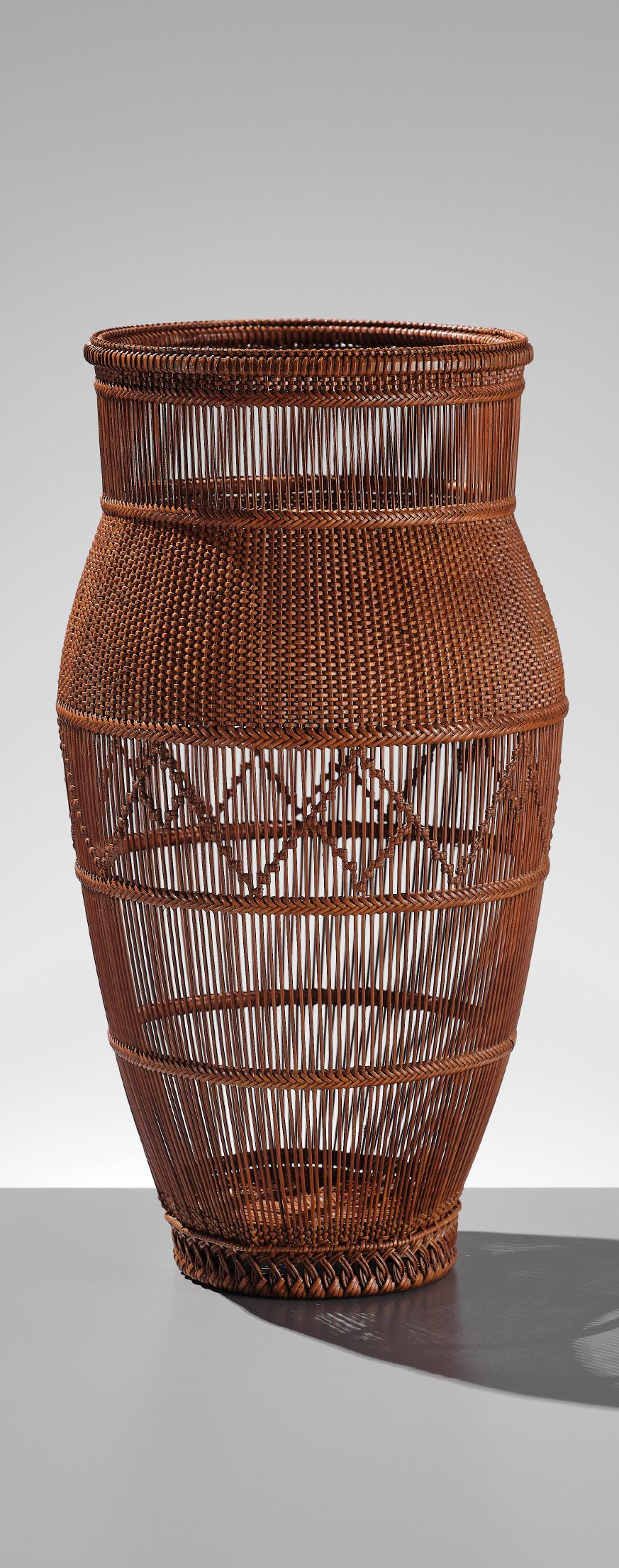
MAEDA CHIKUBOSAI II: A FINE WOVEN BAMBOO AND RATTAN HANAKAGO (FLOWER BASKET)
By Maeda Chikubosai II (1917-2003), signed Chikubosai kore saku Japan, 20th century
Of tall, ovoid form with a short, narrower neck, the basket is masterfully woven from fine strips of bamboo in openwork, the central body shows a diagonal lattice designs, while the upper and lower sections are composed of vertical open weaving. Signed underneath CHIKUBOSAI kore saku [this is made by Chikubosai]. With an otoshi (water holder).
HEIGHT 29 cm
Condition: Excellent condition.
With a wood tomobako (storage box) signed and sealed by the artist.
Maeda Chikubosai II was born in the Hirai section of Sakai, where all of the Maeda clan lives. A late child, he was considered too young to be trained by his father and learned plaiting techniques from his father’s students instead. He began to receive some recognition for his work during the mid1930s. After World War II, he showed in Osaka-area exhibitions and aspired to show creative work in Nitten. In 1953 he had his first piece accepted in Nitten, and he exhibited in 1959 at Japan Traditional Crafts Exhibition. He was honored by the Japanese government in 1992 and named “Living National Treasure” in bamboo craft in 1995.
AUCTION COMPARISON
Compare a closely related bamboo hanakago by the same artist, signed Chikubosai kore saku, dated to the 20th century, 24.9 cm (high), at Zacke, Fine Japanese Art, 16 June 2023, Vienna, lot 169 (sold for EUR 3,640).
Estimate EUR 2,000
Starting price EUR 1,000

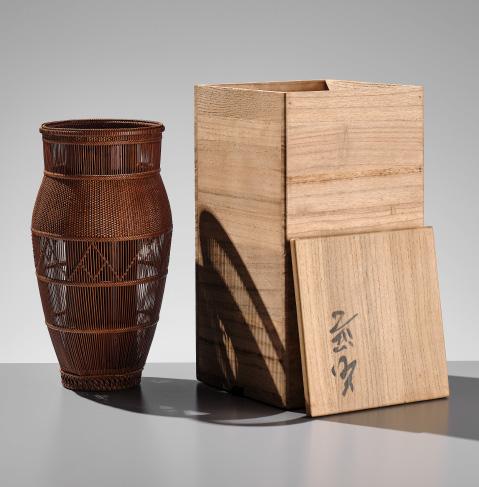

249
HAYAKAWA SHOKOSAI I: A BAMBOO AND RATTAN HANAKAGO (FLOWER BASKET)
By Hayakawa Shokosai I (1815-1897), authenticated by Hayakawa Shokosai III
Japan, mid-19th century
Of rounded and sculptural form, woven from darkly smoked bamboo with a rounded body tapering into a narrow, twisted neck that curves slightly forward in a dynamic, organic motion and terminated into a thick rim. A single fine handle to one side.
SIZE 15.5 x 21.5 x 22 cm
Condition: Excellent condition.
With a wood tomobako (storage box) with a hakogaki inscription: Togumi Fukuro-gata Kake-Hanakago, 籐組袋形掛花籃, [A pouchshaped hanging flower basket made of rattan] and Kore senko shodai no tsukuru toko nari, yotte kore o shosu, Taisho kanoe-saru rogetsu, sansei Shokosai [I attest that this was made by the earlier master Hayakawa Shokosai I, authenticated by me (Hayakawa) Shokosai III, in the twelfth monof of Taisho 9 (1920)] with the seal Shokosai III, 三世尚古斎
Hayakawa Shokosai I (1815–1897) is widely regarded as the founding father of Japanese bamboo art. At the age of eighteen, he left his position in the service of a regional daimyo and spent several years traveling across Japan, refining his skills and studying diverse weaving traditions. In 1845 he established his own basketry workshop in Osaka.
Initially, Shokosai produced faithful reproductions of Chinese-style baskets, reflecting the prevailing taste for imported forms. Over time, however, he developed a distinct artistic language, pioneering new plaiting techniques that emphasized sculptural form and expressive surface pattern. By 1856 he had begun signing his works—a remarkable assertion of individual authorship at a time when most crafts were anonymous—and his reputation continued to grow. His national recognition was cemented when he received an award at the first Domestic Industrial Exhibition in 1877, marking a turning point in the emergence of bamboo as a respected art form in Japan.
AUCTION COMPARISON
Compare a related bamboo basket by the same artist, Hayakawa Shokosai I, dated to c. 1886, at Bonhams, Fine Japanese and Korean Art, 12 September 2018, New York, lot 1169 (sold for USD 6,250 or approx. EUR 7,000 converted and adjusted for inflation at the time of writing).
Estimate EUR 2,000
Starting price EUR 1,000


250
TANABE CHIKUUNSAI I: A BAMBOO AND RATTAN HANAKAGO (FLOWER BASKET)
By Tanabe Chikuunsai I (1877-1937), signed Chikuunsai zo Japan, c. 1910
Of wide, circular form with a deep rounded body, the basket is exquisitely woven from fine strips of smoked bamboo in an open, scattered weave pattern. The interlacing bands overlap dynamically, creating a fluid lattice that gives the basket an organic, sculptural rhythm. The rim is reinforced with a thickly braided bamboo handle, further secured by rattan bindings. Signed underneath CHIKUUNSAI zo [made by Chikuunsai].
LENGTH 30 cm
Provenance: A private collection of bamboo flower baskets in Florida, United States purchased from Kawasaki Bijutsu Gallery in Japan.
Condition: Excellent condition.
With a wood tomobako (storage box) with a hakogaki inscription: Shiho zoko, Hirokuchi Hanakago, 四方底、廣口花籠, [A wide-mouth bamboo basket with the square-shaped base].
Tanabe Chikuunsai I (1877–1937) was one of the most influential Japanese bamboo artists of the early 20th century and the founder of the renowned Tanabe lineage of bamboo masters. Born Tsuneo, the third son of Tanabe Chikatoki Yoshitsune, physician to the Amagasaki Domain, he apprenticed under the celebrated bamboo artist Wada Waichisai I at age twelve. In 1901, upon his master’s death, he inherited the art name Chikuunsai (“Bamboo Cloud”) and established his own workshop in Osaka, later relocating to Sakai, a historic center of sencha and wabi-cha culture. His mastery blended Chinese-style precision with the spirit of Japanese literati aesthetics, earning him national acclaim and international recognition, including a Bronze Medal at the 1925 Paris International Exhibition of Modern Decorative and Industrial Arts.
AUCTION COMPARISON
Compare a closely related bamboo hanakago of similar shape and by the same artist, dated to c. 1910, 28.3 cm (long), at Bonhams, Fine Japanese Works of Art, 25 March 2010, New York, lot 2216 (sold for USD 4,880 or approx. EUR 6,200 converted and adjusted for inflation at the time of writing).
Estimate EUR 3,000
Starting price EUR 1,500
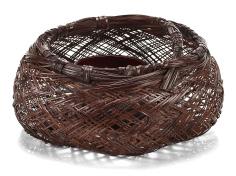
251
TANABE
By Tanabe Chikuunsai I (1877-1937), signed Chikuunsai zo kore Japan, c.1920s
Of tall, ovoid form with a slightly flaring narrow foot rising to a waisted neck and everted rim, the basket is masterfully woven from darkly smoked bamboo in a combination of tight plaiting and open latticework. The upper section features finely spaced vertical slats transitioning into dense horizontal weaving. The tall, arched handle is formed from two bamboo strips bound at the joints with delicate rattan wrappings. Signed underneath CHIKUUNSAI zo kore [this is made by Chikuunsai]. With an otoshi (water holder).
HEIGHT 57 cm
Condition: Excellent condition with minor wear.
With an associated wood tomobako (storage box).
Tanabe Chikuunsai I (1877–1937) was one of the most influential Japanese bamboo artists of the early 20th century and the founder of the renowned Tanabe lineage of bamboo masters. Born Tsuneo, the third son of Tanabe Chikatoki Yoshitsune, physician to the Amagasaki Domain, he apprenticed under the celebrated bamboo artist Wada Waichisai I at age twelve. In 1901, upon his master’s death, he inherited the art name Chikuunsai (“Bamboo Cloud”) and established his own workshop in Osaka, later relocating to Sakai, a historic center of sencha and wabi-cha culture. His mastery blended Chinese-style precision with the spirit of Japanese literati aesthetics, earning him national acclaim and international recognition, including a Bronze Medal at the 1925 Paris International Exhibition of Modern Decorative and Industrial Arts.
MUSEUM COMPARISON
Compare a closely related bamboo hanakago by the same artist, dated to c. 192645, in the National Crafts Museum Tokyo, collection identification number Bm0043.
AUCTION COMPARISON
Compare a closely related bamboo hanakago by the same artist, signed Chikuunsai kore o tsukuru, dated to the 1920s, 61.5 cm (high), at Bonhams, Snow, Sex and Spectacle, 13 May 2021, London, lot 89 (sold for GBP 17,750 or approx. EUR 23,500 converted and adjusted for inflation at the time of writing).
Estimate EUR 2,000
Starting price EUR 1,000




252
IIZUKA KYOKUSHO: A BAMBOO AND RATTAN HANAKAGO (FLOWER BASKET) TITLED ‘ARANAMI’
By Iizuka Kyokusho, signed Kyokusho saku Japan, c. 1920s-1930s
In the form of a rounded kusudama (ornamental festival ball) with a tall, twisted handle, the basket is dynamically woven from broad, flat strips of smoked bamboo that interlace in a vigorous, sculptural pattern. The composition overlaps bands forming an intricate lattice. Signed underneath KYOKUSHO saku [made by Kyokusho].
HEIGHT 35 cm

Jay Jones and Mary Jayne Jones
Provenance: Kagedo Japanese Art, Seattle. Collection of Jay Jones and Mary Jayne Jones, acquired from the above. A copy of the invoice from Kagedo Japanese Art, dated to 7 May 2010, stating a purchase price of USD 22,000 or approx. EUR 28,000 (converted and adjusted for inflation at the time of writing). Jay (1924–2024) and Mary Jayne Jones (1924–2022) were discerning collectors whose diverse and carefully curated art collection reflected a lifetime of curiosity and connoisseurship. Based in the Seattle area, they assembled an impressive range of works, from Arctic Inuit sculpture and archaic Asian artifacts to an exceptional group of early 20th-century Japanese lacquer scholar’s boxes. Their collection also encompassed a distinctive selection of American paintings, spanning from historical works to contemporary art. Condition: Very good condition with minor wear and natural imperfections.
Iizuka Kyokusho (1926–1989) was a distinguished Japanese bamboo artist and a member of the renowned Iizuka family of bamboo craftsmen, one of the most important dynasties in modern Japanese basketry. He was the younger brother of Iizuka Rokansai


The invoice from Kagedo Japanese Art, dated to 7 May 2010, stating a purchase price of USD 22,000 or approx. EUR 28,000
(1890–1958), widely regarded as the father of modern bamboo art, and Iizuka Hosai II (1892–1974). Working primarily in Tokyo, Kyokusho often employed slat bamboo techniques, creating bold, sculptural compositions.
AUCTION COMPARISON
Compare a closely related hanakago by the artist’s brother, Iizuka Rokansai, dated to the Taisho period (1912-1926) to Showa period (1926-1989), 35.6 cm (high), at Christie’s, Japanese and Korean Art, 20 March 2013, New York, lot 734 (sold for USD 16,250 or approx. EUR 19,500 converted and adjusted for inflation at the time of writing).
Estimate EUR 4,000
Starting price EUR 2,000

HAYAKAWA SHOKO: A BAMBOO AND RATTAN HANAKAGO (FLOWER BASKET)
By Hayakawa Shoko (Hayakawa Shokosai V, 1932 -2011), signed Shoko zo Japan, c. 1965-1977
The broad, flaring circular body rising from a square pedestal base, expertly woven from bamboo and rattan, the structure alternates between open diagonal and tight horizontal plaiting, the rim is reinforced with a thick, twisted braid. Signed underneath SHOKO zo [made by Shoko]. With an otoshi (water holder).
HEIGHT 16 cm, LENGTH 29.5 cm
Provenance: A private collection of bamboo flower baskets in Florida, United States purchased from Kawasaki Bijutsu Gallery in Japan.
Condition: Excellent condition with minor wear.
Hayakawa Shokosai V (1932–2011) was a master bamboo artist and head of the Hayakawa Shokosai lineage, designated a Living National Treasure in 2003 for his contributions to bamboo craft. From 1963 onward he adopted the art name Shoko and presented his first solo exhibition in 1965, establishing his reputation for bold forms and refined weaving. Upon the death of his father, Hayakawa Shokosai IV, in 1975, he officially succeeded as the fifth generation in 1977.
AUCTION COMPARISON
Compare a closely related bamboo and rattan hanakago by the same artist, Hayakawa Shokosai V, dated 2005, 19 cm (high), at Christie’s, The Collection of Victoria, Lady de Rothschild, 9 December 2021, London, lot 149 (sold for GBP 13,750 or approx. EUR 20,500 converted and adjusted for inflation at the time of writing).
Estimate EUR 1,500
Starting price EUR 800

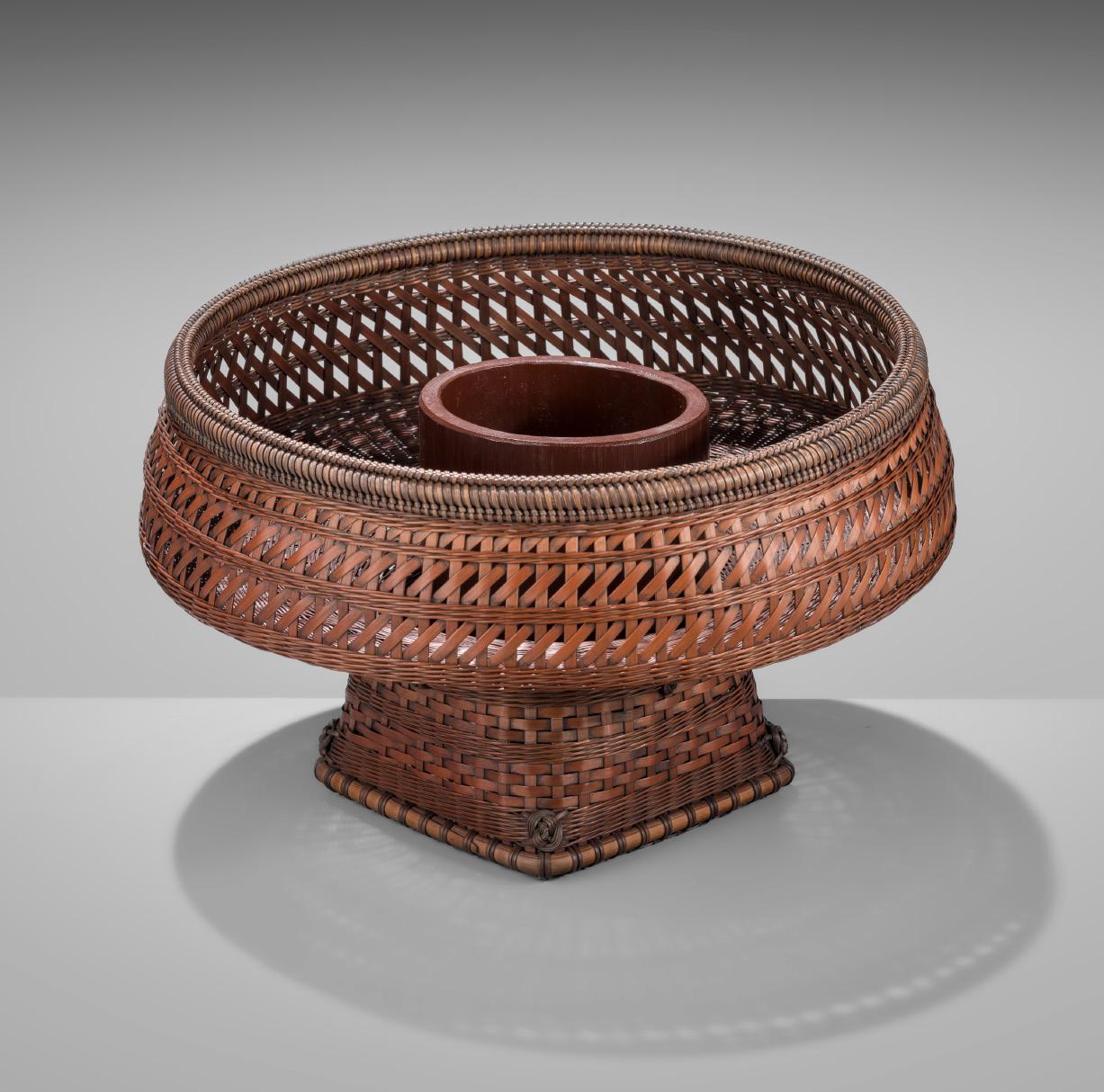
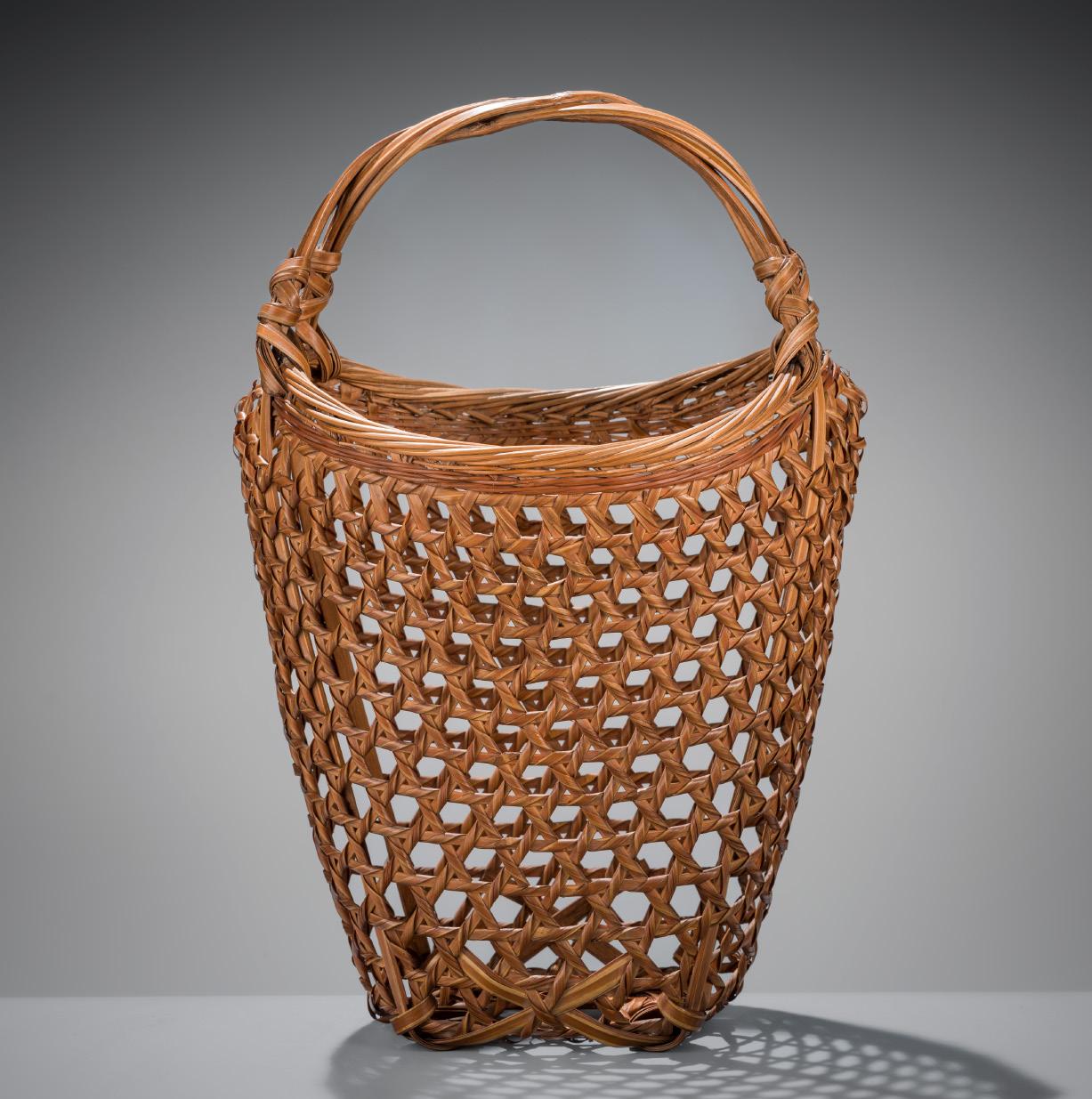
254
CHIKUSAI: A BAMBOO AND RATTAN ‘MANDARIN FISH’-TYPE HANAKAGO (FLOWER BASKET)
By Chikusai, signed Chikusai tsukuru kore Japan, c. 1926-1930s
Of tall, tapering form with an oval base, the basket is masterfully woven in an open hexagonal lattice pattern from warm bamboo. The dynamic, openwork body is framed by a reinforced double rim and a twisted bamboo handle secured with intricate knot bindings. Signed to the base CHIKUSAI tsukuru kore [this was made by Chikusai].
HEIGHT 35.5 cm
Provenance: Flying Cranes Antiques, New York. Collection of Jay Jones and Mary Jayne Jones, acquired from the above.
A copy of the invoice from Flying Cranes Antiques, dated to 16 July 2008, stating a purchase price of USD 5,395 or approx. EUR 6,800 (converted and adjusted for inflation at the time of writing). Jay (1924–2024) and Mary Jayne Jones (1924–2022) were discerning collectors whose diverse and carefully curated art collection reflected a lifetime of curiosity and connoisseurship. Based in the Seattle area, they assembled an impressive range

Jones and Mary Jayne Jones
of works, from Arctic Inuit sculpture and archaic Asian artifacts to an exceptional group of early 20th-century Japanese lacquer scholar’s boxes. Their collection also encompassed a distinctive selection of American paintings, spanning from historical works to contemporary art.
Condition: Excellent condition with minor wear.
Chikusai was an early 20th-century Japanese bamboo artist and a disciple of the renowned bamboo master Tanabe Chikuunsai I (1877–1937). Active during the Showa period (circa 1926–1930s), Chikusai is known for his finely leached bamboo ikebana baskets characterized by elegant twisted handles, intricate hexagonal or openwork asa-no-ha (hemp leaf) plaiting, and refined natural finishes. Working in the Kansai region, an area that suffered significant wartime losses, few of Chikusai’s works survive, making them important records of pre-war bamboo artistry.
MUSEUM COMPARISON
Compare a related bamboo hanakago (flower basket), by Maeda Chikubosai I, dated 1941, 45.1 cm (high), in the Conell University, object number 2012.015.021.
Estimate EUR 2,500
Starting price EUR 1,200

255
KOSUGE CHIKUDO: A BAMBOO AND RATTAN HANAKAGO (FLOWER BASKET)
By Kosuge Chikudo (1895-1966), signed Chikudo saku Japan, c. 1926-1945
Of tall, ovoid form with a rounded base and slightly flaring mouth, the basket is woven from finely split vertical bamboo strips bound with rattan and secured at the rim with a thickly wrapped braid. The tall, arched handle is bound to the rim with intricate rattan knots. Signed underneath Chikudo saku [made by Chikudo]. With a bronze and bamboo otoshi (water holder).
HEIGHT 38 cm
Provenance: A private collection of bamboo flower baskets in Florida, United States. Condition: Excellent condition.
Kosuge Chikudo (1895–1966) was a prominent Japanese bamboo artisan based on Sado Island whose work made a lasting mark in the development of 20th-century bamboo art. He founded a distinctive regional lineage, and his approaches influenced the manner in which bamboo baskets combined functional integrity with artistic expression. Chikudo drew inspiration from the Iizuka workshop traditions of Tochigi and Tokyo, which emphasized aesthetic contrast between finely woven plaiting and simpler structural elements. His sons, including Kogetsu Chikusai, carried forward and expanded his legacy, introducing innovative techniques while maintaining fidelity to Chikudo’s foundational principles. Today, the Kosuge lineage is regarded as part of the important network of Japanese bamboo weaving schools, especially in the Niigata–Sado region.
MUSEUM
COMPARISON
Compare a closely related bamboo hanakago (flower basket) by the same artist, Kosuge Chikudo, 48.3 cm (high), in the Asian Art Museum San Francisco, object number 2006.3.667.
Estimate EUR 1,500
Starting price EUR 800

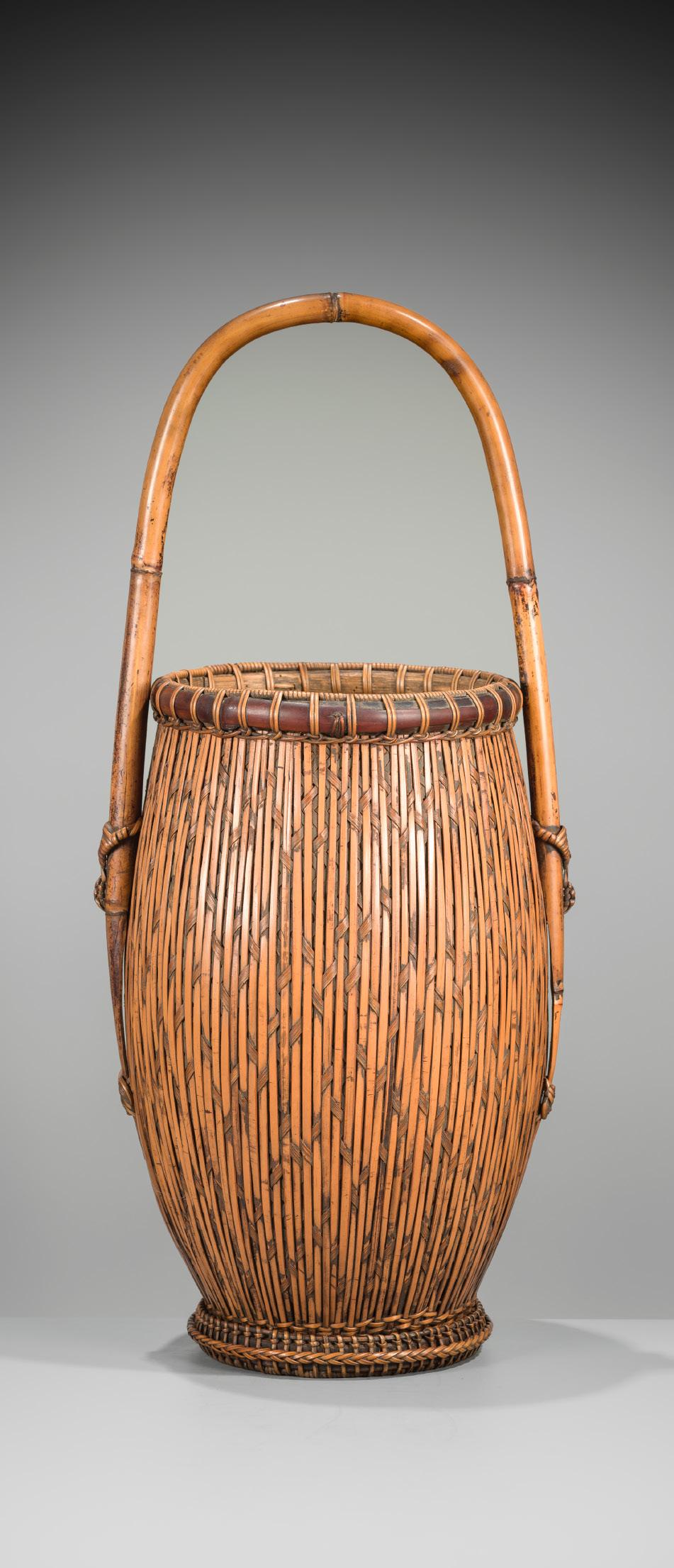

256
HONDA SYORYU: DANCE
By Honda Syoryu (Shoryu, born 1951), signed Syoryu Japan, 2002
Of abstract from, intricately carved from madake bamboo and rattan, signed on an inlaid bamboo tablet to the underside. With the original box.
SIZE 28.5 x 29 x 29.5 cm
Provenance: From a private collection of Japanese bamboo baskets in San Francisco, California, acquired at TAI Modern, Santa Fe, 15 February 2003. A copy of the invoice accompanies this lot. TAI Gallery was founded by Robert T. Coffland, a leading expert in Japanese bamboo arts in the West, who began sourcing works from contemporary masters in Japan. In 2014, the gallery was purchased by Margo Thoma, merged with her own gallery Eight Modern, and rebranded as TAI Modern. Together with Koichiro Okada, a renowned bamboo expert, they support bamboo art in the West by serving as an advisor to Western collectors and institutions, facilitating public demonstrations, and curating bamboo art exhibitions. Works by TAI Modern artists have been placed in some of the country’s most prestigious institutions, including the Art Institute of Chicago, the Metropolitan Museum of Art, the Denver Art Museum, the Los Angeles County Museum of Art, the Asian Art Museum, and many more. Tai Modern regularly features artworks by Honda Syoryu and has published several catalogs on the artist. Condition: Excellent condition.
Honda Syoryu himself remarks: “I create sculptures about space and time, about the magnificence and mystery of the universe. Six years ago, I moved to the city of Matsumoto, where the sky and mountains spread out before my eyes. I am becoming more and more inspired by the beauty of this area. Working with bamboo, it is almost impossible to have total control over the form that you intend to make. When I make my art, I am in constant dialogue with the bamboo. This material’s unique pliability allows me to draw beautiful, naturally curving lines in space. The textures I create cannot be achieved with any other medium. I feel great satisfaction when working together with the bamboo leads me to create a sculpture beyond my imagination.”

Syoryu has virtually abandoned traditional ideas about the function of basketry acquired during his early training, choosing instead to create dramatic curvilinear sculptures from fine stained bamboo strips woven in nawame (twining) technique. Once a few rows of twining have been completed, he leaves the verticals exposed for several inches at both ends, uses hot water to soften the entire piece, and then kneads it into shape, pulling up some of the rows to form the gaps seen in the finished work. The free ends of the verticals are then plaited and secured with a binding of rattan.
Works by this exceptional artist are held in various museum collections such as The Metropolitan Museum of Art, New York, The Museum of Fine Arts, Boston, MA, and The Asian Art Museum, San Francisco. He has received many prizes for his bamboo sculptures.
MUSEUM COMPARISON
Compare a closely related bamboo sculpture by the same artist, titled Dance, dated 2000, in the Metropolitan Museum of Art, object number 2019.424.11.
AUCTION COMPARISON
Compare a related bamboo sculpture by the same artist, titled Galaxy (Seiun) 2001, at Christie’s, The Collection of Victoria, Lady de Rothschild, 9 December 2021, London, lot 161 (sold for GBP 18,750 or approx. EUR 27,500 converted and adjusted for inflation at the time of writing).
Estimate EUR 10,000
Starting price EUR 5,000
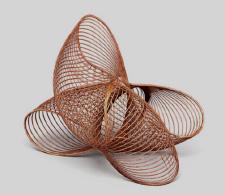
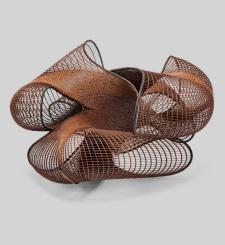
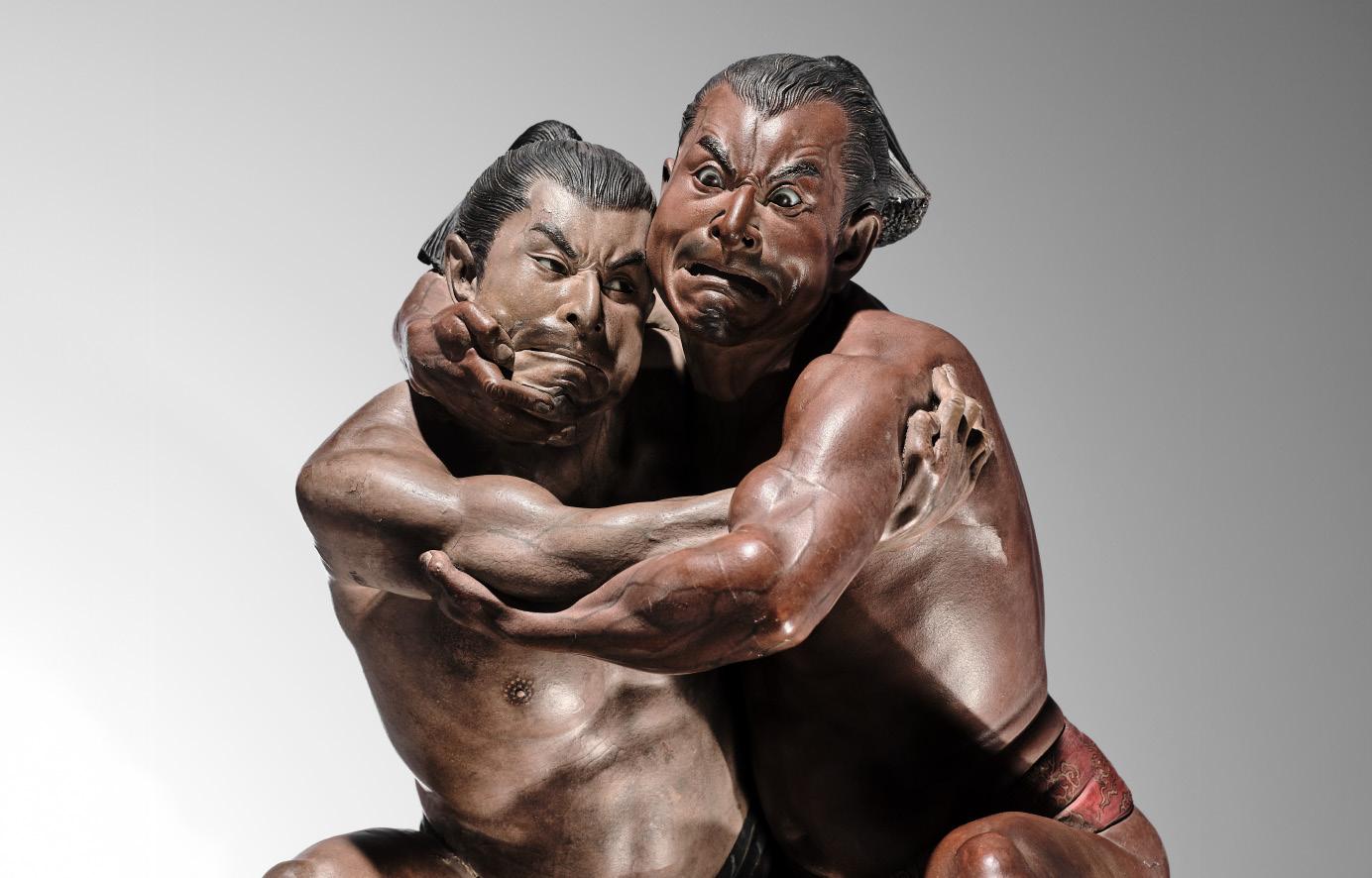
YAMAMOTO:
By Yamamoto, signed Yamamoto to with kakihan Japan, late 19th century, late Edo period (1615-1868) to Meiji period (1868-1912)
Exhibited: Brandt Oriental Art, London, Salon international d’art asiatique, 5 - 8 October 2001, Hôtel Dassault, Paris.
Naturalistically modeled, the composition captures two sumo wrestlers locked in the climactic moment of the kawazu gake, or leg entanglement throw. The pair twist and strain in perfect balance, their muscular forms rendered with extraordinary realism. The dark toned skin is layered with subtle pigments over gesso, the surface detailed with veins along the arms and feet, fine arm hair, and minute creases at the joints. The faces are strikingly alive, the eyes inlaid in glass and glistening with tension, the mouths opened in

exertion, expertly hollowed and inlaid with individually carved teeth. Even the soles of the feet are worked with creases and naturalistic coloration. One foot bears the signature YAMAMOTO to [carved by Yamamoto] and a kakihan.
SIZE 39 × 30 × 57 cm
Provenance: Brandt Oriental Art, London, 2001. British private collection, acquired from the above.
Condition: Overall excellent condition with expected wear, light crackling, tiny losses along the edges, a few tiny nicks here and there, all as is to be expected from this type.
Iki-ningyo are lifelike dolls that gained popularity in misemono (public exhibitions) during Japan’s Edo period. Produced from the late Edo through the Meiji period, they were crafted with such realism that they appeared almost human. These figures typically depicted characters from legend and history, deities and Buddhas, renowned courtesans, or foreign and exotic subjects.
MUSEUM COMPARISON
Compare a related life size (170x150x160 cm) iki ningyo of two sumo wrestlers, by Kamehachi Yasumoto, who was related to the present carver Yamamoto, c. 1890, in the Contemporary Art Museum, Kumamoto.
AUCTION COMPARISON
Compare a related iki ningyo of sumo wrestlers, dated to c. 1890, 57.7 cm high, at Bonhams, Fine Japanese and Korean Art, 24 September 2020, New York, lot 915 (sold for USD 12,575 or approx. EUR 13,500 converted and adjusted for inflation at the time of writing).
Estimate EUR 15,000
Starting price EUR 7,500
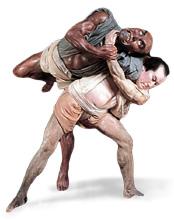



258
OGAWA HARITSU: A SUPERB INLAID LACQUER TSUITATE (TABLE SCREEN)
By Ogawa Haritsu (Ritsuo, 1663–1747) or a close follower, sealed Kan Japan, 18th century, Edo period (1615–1868)
Of rectangular form with softly rounded edges, standing on two feet, the panel set within a wood frame. Finely decorated in takamaki e, hiramaki e, and togidashi e, enriched by a harmonious blend of mixed media inlays.
One side depicts a scene from the Tale of Genji (chapter 27, Kagaribi, Cresset Fires). An ox drawn carriage (gosho guruma) stands to the left, inlaid with pewter and aogai shell, beside a maple and cherry tree whose leaves are rendered in red and green ceramic. Beneath the trees, Prince Genji’s courtiers wait beside a small campfire, their robes inlaid in ceramic of varied hues.
The reverse shows a Ranryo-o dancer from bugaku, his fierce mask and flowing robe in vivid red, green, and blue tones, patterned with delicate floral crests. At his side coils a snake, its tongue extended. Sealed in green ceramic KAN to the left of the snake. The lower section of the frame is inset with a softwood panel pierced with three sections lined in hardwood.
SIZE 17 × 41 × 45 cm
Condition: Good condition and presenting beautifully. A few losses to inlays, some with associated non-distracting touchups.
rare screen painting by Ogawa Haritsu, also depicting Bugaku dancers, Bonhams, Fine Japanese Works of Art, 25 March 2010, New York, lot 2160

With a wood tomobako (storage box).
Ogawa Haritsu (formerly often referred to outside Japan by his alternative name of Ritsuo) was among the first Japanese lacquer artists to establish an independent reputation outside of the hereditary craft dynasties of Kyoto, Edo, and Kanazawa. Following an early career as a haiku poet, he is thought to have first turned his attention to lacquer design in middle age and soon attracted a wide following thanks to his novel choice of subject matter and pioneering and imaginative use of unusual materials; at some point after 1710 he was hired by Tsugaru Nobuhisa (1669-1747), lord of a domain in northern Japan, for whom he worked until 1731.
This richly inlaid tsuitate, with its dual themes of courtly elegance and ritual dance, embodies the wit and technical audacity for which Haritsu’s work is prized. The ceramic Kan seal, refined palette, and innovative blend of materials align it closely with the master’s late Edo milieu and the enduring influence of his atelier.
AUCTION COMPARISON

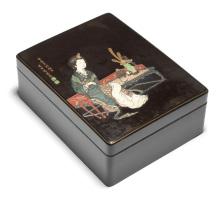
Compare a related Ritsuo-style inlaid lacquer wood box, sealed Kan, dated to the 19th century, 12.2 x 31.1 x 40.7 cm, at Christie’s, Japanese and Korean Art, 22 March 2002, New York, lot 128 (sold for USD 30,550 or approx. EUR 48,000 converted and adjusted for inflation at the time of writing). Compare a related inlaid lacquer bunko, by Ogawa Haritsu, dated to 1716, 14.5 x 30.5 x 39 cm, at Bonhams, The Edward Wrangham Collection of Japanese Art, 10 November 2015, London, lot 158 (sold for GBP 9,375 or approx. EUR 17,000 converted and adjusted for inflation at the time of writing).
Estimate EUR 6,000
Starting price EUR 3,000
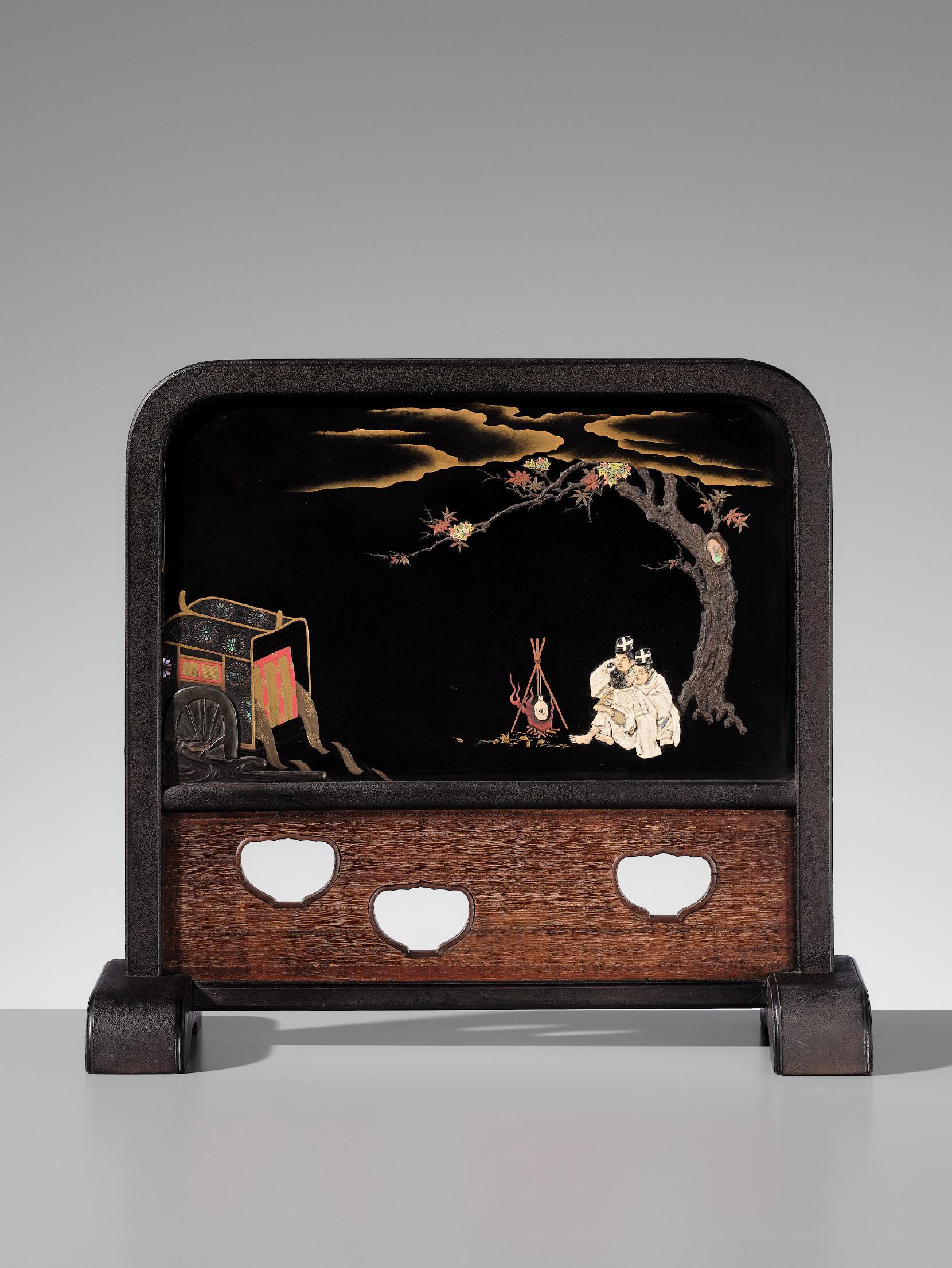

OGAWA HARITSU: AN IMPORTANT AND LARGE INLAID LACQUER ‘ELEPHANT’ KORO (INCENSE BURNER)
By Ogawa Haritsu (Ritsuo,
1663-1747),
sealed Kan and Naoyuki (Shoko)
Japan, 18th century, Edo period (1615-1868)
Finely carved from wood in the form of a large reclining elephant, its head gently raised and trunk curling upward. The body is decorated with an elaborate gold caparison executed in takamaki-e and hiramaki-e, adorned with floral medallions, auspicious emblems (takaramono), and jewel motifs (hoju), further enriched with inlays of mother-of-pearl and green and red-glazed ceramic. The white tusks contrast beautifully with the deep brown lacquer of the body. Resting atop the figure is a reticulated metal cover, intricately pierced and chased with a dense pattern of blooming chrysanthemums. Sealed to the back KAN and NAOYUKI.
SIZE 23.5 x 24 x 62 cm
Condition: Excellent condition considering age and use. A few minor age cracks to the lacquer and some inlays, one tusk is slightly loose.
Ogawa Haritsu (formerly often referred to outside Japan by his alternative name of Ritsuo) was among the first Japanese lacquer artists to establish an independent reputation outside of the hereditary craft dynasties of Kyoto, Edo, and Kanazawa. Following an early career as a haiku poet, he is thought to have first turned his attention to lacquer design in middle age and soon attracted a wide following thanks to his novel choice of subject matter and pioneering and imaginative use of unusual materials; at some point after 1710 he was hired by Tsugaru Nobuhisa (1669-1747), lord of a domain in northern Japan, for whom he worked until 1731.
AUCTION COMPARISON
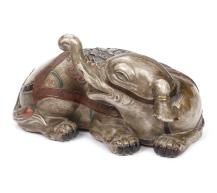

Compare a closely related but smaller inlaid lacquer okimono of an elephant, by Ogawa Haritsu (Ritsuo), signed Muchuan Haritsu with seal Kan, dated to the 18th century, 14 x 25.1 cm, at Bonhams, Fine Japanese Art, 12 May 2011, London, lot 92 (sold for GBP 84,000 or approx. EUR 168,000 converted and adjusted for inflation at the time of writing). Compare a related but smaller lacquer koro (incense burner) in the form of an elephant, attributed to Ogawa Haritsu (Ritsuo), unsigned, dated to the 18th century, 20.5 x 27 cm, at Bonhams, The Last Treasures from the Edward Wrangham Collection of Japanese Art, 19 July 2021, London, lot 219 (sold for GBP 11,475 or approx. EUR 17,500 converted and adjusted for inflation at the time of writing).
Estimate EUR 20,000
Starting price EUR 10,000




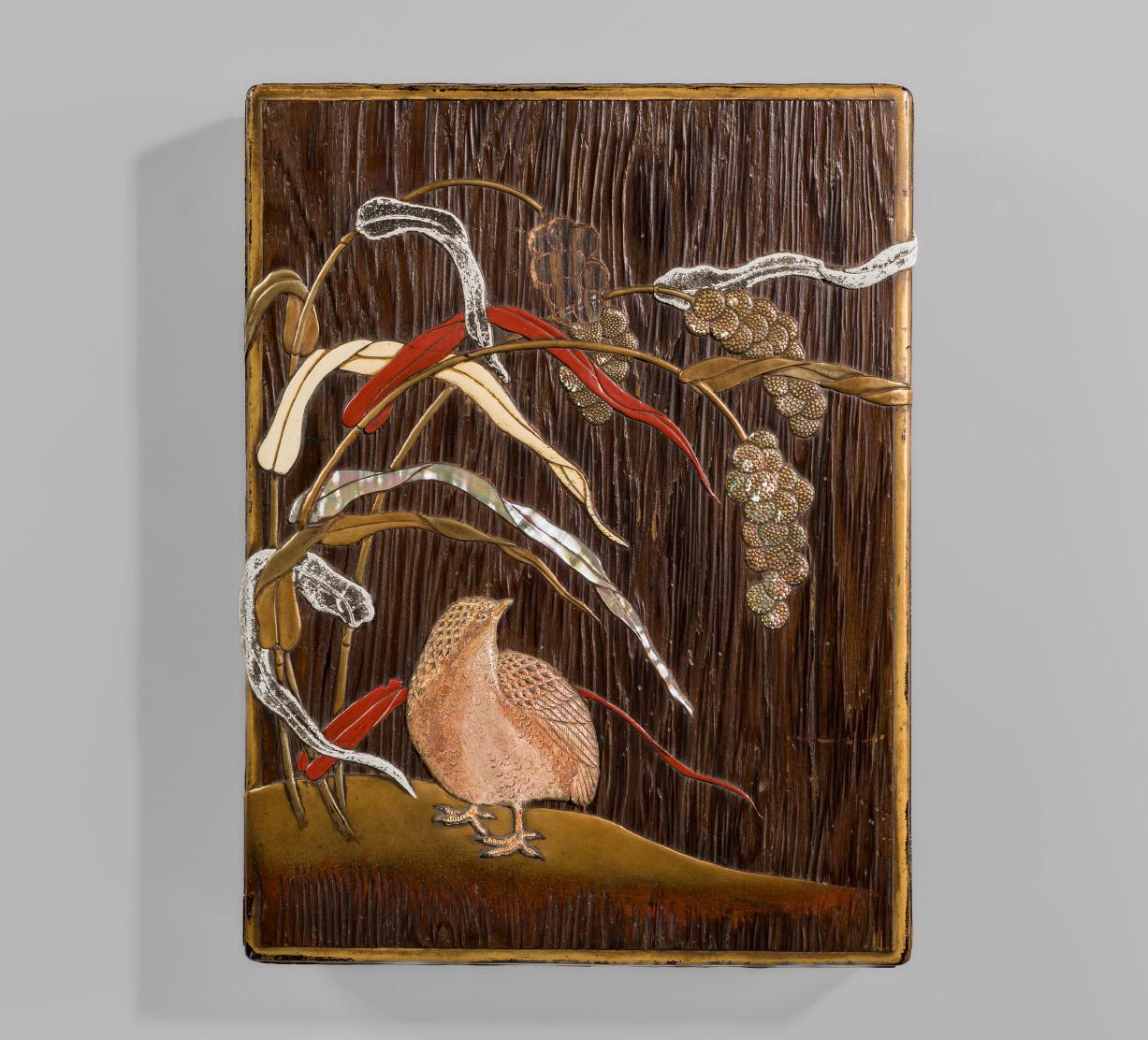
260
MOCHIZUKI HANZAN: A SUPERB CERAMIC-INLAID LACQUER SUZURIBAKO (WRITING BOX)
DEPICTING A QUAIL WITH MILLET
By Mochizuki Hanzan (Haritsu II,1743-1790), sealed Hanzan Japan, 18th century, Edo period (1615-1868)
Of rectangular form with gold fundame edges, the wood ground covered with clear lacquer to heighten the grain and superbly decorated in gold and iro-e takamaki-e, enriched by a harmonious blend of mixed-media inlays. The kabusebuta (overhanging) lid presents a ceramic-inlaid quail looking up beneath stalk of millet, exceptionally inlaid with glazed ceramic, antler, pewter,

mother-of-pearl and tsuishu (carved red lacquer). The interior of the lid is decorated with a finely detailed sozu (bird scarer), composed of a bundle of bamboo tubes suspended by rope, executed in pewter and antler, set against a lustrous roiro ground, and sealed within a red-lacquered square seal cartouche HANZAN.
SIZE 5 x 20.3 x 26.8 cm
Condition: Good condition and presenting beautifully. Obvious loss to one inlay of the millet. The corners with typical crackling and tiny losses to edges. The interior with some light cracks to the roiro ground and with some tiny nicks to the surface, as well as small chip to the edge of the underside. The implements are lost or were never included.
The motif of uzura ni awa (quail with millet) is a beloved seasonal theme in Japanese art, traditionally symbolizing autumn. The pairing of the modest quail with ripe millet conveys both the quiet beauty of the season and auspicious associations of endurance, abundance, and harmony with nature.
AUCTION COMPARISON
Compare a closely related lacquer suzuribako with quails, by Mochizuki Hanzan, at Christie’s, Lacquer from the Japanese Department of Eskenazi, 17 November 1999, London, lot 11 (sold for GBP 24,150 or approx. EUR 68,500 converted and adjusted for inflation at the time of writing).
Estimate EUR 6,000
Starting price EUR 3,000
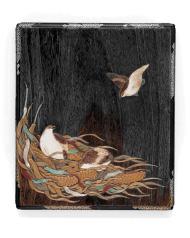
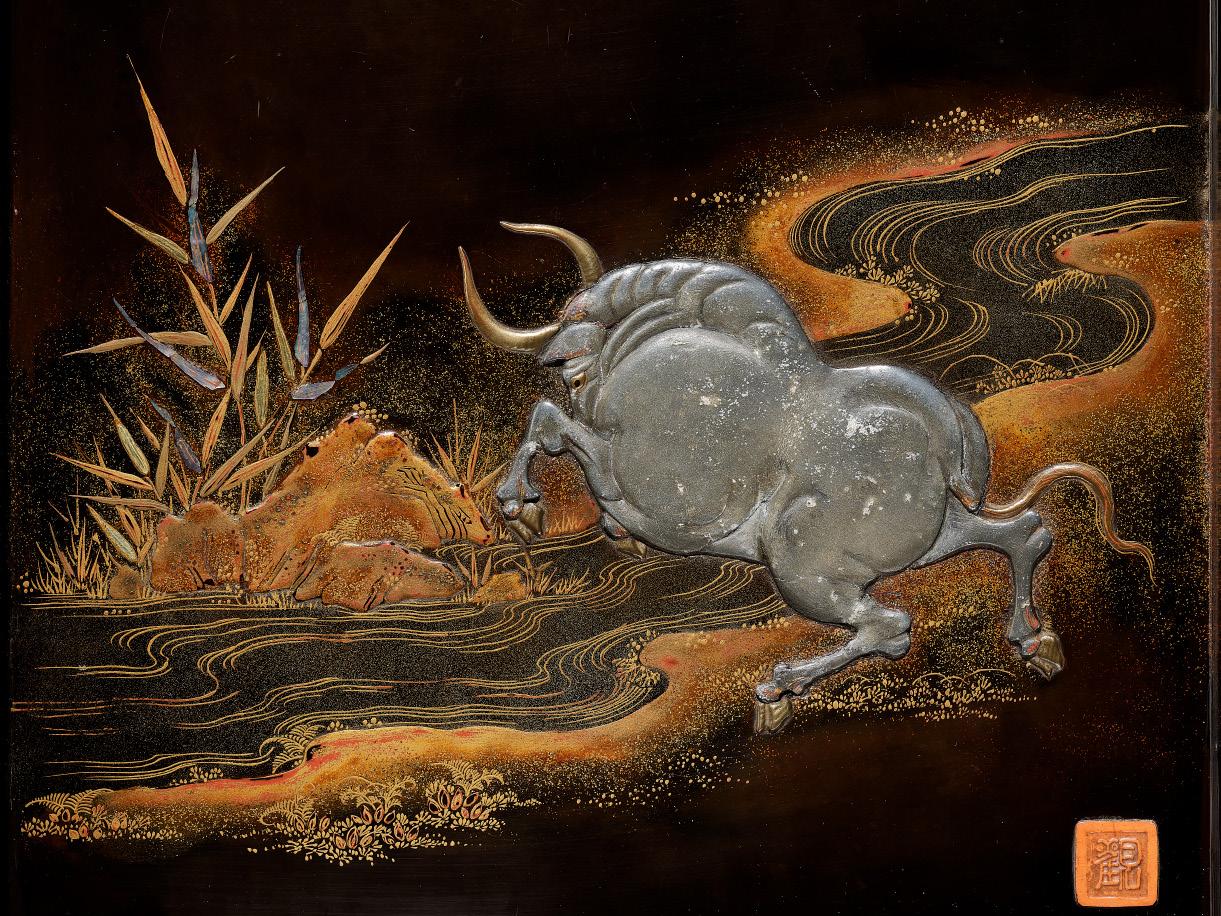
261
KAN: A MASTERFUL RITSUO STYLE INLAID LACQUER BUNKO (DOCUMENT BOX) REFERENCING SUGAWARA NO MICHIZANE
By a follower of Ogawa Haritsu (Ritsuo, 1663-1747), most likely by Mochizuki Hanzan (1743-1790), sealed Kan Japan, second half of 18th century, Edo period (1615-1868)
Published & Exhibited: Cornell University, Herbert F. Johnson Museum of Art, Scattered Gold and Midnight Gloss: Japanese Lacquer from the Anbinder Collection, 31 March – 8 July 2007, p. 11.
Of rectangular form with lobed edges, the top and sides each with a shaped sunken panel bearing a beautiful gold kinji ground, the cover finely decorated with inlays of aogai, mitsuda, eggshell, coral, and glazed ceramic as well as gold, black, and red takamaki-e to depict three cranes in front of an entrance to the Dazaifu shrine with a blossoming plum tree in the courtyard, the gate tower with subtly inlaid glass windows, the gate and wall roughly textured imitating plaster, the edges and base finished in ishime, the sides gold-lacquered in low relief with Chinese poems (kanshi) by Sugaware no Michizane. The interior of roiro with gold fundame edges, the interior of the cover with gold, red, and black hiramaki-e and takamaki-e with kirigane and mura-nashiji as well as inlays of aogai and mitsuda (pewter) to depict an ox bucking before a meandering river, the lower right corner with an inlaid ceramic seal KAN.
SIZE 10.6 x 37.6 x 28.8 cm
Provenance: Heian Art, Kyoto, Japan. The Paul and Helen Anbinder Collection, acquired from the above. Paul Anbinder (b. 1940) is a retired editor who was a director at important publishers, including Random House and Hudson Hills.
Condition: Very good condition with minor wear, few tiny nicks, occasional light scratches, minor flaking to ceramic inlays, little rubbing to lacquer and mitsuda inlay.
The style of the present bunko is clearly that of Ogawa Haritsu (Ritsuo, 1663-1747), but it is more likely to be by Mochizuki Hanzan (Haritsu II, 1743-1790) or a close follower.
With a wood storage box.
AUCTION COMPARISON

Compare a related woven rattan suzuribako by Mochizuki Hanzan, with a similar shaped panel to the top of the cover, dated to the 18th century, at Bonhams, The Edward Wrangham Collection of Japanese Art Part II, 10 May 2011, London, lot 361 (sold for GBP 19,200). Also compare to a related suzuribako by Mochizuki Hanzan, sealed Hanzan, worked with similar bright inlays, at Zacke, Fine Japanese Art, 3 December 2021, Vienna, lot 165 (sold for EUR 50,560).
Estimate EUR 6,000
Starting price EUR 3,000



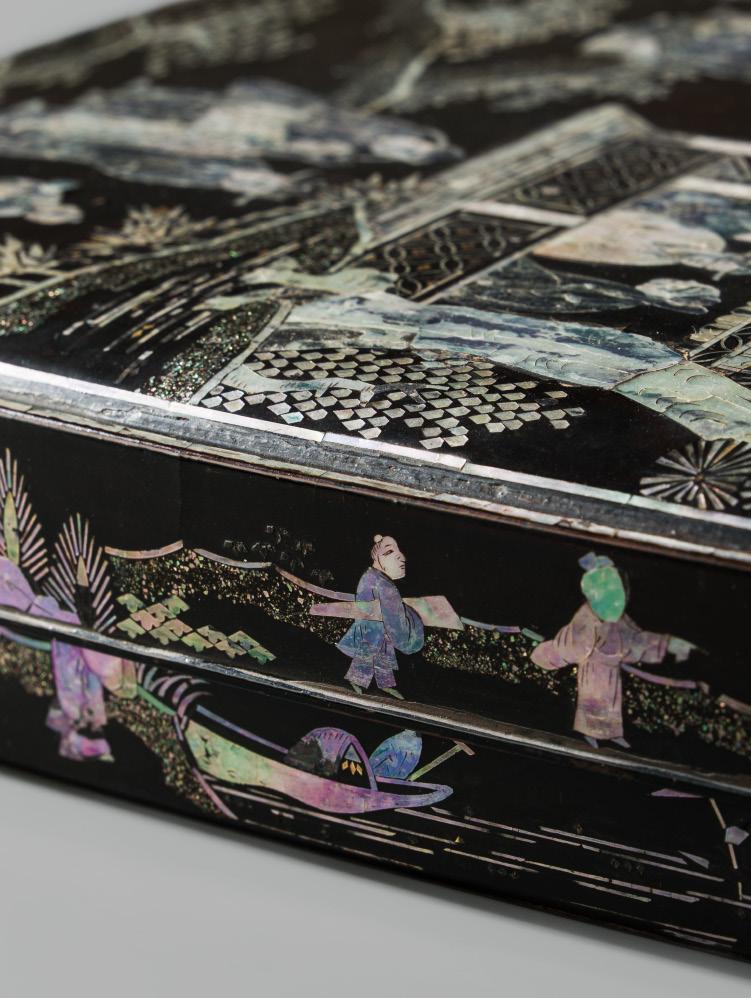
262
A RARE AND SUPERB INLAID RYUKYU LACQUER SUZURIBAKO (WRITING BOX) DEPICTING SCHOLARS AND ATTENDANTS
Japan, 17th-18th century, Edo period (1615-1868)
Of rectangular form with rounded corners, bearing a lustrous roiro ground delicately inlaid with aogai (mother-of-pearl). The kabusebuta (overhanging) lid depicts an elegant scene of several scholars gathered beneath a pine tree in a landscape featuring prunus trees, a pagoda, cranes, and a bridge. The figures are engaged in various scholarly pursuits, such as examining a scroll or engaging in contemplative discussion on a veranda. The sides of the lid and box are further adorned with a continuous band of figures set within a landscape dotted with floral sprays. The underside of the lid reveals leafy chrysanthemums and bush clovers beside a veranda, with butterflies hovering above. The interior is finished in roiro and fitted with a removable tray decorated with a delicate spray of ivy (tsuta). The rims are of pewter. The underside with an inlaid seal 松 (pine).
Provenance: Georg L. Hartl, Munich. A private collection in Lower Rhine, Germany, acquired from the above.
Condition: Good condition with minor wear, some cracks and chips, limited to the interior and edges. Typical minor losses to the inlays. The tray housing the ink stone and water dropper is lost.
MUSEUM COMPARISON
Compare a closely related Ryukyu lacquer box, dated to the 17th-18th century, 10.8 x 27 x 41.9 cm, in the Metropolitan Museum of Art, object number 2020.323.14a, b.
Estimate EUR 4,000
Starting price EUR 2,000

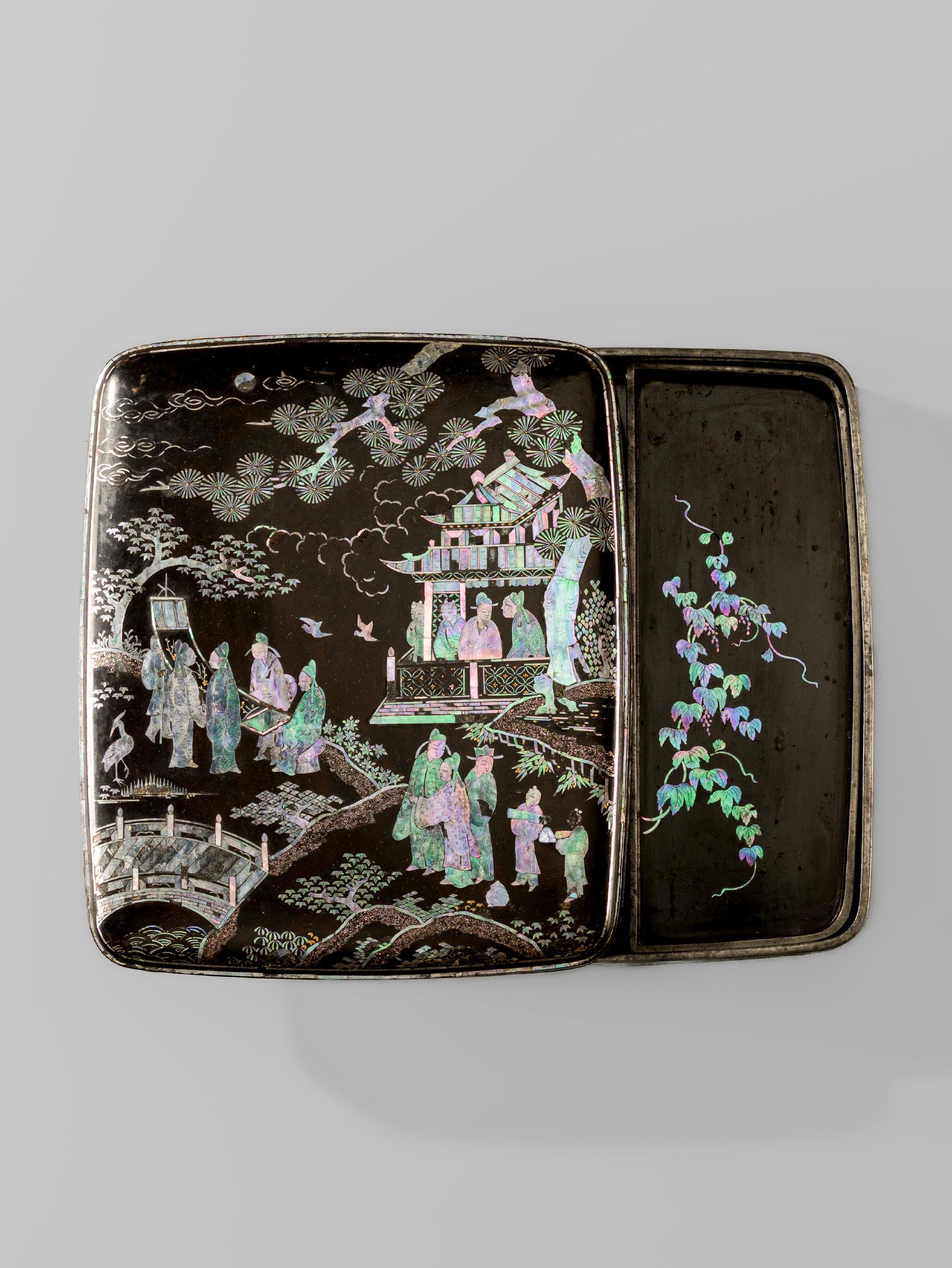

263
KORIN: A SUPERB RINPA STYLE LACQUER SUZURIBAKO (WRITING BOX)
Attributed to Ogata Korin (1658-1716), signed Korin Japan, 18th century, Edo period (1615-1868)
Of rectangular form, the box is finished in a lustrous roiro ground, embellished with e-nashiji and superbly decorated in takamaki-e, further enriched with a harmonious blend of mixed-media inlays. The flat kabusebuta (overhanging) lid depicts the upper lattice sections of two boats, inlaid in mitsuda (pewter) and laden with various grains rendered in shimmering mother-of-pearl, set upon a turbulent stream below a blossoming plum tree, the delicate petals likewise inlaid in shell.
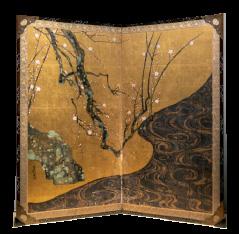
Ogata Korin (1658-1716) was a famous and highly influential Japanese landscape illustrator, lacquerer, painter, and textile designer of the Rinpa School. Korin is best known for his byobu folding screens, such as Irises and Red and White Plum Blossoms (both registered National Treasures), and his paintings on ceramics and lacquerware produced by his brother Kenzan (1663-1743). Also a prolific designer, he worked with a variety of decorative and practical objects, such as round fans, maki-e writing boxes, or inro medicine cases. He is also credited with reviving and consolidating the Rinpa school of Japanese painting, fifty years after its foundation by Hon’ami Koetsu (1558-1637) and Tawaraya Sotatsu (c. 1570-c. 1640). In fact the term ‘Rinpa’, coined in the Meiji period, means ‘school of [Ko]rin’. In particular he had a lasting influence on Sakai Hoitsu (17611828), who replicated many of his paintings and popularized his work, organizing the first exhibition of Korin’s paintings at the hundredth anniversary of his death.
The refined aesthetic continues within, where a delicate riverside landscape unfolds: chidori (plovers) flying above pine trees inlaid with mother-of-pearl, beside a flowing river. Signed to the side of the lid within a gold reserve, KORIN. The interior and base are finished in nashiji, fitted with a removable ita (baseboard), and housing the original implements: a metal water dropper (suiteki), a superbly lacquered and chiseled ink stick holder (sumi-basami) and a fitted rectangular inkstone (suzuri). The rims are finished in fundame.
SIZE 4 x 23 x 21 cm
Provenance: From the Collection of Jay R. Butterman, New York. Condition: Overall good condition with expected age-related wear and tiny chips to the edges and corners, a small crack to one corner, as well as a few obvious losses to the inlays. Otherwise, only typical traces of use. Presenting well.
Estimate EUR 2,000
Starting price EUR 1,000
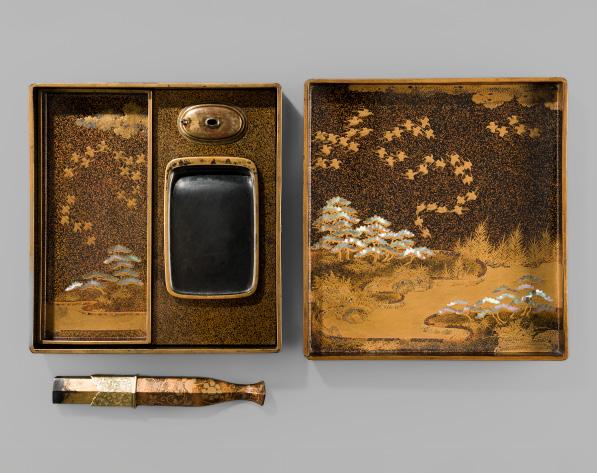

264
A FINE LACQUER SUZURIBAKO (WRITING BOX) OF A PLUM TREE AND MOON
Japan, 18th-19th century, Edo period (1615-1868)
Of rectangular form with rounded edges, bearing a lustrous roiro ground, the kabusebuta (overhanging) lid lacquered in sublime gold hiramaki-e depicting a blossoming plum branch beneath a silver moon, the design extending seamlessly to the sides of the lid and box. The interior cover and removable tray are similarly decorated with lush pines set against a lightly sprinkled black-lacquered ground and housing the original implements: a silver suiteki (waterdropper), a fitted rectangular suzuri (inkstone), and two lacquered writing brushes (fude), the brushes superbly lacquered with the Tokugawa family crest.
SIZE 4 x 21.5 x 23.5 cm
Condition: Good condition with typical wear to the edges, some cracks and chips, limited to the corners and edges, some with associated repairs and touchups. Obvious loss to the lacquer of the moon.
AUCTION COMPARISON
Compare a closely related lacquer suzuribako with bush clover beneath a moon, dated to the 19th century, at Christie’s, Japanese and Korean Art, 17 September 2024, New York, lot 120 (sold for USD 2,520 or approx. EUR 5,000 adjusted for inflation at the time of writing).
Estimate EUR 1,500 Starting price EUR 800


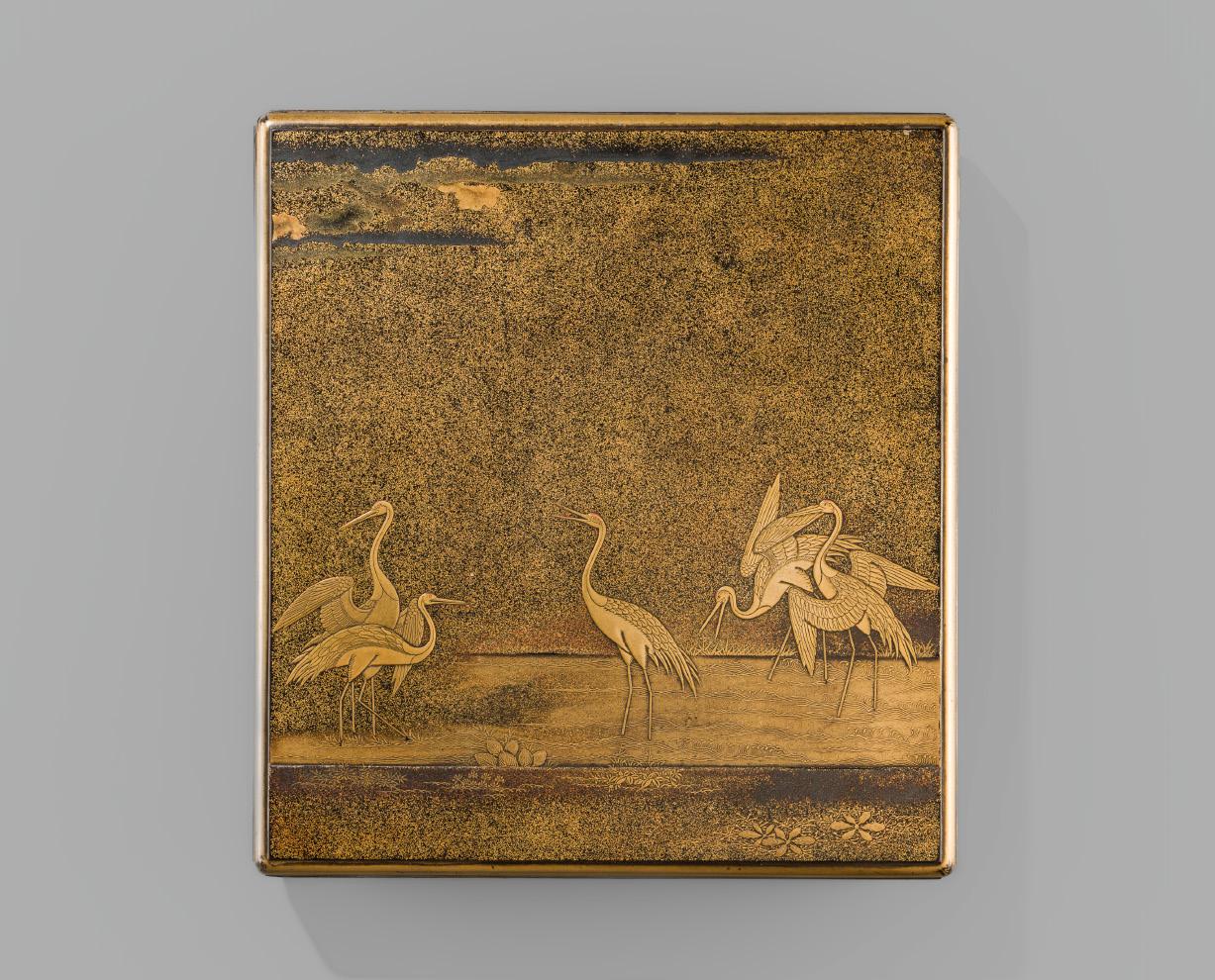
265
A FINE EARLY GOLD LACQUER SUZURIBAKO (WRITING BOX) DEPICTING CRANES
Japan, 17th-18th century, Edo period (1615-1868)
Of rectangular form with rounded edges, bearing a dense nashiji ground, finely decorated in gold takamaki-e and hiramaki-e and framed by fundame edges. The kabusebuta (overhanging) lid features a group of red-capped cranes gathered at the water’s edge, one calling out toward the shrouded clouds above, subtly evoking the presence of the moon. The interior of the lid is decorated with a finely detailed shoreline landscape, featuring huts nestled among pine and maple trees, and two boats drifting on undulating waters, the scene enriched with delicate kirigane flakes. With a removable tray lacquered with a pheasant perched on a rock and housing the original implements: a fitted rectangular suzuri (inkstone).
SIZE 4 x 21.6 x 23.5 cm
Provenance: Lempertz, Cologne, 12 November 1976, lot 643. A private collection in Lower Rhine, Germany, acquired from the above.
Condition: Good condition with typical wear to the edges, some cracks and chips, mostly limited to the corners and edges, some with associated repairs and touchups. Typical losses to the kirigane flakes, and an obvious loss to the rim of the inkstone. The water dropper (suiteki) is lost.
AUCTION COMPARISON
Compare a closely related lacquer suzuribako with cranes, dated to the 18th century, at Zacke, Fine Japanese Art, 4 June 2021, Vienna, lot 99 (sold for EUR 10,744).
Estimate EUR 2,500
Starting price EUR 1,200


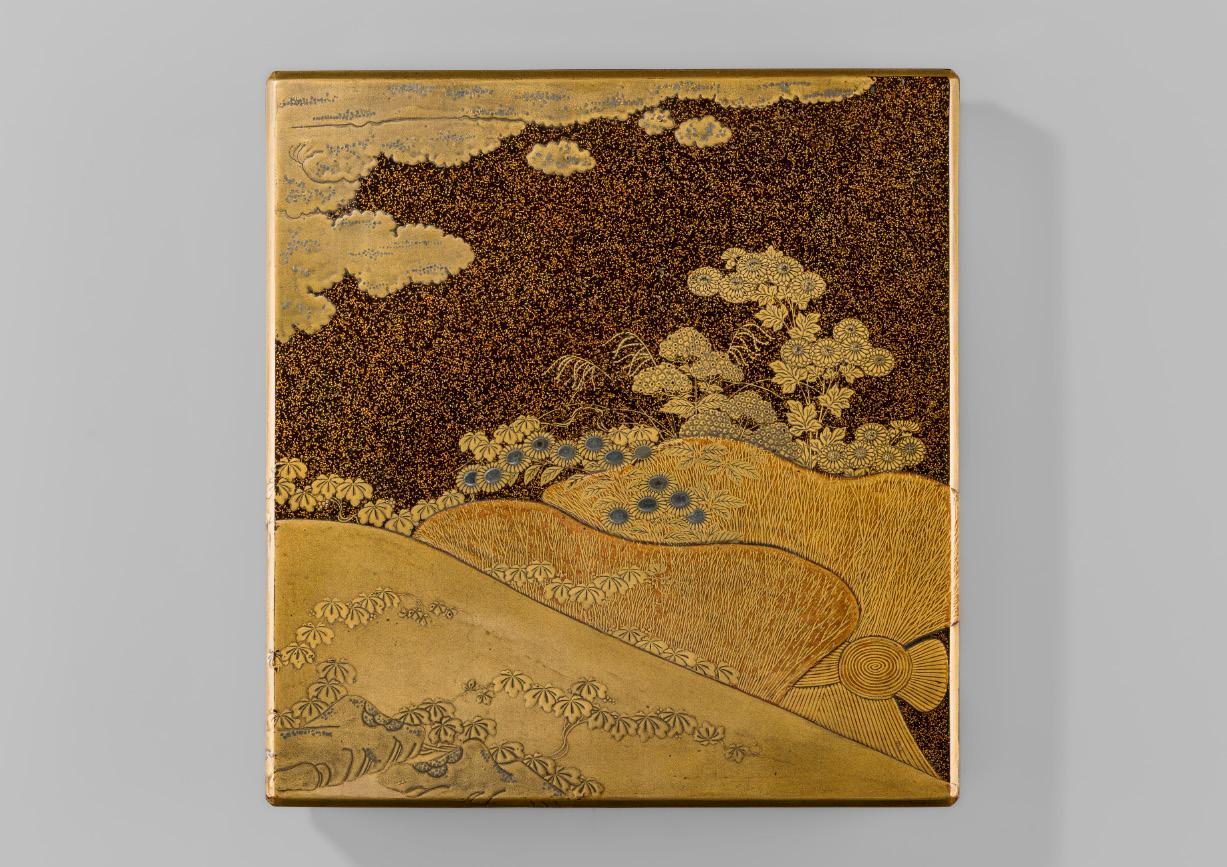
A FINE LACQUER SUZURIBAKO (WRITING BOX)
DEPICTING KIKU (CHRYSANTHEMUMS)
Japan, 18th century, Edo period (1615-1868)
Of rectangular form, bearing a sprinkled roiro ground, very finely decorated in gold and silver takamaki-e and hiramaki-e. The kabusebuta (overhanging) lid presents an elegant landscape with rolling hills, embellished with kirigane flakes, chrysanthemums and hydrangeas bloom among the hills beneath drifting clouds, the design continuing seamlessly onto the sides of the box. The interior of the lid is decorated with silver, red, and gold chidori flying across a large silver crescent moon, while the interior is similarly decorated with further Chidori, fitted with a small tray and housing the original implements: a superb mixed-metal suiteki (water-dropper) depicting seashells and seaweed, and a fitted rectangular suzuri (inkstone). The rims are finished in gold fundame.
SIZE 5 x 23.5 x 25 cm
Condition: Good condition with typical wear to the edges and corners. Small dents, losses to the kirigane flakes, and repairs to two corners with associated touchups.
MUSEUM COMPARISON
Compare a closely related lacquer suzuribako with chrysanthemum, dated to the 18th century, size 4.1 x 19.4 x 21 cm, in the Metropolitan Museum of Art, object number 38.25.109a–f.
AUCTION COMPARISON


Compare a related lacquer suzuribako with chrysanthemum and a moon to the lid’s interior, dated to the late 18th19th century, size 5 x 20.9 x 22.5 cm, at Bonhams, Fine Japanese and Korean Art, including the Crawford Collection of Surimono, 22 September 2021, New York, lot 1037 (sold for USD 14,025 or approx. EUR 14,000 converted and adjusted for inflation at the time of writing).
Estimate EUR 3,000
Starting price EUR 1,500


267 A FINE LACQUER SUZURIBAKO (WRITING BOX) DEPICTING UKIFUNE (A BOAT CAST ADRIFT) FROM THE TALE OF GENJI
Japan, 18th-19th century, Edo period (1615-1868)
Of rectangular form with rounded corners, bearing a dense e-nashiji ground, finely decorated in gold takamaki-e and hiramaki-e. The kabusebuta (overhanging) lid depicts Prince Genji seated in a boat with a court lady, both dressed in elegant robes embellished with kirigane flakes, drifting across tranquil waters within a rocky landscape with pines and young saplings. The underside of the lid reveals the lady in flowing robes, a fan in her hand, standing on a veranda beneath a cherry tree. The interior

in nashiji with further cherry trees, fitted with a removable ita (baseboard), and housing the original implements: a silver water dropper (suiteki) in the form of two cherry blossoms. The rims of fundame.
SIZE 5.2 x 21.8 x 24.1 cm
Provenance: Klefisch, Cologne, 4 December 1976, lot 669. A private collection in Lower Rhine, Germany, acquired from the above.
Condition: Good condition with typical wear, some chips and cracks limited to the corners and edges, not affecting the design. Repair to one crack with residues of glue and associated touchups. The inkstone lost.
AUCTION COMPARISON
Compare a related lacquer suzuribako depicting a scene from the Tale of Genji, dated to the 19th century, at Zacke, Asian Art Discoveries, 17 January 2024, Vienna, lot 10 (sold for EUR 1,950).
Estimate EUR 2,000
Starting price EUR 1,000
Illustration of Ukifune, on cloisonné enamel, c. 1901, Collection Khalili



268
A FINE LACQUER SUZURIBAKO (WRITING BOX)
DEPICTING A THATCHED HOUSE UNDER A CHERRY TREE
Japan, late 19th century, Meiji period (1868-1912)
Of rectangular form with rounded edges, bearing a dense nashiji ground and finely decorated in iro-e takamaki-e and hiramaki-e. The kabusebuta (overhanging) lid depicts a thatched house with a straw roof surrounded by small rocks embellished with kirigane flakes, beneath a magnificently blooming cherry tree. The interior of the lid

presents pine trees beside a river on a nashiji ground, mirrored in the interior, which is also finished in nashiji and decorated with an additional pine tree. Fitted with a removable tray and housing the original implements: a lobed mixed-metal suiteki (water-dropper) and a fitted rectangular suzuri (inkstone). The rims are finished in gold fundame.
SIZE 5 x 22.5 x 25 cm
Condition: Very good condition with typical wear to the edges and a repair to one corner with an associated touchup. Few typical losses to the kirigane flakes.
With an associated wood tomobako (storage box).
AUCTION
COMPARISON
Compare a closely related laquer suzuribako with a thatched house, dated to the late 19th century, Meiji period, at Christie’s, Japanese & Korean Art, 14 September 2011, New York, lot 623 (sold for USD 5,250 or approx. EUR 6,500 converted and adjusted for inflation at the time of writing).
Estimate EUR 4,000
Starting price EUR 2,000
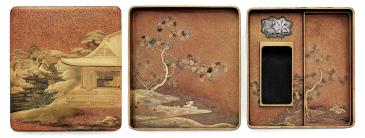

TATSUKE TAKAHIRO: A SUPERB LACQUER SUZURIBAKO (WRITING BOX)
By Tatsuke Takahiro, signed Tatsuke shi Takahiro and kakihan Japan, first half of the 18th century, Edo period (1615-1868)
Of rectangular form, bearing a lustrous roiro ground and finely decorated in gold and silver takamaki-e and togidashi-e. The kabusebuta (overhanging) lid depicts a powerful tiger prowling beside bamboo. The interior of the lid presents a silver moonshaped circular panel lacquered in exquisite sumi-togidashi-e, illustrating the Chinese poet and statesman Tao Yuanming standing beside blooming chrysanthemums, set against a nashiji ground. The same nashiji ground continues across the interior, which is fitted with a removable ita (baseboard) and houses the original implements: a silver suiteki (water-dropper) in the form of an Imperial kiri crest and a fitted rectangular suzuri (inkstone). The rims are finished in gold fundame.
Signed beneath the implements TATSUKE shi TAKAHIRO [Takahiro, of the Tatsuke family], with the artist’s typical kakihan.

The design is inspired by Kano school paintings, which were a significant source of motifs for lacquer artists during the 18th century.

Tiger in a bamboo grove, by Kano Yasunobu, dated c. 1683, in the Arthur M. Sackler Museum, Harvard University, object number1943.56.22.29
SIZE 5.5 x 23.6 x 25.5 cm
Condition: Very good condition with minor expected wear and fine crackling to the edges.
With a wood tomobako (storage box).
Tatsuke Takahiro is listed in Edward A. Wrangham and Joe Earle (eds.), The Index of Inro Artists, 1995, p. 281. Two lacquer works by the artist - one suzuribako depicting the samurai Kikuchi Taketoki and one bunko box with phoenix and figures - were in the Choshunkaku collection, assembled by Baron Kawasaki Shozo (1837–1912), a leading industrialist and member of the House of Peers (Kizoku-in).
AUCTION COMPARISON
For another work by the artist, signed Tatsuke Takahiro with seal, dated to the 18th century, see Christie’s, Asobi: Ingenious creativity, Japanese Works of Art from Antiquity to Contemporary Art, 15 October 2014, London, lot 67 (sold for GBP 23,750 or approx. EUR 43,500 converted and adjusted for inflation at the time of writing).
Estimate EUR 6,000
Starting price EUR 3,000


By the Zohiko company, sealed Zohiko Japan, 19th century
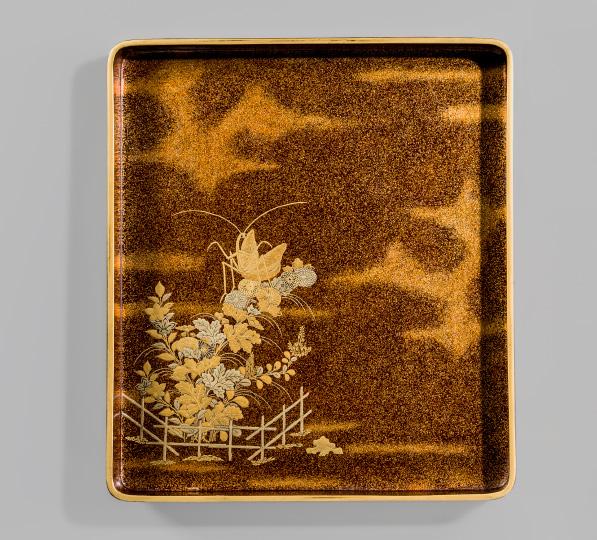
Of rectangular form with rounded edges, bearing a lustrous roiro ground and finely decorated in gold takamaki-e and hiramaki-e. The kabusebuta (overhanging) lid depicts a komainu, its reverse-inlaid eyes painted behind glass to create a strikingly lifelike expression. The guardian beast is shown crouching amidst rocky outcrops and sprays of foliage, large flames arising from its body, the details embellished with fine e-nashiji and kirigane flakes. The interior of the lid is finished in dense nashiji, finely decorated with a mantis poised among chrysanthemum blossoms. The interior of roiro with fundame rims. Sealed to the underside ZOHIKO.
SIZE 4x 19.5 x 22 cm
Condition: Very good condition with minor wear to the edges, typical losses to the kirigane flakes, cracks to the corners and light surface scratches. The implements are lost or have never been included.
The Zohiko Company is a famous company of lacquerers established in the late 17th century and still active today.
Komainu, literally “Korean dogs”, are lion-like guardian beasts commonly placed as statues in pairs at shrine and temple entrances to ward off evil. Believed to have arrived in Japan from China via Korea, their name derives from Koma, the Japanese word for the ancient Korean kingdom of Koguryo.
Estimate EUR 3,000
Starting price EUR 1,500

271
A FINE LACQUER SHIKISHIBAKO (POEM SLIP BOX)
DEPICTING CHERRY TREES
Japan, 19th century, Edo period (1615-1868)
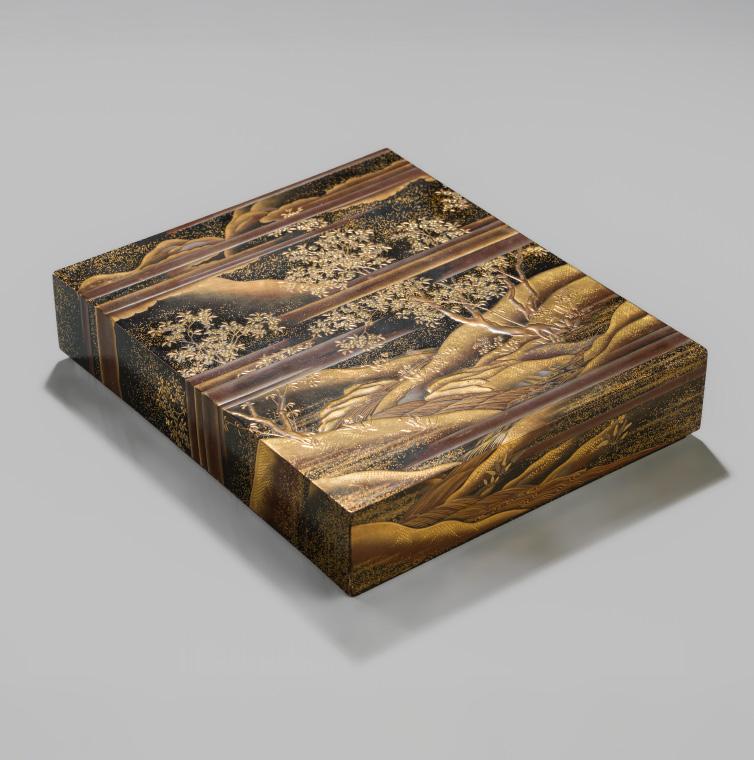
Of rectangular form, bearing a lustrous roiro ground, embellished with e-nashiji and decorated in takamaki-e and hiramaki-e. The flat kabusebuta (overhanging) lid presents a detailed landscape of a flowing river meandering through a rocky terrain with cherry trees, extending seamlessly to the sides of the lid and box. The interior is finished in rich nashiji. The rims of fundame.
SIZE 5.5 x 21.5 x 25.3 cm
Provenance: Lempertz, Cologne, 28-29 November 1974, lot 2749. A private collection in Lower Rhine, Germany, acquired from the above.
Condition: Very good condition with minor typical wear to edges and corners.
AUCTION COMPARISON
Compare a closely related lacquer shikishibako depicting cherry blossoms and pine trees, dated to the late 19th century, at Christie’s, The Edoris Collection of Japanese Art, 10 November 2004, London, lot 131 (sold for GBP 2,031 or approx. EUR 5,000 converted and adjusted for inflation at the time of writing).
Estimate EUR 2,000
Starting price EUR 1,000

272
A FINE SMALL
SUZURIBAKO (WRITING BOX)
DEPICTING GEESE AND BUSH CLOVER (HAGI)
Japan, 19th century, Edo period (1615-1868)
Of rectangular form with a flat flushfitting (inrobuta) cover, bearing a dense nashiji ground, finely decorated to the cover in gold, silver and red iro-e hiramaki-e and takamaki-e, to depict two geese in front of towering bush clover (hagi), together symbolizing Autumn. The sides are further decorated with chrysanthemums (kiku) inlaid in gold foil and bellflowers (kikkyo).
The base and interior in nashiji, housing the original implements: a silver water dropper (suiteki) in the form of a plum (ume) blossom, and a fitted rectangular inkstone (suzuri). The rims of fundame.
SIZE 2.2 x 6 x 15 cm
Condition: Very good condition with minor wear to edges and a small typical loss to the gold-foil inlay of the chrysanthemum to the side.
Estimate EUR 3,000
Starting price EUR 1,500



A SUPERB GOLD LACQUER IMPERIAL PRESENTATION SET OF A RYOSHIBAKO (LETTER BOX) AND A SUZURIBAKO (WRITING BOX) DEPICTING KIKU (CHRYSANTHEMUMS)

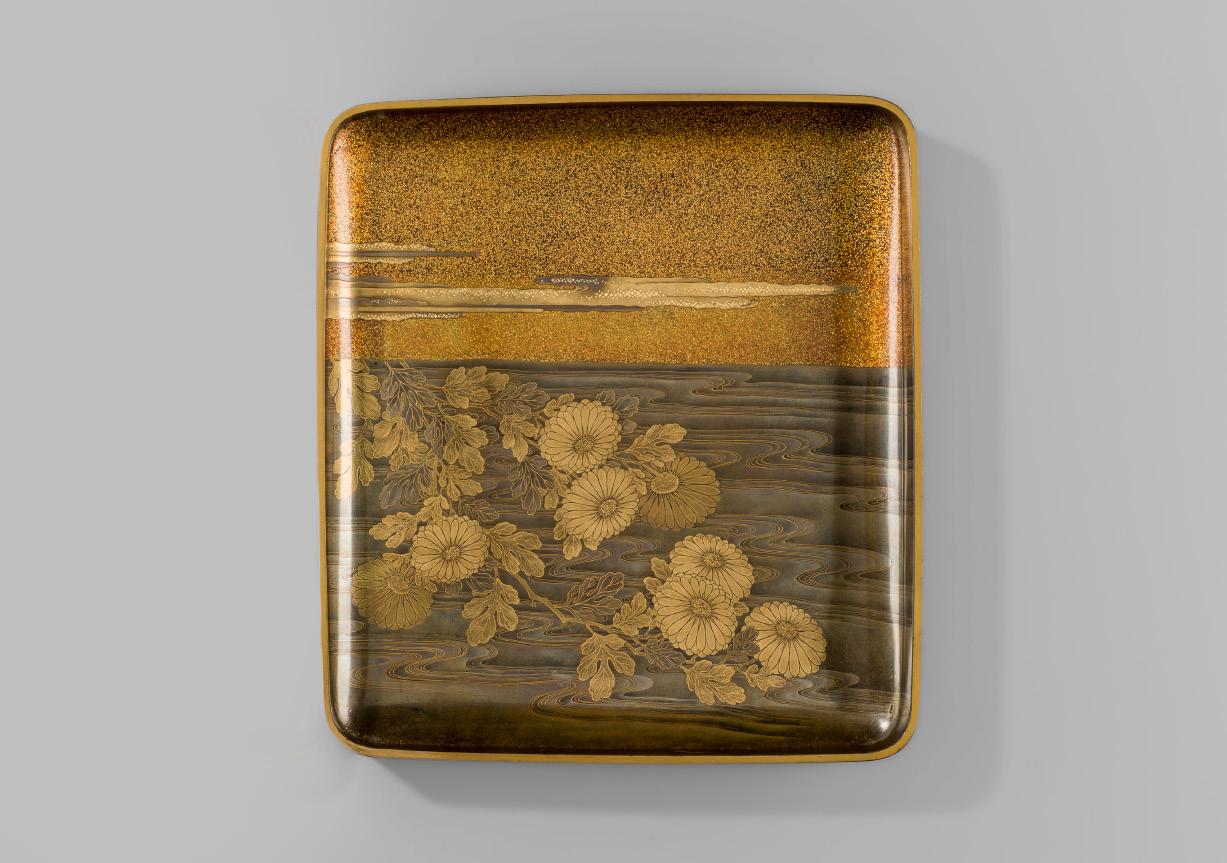
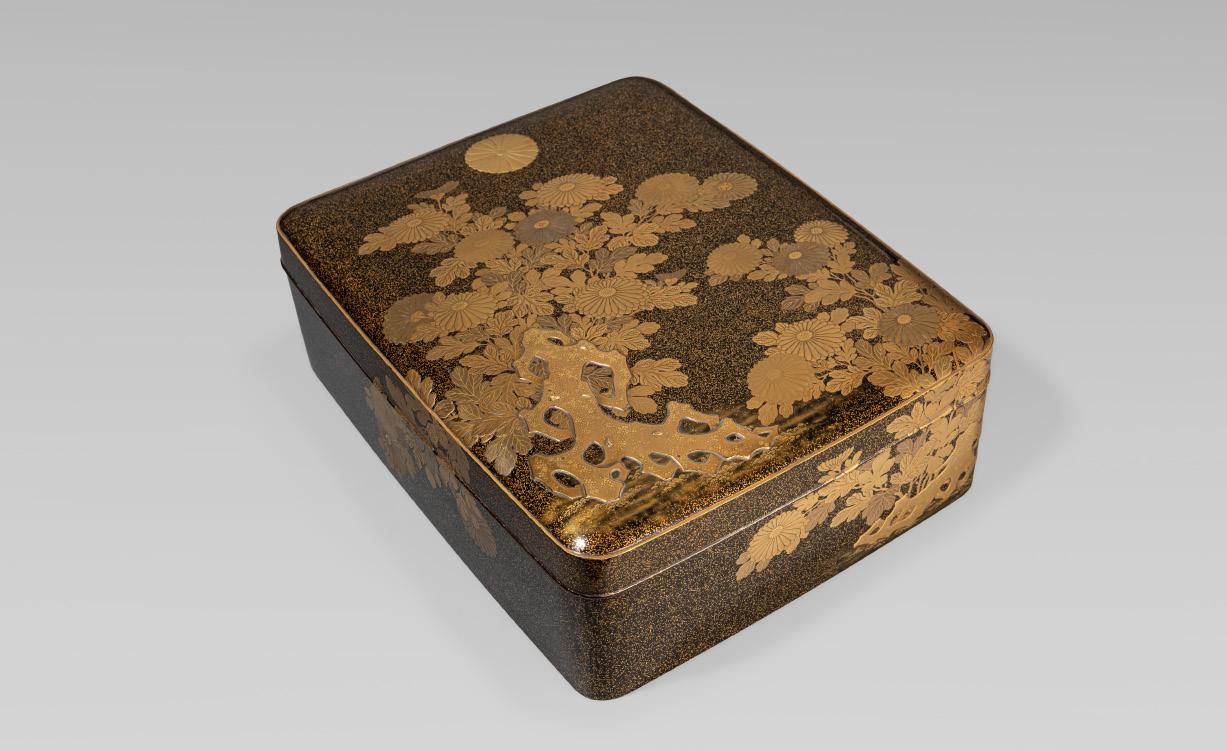
273
A SUPERB GOLD LACQUER IMPERIAL PRESENTATION SET OF A RYOSHIBAKO (LETTER BOX) AND A SUZURIBAKO (WRITING BOX) DEPICTING KIKU (CHRYSANTHEMUMS)
Japan, late 19th to early 20th century, Meiji period (1868-1912) to Taisho period (1912-1926)
Each box of rectangular form with rounded corners, the pair superbly decorated in gold takamaki-e and hiramaki-e on a sprinkled roiro ground. The inrobuta (flush-fitting) lids depict luxuriant chrysanthemum (kiku) blossoms, an Imperial emblem, rising from intricately rendered trunks, embellished with kirigane flakes. The composition on the ryoshibako is crowned by the Imperial kiku seal, indicating an Imperial gift. The interior of each cover is masterfully worked in sublime togidashi-e featuring the same kiku flowers as on the cover reflected in the water.
The suzuribako fitted with a removable ita (baseboard) and housing the original implements: a silver suiteki (water-dropper), writing brushes (fude), ink stick (sumi), and a fitted rectangular suzuri (inkstone).
Each with a wood tomobako (storage box) with the cover inscribed in gold lacquer jingasa kiku maki-e, on suzuribako, 陣笠菊蒔絵、御 硯箱, [A suzuribako, decorated with the designs of chrysanthemums sprays arranged like jingasa (war hats)].
SIZE 4 x 22 x 24.5 cm (suzuribako), 13.5 x 32.5 x 40.5 cm (ryoshibako)

Condition: Excellent condition with only very minor wear to the edges and typical losses to the kirigane flakes.
The 16-petal kiku mon indicates the present set was an Imperial commission.
MUSEUM COMPARISON
Compare a closely related lacquer Imperial presentation box, dated to the early 20th century, 11.6 x 19.9 x 26.4 cm, in the National Museum of Asian Art, Smithsonian Institution, accession number F1997.17a-e.
AUCTION COMPARISON
Compare a closely related single Imperial presentation lacquer tebako also with the Imperial kiku seal, dated to the late 19th century, 31 cm (long), at Sotheby’s, Fine Japanese Art, 3 November 2020, London, lot 114 (sold for GBP 10,000 or approx. EUR 16,000 converted and adjusted for inflation at the time of writing).
Estimate EUR 10,000
Starting price EUR 5,000
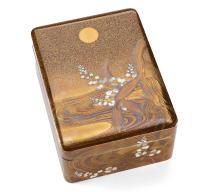



274
A SUPERB GOLD LACQUER SUZURIBAKO (WRITING BOX) DEPICTING AN IDYLLIC LANDSCAPE SCENE
Japan, 19th century, Edo period (1615-1868)
Of rectangular form with rounded corners, bearing a dense nashiji ground, very finely decorated in gold and silver takamaki-e and hiramaki-e. The kabusebuta (overhanging) lid displays a delicate landscape with hills, small parts of their surfaces deeply carved to suggest rocky contours and further embellished with kirigane flakes. Cherry trees, pine saplings, a pagoda, and small huts enliven the scene, which continues seamlessly onto the sides and the interior of the lid. The interior and base in nashiji, fitted with a removable ita (baseboard), and housing the original implements: a silver water dropper (suiteki), and a fitted rectangular inkstone (suzuri). The rims of fundame.
SIZE 5 x 22.5 x 26 cm
Provenance: A noted Swiss private collection, acquired in the 1960s.
Condition: Very good condition with minor wear to the edges, few stains, light surface scratches and tiny losses to kirigane flakes.
Estimate EUR 3,000
Starting price EUR 1,500
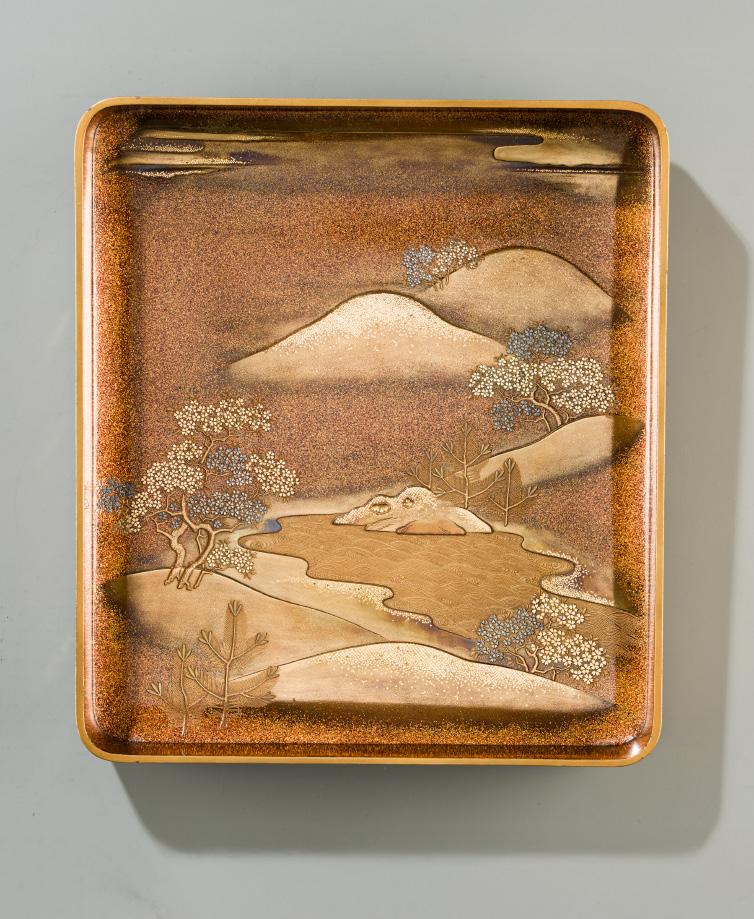

275
A FINE LACQUER SUZURIBAKO (WRITING BOX) WITH CHERRY BLOSSOMS AND MAPLES IN SEASONAL CONTRAST
Japan, Meiji period (1868-1912)
Of rectangular form with rounded edges, bearing a deep, lustrous roiro ground, finely decorated in gold, silver, and red takamaki e and hiramaki e, and further embellished with nashiji, kinpun, and delicate kirigane flakes. The kabusebuta (overhanging) lid presents a continuous landscape of rolling hills, swirling streams, and blossoming cherry trees, the design flowing seamlessly down the sides of the box.
The interior of the lid continues the theme, executed in gold, silver, and red lacquer, with inlays of gold foil, depicting a maple tree set among rocks beside flowing water. The interior of the box displays a red and gold hanabishi brocade pattern and is fitted with a removable ita (baseboard), housing the original writing implements: a silver suiteki (water dropper) delicately engraved with cherry blossoms, and a fitted rectangular suzuri (inkstone). The rims are finished in gold fundame.
SIZE 5.8 × 21 × 25 cm
Condition: Very good condition with minor wear to the edges, small expected losses to the kirigane flakes, a few tiny cracks to the ita.
With a wood tomobako (storage box).
This refined suzuribako evokes the poetic interplay of spring and autumn, the lid capturing the fleeting beauty of cherry blossoms in full bloom, while the interior reveals the quiet melancholy of autumn maples shedding their leaves into flowing water. The artist’s use of contrasting seasons—blossom and fall— offers a meditation on the transience of nature and the passage of time, a central theme in Japanese aesthetics.
Estimate EUR 5,000 Starting price EUR 2,400


276
AN EARLY AND EXCEPTIONALLY LARGE (56 CM) LACQUER FIVE-TIERED JUBAKO (TIERED BOX) DEPICTING ONE THOUSAND CRANES (SENBA-ZURU)
Japan, 17th-18th century, early Edo period (1615-1868)
Of large upright rectangular form, exquisitely decorated in gold and silver takamaki-e and hiramaki-e on a lustrous roiro ground, enriched with gold foil inlay, e-nashiji and fine kinpun. The inrobuta (flush-fitting) stacked boxes are superbly adorned with multiple cranes (tsuru), several in flight beneath clouds embellished with kirigane flakes, while others stand beside a river under pine trees, further highlighted with kirigane. The composition extends seamlessly from the lid across all sides of the box. The interior is finished in warm red lacquer with gold fundame rims.
SIZE 32 x 33.5 x 56 cm
Condition: Very good condition with typical wear and chips to the edges and corners as well as typical losses to the kirigane flakes and gold foil inlays.
This impressive jubako, or tiered box, would originally have been used as a food container or for elaborate picnic sets during festive occasions, such as New Year celebrations or cherry blossom viewings. What makes the present example exceptional is its remarkable and uncommon size, which elevates it from a utilitarian object to a statement of luxury.
Cranes (tsuru) were revered as symbols of longevity, wisdom, and good fortune, deeply rooted in Shinto and Buddhist traditions. Believed to live for a thousand years, cranes were associated with immortality and divine protection, often appearing in lacquerware, textiles, and paintings as auspicious motifs.
AUCTION COMPARISON
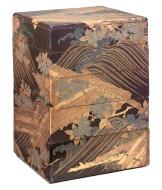

Compare a related but smaller fivetiered lacquer jubako with cherry blossom and a rushing torrent, dated to the 17th-18th century, 34 cm (high), at Christie’s, Japanese Art and Design including Netsuke from the Estate of his Royal Highness the Prince Henry, duke of Gloucester, KG., KT., KP, 13 July 2006, London, lot 350 (sold for GBP 6,000 or approx. EUR 14,500 converted and adjusted for inflation at the time of writing). Compare a related but smaller four-tiered lacquer jubako with waves, dated to the late 16th-17th century, 26 cm (high), at Christie’s, Asobi: Ingenious Creativity Japanese Works of Art from Antiquity to Contemporary and Ceramics from the Collection of Bernard Leach, 15 October 2013, London, lot 21 (sold for GBP 9,375 or approx. EUR 17,500 converted and adjusted for inflation at the time of writing).
Estimate EUR 4,000
Starting price EUR 2,000


277
TABAKO-BON (SMOKING SET) AND COVER DEPICTING CHERRY TREES
Japan, 19th century, Edo period (1615-1868)
The portable box of rectangular form is fitted with a metal handle and a side cabinet drawer adorned with a kiku (chrysanthemum) knop. The exterior and flush-fitting cover are finely decorated in gold takamaki-e and hiramaki-e with delicate branches of cherry trees, their blossoms rendered in silver and enhanced with kirigane flakes, while the edges are framed by graceful floral bands. The top of the lid features an openwork character yama 山 (“mountain”), its calligraphic form echoing the gentle rise of a mountain silhouette - a poetic interplay of word and image. The interior houses three kiseru (tobacco pipe) holders and is fitted with a removable bronze brazier and two covered ash containers.
SIZE 12 x 14 x 20.8 cm
Condition: Very good condition with typical wear and chips to the edges and corners. Losses to the kirigane flakes and a repair to one corner with associated touchups.
AUCTION COMPARISON
Compare a related lacquered wood tabako-bon with cherry blossoms, dated to the 19th century, 16.2 x 18.2 x 19.5 cm, at Zacke, Fine Japanese Art, 13 June 2025, Vienna, lot 289 (sold for EUR 4,420).
Estimate EUR 2,500
Starting price EUR 1,200
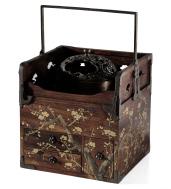


278
A FINE GOLD LACQUER BOX AND COVER DEPICTING KIKU (CHRYSANTHEMUMS), WITH INTERIOR TRAY
Japan, 19th century, Edo period (1615-1868)
Of square form with rounded edges, finely decorated in gold takamaki-e and hiramaki-e on a sprinkled roiro ground. The kabusebuta (overhanging) lid, with its distinctive cutaway sides, is adorned with rich kiku (chrysanthemums) and the sides are decorated with silver-fittings in the form of flower baskets, suspending cords. The tray and interior are similarly decorated with chrysanthemum blossoms against a sprinkled roiro ground. The rims are finished in pewter.
SIZE 8 x 9.5 x 11.5 cm
Condition: Very good condition with only very minor wear to edges.
With a wood tomobako (storage box).
MUSEUM COMPARISON
Compare a closely elated lacquer box and cover, similarly decorated with kiku, dated before 1882, 9.9 x 10.4 x 13 cm, in the GRASSI Ethnography Museum Leipzig, inventory number OAs 04743 a-c.
Estimate EUR 2,000
Starting price EUR 1,000
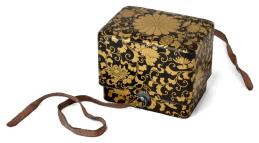


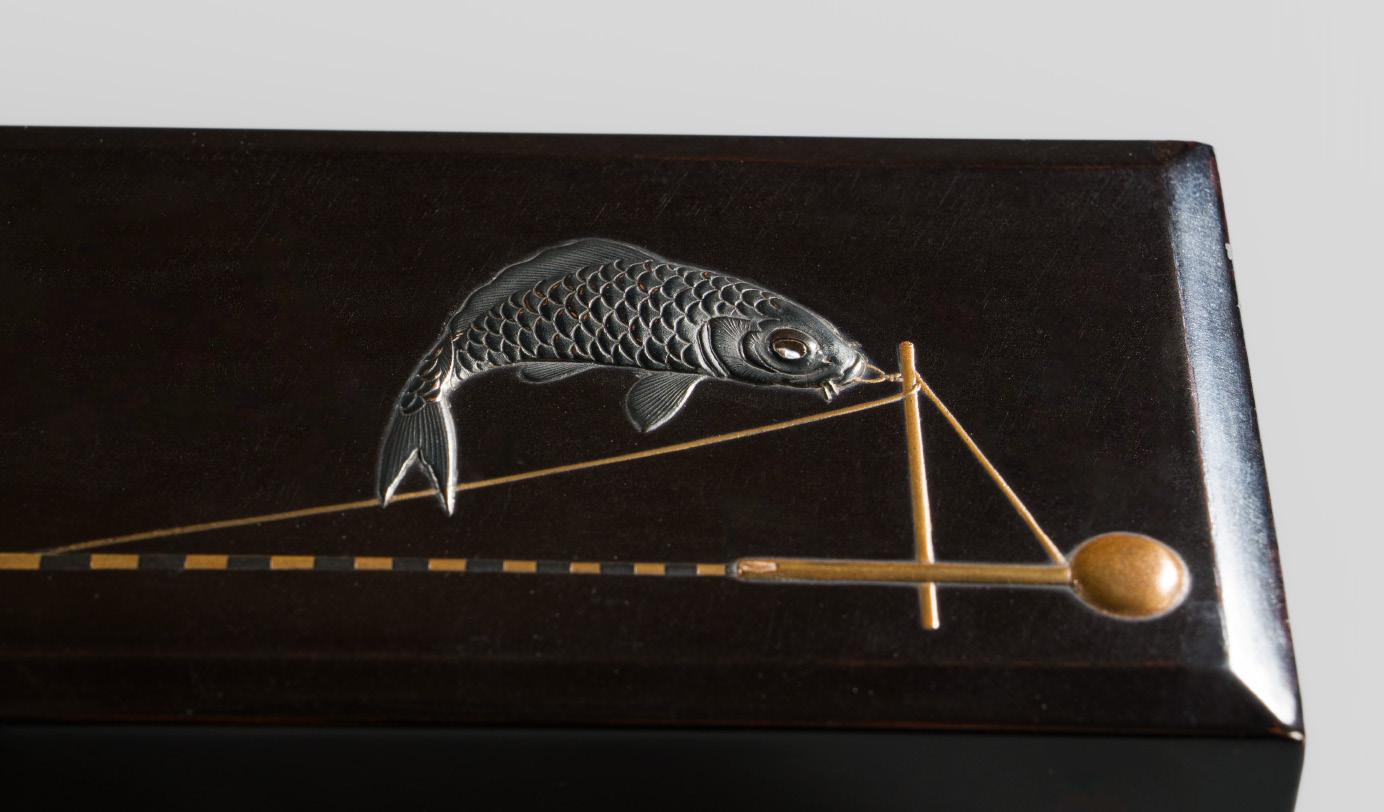
279 KANSHOSAI TOYO: A SUPERB INLAID LACQUER FUMIBAKO (POEM PAPER BOX)
Lineage of Iizuka (Kanshosai) Toyo, signed Kanshosai Japan, 19th century, Edo period (1615-1868)
Of upright rectangular form, bearing a lustrous roiro ground and finely decorated in gold takamaki-e and hiramaki-e, enriched with an elaborate blend of mixed-media inlays. The inrobuta (flush-fitting) lid presents a floral bouquet of shobu (irises), the blossoms exquisitely inlaid with aogai (mother-of-pearl) and the leaves rendered in ceramic. Behind the arrangement stands a koinobori (carp streamer) lacquered in sublime shibuichi-nuri, suspended from a flagpole to celebrate the Boy’s Festival (Tango no Sekku) on the fifth of May. The flagpole is finished with Somadastyle aogai inlays, while the box is fitted with silver kiku-shaped (chrysanthemum) mounts - an Imperial motif attesting to the exceptional quality of the fumibako. Signed to the underside KANSHOSAI. The interior of nashiji with gold fundame rims.
SIZE 21 x 6.3 cm
Provenance: Christie’s, Japanese Works of Art, 15 November 1993, London, lot 318 (sold for GBP 2,300 or approx. EUR 7,500 converted and adjusted for inflation at the time of writing). Private collection in Northern Germany, acquired from the above. With an old label ‘Roironuri fumibako decorated in somada style, iroe hiramakie + inlays with presentation flowers + a carp 19th century 20.5 long’.
Condition: Very good condition with typical wear to the edges. Tiny dents, and small losses to the inlays.
Iizuka (Kanshosai) Toyo was a distinguished lacquerer and inro decorator during the second half of the 19th century in Edo. He had many followers and used a wide range of techniques. For more information on the artist see Wrangham, E. A. (1995) The Index of Inro Artists, pp. 312-313.
Tango no Sekku (boy’s festival), also known as Ayame no hi (Iris festival), is one of the five ancient seasonal festivals influenced by Chinese customs, and the Japanese observance of the celebration is said to have begun around the Nara period. The day was dedicated to boys in the same way Momo no Sekku or Hinamatsuri was dedicated to celebrating girls.
AUCTION COMPARISON
Compare a related laquer inro with fish, by Kanshosai Toyo, dated to the 19th century, at Bonhams, The Edward Wrangham Collection of Japanese Art part II, 10 May 2011, London, lot 251 (sold for GBP 16,800 or approx. EUR 33,500 converted and adjusted for inflation at the time of writing).
Estimate EUR 4,000
Starting price EUR 2,000


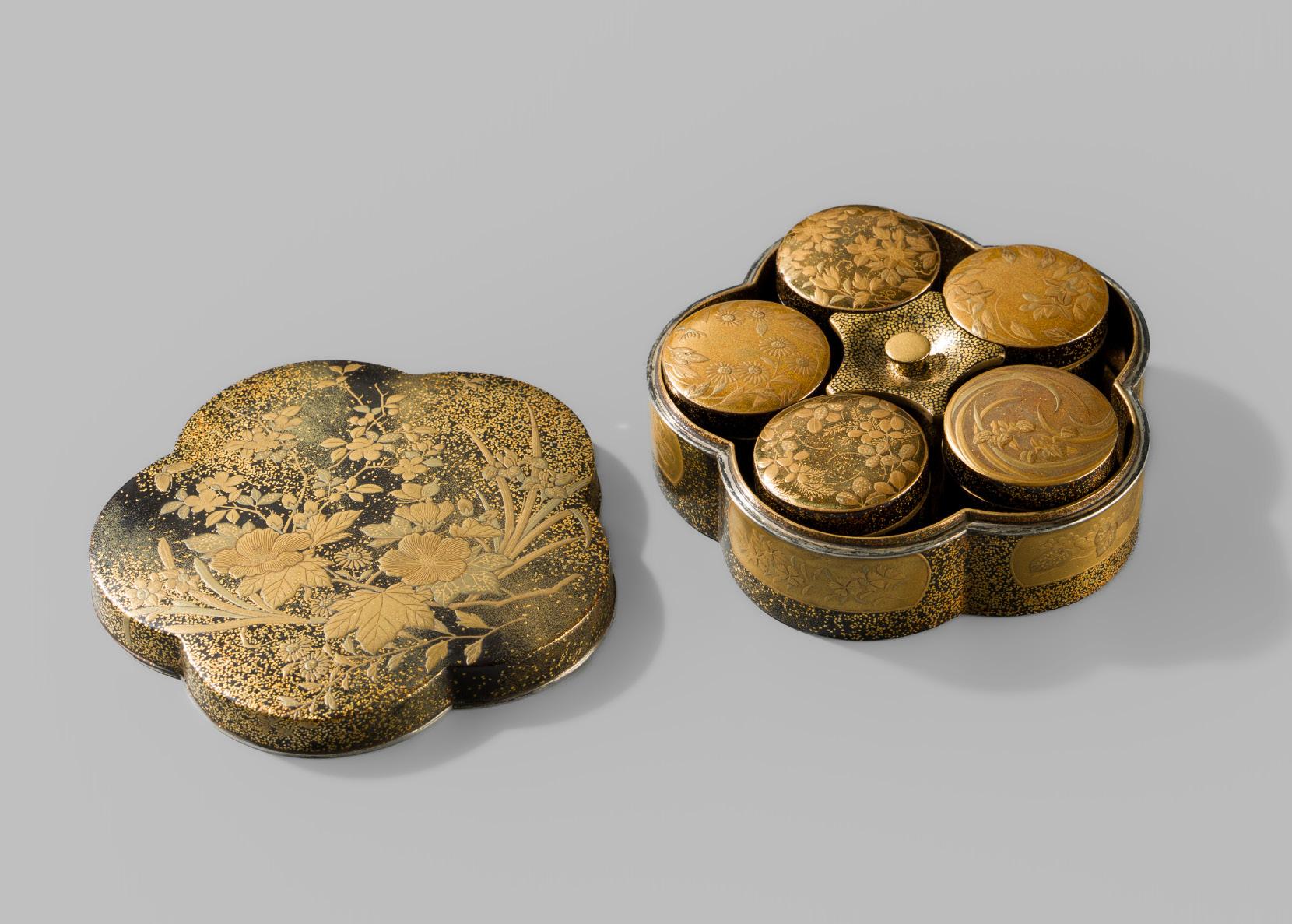
280
A RARE AND SUPERB GOLD LACQUER BOX AND COVER CONTAINING SIX KOGO (INCENSE BOXES), FOR THE INCENSE-MATCHING GAME
Japan, 19th century, Edo period (1615-1868)
Of lobed floral shape, finely decorated with delicate takamaki-e and hiramaki-e on a roiro ground, embellished with e-nashiji and dusted kinpun. The inrobuta (flush-fitting) lid is adorned with flowers and grasses such as elegant sprays of prunus, irises, peonies and daisies, while the sides are adorned with panels enclosing further season flowers. The underside is finished in e-nashiji, while the interior is lined with rich nashiji and silver rims.

The interior is fitted with a removable tray to be lifted by its central knop, holding six small kogo, each of circular form, superbly decorated in gold takamaki-e and hiramaki-e on variously shaded gold and silver grounds, and depicting various seasonal flowers.
DIAMETER 9.8 cm
Provenance: Collection Edmond Fournier (1864-1938), Paris. With a label to the interior lid ‘Dr. E F’.
Condition: Very good condition with only very minor typical wear and a small crack to one panel near the silver rim.
The present set was used for the incense-matching game Like the Way of Tea and flower arrangement, the enjoyment of incense had developed into a complex pastime by the Edo period and had a large following during the seventeenth century. The various games involved guessing a fragrance from among more than 2,000 varieties, matching fragrances, and blending incenses to suggest certain moods.
AUCTION COMPARISON
Compare a related circular box with nine kogo (incense boxes), dated to the late 19th century, 11.9 cm (diameter), at Zacke, Fine Japanese Art, 13 June 2025, Vienna, lot 281 (sold for EUR 3,640).
Estimate EUR 4,000
Starting price EUR 2,000
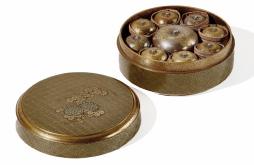

281
A RARE AND SUPERB GOLD LACQUER BOX AND COVER CONTAINING SEVEN KOGO (INCENSE BOXES), FOR THE INCENSE-MATCHING GAME
Japan, 19th century, Edo period (1615-1868)
Of circular form, finely decorated in delicate takamaki-e and hiramaki-e on a dense nashiji ground. The inrobuta (flush-fitting) lid is adorned with an idyllic landscape featuring a meandering river, rocks embellished with shimmering kirigane flakes, and a small, thatched hut nestled beneath pine trees, the composition continuing seamlessly onto the sides of the box. The interior, finished in rich nashiji with fundame rims, houses an elaborate set of seven miniature kogo (incense boxes).
Each of the seven boxes, also of circular form, is finely decorated in iroe takamaki-e and hiramaki-e on a gold fundame ground. The flush-fitting lids are delicately embellished with sprays of seasonal flowers, including peonies, irises, bellflowers, cherry blossoms, and daisies.
DIAMETER 11.5 cm
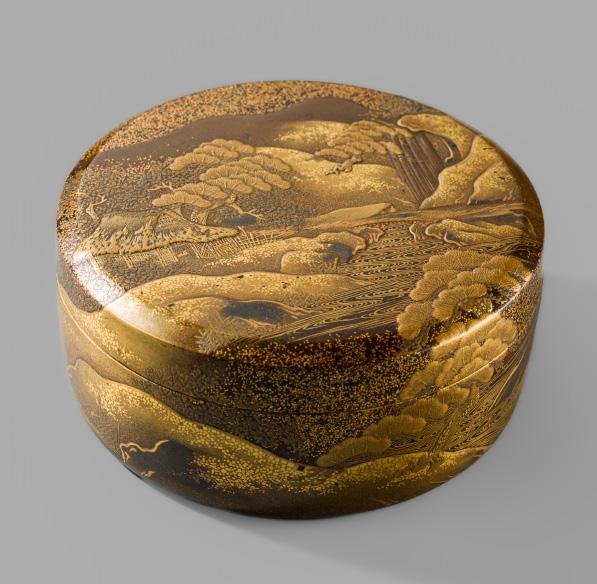
Provenance: From the Collection of Jay R. Butterman, New York. Condition: Very good condition with only minor wear and typical losses to the kirigane flake inlays.
The present set was used for the incense-matching game Like the Way of Tea and flower arrangement, the enjoyment of incense had developed into a complex pastime by the Edo period and had a large following during the seventeenth century. The various games involve guessing a fragrance from among more than 2,000 varieties, matching fragrances, and blending incenses to suggest certain moods.
AUCTION COMPARISON
Compare a related box with seven kogo for the incense-matching game, dated to the Meiji period, at Zacke, Fine Japanese Art, 27 May 2022, Vienna, lot 120 (sold for EUR 5,056).
Estimate EUR 3,000
Starting price EUR 1,500



282 A FINE GOLD LACQUER BOX AND COVER CONTAINING SIX KOGO (INCENSE BOXES), FOR THE INCENSE-MATCHING GAME
Japan, 19th century, Edo period (1615-1868)
Finely decorated in delicate silver and gold takamaki-e and hiramaki-e on a dense nashiji ground. The kabusebuta (overhanging) lid is adorned with a scene from The Tale of Genji, depicting Prince Genji seated in elaborate robes on a veranda beside a courtesan, beneath clouds embellished with kirigane flakes. Small pine saplings, cherry trees, and rock formations appear in the foreground, while pine trees extend onto the sides of the lid. The box is further decorated with the kutsuwa maru ni juji kamon of the Shimazu clan, and the sides are fitted with gilt-metal fittings suspending silk-tasseled cords. The interior houses six miniature kogo, similarly decorated and featuring various designs alluding to popular folktales or festivities.
SIZE 10.5 x 12 x 14 cm
Condition: Very good condition with typical wear to the edges and corners. A crack to one corner and typical losses to the kirigane flakes.
The present set was used for the incense-matching game. Like the Way of Tea and flower arrangement, the enjoyment of incense had developed into a complex pastime by the Edo period and had a large following during the seventeenth century. The various games involve guessing a fragrance from among more than 2,000 varieties, matching fragrances, and blending incenses to suggest certain moods.
AUCTION COMPARISON
Compare a closely related lacquer box for the incense-matching game depicting the Genji Monogatari, at Woolley & Wallis, Japanese Works of Art, 7 December 2020, Salisbury, lot 376 (sold for GBP 4,000 or approx. EUR 6,500 converted and adjusted for inflation at the time of writing).
Estimate EUR 2,500
Starting price EUR 1,200



283 A FINE LACQUER KOBAKO (SMALL BOX) AND COVER WITH BUSH CLOVER (HAGI)
Japan, 19th century, Edo period (1615-1868)
Of rectangular form, finely decorated in sublime iro-e togidashi-e on a radiant kinji ground. The inrobuta (flush-fitting) lid presents a tranquil depiction of bush clover (hagi), symbolizing Autumn, extending from the front to the sides of the cover and box. The underside is finished in exquisite nashiji, while the interior is further worked in nashiji with elegant gold fundame rims.
HEIGHT 11 cm
Condition: Very good condition with minor wear and minuscule nibbling along the edges.
With a wood tomobako (storage box).
Museum comparison: Compare a related incense box with bush clover among other autumnal flowers, dated to the mid-19th century, 7.9 cm (diameter), in the Metropolitan Museum of Art, object number 81.1.208.
AUCTION COMPARISON
Compare a related lacquer kobako with bush clover, among other autumnal flowers dated to the 19th century, at Bonhams, Fine Japanese Art, 11 May 2010, London, lot 267 (sold for GBP 2,640 or approx. EUR 5,500 converted and adjusted for inflation at the time of writing).
Estimate EUR 2,500
Starting price EUR 1,200
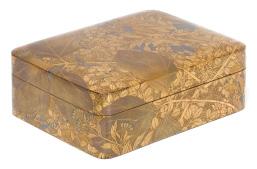


284
A FINE MOKUME LACQUER KOBAKO (SMALL BOX) AND COVER WITH INTERIOR TRAY
Japan, 19th century, Edo period (1615-1868)
Of rectangular form with rounded edges, bearing a mokume (woodgrain) ground and finely decorated in gold and silver takamaki-e and hiramaki-e. The inrobuta (flush-fitting) lid presents several roundels adorned with kirigane flakes and e-nashiji, each depicting birds and flowers including chrysanthemums, cherry blossoms, peonies, irises, bush clover, pine, and maple. The interior tray is decorated with leafy vines and a grasshopper. The underside and interior are finished in nashiji with gold fundame rims.

SIZE 4 x 9.5 x 12.5 cm
Provenance: From the Collection of Jay R. Butterman, New York, United States.
Condition: Very good condition with minor wear and typical losses to the kirigane flakes.
Estimate EUR 2,000
Starting price EUR 1,000

285
A FINE LACQUER ‘HO-O AND DRAGON’ KOGO (INCENSE BOX) AND COVER WITH INTERIOR TRAY
Japan, 19th century, Edo period (1615-1868)
Of small square form with lobed corners, bearing a fine gyobunashiji ground, delicately decorated in gold and silver takamaki-e and hiramaki-e with roundels depicting phoenixes (ho-o) and stylized dragons. The design extends over the inrobuta (flush-fitting) lid with two further roundels on each side. The interior tray rests on four bracket feet and is similarly decorated. The underside is finished in nashiji, while the interior is further lacquered in nashiji with gold fundame rims.
SIZE 4 x 6.4 x 6.5 cm
Condition: Excellent condition with only very minor wear.
With a wood tomobako (storage box).
Estimate EUR 1,500 Starting price EUR 800
286
A SMALL LOBED LACQUER KOGO (INCENSE BOX) AND COVER DEPICTING A CORMORANT FISHING SCENE
Japan, 19th century, Edo period (1615-1868)
Of lobed bean-shaped form, bearing an e-nashiji ground and finely decorated in togidashi-e. The inrobuta (flush-fitting) lid depicts a tranquil cormorant-fishing scene (ukai), showing a small boat moored among reeds and a fishing torch tied to it. The sides are adorned with a brocade pattern in red, green, and gold lacquer, while the interior is finished in nashiji with gold fundame rims.
SIZE 2.3 x 4.5 x 6.4 cm
Condition: Excellent condition with only very minor wear.
Estimate EUR 1,500 Starting price EUR 800
Ukai, or cormorant fishing, is a traditional Japanese method of catching fish that dates back more than 1,300 years. Practiced mainly on rivers such as the Nagara in Gifu, it involves fishermen, known as usho, who skillfully guide trained cormorants (u) on leashes to catch ayu (sweetfish) under the light of flaming torches. Once widespread, ukai became both a livelihood and a cultural performance, admired for the graceful coordination between man and bird. Today, it survives as an important intangible cultural heritage.


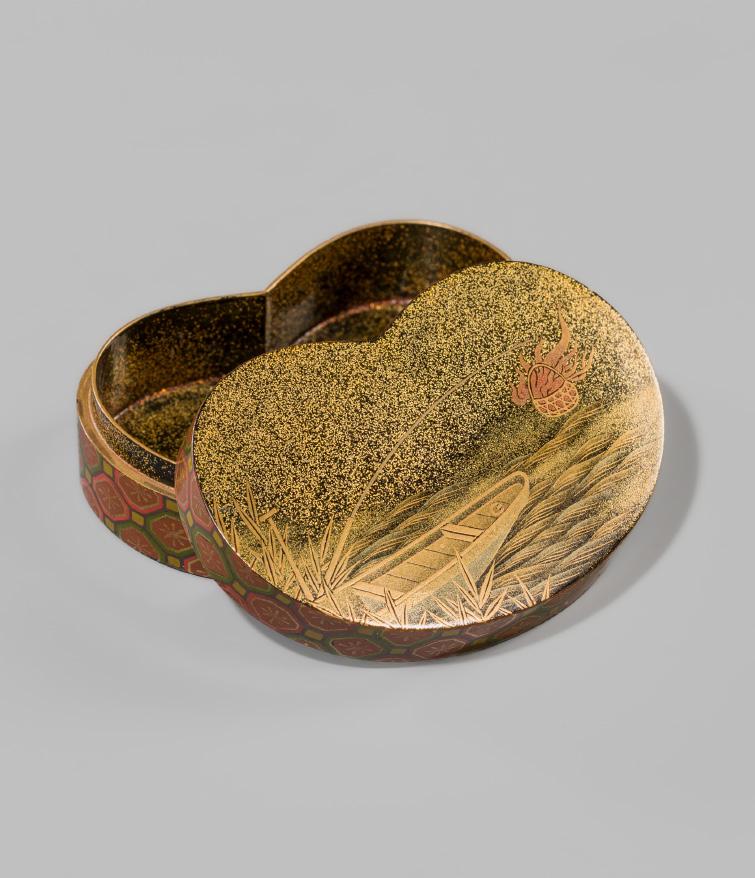


287
A RARE MINIATURE KAGAMIBAKO (MIRROR BOX) WITH CHRYSANTHEMUM
Japan, 17th-18th century, early Edo period (1615-1868)
Of circular form, finely decorated in gold takamaki-e and hiramaki-e on a dense nashiji ground. The inrobuta (flush-fitting) lid is adorned with Imperial chrysanthemum (kiku) motifs spreading across the top and sides above an elegant scrolling design. The interior of sprinkled roiro with gold fundame rims.
Fitted for a small silver mirror engraved with a 24-petaled kiku mon and inscribed with the honorific title Tenkaichi, 天下一 [first under heaven].
DIAMETER 5 cm
Condition: Good condition with typical wear and chips to the rim limited mostly to the interior.
AUCTION COMPARISON
Compare a closely related lacquer kagamibako, dated to the 17th century, 11.3 cm (diameter), at Christie’s, The Joseph Collection of Japanese Art, 11 November 2015, London, lot 2 (sold for GBP 3,750 or approx. EUR 7,000 converted and adjusted for inflation at the time of writing).
Estimate EUR 2,000
Starting price EUR 1,000
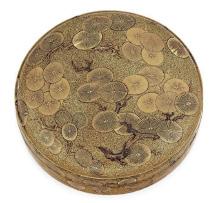
288
A FINE LACQUER KOGO (INCENSE BOX) AND COVER DEPICTING YAMABUSHI AND SAMURAI
Japan, 18th century, Edo period (1615-1868)
Of lobed square form, finely decorated in gold and silver takamaki-e and hiramaki-e on a kinji ground. The inrobuta (flush-fitting) lid depicts an animated scene of yamabushi (mountain ascetics) wearing traveler’s packs (oi) as they confront armed samurai, the rocks and clouds surrounding the scene are embellished with kirigane flakes. The sides are adorned with cherry blossoms (sakura), delicately worked in gold lacquer. The interior is finished in nashiji with fundame rims.
SIZE 1.5 x 5.3 x 5.3 cm
Condition: Very good condition with typical wear to the edges and losses to the kirigane flakes.
Estimate EUR 1,500
Starting price EUR 800


289
A RARE LACQUER KOGO (INCENSE BOX) AND COVER DEPICTING TWO CORMORANTS
Japan, late 17th century, Edo period (1615-1868)
Published:
1. P. Stern, The Magnificent Three: Lacquer, Netsuek and Tsuba’, Japan Society, New York, 1972, no. 27.
2. J. Pekarik, Japanese Lacquer, 1600-1700, The Metropolitan Museum of Art, New York 1980, no. 4, fig. 14.
3. Eskenazi, The Charles A. Greenfield collection of Japanese lacquer, 20 November-7 December 1990, pp. 38-39, no. 4.
Exhibited:
1. Japan House Gallery, The Magnificent Three: Lacquer, Netsuke and Tsuba, Selections from the Collection of Charles A. Greenfield, New York, Autumn 1972.
2. The Metropolitan Museum of Art, Japanese Lacquer, 16001900, Selections from the Charles A. Greenfield Collection, New York, 4 September -19 October 1980.
Of small, rectangular form with rounded edges, finely decorated with gold and brown takamaki-e and hiramaki-e on a dense e-nashiji ground. The slightly domed inrobuta (flush-fitting) lid depicts an enchanting scene of two cormorants, one swimming in the water, the other perched on a rock, further embellished with kirigane flakes. The underside and interior are finished in nashiji with pewter rims.
SIZE 2.3 x 3.7 x 4.8 cm
Provenance: Ex-collection Charles A. Greenfield, collection no.
34. Christie’s, Japanese Art including Property of the Metropolitan Museum of Art, 28 March 2006, New York, lot 382 (sold for USD 3,840 or approx. EUR 5,500 converted and adjusted for inflation at the time of writing). The Collection of Jay R. Butterman, New York, United States, acquired from the above. With an old label ‘Greenfield Collection 34’ to the underside.
Condition: Very good condition with minor wear to the edges. Typical losses to the kirigane flakes.
Estimate EUR 2,000
Starting price EUR 1,000
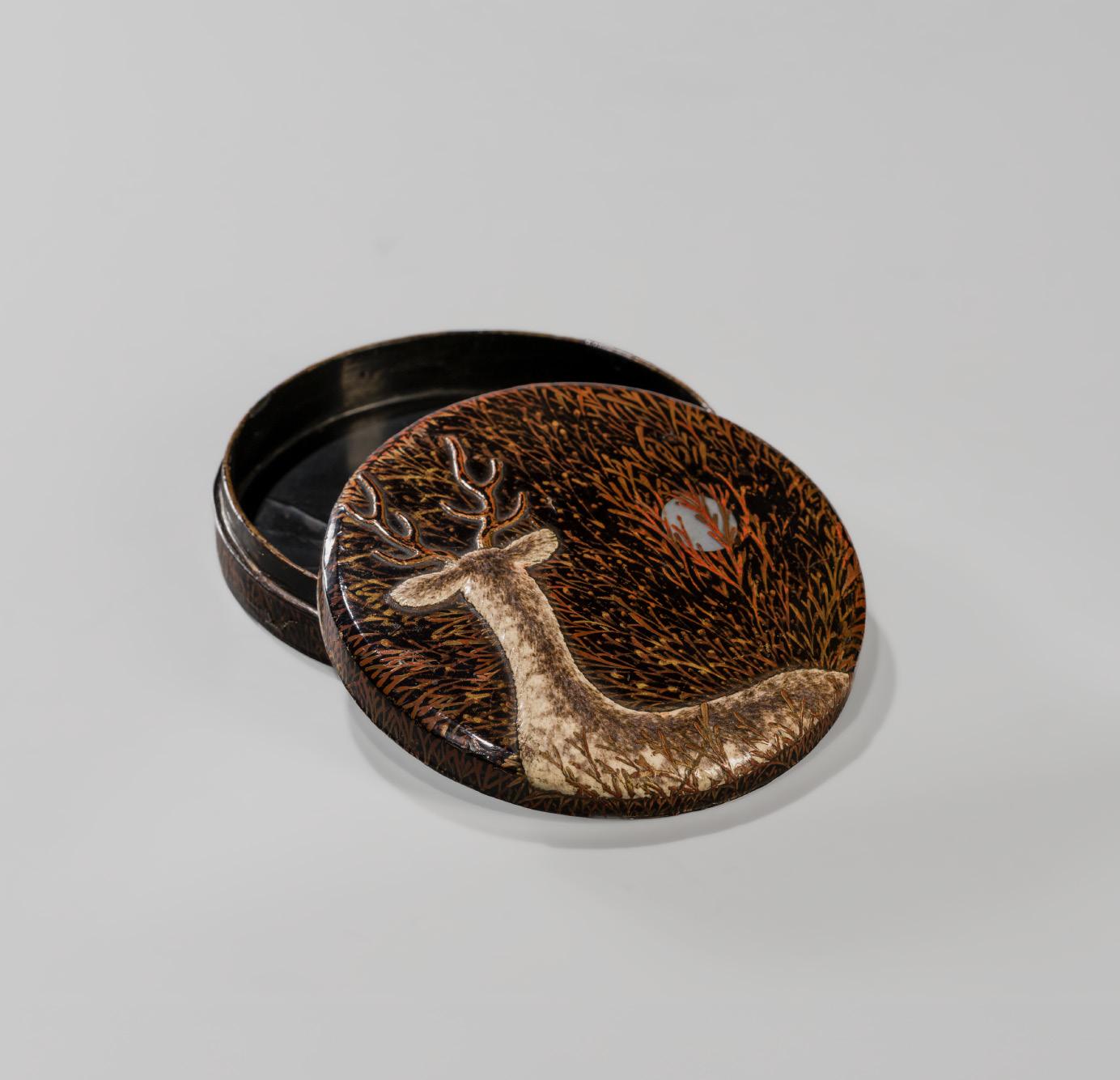
290
A FINE INLAID RITSUO-STYLE KOGO (INCENSE BOX) AND COVER DEPICTING A DEER GAZING AT THE FULL MOON
School of Ogawa Haritsu (Ritsuo, 1663-1747), unsigned Japan, 18th century, Edo period (1615-1868)
Of circular full moon shape, finely decorated with red lacquer, ceramic, and mother-of-pearl inlays on a roiro ground. The inrobuta (flush-fitting) lid depicts an enchanting scene of a ceramic-inlaid deer gazing amongst the autumn grasses toward a full moon. The underside and interior are finished in roiro.
DIAMETER 11 cm
Provenance: Ex-collection Soame Jenyns (1904-1976). Roger Soame Jenyns (19041976) was the assistant chief at the British Museum in the Oriental Art department between 1931-1967. He collected a huge variety of oriental objects, including Japanese lacquer and netsuke.
Condition: Very good condition with typical wear to the edges and cracks to the interior.

Roger Soame Jenyns (1904-1976)
Ogawa Haritsu (Ritsuo, 1663-1747) specialized in the combination of unusual materials such as pottery, bone, lacquer, shell and wood. His sophisticated taste and modern approach appealed to literati circles in the eighteenth century, and he served as both artist and artistic adviser to the Daimyo Tsugaru Nobuhisa. He had many followers and pupils, and his original style has been adapted throughout the centuries.
MUSEUM COMPARISON
Compare a related inro showing a similar scene of a deer, by Ogawa Haritsu, dated to the Edo period (1615–1868), in the Metropolitan Museum of Art, object number 29.100.784.
Estimate EUR 2,000
Starting price EUR 1,000

291
A CHARMING RINPA STYLE INLAID KOGO (INCENSE BOX) AND COVER DEPICTING A TANUKI
Japan, 18th century, Edo period (1615-1868)
Of circular form, the gold fundame ground finely decorated with mitsuda (pewter) and raden (mother-of-pearl) inlays, and gold takamaki-e. The inrobuta (flush-fitting) lid depicts a charming tanuki (raccoon dog) with its body curled, the right forepaw raised to its snout, the whiskers rendered in gold, and the eyes minutely inlaid with mother-of-pearl. The underside and interior are finished in nashiji, with rims in pewter.
DIAMETER 8 cm
Provenance: From the Collection of Jay R. Butterman, New York, United States, acquired from the above.
Condition: Very good condition with minor wear to the edges.
Estimate EUR 1,500
Starting price EUR 800
292
A RINPA STYLE KOBAKO (SMALL BOX) AND COVER DEPICTING ARIWARA NO NARIHIRA ON HORSEBACK
After a design by Ogata Korin (1658-1716), unsigned Japan, Edo period (1615-1868)
Of rectangular form, finely decorated in gold and silver takamaki-e and hiramaki-e on a brown-to-red lacquer ground, enriched with a harmonious blend of mixed-media inlays. The inrobuta (flush-fitting) lid depicts the legendary poet Ariwara no Narihira, rendered in raden (mother-of-pearl) with garments delicately patterned in fine gold, riding a mule inlaid in mitsuda (pewter) toward a flowing river that continues seamlessly onto the sides of the box. The interior of the cover is adorned with a charming scene of monkeys climbing a pewter-inlaid tree, their lively expressions accentuated with aogai (blue-green shell) details. The interior is finished in a deep-brown lacquer, and the rims are mounted in pewter.
SIZE 5.5 x 9.7 x 12.3 cm

Provenance: Form a private collection in the South of Germany. With an old label ‘73’ to the interior.
Condition: Good condition with minor wear to lacquer as is visible in the catalog illustration. A chip to the bottom edge and some typical wear to the corners.
The design is illustrated in Korin Shinsen Hyaku-zu (One Hundred Newly Selected Designs by Korin), by Ikeda Koson, 1864, Vol. 1, spread 28
Estimate EUR 1,500
Starting price EUR 800
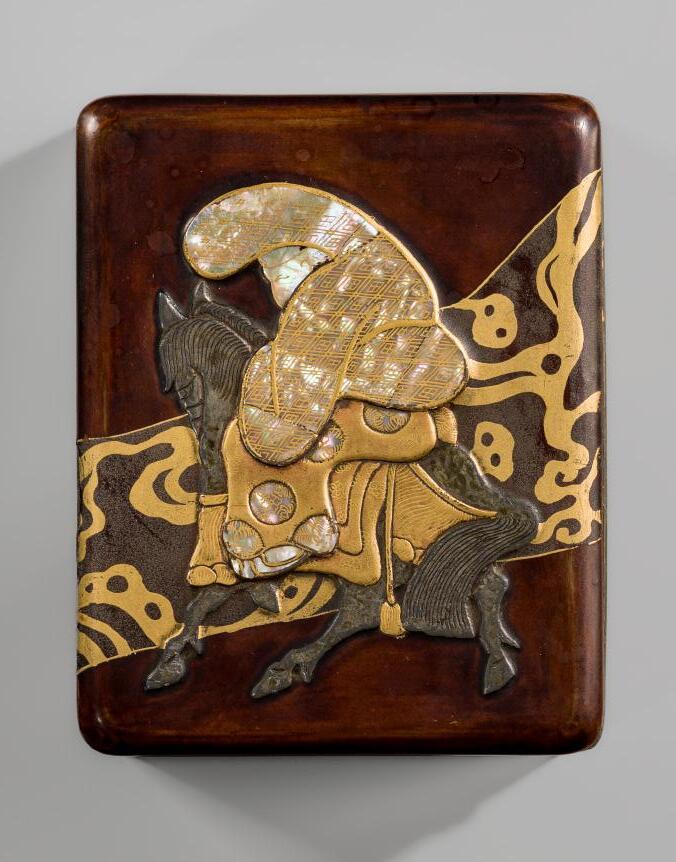


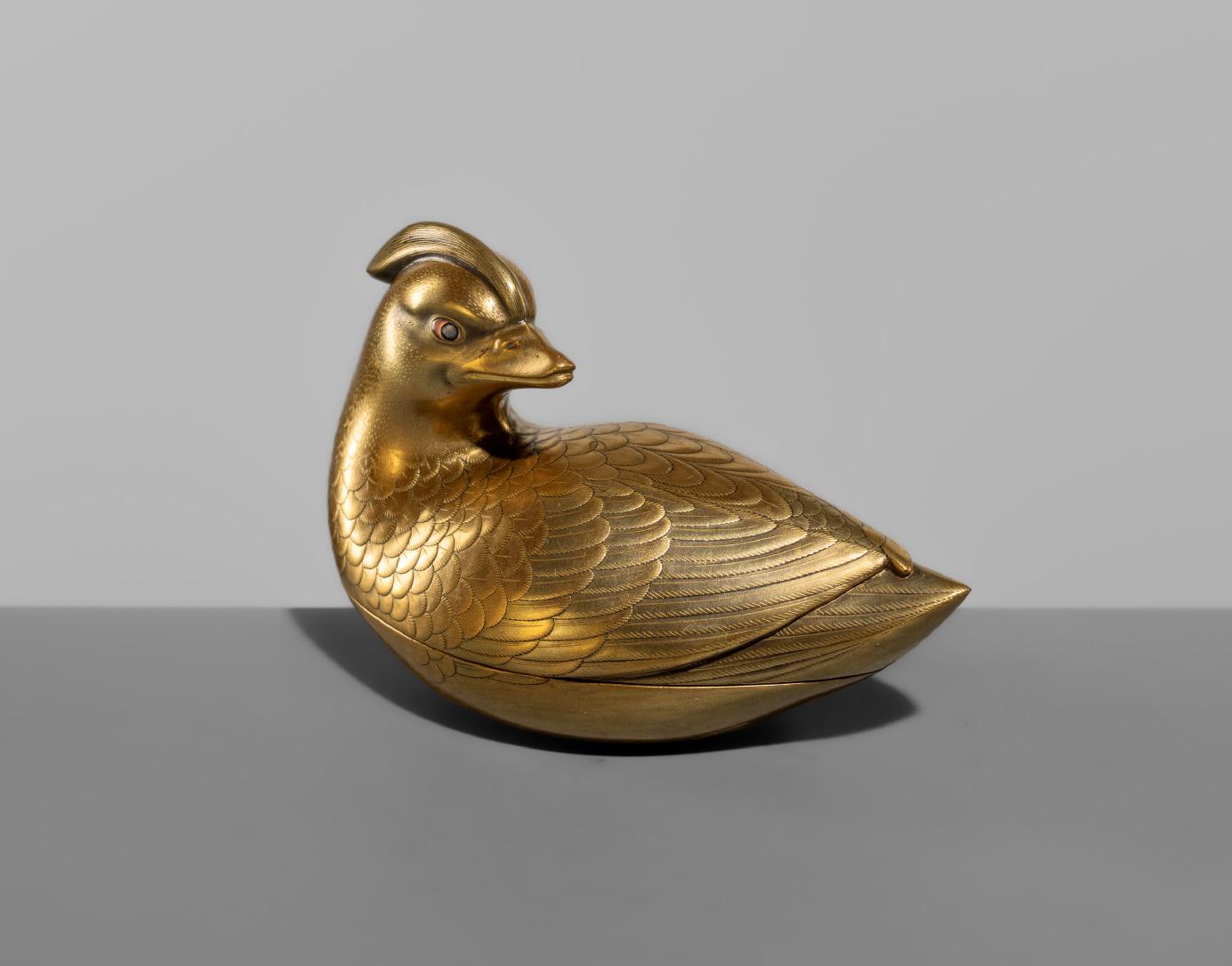
293
Japan, late 19th century, Meiji period (1868-1912)
The box and inrobuta (flush-fitting) lid are exquisitely modeled as a charming mandarin duck (oshidori), finely decorated in gold and silver takamaki-e and hiramaki-e against a beautiful kinji ground. The bird is shown with its head gently turned back, its plumage meticulously rendered in naturalistic detail, with particular attention to the finely worked feathers, the lifelike beak, and the vividly painted eyes. The underside is finished with two slender feet, while the interior reveals a rich nashiji ground with elegant gold fundame rims.
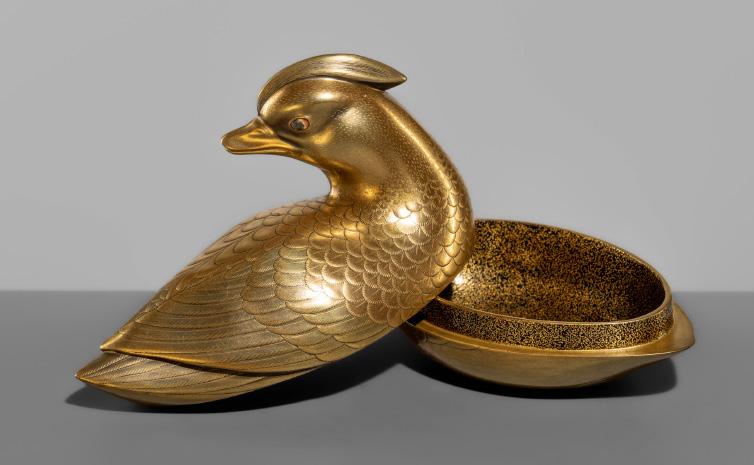
SIZE 5.5 x 7 x 10.1 cm
Provenance: Malcom Fairley Japanese Works of Art, London, 1998. A Swiss private collection, acquired from the above. A copy of the invoice from Malcom Fairley Japanese Works of Art, dated 26 September 1998, accompanies the lot. Condition: Excellent condition.
Mandarin ducks (oshidori), known for always swimming in pairs, symbolize deep conjugal affection, attachment, and fidelity. This type of kogo, typically crafted as a pair, was often presented as a ceremonial wedding gift.
MUSEUM COMPARISON
Compare a closely related pair of lacquer kogo in the shape of mandarin ducks, dated to the second half of the 19th century, in the Metropolitan Museum of Art, object number 14.40.820a–e.
AUCTION COMPARISON


Compare a closely related single lacquer kogo of a mandarin duck, dated to the late 19th century, 12.1 cm (length), at Christie’s, Asian Decorative Arts, 22 February 2001, London, lot 140 (sold for GBP 1,645 or approx. EUR 4,500 converted and adjusted for inflation at the time of writing).
Estimate EUR 3,000
Starting price EUR 1,500

294
KOSHINSAI HARUHIDE: A SUPERB GOLD-LACQUER ‘PEACH’ KOGO (INCENSE BOX) AND COVER WITH INTERIOR TRAY
By Koshinsai Haruhide (active 19th century), signed Koshinsai Haruhide zo Japan, 19th century, Edo period (1615-1868)
The box and inrobuta (flush-fitting) lid are elegantly shaped in the form of a peach, rendered in rich kinji with silver highlights, and carved with a curling stem and two leaves. The surface of the leaves is decorated in takamaki-e, hiramaki-e and subtly embellished with delicate kirigane flakes as well as aogai inlays. Inside, a removable lobed tray rests on three bracket feet and is decorated in black and gold takamaki-e and togidashi-e to depict a landscape scene with a pine tree, hut and river, all encircled by a gyobu-nashiji band. The interior is finished in nashiji with gold fundame rims. Nashiji to the underside and signed KOSHINSAI HARUHIDE zo [made by Koshinsai Haruhide].
SIZE 6 x 7.5 x 9 cm
Provenance: Barry Davies Oriental Art Ltd, London, 1999. A Swiss private collection, acquired from the above. A copy of the invoice from Barry Davies Oriental Art Ltd, dated 26 November 1999, accompanies the lot.
Condition: Very good condition with minor wear and tiny nicks. Very minor typical losses to the gyobu-nashiji and kirigane inlays and a tiny nick to the leaf.
Koshinsai Haruhide is recorded in E.A. Wrangham’s Index of Inro Artists (p. 150) under the name Koshinsai Yoshikawa. An accomplished lacquerer active during the 19th century and into the Meiji era, he is known for producing exceptional kogo and tebako, often incorporating interior trays, and invariably decorated in luxurious gold lacquer.


For another work by this exceptional artist see a lacquer tebako and tray, signed Koshinsai Haruhide with seal Yoshikawa, at Zacke, Fine Japanese Art, 4 June 2021, Vienna, lot 109 (sold for EUR 8,848). Also compare a closely related lacquer kobako and cover of a peach at Bonhams, The Harriet Szechenyi Sale of Japanese Art, 8 November 2011, Vienna, lot 396 (sold for GBP 2,375 or approx. EUR 4,700 converted and adjusted for inflation at the time of writing).
Estimate EUR 3,000 Starting price EUR 1,500
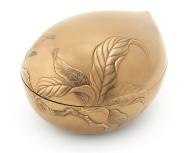

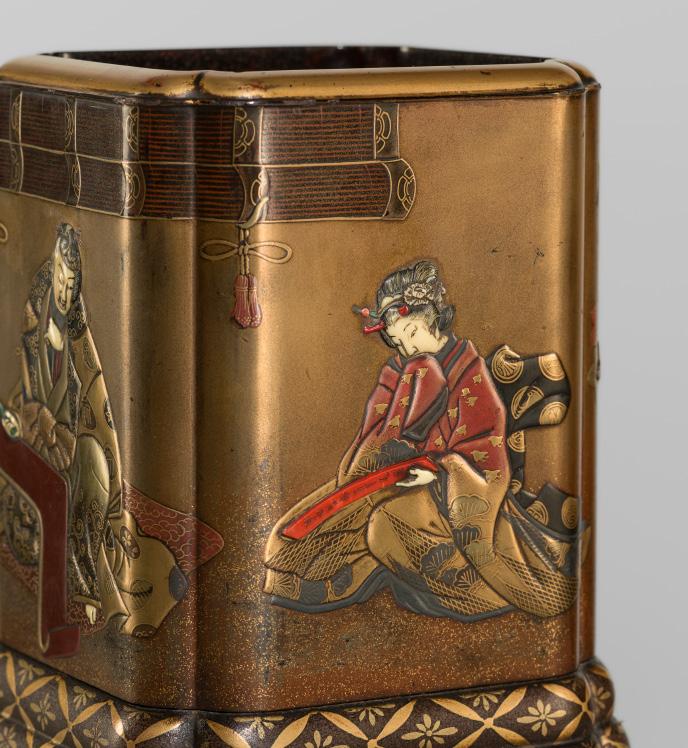
295
A SHIBAYAMA INLAID LACQUER FUDEZUTSU (BRUSHPOT)
Japan, Meiji period (1868-1912)
Of upright rectangular form with lobed sides, set on a tiered base supported by four feet. The sides are finely decorated in iro-e takamaki-e and hiramaki-e on a kinji ground, further enriched with a harmonious blend of Shibayama-style inlays including stained bone, motherof-pearl, semi-precious stones, coral and tortoiseshell. One panel depicts an elegantly dressed scholar seated before a desk beneath lowered blinds, holding a brush in his hand, his robes adorned with scrolling patterns and roundels. Next to him sits a lady holding a poem slip, wearing similarly elegant robes. The remaining two sides depict a maple tree behind a stone lantern finished in ishime lacquer and an open veranda. The base is finely decorated with brocade-style bands, while the underside and interior are finished in nashiji with fundame rims.
HEIGHT 15.6 cm
Condition: Very good condition with only minor wear and light traces of use, particularly to the interior. Minuscule losses to inlays and one inlay replaced.
Estimate EUR 3,000 Starting price EUR 1,500
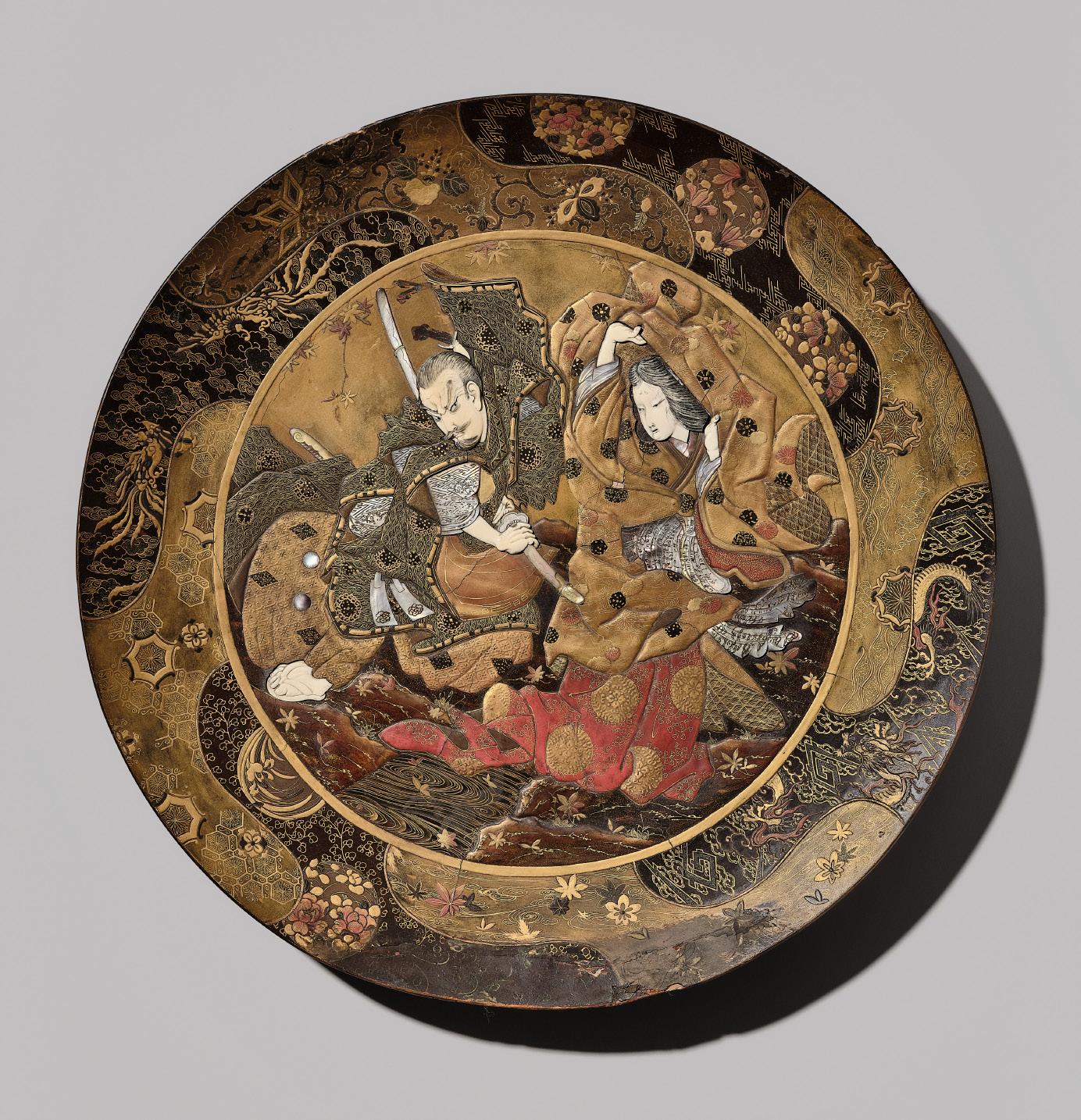
A LARGE SHIBAYAMA INLAID GOLD LACQUER CHARGER WITH OMORI HIKOSHICHI
Japan, Meiji period (1868-1912)
The large charger neatly decorated in iro-e takamai-e and hiramaki-e, featuring the scene where Omori Hikoshichi discovers that the woman he is carrying across the stream is actually a demon in disguise. The face, hands, and feet are inlaid in stained bone, the details finely embellished with inlays of mother-of-pearl. The cavetto richly decorated with a wide band of brocade patterns depicting dragons, phoenixes, clouds, auspicious plants, and vines. The reverse of dense nashiji with three phoenixes.
DIAMETER 58.7 cm
Condition: Some wear, minor losses to the inlays, age cracks, few chips, mostly along the edges, some with associated touchups and repairs, particularly noticeable to the back. Overall still presenting well.
The samurai Omori Hikoshichi lived in the 14th century and served Ashikaga no Takauji. As the story goes, one night during a shadow-casting full moon, Omori met a beautiful young woman in opulent robes who asked to be carried across a stream. When Omori sees the young woman’s reflection in the stream, he realizes that she is a demon in disguise. He then draws his sword and does what he must do.
AUCTION COMPARISON
Compare a related lacquer charger with figural subject, late 19th century, 59.2 cm in diameter, at Bonhams, Fine Japanese Works of Art, 20 March 2012, New York, lot 2211 (sold for GBP 27,500 or approx. EUR 54,000 converted and adjusted for inflation at the time of writing).
Estimate EUR 4,000
Starting price EUR 2,000
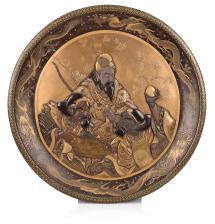
HATTORI SHUNSHO: ‘HOUSE OF LIGHT’
By Hattori Shunso (1943-2018), sealed to the tomobako Shun Japan, early 2000s
Of angular, faceted form, the rectangular box finely decorated in shimmering raden (mother-of-pearl) inlays, gold takamaki-e on a lustrous lacquer ground. The pointed inrobuta (flush-fitting) lid and box are composed of bold, geometric patterns in radiating triangular panels, alternating between rich metallic hues of gold, black (roiro), green, and orange, enhanced with fine linear and sprinkled details that create a prismatic effect. The interior is finished in roiro.
Inscribed to the cover of the tomobako: Raden Kazaribako, Hikari no Yakata, Shun 螺鈿飾箱、光の館、峻 [An ornament box decorated with iridescent shell inlay, entitled House of Light, Shun] and sealed Shun 峻
SIZE 9 x 9.2 x 9.4 cm
Condition: Excellent condition with only some minor nibbling to edges of the raden inlays.
Hattori Shunsho (1943–2018) was a highly esteemed Japanese lacquer artist celebrated for his refined craftsmanship and innovative approach to traditional techniques. He was first selected for the prestigious Nitten Exhibition in 1963 (Showa 38) and went on to exhibit there and at other major venues more than twenty times, earning numerous awards and distinctions throughout his career. In 1995, he had the honor of presenting a lacquer reading table to Pope John Paul II, symbolizing the international recognition of his artistry. In 2004, Hattori created the shelves for the guest room of the Kyoto State Guest House, commissioned by the Government of Japan. He was an active member of the Kyoto Crafts Artists Association, the Kyoto Lacquer Artists Association, and the Sokokai, contributing greatly to the preservation and advancement of Kyoto’s lacquer art tradition.
MUSEUM COMPARISON
Compare a closely related raden-inlaid kobako, by Hattori Shunsho, dated to 2013, 21 x 42 cm, exhibited at the 45th Nitten Exhibition and subsequently gifted to the Kyoto Nation Museum of Modern Art, object number Lc0172.
Estimate EUR 4,000
Starting price EUR 2,000
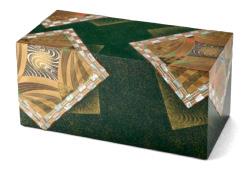
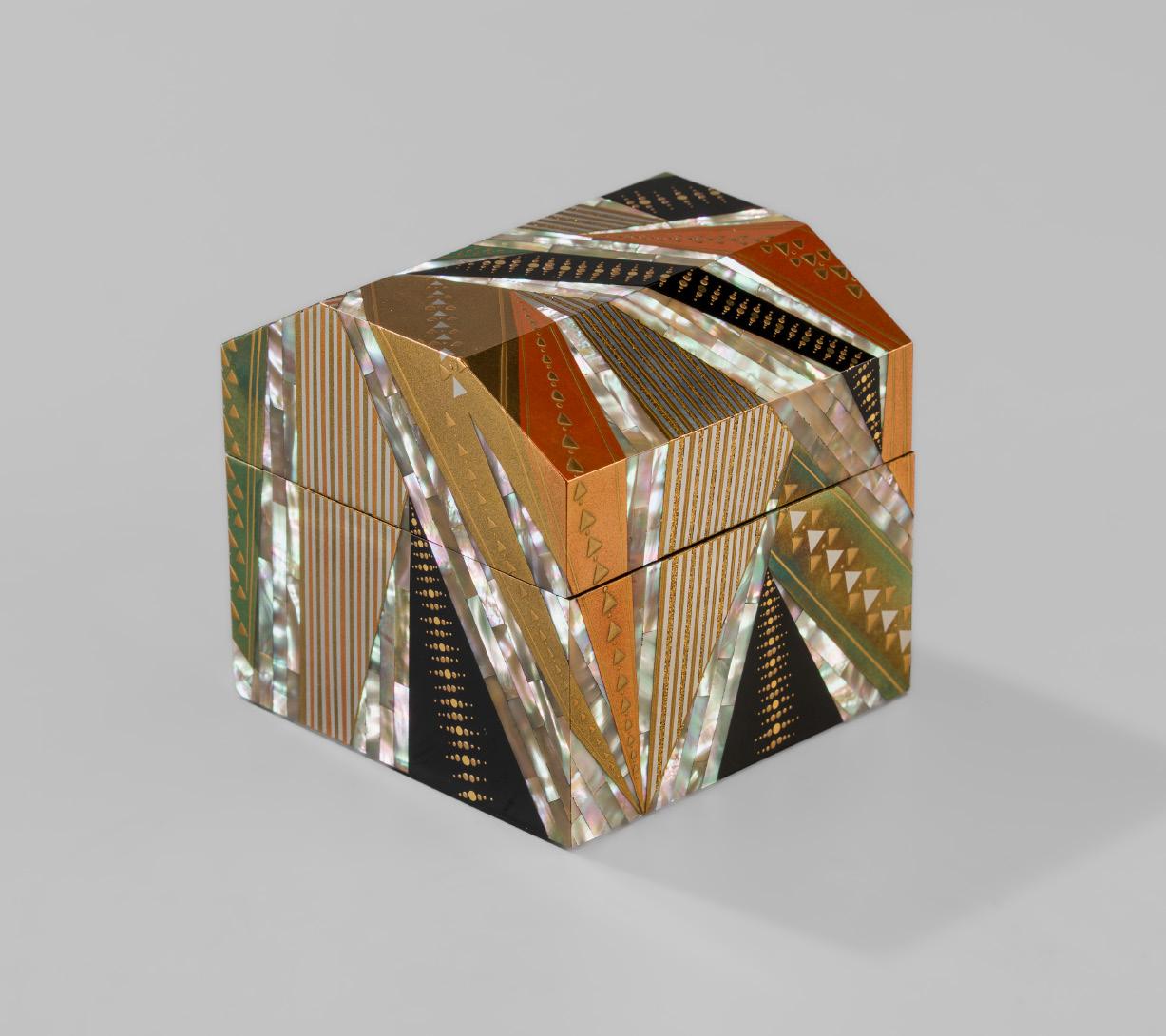
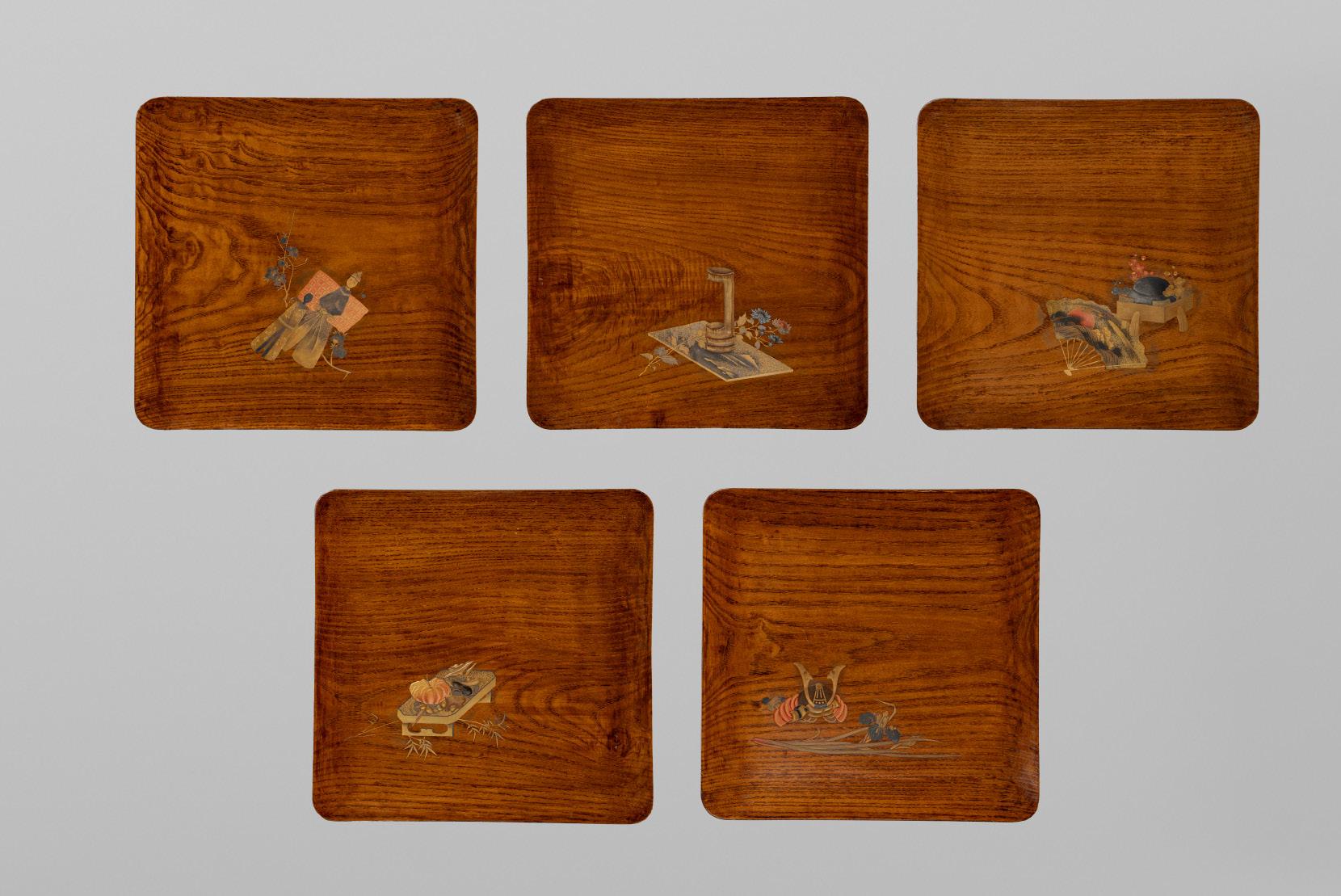
Japan, early 20th century, Meiji period (1868-1912) to Taisho period (1912-1926)
Each of rectangular form with rounded corners, bearing an attractive keyaki (zelkova) wood ground, finely decorated in iro-e takamaki-e and hiramaki-e with various seasonal motifs. The designs include a painting set with a bamboo flower vase and kiku sprig (alluding to Kikujido), Hina dolls associated with the Hinamatsuri (Girls’ Day) festival, assorted gourds, an arrangement of a folding fan with cherry blossoms, and a samurai helmet resting beside irises, symbolizing the Tango no Sekku (Boys’ Festival).
SIZE 32.4 x 33.4 cm
Condition: Very good condition with minor wear to the edges and light surface scratches.
With a wood tomobako (storage box).
AUCTION COMPARISON
Compare a closely related set of 20 Zeshin-school lacquer wood trays, by Kashima Keisai, dated to the Taisho period, at Zacke, Fine Japanese Art, 16 June 2023, Vienna, lot 24 (sold for EUR 12,870).
Estimate EUR 2,000 Starting price EUR 1,000

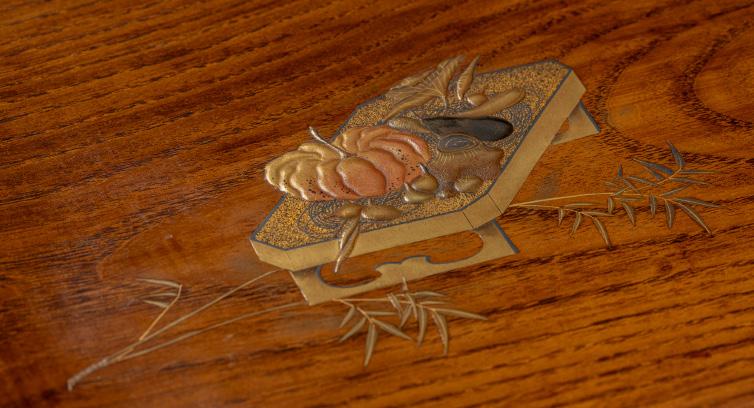


300
IKEDA TAISHIN: A SUPERB MINIATURE LACQUER KOGO (INCENSE BOX) AND COVER DEPICTING KIKU (CHRYSANTHEMUMS)
By Ikeda Taishin (1825-1903), signed Taishin Japan, second half of the 19th century, late Edo period (1615-1868) to Meiji period (1868-1912)
Of small, rectangular shape with rounded edges, bearing a lustrous roiro ground, masterfully decorated with gold takamaki-e and hiramaki-e. The kabusebuta (overhanging) lid, with its distinctive cutaway sides, is adorned with imperial chrysanthemum (kiku) motifs spreading across the top, sides and underside. The interior of fundame, signed TAISHIN.
SIZE 0.7 x 2.8 x 3.4 cm
Condition: Excellent condition.
With a wood tomobako (storage box) and fitted silk ‘floral’ pouch.
Estimate EUR 3,000
Starting price EUR 1,500
299 A FINE SILVER LACQUER KOBAKO (SMALL BOX) AND COVER DEPICTING THREE CROWS
Japan, 19th century, Edo period (1615-1868)
Of upright rectangular form with rounded edges, bearing a rogin-nuri ground and finely decorated in black and gold takamaki-e and hiramaki-e. The inrobuta (flush-fitting) lid depicts three crows in flight, their plumage delicately textured and their eyes inlaid with aogai (mother-of-pearl). The underside and interior are finished in nashiji with gold fundame rims.
SIZE 4.5 x 10 x 13.1 cm
Condition: Good condition with typical wear and tiny nibbling to the edges. A small bruise to the cover (c. 1.8 cm long) and two tiny chips to the edges of the underside. The interior with some losses to the gold fundame rim.
AUCTION COMPARISON
Compare a related rogin-nuri inro with two crows in flight, by Kansai, dated to the 19th century, at Christie’s, Crafted Landscapes: The Ankarcrona Collection of Japanese Lacquer and Asian Works of Art, 1 October 2020, New York, lot 55 (sold for USD 3,250 or approx. EUR 3,500 converted and adjusted for inflation at the time of writing).
Estimate EUR 2,000
Starting price EUR 1,000



301
SHIBATA ZESHIN (1807-1891): A MASTERFUL INLAID LACQUER KOGO (INCENSE BOX)
DEPICTING DAIKOKU TAKING A SMOKING BREAK
By Shibata Zeshin (1807-1891), signed Zeshin Japan, c. 1880s
Of circular form, masterfully decorated in delicate gold and silver takamaki-e, hiramaki-e, and sublime togidashi-e on delicately sprinkled ground. The inrobuta (flush-fitting) lid is adorned with a charming scene set behind a pewter and aogai (mother-of-pearl) inlaid fence, depicting Daikoku seated on a rice pestle beneath trailing ivy vines issuing fruits, leisurely smoking a pipe. The sides and underside are finished in matte silver, while the interior is in nashiji with gold fundame rims. Signed ZESHIN on the underside.
DIAMETER 7.5 cm

Provenance: From the Collection of Dr. med. Josef Markwalder, Baden, Switzerland, and thence by descent. With a handwritten label ‘’Daikoku’ der Gott des Reichtums als alter Mann Pfeife rauchend. Signatur: ‘Zeshin’’. Josef Markwalder was a Swiss physician active as a spa doctor in Baden in the early 20th century. Though little is documented about his career, his name endures in scholarship on Hermann Hesse (1877–1962), the Nobel Prize–winning German-Swiss author of Siddhartha and Der Steppenwolf, where Markwalder is noted as a trusted medical figure during the writer’s difficult years of illness and recovery. Condition: Excellent condition.
Shibata Zeshin (1807-1891) was a Japanese painter, lacquer artist, and printmaker of the late Edo period to early Meiji era. Nominated as one of the first Teishitsu Gigeiin (Imperial Court Artist) in Meiji 23 (1890), Shibata Zeshin excelled in several art forms, including painting, lacquer-making, print design, and calligraphy.
MUSEUM COMPARISON
Compare a closely related inro with a near-identical design, by Shibata Zeshin, in the Victoria & Albert Museum, London, accession no. W.298:1, 2-1922.
AUCTION COMPARISON
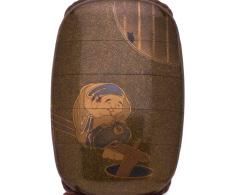


Compare a related gold lacquer inro showing Daikoku and ebisu, the verso with an oni and similarly inlaid fence, by Shibata Zeshin, dated to ca. 1886, at Bonhams, Patient Detail, Perfect Design, 3 November 2022, London, lot 63 (sold for GBP 38,100 or approx. EUR 50,000 converted and adjusted for inflation at the time of writing).
Estimate EUR 15,000 Starting price EUR 7,500

302
SHIBATA ZESHIN: A SUPERB URUSHI-E (LACQUER PAINTING) OF A TEA CEREMONY SET
By Shibata
Zeshin (1807-1891), signed Zeshin with seal Reisai Japan, late 19th century, Meiji period (1868-1912)
Of upright rectangular form, finely decorated in masterful polychrome urushi-e lacquer on a shitan-nuri ground, mounted on paper. Elegantly depicting a still life scene of a tea ceremony set comprising a kyusu (side-handled teapot) heating on a hibachi (brazier) beautifully decorated with a spray of maple. Next to it rests a chashaku (tea scoop), a small tea bowl and a silver chaire (tea caddy). Signed to the brazier ZESHIN with seal Reisai.
SIZE 47.5 x 31.5 cm (excl. frame), 64.7 x 48.5 cm (incl. frame)
Provenance: Bonhams, Fine Japanese Art, 16 May 2013, London, lot 419. The Saoud bin Mohammed Ali Al-Thani Foundation, acquired from the above.
Condition: Good condition with wear. A few surface scratches, some light warping and a tiny loss to the lower corner. Overall presenting very well.
With an old wood frame.

Saoud bin Mohammed bin Ali Al-Thani (1966-2014)
Shitan-nuri (simulated rosewood lacquer) was one of the most complex surfaces that Zeshin invented. He is thought to have developed it during the 1840s and 1850s. The realistic treatment is enhanced by scratching the fictive grain of the wood into the lacquer surface, a technique in which a rat’s tooth is thought to have been used. Extant shitan-nuri pieces by Zeshin are rare.
MUSEUM COMPARISON
Tea vessels were one of Zeshin’s favored still life subjects. Compare a related lacquer painting, by Shibata Zeshin, dated to 1879, in the British Museum, registration number 1913,0501,0.555.
AUCTION COMPARISON
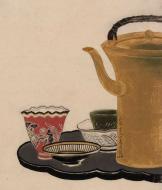

Compare a related urushi-e (lacquer painting) with an ewer, by Shibata Zeshin, dated to ca. 1878, 53.7 x 58.2 cm, at Bonhams, The Mitsumi Collection of Important Works of Lacquer Art and Paintings, 5 November 2014, London, lot 11 (sold for GBP 31,250 or approx. EUR 57,000 converted and adjusted for inflation at the time of writing).
Estimate EUR 6,000
Starting price EUR 3,000

303
SHIBATA ZESHIN: A SUPERB URUSHI-E (LACQUER) FAN PAINTING DEPICTING ANTS AND A BEAN POD
By Shibata Zeshin (1807-1891), signed Zeshin with seal Nanken Japan, late 19th century, Meiji period (1868-1912)
In the shape of a fan, finely decorated in brown urushi-e lacquer on gofun-treated paper, superbly depicting a bean pod curling from the right edge toward the center, with a single ant crawling upon it and four more following in line below it. Signed to the lower right ZESHIN with seal REISAI.
SIZE 37 x 16 cm (excl. frame), 55.7 x 35.2 cm (incl. frame)
Provenance: Kunstzaal van Lier, Amsterdam, The Netherlands. With an old collection label ‘Kunstzaal v. Lier No. 86’ to the back and inscribed on the back ‘53/2’, 2394’, and ‘Zeshin’.
Condition: Very good condition with minor wear. Two small tears to the upper right corner, creasing and folds limited to the edges and corners. Part of an old blue label to the back. Presenting very well.
Set within an old frame behind a passe-partout.
Shibata Zeshin (1807-1891) was a Japanese painter, lacquer artist, and printmaker of the late Edo period to early Meiji era. Nominated as one of the first Teishitsu Gigeiin (Imperial Court Artist) in Meiji 23 (1890), Shibata Zeshin excelled in several art forms, including painting, lacquer-making, print design, and calligraphy. He had an outstanding studio with talented students specializing in lacquer, paintings and prints. He has been called ‘Japan’s greatest lacquerer.’ His work, unlike the oils being used by so many of his
contemporaries, never needed re-touching and never faded. He was a master of emulating oil or ink painting with lacquer and combined groundbreaking techniques with traditional subjects. His studio was situated on the bank of a river, providing him with ample opportunity to observe nature, and the creatures that inhabited the natural world. Like many painters of the 19th century, he was eclectic in his sources and would have been exposed to traditional styles. However, Zeshin’s skill level was such that he could fluidly mix techniques, ideas, and stylistic options, thus painting part of a composition in one manner and including elements of another to add variety and dynamics unheard of at the time.
MUSEUM COMPARISON
Compare a closely related lacquer painting depicting the same subject, by Shibata Zeshin, signed Zeshin with seal Zeshin, in the British Museum, registration no. 1928,0720,0.36.
AUCTION COMPARISON


Compare two related urushi-e (lacquer) fan paintings, by Shibata Zeshin, size 15.5 x 49 cm, at Bonhams, Fine Japanese Art, 10 November 2011, London, lot 255 (sold for GBP 11,250 or approx. EUR 22,500 converted and adjusted for inflation at the time of writing).
Estimate EUR 4,000
Starting price EUR 2,000

A SUPERB AND LARGE TOGIDASHI LACQUER PANEL DEPICTING SHOKI CHASING TWO ONI
Japan, Meiji period (1868-1912)
Of horizontal rectangular form, the panel set within a frame, superbly decorated in gold, red, and silver togidashi-e on a lustrous roiro ground. The scene depicts Shoki the Demon Queller (Zhong Kui) brandishing his sword as two terrified oni flee before him. Shoki, shown with a fierce expression and dressed in flowing Chinese robes and an official headdress, holds a sword with a hilt embellished with nashiji. In the upper right corner, the two demons leap away in panic, one raising his arm over his head in terror.
SIZE 29 x 69 cm (total)

Condition: Very good condition with only very minor wear and some light discoloration to the lacquered ground near the edges.
Shoki was a scholar of early seventh-century China who committed suicide after being cheated out of the first rank in civil service examinations, yet who was buried with honors after the emperor heard the tragic tale. To show his gratitude, Shoki appeared as an exorcist in a dream of a subsequent Chinese emperor and vowed to quell demons and banish disease. In Japan, auspicious images of Shoki were displayed for the Boys’ Day Festival, celebrated on the fifth day of the fifth month.
LITERATURE COMPARISON
Compare a related Zeshin school inro depicting the same subject, illustrated in Sydney L. Moss Ltd. (2014) Lac Lacquer Lacquest, no. 114.
Estimate EUR 4,000
Starting price EUR 2,000


Lots 305 to 360


A LARGE AND FINE EMBROIDERED WALL HANGING WITH A TIGER, KIRIN AND HO-O
Japan, Meiji period (1868-1912)
Of vertical rectangular form, finely embroidered with silk and gold threads on a warm brown ground, richly decorated with a pair of ho-o (phoenixes) soaring amidst swirling clouds and blossoming peonies, their wings extended and long streaming tails curling gracefully. Below, a powerfully striding tiger gazes upward toward the heavens, while beside it a kirin (qilin) stands poised and alert among rugged rockwork.
SIZE 241 x 148 cm
Condition: Very good condition with minimal wear, small tears, a few minor losses, and some loose threads. Overall presenting beautifully.
The tiger, kirin, and ho-o are among the most celebrated creatures of East Asian myth and cosmology, often appearing in combinations that evoke themes of balance, prosperity, and virtuous rule.
AUCTION COMPARISON
Compare a closely related silk embroidered hanging of a dragon, kirin, lion and tiger, dated to the late 19th century, size 200.6 x 150 cm, at Christie’s, Japanese Art and Design, 12 May 2010, London, lot 531 (sold for GBP 1,875 or approx. EUR 4,000 converted and adjusted for inflation at the time of writing).
Estimate EUR 4,000
Starting price EUR 2,000


306
OSAWA NAMPO: A HUMOROUS OSHI-E (PADDED SILK) PAINTING DEPICTING A FROG DAIMYO PROCESSION
By Osawa Nampo (1845-1895), signed Osawa Nampo onna saku with seal Nampo Japan, late 19th century, Meiji period (1868-1912)
Watercolors and padded silk on canvas. Set within a wood frame. Amusingly painted and applied in the oshi-e technique to depict a whimsical parody of a daimyo gyoretsu (feudal lord’s procession), the entourage is formed by lively frogs marching in file, several carry banners made from lotus leaves, while others shoulder poles or guard the cart at the rear.
Inscriptions: To the lower left, Osawa Nampo onna saku 大澤 南 芳 女 作 [made by Osawa Nampo, a female artist] with seal Nampo 南芳
SIZE 54 x 85 cm, SIZE incl. frame 61 x 89.7 cm
Condition: Fair condition with expected wear. Few stains, rubbing, obvious losses to some frogs, and tears to the canvas. Repairs to the largest tear near the bottom. Overall presenting well.
Osawa Nampo (1845–1905) was a female painter from the Nihonbashi district of Edo (modern Tokyo). She studied painting under Okamoto Shuki (1807–1862), a leading follower of the Shijo school, and later under Aoki Nanka (1817–1903). Nampo is remembered as one of the relatively few female artists of her generation to achieve recognition within the male-dominated art world of late Edo and Meiji Japan.
Oshi-e, also known as kiritori zaiku was a technique in which paper or silk wadding is covered with dyed and painted silk or paper to create padded relief designs. Little is known of this technique, but it probably dates back to the Muromachi Period. In the Meiji era, oshi-e was regarded as a feminine accomplishment alongside ikebana, tea ceremony and embroidery. Few recorded examples survive today but the genre was displayed in the ‘Fancy Articles’ section of the Philadelphia Centennial Exhibition of 1876.

Nampo’s work became known in the West through its extraordinary connection to James McNeill Whistler. A pair of her flower paintings, signed and dated 1866 and 1867, were sent to Europe before 1871. These works were later incorporated into a folding screen together with Whistler’s Blue and Silver: Screen, with Old Battersea Bridge (1871–72). Whistler’s painting, dominated by the piers of Old Battersea Bridge with the Albert Suspension Bridge under construction in the background, was planned during the summer of 1871 and exhibited in his 1874 show at the Flemish Gallery, London, as Screen – Blue and Silver. The screen uniquely combined Whistler’s composition with Nampo’s earlier Japanese paintings, although they were made on separate supports and it remains uncertain when they were framed back-to-back to form a single object. James McNeill Whistler, c. 1863
Estimate EUR 2,000
Starting price EUR 1,000


MUSEUM COMPARISON
Compare a related silk painting depicting the procession of daimyo, by Sakurai Seppo, dated before 1880, in the Whyte Museum of Canadian Rockies, accession number SeP.15.01.

AUCTION COMPARISON
Compare a related oshi-e (padded silk) painting of an insect parade, by Sekka, dated to the Meiji period, at Bonhams, Asian Art, 13 November 2013, Edinburgh, lot 98 (sold for GBP 1,500 or approx. EUR 2,800 converted and adjusted for inflation at the time of writing).

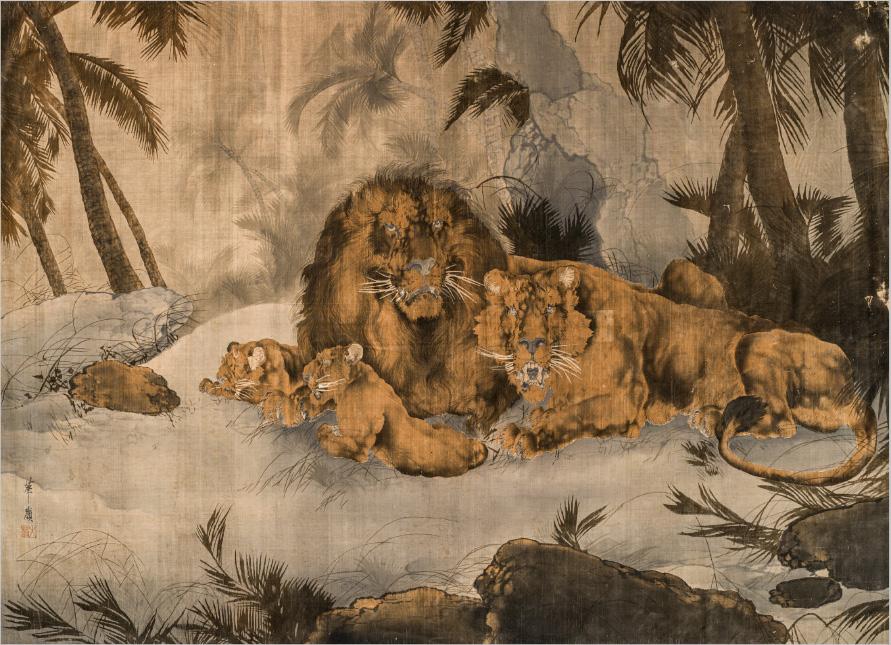

307
By Ohashi Karei, signed Karei and sealed Ohashi Japan, Meiji period (1868-1912)
Each set within a brocade silk and wood frame to depict a family of lions within a lush, exotic landscape. The first panel shows a powerful male lion and a reclining lioness attentively watching over their playful cubs, all set against a backdrop of palm trees, blossoming foliage, and large hydrangea-like blooms. The second panel similarly depicts a male and female lion with their young, resting beneath tall palms and leafy vegetation.
Inscriptions: Each signed Karei 華嶺 with seal Ohashi 大橋
SIZE 170 x 222.5 cm (each)
Condition: Good condition with expected wear. Some soiling, few stains, obvious loose threads, some tears and losses, particularly to the brocade edges and not affecting the image.
AUCTION COMPARISON
Compare a related velvet hanging of tigers, dated to the late 19th century, at Christie’s, Asian and Fine European Costume, Textiles and Fans, 19 November 2002, London, lot 143 (sold for GBP 1,527 or approx. EUR 4,000 converted and adjusted for inflation at the time of writing). Compare a related six-panel screen, by Ohashi Suiseki, at Christie’s, Japanese and Korean Works of Art, 22 September 2004, New York, lot 184 (sold for 9,560 USD or approx. EUR 14,500 converted and adjusted for inflation at the time of writing).
Estimate EUR 2,000
Starting price EUR 1,000

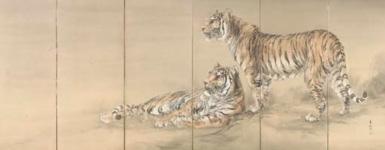

A LARGE EMBROIDERED SILK PANEL DEPICTING HAKONE SHRINE BEFORE MOUNT FUJI, MEIJI PERIOD
Japan, Meiji period (1868-1912)
The large panel is finely embroidered in various shades of blue, green, red, orange, white, brown, and black, depicting the Hakone Shrine at Lake Ashi with its vibrant red torii gate to the left, and the temple’s iconic tiered pagoda to the right, partially shrouded by cherry blossom trees, all framed by the towering snow-capped Mount Fuji in the back. Mounted on silk brocade and set inside a frame, behind glass.
Image SIZE 55 x 87 cm, SIZE incl. mounting 87 x 118.5 cm

Condition: Very good condition with some light soiling, few loose threads, minor traces of use and wear.
Estimate EUR 1,500
Starting price EUR 800
309 A FINE TWO-PANEL BYOBU (FOLDING SCREEN) DEPICTING CHRYSANTHEMUMS
Japan, 17th-18th century, Edo period (1615-1868)
Ink, watercolors, gouache, and gold paint on paper. Mounted on silk brocade on two wood panels with gilt-metal fittings. Finely painted with bunches of chrysanthemums in white, orange and red, against a sprinkled gold ground.
SIZE 156 x 126 cm

Provenance: With Naga Antiques, New York, a paper label affixed to the back. The private estate of Jay Jones and Mary Jayne Jones, Washington State, USA, acquired from the above. Jay Jones (1924-2024) and Mary Jayne Jones (1924-2022) were married 72 years, living most of that time in the Seattle area. They enjoyed traveling, skiing and tennis, loved entertaining, and had a passion for collecting art. They had diverse artistic interests, from an extensive collection of Arctic Inuit sculpture to archaic Asian artifacts and an exquisite collection of early 20th century Japanese lacquer scholar’s boxes as well as fine Japanese screens mostly purchased from Naga Antiques in New York.
Condition: Very good condition with wear. Minor soiling and expected flaking and rubbing to pigment. The background with tears and small losses with associated touchups. The back with traces of wear and use.
MUSEUM COMPARISON
Compare a related six-panel byobu depicting summer and autumn flowers including chrysanthemums, Edo period, dated to the 17th century, in the National Museum of Asian Art, accession number F1896.82.

Estimate EUR 5,000
Starting price EUR 2,400


310 A FINE FOUR-PANEL BYOBU (FOLDING SCREEN) DEPICTING WILLOW AND IRIS BLOSSOMS
Japan, 17th-18th century, Edo period (1615-1868)
Ink, watercolors, gouache, and silver leaf on paper. Mounted on silk brocade on four lacquered wood panels with brass fittings. Painted with a meandering branch of a blossoming willow, its rugged bark finely rendered, issuing dangling vines bearing pale blooms, all above a bed of shobu (irises) and further foliage.
SIZE 106.6 x 185 cm
Provenance: Property of Madam Li Ai-Vee, The Chalet Yu Lan Collection, thence by descent. Li Ai Vee (1932-2021) was a Shanghai-born painter living in Switzerland and a fervent collector of Chinese and Japanese art. She was introduced to painting by her mother, an artist, and later became a student of prestigious painters such as Lin Fengmian


Starting price EUR 3,000 (1900-1991), Lu Yifei (1908-1997), and Zen master Rinzai Yamada Mumon Roshi (1900-1988). In 1958, Li Ai Vee left China and settled in Zurich, Switzerland. In 1965, she studied under the internationally renowned Zhang Daqian (1899-1983), and was awarded the Medal of the City of Paris in recognition of her art. Her extensive collection of Asian art includes monochrome vases, paintings and albums, both Chinese and Japanese, scholarly objects, carved jades and divinities from the Asian pantheon, all of which she combined with her passion for art.

Condition: Good condition with wear. Few stains, minor soiling, and scattered nicks and scratches. Expected flaking and rubbing to pigment—some with associated touchups. The back with traces of wear and use; minor tears with associated losses to the joints.
Compare a related silver leaf screen depicting branches and grasses, dated late Edo to Meiji, but likely also 17th-18th century, at Christie’s, Asian Art, 10 December 2010, Paris, lot 75 (sold for EUR 18,750 or approx. EUR 26,000 adjusted for inflation at the time of writing).
Estimate EUR 6,000
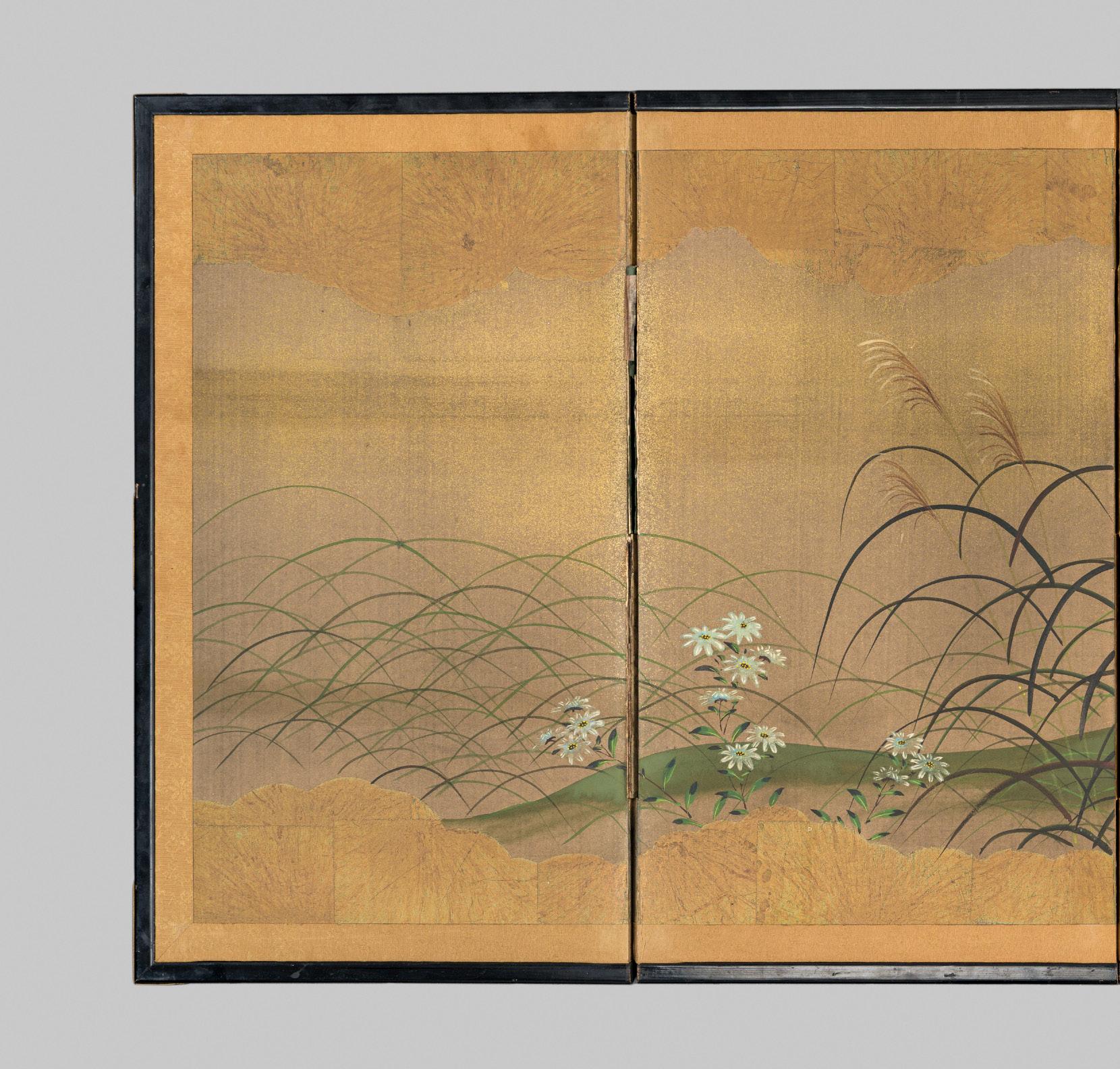
311
A FOUR-PANEL RINPA SCHOOL BYOBU (FOLDING SCREEN) WITH AUTUMN FLOWERS AND GRASSES
Japan, 18th-19th century, Edo period (1615-1868)
Ink, watercolors, gouache, and gold leaf on paper. Mounted on silk brocade on four lacquered wood panels with gilt metal fittings. Finely painted to depict blue and white autumnal flowers amid grasses, framed above and below by scrolling clouds.
Inscriptions: To the lower-right, signed Chisokuken […] 知足軒 […] with seal.
SIZE 51.4 x 113.1 cm
Provenance: Collection of the late Christoph von FürerHaimendorf, London, United Kingdom.
Condition: Very good condition with wear. Little soiling, tiny stains, and expected flaking to pigment. The back with signs of wear and use. Minor tears and losses to the joints.
Estimate EUR 4,000
Starting price EUR 2,000


AUCTION COMPARISON
Compare a closely related Rimpa School screen depicting a hedge and autumn grasses, 17th century, size 144.5 x 348 cm, at Christie’s, Japanese and Korean Art, 21 September 2006, New York, lot 136 (sold for USD 28,800 or approx. EUR 39,500 converted and adjusted for inflation at the time of writing).

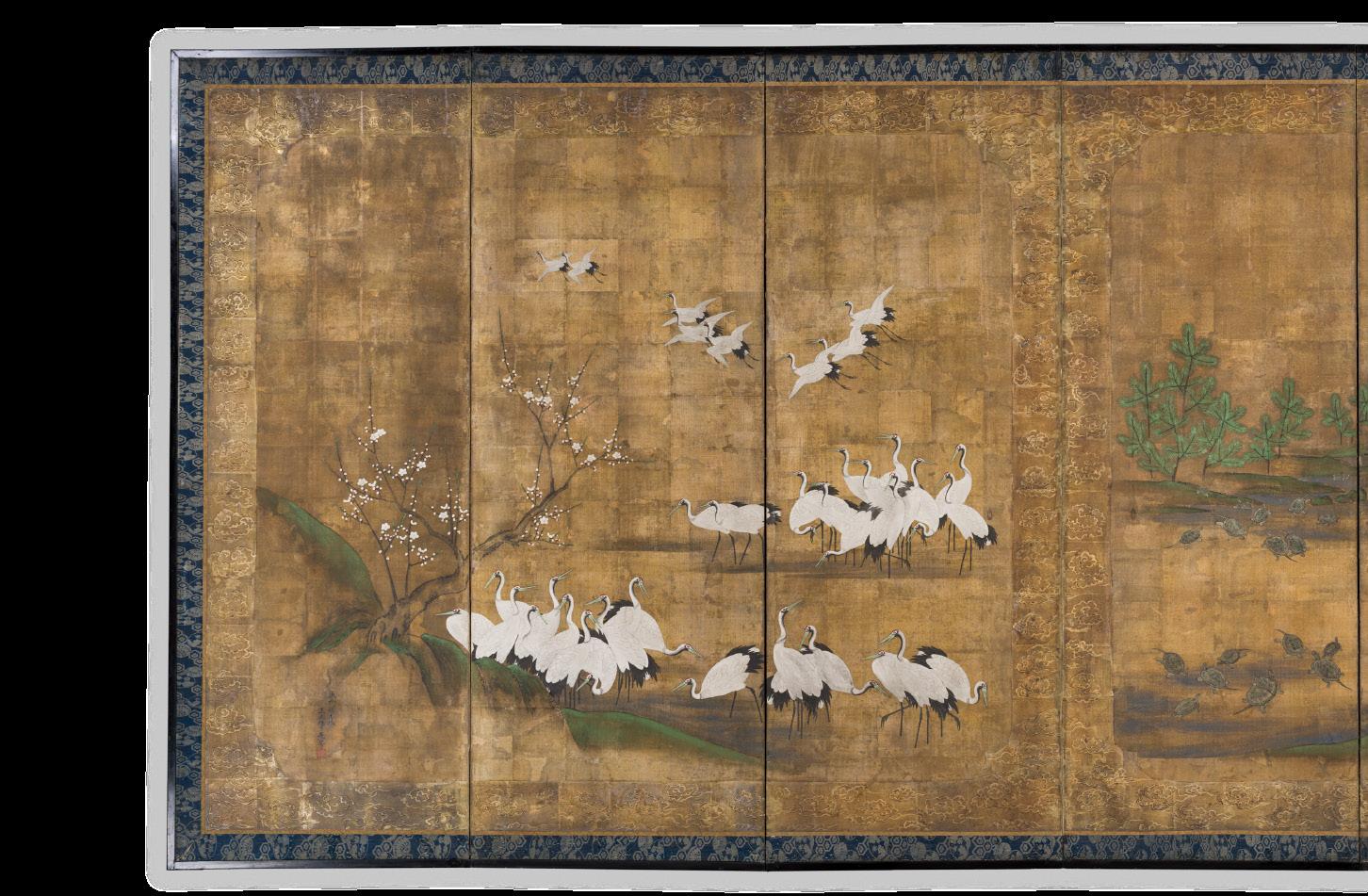


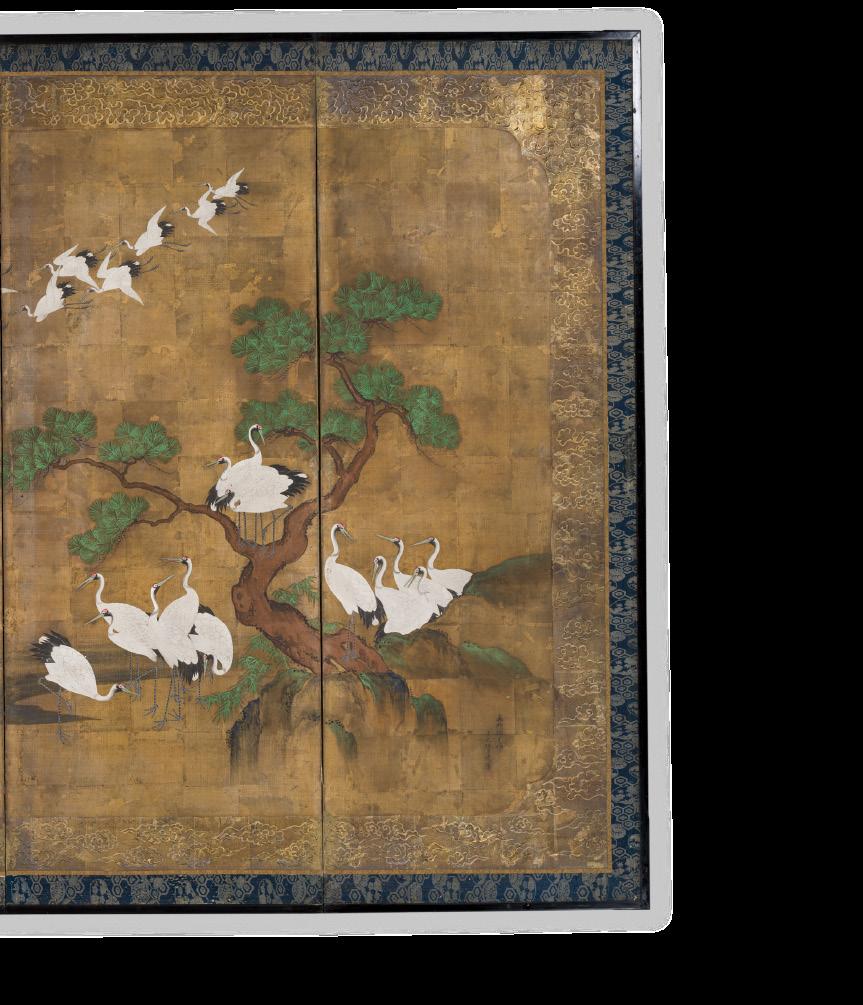
312
TOSA MITSUYOSHI: A TOSA SCHOOL
PAIR OF SIX-PANEL BYOBU (FOLDING SCREEN) DEPICTING CRANES AND TURTLES
By Tosa Mitsuyoshi (1700–1772), signed and sealed by the artist Japan, c. 1737, Edo period (1615-1868)
Ink, watercolors, gouache, and gold paint on silk. Mounted on silk brocade on roiro lacquered wood panels with gilt-metal fittings. Finely painted to depict cranes wading, flying, and gathering beside a leaning plum tree (ume) in full bloom, evoking a scene of festive harmony. The companion screen depicts turtles at play along a tranquil riverside bordered by pine and bamboo - the classic “Three Friends of Winter” (saikan sanyu), symbolizing steadfastness amid adversity
Inscriptions: Each screen signed Edokoro azukari, Tosa, Shogoi no ge, Mitsuyoshi 画所預土佐 正 五位下光芳 [Head of the Court Painting Bureau (e-dokoro azukari), the Tosa School, Junior Fifth Rank, Mitsuyoshi] with seal Mitsuyoshi no in 光芳之印 [The seal of Mitsuyoshi].
SIZE 169 x 370 cm (each)
Condition: Good condition with wear. Some soiling, few stains, and flaking and rubbing to pigment. some losses with associated repairs and touchups. The back with signs of wear and use and reinforcements. Tears and losses to the joints with associated repairs.
Tosa Mitsuyoshi (1700–1772), also read Mitsufusa, was a distinguished painter of the Tosa school during the mid-Edo period. The son of Tosa Mitsusuke (or Mitsutaka), he demonstrated remarkable artistic promise from an early age. Following the deaths of his father and grandfather Tosa Mitsunari in 1710, Mitsuyoshi was appointed Head of the Court Painting Bureau (e-dokoro azukari) at only eleven years old. In 1738, he produced the ceremonial daijo-e byobu for Emperor Sakuramachi, continuing the imperial Yamato-e tradition. His Buddhist name was Jokaku.
This rare and finely executed pair of six-panel folding screens by Tosa Mitsuyoshi presents the auspicious pairing of cranes (tsuru) and turtles (kame), painted against a shimmering ground of gold leaf on silk with delicate cloud motifs in low relief. In Japanese tradition, the crane and turtle together symbolize longevity, wisdom, and good fortune - the crane said to live a thousand years, the turtle ten thousand. Together, they form a powerful emblem of steadfastness and blessings, often seen in art and celebratory contexts such as weddings.
The ‘Three Friends of Winter’ motif is frequently used across all mediums in Chinese art. Comprised of pine, bamboo and prunus, this motif is emblematic of the Confucian virtues of fortitude and resilience. As the pine and bamboo are evergreen plants and the prunus, a plant that has lived for a long time, the three together are also an auspicious symbol of longevity.
Estimate EUR 10,000
Starting price EUR 5,000
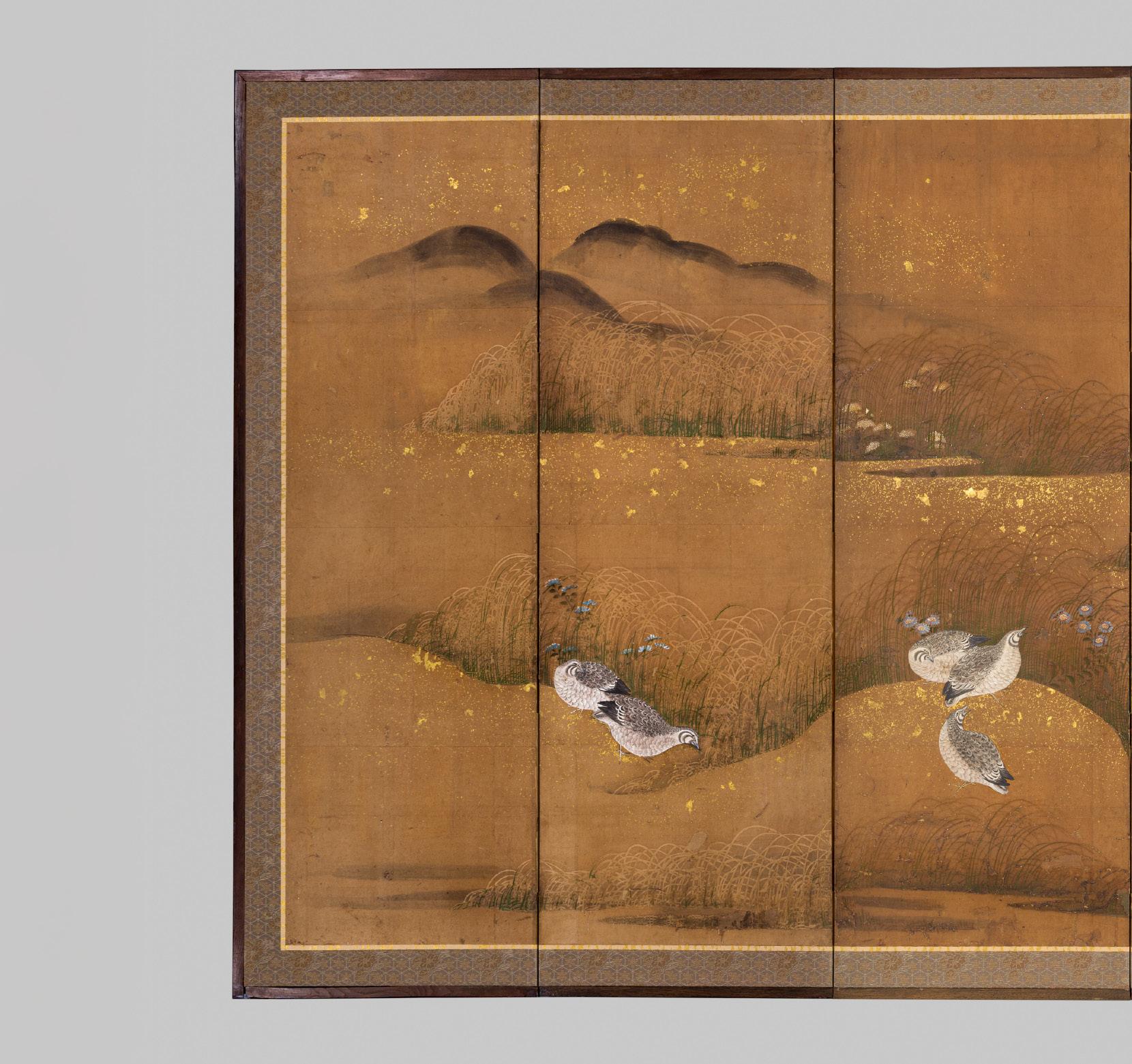
A SUPERB SIX-PANEL TOSA SCHOOL BYOBU (FOLDING SCREEN) OF QUAILS WITH AUTUMN GRASSES AND FLOWERS
Japan, 18th to early 19th century, Edo period (1615-1868)
Ink, watercolors, gouache, and gold paint on paper. Mounted on silk brocade on six wood panels with chased metal fittings. Finely painted with a bevy of quails frolicking about rolling hills dotted with tall autumnal grasses and vibrant blooms.
SIZE 151 x 292 cm
Provenance: Naga Antiques Ltd, New York, 1997, sold for USD 38,000 (or approx. EUR 66,000 converted and adjusted for inflation at the time of writing). The private estate of Jay Jones and Mary Jayne Jones, Washington State, USA, acquired from the above on 5 May 1997, a copy of the invoice accompanies this lot. Jay Jones (1924-2024) and Mary Jayne Jones (1924-2022) were married 72 years, living most of that time in the Seattle area. They enjoyed traveling, skiing and tennis, loved entertaining, and had a passion for collecting art. They had diverse artistic interests, from an extensive collection of Arctic Inuit sculpture to archaic Asian artifacts and an exquisite collection of


early 20th century Japanese lacquer scholar’s boxes as well as fine Japanese screens mostly purchased from Naga Antiques in New York. Condition: Good condition with old wear. Some soiling, few stains, scattered losses and wormholes, and expected flaking to pigment— some with associated touchups. The back with signs of wear and use.
MUSEUM COMPARISON
Compare a closely related Tosa school byobu depicting quails and pampas grasses, dated to the 18th century, in the Art Gallery NSW, accession no. 298.2007.

AUCTION COMPARISON
Compare a related pair of screens depicting quails by Tosa Mitsunari, dated to the early 18th century, at Sotheby’s, Art of Japan, 5 November 2024, London, lot 2 (estimated at USD 80,000-100,000 or approx. EUR 71,00088,000 converted at the time of writing).
Estimate EUR 10,000
Starting price EUR 5,000
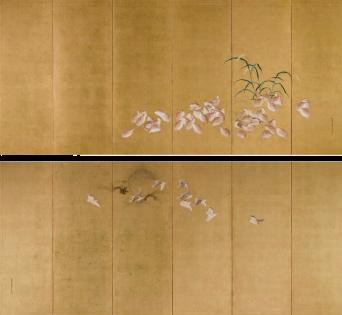
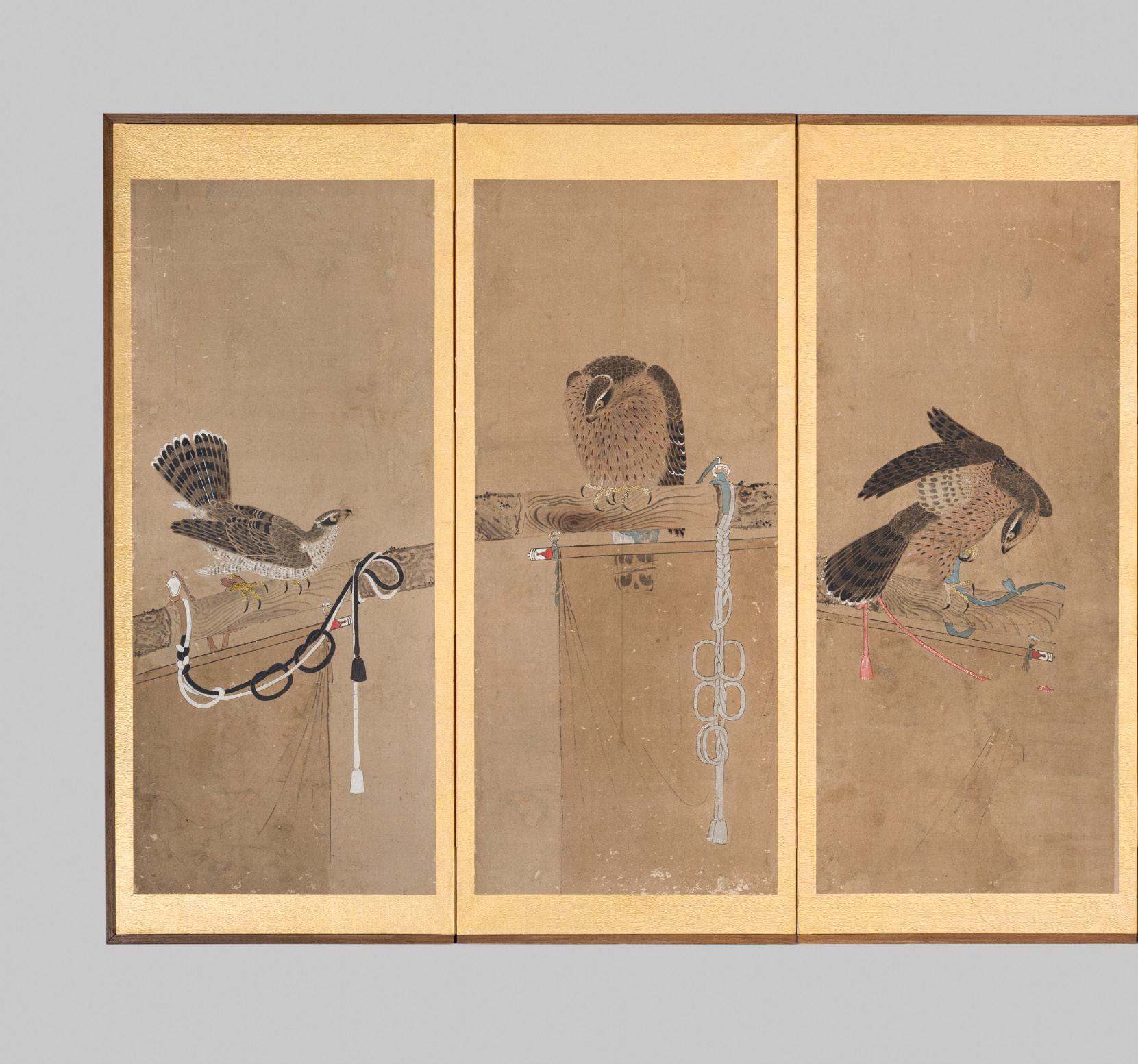
A FINE SIX-PANEL ‘FALCONRY’ BYOBU (FOLDING SCREEN)
Japan, 18th century, Edo period (1615-1868)
Ink, watercolors, gouache, and gold paint on paper. Mounted on six wood panels. Each panel depicting a tethered falcon (taka), each positioned slightly differently, standing on a long perch, staring ahead, preening itself, with its head turned in the direction of its companion or perhaps eyeing prey in the distance.
SIZE 133 x 330 cm
Condition: Good condition with old wear. Soiling, scattered stains, and expected flaking to pigment. Losses with associated repairs and touchups. The back with signs of wear and use.
Falconry (takagari) was introduced to Japan from China in the 4th century. Hunting with hawks and falcons is mentioned in the Kojiki (712). In the Heian period (794-1185), the sport of falconry was practiced by emperors and their courtiers. By the Kamakura period (1185-1333), samurai clans had established various schools, methods and traditions of hunting with falcons and hawks. By the Edo period (1615-1868), falconry was officially patronized by the shogunate and the position of master of falconry was established in the shogunate bureaucracy.
Estimate EUR 3,000
Starting price EUR 1,500

AUCTION COMPARISON
Compare a closely related six-panel ‘falconry’ byobu screen, dated to the 17th century, size 171 x 378 cm, at Zacke, Fine Japanese Art, 14 June 2024, Vienna, lot 304 (sold for EUR 7,800).

Compare a closely related six-fold screen, Edo period, dated to the 18th century, size 152 x 355 cm, at Christie’s, Christie’s Interiors - Style & Spirit, 1 April 2014, London, lot 328 (sold for GBP 11,250 or approx. EUR 21,000 converted and adjusted for inflation at the time of writing).
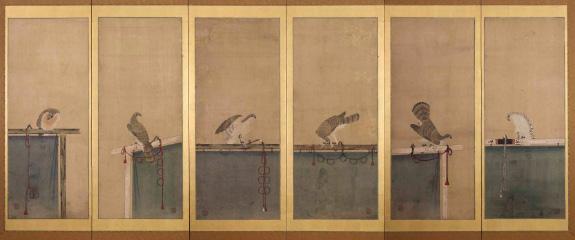

315
TSURUSAWA TANSAKU: A SUPERB PAIR OF KANO SCHOOL SIX-PANEL FOLDING SCREENS DEPICTING DRAGONS AMONG CLOUDS
By Tsurusawa Tansaku (1729-1797), each signed Hogen Tansaku hitsu with seal Japan, 18th century, Edo period (1615-1868)
Ink and gold paint on paper. Each mounted on six lacquered wood panels with metal fittings. Finely painted to depict dragons emerging amid swirling clouds and turbulent waves. The compositions stretch dynamically across multiple panels, with bold
curving lines conveying the motion of wind and water, with the dragons’ sinuous bodies appearing and disappearing among the mist.
Inscriptions: To each screen, signed Hogen Tansaku hitsu 法眼 探 山 筆 [made by Hogen (an honorary title) Tansaku].
Image SIZE 154.5 x 341.9 cm (each)
Condition: Overall good, worn condition. Some soiling, few stains, and flaking to pigment. Small losses with associated repairs and touchups, all as visible in the images provided. The back with signs of wear and use.


Tsurusawa Tansaku (1729–1797) was the third-generation head of the Tsurusawa school of painting, a distinguished branch of the Kano school. He was the son of Tsurusawa Tangei (1687–1769), which placed him firmly within the illustrious artistic lineage of Kano Tan’yū, whom his grandfather had apprenticed under. Over the course of his career, Tansaku upheld and enriched the stylistic traditions of the Kano school while establishing the Tsurusawa line as a respected offshoot in its own right. In recognition of his artistic achievements and stature, he was awarded the honorary title of oōgen, a distinction that signified both official acknowledgment and exceptional accomplishment within the cultural hierarchy of his time.
MUSEUM COMPARISON
For the widely popular prototype by Chen Rong (circa 1200 – 1266) which inspired the present panels and dictated representation of dragons in later Japanese and Chinese schools, see the Museum of Fine Arts, Boston, accession number 17.1697. Note the similar style, horizontal orientation of the composition, and the depiction of dragons soaring amidst clouds, mists, whirlpools, and rocky mountains.
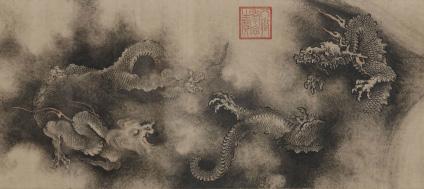
AUCTION COMPARISON
Compare a hanging scroll depicting a dragon in clouds, by Sesson Shukei (circa 1492-1577), at Bonhams, Japanese and Korean Art, 21 September 2022, New York, lot 583 (sold for USD 20,400, or approx. EUR 20,000 converted and adjusted for inflation at the time of writing). Compare a related later pair of sixpanel screens depicting a dragon, clouds, and waves, by Morimura Yoshine (1871-1938), at Christie’s, Japanese and Korean Art, 16 March 2021, New York, lot 6 (sold for USD 25,000, or approx. EUR 26,000 converted and adjusted for inflation at the time of writing).
Estimate EUR 10,000
Starting price EUR 5,000



316
AN IMPRESSIVE KANO SCHOOL SIX-PANEL BYOBU (FOLDING SCREEN) DEPICTING A TIGER WITH OFFSPRING AND DRAGON
Japan, late 19th century, Meiji period (1868-1912)
Ink and watercolors on paper. Mounted on six lacquered wood panels. Finely painted to depict a tiger standing foursquare on a cliff overlooking crashing waves, the feline’s head turned back as it growls at a dragon soaring high above. A pair of tiger cubs stand close to their protective parent, imitating its menacing demeanor as they engage in a playful tussle.
Inscriptions: To the left panel, inscribed and sealed Do Toshitatsu 堂 暁龍 [At Dawn and a Dragon] and with two seals, one reading Chiko Nanzan 知己 南山
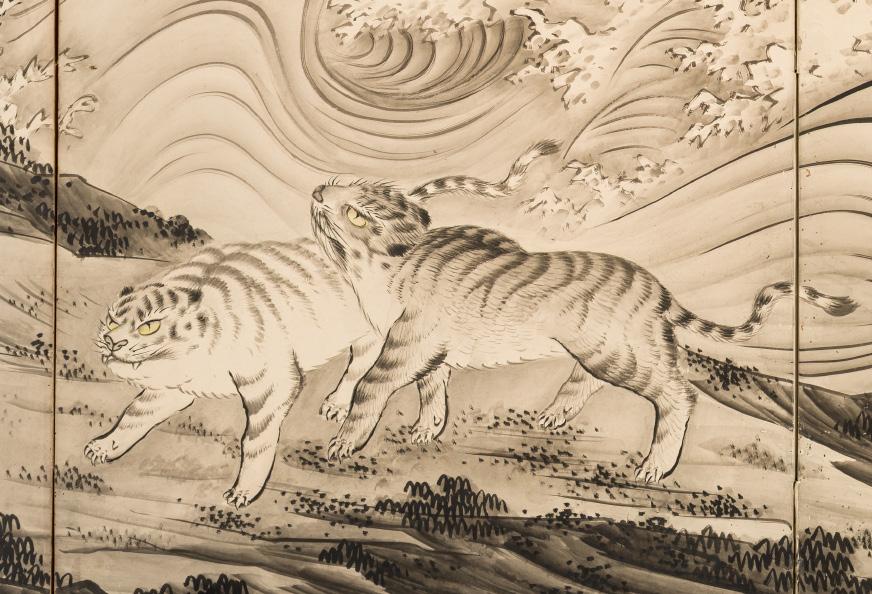
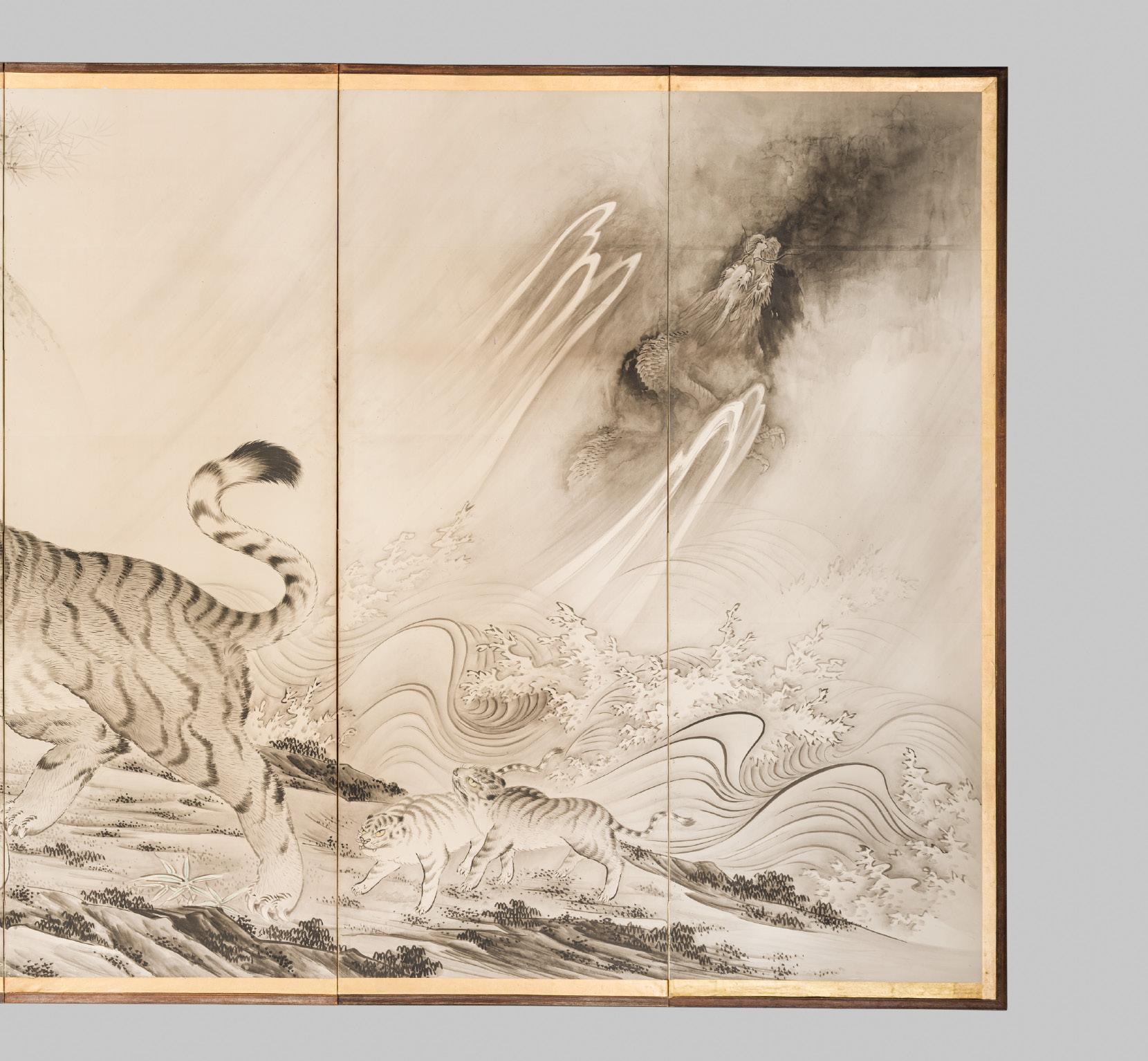
SIZE 170.7 x 368 cm
Condition: Excellent condition with wear and minor flaking to pigment. Small tears and losses near the joints. The back with traces of wear and use. The joints partially reinforced.
Tiger and dragon are Chinese cosmological symbols of the balancing forces in the world, yin (the feminine aspect) and yang (the masculine aspect). The tiger’s roar is also said to generate wind, and the dragon clouds. The screens may have originally been meant to express the fluctuating nature of the world as envisioned in the practice of military divination, or forecasting, based on the Yijing (Book of Changes).
Estimate EUR 15,000 Starting price EUR 7,500

AUCTION COMPARISON
Compare a closely related Kano school six-panel ‘tiger and dragon’ byobu screen, 18th century, at Zacke, Fine Japanese Art, 14 June 2024, Vienna, lot 303 (sold for EUR 23,400).
A TWO-PANEL BYOBU (FOLDING SCREEN) DEPICTING A TANUKI BY MOONLIGHT
Japan, 18th-19th century, Edo period (1615-1868)
Ink and silver on paper, mounted on a silk brocade frame finely decorated with flowerheads and leafy scrolling vines, set within two black-lacquered wood panels with chased metal fittings. Finely painted to depict a tanuki sitting amidst a field of susuki grass, interrupting his belly-drumming session as he notices the full moon above, still partly shrouded in the mist.
SIZE 143.5 x 119.6 cm (with frame) and 125.4 x 102.2 cm (image)
Condition: Good condition with some wear and traces of use, minor soiling, few small tears, minuscule losses, the right panel with a larger tear that has been stabilized.
The tanuki possess magical powers and can change forms, sometimes into Buddhist monks; they are jovial, but also dangerous, as they have been known to suffocate hunters with their enormous scrotums. The act of drumming on the belly, according to legend, was used by tanuki to beguile travelers and hunters to lead them astray. However, it has also been said that tanuki would get together just for fun, drumming on their bellies under the moonlight, perhaps even with some sake involved.
Estimate EUR 4,000
Starting price EUR 2,000




318
OYA SHUNREI: WEASEL IN A PLANTED FIELD
By Oya Shunrei (1892-1967), signed Shunrei with seals Nishio and Shunrei
Japan, early to mid-20th century, Taisho to early Showa period (1912-1945)
Ink, watercolors, gouache, and gold wash on silk. Mounted on silk brocade on lacquered wood panels with metal fittings. The scene depicts a small weasel darting through dense, golden wheat fields, their movement suggested through layered washes of ochre and green.
Inscriptions: To the lower right, Shunrei 峻嶺 with seals Nishio 西 尾 and Shunrei 峻嶺
SIZE 135 x 146 cm
Provenance: With Erik Thomsen Gallery, New York. A private collection, acquired from the above in 2017. A copy of the invoice, dated 27 October 2017, accompanies this lot.
Condition: Excellent condition with minor wear. Few minor stains and minor wear to the frame as is to be expected.
Oya Shunrei (1892–1967) was born in present-day Minokamo, Gifu Prefecture, and became a prominent painter associated with the Nihon-ga tradition. At nineteen he moved to Kyoto, where he studied under Miki Suizan (1883–1957) and later with Takeuchi Seiho (1864–1942), one of the leading exponents of modern Nihonga. Shunrei was a regular participant in the Teiten (Imperial Art Exhibition) during the Taisho and early Showa periods.
Estimate EUR 6,000
Starting price EUR 3,000
This work exemplifies the cross-cultural dialogue between Japanese art and European modernism. PostImpressionist artists such as Vincent van Gogh drew inspiration from Japanese ukiyo-e prints, adopting their flattened perspective and bold color harmonies. In turn, Japanese painters like Shunrei absorbed elements of Impressionism and Post-Impressionism into Nihon-ga. Here, the vast expanse of the wheat field recalls Van Gogh’s celebrated series of Wheat Fields. As in those works, the figure - a weasel in Shunrei’s case - anchors the composition yet is visually diminished by the overwhelming presence of nature. The result is a poetic meditation on the relationship between life’s fleeting motion and the enduring cycles of the natural world.
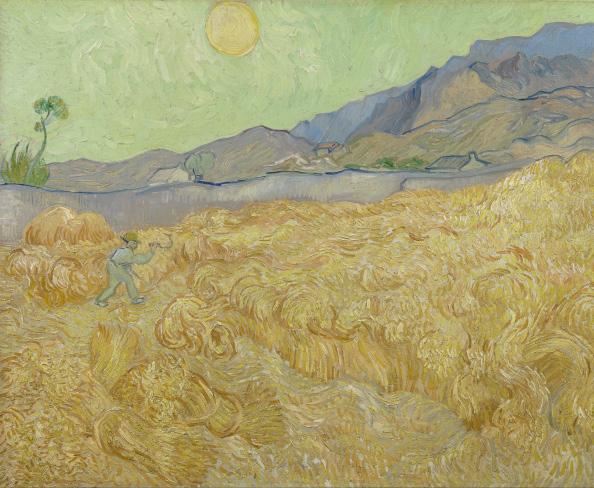
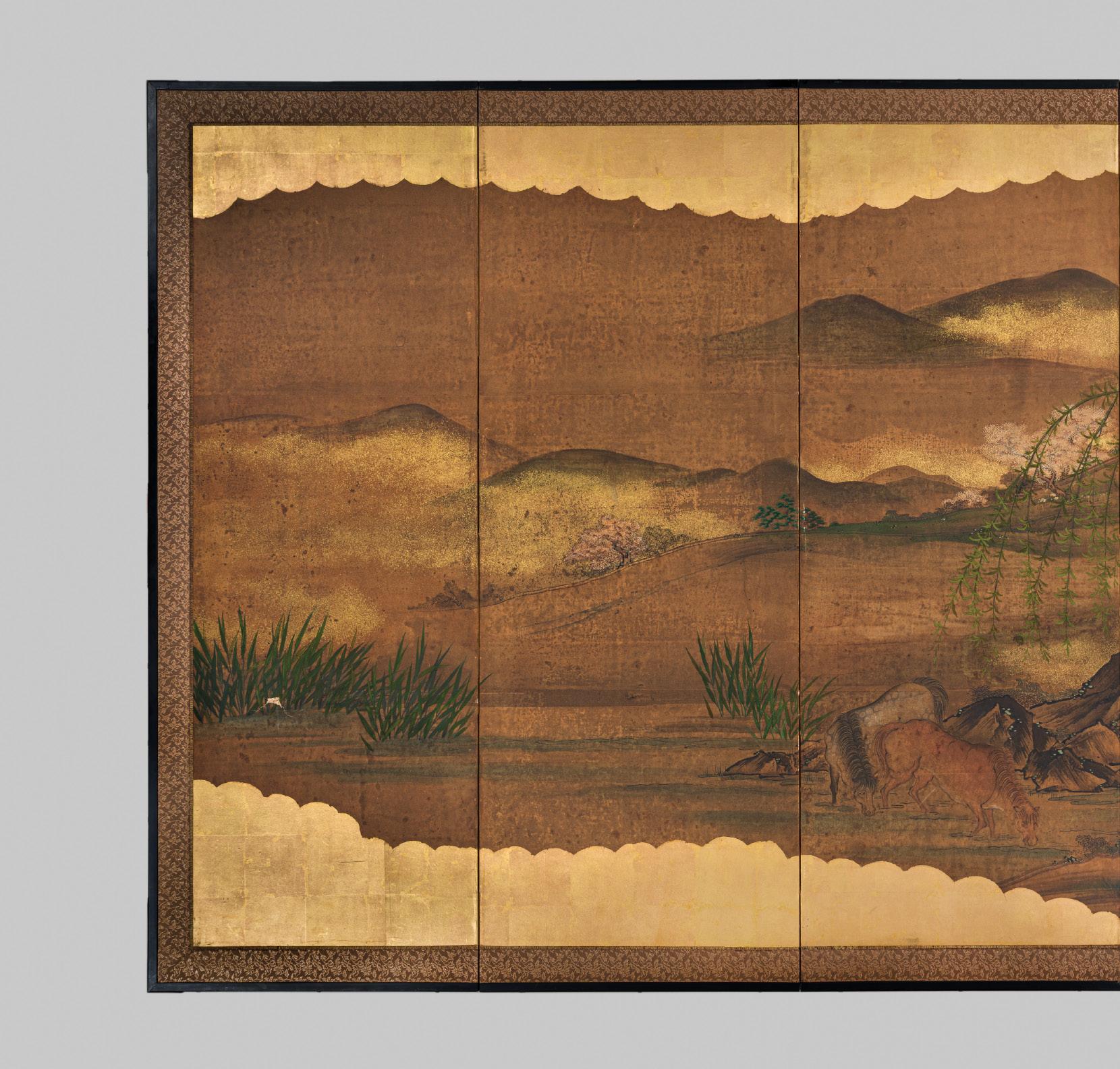
A KANO SCHOOL SIX-PANEL BYOBU (FOLDING SCREEN) DEPICTING GRAZING HORSES IN A LANDSCAPE
Japan, 18th century, Edo period (1615-1868)
Ink, watercolors, gold, and gold leaf on paper. Mounted on silk brocade on six wood panels. Superbly painted with a mountainous landscape dotted with rolling hills, a herd of grazing horses pictured under a wisteria tree, some drinking water in the shallow river nearby, while others rest under the shade of the vibrant blossoms, all enclosed by scrolling clouds in gold.
SIZE 172 x 367 cm
Condition: Very good condition with minor wear and vibrant colors. Some soiling and flaking to pigment. One small tear. The back with traces of wear and use.
The present screen features pasturing horses, a fine example of fuzokuga (genre painting) which gained popularity during the tumultuous sixteenth century. The panoramic landscape with rolling hills creates a jewel-like setting for the gamboling horses as they run, jump, and roll on the ground.
Horses were especially valued during the late Muromachi and Momoyama periods due to the numerous military campaigns that required swift deployment of troops. The demand for depictions of prized steeds frolicking in a landscape, instigated by the newly powerful warrior class who sought to celebrate
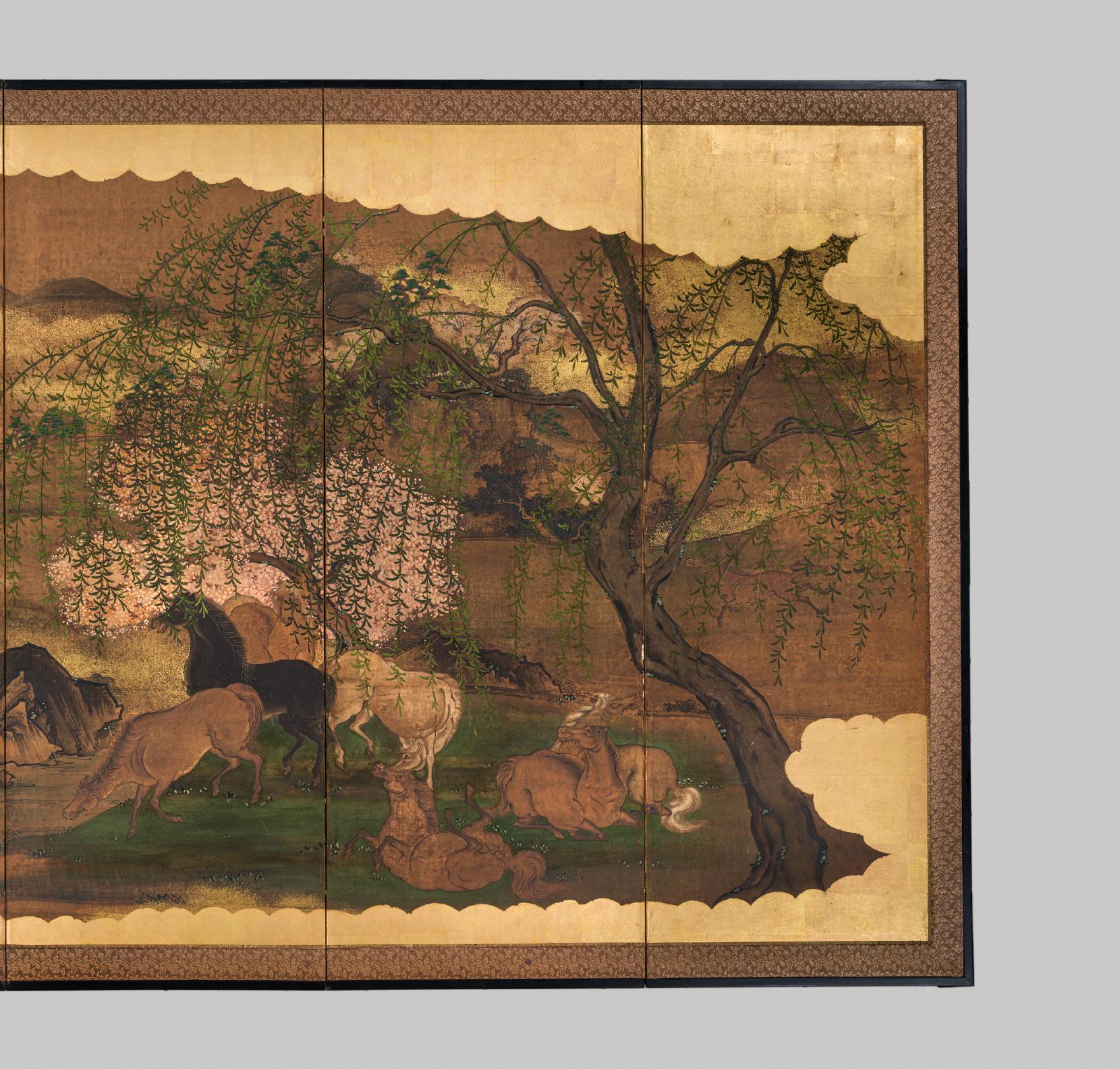
their way of life, is evident in the extant screens of horses by the various ateliers catering to high-ranking military. Not limited to the better known works of the Unkoku and Hasegawa schools, mastery in the depiction of horses is illustrated by a number of extant examples by Kano artists, such as Kano Motonobu (1476-1559; ema at the Komori Shrine in Tamba-cho, Kyoto) and Kano Hideyori (d.c.1576-7; ema at the Kamo Shrine in Hasumi, Shimane Prefecture).
The Kano school of painters, an artistic group composed of Kano male relatives as well as talented students who were granted the family name. The Kano school provided paintings for temples and palaces in Japan’s capital cities for generations. The artists prided themselves on their knowledge of Chinese painting styles, which they adapted for Japanese tastes.
AUCTION COMPARISON
Compare a related screen with similarly painted horses, Hasegawa school, dated to the 17th-18th century, at Zacke, Fine Japanese Art, 3 December 2021, Vienna, lot 294 (sold for EUR 7,584).

Estimate EUR 6,000
Starting price EUR 3,000

320
A SUPERB KANO SCHOOL
SIX-PANEL BYOBU (FOLDING SCREEN)
DEPICTING CRANES AND PINE
Japan, 17th-18th century, Edo period (1615-1868)
Ink, watercolors, gouache, gold paint, and gold leaf on paper.
Mounted on silk brocade on six wood panels with copper fittings. Finely painted with tanchozuru (red-crowned cranes) and whitenaped cranes standing and preening themselves by a river with wild flowers growing on either side, under the shade of a large pine, and dotted with large gnarled rocks. The scene is partially shrouded by dense clouds in gold.
SIZE 136.5 x 285 cm
Provenance: The private collection of Meri Green, Wilmington, Delaware, USA.
Condition: Very good condition with old wear. Some soiling and expected flaking to pigment. Few tears and small losses with associated repairs and touchups. The back with signs of wear and use.
The Kano school of painters, an artistic group composed of Kano male relatives as well as talented students who were granted the family name. The Kano school provided paintings for temples and palaces in Japan’s capital cities for generations. The artists prided themselves on their knowledge of Chinese painting styles, which they adapted for Japanese tastes.

MUSEUM COMPARISON
Compare a closely related pair of six panel byobu depicting pine, bamboo, plum, crane, and turtles, by Kano Sansetsu, 17th century, in the Larry Ellison Collection, and exhibited in the Asian Art Museum, San Francisco, In the Moment: Japanese Art from the Larry Ellison Collection, 28 June – 22 September 2013. Compare a closely related pair of six-panel byobu depicting birds and flowers of the four seasons, dated to the late 16th century, in the Metropolitan Museum of Art, object number 1987.342.1, .2.


AUCTION COMPARISON
Compare a closely related six panel byobu depicting cranes and chicks among pine, dated to the 18th century, size 170.7 x 61.7 cm, at Sotheby’s, Japanese Works of Art from Private Collections, 5 October 2023, lot 2 (sold for GBP 10,795 or approx. EUR 13,500 converted and adjusted for inflation at the time of writing).

Estimate EUR 6,000
Starting price EUR 3,000
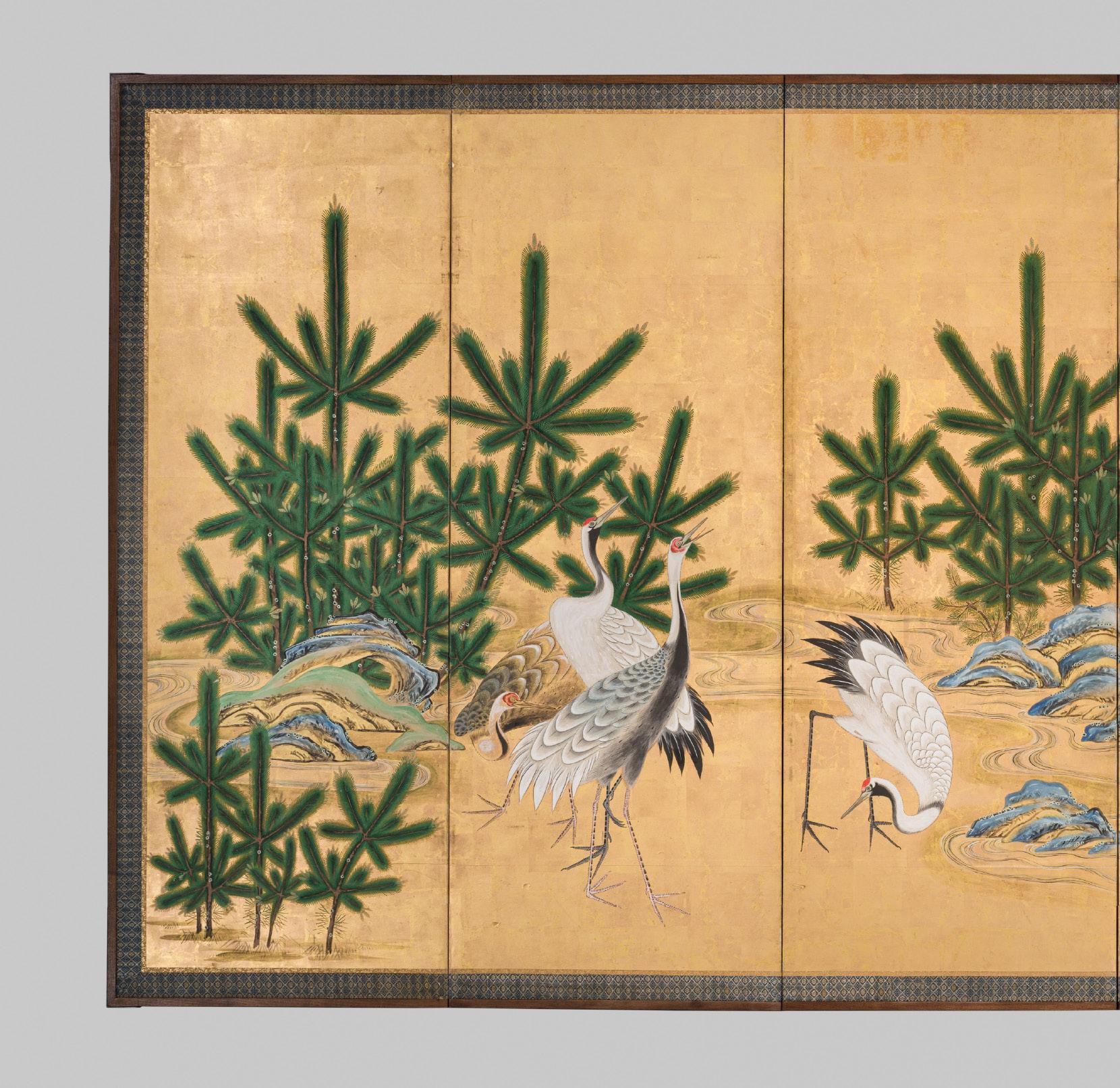
A FINE SIX-PANEL BYOBU (FOLDING SCREEN)
DEPICTING CRANES AND PINE
Japan, 18th-19th century, Edo period (1615-1868)
Ink, watercolors, gouache, and gold leaf on paper. Mounted on silk brocade on six wood panels with metal fittings. Finely painted with tanchozuru (red-crowned cranes) and white-naped cranes standing and preening themselves by a brook, young pines growing on either side of the gushing stream dotted with large rocks.
SIZE 171 x 364 cm
Condition: Very good condition with minor wear. Some soiling and expected flaking to pigment. Minuscule losses with associated repairs and touchups. The back with signs of wear and use.

The crane is one of the most prominent symbols of longevity and good fortune in Asia. They are believed to have a long lifespan and to traverse between heaven and earth. In turn, these attributes have made them logical companions of sennin, the Taoist Immortals. The red-crowned or Japanese crane depicted on this screen is said to live for 1,000 years.
Pine is an auspicious symbol in Japan, representing longevity due to its long life, and endurance as it remains green throughout the winter months. The pine trees depicted in this painting introduce a freshness and liveliness which complements the spirited movements of the cranes.
Compare a related six-fold screen with cranes and pine, 18th century, at Christie’s, Refined Beauty: Japanese Art of the Edo Period, 28 July 2015, London, lot 1 (sold for GBP 12,500 or approx. EUR 23,000 converted and adjusted for inflation at the time of writing).
Estimate EUR 4,000
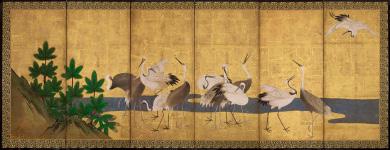
Starting price EUR 2,000




322
A PAIR OF KANO SCHOOL SIX-PANEL BYOBU (FOLDING SCREEN) DEPICTING TWO BATTLES FROM THE GENPEI WAR: ICHINOTANI AND YASHIMA
Japan, 17th-18th century, Edo period (1615-1868)
Ink, watercolors, gouache, gold paint, and gold leaf on paper. Each mounted on silk brocade on roiro lacquered wood panels with gilt-metal fittings. These screens depict battles fought at the height of civil wars between two rival clans, the Minamoto and the Taira, during the late 12th century.
SIZE 170.5 x 364 cm (each)
Condition: Good condition with old wear. Some soiling, few stains, and expected flaking and rubbing to pigment with associated touchups. Small losses with associated repairs. The back with signs of wear and use. Tears and losses to the backs with associated repairs.
The loyalty, courage, and martial skills of the samurai are shown in loving detail on this action-packed pair of screens. The battles of Ichinotani (on the right screen) and Yashima (on the left) took place in early 1185, at the end of the grueling five-year war between the Taira (also known as the Heike) and the Minamoto (or Genji). The Minamoto emerged victorious and their leader, Yoritomo, became the first shogun of a new military government. The battles were immortalized in the 13th-century historical novel, Tale of the Heike. The tale held special relevance in the 17th century when the concept of bushido, the way of the samurai, developed. Men recalled with romantic nostalgia their past fighting days and selfconsciously articulated an ideal code of conduct.

MUSEUM COMPARISON
Compare a closely related pair of six-panel byobu screens depicting Two Battles from the Genpei War: Ichinotani and Yashima, dated to the first half of the 17th century, size 153 × 348 cm, in the John C. Weber Collection, and exhibited in Metropolitan Museum of Art, Anxiety and Hope in Japanese Art, 8 April-14 July 2023.

AUCTION COMPARISON
Compare a closely related pair of six-panel byobu depicting the battle of Yashima and Ichinotani, dated 17th-18th century, size 163.5 x 360 cm, at Christie’s, Japanese and Korean Art, 24 March 2010, New York, lot 622 (sold for USD 23,750 or approx. EUR 30,500 converted and adjusted for inflation at the time of writing).
Estimate EUR 10,000
Starting price EUR 5,000
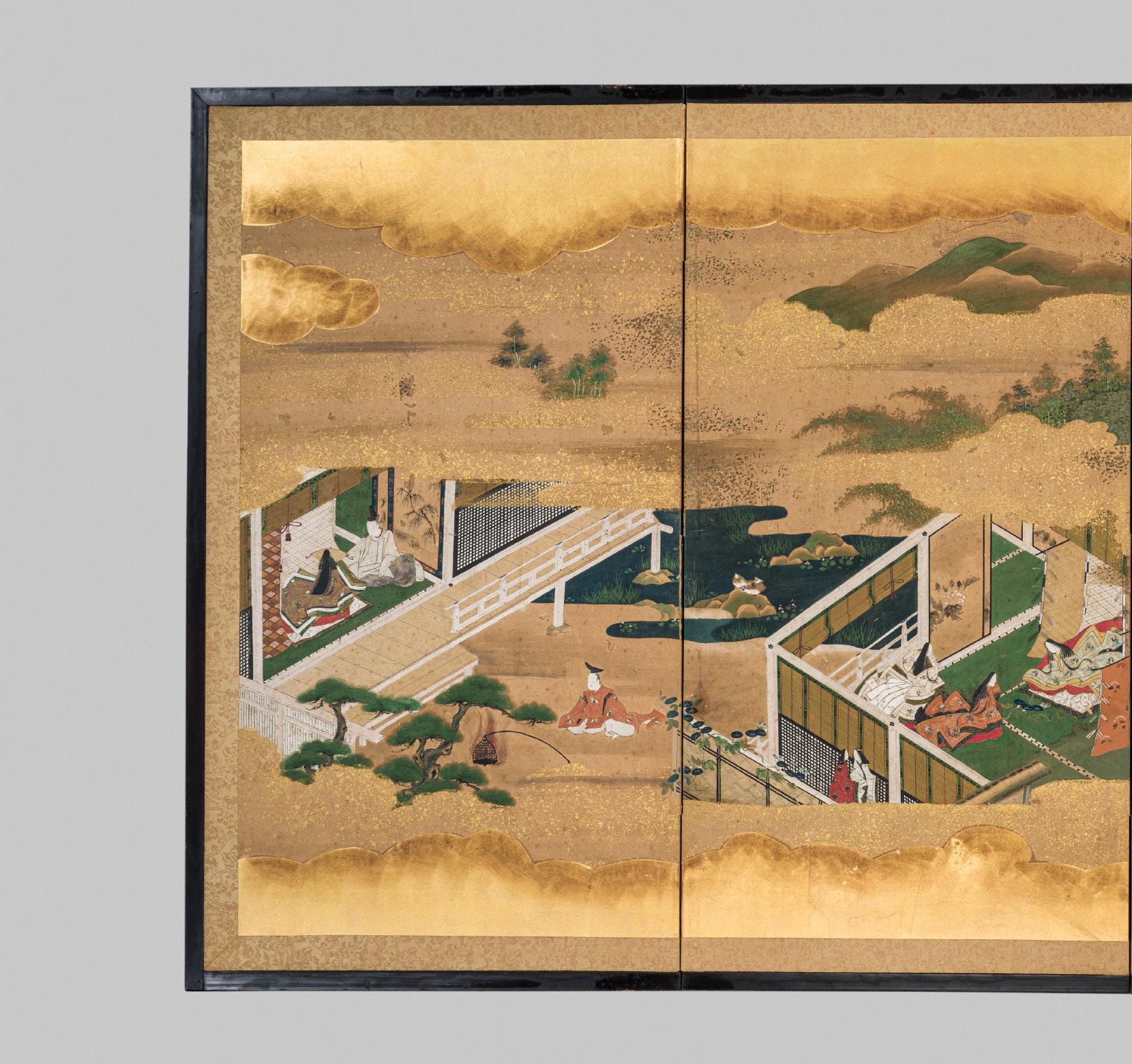
A FINE FOUR-PANEL BYOBU (FOLDING SCREEN) DEPICTING SCENES FROM THE TALE OF GENJI
Japan, 18th century, Edo period (1615-1868)
Ink, watercolor, gouache, gold paint, and gold leaf on paper. Mounted on silk brocade across four lacquered wood panels with finely chased and ring-punched metal fittings. Exquisitely painted with elegantly attired courtiers within refined palace interiors, opening onto serene garden settings with blossoming trees and distant mountains, all framed by sweeping clouds of gilt above and below.
SIZE 79.2 x 164.6 cm
Condition: Good condition with minor wear. Few stains, light nicks, and minor flaking to pigment with associated touchups. The back with usual traces of wear and use.
The Tale of Genji captures the refined aesthetics of Heian court life, where aristocrats valued seasonal beauty and poetic sensitivity as measures of character and status. This screen painting reflects that world, with figures seated in a palace interior - partially opened to the landscape - contemplating flowering trees that echo the novel’s recurring themes of impermanence and longing. Just as in Genji, the architectural openness blurs the boundary between human emotion and the natural world, making nature a silent participant in the story of love and courtly life.
Estimate EUR 4,000
Starting price EUR 2,000
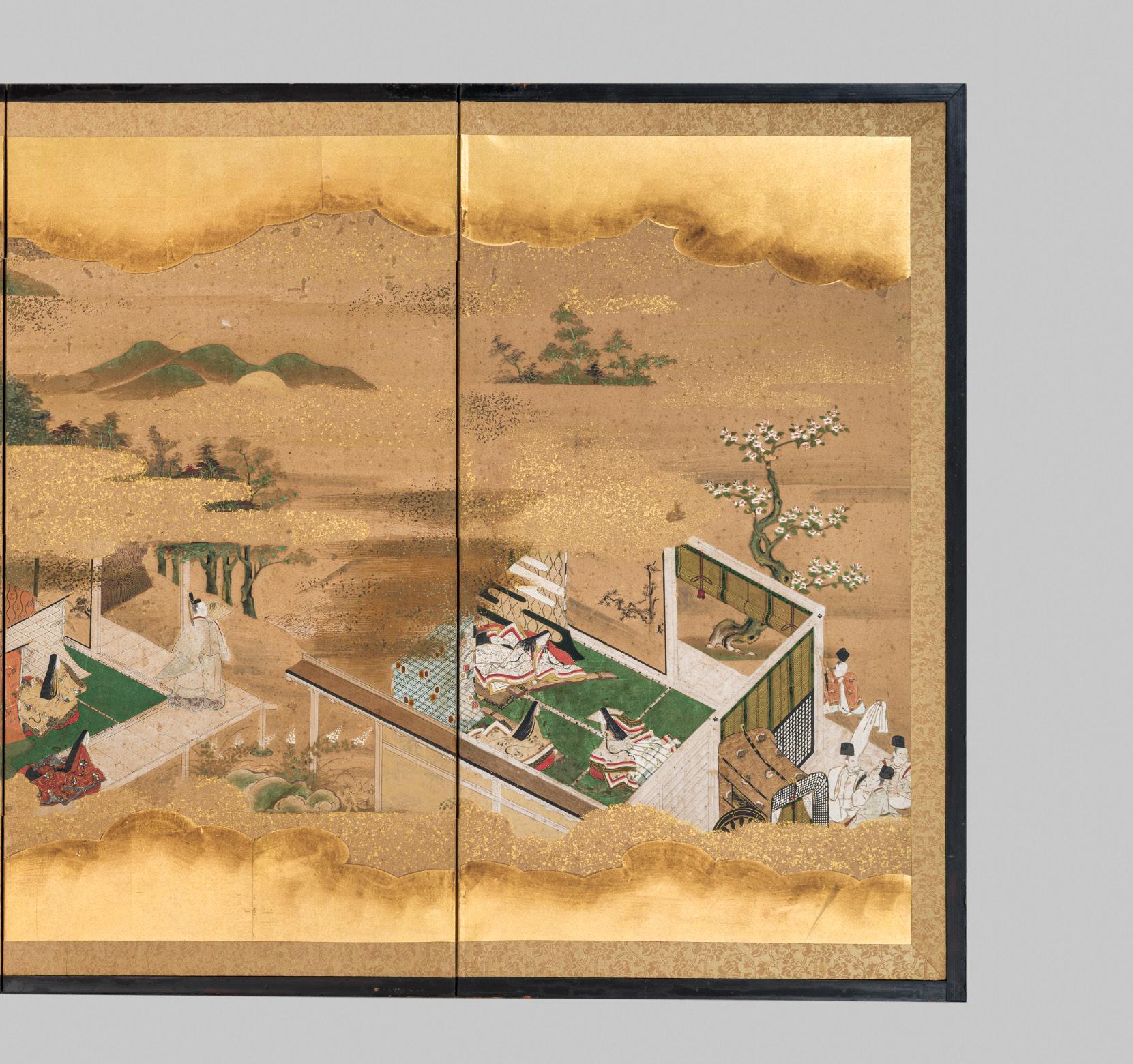
Compare a related pair of six-fold screens depicting scenes from the Tale of Genji, Edo period, dated 17th-18th century, size 94 x 270 cm, at Christie’s, Japanese and Korean Art, 23 March 2000, New York, lot 177 (sold for USD 29,900 or approx. EUR 48,000 converted and adjusted for inflation at the time of writing).
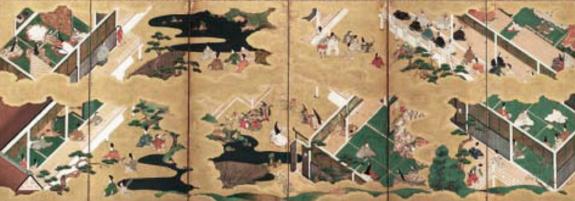
Compare a related pair of six-fold screens depicting scenes from the Tale of Genji, dated 19th century, size 151 x 362.8 cm, at Christie’s, Japanese and Korean Art, 23 March 2000, New York, lot 175 (sold for USD 23,000 or approx. EUR 37,000 converted and adjusted for inflation at the time of writing).
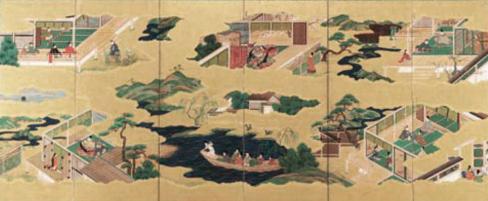

324
A FINE KANBUN-STYLE TWO-PANEL BYOBU (FOLDING SCREEN) DEPICTING MUSICIANS AND BIJIN
Japan, 18th century, Edo period (1615-1868)
Ink, watercolors, gouache, gold paint, and gold foil on paper. Mounted on two lacquered wood panels. Finely painted to depict a group of elegantly attired beauties, standing gracefully and accompanied by female musicians, one of whom is seated on a folding stool, each rendered in the manner associated with ukiyo-e paintings of the Kanbun era (1661-1673).
SIZE 158.5 x 188 cm
Provenance: With Adalbert Offermann Hans-Martin Schmitz: Alte Kunst aus China und Japan, Wuppertal, Germany. A private collection in South Germany, acquired from the above in 1975. A copy of an invoice from Adalbert Offermann Hans-Martin Schmitz: Alte Kunst aus China und Japan, Wuppertal, dated 2 November 1975, confirming the dating, and stating a purchase price for the present lot of DEM 8,500 or approx. EUR 14,000 (converted and adjusted for inflation at the time of writing), accompanies the lot. Adalbert Offermann, together with Hans-Martin Schmitz, founded the art gallery Alte Kunst aus Japan und China in 1964. In their youth, the partners shared a profound passion for East Asian art, which evolved into their profession and established them among the foremost dealers of non-European art in Germany. Initially specializing in Asian arms, the gallery later expanded its focus to encompass a wider range of Chinese and Japanese decorative arts, concentrating on netsuke, inro, woodblock prints, and paintings.
Condition: Very good condition with wear. Some soiling, minor stains, and scattered tears with associated repairs. Typical flaking and losses to pigment with touchups. The back with traces of wear and use.
During the 18th-19th centuries, Japanese artists often created byobu screens that consciously echoed earlier models from the Momoyama and early Edo periods. This tradition of copying was not mere replication but an act of homage, preservation, and reinterpretation. Painters adapted celebrated themes - landscapes, seasonal flowers, and courtly scenes - updating stylistic details to suit contemporary taste while maintaining continuity with the classical canon. Such works reveal both the enduring prestige of canonical prototypes and the role of replication as a form of transmission, ensuring that revered visual traditions remained visible within changing cultural contexts.
The present work, executed in the Kanbun bijin-ga style, must be seen in this context. Kanbun painting itself was a highly codified style that subsequent generations deliberately emulated, precisely because of its prestige as one of the earliest phases of ukiyo-e painting. Thus, the present screen is both a celebration and a conscious copy of the Kanbun manner, part of the broader cultural practice of safeguarding and transmitting revered visual traditions within the shifting fashions of the Edo period.
Compare a related two-panel byobu depicting Kanbun beauties, dated to the 19th century, size 117 x 150 cm, at Bonhams, Property from the Estate of Liza Hyde, 19 March 2009, New York, lot 190 (sold for USD 7,930 or approx. EUR 10,500 converted and adjusted for inflation at the time of writing).
Estimate EUR 5,000
Starting price EUR 2,400

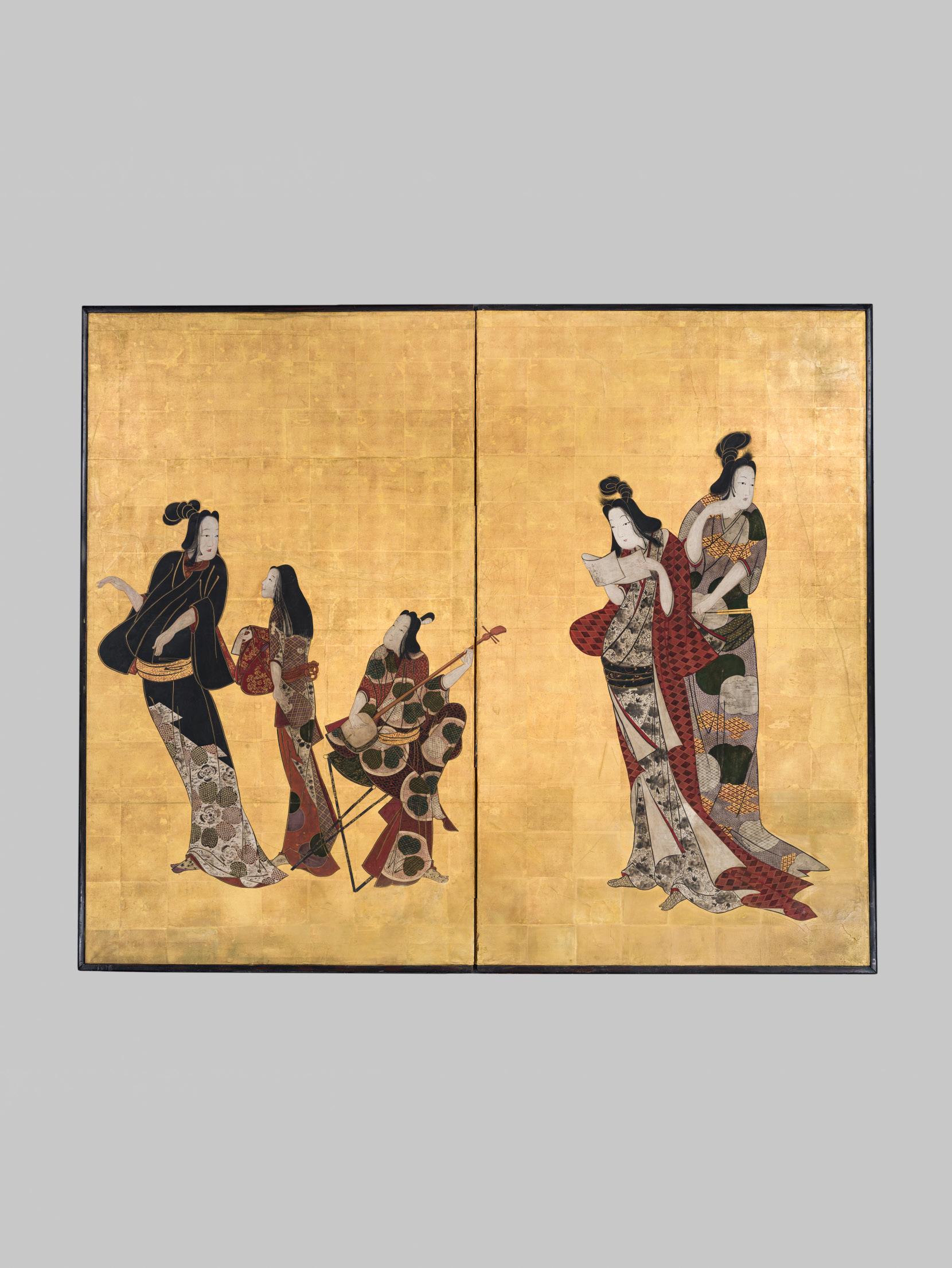

A PAIR OF TWO TWO-PANEL BYOBU (FOLDING SCREENS) DEPICTING SPRING AND AUTUMN FESTIVITIES
Japan, 19th century, late Edo period (1615-1868) to Meiji period (1868-1912)
Ink, watercolors, gouache, gold paint, and gold leaf on paper. Mounted on silk and set within lacquered wood frames.
Each screen finely painted with scenes of courtly leisure set against a lavish gold ground. The left screen depicts elegant figures celebrating the arrival of spring beneath blooming cherry trees during a hanami gathering. The blue-and-white striped enclosure curtain (jinmaku), decorated with the Soma family crest (mon), forms a decorative boundary for the noble assembly. The right

screen shows courtiers enjoying music, conversation, and sake beneath brilliant red maples, evoking the pleasures of autumn leaf viewing (momijigari).
SIZE 174 x 178 cm (each)
Condition: Excellent condition with minor wear. The back with traces of wear and use.
With a storage box.
The striped jinmaku (camp curtain) originated as a practical enclosure used in samurai military encampments to provide privacy and mark rank. By the late Edo and Meiji periods, however, the motif had entered broader artistic and ceremonial use. Curtains of this type appear in festival and theater settings as decorative partitions, signifying refinement and order rather than martial function.
Estimate EUR 3,000
Starting price EUR 1,500

326
MORI TAKAMASA: UKIFUNE (A BOAT CAST ADRIFT) FROM THE TALE OF GENJI
By Mori Takamasa (1791/2-1864), signed Gyokusen Koga hitsu and sealed Gyokusen Japan, 19th century, Edo period (1615-1868)
Ink, watercolors, gouache, and gold paint on silk. Mounted as a hanging scroll within a silk brocade frame with wood jikusaki (roller ends). Superbly painted to depict Prince Genji seated in a boat with a court lady, drifting across tranquil waters under the glow of a crescent moon. Genji, dressed in an elegant, patterned robe and black cap, gazes toward the mist-shrouded hills and shoreline, while his companion, robed in flowing layered garments, turns slightly. A pine tree bends from the bank.
Inscriptions: To the middle left, signed Gyokusen Koga hitsu 玉 泉 古賀 筆i [made by Gyokusen Koga] and sealed Gyokusen 玉泉 To the top of the tomobako, signed and inscribed, Genji Ukifune no zu, Mori Gyokusen ga with the seal Choseikaku 源氏浮舟之圖、 森玉僊画、印:長生閣 [painting of a scene in the Chapter Ukifune from the Tale of Genji, painted by Mori Gyokusen], and with a black square seal on the box lid Choseikaku 長生閣 [The Longevity Pavilion].
Image SIZE 60.3 x 63.8 cm, SIZE incl. mounting 143.8 x 80 cm
Provenance: The private collection of Alan and Simone Hartman, New York, acquired from the above.
Condition: Very good condition with minor wear. Some soiling, and few stains to the reverse. The mounting with usual traces of wear and use.
With a wood tomobako.
Mori Takamasa was born in Nagoya, and was a versatile artist, learning Kano school, Nanga, and Ukiyo-e style painting and print design. In the present lot we see the influence of his study of the Tosa school of Yamato-e. Before his study of Yamato-e, he was mainly known as Gyokusen, but took the name Takamasa (which can also be read as Koga) around 1835 when he began his association with the atelier of Tosa Mitsuzane (1780-1852).
This present lot captures a scene from the eponymous ‘Boat on the River’ chapter of the Genji Monogatari (The Tale of Genji), Murasaki Shikibu’s celebrated 11th-century courtly romance. Prince Genji is shown seated in a boat alongside a lady, drifting across tranquil waters beneath a crescent moon.
MUSEUM COMPARISON
Compare a related painting of Ukifune, by Tosa Mitsunobu, dated to 1509-1510, in the Arthur M. Sackler Museum, Harvard University, object number 1985.352.51.A.
Estimate EUR 2,500
Starting price EUR 1,200

Japan, 18th century, Edo period (1615-1868)
Ink, watercolors, gouache, and gold on paper. The young prince standing in an elegant pose, adorned in formal robes richly decorated with floral designs, and sporting the traditional chonmage hairstyle, characteristic of young Edo-period samurai, both his katana and wakizashi swords attached to his obi.
SIZE 90 x 26 cm (image) and 124.5 x 43.2 cm (incl. frame)
Condition: Very good condition with minor wear, few creases, some soiling, little fading, and minor loss to pigment.
Framed behind glass.
Prince Genji is a central character in the classic Japanese novel The Tale of Genji, written by Murasaki Shikibu around the year 1000. Often referred to as Shining Genji or Hikaru Genji, he is the son of a Japanese Emperor and a low-ranking concubine. Despite his noble birth, Genji is not in line for the Imperial throne due to his mother’s social status. Instead, he becomes a prominent figure at the Heian court, known for his exceptional beauty, intelligence, and numerous romantic affairs. The novel follows his life, exploring themes of love, loss, and the impermanence of human life.
The Tale of Genji is considered one of the world’s first novels and is often praised for its psychological depth and intricate portrayal of courtly life in 11th-century Japan.
For a woodblock print of Prince Genji in anachronistic Edo period garb and hairdo, from a parodic work entitled Genji Gojū yojō loosely translated “Modern Feelings” or more precisely translated “Lasting impressions of a later Genji collection”, see the British Museum, London, registration number 2012,3033.6.1-2.
Estimate EUR 1,500 Starting price EUR 800



328
KAIHO YUSHO: KINKO SENNIN RIDING A GIANT CARP
By Kaiho Yusho (1533-1615) signed with two seals Japan, 16th century, late Muromachi period (1333-1573) to early Momoyama period (1573-1615)
Ink and watercolor on paper, mounted on a silk brocade border and set within a vintage frame behind acrylic glass. The painting depicts the bearded Kinko Sennin seated upon the back of a large carp (koi). The Daoist immortal, robed in flowing garments with long, trailing sleeves, holds a scroll delicately in both hands. The carp, rendered with a wide, rounded eye and an arched body, glides dynamically through curling waves beneath.
Inscriptions: To the lower left, two seals, one reading Kaiho Yusho, 海北 友松
Image SIZE 121 x 50.5 cm, SIZE incl. mounting 138.2 x 67 cm
Provenance: From the Estate of Edith and Joel Frankel, New York, USA, and thence by descent in the family. E & J Frankel was a major New York gallery specializing in Asian Art since 1967. Condition: Old wear and browning to paper. Scattered soiling, few stains, small losses including wormholes, and some creasing and folds. The mounting and frame with usual traces of wear and age. Professional restoration is recommended.
Kaiho Yusho (1533-1615) was a painter of the Azuchi–Momoyama period. He was born in Omi province to Kaiho Tsunachika, who was a vassal of Azai Nagamasa. At an early age he became a page at the Tofuku-ji in Kyoto and later a lay priest. He served there under the abbot and associated with the leading Zen priests of Kyoto. In his forties, Yusho turned to painting and became a pupil in the Kano School, either under the famous Kano Motonobu or his grandson Kano Eitoku. He then worked at Jurakudai, under the patronage of Toyotomi Hideyoshi and the Emperor Go-Yozei. At first, he patterned his work after Song painter Liang Kai, producing only monochrome ink paintings, using a ‘reduced brush stroke,’ relying more on ink washes than sharp hard strokes. Later, he worked with fashionable rich colors and gold leaf. Artistically on a level with Hasegawa Tohaku and Kano Eitoku, he gave his name Kaiho to the style of painting he and his followers practiced.
AUCTION COMPARISON
Compare a closely related scroll painting of Kinko sennin, attributed to Kaiho Yusho and Karasuma Mitsuhiro, at Bonhams, The Ethereal Brush, 10 November 2016, London, lot 13 (estimated at GBP 20,000 or approx. EUR 33,000 converted and adjusted for inflation at the time of writing).
Estimate EUR 2,000
Starting price EUR 1,000
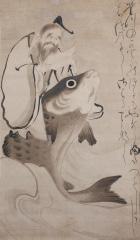

329 A FINE SUIBOKU-GA SCROLL PAINTING, ‘GIBBONS REACHING FOR THE MOON’S REFLECTION’
Japan, early Edo period (1615-1868)
Ink on silk. Mounted as a hanging scroll, on a silk brocade coated paper frame with red lacquered wooden handles. Depicting a lively scene with fifteen monkeys hanging off a cliff, their arms extended to form a chain, attempting in vain to fish the reflection of the moon in the water below.
Inscriptions: To the verso, inscribed ‘Enko ryu ga’ 猿猴 柳画 (‘Painting of monkeys and willow tree’).
Provenance: From an old French private collection. Condition: Very good condition with only minor wear and slight creasing. The brocade mounting with expected wear and traces of age.
Image SIZE 98 x 10 cm, SIZE incl. mounting 160 x 24 cm
A common theme in Zen paintings: monkeys trying to capture the moon’s reflection in water. The image derives from a Buddhist story in which five hundred monkeys hold on to each other’s tails and attempt to seize the reflection of a moon in a well; they fail when the branch from which they are hanging breaks. The monkeys stand for unenlightened people who cannot distinguish between reality and illusion.
Estimate EUR 3,000 Starting price EUR 1,500

330
By Kano Tsunenobu (1636-1713), signed Tsunenobu hitsu and sealed Ukon Japan, c. 1700, Edo period (1615-1868)
Ink on silk. Mounted as a hanging scroll within a silk brocade frame with antler jikusaki (roller ends). Depicting a tall bamboo stalk with articulated nodes, flanked by sprouting shoots and clusters of slender leaves extending outward.
Inscriptions: Signed to the lower-left Tsunenobu hitsu 常信筆 [made by Tsunenobu] and with a red seal Ukon 右近
Image SIZE 106.4 x 45.5 cm, SIZE incl. mounting 179.8 x 54 cm
Provenance: From an old and important private collection in Germany, assembled between 1950s-2007. Condition: Very good condition with minor wear. Few creases and folds, light soiling, and some foxing. The mounting with usual traces of wear and use.
MUSEUM COMPARISON
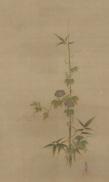

Compare a related scroll painting depicting morning glory and bamboo, by Kano Tsunenobu, dated to the mid17th to early 18th century, in the National Museum of Asian Art, Smithsonian Institute, accession number F1904.379a-c. Also compare a related painting with a tiger emerging from bamboo, signed Tsunenobu, dated to the early 18th century, in the Minneapolis Institute of Art, accession number 2012.1.1.
Estimate EUR 1,500
Starting price EUR 800
331

By Kano Joshin (Kano Shushin), signed Kano Shushin hitsu with seal Fujiwara Japan, 17th century, Edo period (1615-1868)
Ink and watercolors on silk. Each mounted as a hanging scroll within a silk brocade frame with ivory jikusaki (roller ends). Finely painted to the first scroll with two tigers growling at a dragon, one feline partially obscured by bamboo stalks, on the second scroll, the sinuous dragon soars high above crashing waves.
Inscriptions: Each scroll signed Kano Shushin hitsu 狩野集信筆 [Painted by Kano Shushin] with seal Fujiwara 藤原
Image SIZE 108.5 x 43 cm, SIZE incl. mounting 193 x 53 cm (each)
Condition: Very good condition with wear, some soiling, and browning. Some creasing and folds. Tiny tears and small losses with associated repairs. Overall presenting beautifully.

Kano Joshin (Kano Shushin) (d. 1697) was a native of Kozuke Province (modern Gunma Prefecture). He studied painting under the eighth-generation head of the Nakabashi branch of the Kano school, Kano Yasunobu, and took the name Hokyo Shushin, Shushin with the honorary title Hokkyo. He was employed by the Takamatsu Domain as an official painter. He is regarded as the founder of the Kano school in the Takamatsu Domain. He passed away in the 10th year of the Genroku era (1697).
AUCTION COMPARISON
Compare a related scroll painting depicting tiger and dragon, by Kano Sansetsu (15891651), size 131.1 x 58.4 cm, at Christie’s Japanese and Korean Art Including the Collection of David and Nayda Utterberg, 22 March 2022, New York, lot 25 (sold for USD 44,100 or approx. EUR 43,000 converted and adjusted for inflation at the time of writing).
Estimate EUR 2,000
Starting price EUR 1,000
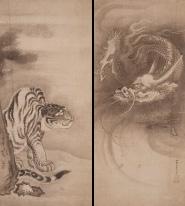
By Kishi Renzan (1805–1859), signed Renzan and Kishi no saku, each with seal Japan, 19th century, Edo period (1615-1868)
Ink on paper. Pair of hanging scrolls mounted in silk brocade with bone jikusaki (roller ends). The left scroll finely painted with a tiger, depicted as if fused with rock, brimming with predatory feline vitality. The tiger (tora), sovereign of the earthly realm, crouches upon an exposed cliff, its compact head and broad body exuding menace; the eyes gleam with slyness and attack-readiness, while the striped fur markings merge seamlessly into the rocky ground. The right scroll presents the celestial counterpart, the dragon (tatsu), emerging from surging vapors and wave-like clouds, executed in bold sweeping brushwork. The dragon’s head, adorned with backward-sweeping horns and barbels, is strikingly humanized with a yearning upward gaze. Both compositions reveal Renzan’s sensitive and vibrant brush, capable of dramatic condensation and expressive intensity.
Inscriptions: Left scroll signed Renzan 連山 with seal. Right scroll signed Kishi no saku 岸 之 作 with seal. The tomobako inscribed Renzan ryuko tsuifuku 蓮山 龍虎 対幅 [Pair of scrolls with Dragon and Tiger by Renzan].
Image SIZE (each) 103.7 × 27.7 cm SIZE incl. mounting (each) 182.5 × 41 cm
Provenance: From a German private collection, acquired at Galerie Zacke in 2018. Condition: Very good condition with some expected foxing throughout as visible in the catalog illustration. The painting has been professionally re-backed and the mounting restored. Presenting beautifully.
With a wood tomobako (storage box) inscribed to the cover.
The Kishi school of painters was founded by Kishi Ganku (1749–1838), a distinguished Japanese artist renowned for his vivid and powerful depictions of animals, particularly tigers and dragons. Ganku developed a distinctive style that integrated Chinese painting techniques with traditional Japanese esthetics, establishing a visual language that would define the school. Kishi Renzan (1805-1859) was the son-in-law and first pupil of Ganku.
AUCTION
COMPARISON
Compare a closely related pair of paintings by the same artist, also depicting dragon and tiger, each scroll measuring 96 x 30.9 cm, at Christie’s, Japanese Art and Design, 14 May 2008, London, lot 349 (sold for GBP 3,250 or approx. EUR 7,000 converted and adjusted for inflation at the time of writing).
Estimate EUR 2,000
Starting price EUR 1,000




By Mori Sosen (1747-1821), signed Sosen with seal Mori Morikata Japan, late 18th to early 19th century, Edo period (1615-1868)
Watercolors on silk. Mounted as a hanging scroll within a silk brocade frame with antler jikusaki (roller ends). Finely painted to depict a monkey carrying its young on its back. The parent strides forward with an alert yet calm expression, while the baby clings closely, gazing outward with curiosity.
Inscriptions: To the lower right, signed Sosen 狙仙 with a red seal Mori Morikata 杜 守象
Image SIZE 34.5 x 45.5 cm, SIZE incl. mounting 111 x 57 cm
Condition: The image is in good condition with few stains as visible in the catalog illustration. The mounting with stains, tears, repairs and losses.
AUCTION COMPARISON
Compare a closely related painting of a monkey, signed Sosen hitsu and sealed Zo, size 38.1 x 52.4 cm, at Christie’s, 27 September 2022, New York, lot 43 (sold for USD 6,930 or approx. EUR 6,500 converted and adjusted for inflation at the time of writing).
Estimate EUR 1,500
Starting price EUR 800


334 A FINE SCROLL PAINTING OF MONKEYS, ATTRIBUTED TO MORI SOSEN
Attributed to Mori Sosen (1747-1821), unsigned Japan, late 18th to early 19th century, Edo period (1615-1868)
Ink, watercolors, and gouache on silk. Mounted as a hanging scroll on a silk brocade frame with wood jikusaki (roller ends). Finely painted to depict monkeys gathered on and around a gnarled tree above a cascading waterfall, set within a mountainous landscape. Some of the monkeys climb along the branches, while others sit together in animated poses, their faces rendered with expressive detail.
Image SIZE 112.5 x 49 cm, SIZE incl. mounting 202 x 62 cm
Condition: The image is in excellent condition with only very minor wear, some light creasing to the top and a few tiny stains. The mounting with some typical wear, soiling and creasing, but still presenting very well.
Mori Sosen (1747-1821), the founder of the Mori painting School, was active in Osaka at the end of the Edo period and came to be known as the ‘Monkey Painter Sosen,’ and he is renowned even today for his monkey paintings. Like his contemporary Maruyama Okyo, Sosen created works based on sketches from life as is finely exemplified by the painting presented here, where the artist has beautifully captured the realism of the details of the animals’ soft fur in the refined delicacy of the brushstrokes.
AUCTION COMPARISON
Compare a related scroll painting of monkeys by a waterfall, by Mori Sosen, dated to the late 18th-early 19th century, image size 80 x 86.5 cm, at Zacke, Fine Japanese Art, 4 June 2021, Vienna, lot 265 (sold for EUR 15,168).
Estimate EUR 2,000
Starting price EUR 1,000



335
SHIBATA ZESHIN (1807-1891):
RUSU MOYO (ABSENT MOTIF) FOR
Japan, 19th century
Ink, watercolor, and gouache on silk. Mounted as a hanging scroll, on a silk brocade coated paper frame with wooden handles. Finely painted depicting a peaceful, autumnal scene of two monkeys hanging from the vine-clad branches of a pine tree, peering down towards a wasps’ nest, guarded by other wasps, two bats hovering around, a stag and a deer grazing beside a stream, abundant reishi fungi, grasses, and bamboo growing from behind rocks in the foreground.
Inscriptions: Signed, ‘Zeshin utsusu, 是真寫 (‘painted by Zeshin’), and sealed with a pot seal, ‘Zeshin’ 是真, and a square seal, ‘Koma’ 古満
Condition: Excellent condition with minor wear, very light creasing, and microscopic staining. The silk brocade shows minor wear and soiling.
Image SIZE 123.7 x 55 cm, SIZE incl. mounting 214.5 x 70 cm
With a fitted tomobako storage box.
The combination of a bat (fuku), stag (roku), and pine (ju) are not only symbolic motifs for prosperity and longevity but also make up the reading for Fukurokuju, the god of longevity, whose image is intentionally omitted from this painting.
Shibata Zeshin (1807-1891) was a Japanese painter and lacquer artist of the late Edo period and early Meiji era. He studied under the great artists of the Kyoto school, including Maruyama Okyo, Okamoto Toyohiko, and Goshin. Though he would later be known primarily for his work with lacquers, Zeshin excelled at traditional ink painting, and produced many works of traditional subjects such as tigers and waterfalls. He inherited the Koma School workshop after his old teacher, Koma Kansai, died in 1835. It was here that he experimented with the technical aspects of lacquer. Along with Nakayama Komin and Shirayama Shosai, he is considered one of the three great late lacquerers of Japan.

Shibata Zeshin (1807-1891)
Shibata Zeshin’s studio was situated on the bank of a river, providing him with ample opportunity to observe nature, and the creatures that inhabited the natural world. Like many painters of the 19th century, he was eclectic in his sources and would have been exposed to traditional styles. However, Zeshin’s skill level was such that he could fluidly mix techniques, ideas, and stylistic options, thus painting part of a composition in one manner and including elements of another to add a style and variety unheard of at the time.
Estimate EUR 10,000
Starting price EUR 5,000

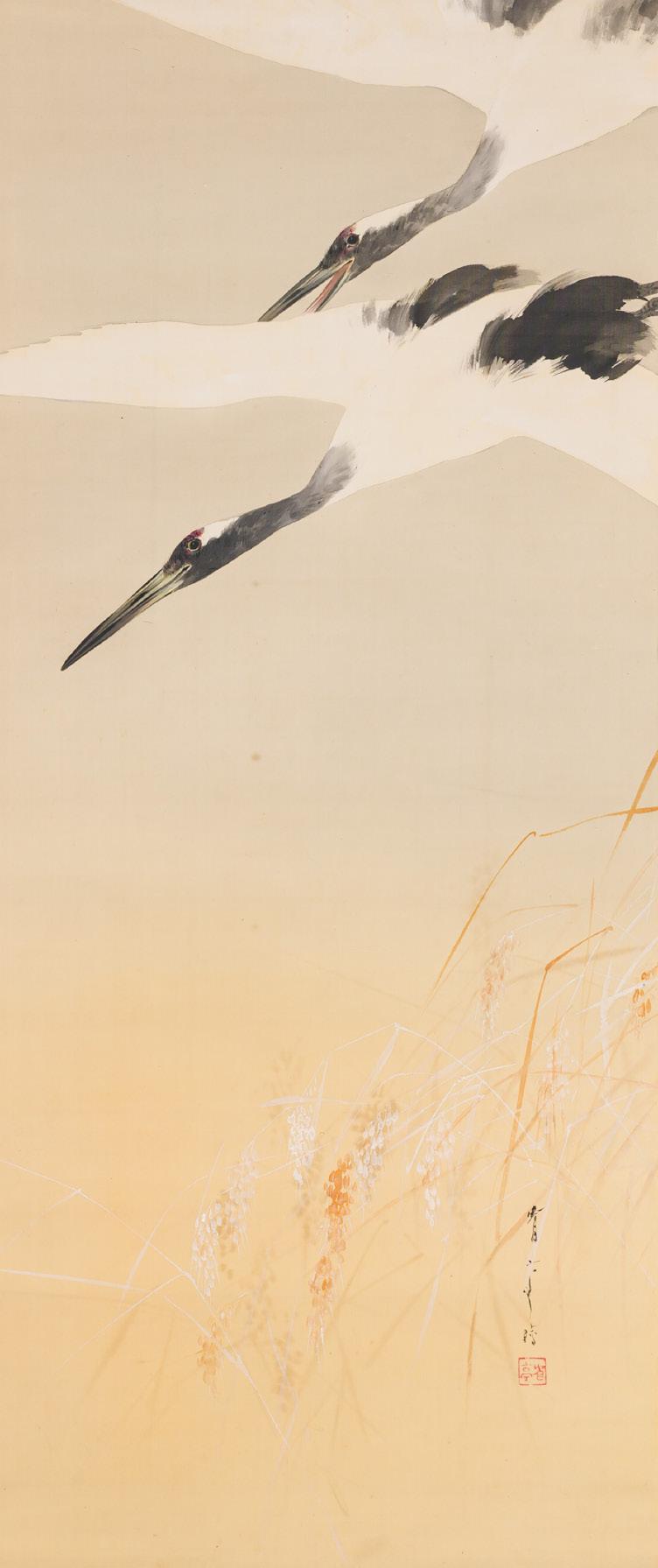
By Watanabe Seitei (1851-1918), signed Seitei e with seal Seitei Japan, late 19th to early 20th century, Meiji period (1868-1912)
Ink and watercolors on silk. Mounted as a hanging scroll within a silk brocade frame with wood jikusaki (roller ends). Finely painted to depict two cranes in mid-flight, their long necks outstretched and wings sweeping across the upper composition.
Inscriptions: To the bottom left, signed Seitei e 省亭 繪 [made by Seitei] with seal Seitei 省亭
Image SIZE 116.5 x 49.5 cm, SIZE incl. mounting 211 x 67.5 cm
Provenance: Christie’s, 4 July 2019, London, lot 36. A noted private collection, acquired from the above. Condition: Excellent condition with only very minor wear.
With an associated wood tomobako.
Watanabe Seitei (1851-1918) was a Nihonga painter and one of the first to visit Europe, attending the 1878 International Exhibition in Paris and being awarded a medal. Seitei blended Western realism with the delicate colors and washes of the Kikuchi Yosai school, introducing a new approach to kachoga (bird-and-flower painting). On his return from Europe, Seitei created designs for ceramics and cloisonné, working with the cloisonné artist Namikawa Sosuke (1847–1910), leading to acclaim from abroad.
AUCTION COMPARISON

Cloisonné vase by Namikawa Sosuke, after a design by Watanabe Seitei
Compare a related scroll painting depicting a June egret, painted in a similar manner, by Watanabe Seitei, total size 114.9 x 40.7 cm, at Christie’s, Japanese and Korean Art, 29 March 2005, New York, lot 263 (sold for USD 5,040 or approx. EUR 7,700 converted and adjusted for inflation at the time of writing).

Estimate EUR 4,000
Starting price EUR 2,000

By Kawanabe Kyosai (1831-1889), signed Shojo Kyosai hitsu Japan, late 19th century
Ink and watercolors on paper. Mounted as a hanging scroll within a silk brocade frame with wood jikusaki (roller ends). Expressively painted to depict a skeleton standing upright and gripping a sword at its waist, the weapon detailed with a finely patterned hilt and scabbard. In its left hand, the skeleton brandishes a severed human head, the face rendered with haunting realism, its hair hanging loose.
Inscriptions: To the lower right, signed Shojo Kyosai hitsu, 惺々暁 斎筆, [made by Shojo Kyosai]. To the reverse inscribed Shojo Kyosai Sensei no hitsu, Gaikotsu hosho namakuni no zu, 惺々暁斎先生之 筆、骸骨抱拿生首之図, [made by Master Shojo Kyosai, a skeleton holding a freshly severed head], and Dai nanjuku go, with the seal Kaijima, 第七十八號、第七拾九號, [Number 79, the seal Kaijima]. The seal Kajima likely refers to the important Kaijima Family, noted members being Kaijima Tasuke (1845-1916) and his brother Kaijima Yoshizo (1856-1935).
Kawanabe Kyosai (1831-1889) was a prolific Japanese artist from Koga Ishimachi, Shimousa Province, who studied at the Kano school. During the time of political unrest following the revolution of 1867, Kyosai attained a reputation as a caricaturist. He created what is considered to be the first manga magazine with Kanagaki Robun in 1874: Eshinbun Nipponchi. In addition to his caricatures, Kyosai painted many pictures and sketches, often choosing subjects from Japanese folklore. Timothy Clarke describes Kyosai as “an individualist and an independent, perhaps the last virtuoso in traditional Japanese painting.” His renown after his death culminated in the establishment of the Kawanabe Kyosai Memorial Museum, built in 1977, located at Warabi, Saitama Prefecture.

Kyosai, ca. 1880
Condition: Very good condition with wear, little staining, some foxing, and minor creasing and folds. The frame with usual traces of wear and use.
With a wood tomobako.


Compare a related scroll painting depicting the third princess of the Tale of Genji, by Kawanabe Kyosai, at Bonhams, Japanese and Korean Art, 21 September 2022, New York, lot 595 (sold for USD 31,875 or approx. EUR 29,500 converted and adjusted for inflation at the time of writing). Compare a related scroll painting depicting the Jigoku dayu [Hell Courtesan], by Kawanabe Kyosai, at Christie’s, Asobi: Ingenious Creativity Japanese Works of Art from Antiquity to Contemporary and Ceramic from the Collection of Bernard Leach, 15 October 2013, London, lot 56 (sold for GBP 578,500 or approx. EUR 1,080,000 converted and adjusted for inflation at the time of writing).
Estimate EUR 15,000
Starting price EUR 7,500

By Utagawa Kuniyoshi
(1797–1861), signed Kuniyoshi ga Japan, dated 1853
Color woodblock print on paper. Vertical oban triptych. Signed Kuniyoshi ga; publisher Yamaguchi Tobei. Title Tamatori-hime Ryugu no zu (Tamatori-hime at the Ryugu Palace).
In this dynamic composition, Princess Tamatori (also known as the ama diver Tamamo) grasps the sacred jewel while battling through surging waters. She moves toward the left edge of the triptych, knife raised in defense, casting a backward glance at the pursuing sea creatures armed with swords. Above, the enraged Dragon King, in the form of a four-clawed dragon, roils the sea in fury.
SIZE of the sheet 36.4 x 25.1 cm (each)
Condition: Good condition with wear, slight browning to paper, light foxing, light creasing, the central sheet with a central fold, and some rubbing along the edges. Beautiful impression with wellpreserved, vibrant colors.
This work illustrates the famous legend of Princess Tamatori. According to tradition, the Tang Emperor gifted a sacred jewel to Fujiwara no Kamatari (614–669). Lost at sea during its transport, the jewel sank to the Dragon King’s palace. To retrieve it, Kamatari’s son married the young ama diver Tamamo, who bravely undertook the descent. Pursued by the Dragon King and his retinue, Tamamo - revered in legend as Princess Tamatori - cut open her breast to hide the jewel. Though she succeeded in saving the treasure, she died from her wounds upon reaching the shore. Kuniyoshi captures her moment of desperate courage, jewel in hand, as she fights her way back to the surface.
Utagawa Kuniyoshi (1797–1861) was one of the last great masters of ukiyo-e. His work spanned a wide range of subjects: landscapes, bijin (beautiful women), Kabuki actors, cats, mythical creatures, and heroic samurai battles. His prints are represented in major museum collections worldwide, including the Metropolitan Museum of Art, Princeton University Art Museum, Walters Art Museum, Portland Art Museum, Seattle Art Museum, Brooklyn Museum, and the Van Gogh Museum.
AUCTION
COMPARISON
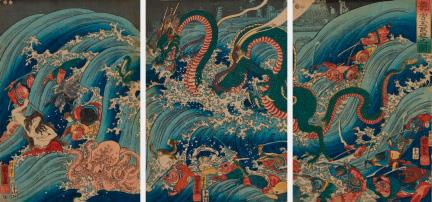
Compare the identical print at Christie’s, Japanese and Korean Art, 16 March 2021, New York, lot 185 (sold for USD 32,500 or approx. EUR 34,000 converted and adjusted for inflation at the time of writing).
Estimate EUR 15,000 Starting price EUR 7,500
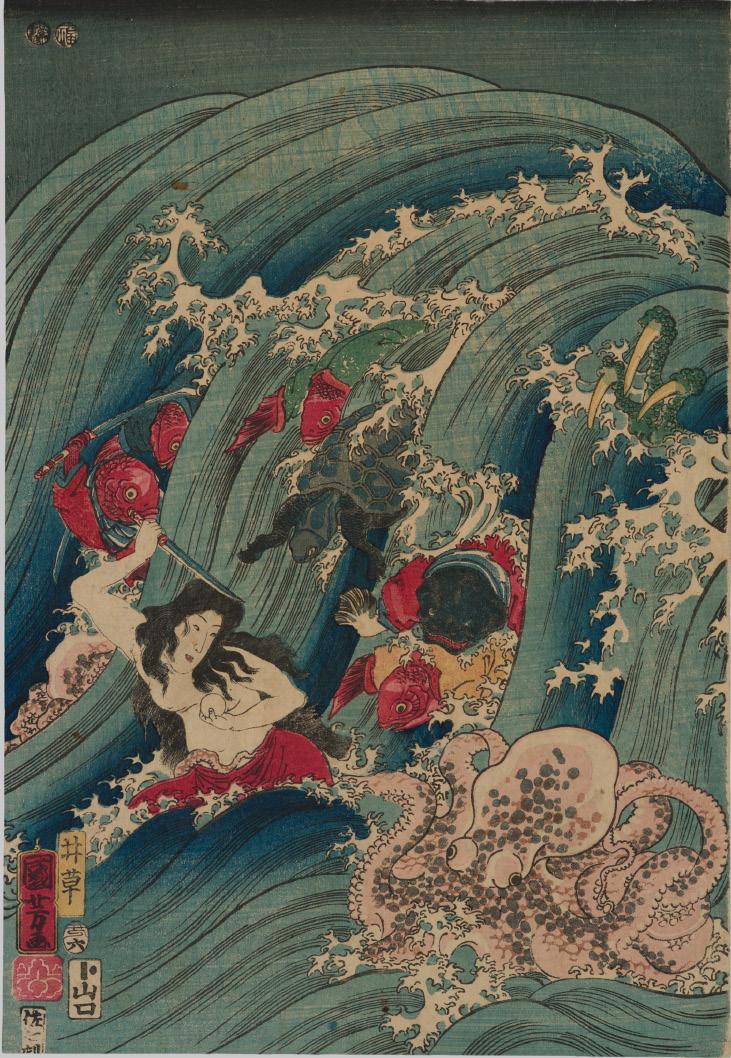

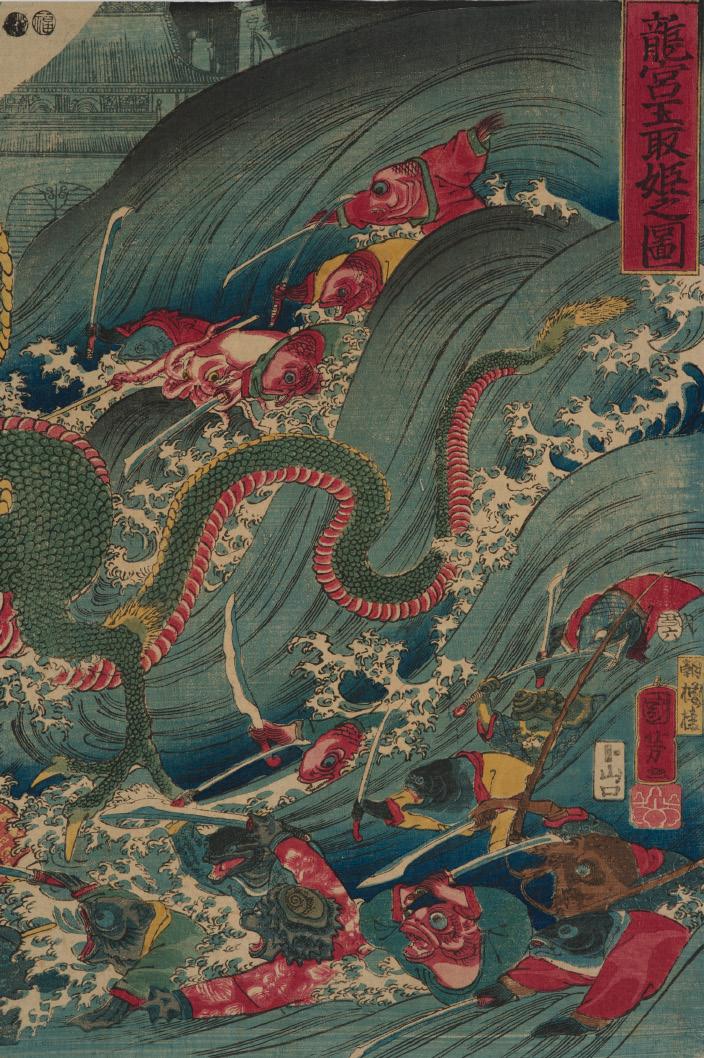
339
TSUKIOKA YOSHITOSHI:
By Tsukioka Yoshitoshi (1839-1892), signed Oju Ikkaisai Yoshitoshi ga (on the right sheet) and Ikkaisai Yoshitoshi ga (on the center and left sheets) Japan, dated 1869
Color woodblock print on paper. Vertical oban triptych. Signed Oju Ikkaisai Yoshitoshi ga (on the right sheet) and Ikkaisai Yoshitoshi ga (on the center and left sheets) with censor’s seal; publisher Masadaya Heikichi. Title Goketsu kijutsu kurabe (A Competition Among Powerful Magicians).
An extraordinary early triptych by Yoshitoshi, this dynamic composition stages a supernatural contest among master magicians. On the right, a warrior astride a winged beast battles a gigantic snake, its tongue darting menacingly from its gaping jaws. At the center, a monstrous cat (bakeneko) faces off against an enormous rat, a direct reference to the sorcerer Nikki Danjo. To the left, an elderly magician sits astride a colossal toad, while another unfurls a scroll beside two large tengu, one brandishing a sword.
SIZE of the sheet 35.9 x 24.2 cm (each)
Provenance: Collection of John A. Stevenson, thence by descent. John A. Stevenson has long been a well-established name within the study of Japanese art history, especially for his research and publications related to woodblock prints, particularly the artist Tsukioka Yoshitoshi. Born in the United Kingdom in 1944, John began his world-spanning career soon after graduation from Oxford University. He went first to Nigeria, then Hong Kong, afterwards residing in a variety of East Asian locales including Taiwan, Thailand, South Korea, Vietnam, and China. It was in the 1980s that he began publishing on the art of Yoshitoshi, including Yoshitoshi’s Thirty-six Ghosts (1983), Yoshitoshi’s Women (1986), and continuing into the 1990s with Yoshitoshi’s One Hundred Aspects of the Moon (1992). Beyond Yoshitoshi’s prints, he also published writings on contemporary Japanese paintings and prints, Vietnamese ceramics, and both Western and East Asian history. Condition: Very good condition with minor wear. Light creasing and minimal losses along the edges.
Tsukioka Yoshitoshi (1839-1892) was one of the leading woodblock print artists during the Meiji era (1868-1912) and one of the last to work in the traditional ukiyo-e manner. Born in Edo (present-day Tokyo), he showed a strong interest in classical Japanese literature and history. When he was eleven, he became a student at Kuniyoshi Utagawa’s studio. Under his teacher’s guidance, he showed exquisite draftsmanship skills and learned how to draw from life, something not necessarily part of the training of schools of painting and illustration in Japan.
MUSEUM COMPARISON

A closely related print by the same artist, with similar seals, is in the Los Angeles County Museum of Art (LACMA), accession number M.84.31.437a-c.
Estimate EUR 8,000
Starting price EUR 4,000


SELECTED WORKS BY TSUCHIYA KOITSU AND KAWASE HASUI (LOTS 340-355)
TSUCHIYA KOITSU (1870–1949)
Tsuchiya Koitsu was a renowned Japanese landscape artist and a student of the celebrated Meiji-era print designer Kobayashi Kiyochika (1847–1915). Rising to prominence in the early 1930s, he became a leading designer of shin hanga (New Prints) for major woodblock publishers through the 1940s. Koitsu’s works are especially admired for their dramatic interplay of light and shadow as well as their striking color effects, reflecting the influence of his teacher Kiyochika. His artistry has often been regarded as standing alongside the finest shin hanga landscape masters, including Kawase Hasui, Kasamatsu Shiro, and Yoshida Hiroshi.

KAWASE HASUI (1883-1957)

340
TSUCHIYA KOITSU:
By Tsuchiya Koitsu (1870-1943), signed Koitsu with seal Shin Japan, dated 1936
Color woodblock print on paper. Vertical chuban. Signed Koitsu with seal Shin; publisher Doi. Titled Taganoura (Fuji from Tago Bay).
Beautiful view of Mt. Fuji from Tago Bay, the peak reflected on the shimmering surface of the water below. The side of the mountain is shadowed in violet as the sun begins to rise, illuminating the snowy peak in yellow as a rosy glow spreads across the sky. A large pine tree frames the scene, with a small boat on the right.
SIZE of the sheet 28.2 x 20.2 cm
Provenance: Collection of Ralf Zeller. Ralf Zeller, a German architect and connoisseur of Chinese ceramics and works of art, has assembled his collection over more than three decades. It encompasses Chinese archaic jades of distinguished quality, Japanese woodblock prints, together with an extensive group of sculptural ornaments from the Ming and Qing dynasties.
Condition: Very good condition with minor wear. Some light foxing and minuscule creasing to outer margin.
Estimate EUR 2,000
Starting price EUR 1,000
Kawase Hasui was a prominent Japanese artist and printmaker of the shin-hanga (“new prints”) movement, which focused on traditional techniques and subject matter. He is best known for his landscape prints depicting scenes of Japan, which were highly detailed and often captured the beauty and tranquility of the country’s natural landscapes. Hasui’s works were characterized by their delicate colors and sophisticated composition, and his legacy as a master of shin-hanga continues to influence Japanese art and culture today.
Formal portrait of Kawase Hasui, dated May 1939, and signed by the
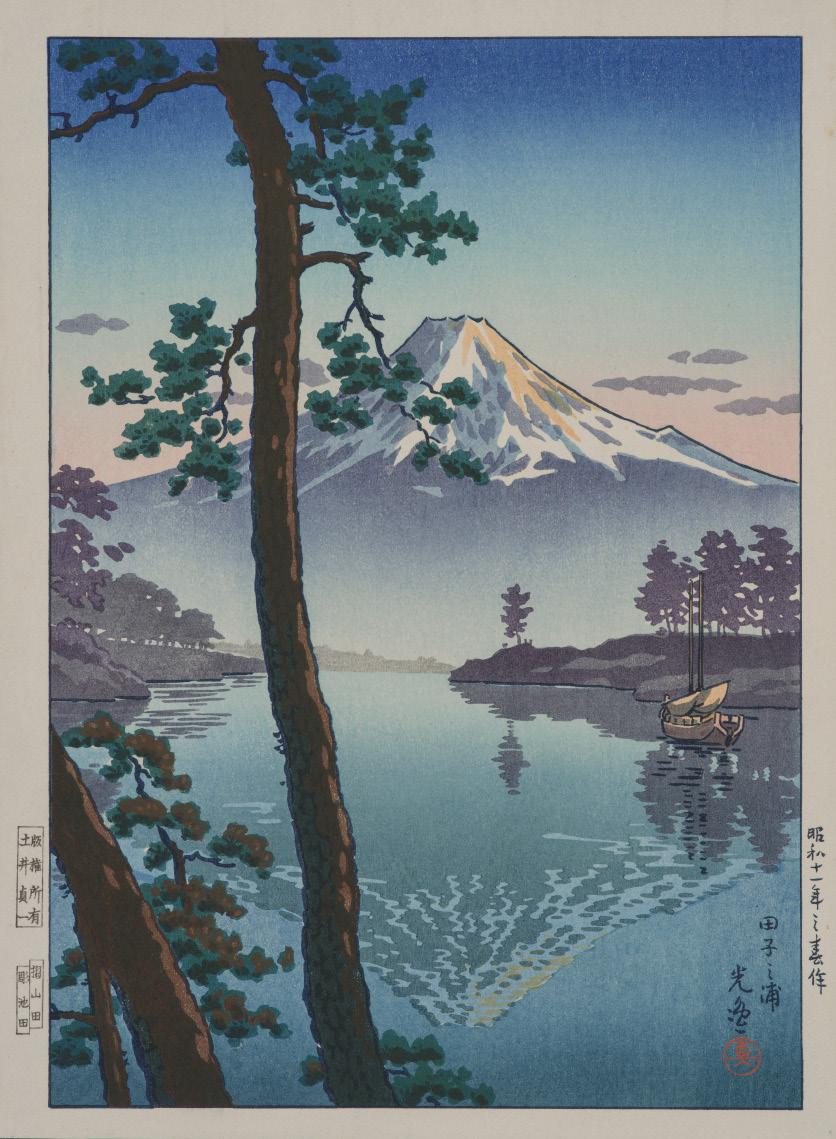

341
KAWASE HASUI: CLEARING AFTER A SNOWFALL ON MOUNT FUJI, TAGONOURA BEACH
By Kawase Hasui (1883-1957), signed Hasui and sealed Kawase Japan, dated January 1932
Color woodblock print on paper. Vertical oban. Signed Hasui with seal Kawase; publisher Doi Sadaichi. Title Fuji no yukibare, Tagonoura (Clearing after a snowfall on Mount Fuji, Tagonoura Beach).
The peak of Mount Fuji is colored pink with the clear rays of sunset following a day of heavy snowfall, framed by snow-laden boughs of pine trees. Fuji is reflected on the calm water of the bay below.
SIZE of the sheet 39.1 x 26 cm
Condition: Excellent condition. Beautiful, vibrant impression.
MUSEUM COMPARISON
A closely related print with similar seals is in the Los Angeles County Museum of Art, accession number M.73.37.130.
AUCTION COMPARISON
Compare a closely related print, with similar seals, at Christie’s, New Wave: Icons of Modern Japanese Prints Online, 24 September 2024, New York, lot 42 (sold for USD 27,720 or approx. EUR 24,500 converted and adjusted for inflation at the time of writing).
Estimate EUR 12,000
Starting price EUR 6,000


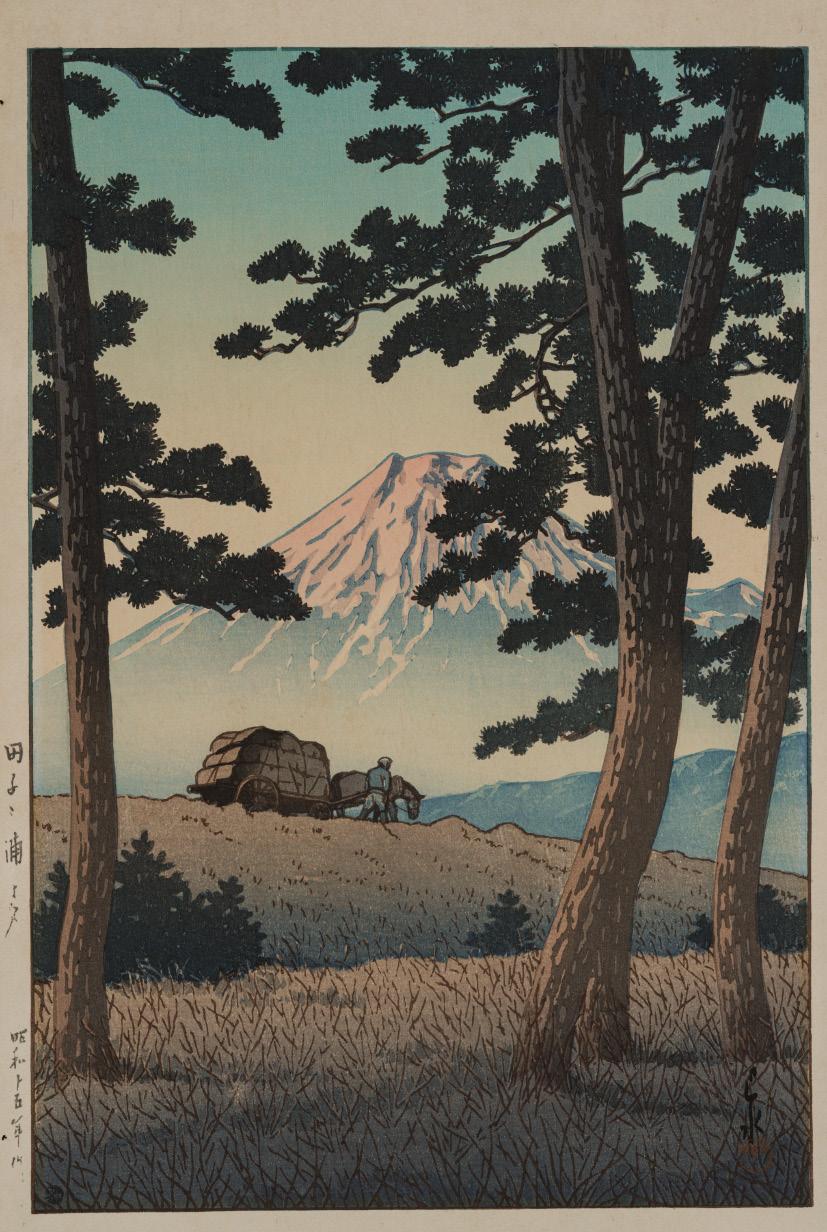
KAWASE HASUI: EVENING AT TAGO BAY
By Kawase Hasui (1883-1957), signed Hasui and sealed Kawase Japan, dated 1940
Color woodblock print on paper. Vertical oban. Signed Hasui with seal Kawase; publisher Watanabe Shozaburo, sealed to the lower left corner. Title Tago no ura no yube (Evening at Tago Bay), Tokaido fukei senshu (Selected views of the Tokaido Road).
Depicting Tago Bay, at the foot of Mount Fuji, four tall pine trees frame the view of the mountain. A farmer leads a horse and cart laden with bays of hay; the sunset tints the snow-capped mountain pink, and bathes the foreground in evening light.
SIZE of the sheet 39.4 x 26.4 cm
Condition: Excellent condition. Some very light browning visible in the back. Beautiful impression. Two mounting holes to the outer edge.
MUSEUM COMPARISON
A closely related print with similar seal is in the Art Institute of Chicago, reference number 1990.607.714.
AUCTION COMPARISON
Compare a closely related print, with similar seal, at Christie’s, Landscapes of Japan: Woodblock Prints from Edo to Post-War, 26 March 2024, New York, lot 67 (sold for USD 3,528 or approx. EUR 3,100 converted and adjusted for inflation at the time of writing).
Estimate EUR 2,000 Starting price EUR 1,000

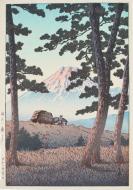

KAWASE HASUI: FUDO HALL IN MEGURO
By Kawase Hasui (1883-1957), signed Hasui and sealed Kawase Japan, dated 1931
Color woodblock print on paper. Vertical oban. Set inside a frame, behind glass. Signed Hasui with seal Kawase; publisher Watanabe Shozaburo, sealed to the outer right margin. Title Meguro Fudo-do (Fudo Hall in Meguro).
Fudo Temple in Meguro ward, Tokyo. Fudo is one of the five “Kings of Wisdom” in the Shingon sect of esoteric Buddhism.
SIZE of the sheet 39 x 26 cm, SIZE incl. frame 51 x 38.4 cm
Condition: Very good condition with some browning mostly limited to the outer margins and back. Minor creasing to the upper margin and some general wear to edges.
Ryusenji, also known as the Meguro Fudo (Black-eyed Fudo) is a Buddhist temple located in Meguro, Tokyo, Japan. The temple currently belongs to the Tendai school of Japanese Buddhism, and its main image is a hibutsu statue of Fudo-myoo. The temple is 18th of the Kanto Sanjuroku Fudo pilgrimage route of 36 temples in the Kanto region dedicated to Fudo-myoo.
AUCTION COMPARISON
Compare a closely related print, with similar seal, at Christie’s, Japanese and Korean Art, 16 September 2025, New York, lot 240 (sold for USD 7,620 or approx. EUR 6,500 converted at the time of writing).
Estimate EUR 2,500
Starting price EUR 1,200

344
By Tsuchiya Koitsu (1870-1943), signed Koitsu with seal Shin Japan, dated 1941
Color woodblock print on paper. Vertical oban. Set inside a frame, behind glass. Signed Koitsu with seal Shin; publisher Uchida. Titled Ame no Miyajima (Miyajima in the Rain).
Depicting the famous floating torii gate of the Itsukushima Shrine on Miyajima, a deer drinking from the water.
SIZE of the sheet 41.5 x 28.7 cm
Condition: Very good condition. Minor creasing and foxing to the outer margins. One mounting hole to the outer left edge.
MUSEUM COMPARISON
A closely related print is in the collection of the Art Gallery of Greater Victoria, Canada, object number 1994.013.023.

Estimate EUR 1,000
Starting price EUR 500
By Kawase Hasui (1883-1957), signed Hasui and sealed Kawase Japan, dated 1938
Color woodblock print on paper. Vertical oban. Signed Hasui with seal Kawase; publisher Watanabe Shozaburo, sealed to the lower right. Title Tsuki no Kiyosumi-en (Moon over Kiyosumi Garden).
Soft evening scene of the pond at Kiyosumi Garden in Tokyo, gleaming under the absent moon’s light. Centered by a stone lantern surrounded by carefully groomed pine trees.
SIZE of the sheet 39 x 26.2 cm
Condition: Excellent condition. A small mounting hole is present along the outer edge, and there are remnants of a paper backing on the reverse at the outer right margin.
MUSEUM COMPARISON
A closely related print with similar seal is in the Art Institute of Chicago, reference number 1990.607.682.
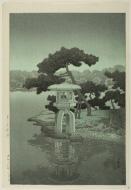
AUCTION COMPARISON
Compare a closely related print at Sotheby’s, Japanese Woodblock Prints, 23 March 2023, London, lot 64 (sold for GBP 3,048 or approx. EUR 3,900 converted and adjusted for inflation at the time of writing).
Estimate EUR 1,500 Starting price EUR 800



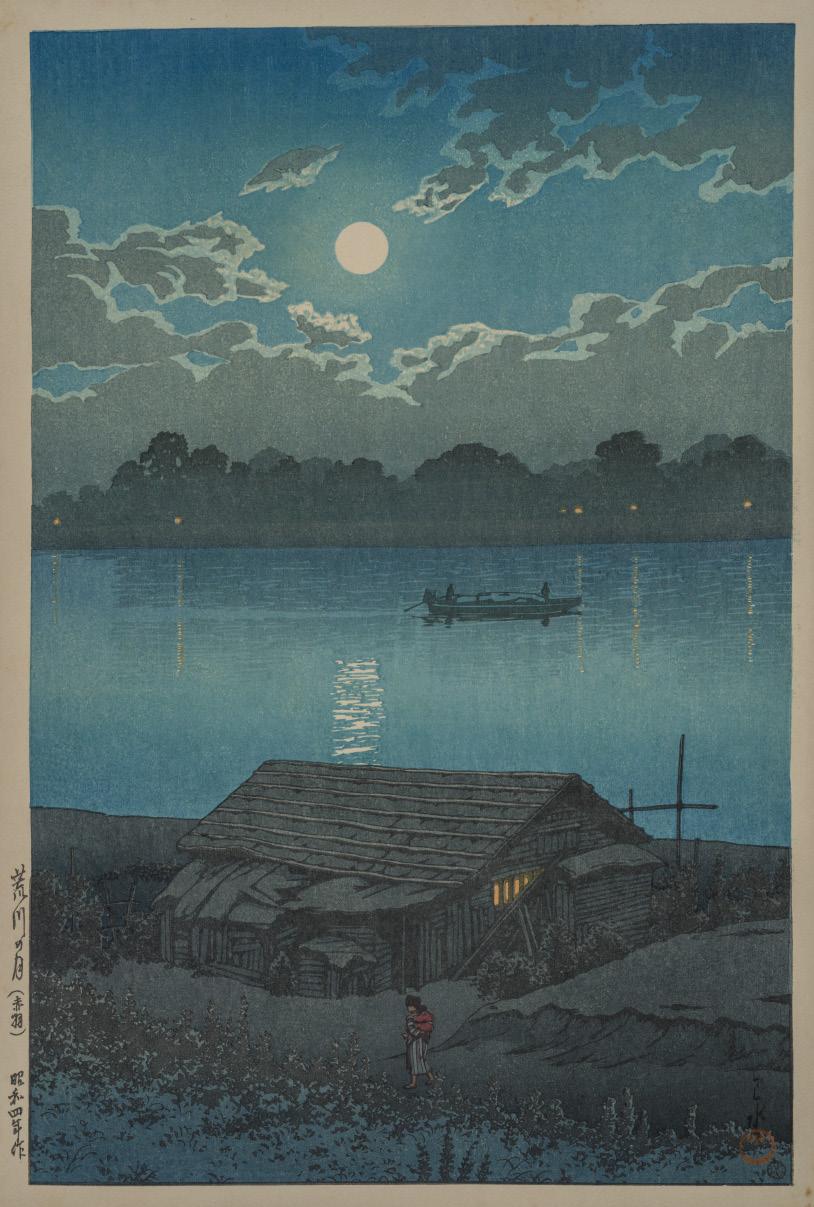
KAWASE HASUI: MOON ON THE ARAKAWA RIVER IN AKABANE
By Kawase Hasui (1883-1957), signed Hasui with seal Kawase Japan, dated 1929
Color woodblock print on paper. Vertical oban. Signed Hasui with seal Kawase; publisher Watanabe Shozaburo, sealed to the lower right. Title Arakawa no tsuki, Akabane (Moon on the Arakawa River in Akabane), from the series Tokyo nijukei (Twenty views of Tokyo).
Depicting the Arakawa River, which runs from Saitama Prefecture through Tokyo, shown from the banks in Akabane, gleaming under the light of the full moon casting its light throughout the composition.
SIZE of the sheet 38.8 x 26.4 cm
Condition: Excellent condition. Some light expected browning to paper, however limited to outer margins. Beautiful, vibrant impression. One mounting hole to the outer edge.
Museum comparison: A closely related print by the same artist is in the Los Angeles County Museum of Art, accession number M.2003.67.70.
AUCTION COMPARISON


Compare a closely related print at Christie’s, Landscapes of Japan: Woodblock Prints from Edo to Post-War, 26 March 2024, New York, lot 62 (sold for USD 13,860 or approx. EUR 12,500 converted and adjusted for inflation at the time of writing). Compare a closely related print, with a Watanabe gift seal, at Zacke, Fine Japanese Art, 3 December 2021, Vienna, lot 309 (sold for EUR 6,320).
Estimate EUR 6,000 Starting price EUR 3,000

KAWASE HASUI: KEGON WATERFALL, NIKKO
By Kawase Hasui (1883-1957), signed Hasui with seal Kawase Japan, dated fall 1927
Color woodblock print on paper. Vertical oban. Signed Hasui with seal Kawase; publisher Bijutsusha (Rumi), sealed to the lower right. Title Nikko Kegon taki (Kegon waterfall, Nikko), from the series Ukiyoe monyo shu (Collection of ukiyoe designs).
Beautiful view of a spectacular waterfall in autumn.
SIZE of the sheet 38.9 x 26.3 cm
Condition: Very good condition with wear, some browning, mostly visible to the back. A few light creases, mostly to the lower end. One mounting hole to the outer edge.
In the late 1920’s the publishing firm Bijutsusha (in Yotsuya, Tokyo) published a series of twelve prints, Ukiyoe monyo shu (Collection of ukiyoe designs), with eight landscapes by Hasui, and four prints depicting beauties by Yamakawa Shuho (1898-1944).
AUCTION COMPARISON
Compare a closely related print at Christie’s, with similar seal, Arts of Asia Online, 28 September 2023, New York, lot 226 (sold for USD 4,788 or approx. EUR 4,500 converted and adjusted for inflation at the time of writing).
Estimate EUR 4,000
Starting price EUR 2,000
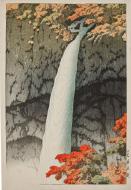
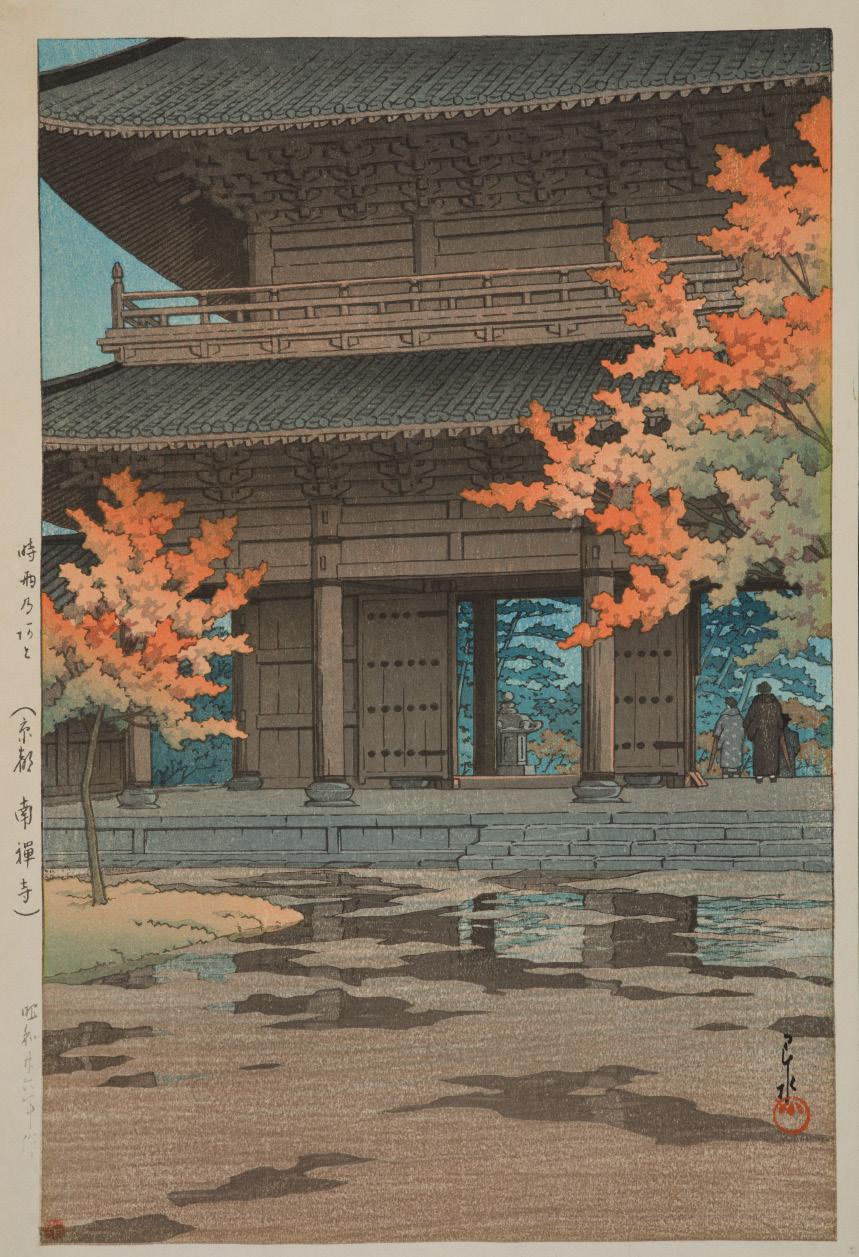
KAWASE HASUI: AFTER DRIZZLING IN AUTUMN, NANZEN-JI TEMPLE IN KYOTO
By Kawase Hasui (1883-1957), signed Hasui with seal Kawase Japan, dated 1951
Color woodblock print on paper. Vertical oban. Signed Hasui with seal Kawase; publisher Watanabe Shozaburo, sealed to the lower left. Title Jigure no ato (Kyoto Nanzen-ji) (After drizzling in autumn, Nanzen-ji Temple in Kyoto).
SIZE of the sheet 40 x 26.6 cm
Condition: Excellent condition. Some minor wear to the outer edges and remnants from a paper backing to the reverse. Very good impression and bright colors.
Reddening maple leaves flank the impressive main gate (sanmon) of the Nanzenji Temple in Kyoto. Established around 1291 through
a donation by the Emperor Kameyama (1249-1305) of his estate in the locale of Higashiyama, the site became the head temple of the Nanzenji branch of the Rinzai sect of Zen Buddhism. By the time of Hasui’s day, the temple marked the end of the quaint cherry treelined pedestrian path known as the Philosopher’s Walk (Tetsugaku no michi). Here, lingering puddles at the gate’s approach signal an earlier bout of rainfall.
AUCTION COMPARISON
Compare a closely related print at Christie’s, Landscapes of Japan: Woodblock Prints from Edo to Post-War, 26 March 2024, New York, lot 74 (sold for USD 6,048 or approx. EUR 5,400 converted and adjusted for inflation at the time of writing).
Estimate EUR 2,000
Starting price EUR 1,000
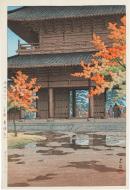

KAWASE HASUI: MOUNT UNZEN
By Kawase Hasui (1883-1957), signed Hasui with seal Kawase Japan, circa 1927
Color woodblock print on paper. Horizontal oban. Signed Hasui with seal Kawase; publisher Bijutsusha. Title Hizen (Mount Unzen), from the series Ukiyo-e monyo shu (Collection of ukiyo-e designs).
Boats glide on glassy waters, the mountains, sails and sky transformed by the red reflection of the sun at sunset.
SIZE of the sheet 25.9 x 38.6 cm
Condition: Good condition. Few stains, some creasing, and the margins slightly trimmed. A small area with encrustations to the top-left corner.
AUCTION COMPARISON
Compare a closely related print at Christie’s, with similar seals, Arts of Asia Online, 28 March 2024, New York, lot 287 (sold for USD 3,780 or approx. EUR 3,300 converted and adjusted for inflation at the time of writing).
Estimate EUR 2,000
Starting price EUR 1,000

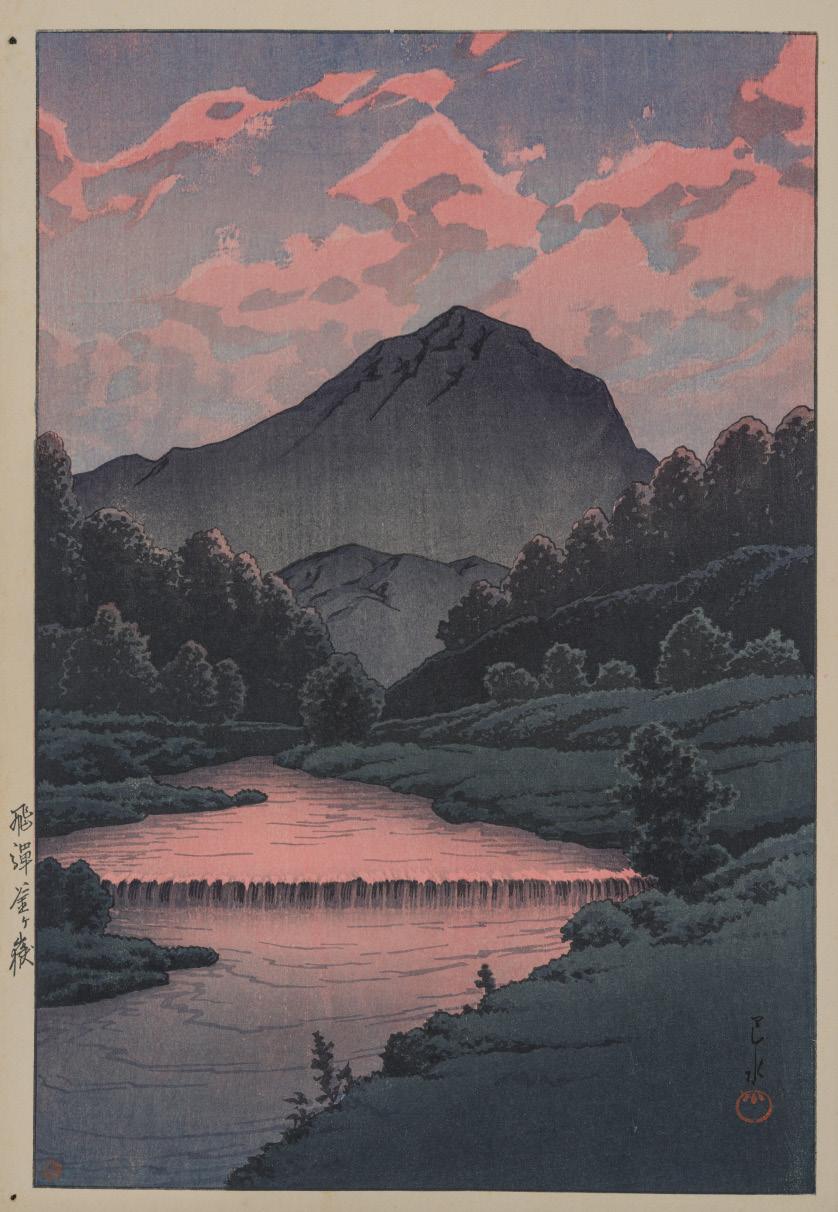
350 KAWASE HASUI: MOUNT KAMAGA, HIDA
By Kawase Hasui (1883-1957), signed Hasui with seal Sui Japan, dated 1933
Color woodblock print on paper. Vertical oban. Signed Hasui with seal Sui; publisher Watanabe Shozaburo, sealed to the lower left. Title Hida Kamagadake (Mount Kamaga, Hida).
Depicting Mount Kama in Shiga Prefecture towering over a meandering river in the foreground reflecting the sunset.
SIZE of the sheet 39.3 x 26.8 cm
Condition: Excellent condition. Some browning, foxing and light stains, however limited to the back or outer margins. Two mounting holes to the left outer margin.
MUSEUM COMPARISON
A closely related print by the same artist, with similar seal, is in the Art Institute of Chicago, reference number 1990.607.687.
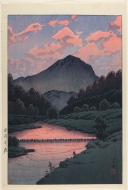
Estimate EUR 2,500 Starting price EUR 1,200

By Tsuchiya Koitsu (1870-1943), signed Koitsu with seal Shin Japan, dated 1936
Color woodblock print on paper. Vertical oban. Signed Koitsu with seal Shin; publisher Doi. Titled Haru no Yuki, Kyoto Maruyama (Spring Snow at Maruyama, Kyoto).
Gorgeous winter view of Maruyama Park in Kyoto, the trees and grounds covered with a soft blanket of snow. Two women share an umbrella in the foreground as another hurries across the bridge to the right. Snow falls gently and the graceful branches of a willow tree frame the scene overhead.
SIZE of the sheet 43 x 29 cm
Condition: Very good condition. Some very light foxing, creasing to the outer margin, and glue and paper residue to the back from previous mounting.
Estimate EUR 1,500 Starting price EUR 800

KAWASE HASUI: HONMON TEMPLE, IKEGAMI
By Kawase Hasui (1883-1957), signed Hasui and sealed Kawase Japan, dated 1931
Color woodblock print on paper. Vertical oban. Signed Hasui with seal Kawase; publisher Watanabe Shozaburo. Title Ikegami Honmonji (Honmon Temple, Ikegami).
Figures walking in a courtyard towards the staircase of a temple. There is a large snowy tree at the left. Surroundings have a layer of snow and the figures carry umbrellas.
SIZE of the sheet 39.5 x 26.2 cm
Condition: Excellent condition with minimal wear.
Museum comparison: A closely related print is in the Madison Museum of Contemporary Art.
AUCTION COMPARISON
Compare a closely related print, with similar seal, at Sotheby’s, Fine Japanese Prints, 16 December 2022, London, lot 147 (sold for GBP 6,930 or approx. EUR 9,000 converted and adjusted for inflation at the time of writing).
Estimate EUR 2,000
Starting price EUR 1,000
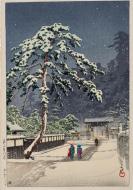

KAWASE
By Kawase Hasui (1883-1957), signed Hasui with seal Sui Japan, dated 1947
Color woodblock print on paper. Horizontal oban. Signed Hasui with seal Sui; publisher Watanabe Shozaburo, sealed to the lower right. Title Mito Hinuma no yuki (Snow at Hinuma Swamp in Mito).
Snow is falling upon Hinuma Marsh. Located to the south of Mito in Ibaraki Prefecture, the rural scene is almost entirely rendered in varying shades of blue pigment, save for the unprinted areas of white for the snowfall and accents of yellow coloring the reeds. Tall pine trees stand gnarled and twisted; a lone figure cloaked in straw carries a line, the prow of his boat nestled among the water grasses.
SIZE of the sheet 27.8 x 39.6 cm
Condition: Excellent condition. Some browning, foxing and light stains, however limited to the back or outer margins. Very good impression.
MUSEUM COMPARISON
A closely related print by the same artist, with similar seal, is in the Los Angeles County Museum of Art, accession number M.73.37.240.
AUCTION COMPARISON
Compare a closely related print at Sotheby’s, with similar seal, Landscape to City: 20th Century Japanese Prints Part II, 10 May 2023, London, lot 74 (sold for GBP 3,048 or approx. EUR 3,800 converted and adjusted for inflation at the time of writing).
Estimate EUR 4,000 Starting price EUR 2,000

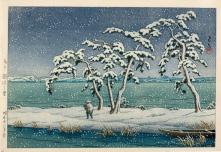

HASUI:
By Kawase Hasui (1883-1957), signed Hasui and sealed Kawase Japan, dated 1948
Color woodblock print on paper. Horizontal oban. Signed Hasui with seal Kawase; publisher Watanabe Shozaburo, sealed to the lower right. Title Heian Jingu no yuki (Kyoto) (Snow at Heian Shrine, Kyoto).
Depicting two male visitors, sheltered beneath umbrellas, approaching the Heian Shrine in Kyoto during a blustery snowstorm.
SIZE of the sheet 26 x 38.3 cm
Condition: Very good condition. Beautiful, vibrant impression. Tiny stains to the outer margin as visible in the images provided. The back with adhesive residue from mounting.
The Heian shrine was built in 1894 to commemorate the 1100th anniversary of the founding of the city of Kyoto. It is dedicated to the Emperors Kanmu (r. 781-806) in whose reign the city was established, and Komei (r. 1846-67), the last Emperor in Kyoto. The large garden was principally the work of Ogawa Jihei (1860-1933), whose design was inspired by the aesthetics of the Heian period (794-1185).
AUCTION COMPARISON
Compare a closely related print, with similar seal, at Sotheby’s, Fine Japanese Prints, 14 December 2021, London, lot 184 (sold for GBP 7,560 or approx. EUR 11,000 converted and adjusted for inflation at the time of writing).
Estimate EUR 4,000
Starting price EUR 2,000
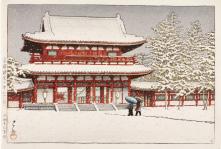

By Kawase Hasui (1883-1957), signed Hasui and sealed Kawase Japan, dated 1932
Color woodblock print on paper. Vertical oban. Set inside a frame, behind glass. Signed Hasui and sealed Kawase; publisher Doi Sadakazu. Title Kure no yuki, Edogawa (Evening Snow at Edogawa River).
Two beauties create a colorful contrast against the snow-covered landscape as they cross a wooden bridge spanning the Edo River.
SIZE of the sheet 40 x 25.5 cm, SIZE incl. frame 47 x 34.7 cm
Condition: Overall good condition with wear and some browning to paper. Small stains, scattered foxing, and minor creasing. All as visible in the images provided.
AUCTION COMPARISON
Compare a closely related print, with similar seal, at Sotheby’s, Japanese Woodblock Prints, 18 July 2024, London, lot 44 (sold for GBP 13,200 or approx. EUR 16,000 converted and adjusted for inflation at the time of writing).
Estimate EUR 1,000
Starting price EUR 500


By Ohara Koson (1878-1945), signed Shoson with seal Shoson Japan, 1927
Color woodblock print and gofun (shell paste) on paper. Vertical oban. Signed Shoson with seal Shoson; publisher Watanabe Shozaburo, sealed to the lower left. Title Yanagibashi no yuki (Snow at Yanagibashi).
Two women cross the Yanagibashi Willow bridge over the river Sumidagawa in a heavy snowfall, the umbrellas covering their face.
SIZE of the sheet 39.7 x 26.6 cm
Condition: Excellent condition. Beautiful impression. Some very light, hardly noticeable foxing.
Ohara Koson (1877-1945) was a Japanese painter and woodblock print designer of the late 19th and early 20th centuries, part of the shin-hanga (new prints) movement. He is famous as a master of kacho-e (bird-and-flower) designs. Throughout a prolific career, in which he created around 500 prints, he went by three different titles: Ohara Hoson, Ohara Shoson, and Ohara Koson.
MUSEUM COMPARISON
A closely related print by the same artist, with similar seals, is in the Los Angeles County Museum of Art (LACMA), accession number M.2000.105.148.
AUCTION COMPARISON
Compare a closely related print, with a similar seal, at Christie’s, Landscapes of Japan: Woodblock Prints from Edo to Post-War, 26 March 2024, New York, lot 84 (sold for USD 17,640 or approx. EUR 15,000 converted and adjusted for inflation at the time of writing).
Estimate EUR 4,000
Starting price EUR 2,000


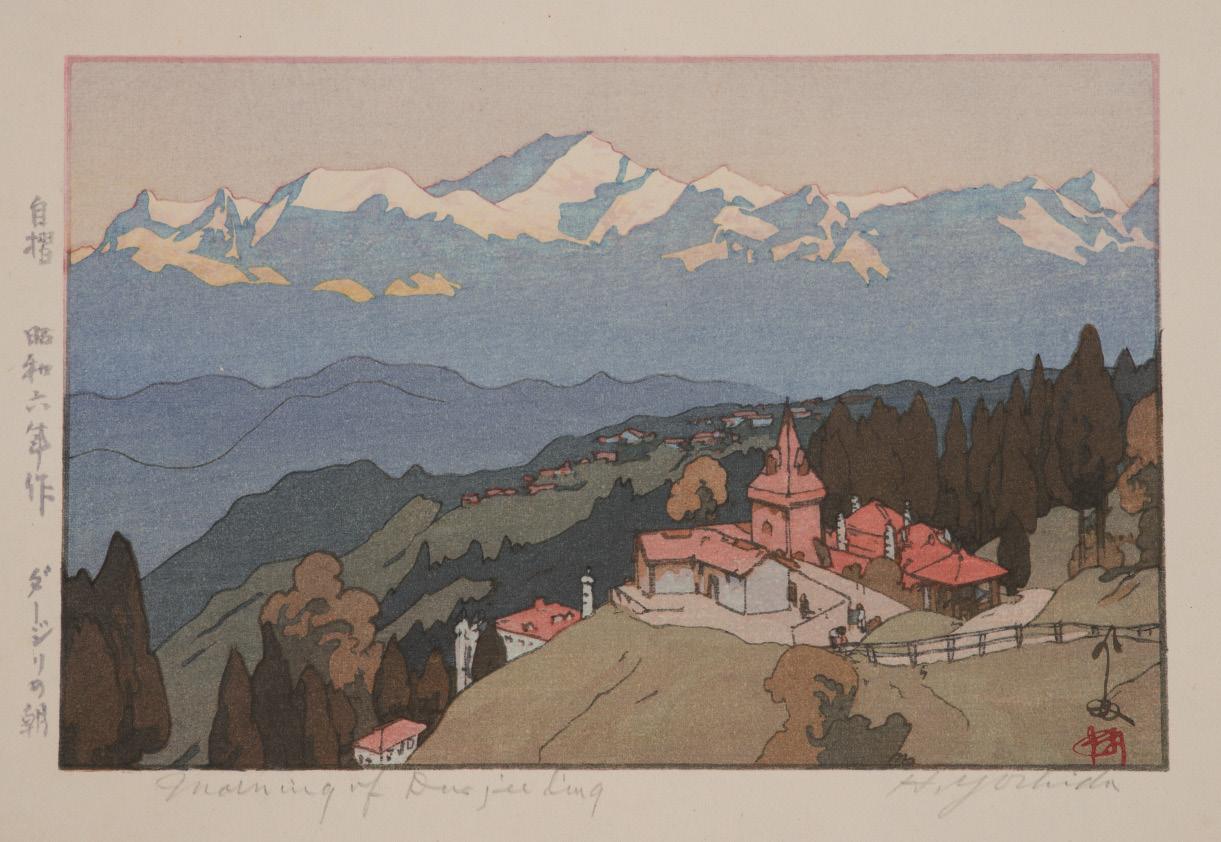
By Yoshida Hiroshi (1876-1950), signed Yoshida and sealed Hiroshi Japan, dated 1931
Color woodblock print on paper. Horizontal chuban. Signed Yoshida with seal Hiroshi, Jizuri (self-printed) seal to the left margin. Titled Darjeeling no Asa (Morning of Darjeeling), from the series India and Southeast Asia.
Darjeeling is a town in the Indian state of West Bengal. It is the headquarters of Darjeeling district, in the Shiwalik Hills on the lower range of the Himalaya.
SIZE of the sheet 15.7 x 24.5 cm
Condition: Very good condition with some very light foxing to the outer margins. Beautiful, vibrant impression.
The name ‘Darjeeling’ is a combination of the Tibetan words ‘Dorje’ (thunderbolt) and ‘ling’ (place), translating to ‘The land of the thunderbolt’. Darjeeling is internationally famous for its tea industry.
The jizuri seal is the most important mark on a Hiroshi Yoshida print as it helps distinguish an early edition where the printing process was directly supervised by him. Jizuri means “self-printed” and indicates that Hiroshi Yoshida played an active role in the printing process of the respective print. Hiroshi focused heavily on developing prints of the highest quality and normally only the prints with the best impressions received his jizuri seal.
Hiroshi Yoshida (1876-1950) began his artistic training with his adoptive father in Kurume, Fukuoka prefecture. Around the age of twenty, he left Kurume to study with Soritsu Tamura in Kyoto, subsequently moving to Tokyo and the tutelage of Shotaro Koyama. Yoshida studied Western-style painting, winning many exhibition prizes, and making several trips to the United States, Europe and North Africa selling his watercolors and oil paintings. While highly successful as an oil painter and watercolor artist, Hiroshi Yoshida turned to woodblock printmaking upon learning of the Western world’s infatuation with ukiyo-e. While widely traveled and knowledgeable of Western aesthetics, he maintained an allegiance to traditional Japanese techniques and traditions.
MUSEUM COMPARISON
A closely related print is in the Toledo Museum, object number 2008.50.

Estimate EUR 3,000
Starting price EUR 1,500
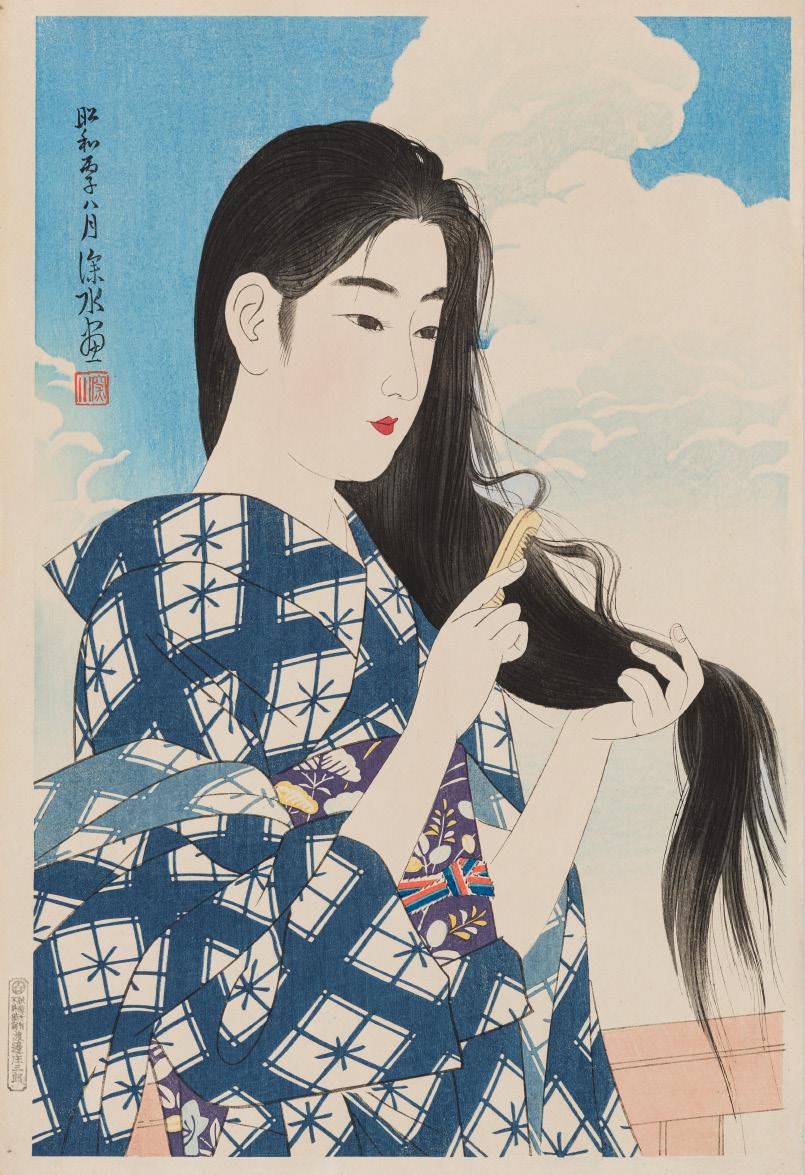
358
By Ito Shinsui (1898-1972), signed Shinsui ga with seal Shinsui Japan, dated 1936
Color woodblock print on paper. Vertical dai oban. Set inside a frame, behind glass. Signed Shinsui ga with seal Shinsui; publisher Watanabe Shozaburo, sealed Shintei [a presentation copy] to the back. Title Senpatsu (Washed Hair), from the series Gendai bijin shu dai nishu (the Second Collection of Modern Beauties).
A young woman combs her hair after washing it.
SIZE of the sheet 44 x 28.5 cm
Provenance: From the private collection of the daughter of Theodor Scheiwe (1897-1983), one of the most prominent German collectors of woodblock prints. As opposed to the collection of her father, this Westphalian private collection focused on 20th century prints, shin-hanga and sosaku-hanga, featuring many portraits by the celebrated artist Ito Shinsui, sourced from various auction houses and prominent dealers, and always looking for the very best quality and condition.
Condition: Good condition with wear. Slight browning of paper to the reverse, minor fading, and light creasing along the outer edges. Mounting holes to the outer edges. Gently mounted on cardboard.
Ito Shinsui (1898-1972) studied Japanese painting and began designing woodblock prints for the publisher Watanabe Shozaburo in 1916, with whom he collaborated until 1960. He is best known for his lovely shin-hanga images of beautiful women. These elegant and refined beauties are drawn with graceful line work and softly colored backgrounds. Recognized for his artistic achievements, the Japanese government declared Shinsui an Intangible Cultural Property in 1952, and he received the Order of the Rising Sun in 1970.
MUSEUM COMPARISON
A closely related print is in the National Gallery of Victoria, Melbourne, accession number 2015.191.
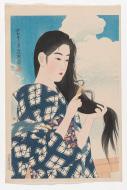
AUCTION COMPARISON
Compare a closely related print sold at Christie’s, Japanese and Korean Art Online, 7 November 2019, New York, lot 56 (sold for USD 5,000).
Estimate EUR 4,000
Starting price EUR 2,000
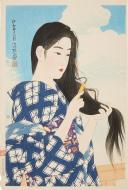

359
OGATA GEKKO: THE NINE-TAILED FOX
By Ogata Gekko (1859-1920), signed Gekko zuihitsu with seal Ichigaku Ichiei Japan, c. 1890s, Meiji period (1868-1912)
Color woodblock print on paper. Horizontal oban. Set inside a frame, behind glass. Signed Gekko zuihitsu with seal Ichigaku Ichiei. Title Kyubi no kitsune (The Nine-tailed Fox), from the series Gekko zuihitsu (Gekko’s Miscellany).
In this dynamic scene, the kitsune—disguised as a beautiful courtesan—flees the imperial palace, her form vanishing into the shadows as she narrowly escapes capture. Though her plot to assassinate the emperor fails, her deception sets off a chain of events that destabilizes the court, ultimately sparking one of the most consequential civil wars in Japanese history. Gekko captures the moment with dramatic tension, blending myth with historical allegory in a masterful display of Meiji-era printmaking.
SIZE of the sheet 37 x 25 cm, SIZE incl. frame 56.5 x 41.5 cm
Provenance: From the Eva and Aubrey Sweet Collection. Eva and Aubrey Sweet were Melbourne-based collectors who over six decades assembled an intimate yet ambitious collection of Asian art, with particular focus on Chinese jades, Japanese lacquerware, prints, and netsuke. Though modest and private in demeanor, their acquisitions were underpinned by Eva and Aubrey Sweet

methodical study, engagement with curators and dealers, and a wide reference library.
Condition: Excellent condition with minor wear, some light browning and staining to the back.
Ogata Gekko (1859-1920) was a Japanese artist best known as a painter and a designer of ukiyo-e woodblock prints. He was self-taught in art, won numerous national and international prizes, and was one of the earliest Japanese artists to win an international audience. Gekko was self-taught in art, and began decorating porcelain and rickshaws, and designing flyers for the pleasure quarters. His early style shows the influence of the painter Kikuchi Yosai. About 1881 he took the surname Ogata at the insistence of a descendant of the painter Ogata Korin. He soon was designing prints and illustrating books and newspapers. In 1885 Gekko exhibited in the Painting Appreciation Society, and he became acquainted with the art scholars Ernest Fenellosa and Okakura Kakuzo.
MUSEUM COMPARISON
A closely related print is in the British Museum, registration number 1906,1220,0.1757.

Estimate EUR 1,500
Starting price EUR 800
360
By Ohara Koson (1878-1945), signed Shoson with seal Shoson Japan, c. 1924-1930
Color woodblock print on paper. Vertical oban. Signed Shoson with seal Shoson; publisher Watanabe Shozaburo, sealed to the lower right. Title Scops Owl in Flight, Cherry Blossoms and Full Moon.
A keen-eyed owl flies past a cherry branch full of blossoms, a large full moon is seen in the background.
SIZE of the sheet 38 x 25.3 cm
Condition: Good condition with minor wear, slight browning visible to the back and along the edges. Minor creasing and tiny losses to the outer edges.
Ohara Koson (1877-1945) was a Japanese painter and woodblock print designer of the late 19th and early 20th centuries, part of the shin-hanga (new prints) movement. He is famous as a master of kacho-e (bird-and-flower) designs. Throughout a prolific career, in which he created around 500 prints, he went by three different titles: Ohara Hoson, Ohara Shoson, and Ohara Koson.
AUCTION COMPARISON
Compare a closely related print at Zacke, Fine Japanese Art, 14 June 2024, Vienna, lot 351 (sold for EUR 2,464).
Estimate EUR 2,000
Starting price EUR 1,000

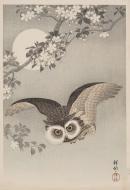
§ 1) The auction shall be carried out in accordance with the provisions of the rules of procedure of GALERIE ZACKE©, SZA VERSTEIGERUNGEN UND VERTRIEBS GMBH, Zelinkagasse 6, 1010 WIEN (hereinafter referred to as the company) as well as in accordance with sections 244-246 of the GEWERBEORDNUNG [Industrial Code] of 1994. The auction shall be carried out on commission. The auctioneer shall be entitled to withdraw lots exceptionally, to conduct the auction deviating from the order of the catalog numbers and to offer lots jointly. In the event of any dispute concerning a double bid or if the auctioneer has missed a bid, the auctioneer shall be entitled to revoke acceptance of a bid and to continue auctioning the item. The figures stated in the catalog shall be the highest bid in Euro (€) expected by the respective expert. As a rule, the bid shall be increased by 10% of the last bid. (See table of the bidding increments).
§ 2) The acceptance of a bid shall be granted to the highest bidder unless a hidden reserve has been agreed upon with the consignor of the item in question. Such a hidden reserve (also called limit or just reserve) shall be the minimum price under which the item will not be sold during the auction. This reserve will be disclosed upon request and after the auction only and may exceed the estimate. The auctioneer will in this case bid on behalf of the seller against all other bidders until the reserve has been reached. If a reserve is not reached during the auction, the auctioneer will knock down the item to the highest bidder at the final bid, but the sale will be conditional of the acceptance of this final bid by the seller. In this case the highest bidder shall be bound to his/her last bid for a term of 8 days starting with the day of the knockdown. If the winning bidder does not receive a written cancellation notice within this term of 8 days, the knockdown becomes unconditional and the sale is final. Typically, only a minority of all items in an auction have a hidden reserve.
§ 3) Most items shall be subject to differential taxation. A uniform surcharge of 25% plus the value added tax applicable to the surcharge to the amount of 20% shall be added to the achieved highest bid (final and highest bid). Thus, the surcharge shall be 30% of the final and highest bid in total. Items with added VAT are marked † in the online catalog.
§ 4) In the event of sales abroad, the value added tax will be repaid if the item is sold to a country which is not a member country of the European Union (third country), the legal requirements are met, and the proof of exportation is provided. The value added tax shall not be shown separately on the invoice.
§ 5) The auction buyer must pay the purchase price immediately upon acceptance of the bid (final and highest bid plus 25% surcharge, plus the value added tax applicable to the surcharge to the amount of 20%, or the added VAT on top of the final price, when a lot is highlighted accordingly in the auction catalog). The company may grant an auction buyer a term of payment for the purchase price in whole or in part when this has been formally applied for in writing before the auction.
§ 6) In the event of a term of payment, or any payment delay, in whole or in part, the company shall be entitled to charge default interest (12% p.a.) as well as storage charges (2.4% pf the final and highest bid per month commenced) after 14 days upon acceptance of the bid. The item purchased at auction shall be handed over exclusively upon full payment of the purchase price including all costs and charges accrued since the acceptance of the bid.
§ 7) The buyer should take acquired items into possession, as far as possible, immediately or after the end of the auction. Items which have been fully paid for shall be handed over in our show rooms in GALERIE ZACKE, Zelinkagasse 6, 1010 VIENNA. If a deferred purchase price is not paid within the set period, the company shall be entitled to auction the item again in order to recoup its claim from the defaulting auction buyer. In this case, the defaulting auction buyer shall be liable to the company for the total loss of commission incurred by the company due to the re-auctioning as well as for any default interest and storage charges.
§ 8) The company shall be entitled to a lien on all items of the buyer irrespective of whether the buyer bought them within the scope of an auction or in free sale or the company secured ownership of these items otherwise. This lien shall serve to secure all current and future, qualified, limited and unmatured claims to which the company is entitled and which result from all legal transactions concluded with the buyer.
§ 9) The items received for auction will be exhibited and may be viewed prior to the auction. In doing so, the company shall give everyone the opportunity to check the nature and the condition of the exhibited items to the extent deemed possible within the scope of the exhibition. Every bidder shall be deemed to act on its own behalf unless it provides a written confirmation saying that it acts as a representative or agent of a well-known principal. The company may refuse bids; this shall particularly apply if a bidder who is unknown to the company or with whom the company has no business connections yet does not provide a security deposit before the auction. However, in principle there shall be no claim to accept a bid. If a bid has been refused, the previous bid shall remain effective.
§ 10) The company’s experts evaluate and describe the items received for auction and determine the starting prices unless otherwise stated in the catalog or expert opinion. The information concerning production technique or material, state of preservation, origin, design and age of an item is based on published or otherwise generally accessible (scientific) findings concluded by the company’s expert with the necessary care and accuracy. The company shall warrant to the buyer according to §34-38 of the AGB (Terms and Conditions) that properties are correct provided that any complaints referring to this are made within 45 days after the auction day. Subsequent complaints shall be excluded in principle. The company shall not be liable for any further information in the catalog and expert opinion as well. This shall also apply to illustrations in the catalog. The purpose of these illustrations is to guide the potential buyer during the preview. They shall not be authoritative for the condition or the characteristics of the pictured item. The published condition reports shall only mention defects and damage affecting the artistic or commercial value significantly. Complaints concerning the price shall be excluded upon acceptance of the bid. The company reserves the right to amend the catalog online prior to the auction. These amendments shall also be made public orally by the auctioneer during the auction. In this case, the company shall be liable for the amendment only. All items offered may be checked prior to the auction. These items are used. Any claims for damages exceeding the liability named above and resulting from other material defects or other defects of the item shall be excluded. When making the bid, the bidder confirms that he/she has inspected the item prior to the auction and has made sure that the item corresponds to the description.
§ 11) If a customer is not able to participate in an auction personally, the company shall accept purchase orders. These orders may be placed in writing via mail, e-mail, fax, www.zacke.at or a third party bidding platform. In the case of a purchase order placed by phone or orally, the company shall reserve the right to make the performance dependent on a confirmation from the principal communicated in writing. Furthermore, the company shall not be liable for the performance of purchase orders. Equal purchase orders or live bids will be considered in the order of their receipt. Bids which below the estimate shall be exhausted completely. Bids which do not correspond to the increments determined by the company (see bidding increment table) will be rounded up to the next higher increment. The table of these increments can be sent upon request. The written bid (purchase order) must include the item, the catalog number and the offered top bid limit which is quoted as the amount of the acceptance of the bid without buyer’s commission and without taxes.
Ambiguities shall be carried by the bidder. A purchase order which has already been placed may only be cancelled if the written withdrawal is received by the company at least 72 hours prior to the beginning of the auction.
§ 12) The company may refuse a purchase order without explanation or make its execution dependent on payment of a security deposit. In the event of an unsuccessful order, such a deposit will be reimbursed by the company within 5 working days. Processing of purchase orders is free of charge.
§ 13) Every seller shall in principle be entitled to withdraw the items offered for auction until the start of the auction. Therefore, it is impossible to assume liability or to give warranty for the actual offering.
§ 14) Paid items must be collected within 30 days after payment. Items which have not been collected may be re-offered without further communication at the starting price from the recent auction reduced by 50%. Items which have not been collected within 30 days after the auction or for which the company does not receive any proper shipping instructions stating the type of shipping and the address of dispatch (independent of a possibly placed purchase order) shall be stored at the owner’s risk.
Furthermore, the company shall be entitled to store items which have been purchased at auction and paid but not collected at the buyer’s risk and expense, including the costs for an insurance, with a forwarding agency. It shall be understood that the provision concerning the re-auctioning of unpaid and paid but not collected items must also apply to items not exhibited or stored on the premises of the company. The ownership shall be transferred to the buyer at the time of handing over the issuing note.
§ 15) In the case of mixed lots with a starting price of less than EUR 350.00, the company shall not warrant for the completeness or correctness of the individual items within a mixed lot.
§ 16) A registration for a bid by telephone for one or several items shall automatically represent a bid at the starting price of these items. If the company cannot reach a bidder by telephone, it will bid the starting price on behalf of this bidder when the respective lot is up for auction.
§ 17) Payments made to the company by mistake (through the payer’s fault) (e. g. due to miscalculation of the exchange rate by the payer) or payments made to the company for the same invoice several times shall be compensated in form of a credit note for goods for an indefinite period of time. The repayment of such payments in cash shall be excluded.
§ 18) Certain auction lots may exist several times (multiples). In such a case, the auctioneer may accept a second, third or even more bids from the underbidder(s). In this case, the text in the catalog and not the illustration shall be exclusively binding with regard to the warranty.
§ 19) The company reserves the right to assign to the buyer all rights and obligations resulting from the contractual relationship between the company and the seller by way of a respective declaration, as well as to assign to the seller all rights and obligations resulting from the contractual relationship between the company and the buyer by way of a respective declaration, in each case in terms of a complete assignment of contract with the result that the contractual relationship - following the submission of the aforementioned declarations by the company –shall exclusively be between the seller and the buyer, all of which is in accordance with the basic model of the commission agreement. Buyers and sellers shall already now give their explicit consent to this contract assignment.
§ 20) The place of performance of the contract brought about between the company on the one hand and the seller as well as the buyer on the other hand shall be the place of business of the company. The legal relationships and contracts existing between the company, the sellers and the buyers shall be subject to Austrian law. The company, the sellers and the buyers shall agree to settle all disputes resulting from, concerning and in connection with this contract before the territorially competent court of Vienna.
§ 21) The export of certain art objects from Austria shall require a permit from the Bundesdenkmalamt [Federal Monuments Office]. The company will orally provide information about art objects for which such export permit will probably not be granted at the beginning of the auction.
§ 22) Whenever making a bid, whether personally or via an agent, in writing, online, telephone, or in any other way, the bidder fully and unconditionally accepts the Terms of Auction, the ‘Important Information’ section in the auction catalog, the Terms and Conditions (AGB) of Galerie Zacke, §1-50, the Fee Tariff, and the Bidding Increments table, all as published on www.zacke.at on the day of the auction.


